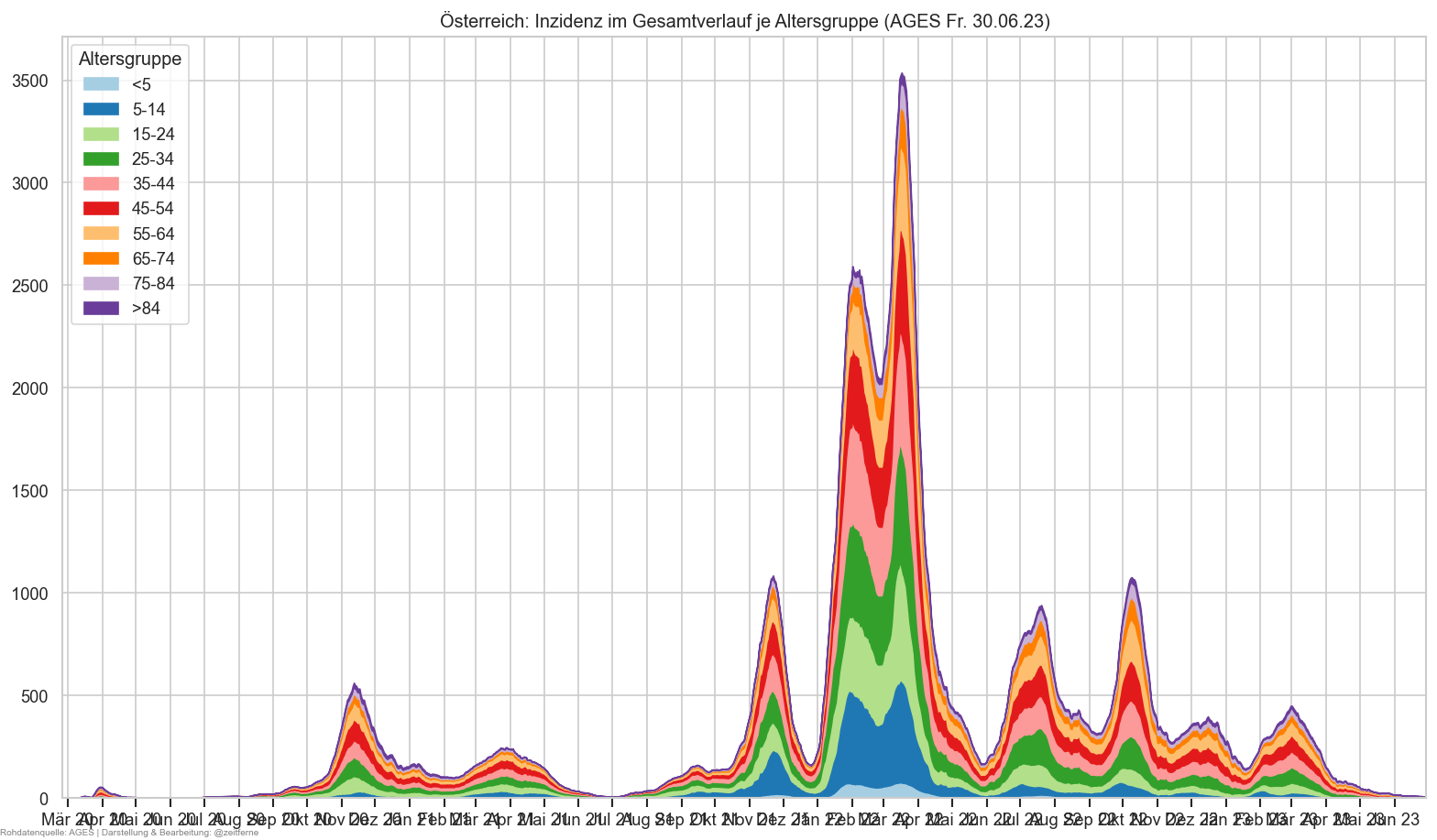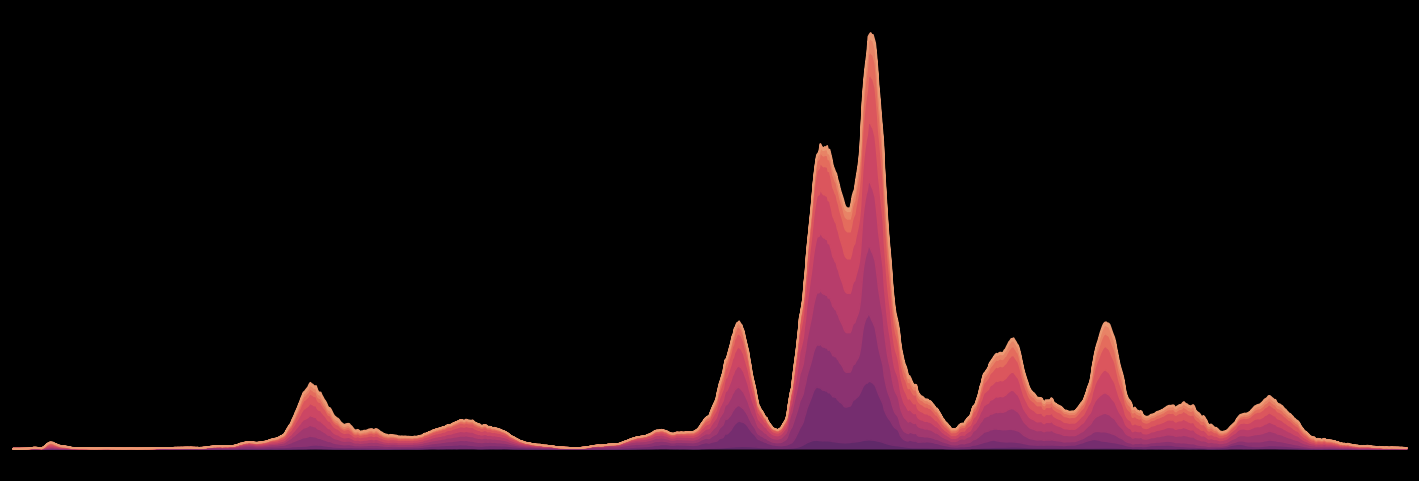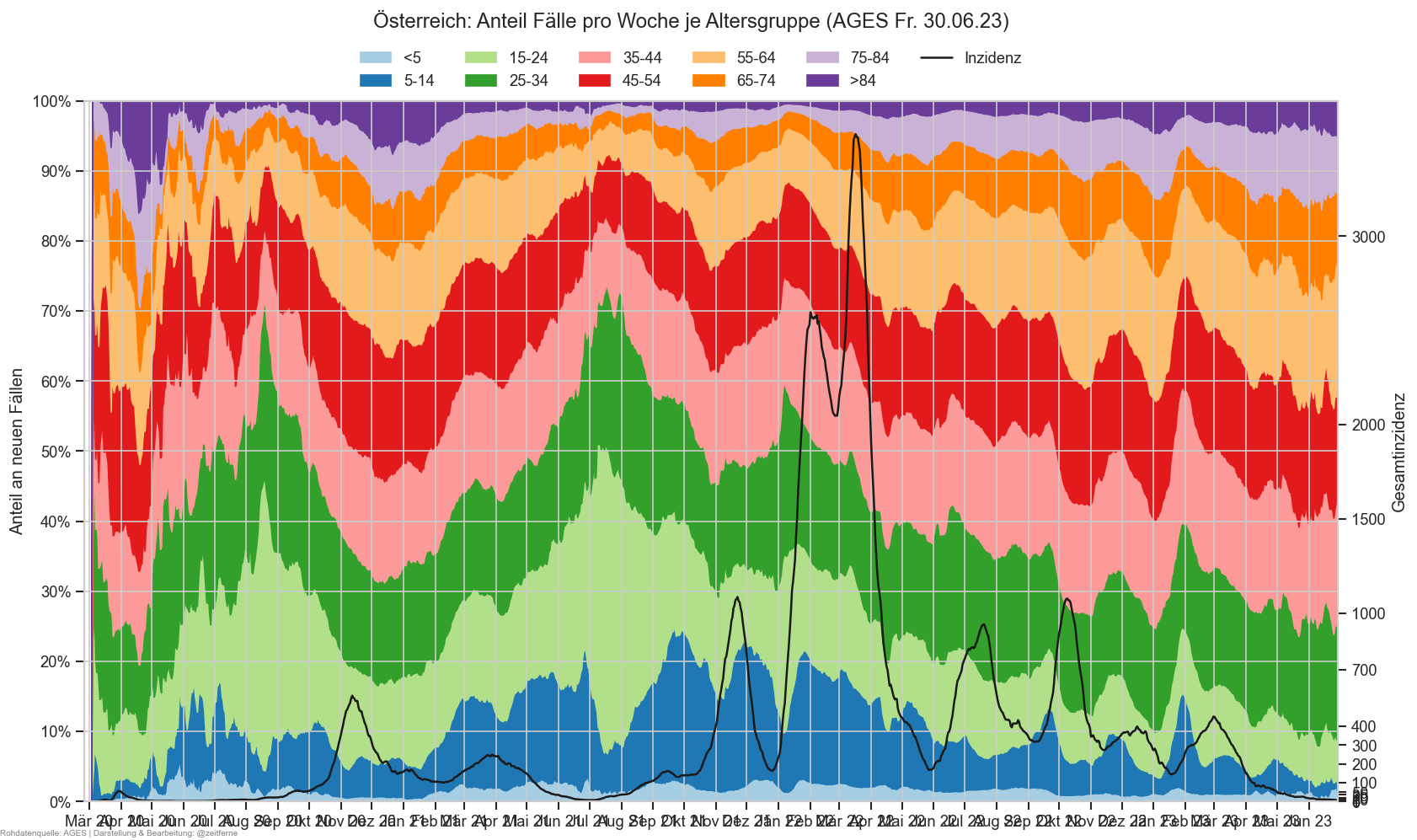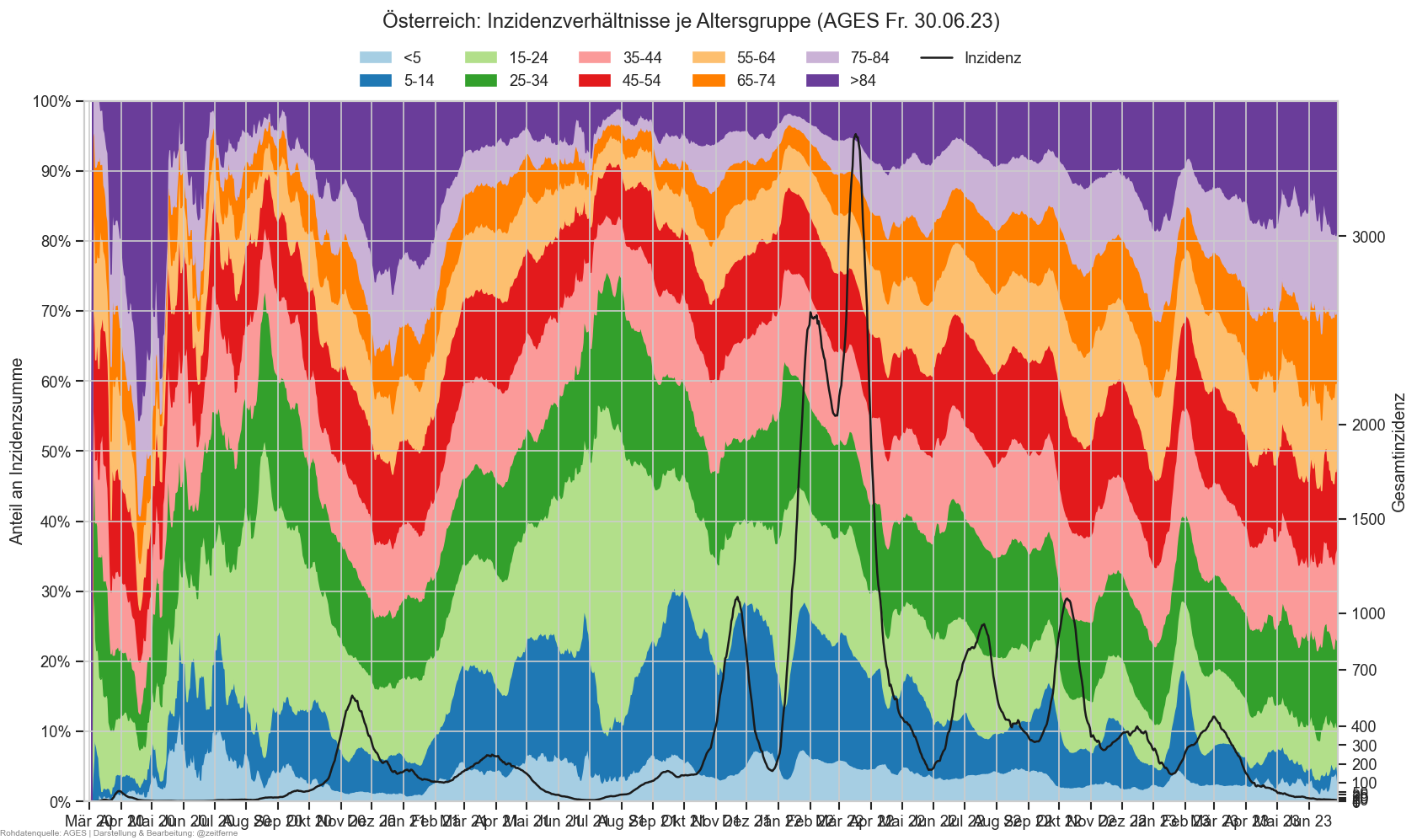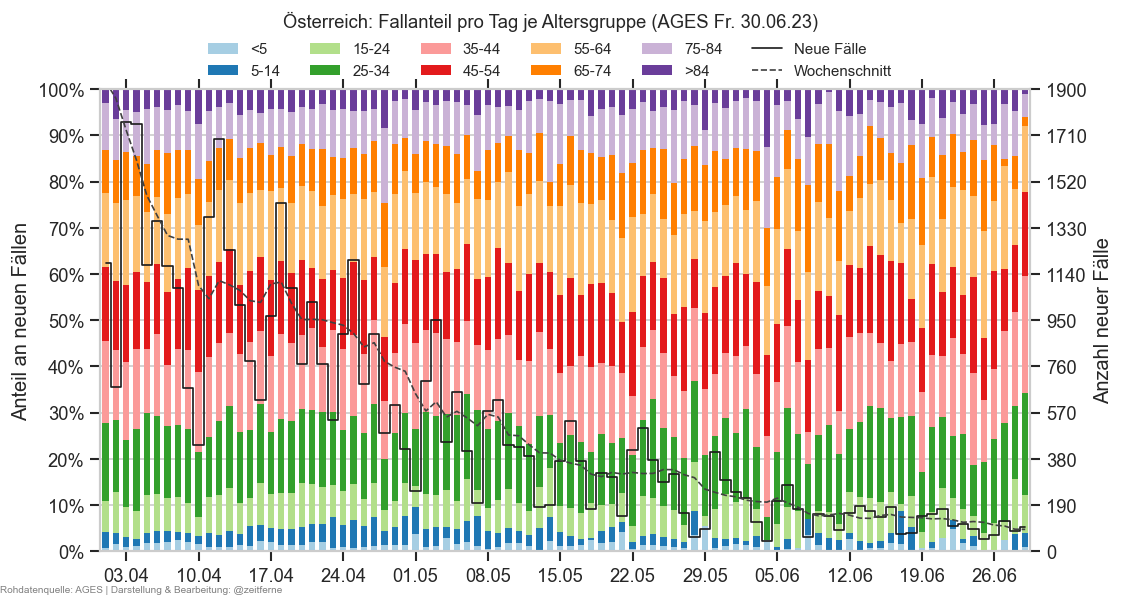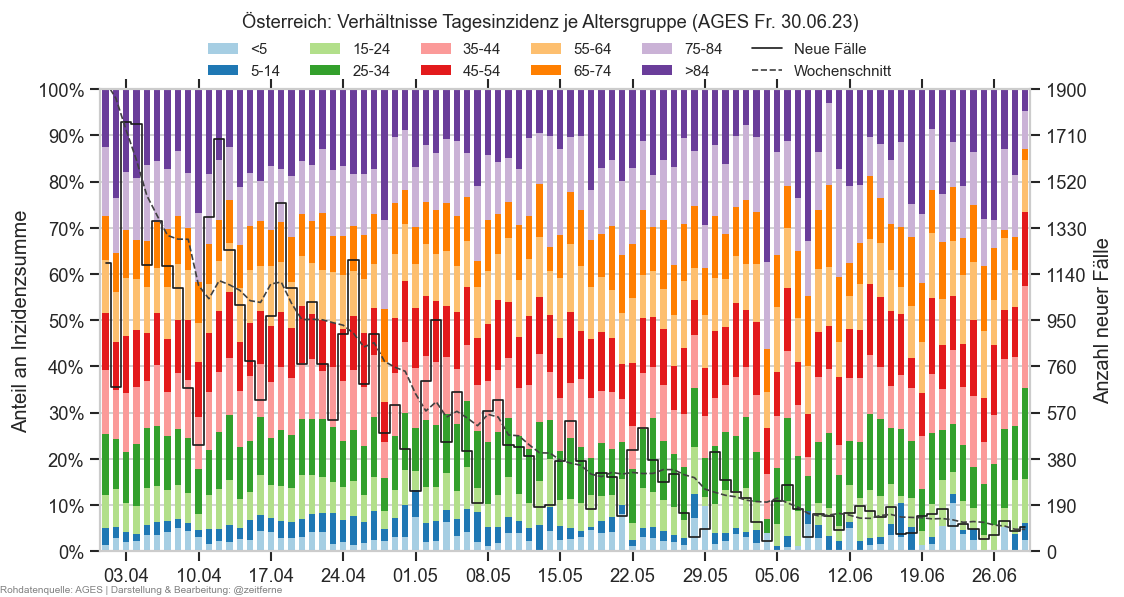Diagramme & Tabellen zu SARS-CoV-2 in Österreich¶
Erstellt aus https://github.com/zeitferne/covidat-tools/blob/main/notebooks/covidat-old.ipynb
Datenquellen sind die AGES (https://covid19-dashboard.ages.at/) und das Gesundheitsministerium (https://info.gesundheitsministerium.gv.at/opendata). Hierbei werden die Bundesländermeldungen (auch genannt "Morgenmeldungen" oder "Krisenstabzahlen") direkt von https://info.gesundheitsministerium.gv.at/data/timeline-faelle-bundeslaender.csv bezogen, alle anderen werden über https://github.com/statistikat/coronaDAT bezogen um auch auf historische Daten zurückgreifen zu können (die Daten selbst sind ident zu den offiziellen, allerdings steht aus offiziellen Quellen jeweils nur die aktuellste Datenversion zur Verfügung).
Tipp: Rechtsklicken auf die Diagramme und "in neuem Tab anzeigen" o.ä. um sie größer darzustellen.
Alle Angaben ohne Gewähr! Auch wenn als Datenquelle die AGES oder das Gesundheitsministerium angegeben ist, stammt die Darstellung & ggf. weitere Auswertung von mir und kann fehlerhaft sein.
Viele Abschnitte die haupts. Informationen zur aktuellen Situation bzw. zu kurzfristigen Änderungen zeigen sind auf GitHub nicht angezeigt. Wagemutige können lokal ausführen (versuchen) und DISPLAY_SHORTRANGE_DIAGS von = False auf = True ändern.
Hauptabschnitte¶
DISPLAY_SHORTRANGE_DIAGS = False
import locale
locale.setlocale(locale.LC_ALL, "de_AT.UTF-8");
%matplotlib inline
%precision %.4f
#%load_ext snakeviz
import colorcet
import pandas as pd
from scipy import stats
import matplotlib.pyplot as plt
import matplotlib.dates
import matplotlib.ticker
import matplotlib.patches
import matplotlib.colors
import seaborn as sns
from importlib import reload
from itertools import count
from datetime import date, datetime, timedelta
from IPython.display import display, Markdown, HTML
import textwrap
from functools import partial
from cycler import cycler
from covidat import cov, covdata
from covidat.cov import sortedlabels, labelend2
pd.options.display.precision = 4
plt.rcParams['figure.figsize'] = (16*0.7,9*0.7)
plt.rcParams['figure.dpi'] = 120 #80
plt.rcParams['figure.facecolor'] = '#fff'
sns.set_theme(style="whitegrid")
sns.set_palette('tab10')
plt.rcParams['image.cmap'] = cov.un_cmap
pd.options.display.max_rows = 120
pd.options.display.min_rows = 40
from covidat.util import COLLECTROOT, DATAROOT
print("collect-root:", COLLECTROOT)
print("data-root:", DATAROOT)
collect-root: ...\covidat\tmpdata data-root: ...\covidat-data\data
MIDRANGE_NDAYS = 120
SHORTRANGE_NDAYS = 91 + 1
DETAIL_NDAYS = 42 + 1
DETAIL_SMALL_NDAYS = 35 + 1
def nextday(dt):
return dt + timedelta(1)
# Find gaps (max size 1) & fill them
def fixgaps1(df, namecol, datecol, fixcols, allowlarge=False):
followdt = nextday(df.iloc[0][datecol])
newdfs = [df]
groups = iter(df.groupby(datecol, sort=False, as_index=False))
next(groups) # Drop first
for dt, items in groups:
i_dt = items.iloc[0].name
n_bl = len(items)
#print(i_dt)
if followdt.tz_localize(None).normalize() != dt.tz_localize(None).normalize():
#print("Prev", df.iloc[i_dt - n_bl])
gapsize = dt.tz_localize(None).normalize() - followdt.tz_localize(None).normalize()
print("Gap: Expected", followdt, "found", dt, "size", gapsize)
if gapsize > timedelta(1) and not allowlarge:
raise ValueError("Gap larger than one day, unable to correct")
prevrows = df.iloc[i_dt - n_bl:i_dt]
nextrows = df.iloc[i_dt:i_dt + n_bl]
#print(prevrows.iloc[-1][datecol], nextrows.iloc[-1][datecol])
#print(prevrows.iloc[0], nextrows.iloc[0])
for gapidx in range(gapsize.days):
newdf = prevrows.copy()
newdf[datecol] = followdt
coeff = (gapidx + 1) / (gapsize.days + 1)
#print(gapidx, coeff)
for col in fixcols:
newdf[col] = (
prevrows[col].to_numpy()
+ (nextrows[col].to_numpy() - prevrows[col].to_numpy())
* coeff)
followdt = nextday(followdt)
newdfs.append(newdf)
followdt = nextday(dt)
df = pd.concat(newdfs)
df.sort_values(by=[datecol, namecol], inplace=True)
df.reset_index(inplace=True, drop=True)
return df
def erase_outliers(series, q=0.9, maxfactor=10, rwidth=21, mode="mean2", fillnan=False):
series = series.copy()
outliers = (
(series > series.rolling(rwidth).quantile(q).clip(lower=1) * maxfactor) |
(series < 0) |
(fillnan & ~np.isfinite(series)))
nseries = series#.where(~outliers)
if mode == "mean2":
series[outliers] = (nseries.shift(14) + nseries.shift(7)) / 2
elif mode == "zero":
series[outliers] = 0
else:
raise ValueError(f"Bad mode: {mode}")
return series
def dodgeannot(annots, ax):
"""annots must be a list of tuples (y, text, kwargs).
Modifies the list in-place to adjust Y-positions for minimal overlap.
"""
yrng = ax.get_ylim()[1] - ax.get_ylim()[0]
annots.sort(key=lambda a: a[0])
changed = True
for i in range(30):
if not changed:
break
changed = False
for i, annot in enumerate(annots[1:], 1):
p_annot = annots[i - 1]
if annot[0] - p_annot[0] < yrng * 0.07:
changed = True
annots[i] = (annot[0] + yrng * 0.015 , *annot[1:])
annots[i - 1] = (p_annot[0] - yrng * 0.01, *p_annot[1:])
for annot in annots:
ax.annotate(annot[1], (ax.get_xlim()[1], annot[0]), va="center", **annot[2])
def plot_colorful_gcol(ax, dates, growth, name="Inzidenz", detailed=False, draw1=True, **kwargs):
mpos = growth > 1
mgrow = growth > growth.shift()
#mgrow |= mgrow.shift(-1)
#mgrow = mgrow.shift()
#ax.stackplot([fsbl["Datum"].iloc[0], fsbl["Datum"].iloc[-1]], 1, 100, colors=["blue", "red"], alpha=0.3)
if draw1:
ax.axhline(1, color="k", lw=1)
ax.plot(
dates, growth, color="C4",
label=f"Steigende {name}",
marker='.',
**kwargs)
ax.plot(
dates, growth.where(~mpos), color="C0",
label=f"Sinkende {name}",
marker=".",
#markersize=1.5
**kwargs
)
if detailed:
ax.plot(
dates, growth.where(~mpos & mgrow), color="C1",
label=f"Verlangsamt sinkende {name}",
marker=".",
#markersize=1.5
**kwargs
)
ax.plot(
dates, growth.where(mpos & mgrow), color="C3",
label=f"Beschleunigt steigende {name}",
marker=".",
#markersize=1.5
**kwargs
)
def enrich_agd(agd, fs):
#display(agd)
agd["AnzahlFaelleSumProEW"] = agd["AnzahlFaelleSum"] / agd["AnzEinwohner"]
agg = {
"Altersgruppe": "first",
#"Bundesland": "first", # Bug (slowness) with categorical dtype
"AnzEinwohner": np.sum,
"AnzEinwohnerFixed": np.sum,
"AnzahlFaelle": np.sum,
"AnzahlFaelleSum": np.sum,
"AnzahlTotSum": np.sum,
"AnzahlGeheilt": np.sum,
"Bundesland": "first",
}
if "AnzahlFaelleMeldeDiff" in agd.columns:
agg.update({
"AnzahlFaelleMeldeDiff": np.sum,
})
if "AgeFrom" in agd.columns:
agg.update({
"AgeFrom": "first",
"AgeTo": "first",
})
if "FileDate" in agd.columns:
agg.update({
"FileDate": "first",
})
agd_sums = agd.groupby(
["Datum", "BundeslandID", "AltersgruppeID"],
as_index=False, group_keys=False).agg(agg) # Group over Geschlecht
if fs is not None:
per_state = fs.copy()
per_state["Altersgruppe"] = "Alle"
#per_state["Bundesland"] = "Alle"
#per_state["AgeFrom"] = 0
#per_state["AgeTo"] = np.iinfo(agd_sums["AgeTo"].dtype).max
per_state["AltersgruppeID"] = 0
per_state.drop(columns="AnzahlGeheilt", inplace=True, errors="ignore")
per_state.rename(columns={"AnzahlGeheiltSum": "AnzahlGeheilt"}, inplace=True)
agd_sums = pd.concat([per_state, agd_sums])
#agd_sums["Bundesland"] = agd_sums["BundeslandID"].replace(cov.BUNDESLAND_BY_ID)
agd_sums["BLCat"] = agd_sums["Bundesland"].astype(cov.Bundesland)
agd_sums["Gruppe"] = agd_sums["Bundesland"].str.cat([agd_sums["Altersgruppe"]], sep=" ")
with cov.calc_shifted(agd_sums, ["Bundesland", "AltersgruppeID"], 7, newcols=["inz", "AnzahlFaelle7Tage"]):
agd_sums["inz"] = cov.calc_inz(agd_sums)
agd_sums["AnzahlFaelle7Tage"] = agd_sums["AnzahlFaelle"].rolling(7).sum()
with cov.calc_shifted(agd_sums, ["Bundesland", "AltersgruppeID"], newcols=["AnzahlTot"]):
agd_sums["AnzahlTot"] = agd_sums["AnzahlTotSum"].diff()
agd_sums["AnzahlFaelleProEW"] = agd_sums["AnzahlFaelle"] / agd_sums["AnzEinwohner"]
agd_sums["AnzahlFaelleSumProEW"] = agd_sums["AnzahlFaelleSum"] / agd_sums["AnzEinwohner"]
cov.enrich_inz(agd_sums, catcol=["Bundesland", "AltersgruppeID"])
agd_sums.reset_index(drop=True, inplace=True)
return agd_sums
def load_bev():
result = (
pd.read_csv(DATAROOT / "statat-bevstprog/latest/OGD_bevstprog_PR_BEVJD_7.csv",
sep=";", encoding="utf-8")
.rename(columns={
"C-B00-0": "BundeslandID",
"C-A10-0": "Jahr",
"C-GALT5J99-0": "AltersgruppeID5",
"C-C11-0": "Geschlecht",
"F-S25V1": "AnzEinwohner"
}))
result["Jahr"] = result["Jahr"].str.removeprefix("A10-").astype(int)
result["Datum"] = result["Jahr"].map(lambda y: pd.Period(year=y, freq="Y"))
result["BundeslandID"] = result["BundeslandID"].str.removeprefix("B00-").astype(int)
result["Geschlecht"] = result["Geschlecht"].map({"C11-1": "M", "C11-2": "W"})
result["AltersgruppeID5"] = result["AltersgruppeID5"].str.removeprefix("GALT5J99-").astype(int)
result.drop(columns="Jahr")
result = result.groupby([
result["Datum"],
result["BundeslandID"],
result["AltersgruppeID5"]
.map(lambda ag5: 1 if ag5 == 1 else 10 if ag5 >= 18 else (ag5 + 2) // 2)
.rename("AltersgruppeID"),
result["Geschlecht"],
])["AnzEinwohner"].sum()
return result
statbev = load_bev()
origlevels = statbev.index.names
pandembev = (statbev[
(statbev.index.get_level_values("Datum") >= pd.Period(year=2020, freq="Y"))
& (statbev.index.get_level_values("Datum") <= pd.Period(year=2024, freq="Y"))])
pandembev = pandembev.groupby(["BundeslandID", "Geschlecht", "AltersgruppeID"]).apply(
lambda s: s.reset_index(["BundeslandID", "Geschlecht", "AltersgruppeID"], drop=True).resample("D").interpolate().to_timestamp())
pandembev = cov.add_sum_rows(pandembev.to_frame(), "BundeslandID", 10)["AnzEinwohner"]
pandembev.index = pandembev.index.reorder_levels(origlevels)
# .groupby(["BundeslandID", "AltersgruppeID", "Geschlecht"])
# .transform(lambda s: s.rename("AnzEinwohner").reset_index().set_index("Datum")["AnzEinwohner"].reindex(pd.date_range(fs["Datum"].min(), fs["Datum"].max()))).interpolate()).dropna()
#%%time
daydate = date(2023, 6, 30)
cov=reload(cov)
ages_version = cov.load_day("Version.csv", daydate)
display(ages_version)
if ages_version["VersionsNr"].iloc[-1] != "V 2.7.0.0" or len(ages_version) != 1:
raise ValueError("AGES version update, new=" + str(ages_version["VersionsNr"].iloc[-1]))
ages_vdate = pd.to_datetime(ages_version.iloc[0]["CreationDate"], dayfirst=True)
fs = cov.load_faelle(bev=pandembev, daydate=daydate)
fs["FileDate"] = ages_vdate
cov.enrich_inz(fs, catcol="BundeslandID")
fs["AnzahlFaelleSumProEW"] = fs["AnzahlFaelleSum"] / fs["AnzEinwohner"]
fs["AnzahlFaelleProEW"] = fs["AnzahlFaelle"] / fs["AnzEinwohner"]
fs["BLCat"] = fs["Bundesland"].astype(cov.Bundesland)
with cov.calc_shifted(fs, "BundeslandID", 1) as shifted:
fs["AnzTests"] = fs["TestGesamt"] - shifted["TestGesamt"]
fs["TestPosRate"] = fs["AnzahlFaelle"] / fs["AnzTests"]
with cov.calc_shifted(fs, "BundeslandID", 7) as shifted:
fs["TestPosRate_a7"] = fs["AnzahlFaelle"].rolling(7).sum() / fs["AnzTests"].rolling(7).sum()
fs_at = fs.query("Bundesland == 'Österreich'").copy()
hosp = cov.add_date(cov.load_day("Hospitalisierung.csv", daydate), "Meldedatum")
hosp["IntensivBettenFreiPro100"] = hosp["IntensivBettenFrei"] / hosp["IntensivBettenKapGes"] * 100
hosp["IntensivBettenBelGes"] = hosp["IntensivBettenBelCovid19"] + hosp["IntensivBettenBelNichtCovid19"]
with cov.calc_shifted(hosp, "BundeslandID", 7):
hosp["IntensivBettenFreiPro100_a7"] = hosp["IntensivBettenFreiPro100"].rolling(7).mean()
hosp["IntensivBettenBelGes_a7"] = hosp["IntensivBettenBelGes"].rolling(7).mean()
hosp["AnteilCov"] = hosp["IntensivBettenBelCovid19"] / hosp["IntensivBettenBelGes"]
hosp["AnteilNichtCov"] = hosp["IntensivBettenBelNichtCovid19"] / hosp["IntensivBettenBelGes"]
#gis_o = cov.load_gem_impfungen()
DTFMT = "%a %c"
bez_orig = cov.load_bezirke(daydate)
bez = cov.enrich_bez(bez_orig, fs)
bez["FileDate"] = ages_vdate
agd = cov.load_ag(bev=pandembev, daydate=daydate)
agd["FileDate"] = ages_vdate
with cov.calc_shifted(agd, ["Gruppe"]) as shifted:
agd["AnzahlTot"] = agd["AnzahlTotSum"] - shifted["AnzahlTotSum"]
agd_sums = enrich_agd(agd, fs)
agd_sums_at = agd_sums.query("Bundesland == 'Österreich'")
ag_to_id = agd_sums_at.set_index("Altersgruppe")["AltersgruppeID"].to_dict()
cov.enrich_inz(agd, catcol="Gruppe")
hospfz = (cov.norm_df(cov.load_day("CovidFallzahlen.csv", daydate),
datecol="Meldedat", format=cov.AGES_DATE_FMT)
.set_index(["Datum", "BundeslandID"])).drop(columns="MeldeDatum")
hospfz["Bundesland"].replace("Alle", "Österreich", inplace=True)
hospfz["AnzEinwohner"] = fs.set_index(["Datum", "BundeslandID"])["AnzEinwohner"]
hospfz["AnzEinwohner"].ffill(inplace=True)
def recalc_at_hosp(hospfz):
scols = ["FZHosp", "FZHospFree", "FZICU", "FZICUFree"]
hospfz_sum = hospfz.query("BundeslandID != 10").groupby(level="Datum")[scols].sum()
#display(hospfz_sum)
hospfz.loc[(pd.IndexSlice[:], 10), scols] = hospfz_sum.to_numpy()
if False:
# MANUAL FIX according to https://coronavirus.wien.gv.at/aktuelle-kennzahlen-aus-wien/
hospfz.loc[(pd.to_datetime("2022-11-02"), 9), "FZHosp"] = 456
hospfz.loc[(pd.to_datetime("2022-11-03"), 9), "FZHosp"] = 455
hospfz.loc[(pd.to_datetime("2022-11-04"), 9), "FZHosp"] = 444
# CoV+Post+Nicht
hospfz.loc[(pd.to_datetime("2022-11-05"), 9), "FZHosp"] = 103+218+117
hospfz.loc[(pd.to_datetime("2022-11-06"), 9), "FZHosp"] = 96+210+111
hospfz.loc[(pd.to_datetime("2022-11-07"), 9), "FZHosp"] = 101+226+115
hospfz.loc[(pd.to_datetime("2022-11-08"), 9), "FZHosp"] = 108+241+115
hospfz.loc[(pd.to_datetime("2022-11-09"), 9), "FZHosp"] = 105+231+109
hospfz.loc[(pd.to_datetime("2022-11-10"), 9), "FZHosp"] = 103+215+110
recalc_at_hospfz(hospfz)
#hospfz.loc[10] = hospfz[hospfz["Bundesland"] != "Österreich"].groupby("Datum").sum(numeric_only=True).assign(Bundesland="Österreich")
#hospfz.loc[10, "Bundesland"] = "Österreich"
hospfz.reset_index(inplace=True)
cov.enrich_hosp_data(hospfz)
while not (cov.filterlatest(hospfz)[["FZHosp", "FZICU"]] != 0).any().any():
print("Dropping All-Zero hospitalization data for " + str(hospfz.iloc[-1]["Datum"]))
hospfz = hospfz[hospfz["Datum"] != hospfz.iloc[-1]["Datum"]]
AGES_STAMP = " (AGES " + ages_vdate.strftime("%a %d.%m.%y") + ")"
| VersionsNr | VersionsDate | CreationDate | |
|---|---|---|---|
| 0 | V 2.7.0.0 | 30.06.2023 00:00:00 | 30.06.2023 14:02:01 |
cov=reload(cov)
def load_hist(fname="CovidFaelle_Timeline.csv", catcol="BundeslandID", ndays=31*2,
normalize=lambda df: df, csv_args=None):
ages_hist_keys = ["Datum"] + ([catcol] if isinstance(catcol, str) else catcol) + ["FileDate"]
ages_hist = cov.loadall(fname, ndays, normalize, csv_args=csv_args)
if "Time" in ages_hist.columns:
cov.add_date(ages_hist, "Time", format=cov.AGES_TIME_FMT)
ages_hist.sort_values(by=ages_hist_keys, inplace=True)
ages_hist.reset_index(drop=True, inplace=True)
print("Loaded", fname, "from", ages_hist.iloc[0][["Datum", "FileDate"]], "to",
ages_hist.iloc[-1][["Datum", "FileDate"]],
"requested", ndays, "got", ages_hist["FileDate"].nunique())
sumcol = "AnzahlFaelleSum"
dsumcol = "AnzahlTotSum"
hsumcol = "AnzahlGeheiltSum"
lastfiledate = None
for filedate in np.sort(ages_hist["FileDate"].unique()):
if lastfiledate and filedate - lastfiledate != np.timedelta64(1, 'D'):
raise ValueError(f"Gap in data between {lastfiledate} and {filedate}")
lastfiledate = filedate
mask = ages_hist["FileDate"] == filedate
masked = ages_hist.loc[mask].copy()
with cov.calc_shifted(masked, ages_hist_keys[1:], 7, newcols=["inz", "AnzahlTot7Tage"]) as shifted:
masked["inz"] = (masked[sumcol] - shifted[sumcol]) / masked["AnzEinwohner"] * 100_000
masked["AnzahlTot7Tage"] = (masked[dsumcol] - shifted[dsumcol])
ages_hist.loc[mask, ["inz", "AnzahlTot7Tage"]] = masked
ages1 = ages_hist[ages_hist["FileDate"] == ages_hist["Datum"] + timedelta(1)].copy()
with cov.calc_shifted(ages1, catcol) as shifted:
ages1["AnzahlFaelleMeldeDiff"] = ages1[sumcol] - shifted[sumcol]
ages1["AnzahlTotMeldeDiff"] = ages1[dsumcol] - shifted[dsumcol]
if hsumcol in ages1.columns:
ages1["AnzahlGeheiltMeldeDiff"] = ages1[hsumcol] - shifted[hsumcol]
ages1m = (ages1.drop(columns=[
"AnzahlFaelle",
"SiebenTageInzidenzFaelle",
"AnzahlFaelle7Tage",
"AnzahlTot",
"AnzahlTotTaeglich",
"AnzahlGeheiltTaeglich"], errors="ignore")
.rename(columns={
"AnzahlFaelleMeldeDiff": "AnzahlFaelle",
"AnzahlTotMeldeDiff": "AnzahlTot",
"AnzahlGeheiltMeldeDiff": "AnzahlGeheilt",
}))
ages1m["Datum"] = ages1m["FileDate"]
with cov.calc_shifted(ages1m, catcol, 7, newcols=["inz"]):
ages1m["inz"] = cov.calc_inz(ages1m)
cov.enrich_inz(ages1m, catcol=catcol)
return ages1, ages1m, ages_hist
if True:
cols = {
"Time": str,
"Bundesland": str,
"BundeslandID": np.uint8,
"AnzEinwohner": int,
"AnzahlFaelle": int,
"AnzahlFaelleSum": int,
"AnzahlFaelle7Tage": int,
"AnzahlTotTaeglich": int,
"AnzahlTotSum": int,
"AnzahlGeheiltTaeglich": int,
"AnzahlGeheiltSum": int,
}
ages1, ages1m, ages_hist = load_hist(ndays=2000, csv_args=dict(
engine="c",
dtype=cols,
usecols=list(cols.keys())))
ages1.rename(columns={"AnzahlTotTaeglich": "AnzahlTot", "AnzahlGeheiltTaeglich": "AnzahlGeheilt"}, inplace=True)
Missing data for 2020-10-05
Loaded CovidFaelle_Timeline.csv from Datum 2020-02-12 00:00:00 FileDate 2020-10-13 00:00:00 Name: 0, dtype: object to Datum 2023-06-29 00:00:00 FileDate 2023-06-30 00:00:00 Name: 7200979, dtype: object requested 2000 got 998
#%%prun -D program.prof
#%%time
cols = {
"Time": str,
"Bundesland": str,
"BundeslandID": int,
"AnzEinwohner": int,
"Anzahl": int,
"AnzahlTot": int,
"AnzahlGeheilt": int,
"AltersgruppeID": int,
"Geschlecht": str,
"Altersgruppe": str,
#"AnzahlGeheiltTaeglich": int,
#"AnzahlGeheiltSum": int,
}
agd1, agd1m, agd_hist = load_hist(
"CovidFaelle_Altersgruppe.csv", ["AltersgruppeID", "BundeslandID", "Geschlecht"], 52,
normalize=lambda ds: ds.rename(columns={"AnzahlTot": "AnzahlTotSum", "Anzahl": "AnzahlFaelleSum"}, errors="raise"),
csv_args=dict(
engine="c",
dtype=cols,
usecols=list(cols.keys())))
#agd1m["Gruppe"] = agd1m["Bundesland"].str.cat(
# [agd1m["Altersgruppe"], agd1m["Geschlecht"]], sep=" "
# )
agd1m = cov.enrich_ag(agd1m.drop(columns="FileDate"), parsedate=False)
agd_hist_o = agd_hist.copy()
agd_hist = cov.enrich_ag(agd_hist, agefromto=False, parsedate=False)
agd1 = agd_hist[agd_hist["FileDate"] == agd_hist["Datum"] + timedelta(1)].copy()
agd1 = agd1.merge(agd1m[["Datum", "Bundesland", "Altersgruppe", "Geschlecht", "AnzahlFaelle"]].rename(columns={
"AnzahlFaelle": "AnzahlFaelleMeldeDiff"}),
left_on=["FileDate", "Bundesland", "Altersgruppe", "Geschlecht"],
right_on=["Datum", "Bundesland", "Altersgruppe", "Geschlecht"],
suffixes=(None, "_x")).drop(columns=["Datum_x"])
agd1m_sums = enrich_agd(agd1m, ages1m)
with cov.calc_shifted(agd1m, ["Gruppe"], newcols=["AnzahlTot"]) as shifted:
agd1m["AnzahlTot"] = agd1m["AnzahlTotSum"] - shifted["AnzahlTotSum"]
cols = {
"Time": str,
#"Bundesland": str,
"GKZ": int,
"Bezirk": str,
"AnzEinwohner": int,
"AnzahlFaelle": int,
"AnzahlFaelleSum": int,
"AnzahlFaelle7Tage": int,
"AnzahlTotTaeglich": int,
"AnzahlTotSum": int,
#"AnzahlGeheiltTaeglich": int,
#"AnzahlGeheiltSum": int,
}
bez1, bez1m, bez_hist = load_hist("CovidFaelle_Timeline_GKZ.csv", "Bezirk", 52, csv_args=dict(
engine="c",
dtype=cols,
usecols=list(cols.keys())))
bez1m = cov.enrich_bez(bez1m, ages1m)
Loaded CovidFaelle_Altersgruppe.csv from Datum 2020-02-26 00:00:00 FileDate 2023-05-10 00:00:00 Name: 0, dtype: object to Datum 2023-06-29 00:00:00 FileDate 2023-06-30 00:00:00 Name: 12422799, dtype: object requested 52 got 52 Loaded CovidFaelle_Timeline_GKZ.csv from Datum 2020-02-26 00:00:00 FileDate 2023-05-10 00:00:00 Name: 0, dtype: object to Datum 2023-06-29 00:00:00 FileDate 2023-06-30 00:00:00 Name: 5838715, dtype: object requested 52 got 52
ems_o = pd.read_csv(
DATAROOT / "covid/morgenmeldung/timeline-faelle-ems.csv",
sep=";")
ems_o["Datum"] = cov.parseutc_at(ems_o["Datum"], format=cov.ISO_TIME_TZ_FMT)
print("EMS", ems_o.iloc[-1]["Datum"], ems_o.iloc[0]["Datum"])
ems_o = fixgaps1(ems_o, "Name", "Datum", ["BestaetigteFaelleEMS"])
EMS 2022-09-12 08:00:00+02:00 2021-03-01 08:00:00+01:00 Gap: Expected 2021-11-14 08:00:00+01:00 found 2021-11-15 08:00:00+01:00 size 1 days 00:00:00
mms_o = pd.read_csv(
DATAROOT / "covid/morgenmeldung/timeline-faelle-bundeslaender.csv",
sep=";",
#encoding="cp1252"
)
mms_o["Datum"] = cov.parseutc_at(mms_o["Datum"], format=cov.ISO_TIME_TZ_FMT)
print("BMI", mms_o.iloc[-1]["Datum"], mms_o.iloc[0]["Datum"])
BMI 2022-09-12 09:30:00+02:00 2021-03-01 09:30:00+01:00
def load_apo(enc):
return pd.read_csv(
DATAROOT / "covid/morgenmeldung/timeline-testungen-apotheken-betriebe.csv",
sep=";", decimal=",", thousands=".",
encoding=enc,
dtype={"Datum": str})
try:
apo_o = load_apo("utf-8")
except UnicodeDecodeError:
apo_o = load_apo("cp1252")
apo_o["Datum"] = cov.parseutc_at(apo_o["Datum"], format=cov.AGES_DATE_FMT)
print("Apotheken", apo_o.iloc[-1]["Datum"], apo_o.iloc[0]["Datum"])
Apotheken 2023-06-25 02:00:00+02:00 2021-02-15 01:00:00+01:00
reinf_o = (pd.read_csv(
DATAROOT / "covid/ages-ems-extra/Reinfektionen_latest.csv",
sep=";", decimal=",")
.rename(columns={"Monat": "Datum"}))
reinf = reinf_o.query("Datum != ''").copy()
reinf["Datum"] = pd.to_datetime(
reinf["Datum"]
.str.replace("Jan", "Jän", regex=False)
.str.replace("Mrz", "Mär", regex=False),
format="%b %y")
reinf.set_index("Datum", inplace=True)
display(HTML(
f"""
<p><strong>Auswertung vom:</strong> {datetime.now().strftime(DTFMT)}
<p><strong>Letzte enthaltene Daten vom:</strong>
<ul>
<li> AGES: {ages_vdate.strftime(DTFMT)}
{ages_version.to_html(index=False)}
</li>
<li> EMS Morgenmeldungen: {ems_o.iloc[-1]["Datum"].strftime(DTFMT)}</li>
<li> Bundesländermeldungen: {mms_o.iloc[-1]["Datum"].strftime(DTFMT)}</li>
<li> Apotheken-Tests: {apo_o.iloc[-1]["Datum"].strftime(DTFMT)}</li>
</ul>
"""));
Auswertung vom: Di. 25.07.2023 22:02:40
Letzte enthaltene Daten vom:
- AGES: Fr. 30.06.2023 14:02:01
VersionsNr VersionsDate CreationDate V 2.7.0.0 30.06.2023 00:00:00 30.06.2023 14:02:01 - EMS Morgenmeldungen: Mo. 12.09.2022 08:00:00
- Bundesländermeldungen: Mo. 12.09.2022 09:30:00
- Apotheken-Tests: So. 25.06.2023 02:00:00
def doubling_time(g):
# x * g**t = 2x # Solve for t
# g**t = 2
# log(g) * t = log(2)
# t = log(2) / log(g)
return np.log(2) / np.log(g)
7*doubling_time(cov.filterlatest(fs_at).iloc[-1]["inz_g7"])
-13.3784
def pctc(n, emoji=False, percent=True):
p = n * 100 - 100
result = (
"±0" if np.isnan(p) or n == 1 else
format(np.round(p), "+n") if n >= 1.995 or n <= 0 else
format(p, "+.2n")
).replace("-", "‒").replace("inf", "∞")
if percent:
result += "%"
if emoji:
if 0.97 < n < 1.03:
pass
elif n <= np.exp(np.log(0.5) / 2): # 2 weeks halving
result += " ⏬"
elif n < 1:
result += " ↘"
elif n >= 2: # 1 weeks doubling
result += " 🔥"
elif n >= np.exp(np.log(2) / 2): # 2 weeks doubling
result += " ⏫"
elif n > 1:
result += " ↗"
return result
np.exp(np.log(2) / 2)
1.4142
agd1_sums = enrich_agd(agd1, ages1)
ages_old = ages_hist[ages_hist["FileDate"] == ages_hist.iloc[-1]["FileDate"] - timedelta(1)].copy()
ages_old.rename(columns={"AnzahlTotTaeglich": "AnzahlTot"}, inplace=True)
ages_old2 = ages_hist[ages_hist["FileDate"] == ages_hist.iloc[-1]["FileDate"] - timedelta(2)].copy()
ages_old2.rename(columns={"AnzahlTotTaeglich": "AnzahlTot"}, inplace=True)
ages_old7 = ages_hist[ages_hist["FileDate"] == ages_hist.iloc[-1]["FileDate"] - timedelta(7)].copy()
ages_old7.rename(columns={"AnzahlTotTaeglich": "AnzahlTot"}, inplace=True)
agd_old = cov.enrich_ag(agd_hist[agd_hist["FileDate"] == agd_hist.iloc[-1]["FileDate"] - timedelta(1)].copy(), agefromto=False, parsedate=False)
agd_old2 = cov.enrich_ag(agd_hist[agd_hist["FileDate"] == agd_hist.iloc[-1]["FileDate"] - timedelta(2)].copy(), agefromto=False, parsedate=False)
agd_old7 = cov.enrich_ag(agd_hist[agd_hist["FileDate"] == agd_hist.iloc[-1]["FileDate"] - timedelta(7)].copy(), agefromto=False, parsedate=False)
for agdh in (agd_old, agd_old2, agd_old7):
with cov.calc_shifted(agdh, ["Gruppe"]) as shifted:
agdh["AnzahlTot"] = agdh["AnzahlTotSum"] - shifted["AnzahlTotSum"]
agd_sums_old = enrich_agd(agd_old, ages_old)
agd_sums_old2 = enrich_agd(agd_old2, ages_old2)
agd_sums_old7 = enrich_agd(agd_old7, ages_old7)
bez_old = bez_hist[bez_hist["FileDate"] == bez_hist.iloc[-1]["FileDate"] - timedelta(1)].copy()
bez_old.rename(columns={"AnzahlTotTaeglich": "AnzahlTot"}, inplace=True)
bez_old = cov.enrich_bez(bez_old, ages_old)
bez_old2 = bez_hist[bez_hist["FileDate"] == bez_hist.iloc[-1]["FileDate"] - timedelta(2)].copy()
bez_old2.rename(columns={"AnzahlTotTaeglich": "AnzahlTot"}, inplace=True)
bez_old2 = cov.enrich_bez(bez_old2, ages_old2)
bez_old7 = bez_hist[bez_hist["FileDate"] == bez_hist.iloc[-1]["FileDate"] - timedelta(7)].copy()
bez_old7.rename(columns={"AnzahlTotTaeglich": "AnzahlTot"}, inplace=True)
bez_old7 = cov.enrich_bez(bez_old7, ages_old7)
schul_o = pd.read_csv(
DATAROOT / "covid/morgenmeldung/timeline-testungen-schulen.csv",
sep=";",
#encoding="cp1252"
)
schul_o["Datum"] = cov.parseutc_at(schul_o["Datum"], format=cov.ISO_DATE_FMT)
print("timeline-testungen-schulen", schul_o.iloc[-1]["Datum"], schul_o.iloc[0]["Datum"])
timeline-testungen-schulen 2022-07-01 02:00:00+02:00 2021-04-23 02:00:00+02:00
bltest_o = pd.read_csv(
DATAROOT / "covid/morgenmeldung/timeline-testungen-bundeslaender.csv",
sep=";",
#encoding="cp1252"
)
bltest_o["Datum"] = cov.parseutc_at(bltest_o["Datum"], format=cov.ISO_TIME_TZ_FMT)
print("timeline-testungen-bundeslaender", bltest_o.iloc[-1]["Datum"], bltest_o.iloc[0]["Datum"])
timeline-testungen-bundeslaender 2023-06-26 09:30:00+02:00 2021-03-01 09:30:00+01:00
schul = schul_o.copy()
schul["Datum"] = schul["Datum"].dt.normalize().dt.tz_localize(None)
schul.set_index(["BundeslandID", "Datum"], inplace=True)
schul.rename(columns={
"Name": "Bundesland",
"TestungenSchulenPCR": "PCRSum",
"TestungenSchulen": "TestsSum",
"TestungenSchulenAntigen": "AntigenSum"},
inplace=True)
schul["PCRSum"].fillna(0, inplace=True)
schul["PCR"] = schul.groupby(level="BundeslandID")["PCRSum"].transform(lambda s: s.diff())
schul["Tests"] = schul.groupby(level="BundeslandID")["TestsSum"].transform(lambda s: s.diff())
#schul.loc[np.isnan(schul["PCR"]), "PCR"] = schul["PCRSum"]
schul["Antigen"] = schul.groupby(level="BundeslandID")["AntigenSum"].transform(lambda s: s.diff())
#schul.loc[np.isnan(schul["Antigen"]), "Antigen"] = schul["AntigenSum"]
apo = apo_o.copy()
apo.rename(inplace=True, columns={
"Name": "Bundesland",
"TestungenApothekenPCR": "PCRSum",
"TestungenApotheken": "TestsSum",
"TestungenApothekenAntigen": "AntigenSum",
"TestungenBetriebe": "TestsBetriebSum"})
with cov.calc_shifted(apo, "BundeslandID", 1) as shifted:
for colname in apo.columns:
if not colname.endswith("Sum"):
continue
apo[colname[:-len("Sum")]] = apo[colname] - shifted[colname]
apo["Datum"] = apo["Datum"].dt.normalize().dt.tz_localize(None) + timedelta(1)
apo.set_index(["BundeslandID", "Datum"], inplace=True)
def rollupneg(vs):
poscount = vs.gt(0).cumsum()
gs = vs.groupby(poscount)
return gs.transform(lambda s: s.mean())
#data = pd.Series([100, -10, -20, 10, 4, -1], name="d")
#corr = rollupneg(data).sort_index().rename("c")
#display(pd.DataFrame((data, corr)).T)
cov=reload(cov)
def rollupallneg(df):
for bl in df["BundeslandID"].unique():
mask = df["BundeslandID"] == bl
df.loc[mask, "AnzahlFaelle"] = rollupneg(df.loc[mask, "AnzahlFaelle"])
df.loc[mask, "AnzahlFaelleSum"] = df.loc[mask, "AnzahlFaelleSum"].cumsum()
mask_at = df["BundeslandID"] == 10
#print(len(mask_at[mask_at]))
corrcols = ["AnzahlFaelle", "AnzahlFaelleSum"]
sums = df.loc[~mask_at, corrcols + ["Datum"]].groupby("Datum").sum()
#display(sums)
df.loc[mask_at, corrcols] = sums.to_numpy()
# TODO: Join by date for correct historical data
ew_by_bundesland = cov.filterlatest(fs).set_index("Bundesland")["AnzEinwohner"].to_dict()
ems = ems_o.rename(columns={"Name": "Bundesland", "BestaetigteFaelleEMS": "AnzahlFaelleSum"})
ems["AnzEinwohner"] = ems["Bundesland"].replace(ew_by_bundesland)
with cov.calc_shifted(ems, "BundeslandID", 1) as shifted:
ems["AnzahlFaelle"] = ems["AnzahlFaelleSum"] - shifted["AnzahlFaelleSum"]
#rollupallneg(ems)
with cov.calc_shifted(ems, "BundeslandID", 7) as shifted:
ems["inz"] = cov.calc_inz(ems)
cov.enrich_inz(ems, catcol="Bundesland")
mms = mms_o.copy()
mms.rename(inplace=True, columns={
"Name": "Bundesland",
"Intensivstation": "FZICU",
"Hospitalisierung": "FZHosp",
"BestaetigteFaelleBundeslaender": "AnzahlFaelleSum",
"Todesfaelle": "AnzahlTotSum",
"Genesen": "AnzahlGeheiltSum",
"Testungen": "TestsSum",
"TestungenPCR": "PCRSum",
"TestungenAntigen": "AntigenSum"})
mms["FZHosp"] -= mms["FZICU"]
mms["Datum"] = mms["Datum"].dt.normalize().dt.tz_localize(None)
#mms["AnzahlFaelleSum"] = mms["AnzahlFaelleSum"].str.replace(",00", "").str.replace(".", "", regex=False)
mms.set_index(["BundeslandID", "Datum"], inplace=True)
mms["AnzEinwohner"] = fs.set_index(["BundeslandID", "Datum"])["AnzEinwohner"]
mms.loc[~np.isfinite(mms["AnzEinwohner"]), "AnzEinwohner"] = mms["Bundesland"].map(ew_by_bundesland)
mms.sort_index(inplace=True)
rowkey = (9, pd.to_datetime("2021-12-12"))
prevkey = (9, pd.to_datetime("2021-12-11"))#
#print(mms.loc[rowkey, "AnzahlFaelleSum"])
if mms.loc[rowkey, "AnzahlFaelleSum"] == mms.loc[prevkey, "AnzahlFaelleSum"]:
#print("corr!")
mms.loc[rowkey, "AnzahlFaelleSum"] = (
(mms.loc[prevkey, "AnzahlFaelleSum"] +
mms.loc[(9, pd.to_datetime("2021-12-13")), "AnzahlFaelleSum"]) // 2)
mms.loc[(10, rowkey[1]), "AnzahlFaelleSum"] = mms.loc[(pd.IndexSlice[0:9], rowkey[1]), "AnzahlFaelleSum"].sum()
#print(mms.loc[rowkey])
mms.reset_index(inplace=True)
def add_unsum(mms):
with cov.calc_shifted(mms, "BundeslandID", 1) as shifted:
for colname in mms.columns:
if not colname.endswith("Sum"):
continue
dcol = colname[:-len("Sum")]
#print(colname, dcol)
mms[dcol] = mms[colname].astype(float) - shifted[colname].astype(float)
add_unsum(mms)
#rollupallneg(mms)
def enrich_mms(mms, apo, schul):
mms.set_index(["BundeslandID", "Datum"], inplace=True)
apolast = apo.index[-1][1]
apovalid = apo#[apo.index.get_level_values("Datum") != apolast]
mms["PCR"] = mms["PCR"].groupby(level="BundeslandID").transform(lambda s: erase_outliers(s))
#mms["PCR"] = mms["PCR"].clip(lower=0)
mms["PCRApo"] = apovalid["PCR"]
mms["AGApo"] = apovalid["Antigen"]
mms["TestsApo"] = apovalid["Tests"]
mms["PCRReg"] = mms["PCR"] + apo.where(apo["Bundesland"] != "Steiermark", 0)["PCR"]
mms["AGReg"] = mms["Antigen"] + apo.where(apo["Bundesland"] != "Steiermark", 0)["Antigen"]
mms.loc[(10,), "PCRReg"] = (
mms.query("Bundesland != 'Österreich'")["PCRReg"]
.groupby("Datum")
.sum(min_count=1)
.to_numpy())
#mms["PCRReg"] = mms["PCR"].add(apo["PCR"])
mms["TestsReg"] = mms["Tests"].add(apo.where(apo["Bundesland"] != "Steiermark", 0)["Tests"]).add(apo["TestsBetrieb"], fill_value=0)
mms["PCRAlle"] = mms["PCRReg"].add(schul["PCR"], fill_value=0)
mms["TestsAlle"] = mms["TestsReg"].add(schul["Tests"].where(schul["Bundesland"] != "Wien"), fill_value=0)
mms["PCRAlle"] = mms["PCRReg"].add(schul["PCR"].where(schul["Bundesland"] != "Wien"), fill_value=0)
at_tests = (
mms.query("Bundesland != 'Österreich'")[["TestsAlle", "PCRAlle"]]
.groupby(level="Datum").sum())
#display(at_tests)
mms.loc[10, ["TestsAlle", "PCRAlle"]] = at_tests.to_numpy()
mms.reset_index(inplace=True)
mms["PCRPosRate"] = mms["AnzahlFaelle"] / mms["PCR"]
mms["PCRRPosRate"] = mms["AnzahlFaelle"] / mms["PCRReg"]
mms["PCRAPosRate"] = mms["AnzahlFaelle"] / mms["PCRAlle"]
with cov.calc_shifted(mms, "BundeslandID", 7) as shifted:
faelle7 = mms["AnzahlFaelle"].rolling(7).sum()
mms["PCRPosRate_a7"] = faelle7 / mms["PCR"].rolling(7).sum()
mms["PCRAPosRate_a7"] = faelle7 / mms["PCRAlle"].rolling(7).sum()
mms["TestsAPosRate_a7"] = faelle7 / mms["TestsAlle"].rolling(7).sum()
mms["PCRRPosRate_a7"] = faelle7 / mms["PCRReg"].rolling(7).sum()
mms["TestsRPosRate_a7"] = faelle7 / mms["TestsReg"].rolling(7).sum()
mms["TestsBLPosRate_a7"] = faelle7 / mms["Tests"].rolling(7).sum()
mms["PCRInz"] = cov.calc_inz(mms, "PCR")
mms["AGInz"] = cov.calc_inz(mms, "Antigen")
mms["AGRInz"] = cov.calc_inz(mms, "AGReg")
mms["PCRAInz"] = cov.calc_inz(mms, "PCRAlle")
mms["PCRRInz"] = cov.calc_inz(mms, "PCRReg")
mms["TestsRInz"] = cov.calc_inz(mms, "TestsReg")
mms["TestsBLInz"] = cov.calc_inz(mms, "Tests")
mms["inz"] = cov.calc_inz(mms)
with cov.calc_shifted(mms, "BundeslandID", 14) as shifted:
mms["PCRPosRate_a14"] = mms["AnzahlFaelle"].rolling(14).sum() / mms["PCR"].rolling(14).sum()
cov.enrich_hosp_data(mms)
with cov.calc_shifted(mms, "BundeslandID", -14):
mms["FZICU_a3_lag"] = mms["FZICU_a3"].shift(-14)
mms["FZHosp_a3_lag"] = mms["FZHosp_a3"].shift(-14)
cov.enrich_inz(mms, "FZICU_a3_lag", catcol="BundeslandID")
cov.enrich_inz(mms, "FZHosp_a3_lag", catcol="BundeslandID")
cov.enrich_inz(mms, catcol="BundeslandID")
mms_unenriched = mms.copy()
enrich_mms(mms, apo, schul)
MMS_STAMP = " (Krisenstab " + mms.iloc[-1]["Datum"].strftime("%a %d.%m.%y") + ")"
def load_bltest():
bltest = bltest_o.rename(columns={
"Name": "Bundesland",
"Testungen": "TestsSum",
"TestungenPCR": "PCRSum",
"TestungenAntigen": "AntigenSum"})
bltest = bltest.loc[~pd.isna(bltest["TestsSum"])] # Punch holes & fix them
bltest_at = bltest.query("Bundesland == 'Österreich'")
zdates = bltest_at.loc[bltest_at["TestsSum"] == bltest_at.shift()["TestsSum"]]["Datum"]
bltest = bltest.loc[
(bltest["Datum"].dt.tz_localize(None) < pd.to_datetime("2022-10-01"))
| ~bltest["Datum"].isin(zdates)]
bltest = fixgaps1(
bltest.reset_index(drop=True),
"Bundesland",
"Datum",
["TestsSum", "PCRSum", "AntigenSum"],
allowlarge=True)
bltest["Datum"] = bltest["Datum"].dt.tz_localize(None).dt.normalize()
#bltest.sort_values(["BundeslandID", "Datum"], inplace=True)
#bltest["TestsSum"].ffill(inplace=True)
#bltest["PCRSum"].ffill(inplace=True)
#bltest["AntigenSum"].ffill(inplace=True)
add_unsum(bltest)
bltest.set_index(["Datum", "Bundesland"], inplace=True)
#display(bltest.loc[(pd.to_datetime("2022-11-10") - timedelta(14), "Tirol")])
bltest.loc[(pd.to_datetime("2022-11-10"), "Tirol"), "PCR"] = (
bltest.loc[(pd.to_datetime("2022-11-10") - timedelta(14), "Tirol"), "PCR"])
bltest.loc[(slice(None), "Österreich"), :] = bltest.query("Bundesland != 'Österreich'").groupby("Datum").sum().to_numpy()
#display(bltest.query("Bundesland != 'Österreich'").groupby("Datum").sum())
bltest.loc[(slice(None), "Österreich"), "BundeslandID"] = 10
#bltest.groupby(level="Bundesland")
return bltest.reset_index()
bltest = load_bltest()
Gap: Expected 2022-10-01 09:30:00+02:00 found 2022-10-03 09:30:00+02:00 size 2 days 00:00:00 Gap: Expected 2022-10-08 09:30:00+02:00 found 2022-10-10 09:30:00+02:00 size 2 days 00:00:00 Gap: Expected 2022-10-15 09:30:00+02:00 found 2022-10-17 09:30:00+02:00 size 2 days 00:00:00 Gap: Expected 2022-10-22 09:30:00+02:00 found 2022-10-24 09:30:00+02:00 size 2 days 00:00:00 Gap: Expected 2022-10-26 09:30:00+02:00 found 2022-10-27 09:30:00+02:00 size 1 days 00:00:00 Gap: Expected 2022-10-29 09:30:00+02:00 found 2022-10-31 08:30:00+01:00 size 2 days 00:00:00 Gap: Expected 2022-11-01 08:30:00+01:00 found 2022-11-02 08:30:00+01:00 size 1 days 00:00:00 Gap: Expected 2022-11-05 08:30:00+01:00 found 2022-11-07 08:30:00+01:00 size 2 days 00:00:00 Gap: Expected 2022-11-12 08:30:00+01:00 found 2022-11-14 08:30:00+01:00 size 2 days 00:00:00 Gap: Expected 2022-11-19 08:30:00+01:00 found 2022-11-21 08:30:00+01:00 size 2 days 00:00:00 Gap: Expected 2022-11-26 08:30:00+01:00 found 2022-11-28 08:30:00+01:00 size 2 days 00:00:00 Gap: Expected 2022-12-03 08:30:00+01:00 found 2022-12-05 08:30:00+01:00 size 2 days 00:00:00 Gap: Expected 2022-12-08 08:30:00+01:00 found 2022-12-09 08:30:00+01:00 size 1 days 00:00:00 Gap: Expected 2022-12-10 08:30:00+01:00 found 2022-12-12 08:30:00+01:00 size 2 days 00:00:00 Gap: Expected 2022-12-17 08:30:00+01:00 found 2022-12-19 08:30:00+01:00 size 2 days 00:00:00 Gap: Expected 2022-12-24 08:30:00+01:00 found 2022-12-27 08:30:00+01:00 size 3 days 00:00:00 Gap: Expected 2022-12-31 08:30:00+01:00 found 2023-01-02 08:30:00+01:00 size 2 days 00:00:00 Gap: Expected 2023-01-06 08:30:00+01:00 found 2023-01-09 08:30:00+01:00 size 3 days 00:00:00 Gap: Expected 2023-01-14 08:30:00+01:00 found 2023-01-16 08:30:00+01:00 size 2 days 00:00:00 Gap: Expected 2023-01-21 08:30:00+01:00 found 2023-01-23 08:30:00+01:00 size 2 days 00:00:00 Gap: Expected 2023-01-28 08:30:00+01:00 found 2023-01-30 08:30:00+01:00 size 2 days 00:00:00 Gap: Expected 2023-02-04 08:30:00+01:00 found 2023-02-06 08:30:00+01:00 size 2 days 00:00:00 Gap: Expected 2023-02-11 08:30:00+01:00 found 2023-02-13 08:30:00+01:00 size 2 days 00:00:00 Gap: Expected 2023-02-18 08:30:00+01:00 found 2023-02-20 08:30:00+01:00 size 2 days 00:00:00 Gap: Expected 2023-02-25 08:30:00+01:00 found 2023-02-27 08:30:00+01:00 size 2 days 00:00:00 Gap: Expected 2023-03-04 08:30:00+01:00 found 2023-03-06 08:30:00+01:00 size 2 days 00:00:00 Gap: Expected 2023-03-11 08:30:00+01:00 found 2023-03-13 08:30:00+01:00 size 2 days 00:00:00 Gap: Expected 2023-03-18 08:30:00+01:00 found 2023-03-20 08:30:00+01:00 size 2 days 00:00:00 Gap: Expected 2023-03-25 08:30:00+01:00 found 2023-03-27 09:30:00+02:00 size 2 days 00:00:00 Gap: Expected 2023-04-01 09:30:00+02:00 found 2023-04-03 09:30:00+02:00 size 2 days 00:00:00 Gap: Expected 2023-04-08 09:30:00+02:00 found 2023-04-11 09:30:00+02:00 size 3 days 00:00:00 Gap: Expected 2023-04-15 09:30:00+02:00 found 2023-04-17 09:30:00+02:00 size 2 days 00:00:00 Gap: Expected 2023-04-22 09:30:00+02:00 found 2023-04-24 09:30:00+02:00 size 2 days 00:00:00 Gap: Expected 2023-04-29 09:30:00+02:00 found 2023-05-02 09:30:00+02:00 size 3 days 00:00:00 Gap: Expected 2023-05-03 09:30:00+02:00 found 2023-05-08 09:30:00+02:00 size 5 days 00:00:00 Gap: Expected 2023-05-09 09:30:00+02:00 found 2023-05-15 09:30:00+02:00 size 6 days 00:00:00 Gap: Expected 2023-05-16 09:30:00+02:00 found 2023-05-22 09:30:00+02:00 size 6 days 00:00:00 Gap: Expected 2023-05-23 09:30:00+02:00 found 2023-05-30 09:30:00+02:00 size 7 days 00:00:00 Gap: Expected 2023-05-31 09:30:00+02:00 found 2023-06-05 09:30:00+02:00 size 5 days 00:00:00 Gap: Expected 2023-06-06 09:30:00+02:00 found 2023-06-12 09:30:00+02:00 size 6 days 00:00:00 Gap: Expected 2023-06-13 09:30:00+02:00 found 2023-06-19 09:30:00+02:00 size 6 days 00:00:00 Gap: Expected 2023-06-20 09:30:00+02:00 found 2023-06-26 09:30:00+02:00 size 6 days 00:00:00
haveages = ages1m.iloc[-1]["Datum"] >= mms.iloc[-1]["Datum"]
havehosp = haveages and hospfz.iloc[-1]["Datum"] >= ages1m.iloc[-1]["Datum"]
print(f"{havehosp=}")
with cov.calc_shifted(ages_hist, ["BundeslandID", "FileDate"], 14, newcols=["AnzahlFaelle14Tage"]) as shifted:
ages_hist["AnzahlFaelle14Tage"] = ages_hist["AnzahlFaelleSum"] - shifted["AnzahlFaelleSum"]
with cov.calc_shifted(ages_hist, ["BundeslandID", "FileDate"], 21, newcols=["AnzahlToteXTage", "AnzahlGeheiltXTage"]) as shifted:
ages_hist["AnzahlToteXTage"] = ages_hist["AnzahlTotSum"] - shifted["AnzahlTotSum"]
ages_hist["AnzahlGeheiltXTage"] = ages_hist["AnzahlGeheiltSum"] - shifted["AnzahlGeheiltSum"]
with cov.calc_shifted(ages_hist, ["BundeslandID", "FileDate"], 365, newcols=["AnzahlTote1J"]) as shifted:
ages_hist["AnzahlTote1J"] = ages_hist["AnzahlTotSum"] - shifted["AnzahlTotSum"]
ages_hist.loc[np.isnan(ages_hist["AnzahlTote1J"]), "AnzahlTote1J"] = ages_hist["AnzahlTotSum"]
ages1x = ages_hist[ages_hist["Datum"] + timedelta(1) == ages_hist["FileDate"]]
ages2x = ages_hist[ages_hist["Datum"] + timedelta(2) == ages_hist["FileDate"]]
#(ages_hist_f.iloc[tod][tod]["AnzahlFaelle"] +
# ages_hist_f[tod][tod - 1]["AnzahlFaelle14Tage"] -
# ages_hist_f[tod - 1][tod - 1]["AnzahlFaelle14Tage"])
idxc = ["BundeslandID", "Datum"]
ages1mx = (ages1
.copy()
.drop(columns="Datum")
.rename(columns={"FileDate": "Datum"})
.set_index(idxc))
nmsrecent = (ages2x.set_index(idxc)[["AnzahlFaelle14Tage", "AnzahlToteXTage", "AnzahlGeheiltXTage"]]
- ages1x.set_index(idxc)[["AnzahlFaelle14Tage", "AnzahlToteXTage", "AnzahlGeheiltXTage"]]).reset_index()
nmsrecent["Datum"] += timedelta(2)
nmsrecent.set_index(idxc, inplace=True)
ages1mx["AnzahlGeheilt"] += nmsrecent["AnzahlGeheiltXTage"]
ages1mx["AnzahlFaelle"] += nmsrecent["AnzahlFaelle14Tage"]
ages1mx["AnzahlTot"] += nmsrecent["AnzahlToteXTage"]
ages1mx["AnzahlFaelleSum"] = ages1mx["AnzahlFaelle"].groupby(level="BundeslandID").transform(lambda s: s.cumsum())
ages1mx["AnzahlTotSum"] = ages1mx["AnzahlTot"].groupby(level="BundeslandID").transform(lambda s: s.cumsum())
ages1mx["AnzahlGeheiltSum"] = ages1mx["AnzahlGeheilt"].groupby(level="BundeslandID").transform(lambda s: s.cumsum())
#display(ages1.groupby("BundeslandID")["AnzahlFaelleSum"].agg("first"))
ages1mx[["AnzahlFaelleSum", "AnzahlTotSum", "AnzahlGeheiltSum"]] += (
ages1.groupby("BundeslandID")[["AnzahlFaelleSum", "AnzahlTotSum", "AnzahlGeheiltSum"]].agg("first"))
mmx = bltest.copy()
mmx["Datum"] = mmx["Datum"].dt.normalize().dt.tz_localize(None)
mmx.set_index(["BundeslandID", "Datum"], inplace=True)
#display(mmx.reset_index().iloc[-1][["Datum", "Bundesland", "PCR"]])
ages1m_i = ages1m.set_index(["BundeslandID", "Datum"])
mmx = mmx.reindex(ages1m_i.index)
mmx["Bundesland"] = ages1m_i["Bundesland"]
mmx.sort_index(inplace=True)
mmx[["FZHosp", "FZICU"]] = hospfz.set_index(["BundeslandID", "Datum"])[[
"FZHosp", "FZICU"]]
fsm = fs.copy()
fsm["Datum"] = fsm["Datum"].dt.normalize().dt.tz_localize(None) + timedelta(1)
fsm.rename(columns={"AnzahlGeheiltTaeglich": "AnzahlGeheilt"}, inplace=True)
fsm.set_index(["BundeslandID", "Datum"], inplace=True)
# ages1m not loaded in full range, use data by lab date for older data
cols = ["AnzahlFaelle", "AnzahlFaelleSum", "AnzahlTot", "AnzahlTotSum", "AnzEinwohner", "AnzahlGeheilt", "AnzahlGeheiltSum"]
mmx[cols] = fsm[cols]
mmx.loc[
mmx.index.get_level_values("Datum") >= ages1mx["AnzahlTot"].first_valid_index()[1],
cols] = ages1mx[cols]
olderidx = mmx.index.get_level_values("Datum") <= bltest["Datum"].min().tz_localize(None).normalize()
mmx.loc[olderidx & ~np.isfinite(mmx["PCRSum"]), "PCRSum"] = fsm["TestGesamt"]
mmx.loc[olderidx & ~np.isfinite(mmx["PCR"]), "PCR"] = fsm["AnzTests"]
mmx.loc[olderidx & ~np.isfinite(mmx["TestsSum"]), "TestsSum"] = fsm["TestGesamt"]
mmx.loc[olderidx & ~np.isfinite(mmx["Tests"]), "Tests"] = fsm["AnzTests"]
mmx.loc[olderidx & ~np.isfinite(mmx["AntigenSum"]), "AntigenSum"] = 0
mmx.loc[olderidx & ~np.isfinite(mmx["Antigen"]), "Antigen"] = 0
#mmsidx = mms.set_index(idxc)
#mmx.loc[(mmx.index.get_level_values("Datum") >= mmsidx["AnzahlTot"].first_valid_index()[1])
# & (mmx["Bundesland"] == "Niederösterreich"), "AnzahlTot"] = mmsidx["AnzahlTot"]
#mmx.loc[mmx.index.get_level_values("BundeslandID") == 10, "AnzahlTot"] =
#dsum = mmx.loc[
# mmx.index.get_level_values("BundeslandID") != 10, ["AnzahlTot"]].groupby(level="Datum").sum()
#dsum["BundeslandID"] = 10
#mmx.loc[mmx.index.get_level_values("BundeslandID") == 10, "AnzahlTot"] = dsum.reset_index().set_index(idxc)
#display(mmx.loc[10, "AnzahlTot"])
mmx.reset_index(inplace=True)
display(mmx.reset_index().iloc[-1][["Datum", "Bundesland", "PCR"]])
enrich_mms(mmx, apo, schul)
mmx.loc[olderidx, "PCRReg"] = mmx.loc[olderidx, "PCR"]
mmx.loc[olderidx, "PCRRPosRate"] = mmx.loc[olderidx, "PCRPosRate"]
mmx.loc[olderidx, "PCRRPosRate_a7"] = mmx.loc[olderidx, "PCRPosRate_a7"]
mmx.loc[olderidx, "PCRRInz"] = mmx.loc[olderidx, "PCRInz"]
mmx.loc[olderidx, "PCRAlle"] = mmx.loc[olderidx, "PCR"]
mmx.loc[olderidx, "PCRAPosRate"] = mmx.loc[olderidx, "PCRPosRate"]
mmx.loc[olderidx, "PCRAPosRate_a7"] = mmx.loc[olderidx, "PCRPosRate_a7"]
mmx.loc[olderidx, "PCRAInz"] = mmx.loc[olderidx, "PCRInz"]
display(mmx.reset_index().iloc[110][["Datum", "Bundesland", "PCRReg"]])
mmx = mmx.copy()
ages1mx.reset_index(inplace=True)
with cov.calc_shifted(ages1mx, "BundeslandID", 7):
ages1mx["inz"] = cov.calc_inz(ages1mx)
cov.enrich_inz(ages1mx, catcol="BundeslandID")
ages1mx = ages1mx.copy()
print("Data until", mmx.iloc[-1]["Datum"])
havehosp=True
Datum 2023-06-30 00:00:00 Bundesland Österreich PCR NaN Name: 9979, dtype: object
...\covidat-tools\src\covidat\cov.py:949: PerformanceWarning: DataFrame is highly fragmented. This is usually the result of calling `frame.insert` many times, which has poor performance. Consider joining all columns at once using pd.concat(axis=1) instead. To get a de-fragmented frame, use `newframe = frame.copy()`
df[dgcol] = df[dailycol] / shifted[dailycol]
...\covidat-tools\src\covidat\cov.py:950: PerformanceWarning: DataFrame is highly fragmented. This is usually the result of calling `frame.insert` many times, which has poor performance. Consider joining all columns at once using pd.concat(axis=1) instead. To get a de-fragmented frame, use `newframe = frame.copy()`
df[f"{inzcol}_prev{sfx}"] = df[inzcol] - df[dcol]
Datum 2021-01-24 00:00:00 Bundesland Burgenland PCRReg 8480.0 Name: 110, dtype: object
Data until 2023-06-30 00:00:00
if False:
for bl in fs["Bundesland"].unique():
fig, ax = plt.subplots(figsize=(6, 4))
fs_oo = fs[fs["Bundesland"] == bl].query("Datum < '2021-07-01'")
#sns.boxplot(y=fs_oo["FZICU"], x=fs_oo["Bundesland"], ax=ax, color="lightgrey")
sns.swarmplot(y=fs_oo["FZHosp"], ax=ax, size=2.2)
ax.set_ylabel("CoV-PatientInnen auf Normalstation")
#ax.set_xlabel(None)
#ax.set_xticks([])
ax.set_title(f"{bl}: COVID-Normal-Belegungen bis exkl. Juli 2021 nach Häufigkeit")
#ax.set_ylabel("PatientInnen auf ICU")
curbel = mms[mms["Bundesland"] == bl].iloc[-1]["FZHosp"] - mms[mms["Bundesland"] == bl].iloc[-1]["FZICU"]
#if bl == 'Oberösterreich':
# levels = [("2", 52), ("2a", 75), ("3", 103)]
# for levelname, levelcap in levels:
# ax.axhline(y=levelcap, color="k", linewidth=1)
# ax.text(0.5, levelcap * 1.05, f"Stufe {levelname} bis {levelcap}", ha="right")
# ax.axhline(y=90, color="darkgrey")
# ax.text(-0.5, 90*1.05, "Prognose für 17.11.21: 90")
ax.axhline(y=curbel, color="r", zorder=2.1)
ax.text(-0.5, curbel * 1.05, f"Aktuell: {curbel} ({stats.percentileofscore(fs_oo['FZHosp'].to_numpy(), curbel, kind='weak'):.0f}% darunter)");
#ax.text(-0.5, curbel * 1.05, f"Aktueller Belag: {curbel} ({fs_oo['FZICU'].sort_values())");
#sns.violinplot(y=fs_oo["FZICU"], x=fs_oo["Bundesland"], ax=ax)
Kürzliche Neuinfektionen & Meldewesen¶
Im folgenden die vielleicht wichtigste Information, die aktuelle 7-Tages-Inzidenz in Österreich aus verschiedenen Quellen:
Die 8:00-Meldung des EMS (https://www.data.gv.at/katalog/dataset/9723b0c6-48f4-418a-b301-e717b6d98c92 / https://info.gesundheitsministerium.gv.at/opendata#timeline-faelle-ems)Die 9:30-Bundesländer/BMI-Meldungen (https://www.data.gv.at/katalog/dataset/f33dc893-bd57-4e5c-a3b0-e32925f4f6b1 / https://info.gesundheitsministerium.gv.at/opendata#timeline-faelle-bundeslaender)- Die 14:00-Zahlen der AGES nach Meldedatum(https://www.data.gv.at/katalog/dataset/ef8e980b-9644-45d8-b0e9-c6aaf0eff0c0 / https://covid19-dashboard.ages.at/dashboard.html)
- Wie 3., aber nach Labordatum
- Wie 4. aber für jedes Datum wird der Wert aus dem damaligen Datenstand angezeigt (ohne spätere Nachmeldungen und Korrekturen)
cov=reload(cov)
def print_inz():
today = date.today()
recent = {
#"EMS 8:00": (ems["Datum"].iloc[-1].date() == today, ems, cov.DS_BMG),
#"BMI 9:30": (mms["Datum"].iloc[-1].date() == today, mms, cov.DS_BMG),
"AGES-Meldung": (ages1m["Datum"].iloc[-1].date() == today, ages1m, cov.DS_AGES),
"AGES-Meldung <= 14 T": (mmx["Datum"].iloc[-1].date() == today, mmx, cov.DS_AGES),
"AGES-Labordatum": (fs_at["Datum"].iloc[-1].date() == today - timedelta(1), fs, cov.DS_AGES),
"AGES historisch": (ages1["Datum"].iloc[-1].date() == today - timedelta(1), ages1, cov.DS_AGES),
}
tab = [[] for _ in range(fs["Bundesland"].nunique())]
coldates = []
for name, (is_recent, data, _) in recent.items():
#print(f"Inzidenz lt. {name:8} ({data.iloc[-1]['Datum'].strftime(DTFMT)}):")
lastdate = data.iloc[-1]["Datum"]
coldates += [lastdate, lastdate - timedelta(1), lastdate - timedelta(7)]
for i, bundesland in enumerate(data["Bundesland"].unique()):
bldata = data[data["Bundesland"] == bundesland]
#print(name, bundesland)
#print(i, bundesland)
tab[i].extend([bldata.iloc[-1]['inz'], bldata.iloc[-2]['inz'], bldata.iloc[-1 - 7]['inz']])
#print(f" {bundesland:20}: {bldata.iloc[-1]['inz']:6.1f}"
#f" (Vortag: {bldata.iloc[-2]['inz']:6.1f},"
#f" 1 Woche vorher: {bldata.iloc[-1 - 7]['inz']:6.1f})")
coldates = [cd.strftime("%a%d.") for cd in coldates]
cols = pd.MultiIndex.from_arrays([np.repeat(list(recent), 3), coldates], names=["Quelle", "Datum"])
#display(tab)
df = pd.DataFrame(tab, columns=cols, index=fs["BLCat"].unique()).sort_index()
display(df)
if DISPLAY_SHORTRANGE_DIAGS:
fig, axs = plt.subplots(nrows=2, ncols=(len(recent) + 1) // 2, sharey=True, figsize=(4, 5.5))
fig.subplots_adjust(wspace=0.03, hspace=0.3)
norm = matplotlib.colors.LogNorm(vmin=df.melt()["value"].quantile(0.01), vmax=df.melt()["value"].quantile(0.99))
for i, ax in enumerate(axs.flat):
if i >= len(recent):
ax.axis("off")
break
dfsrc = df.iloc[:, 3*i:3*(i + 1)].copy()
#if ax is axs[-1]: # Erstmeldung:
# dfsrc.iloc[:, 0] = np.nan
src = dfsrc.columns[0][0]
is_recent, _, srccite = recent[src]
color = "k" if is_recent else "grey"
dfsrc.columns = dfsrc.columns.droplevel()
def doplot(ax):
ax.set_title(src, color=color)
sns.heatmap(
dfsrc,
fmt=".0f",
annot=True,
ax=ax,
cbar=False,
norm=norm,
square=False,
alpha=1 if is_recent else 0.5,
cmap=cov.un_l_cmap)
#if ax is axs[-1]: # Erstmeldung:
# ax.set_xticklabels([""] + ax.get_xticklabels()[1:])
if not is_recent:
ax.tick_params(labelcolor=color)
ax.tick_params(pad=-1, labelbottom=False, labeltop=True)
ax.set_xlabel(None)
doplot(ax)
#fig2, ax2 = plt.subplots(figsize=(2, 3))
#cov.stampit(fig2, srccite)
#doplot(ax2)
cov.stampit(fig, cov.DS_BOTH)
print_inz()
| Quelle | AGES-Meldung | AGES-Meldung <= 14 T | AGES-Labordatum | AGES historisch | ||||||||
|---|---|---|---|---|---|---|---|---|---|---|---|---|
| Datum | Fr.30. | Do.29. | Fr.23. | Fr.30. | Do.29. | Fr.23. | Do.29. | Mi.28. | Do.22. | Do.29. | Mi.28. | Do.22. |
| Österreich | 6.9783 | 7.0226 | 9.8914 | 7.0669 | 7.0226 | 9.8914 | 6.8630 | 6.9179 | 9.8633 | 6.9451 | 6.9894 | 9.8582 |
| Vorarlberg | 0.9921 | 0.7440 | 0.9921 | 0.9921 | 0.7440 | 0.9921 | 0.9788 | 0.7341 | 0.9790 | 0.9921 | 0.7440 | 0.9921 |
| Tirol | 1.8265 | 1.8265 | 3.6530 | 1.8265 | 1.8265 | 3.6530 | 1.6769 | 1.8059 | 3.6122 | 1.6960 | 1.8265 | 3.5225 |
| Salzburg | 4.6075 | 5.3164 | 7.6202 | 4.6075 | 5.3164 | 7.7974 | 4.2036 | 5.2545 | 7.7074 | 4.2531 | 5.3164 | 7.4429 |
| Oberösterreich | 3.1741 | 3.6370 | 6.2160 | 3.1741 | 3.5709 | 6.1499 | 3.1381 | 3.5304 | 6.0807 | 3.1741 | 3.5709 | 6.1499 |
| Niederösterreich | 8.8400 | 8.6059 | 9.1913 | 8.7815 | 8.5473 | 9.3084 | 8.3340 | 8.4499 | 9.5504 | 8.4302 | 8.4888 | 9.3084 |
| Wien | 16.7576 | 16.0914 | 22.1385 | 17.1676 | 16.1426 | 22.0872 | 16.7940 | 15.7888 | 21.8265 | 17.1163 | 16.0914 | 22.1385 |
| Burgenland | 7.3521 | 8.0205 | 13.7016 | 7.6863 | 8.3546 | 14.0358 | 7.2764 | 7.9380 | 13.8928 | 7.3521 | 8.0205 | 14.0358 |
| Steiermark | 2.6255 | 3.1825 | 6.2058 | 2.6255 | 3.2620 | 6.1262 | 2.6080 | 3.2403 | 6.0067 | 2.6255 | 3.2620 | 6.0467 |
| Kärnten | 0.8831 | 1.2364 | 2.8260 | 0.8831 | 1.0598 | 2.6494 | 0.8816 | 1.0580 | 2.6449 | 0.8831 | 1.0598 | 2.6494 |
WIRD NICHT MEHR ANGEZEIGT -- KURZZEITDIAGRAMM:
Das folgende Doppeldiagramm besteht aus 2 Teilen.
Oben sind die täglichen Neumeldungen dargestellt. Die ersten zwei Balken sind die EMS und BMI-Meldungen. Der 3. Balken kommt wider aus den 14:00-Zahlen der AGES (https://www.data.gv.at/katalog/dataset/ef8e980b-9644-45d8-b0e9-c6aaf0eff0c0 / https://covid19-dashboard.ages.at/dashboard.html), allerdings wird nicht die für den jeweiligen Tag gemeldete Fallzahl gemeldet, sondern die Differenz der bis heute insgesamt gemeldeten Fälle von den gestern und laut gestrigem Datenstand insgesamt gemeldeten Fällen. Das entpsricht dem, was unter https://orf.at/corona/daten/oesterreich als „Laborbestätigte Fälle (gesamte Epidemie)“ bezeichnet wird.
Unten sind nochmals die 14:00-AGES Zahlen dargestellt, diesmal ist die Zuordnung der neuen Fälle wie in den AGES-Daten angegeben, d.h. nach Testdatum. Der erste Balken stellt dar wie viele positive Tests gemeldet wurden als dieser Tag zum ersten Mal in den AGES-Zahlen auftauchte. Der 2. Balken zeigt den letztgültigen Stand aus den aktuellsten Daten für diesen Tag an. Für den aktuellsten Tag fehlt daher dieser Balken, weil es (per Definition) noch keine Nachmeldungen gab.
Es werden auch jeweils Durchschnittlinien eingezeichnet. Diese zeigen dass die Meldungen zwar im Zeitverlauf leicht unterschiedlich sind, aber über längere Zeit ziemlich genau aufs gleiche hinauslaufen. Nur die AGES-Erstmeldungen sind logischerweise etwas niedriger (die Differenz zum Schnitt nach aktuellem Stand entspricht den Nachmeldungen + Korrekturen).
cov=reload(cov)
def plt_sum_ax(
ax: plt.Axes,
xs: pd.Series,
cats: pd.Series,
vs: pd.Series,
*,
color_args: dict=None,
**kwargs):
ucats = cats.unique()
colors = sns.color_palette(n_colors=len(ucats), **(color_args or {}))
#display(colors)
#dates = matplotlib.dates.date2num(agd_all.index.get_level_values("Datum"))
#if mode == 'ratio':
# sums = agd_rec_at.query("Altersgruppe != 'Alle'").groupby("Datum")[col].sum()
pltbar = cov.StackBarPlotter(ax, xs, allow_negative=True, linewidth=0, **kwargs)
for color, cat in zip(colors, ucats):
mask = cats == cat
#display(mask)
#display(vs)
pltbar(vs[mask].to_numpy(), color=color, label=cat)
#print(sum_below, ag_id)
#ax.legend(title="Altersgruppe", loc="center left")
def plt_recent_cases(ax: plt.Axes, data_sources, n_days: int=28):
#display(ages1)
_dt, maxidx = max(
((src[0]["Datum"].iloc[-1].tz_localize(None) - timedelta(src[3]), i)
for i, src in enumerate(data_sources)))
xs0 = pd.DatetimeIndex(data_sources[maxidx][0]
.query("Bundesland == 'Österreich'")
["Datum"]
.iloc[-n_days:]
.dt.tz_localize(None)
.dt.normalize()
- timedelta(data_sources[maxidx][3]))
#display(f"{_dt=}, {maxidx=}, {n_days=}")
assert(len(xs0) == n_days)
#display(xs0)
#xs0 = xs0[xs0.weekday == 0]
#n_bars = len(data_sources)
n_bars = 3 # Use same
mid = n_bars / 2
bargroup_distance = 0.3
bar_space = (1 - bargroup_distance) / n_bars
bar_distance = bar_space / 7
bar_width = bar_space - bar_distance
#print(n_bars, mid, bargroup_distance, bar_space, bar_distance, bar_width)
for i, (fulldata, ls, lc, timeshift, label) in enumerate(data_sources):
fulldata = fulldata.copy()
fulldata["Datum"] = fulldata["Datum"].dt.tz_localize(None).dt.normalize() - timedelta(timeshift)
#print(i, timeshift, xs0[0])
#display(fulldata)
data = fulldata.query("Bundesland != 'Österreich'")
#display(data.head(3))
#data.sort_values(by=["Datum", "Bundesland"], inplace=True)
#display(data["Bundesland"].unique())
data = data[data["Datum"] >= xs0[0]- timedelta(timeshift)]
#assert data["Datum"].nunique() == n_days, f"{label}: {data['Datum'].nunique() } != {n_days}"
#display(data["Datum"].min())
#data = data[data["Datum"].dt.weekday == 0]
#print(f"{bar_space * i - bar_space * mid=}")
xs = xs0.intersection(data["Datum"]) + timedelta(bar_space * i - bar_space * mid + bar_width / 2)
#print(len(xs), len(xs0), len(data), len(fulldata))
#print(label)
plt_sum_ax(
ax,
xs,
data["Bundesland"],
data["AnzahlFaelle"],
width=bar_width)
mean = (fulldata.set_index("Datum")
.query("Bundesland == 'Österreich'")
["AnzahlFaelle"]
.rolling(7)
.mean())
ax.plot(
xs,
mean[mean.index.isin(xs0)],
color=lc,
#alpha=0.6,
ls=ls,
#drawstyle="steps-post",
linewidth=0.7,
alpha=0.75,
marker="+",
label="Ø " + label)
cov.set_date_opts(ax, xs0)
ax.get_yaxis().set_minor_locator(matplotlib.ticker.AutoMinorLocator(2))
ax.grid(True, axis="y", which="minor", linewidth=0.5)
#ax.set_axisbelow(True)
if DISPLAY_SHORTRANGE_DIAGS:
fig, axs = plt.subplots(nrows=2, figsize=(8.5, 7))
n_days = DETAIL_NDAYS
#print(f"{n_days=}")
ages1_at = ages1.query("Bundesland == 'Österreich'")
plt_recent_cases(axs[1], (
(ages1, '-', 'peru', 0, "Nur Erstmeldung"),
(fs[fs["Datum"] != fs.iloc[-1]["Datum"]], '-', 'k', 0, "Letztstand")),
n_days=n_days)
#(n_days
# if fs.iloc[-1]["Datum"] + timedelta(1) >= ems["Datum"].iloc[-1].tz_localize(None).normalize()
# else n_days - 1)
#)
#raise
#print(f"{n_days=}")
axs[1].plot(
ages1_at["Datum"] - timedelta(0.3),
ages1_at["AnzahlFaelle7Tage"] / 7,
color="grey",
marker="+",
linewidth=0.7,
alpha=0.75, label="Ø Historisch")
plt_recent_cases(axs[0], (
(ems, '-', 'darkred', 0, "EMS"),
(mms, '-', 'teal', 0, "BMI"),
(ages1m, '-', 'peru', 0, "AGES Meldesumme"),
),
n_days=n_days)
#axs[0].tick_params(axis="x", which="major", labelbottom=False)
axs[0].tick_params(axis="x", which="minor", labelbottom=True)
#axs[0].xaxis.set_tick_params(which="major", pad=0)
#ymax = max(ax.get_ylim()[1] for ax in axs)
for ax in axs:
#ax.set_ylim(top=ymax)
ax.tick_params(axis="both", which="both", labelsize=8, pad=0)
ax.tick_params(axis="x", which="major", labelsize=8, pad=5)
axs[0].set_title("Summe neu gemeldete positive Tests +/- Korrekturen (nach Meldedatum)", fontdict=dict(fontsize=9), y=1.07)
nlegendentries = 3 + len(cov.BUNDESLAND_BY_ID) - 1
axs[0].legend(
#["Ø EMS", "Ø BMI", "Ø AGES Meldesumme"] + [bl for bl in cov.ICU_LIM_GREEN_BY_STATE if bl != 'Österreich'],
# This weird args take care of negative values: The order of artists is:
# BL1-positive-src1, BL1-negative-src1, BL2-positive-src1, BL2-negative-src1, ..., BLn-negative-srcN
# But we do not give the negatives labels, so if we use the handles in addition to the labels,
# we get all the right legend entries, and none of the wrong/duplicate ones.
axs[0].get_legend_handles_labels()[0][:nlegendentries],
axs[0].get_legend_handles_labels()[1][:nlegendentries],
loc="upper center",
ncol=6,
prop=dict(size=6),
bbox_to_anchor=(0.5, 1.1));
axs[1].set_title("Positive Tests je Labordatum (AGES)", fontdict=dict(fontsize=9))
axs[1].legend(
ax.get_legend_handles_labels()[1][:3],
loc="upper center",
ncol=3,
prop=dict(size=6),
bbox_to_anchor=(0.5, 1.03));
fig.tight_layout()
fig.subplots_adjust(hspace=0.2)
axs[1].set_xlim(axs[0].get_xlim()[0] - 1, axs[0].get_xlim()[1] - 1);
ymin = min(0, min(ax.get_ylim()[0] for ax in axs))
ymax = max(data0.query("Bundesland == 'Österreich'")["AnzahlFaelle"].iloc[-n_days:].max() * 1.05 for data0 in (fs, ages1m, ages1))
for ax in axs:
ax.set_xlim(left=ax.get_xlim()[0] + 1)
ax.set_ylim(ymin, ymax)
cov.stampit(fig, cov.DS_BOTH)
# BUG! TODO: Fix labels if negative values appear
#print(n_bars, mid, bargroup_distance, bar_space, bar_distance, bar_width)
def plt_msys(bl, uselog=True):
fig, ax = plt.subplots()
agesbl = ages1m[ages1m["Bundesland"] == bl]
fsbl = fs[fs["Bundesland"] == bl]
srcs = [
(fsbl, 'C1', 1, "AGES 14:00 nach Labordatum+1", None, 5),
#(ems[ems["Bundesland"] == bl], 'C2', 0, "EMS 8:00", None, 1.5),
#(mms[mms["Bundesland"] == bl], 'C0', 0, "Bundesländermeldung 9:30", None, 2.5),
#(fs[fs["Bundesland"] == bl], 'C3', 0, "AGES - 13%", ":", None),
(ages1[ages1["Bundesland"] == bl], 'C4', 1, "AGES nur Erstmeldung", None, 2.5),
(agesbl, 'C0', 0, "AGES 14:00 nach Meldedatum", None, 1),
#(fs, 'k', 1, "AGES Labordatum", "_"),
]
ndays = MIDRANGE_NDAYS
begdate = srcs[0][0].iloc[-ndays - 1]["Datum"].normalize().tz_localize(None) + timedelta(srcs[0][2])
#print(begdate)
for data, color, offset, name, ls, lw in srcs:
data = data.copy()
data["Datum"] = data["Datum"].dt.normalize().dt.tz_localize(None) + timedelta(offset)
data_at = data[data["Datum"] >= begdate]
#assert len(data_at) == ndays + 1, f"{len(data_at)=}@{name=}@{offset=}@{len(data)=}@{ndays=}"
ax.plot(
data_at["Datum"],
data_at["AnzahlFaelle"] * ((1 - 0.13) if name == "AGES - 13%" else 1),
color=color,
label=name,
#marker=style,
marker=".",
lw=lw,
ls=ls,
#alpha=0.8,
markersize=lw * 3
#markersize=10, ds=ds
)
if uselog:
cov.set_logscale(ax)
ax.set_ylim(bottom=max(ax.get_ylim()[0], fsbl.iloc[-ndays - 1:]["AnzahlFaelle"].min() / 2))
else:
ax.set_ylim(bottom=0)
cov.set_date_opts(ax, agesbl["Datum"].iloc[-ndays:])
ax.set_xlim(left=begdate + timedelta(0.2), right=ax.get_xlim()[1] + 1)
if ndays <= DETAIL_NDAYS:
ax.xaxis.set_minor_locator(matplotlib.dates.DayLocator())
ax.grid(which="minor", axis="x", lw=0.2)
ax.legend()
#fig.autofmt_xdate()
ax.set_title(bl + ": Fallzahlen aus verschiedenen Quellen" + (", logarithmisch" if uselog else ""))
ax.set_ylabel("Fälle")
return ax
#plt_msys("Österreich")
#selbl = "Österreich"
plt_msys("Österreich")
if False:
plt_msys("Niederösterreich")
plt_msys("Tirol", uselog=False)
plt_msys("Vorarlberg", uselog=False)
#plt_msys("Vorarlberg")
plt_msys("Wien", uselog=False)
if False:
fig, ax = plt.subplots()
mms_oo = mms[mms["Bundesland"] == selbl]
fs_oo = fs[fs["Bundesland"] == selbl]
fs_old_oo = ages_old[ages_old["Bundesland"] == selbl]
#ax.plot(
# mms_oo["Datum"].iloc[-90:] - timedelta(1),
# mms_oo["AnzahlTot"].rolling(14).sum().iloc[-90:], label="Krisenstab nach Meldedatum-1")
ax.plot(fs_oo["Datum"].iloc[-90:],
fs_oo["AnzahlTot"].rolling(14).sum().iloc[-90:],
label="AGES nach Todesdatum", color="C1")
ax.plot(fs_old_oo["Datum"].iloc[-90 + 1:],
fs_old_oo["AnzahlTot"].rolling(14).sum().iloc[-90 + 1:],
color="C1", ls="--",
label="AGES nach Todesdatum, alter Stand")
ax.legend()
fig.suptitle(f"{selbl}: COVID-Tote aus verschiedenen Quellen, 14-Tage-Summen")
cov.set_date_opts(ax)
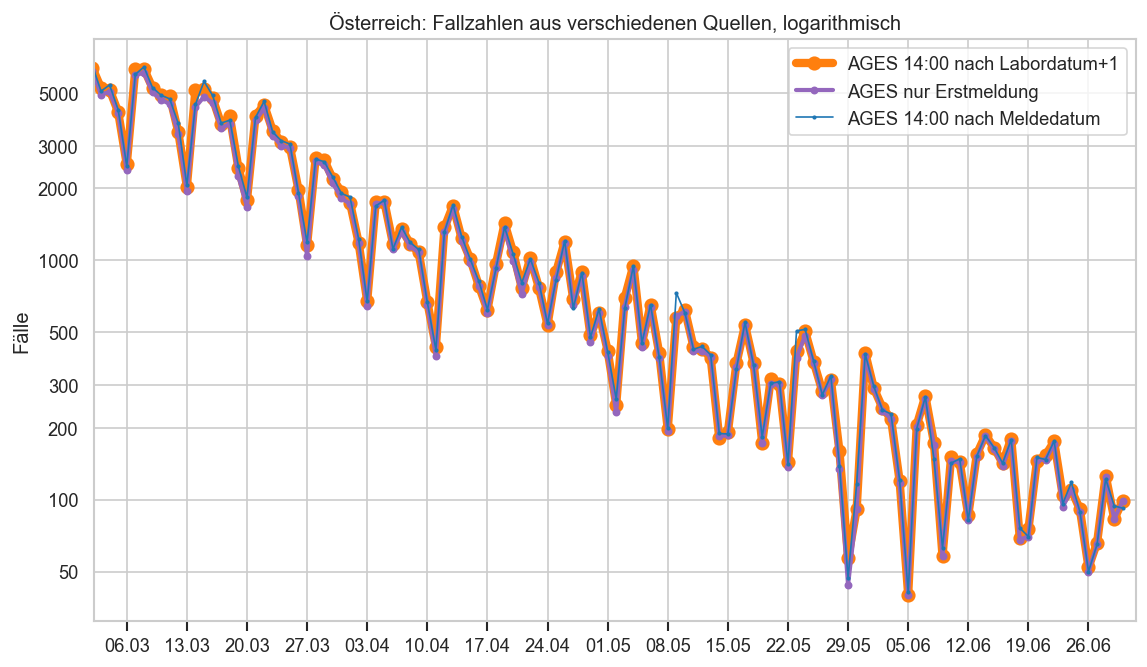
ages1i = ages1.set_index(["Datum", "Bundesland"]).sort_index()
fsi = fs.set_index(["Datum", "Bundesland"]).sort_index().iloc[-len(ages1i):]
diff = (fsi[["AnzahlFaelle7Tage"]] / ages1i[["AnzahlFaelle7Tage"]])
diff = diff[diff.index.get_level_values("Datum") <= diff.index.get_level_values("Datum")[-1] - timedelta(7)]
#display(diff)
ax = diff.groupby(level="Bundesland").mean().plot.barh(legend=False)
ax.xaxis.set_major_formatter(matplotlib.ticker.PercentFormatter(xmax=1, decimals=0))
ax.set_xlim(left=0.95, right=1.05)
ax.axvline(1, color="k")
ax.set_title("Fälle inklusive aller Nachmeldungen als Anteil der Erstmeldung ‒ Wochensummen");
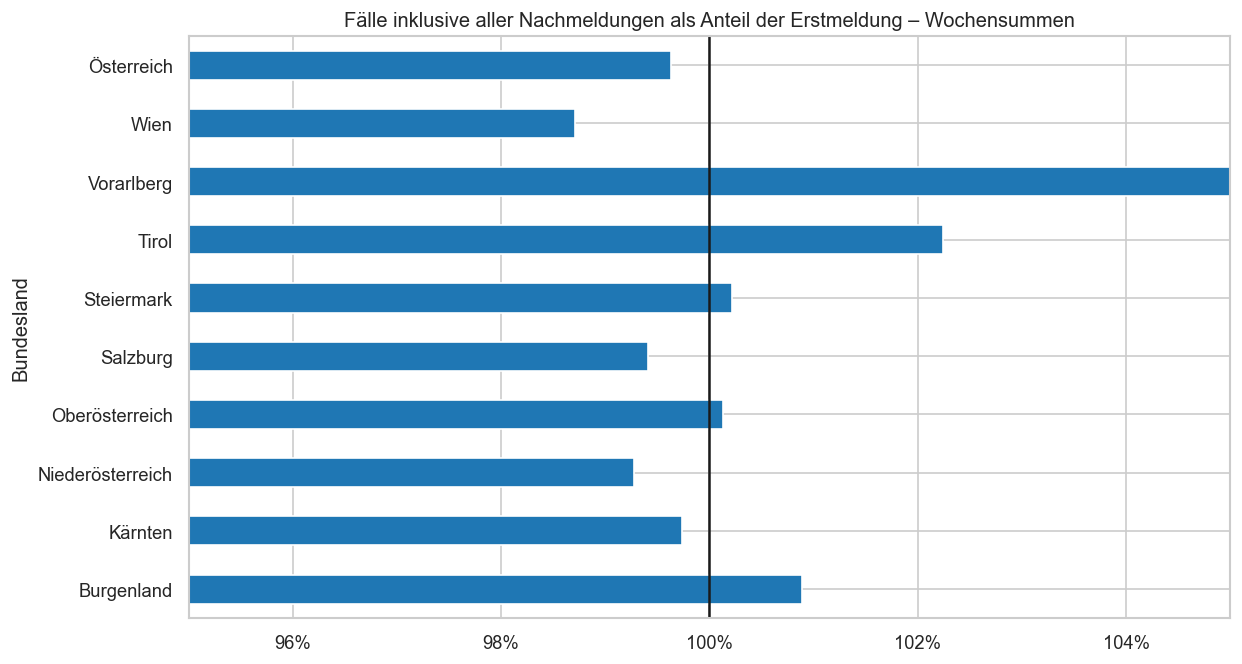
if DISPLAY_SHORTRANGE_DIAGS:
cov=reload(cov)
ndays = DETAIL_NDAYS
selbl="Österreich"
#fig, ax = plt.subplots()
old, new = ages_old, fs
#old, new = ages_old2, ages_old
#old, new = agd_sums_old.query("Bundesland == 'Österreich' and Altersgruppe != 'Alle'"), agd_sums.query("Bundesland == 'Österreich' and Altersgruppe != 'Alle'")
fig, axs = cov.plt_mdiff(
new,#.query("Datum < '2020-04-20'"),
old,#.query("Datum < '2020-04-20'"),
#"Altersgruppe",
"Bundesland",
vcol="AnzahlFaelle",
rwidth=1, ndays=ndays, logview=False, name="Fälle", color=(0.4, 0.4, 0.4), sharey=False)#, vcol="AnzahlFaelle", name="Fälle")
#cov.set_date_opts(ax)#, fs_oo.index[-ndays:] if ndays else fs_oo.index, showyear=True)
#cov.set_logscale(ax)
fig.suptitle(f"Gefundene COVID-Fälle in {selbl}" + (AGES_STAMP if new is fs else f" (AGES {new.iloc[-1]['FileDate'].strftime('%a %d.%m.%y')})"), y=0.95)
cov.stampit(fig)
cov.filterlatest(mmx)[["Bundesland", "AnzahlFaelle"]]
| Bundesland | AnzahlFaelle | |
|---|---|---|
| 997 | Burgenland | 3 |
| 1995 | Kärnten | 1 |
| 2993 | Niederösterreich | 19 |
| 3991 | Oberösterreich | 13 |
| 4989 | Salzburg | 2 |
| 5987 | Steiermark | 4 |
| 6985 | Tirol | 3 |
| 7983 | Vorarlberg | 1 |
| 8981 | Wien | 54 |
| 9979 | Österreich | 100 |
#xs = fs_at.set_index(["Bundesland", "Datum"])["AnzahlFaelle"] - ages_old.query("Bundesland == 'Österreich'").set_index(["Bundesland", "Datum"])["AnzahlFaelle"]
#xs[(xs != 0) & np.isfinite(xs)].to_frame()
if False:
cov=reload(cov)
ndays = SHORTRANGE_NDAYS
selbl="Österreich"
#fig, ax = plt.subplots()
old, new = ages_old, fs
fig, ax = cov.plt_mdiff(
new,
old,
"Bundesland",
vcol="AnzahlFaelle",
rwidth=7, ndays=ndays, logview=False, name="Fälle", color=(0.4, 0.4, 0.4), sharey=False)#, vcol="AnzahlFaelle", name="Fälle")
#cov.set_date_opts(ax)#, fs_oo.index[-ndays:] if ndays else fs_oo.index, showyear=True)
#cov.set_logscale(ax)
fig.suptitle(f"7-Tage-Summe gefundener COVID-Fälle in {selbl}", y=0.95)
cov.stampit(fig)
import re
def mathbold(s):
return re.sub("[0-9]", lambda m: chr(ord("𝟬") + int(m[0])), s)
def print_case_stats(selbl="Österreich", ages1=ages1, fs=fs, lbl=""):
ages1_at = ages1.query(f"Bundesland == '{selbl}'")
agesrpt = ages1_at.assign(Tag=ages1_at["Datum"].dt.strftime("%A")).tail(16)[
["Datum", "Tag", "FileDate", "AnzahlFaelleMeldeDiff", "AnzahlFaelle"]].set_index("Datum")
agesrpt["AnzahlFaelleNeu"] = fs[fs["Bundesland"] == selbl].set_index("Datum")["AnzahlFaelle"]
#display(agesrpt)
offset = -1
rptday = agesrpt.iloc[offset]["Tag"]
rptday_s = agesrpt.index[offset].strftime("%a")
mday = agesrpt.iloc[offset]["FileDate"].strftime("%A")
agesrpt = agesrpt.loc[agesrpt["Tag"] == rptday]
agesrpt.sort_index(ascending=False, inplace=True)
print(f"#COVID19at Fallzahlen am {mday} ({selbl}{lbl}/AGES):\n")
hasnmark = False
isfirst = True
for _, rec in agesrpt.iterrows():
nmark = "" if rec["AnzahlFaelleMeldeDiff"] >= rec["AnzahlFaelle"] else "*"
hasnmark = hasnmark or nmark
fz = f"{rec['AnzahlFaelleMeldeDiff']:+.0f}"
#if isfirst:
# fz = mathbold(fz)
print(
"‒", rec["FileDate"].strftime("%d.%m") + ".:",
f"{fz}{nmark}{' gesamt' if isfirst else ''},",
f"{rec['AnzahlFaelle']:.0f} {'für ' + rptday if isfirst else rptday_s}"
+ (f" (Stand heute: {rec['AnzahlFaelleNeu']:.0f})"
if rec['AnzahlFaelleNeu'] != rec['AnzahlFaelle'] else ""))
isfirst = False
if hasnmark:
print(" *negative Nachmeldungen")
posrates = cov.filterlatest(mmx).query("Bundesland != 'Österreich'")["PCRRPosRate_a7"]
posrates = posrates[np.isfinite(posrates)]
#display(posrates.to_frame())
#display(ages1m[ages1m["Datum"] == agesrpt.iloc[0]["FileDate"]])
if posrates.median() >= 0.1:
print(f"\n⚠ 7-T-PCR-Positivrate aktuell {posrates.median() * 100:.2n}% im Median der BL ⇒ hohe Dunkelziffer")
print_case_stats()
print_case_stats("Österreich", agd1_sums.query("Altersgruppe == '5-14'"), agd_sums.query("Altersgruppe == '5-14'"), " 5-14")
#COVID19at Fallzahlen am Freitag (Österreich/AGES):
‒ 30.06.: +92* gesamt, 99 für Donnerstag
‒ 23.06.: +96, 93 Do. (Stand heute: 104)
‒ 16.06.: +142, 138 Do. (Stand heute: 142)
*negative Nachmeldungen
#COVID19at Fallzahlen am Freitag (Österreich 5-14/AGES):
‒ 30.06.: +0* gesamt, 3 für Donnerstag
‒ 23.06.: +2, 2 Do.
‒ 16.06.: +2, 2 Do.
*negative Nachmeldungen
An welchen Tagen werden die meisten Fälle gemeldet?¶
Im Folgenden wird über die letzen 100 Tage der Durchschnitt neu gemeldeter Fälle pro Woche berechnet und dann für jeden Wochentag welcher Anteil dieses Durchschnitts im Durchschnitt an diesem Wochentag gemeldet werden.
def plt_distribution(src: pd.DataFrame, name: str, n_days: int, ax: plt.Axes, vcol="AnzahlFaelle", plt_args=None):
src = src.query("Bundesland == 'Österreich'").copy()
src["s7"] = src[vcol].where(src[vcol] >= 0).fillna(0).rolling(7).sum()
src = src.iloc[-n_days:].set_index("Datum")
days = ['Mo.','Di.', 'Mi.', 'Do.','Fr.','Sa.', 'So.']
#days.reverse()
contrib = (src[vcol].clip(lower=0) / src["s7"]).rename("Anteil").to_frame()
#contrib = contrib[np.isfinite(contrib)]
contrib["Wochentag"] = contrib.index.strftime("%a")
contrib["daynum"] = contrib.index.weekday
contrib.sort_values(by="daynum", inplace=True)
contrib["d"] = (contrib.index - contrib.index.min()).days
contrib_m = contrib.groupby("Wochentag", sort=False)["Anteil"].mean()
print(len(contrib["Anteil"][np.isfinite(contrib["Anteil"])]))
#daysums = src.iloc[-n_days:].sum()
#display(daysums[["AnzahlFaelle"]])
#daysums.sort_index(inplace=True, key=)
ax.set_title(name)
#daysums.plot(y="AnzahlFaelleNorm", kind="barh", title=name, legend=False, ax=ax)
#contrib_m.plot(kind="barh", title=name, legend=False, ax=ax, **(plt_args or {}))
#sns.boxplot(data=contrib, ax=ax, order=days, x="Anteil", y="Wochentag", **(plt_args or {"color": "C0"}))
sns.scatterplot(
data=contrib,
ax=ax, x="Anteil", y="Wochentag", hue="d", legend=False, palette=cov.un_l_cmap,
**(plt_args or {"color": "C0"}))
ax.plot(contrib_m, contrib_m.index, marker="|", **(plt_args or {}), markersize=14, mew=3)
ax.axvline(x=(1/7), color="grey")
ax.get_xaxis().set_major_formatter(matplotlib.ticker.PercentFormatter(xmax=1, decimals=0))
#ax.set_xlim(left=0.5, right=1.5)
n_days = 7*15
fig, axs = plt.subplots(figsize=(10, 5), ncols=2, nrows=2, sharey=True, sharex=True)
fig.suptitle(f"Verteilung der Fälle auf die Wochentage (letzte {n_days} Tage) in %, Schnitt der Wochen", y=0.85)
fig.subplots_adjust(top=0.75, wspace=0.1)
plt_distribution(ems.query("Bundesland == 'Österreich'"), "EMS 8:00", n_days, axs[0][0])
plt_distribution(mms.query("Bundesland == 'Österreich'"), "BMI 9:30", n_days, axs[0][1])
#plt_distribution(fs_at, "AGES", axs[2], 0)
plt_distribution(ages1m, "AGES 14:00-Meldesumme", n_days, axs[1][0])
plt_distribution(fs_at, "AGES nach Labordatum", n_days, axs[1][1])
for ax in axs.flat:
ax.tick_params(labelleft=True, pad=0)
ax.set_xlim(left=0.05)
for ax in axs.flat:
if ax not in axs[-1]:
ax.set_xlabel(None)
if ax not in axs.T[0]:
ax.set_ylabel(None)
fig, axs = plt.subplots(figsize=(10, 5), ncols=3, nrows=1, sharey=True, sharex=True)
fig.suptitle(f"Verteilung der Todesfälle auf die Wochentage (letzte {n_days} Tage) in %, Schnitt der Wochen", y=0.85)
fig.subplots_adjust(top=0.75, wspace=0.2)
plt_args = dict(color="k")
plt_distribution(mms.query("Bundesland == 'Österreich'"), "BMI 9:30", n_days, axs[0], vcol="AnzahlTot", plt_args=plt_args)
#plt_distribution(fs_at, "AGES", axs[2], 0)
plt_distribution(ages1m, "AGES 14:00-Meldesumme", n_days, axs[1], vcol="AnzahlTot", plt_args=plt_args)
plt_distribution(fs_at, "AGES nach Todesdatum", n_days, axs[2], vcol="AnzahlTot", plt_args=plt_args)
for ax in axs.flat:
ax.tick_params(labelleft=True, pad=0)
ax.set_xlim(left=0, right=0.37)
for ax in axs.flat[1:]:
ax.set_ylabel(None)
#ax.tick_params(labelleft=False, pad=0)
a1m_oo = ages1m.query("Bundesland == 'Österreich'").set_index("Datum")
a1m_oo["AnzahlTot"][a1m_oo["AnzahlTot"] < 0], a1m_oo["AnzahlTot"][a1m_oo["AnzahlTot"] >= a1m_oo["AnzahlTot"].max()]
105 105 105 105 105 105 105
(Datum 2021-08-26 -2.0 2021-08-27 -3.0 2021-08-31 -15.0 2022-05-11 -12.0 2022-09-13 -56.0 2022-10-22 -89.0 2022-12-04 -1.0 2023-06-07 -1.0 Name: AnzahlTot, dtype: float64, Datum 2022-04-20 3108.0 Name: AnzahlTot, dtype: float64)
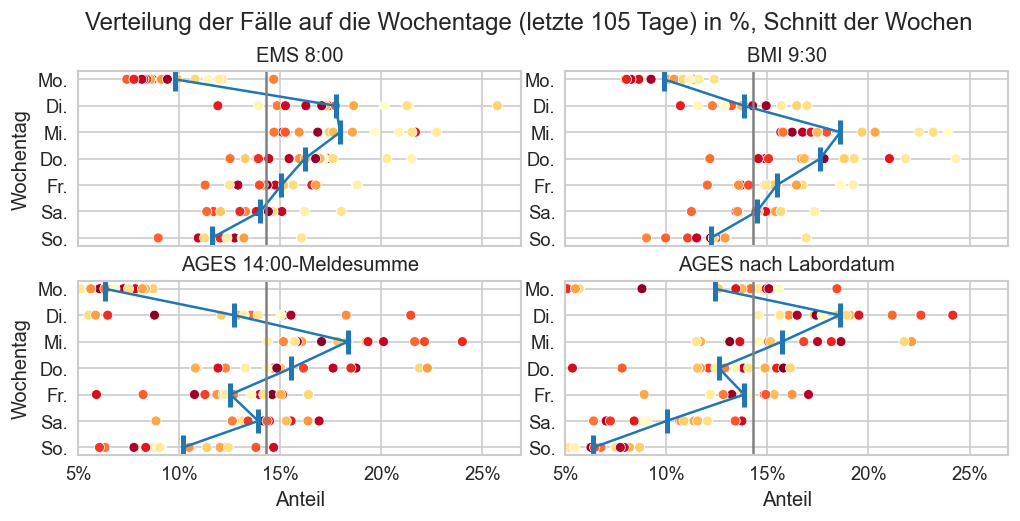
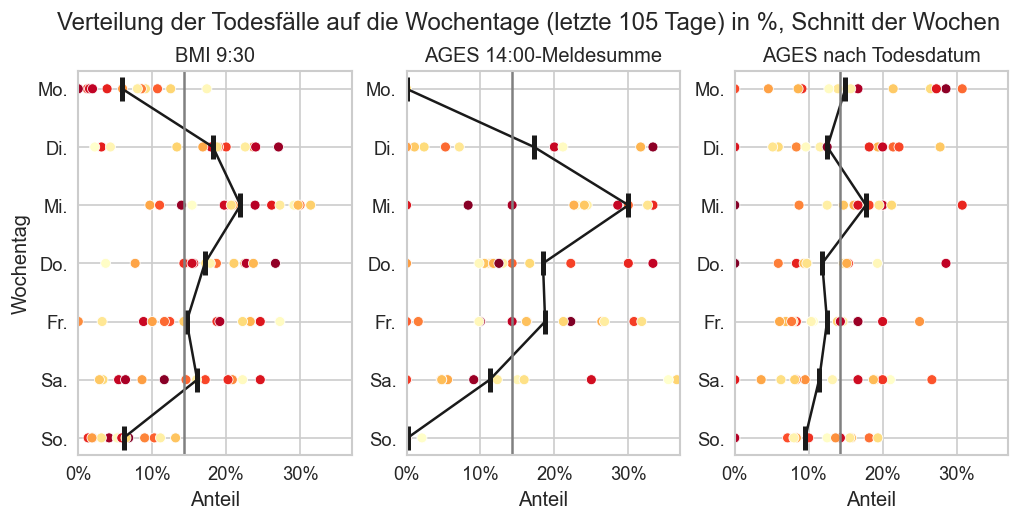
mms.iloc[-1]["AnzahlFaelle"] / 0.8 * 1.2
3861.0000
def plt_by_weekday(fs_at, ttl, uselog=True):
fig, ax = plt.subplots()
wds = ["Montag", "Dienstag", "Mittwoch", "Donnerstag", "Freitag", "Samstag", "Sonntag"]
ax.plot(fs_at["Datum"], fs_at["AnzahlFaelle"], lw=5, alpha=0.2, color="k")
for i in range(7):
fs_at_d = fs_at[fs_at["Datum"].dt.weekday == i].set_index("Datum")
ax.plot(fs_at_d["AnzahlFaelle"], label=wds[i], marker=cov.MARKER_SEQ[i], lw=1)
last = fs_at_d.iloc[-1]
#ax.annotate(
# f"{wds[i][:2]} {last['AnzahlFaelle'] / 1000:.0f}k",
# (last.name, last["AnzahlFaelle"]),
# xytext=(5, 0), textcoords='offset points', fontsize="xx-small")
ax.legend()
cov.set_date_opts(ax, fs_at["Datum"].iloc[7:], showyear=True)
fig.autofmt_xdate()
#ax.set_xlim(right=ax.get_xlim()[1] + 7)
if uselog:
cov.set_logscale(ax)
else:
ax.set_ylim(bottom=0)
#ax.set_ylim(bottom=500)
#ax.set_ylim(bottom=0)
bl = fs_at.iloc[0]["Bundesland"]
ax.set_title(f"{bl}: Neue Fälle je Wochentag{ttl}")
return fig, ax
#plt_by_weekday(mms.query("Bundesland == 'Österreich'").iloc[-100:], " ‒ 9:30 Krisenstabmeldung")
#plt_by_weekday(mms.query("Bundesland == 'Oberösterreich'").iloc[-100:], " ‒ 9:30 Krisenstabmeldung")
#plt_by_weekday(ems.query("Bundesland == 'Österreich'").iloc[-100:], " ‒ 8:00 EMS")
plt_by_weekday(ages1m.query("Bundesland == 'Österreich'").iloc[-MIDRANGE_NDAYS - 7:], ", logarithmisch ‒ AGES nach Meldedatum")
if False:
plt_by_weekday(ages1m.query("Bundesland == 'Wien'").iloc[-MIDRANGE_NDAYS - 7:], " ‒ AGES nach Meldedatum", uselog=False)
plt_by_weekday(fs.query("Bundesland == 'Oberösterreich'").iloc[-MIDRANGE_NDAYS - 7:], ", logarithmisch ‒ AGES nach Labordatum")
#plt_by_weekday(ages1m.query("Bundesland == 'Österreich'").iloc[-100:], " ‒ AGES nach Meldedatum")
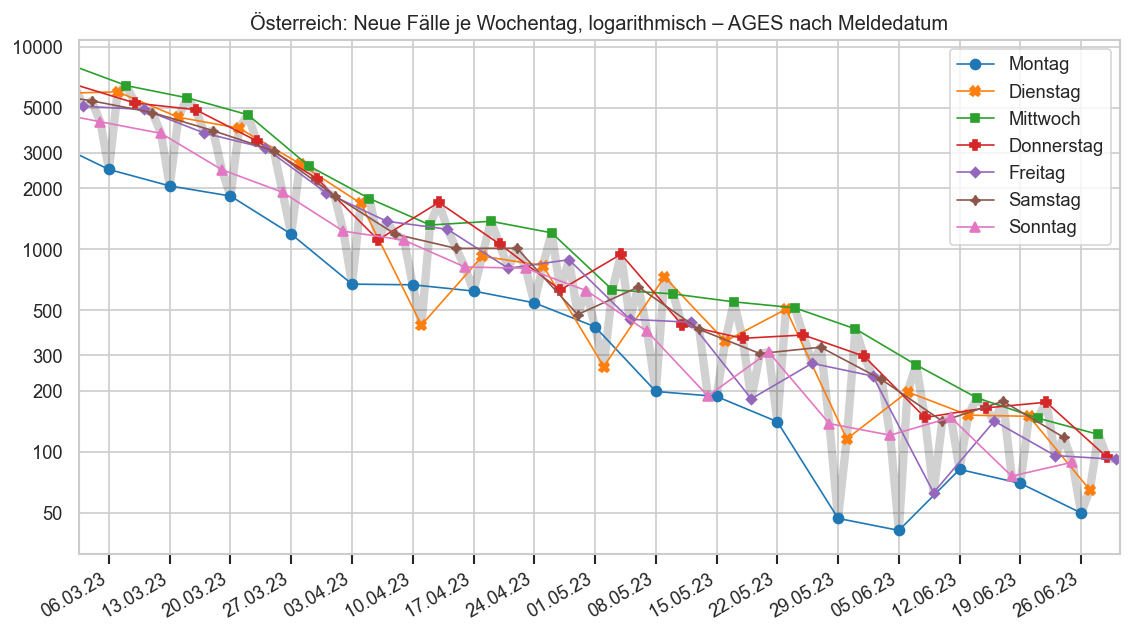
cov=reload(cov)
def make_wowg_diag(
src,
stamp,
ax: plt.Axes,
ccol="AnzahlFaelle",
label="Neuinfektionen",
ndays=7*3,
pltdg=True,
pltg7=True):
fsdata = src.copy()
#fsdata = mms.query("Bundesland == 'Österreich'").copy()
fsdata["inz"] = fsdata[ccol].rolling(7).sum() #cov.calc_inz(fsdata, ccol)
cov.enrich_inz(fsdata, catcol="Bezirk" if "Bezirk" in src.columns else "Bundesland", dailycol=ccol)
fsdata[ccol + "_a7"] = fsdata[ccol].clip(lower=0).rolling(7).mean()
fsdata["inz_g7"] = fsdata[ccol + "_a7"] / fsdata[ccol + "_a7"].shift(7)
fsdata["Datum"] = fsdata["Datum"].dt.normalize()
fsdata = fsdata.iloc[-ndays - 1:]
display(stamp, fsdata[[ccol, ccol + "_a7", "inz_g7", "inz_dg7"]].iloc[-1])
#fsdata = fs_at.copy()
#display(fsdata.dtypes)
#ax = fig.subplots()
ax.set_ylabel(label)
ax.set_title(stamp)
if pltg7 or pltdg:
ax2 = ax.twinx()
ax2.grid(False)
ax2.set_ylabel("Anstieg ggü. 7 Tage vorher")
if pltdg:
ax2.plot(
fsdata["Datum"],
fsdata["inz_dg7"] - 1,
#drawstyle="steps-mid",
color="k",
alpha=0.7,
label="Anstieg Wochentagswert (rechte Skala)",
marker="+")
if pltg7:
ax2.plot(
fsdata["Datum"],
fsdata["inz_g7"] - 1,
#drawstyle="steps-mid",
color="k",
ls=":",
alpha=0.7,
label="Anstieg Wochensumme (rechte Skala)",
marker="x"
#marker="D"
)
ax2.axhline(0, lw=0.5, color="k")
cov.set_percent_opts(ax2)
ax2.yaxis.set_major_locator(matplotlib.ticker.MaxNLocator(8))
else:
ax2 = None
ax.yaxis.set_major_locator(matplotlib.ticker.MaxNLocator('auto', integer=True))
#ax.set_yscale("log", base=2)
#ax.get_yaxis().set_major_locator(matplotlib.ticker.LogLocator(base=10.0, subs=(1.0, 0.5, 0.25)))
#ax.get_yaxis().set_major_formatter(matplotlib.ticker.ScalarFormatter())
#cmap = sns.color_palette(cov.div_l_cmap, as_cmap=True)
#cnorm = matplotlib.colors.TwoSlopeNorm(vcenter=1, vmax=2)
ax.bar(fsdata["Datum"], fsdata[ccol], color="k", label=label, linewidth=0, alpha=0.25)
ax.plot(
fsdata["Datum"],
fsdata[ccol + "_a7"],
color=(0.45,) * 3,
#linestyle="--",
label="7-Tage-Schnitt " + label,
lw=2,
ds="steps-mid")
#ax.fill_between(fsdata["Datum"], 0, fsdata["AnzahlFaelle"], color="darkgrey")
if False:
for weekday in fsdata["Datum"].dt.dayofweek.unique():
wkd = fsdata[fsdata["Datum"].dt.dayofweek == weekday]
ax.quiver(
wkd["Datum"].iloc[:-1],
wkd[ccol].iloc[:-1],
np.repeat(7, len(wkd) - 1),
(wkd[ccol] - wkd[ccol].shift(1)).iloc[1:],
color=cmap(cnorm(wkd["inz_dg7"].iloc[1:])),
units="xy",
angles="xy",
scale_units="xy",
scale=1,
width=wkd[ccol].max() / 500,
#headlength=2,
zorder=2)
#ax.set_ylim(bottom=500)
cov.set_date_opts(ax, fsdata["Datum"])
ax.set_xlim(fsdata["Datum"].iloc[0] - timedelta(0.5), fsdata["Datum"].iloc[-1] + timedelta(0.5))
#ax.set_xticks(ax.get_xticks() + 0.5)
#ax.get_yaxis().set_major_formatter(matplotlib.ticker.FormatStrFormatter("%.0f"))
ax.yaxis.set_minor_locator(matplotlib.ticker.AutoMinorLocator())
ax.grid(which="minor", axis="y", lw=1/3)
ax.tick_params(left=False, which="both")
return ax2
def same_axlims(axs, axs2, maxg=2, maxy=None, minbottom=None):
if axs2:
top = min(maxg, max(ax.get_ylim()[1] for ax in axs2))
bottom = max(-1.1, min(ax.get_ylim()[0] for ax in axs2))
for ax in axs2:
ax.set_ylim(bottom, top)
#ax.set_ylim(-0.2, 1)
left=max(ax.get_xlim()[0] for ax in axs) + 1
right=max(ax.get_xlim()[1] for ax in axs)
top = max(ax.get_ylim()[1] for ax in axs)
if maxy is not None:
top = min(maxy, top)
bottom = min(ax.get_ylim()[0] for ax in axs)
if minbottom is not None:
bottom = max(bottom, minbottom)
for ax in axs:
ax.set_xlim(left, right)
ax.set_ylim(bottom, top)
def make_wowg_figs(bl, maxg=2, ndays=7*3):
fig = plt.Figure(figsize=(16 * 0.5, 8))
fig.suptitle(bl + ": Positive Tests nach Meldedatum", y=0.96)
fig.subplots_adjust(hspace=0.4)
axs = fig.subplots(nrows=3, sharey=True)
axs2 = []
#make_wowg_diag(fs_at, AGES_STAMP, axs[0])
#ems0 = ems.query("Bundesland == 'Österreich'").copy()
#mask = ems0["Datum"].dt.normalize().dt.tz_localize(None).isin(list(map(pd.to_datetime, ["2021-11-14", "2021-11-15"])))
#display(mask)
#display(mask.any())
#assert mask.any()
#ems0.loc[mask, "AnzahlFaelle"] = ems0.loc[mask, "AnzahlFaelle"].mean()
#ems0["inz"] = cov.calc_inz(ems0)
#cov.enrich_inz(ems0, catcol="Bundesland")
axs2.append(make_wowg_diag(ems[ems["Bundesland"] == bl],
"EMS " + ems.iloc[-1]["Datum"].strftime("%a %x"), axs[len(axs2)],
ndays=ndays))
fig.legend(frameon=False, ncol=2, loc="upper center", bbox_to_anchor=(0.5, 0.95), fontsize=8)
axs2.append(make_wowg_diag(
mms[mms["Bundesland"] == bl], "BMI " + mms.iloc[-1]["Datum"].strftime("%a %x"), axs[len(axs2)],
ndays=ndays))
axs2.append(make_wowg_diag(
ages1m[ages1m["Bundesland"] == bl], "AGES Meldesumme " + ages1m.iloc[-1]["Datum"].strftime("%a %x"), axs[len(axs2)],
ndays=ndays))
def fixup_axes(fig, axs, axs2):
same_axlims(axs, axs2, maxg=maxg)
#cov.stampit(fig, cov.DS_BOTH)
fixup_axes(fig, axs, axs2)
display(fig)
fig = plt.Figure()
axs = fig.subplots(nrows=2, sharey=True)
axs2 = []
fig.subplots_adjust(hspace=0.3)
axs2.append(make_wowg_diag(fs[fs["Bundesland"] == bl], "Inklusive Nachmeldungen", axs[len(axs2)], ndays=ndays))
fig.legend(frameon=False, ncol=2, loc="upper center", bbox_to_anchor=(0.5, 1))
axs2.append(make_wowg_diag(ages1[ages1["Bundesland"] == bl], "Nur Erstmeldungen", axs[len(axs2)], ndays=ndays))
fig.suptitle(bl + ": Positive Tests nach Labordatum" + AGES_STAMP, y=1.025)
#ax.set_xlim(left=ax.get_xlim()[0] + 7)
#ax.set_title(None);
fixup_axes(fig, axs, axs2)
display(fig)
#fs.query("Bundesland == 'Österreich'")["AnzahlFaelle"].rolling(7).mean().tail(3)
if DISPLAY_SHORTRANGE_DIAGS:
make_wowg_figs("Österreich", maxg=1.1, ndays=DETAIL_NDAYS)
if DISPLAY_SHORTRANGE_DIAGS:
make_wowg_figs("Vorarlberg", maxg=2, ndays=DETAIL_NDAYS)
cases = fs.query("Bundesland == 'Österreich'").set_index("Datum")["AnzahlFaelle"]
#ismax = (cases > cases.shift().cummax()).rename("ismax")
pd.DataFrame(dict(cases=cases))
fig, ax = plt.subplots()
ax.plot(cases)
#ax.plot(cases[ismax], marker=".", lw=0)
#display(len(cases[ismax]))
ax.figure.suptitle("Tägliche COVID-Fälle & Allzeit-Maxima" + AGES_STAMP, y=0.93);
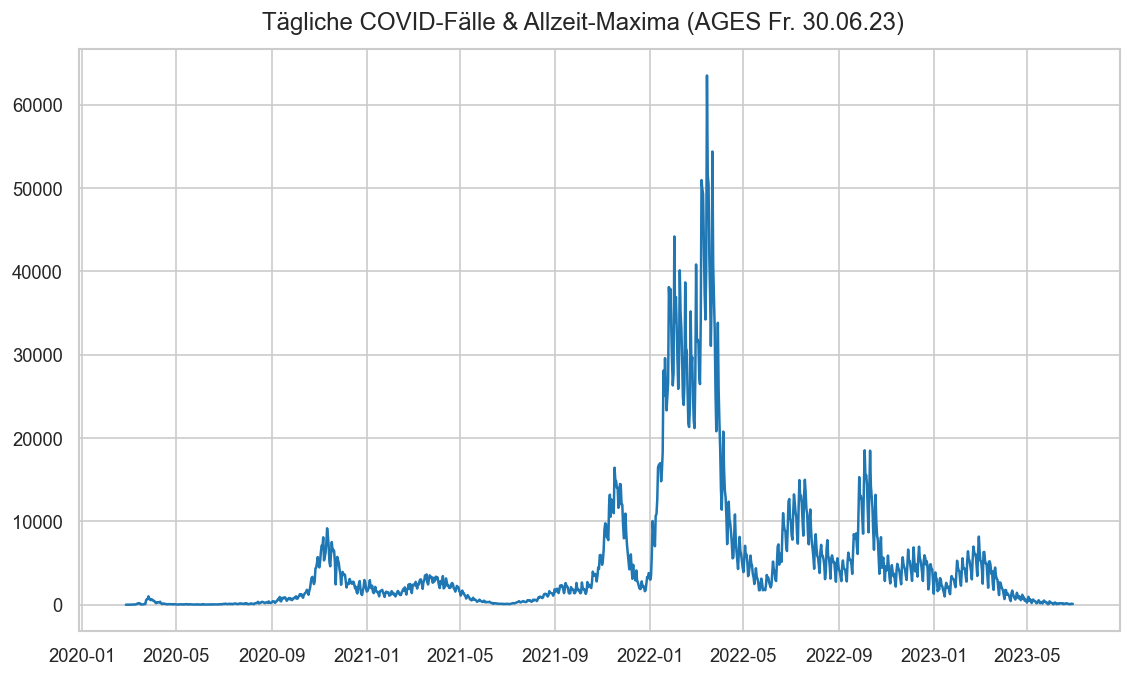
def plt_minmax(fs_at):
fig, ax = plt.subplots()
ax.plot(fs_at.set_index("Datum")["AnzahlFaelle"].rolling(7).min())
ax.plot(fs_at.set_index("Datum")["AnzahlFaelle"].rolling(7).max())
ax.plot(fs_at.set_index("Datum")["AnzahlFaelle"].rolling(7).median())
ax.plot(fs_at.set_index("Datum")["AnzahlFaelle"].rolling(7).mean())
cov.set_logscale(ax)
ax.set_ylim(bottom=50)
fig.suptitle("COVID-Fälle: Min, max, median, avg" + AGES_STAMP, y=0.93)
plt_minmax(fs.query("Bundesland == 'Österreich'"))

def draw3pt():
fig, axs = plt.subplots(nrows=3, sharex=True)
fig.subplots_adjust(hspace=0.05)
data = fs_at.set_index("Datum")["inz"]
fig.suptitle(fs_at.iloc[0]["Bundesland"] + ": 7-Tage-Inzidenz / 100.000 EW in 3 Stufen" + AGES_STAMP, y=0.93)
for cl, ax in zip(("C3", "C1", "C0"), axs.flat):
ax.plot(data, lw=2, color=cl)
ax.fill_between(matplotlib.dates.date2num(data.index), 0, data.to_numpy(), color=cl, lw=0, alpha=0.3)
#data.quantile(0.995) * 1.1
axs[0].set_ylim(500, 5000)
axs[0].yaxis.set_major_locator(matplotlib.ticker.MultipleLocator(1000))
axs[0].set_ylabel("Extrem")
axs[1].set_ylim(50, 500)
axs[1].yaxis.set_major_locator(matplotlib.ticker.MultipleLocator(100))
axs[1].set_ylabel("Hoch")
axs[2].set_ylim(0, 50)
axs[2].set_ylabel("Gewöhnlich")
axs[2].yaxis.set_major_locator(matplotlib.ticker.MultipleLocator(10))
cov.set_date_opts(axs[2], showyear=True)
fig.autofmt_xdate()
draw3pt()
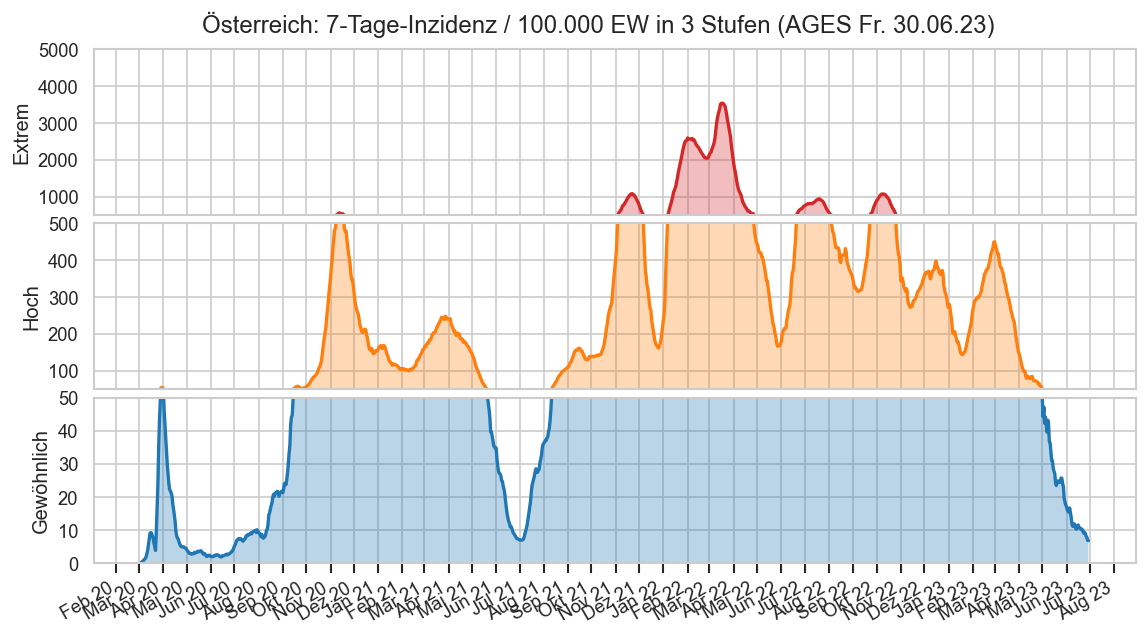
Kürzliche Negativmeldungen in Bundesländermeldungen¶
#mms[mms["AnzahlFaelle"] < 0].query("Datum >= '2022-03-01T00:00+2'")
mms[mms["AnzahlFaelle"] < 0].query("Datum >= '2022-03-01'")[["Datum", "Bundesland", "AnzahlFaelle"]]
| Datum | Bundesland | AnzahlFaelle | |
|---|---|---|---|
| 4347 | 2022-04-25 | Vorarlberg | -7.0 |
Kürzliche Negativmeldungen im EMS¶
ems[ems["AnzahlFaelle"] < 0].query("Datum >= '2022-03-01T00:00+01:00'")[["Datum", "Bundesland", "AnzahlFaelle"]]
| Datum | Bundesland | AnzahlFaelle | |
|---|---|---|---|
| 4466 | 2022-05-21 08:00:00+02:00 | Tirol | -12.0 |
| 4496 | 2022-05-24 08:00:00+02:00 | Tirol | -119.0 |
def trend_indicator(fsbl, i):
if i < 0:
i = len(fsbl) +i
lastinz = fsbl.iloc[i]['inz']
inzd = lastinz - fsbl.iloc[i - 1]["inz"]
inzd7 = lastinz - fsbl.iloc[i - 7]["inz"]
cur = fsbl.iloc[i]
prev = fsbl.iloc[i - 1]
last3 = fsbl.iloc[i - 2:i + 1]
last5 = fsbl.iloc[i - 4:i + 1]
last7 = fsbl.iloc[i - 6:i + 1]
n_up = (last3["inz_dg7"] > 1).sum()
if not (
inzd < 0 and
cur["inz_g7"] <= last3["inz_g7"].min() and
cur["inz_dg7"] <= last5["inz_dg7"].min()
) and (
n_up >= 2 and
cur["inz_g7"] > 1.01 or
n_up >= 3 and
cur["inz_g7"] > 0.95 and cur["inz_dg7"] > 1.05 and
cur["inz_g7"] == last7["inz_g7"].max()):
if inzd > 0 and (cur["inz_g7"] > last3["inz_g7"].min() and cur["inz_g7"] > 1.1 or
cur["inz_g7"] > 1.5): # and lastg1 > 0.5:
return 'grow'
return 'slowgrow'
if not (
inzd > 0 and
cur["inz_g7"] >= last3["inz_g7"].max() and
cur["inz_dg7"] >= last5["inz_dg7"].max()
) and (
n_up < 2 and
cur["inz_g7"] < 0.99 or
n_up == 0 and
cur["inz_g7"] < 1.05 and
cur["inz_dg7"] < 0.95 and
cur["inz_g7"] == last7["inz_g7"].min()):
if inzd < 0 and (cur["inz_g7"] < last3["inz_g7"].max() and cur["inz_g7"] < 0.9 or
cur["inz_g7"] < 0.5): # and lastg1 < 1.5:
return 'shrink'
return 'slowshrink'
return 'unclear'
def set_hls(c, *args, **kwargs):
res = sns.set_hls_values(c, *args, **kwargs)
return tuple(min(1., max(0., c)) for c in res)
omicronbegdate=pd.to_datetime("2022-05-01")
def plt_per_cat_inz(fs=fs, stamp=AGES_STAMP, catcol="Bundesland", fromdate=omicronbegdate, ndays=DETAIL_NDAYS):
catlist = fs[catcol].unique()
fig, axs = plt.subplots(nrows=(len(catlist) + 1) // 2, ncols=2, sharex=True, sharey=True, figsize=(9, 9))
fig.suptitle("SARS-CoV-2-Fälle" + stamp, y=1)
colors = dict(
grow = (1, 0.85, 0.85),
shrink = (0.85, 0.85, 1),
slowgrow = (1, 1, 0.85),
slowshrink = (0.92, 1, 1),
unclear = (1, 1, 1)
)
for ax, bl in zip(axs.flat, catlist):
fsbl = fs[fs[catcol] == bl]
fsbl = fsbl[fsbl["Datum"] > fsbl["Datum"].iloc[-1] - timedelta(ndays)]
bs = ax.bar(
fsbl["Datum"], fsbl["AnzahlFaelle"] / fsbl["AnzEinwohner"] * 100_000 * 7, color="k", lw=0,
label="Einzel-Tageswert × 7", alpha=0.5, aa=True, snap=False)
ls = ax.plot(fsbl["Datum"], fsbl["inz"], label="7-Tage-Inzidenz", color="k")
if ax is axs[0][0]:
legend = fig.legend(
handles=[
bs,
ls[0],
matplotlib.patches.Patch(color=colors['grow'], label='Steigend > 10%/Wo. & nicht bremsend'),
matplotlib.patches.Patch(color=colors['slowgrow'], label='Eher steigend'),
matplotlib.patches.Patch(color=colors['shrink'], label='Sinkend > 10%/Wo. & nicht bremsend'),
matplotlib.patches.Patch(color=colors['slowshrink'], label='Eher sinkend'),
],
loc="upper center", frameon=False, ncol=3, bbox_to_anchor=(0.5, 0.99), fontsize="small",
title=f"Beschriftung: {catcol}: 7-Tage-Inzidenz/100.000 EW"
" (± Änderung Vortag/± Änderung Vorwoche)")
plt.setp(legend.get_title(), fontsize='small')
elif ax is axs.flat[-1]:
ax.set_ylim(bottom=0)
#fig.text(0.5, 0.9, "foo", fontsize="small", "Ste")
for i, bar in enumerate(bs):
bar.set_color(set_hls(colors[trend_indicator(fsbl, i)], l=0.3))
#ax.axhline(1, color="k")
#ax.set_ylim(top=3, bottom=0.5)
lastinz = fsbl.iloc[-1]['inz']
ax.axhline(lastinz, color="k", lw=0.5, zorder=1)
inzd = lastinz - fsbl.iloc[-2]["inz"]
inzd7 = lastinz - fsbl.iloc[-1 - 7]["inz"]
ax.set_title(f"{bl}: {lastinz:.0f} ({inzd:+.0f}/{inzd7:+.0f})", y=0.97)
ax.yaxis.set_major_locator(matplotlib.ticker.MaxNLocator(7))
if ax in axs[-1]:
cov.set_date_opts(ax, fsbl["Datum"].iloc[1:], showday=False)
ax.set_xlim(right=ax.get_xlim()[1] + 1)
#ax.set_xlim(left=fsbl["Datum"].iloc[0])
ax.set_facecolor(colors[trend_indicator(fsbl, -1)])
if ax in axs.T[0]:
#ax.yaxis.set_major_formatter(matplotlib.ticker.FuncFormatter(lambda v, _: f"×{v:.0f}"))
ax.set_ylabel("Fälle/100.000")
#ax.xaxis.set_major_locator(matplotlib.dates.MonthLocator(interval=3))
fig.subplots_adjust(wspace=0.05, hspace=0.25)
fig.autofmt_xdate()
return fig, axs
#fig.autofmt_xdate()
#plt_per_cat_inz(ems, " ‒ EMS nach Meldedatum", #fromdate=pd.to_datetime("2021-11-01")
# )
#raise
if DISPLAY_SHORTRANGE_DIAGS:
plt_per_cat_inz(ages1mx.reset_index(), " ‒ AGES nach Meldedatum 14-T") #fromdate=pd.to_datetime("2021-11-01"))
#axs = plt_per_cat_inz(mms, " ‒ BMI nach Meldedatum", #fromdate=pd.to_datetime("2021-11-01")
# )[1]
#for ax in axs.flat:
# cov.set_logscale(ax)
# ax.set_ylim(bottom=50)
# ax.yaxis.set_major_locator(matplotlib.ticker.LogLocator(base=10, subs=[0.3, 1]))
if False:
plt_per_cat_inz(ages1m, " ‒ AGES nach Meldedatum")
#plt_ag_sep(uselog=True)
#fig.text(0, 0.)
#plt_per_cat_inz(fs[fs["Datum"] != fs["Datum"].iloc[-1]], " ‒ AGES nach Labordatum (ohne neuesten Tag)")
if DISPLAY_SHORTRANGE_DIAGS:
for ax in plt_per_cat_inz(fs, " ‒ AGES nach Labordatum (inkl. neuestem Tag)",)[1].flat:
#cov.set_logscale(ax)
#ax.set_ylim(bottom=50)
#ax.yaxis.set_major_locator(matplotlib.ticker.LogLocator(base=10, subs=[0.3, 1]))
pass
plt.plot(fs_at["Datum"], fs_at["inz"])
ax = plt.gca()
ax.set_ylim(bottom=100)
ax.set_xlim(left=pd.to_datetime("2020-10-01"))
cov.set_logscale(ax)
cov.set_date_opts(ax)
ax.figure.autofmt_xdate()
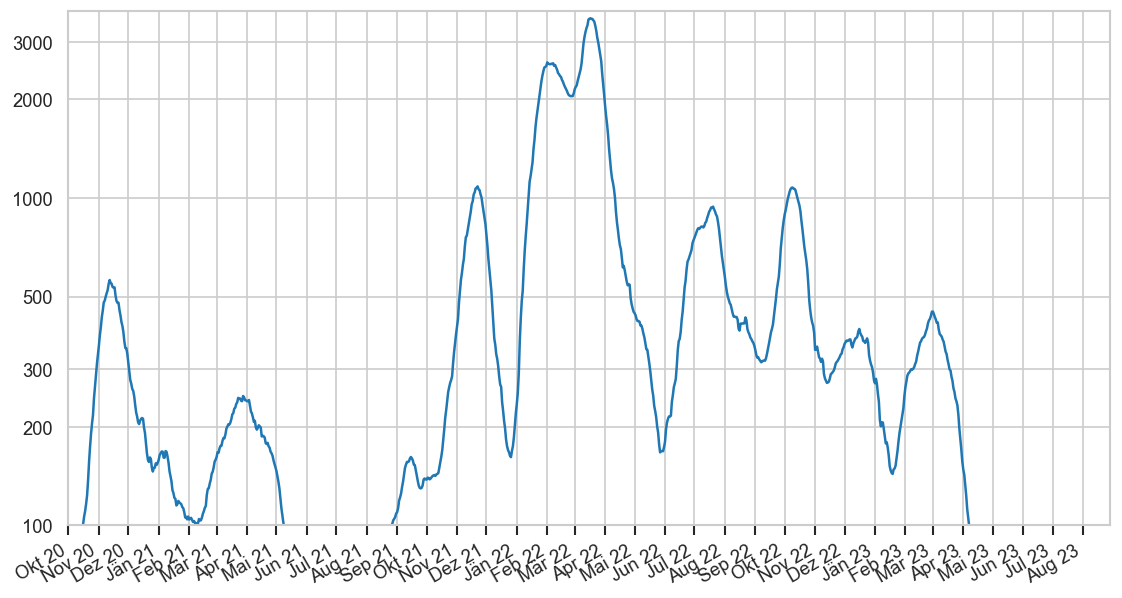
#display(fs_at[fs_at["AnzahlFaelle"] >= 9000][["Datum", "AnzahlFaelle", "inz"]])
def plt_avg_scatter(ax, ts, **kwargs):
#ax.plot(ts, marker=".", linewidth=0.1, markersize=4, label=ts.name, **kwargs)
p_dayvals = ax.fill_between(ts.index, ts.to_numpy(), label=ts.name + " (Tageswerte)", **kwargs, edgecolor="k", alpha=1/3,
step="mid")
means = ts.rolling(7).mean()
p_means = ax.plot(means, label=f"7-Tage-Schnitt {ts.name}", **kwargs)
cov.set_date_opts(ax, ts.index, showyear=True)
ax.set_xlim(right=ts.index[-1] + timedelta(7))
p_lastmean = ax.axhline(means.iloc[-1], linewidth=1, linestyle="--", **kwargs, label="Letzter 7-Tage-Schnitt")
p_lastday = ax.axhline(ts.iloc[-1], linewidth=1, linestyle=":", **kwargs, label="Letzter Tageswert")
ax.legend(
[p_means[0], p_dayvals, p_lastmean, p_lastday],
[f"7-Tage-Schnitt {ts.name}", ts.name + " (Tageswerte)", "Letzter 7-Tage-Schnitt", "Letzter Tageswert"],
loc="upper left", ncol=2)
ax.set_ylabel(f"{ts.name} pro Tag")
def plt_cases_simple(fs_at):
fig, axs = plt.subplots(nrows=2, sharex=True, figsize=(14, 14))
data = fs_at.set_index("Datum")["AnzahlFaelle"].rename("Anzahl Fälle")
plt_avg_scatter(axs[0], data, color="C1")
plt_avg_scatter(axs[1], data, color="C1")
#axs[0].yaxis.set_major_locator(matplotlib.ticker.MultipleLocator(2500))
axs[1].set_yscale("log")
axs[1].yaxis.set_major_formatter(matplotlib.ticker.ScalarFormatter())
axs[1].yaxis.set_major_locator(matplotlib.ticker.LogLocator(base=10, subs=[0.25, 0.5, 1]))
axs[1].get_legend().remove()
axs[0].tick_params(labelbottom=False)
axs[0].set_title("Lineare Skala")
axs[1].set_title("Logarithmische Skala")
fig.suptitle(fs_at["Bundesland"].iloc[0] + ": Täglich entdeckte COVID-Fälle" + AGES_STAMP, y=0.92)
fig.subplots_adjust(hspace=0.1)
for ax in axs:
ax.tick_params(bottom=False)
ax.set_ylim(bottom=20, top=fs_at["AnzahlFaelle"].max() * 1.05)
ax.set_xlim(left=date(2020, 6, 1))
fig.autofmt_xdate()
plt_cases_simple(fs_at)
if False:
plt_cases_simple(fs.query("Bundesland == 'Oberösterreich'"))
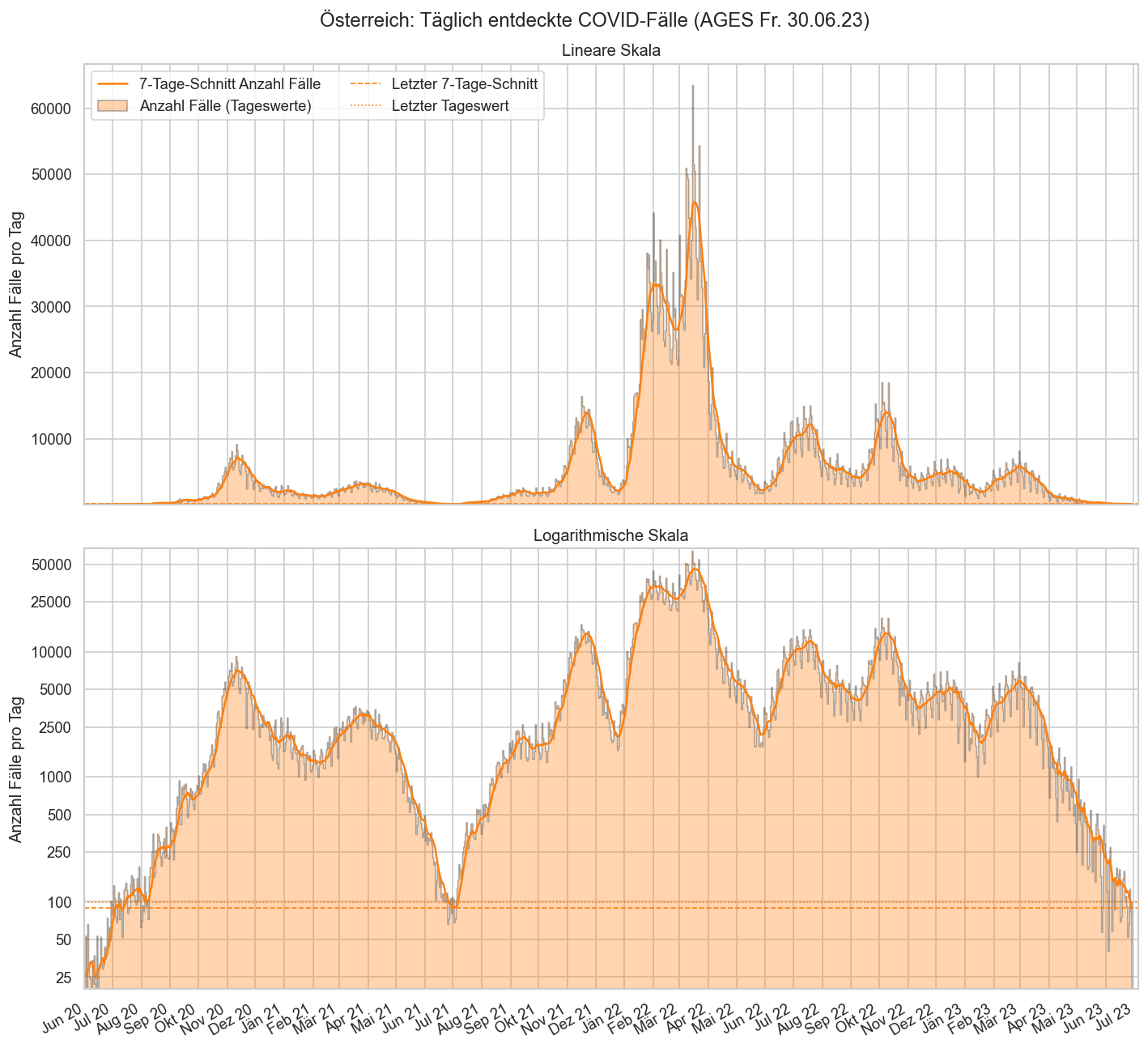
def plt_uninf(fs_at):
fs_at = fs_at.set_index("Datum")
inzuninf = fs_at["AnzahlFaelle7Tage"] / (
fs_at["AnzEinwohner"] - fs_at["AnzahlFaelle"].shift().rolling(120).sum()) * 100_000
fig, ax = plt.subplots()
ax.plot(inzuninf, label="Inzidenz der nicht bereits innerhalb 120 Tage Infizierten (Schätzung)")
ax.plot(fs_at["inz"], label="Inzidenz gesamt")
cov.set_logscale(ax)
ax.set_ylim(bottom=50)
ax.set_xlim(left=pd.to_datetime("2021-08-01"))
cov.set_date_opts(ax)
ax.legend()
fig.autofmt_xdate()
plt_uninf(fs_at)
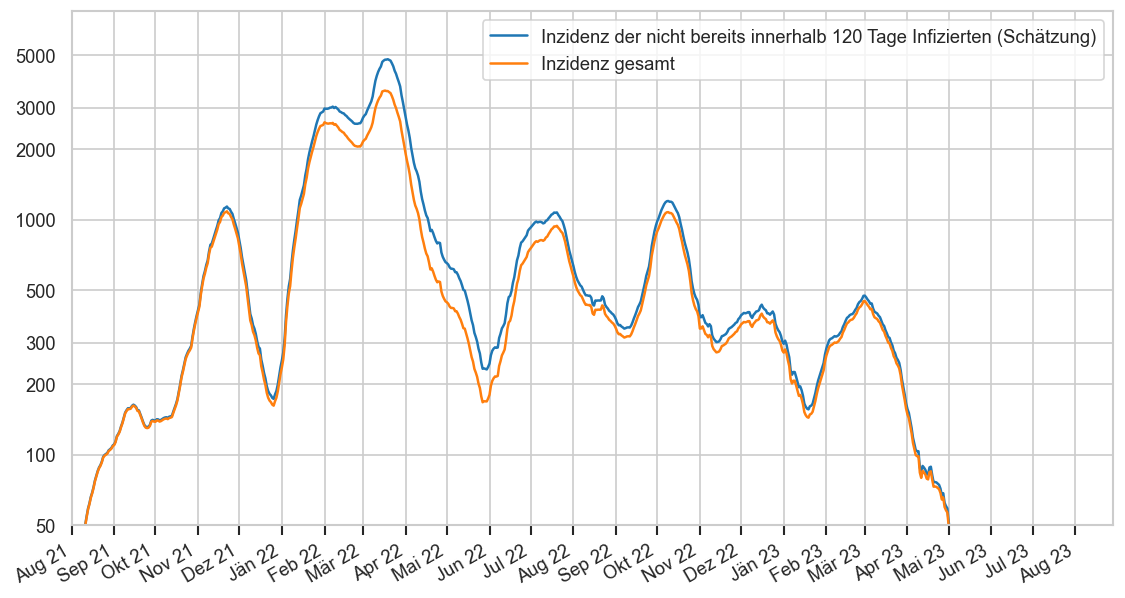
def plt14d():
mms_at = fs.query("Bundesland == 'Österreich'").set_index("Datum")
ax = (mms_at["AnzahlFaelle"].rolling(14).sum() / mms_at["AnzEinwohner"] * 100_000).plot()
cov.set_date_opts(ax, mms_at.index)
ax.set_xlim(right=ax.get_xlim()[1] + 7)
ax.figure.suptitle("14-Tage-Inzidenz pro 100.000 EW", y=0.93)
ax.figure.autofmt_xdate()
plt14d()
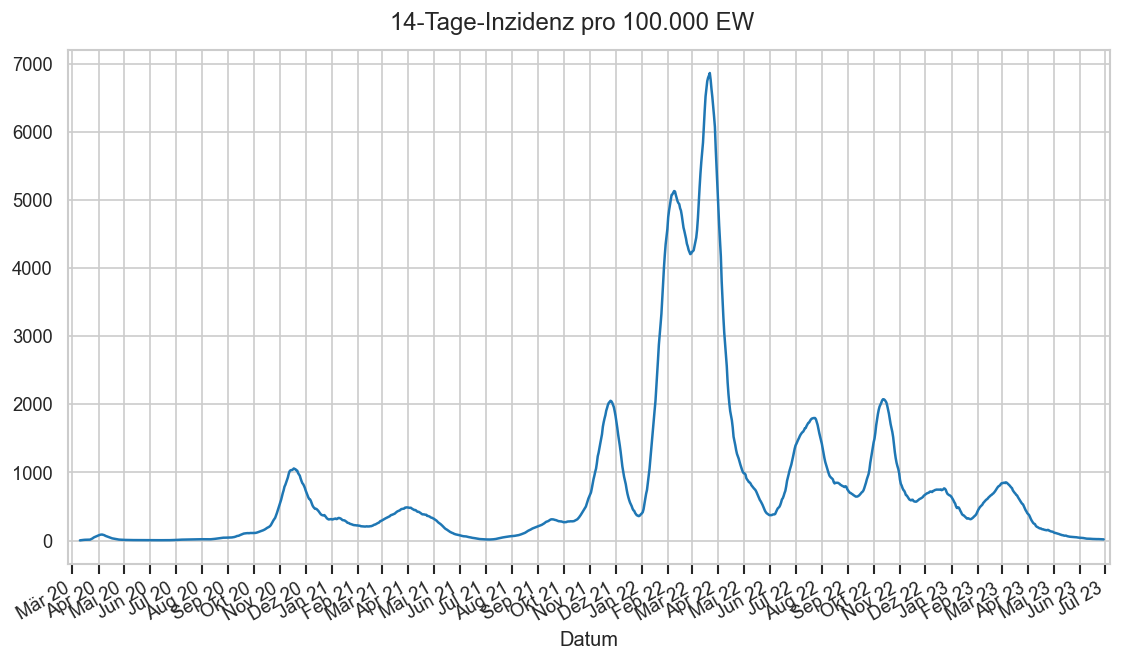
Übersicht Pandemieverlauf¶
Die rechte y-Achse ist logarithmisch (Änderung um gleichen Faktor ist immer gleich lang, gleiche absolute Änderungen werden mit zunehmendem Ausgangswert kleiner dargestellt).
Die gestrichelten Linien gehen jeweils vom letzen Wert aus, man kann daran leicht ablesen wo wir uns gerade im Vergleich z.B. zur letzten Welle befinden.
Achtung: Die Zahlen v.a. der letzten 1-3 Tage sind in den hier verwendeten AGES normalerweise zu niedrig und werden in den Folgetagen durch Nachmeldungen nach oben korrigiert. Der ORF hat dazu eine Übersicht unter "Verteilung neuer Fälle über die letzten Tage" bei https://orf.at/corona/daten/oesterreich. Derzeit scheint es dort leichte technische Probleme zu geben, das Diagramm wird zuerst nicht angezeigt, sondern man muss zuerst z.B. "Verstorbene" auswählen und dann wieder "Laborbestätigte Fälle" um zweiteres zu sehen.
blverlauf = covdata.load_ww_blverlauf()
blvfull = (
blverlauf[blverlauf["Datum"] >= pd.to_datetime("2022-09-01")])
abwfrom = blverlauf["FileDate"].min()
blverlauf_last = blverlauf[blverlauf["FileDate"] == blverlauf["FileDate"].max()]
blv1 = covdata.first_filedate(blvfull, ["Bundesland"])
blverlauf["FileDate"].max()
Timestamp('2023-07-24 23:10:09+0000', tz='UTC')
wien_hosp = pd.read_csv(COLLECTROOT / "covid/wien/wien.csv",sep=";")
wien_hosp["Datum"] = (
cov.parseutc_at(wien_hosp["Datum"], format=cov.ISO_DATE_FMT).dt.tz_localize(None).dt.normalize())
wien_hosp.sort_values(by="Datum", kind="stable", inplace=True)
wien_hosp.drop_duplicates(["Datum"], keep="last", inplace=True)
wien_hosp.set_index("Datum", inplace=True)
hospfz_ow = hospfz.copy().set_index(["Datum", "BundeslandID"])
wien_hosp_x = wien_hosp.copy().reset_index()
wien_hosp_x["Datum"] += np.timedelta64(1, 'D')
hospfz_ow.loc[
hospfz_ow.index.get_level_values("BundeslandID").isin([9, 10]), "FZHosp"] = hospfz_ow["FZHosp"].add(
wien_hosp_x
.set_index("Datum")
.query("Datum >= '2022-11-02'")
["HospPostCov"]
.resample("1D")
.interpolate(),
fill_value=0)
if False: #???
hospfz_ow.loc[(pd.to_datetime("2022-11-02"), 9), "FZHosp"] += (
wien_hosp.query("Datum == '2022-11-02'").iloc[0]["HospPostCov"])
hospfz_ow.loc[(pd.to_datetime("2022-11-02"), 10), "FZHosp"] += (
wien_hosp.query("Datum == '2022-11-02'").iloc[0]["HospPostCov"])
natmon_latest = pd.read_csv(DATAROOT / "covid/abwassermonitoring/dl_natmon_01_latest.csv", sep=";", encoding="utf-8",
parse_dates=["Datum"]).rename(errors="raise", columns={
"gemittelte kumulierte Faelle der letzten 7 Tage aus den Humantestungen": "AnzahlFaelle7Tage",
"Gesamtvirenfracht [Genkopien pro Tag * 10^6]": "Abwassersignal"
}).set_index("Datum")
natmon_norm = natmon_latest.copy()
msk_erw = natmon_norm.index >= pd.to_datetime("2023-02-01")
#display(natmon_norm)
# "Rund 52%" https://web.archive.org/web/20230110152232/https://abwassermonitoring.at/dashboard/
anzEw = pandembev.xs(10, level="BundeslandID").groupby("Datum").sum()
natmon_norm.loc[~msk_erw, "Abwassersignal"] = natmon_norm["Abwassersignal"] / (anzEw * 0.515)
# "Mehr als 58%" https://abwassermonitoring.at/dashboard/
natmon_norm.loc[msk_erw, "Abwassersignal"] = natmon_norm["Abwassersignal"] / (anzEw * 0.582)
#natmon_latest["Datum"] = pd.to_datetime(natmon_latest["Datum"], format=cov.AGES_DATE_FMT)
if True:
natmon = pd.read_csv(COLLECTROOT / "covid/abwassermonitoring/natmon_01_all.csv.xz", sep=";", encoding="utf-8",
parse_dates=["Datum"])
natmon = natmon.pivot(columns="name", index=["FileDate", "Datum"], values="y")
natmon_latest0 = (
natmon.loc[
natmon.index.get_level_values("FileDate") ==
natmon.index.get_level_values("FileDate")[-1]]
.dropna(how="all").reset_index("FileDate"))
def _drel(nm):
fst = nm.loc[nm["Abwassersignal"].first_valid_index()]
lst = nm.loc[nm["Abwassersignal"].last_valid_index()]
display(fst, lst, fst["Abwassersignal"]/lst["Abwassersignal"])
_drel(natmon_latest0)
_drel(natmon_latest)
#natmon_latest
name FileDate 2023-07-24T23:10:09+00:00 Abwassersignal 29918.7 Humansignal 51059.0 Name: 2022-01-16 00:00:00, dtype: object
name FileDate 2023-07-24T23:10:09+00:00 Abwassersignal 5887.1333 Humansignal NaN Name: 2023-07-18 00:00:00, dtype: object
5.0820
AnzahlFaelle7Tage 5.1059e+04 Abwassersignal 4.7869e+08 Name: 2022-01-16 00:00:00, dtype: float64
AnzahlFaelle7Tage NaN Abwassersignal 9.4192e+07 Name: 2023-07-18 00:00:00, dtype: float64
5.0820
cov = reload(cov)
with sns.axes_style("whitegrid", {'axes.grid' : False}), plt.rc_context({"figure.dpi": 300}):
fsx = fs.set_index(["Bundesland", "Datum"])
for bl in fsx.index.levels[0].unique():
bldata = fsx.loc[bl].iloc[-2000:]
if bl == "Österreich":
bldata = bldata.join(natmon_latest["Abwassersignal"], how="left")
else:
bldata = bldata.join(blv1.reset_index().query(f"Bundesland == '{bl}'").set_index("Datum")["y"]
.rename("Abwasser_y"))
if bl in ("Österreich", "Wien"):
bldata = bldata.merge(wien_hosp[["HospPostCov"]], on="Datum", how="left")
#plt.plot(bldata["AnzEinwohner"])
#display(bldata[~pd.isna(bldata["Abwassersignal"])])
#display(bldata[["AnzEinwohner", "Abwassersignal", "inz"]].iloc[0])
cov.plot_detail(bldata, bl);
plt.title(f"Epidemieüberblick {bl}{AGES_STAMP}", y=1.1)
...\AppData\Local\hatch\env\virtual\covidat\MDfikVs6\notebooks\Lib\site-packages\pandas\plotting\_matplotlib\core.py:807: UserWarning: The label '_7-Tage-Summe Tote vol.' of <matplotlib.lines.Line2D object at 0x00000198EA4AC350> starts with '_'. It is thus excluded from the legend. ax.legend(handles, labels, loc="best", title=title) ...\AppData\Local\hatch\env\virtual\covidat\MDfikVs6\notebooks\Lib\site-packages\pandas\plotting\_matplotlib\core.py:807: UserWarning: The label '_7-Tage-Summe Tote vol.' of <matplotlib.lines.Line2D object at 0x000001993E20D690> starts with '_'. It is thus excluded from the legend. ax.legend(handles, labels, loc="best", title=title) ...\AppData\Local\hatch\env\virtual\covidat\MDfikVs6\notebooks\Lib\site-packages\pandas\plotting\_matplotlib\core.py:807: UserWarning: The label '_7-Tage-Summe Tote vol.' of <matplotlib.lines.Line2D object at 0x00000198896B8990> starts with '_'. It is thus excluded from the legend. ax.legend(handles, labels, loc="best", title=title) ...\AppData\Local\hatch\env\virtual\covidat\MDfikVs6\notebooks\Lib\site-packages\pandas\plotting\_matplotlib\core.py:807: UserWarning: The label '_7-Tage-Summe Tote vol.' of <matplotlib.lines.Line2D object at 0x000001989F3DA2D0> starts with '_'. It is thus excluded from the legend. ax.legend(handles, labels, loc="best", title=title) ...\AppData\Local\hatch\env\virtual\covidat\MDfikVs6\notebooks\Lib\site-packages\pandas\plotting\_matplotlib\core.py:807: UserWarning: The label '_7-Tage-Summe Tote vol.' of <matplotlib.lines.Line2D object at 0x000001990E54CD10> starts with '_'. It is thus excluded from the legend. ax.legend(handles, labels, loc="best", title=title) ...\AppData\Local\hatch\env\virtual\covidat\MDfikVs6\notebooks\Lib\site-packages\pandas\plotting\_matplotlib\core.py:807: UserWarning: The label '_7-Tage-Summe Tote vol.' of <matplotlib.lines.Line2D object at 0x0000019910631B50> starts with '_'. It is thus excluded from the legend. ax.legend(handles, labels, loc="best", title=title) ...\AppData\Local\hatch\env\virtual\covidat\MDfikVs6\notebooks\Lib\site-packages\pandas\plotting\_matplotlib\core.py:807: UserWarning: The label '_7-Tage-Summe Tote vol.' of <matplotlib.lines.Line2D object at 0x00000199109ED910> starts with '_'. It is thus excluded from the legend. ax.legend(handles, labels, loc="best", title=title) ...\AppData\Local\hatch\env\virtual\covidat\MDfikVs6\notebooks\Lib\site-packages\pandas\plotting\_matplotlib\core.py:807: UserWarning: The label '_7-Tage-Summe Tote vol.' of <matplotlib.lines.Line2D object at 0x0000019910C33190> starts with '_'. It is thus excluded from the legend. ax.legend(handles, labels, loc="best", title=title) ...\AppData\Local\hatch\env\virtual\covidat\MDfikVs6\notebooks\Lib\site-packages\pandas\plotting\_matplotlib\core.py:807: UserWarning: The label '_Normalstationsbelegung ohne PostCov' of <matplotlib.lines.Line2D object at 0x0000019910E6E8D0> starts with '_'. It is thus excluded from the legend. ax.legend(handles, labels, loc="best", title=title) ...\AppData\Local\hatch\env\virtual\covidat\MDfikVs6\notebooks\Lib\site-packages\pandas\plotting\_matplotlib\core.py:807: UserWarning: The label '_7-Tage-Summe Tote vol.' of <matplotlib.lines.Line2D object at 0x000001991100DD50> starts with '_'. It is thus excluded from the legend. ax.legend(handles, labels, loc="best", title=title) ...\AppData\Local\hatch\env\virtual\covidat\MDfikVs6\notebooks\Lib\site-packages\pandas\plotting\_matplotlib\core.py:807: UserWarning: The label '_Normalstationsbelegung ohne PostCov' of <matplotlib.lines.Line2D object at 0x00000199129DF850> starts with '_'. It is thus excluded from the legend. ax.legend(handles, labels, loc="best", title=title) ...\AppData\Local\hatch\env\virtual\covidat\MDfikVs6\notebooks\Lib\site-packages\pandas\plotting\_matplotlib\core.py:807: UserWarning: The label '_7-Tage-Summe Tote vol.' of <matplotlib.lines.Line2D object at 0x00000199129AB2D0> starts with '_'. It is thus excluded from the legend. ax.legend(handles, labels, loc="best", title=title)
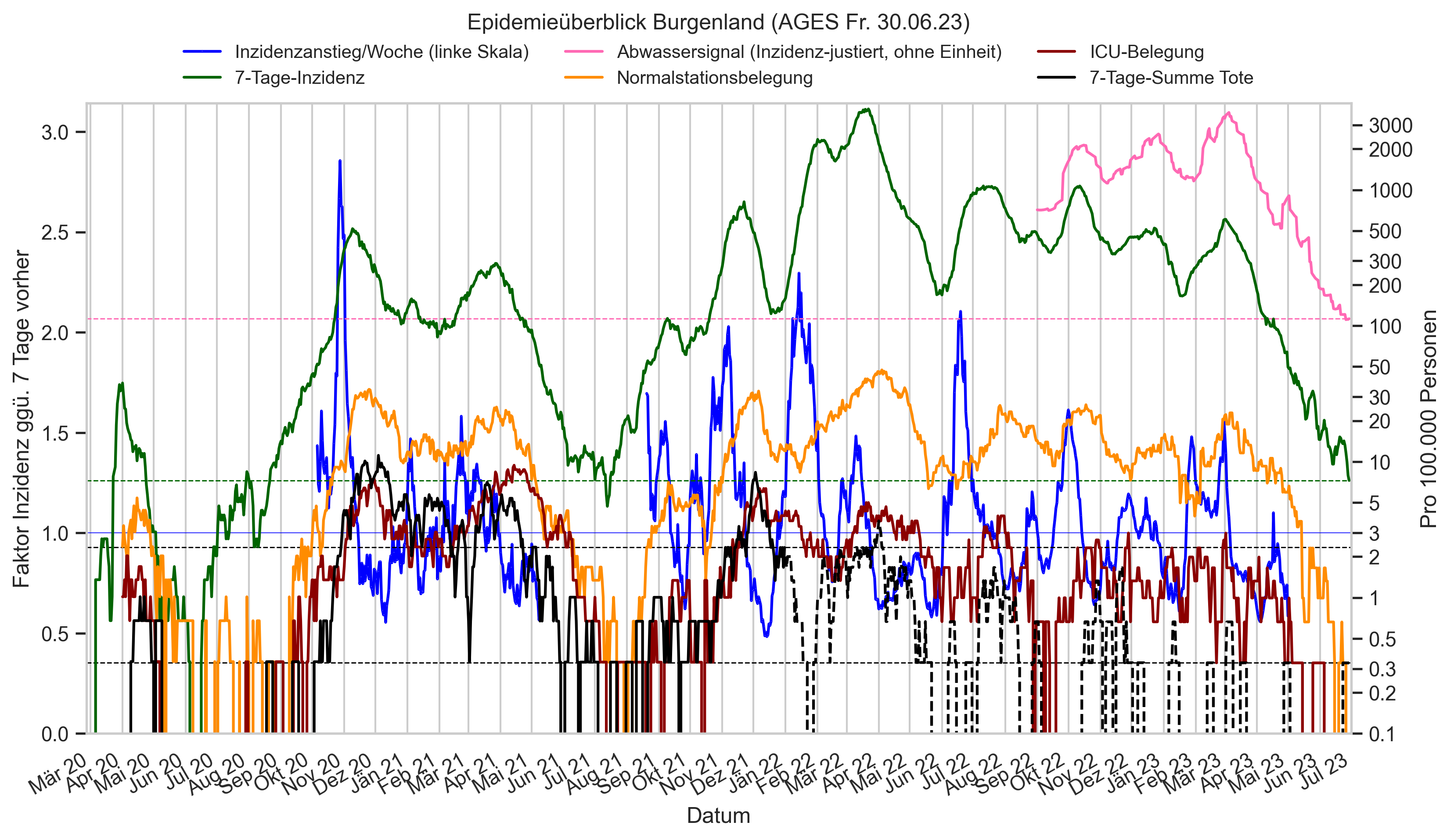
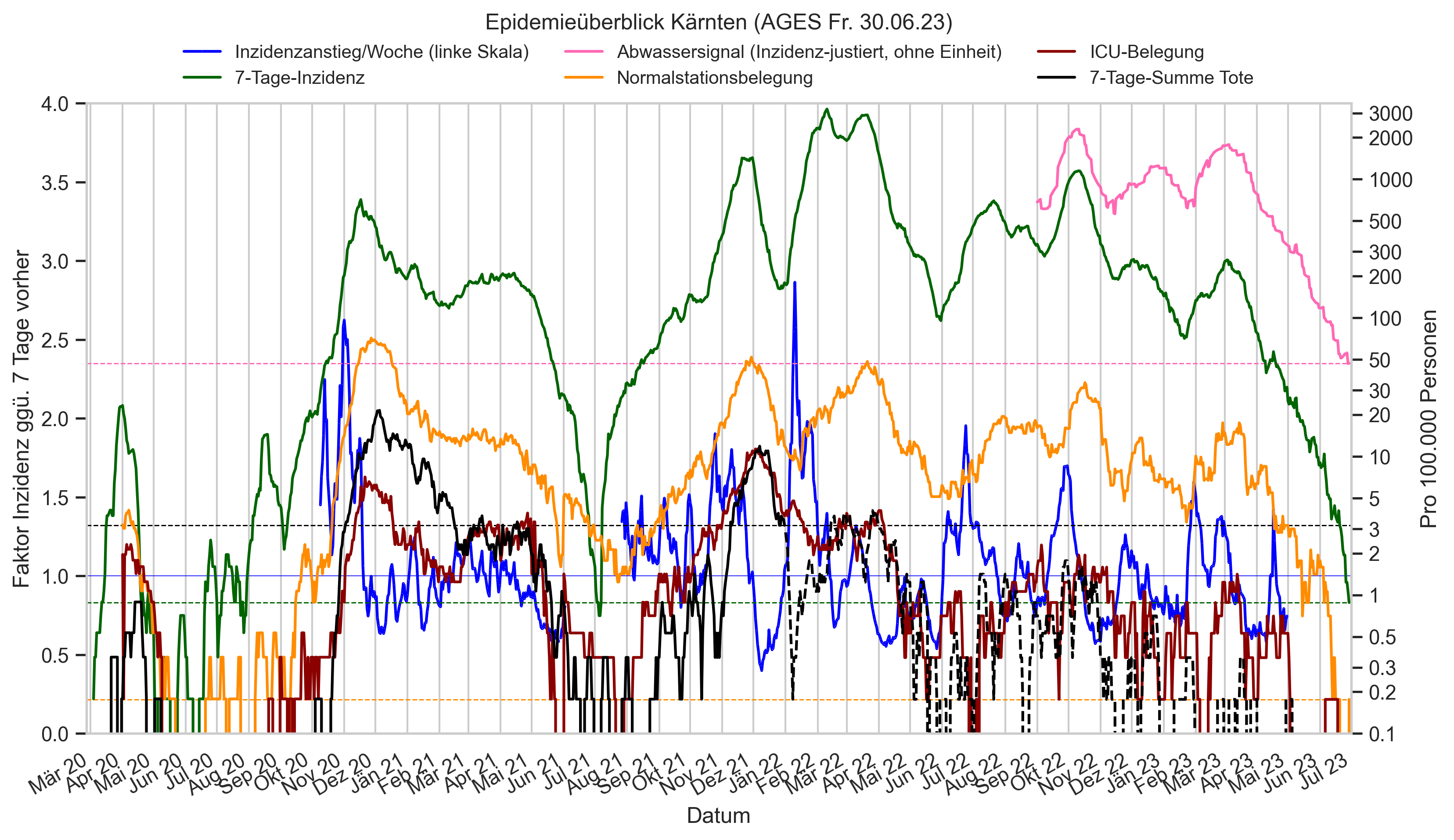
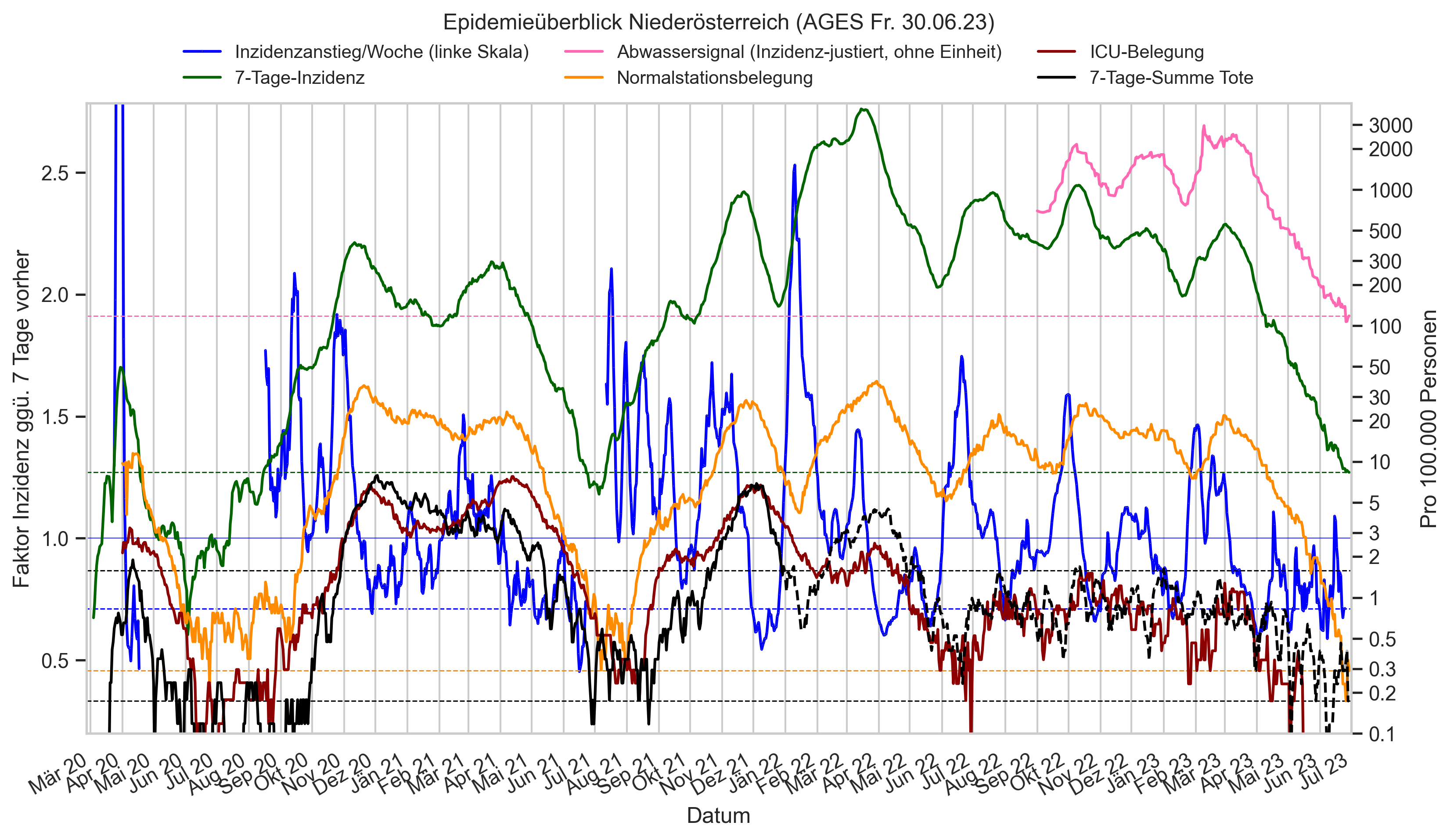
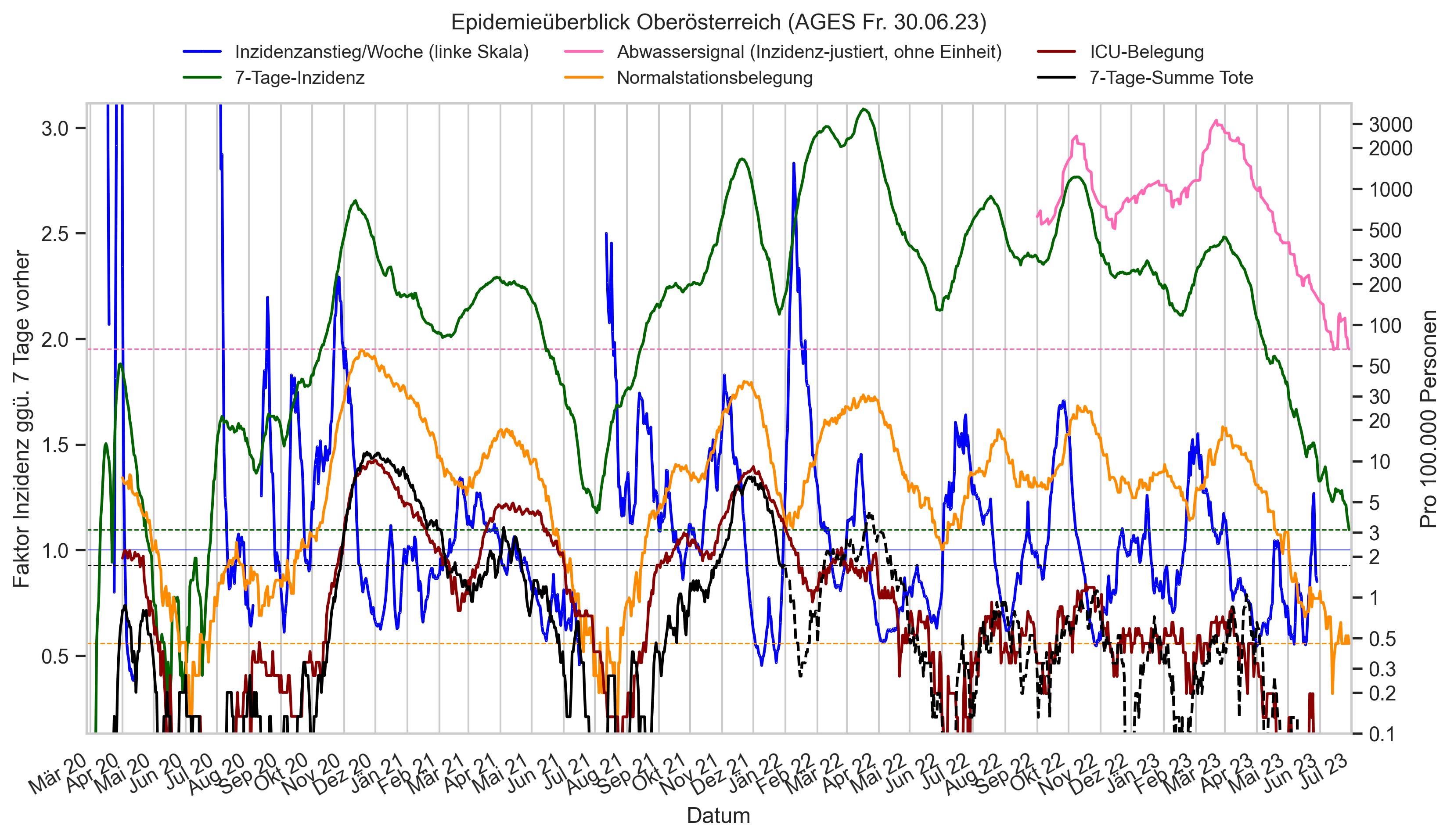
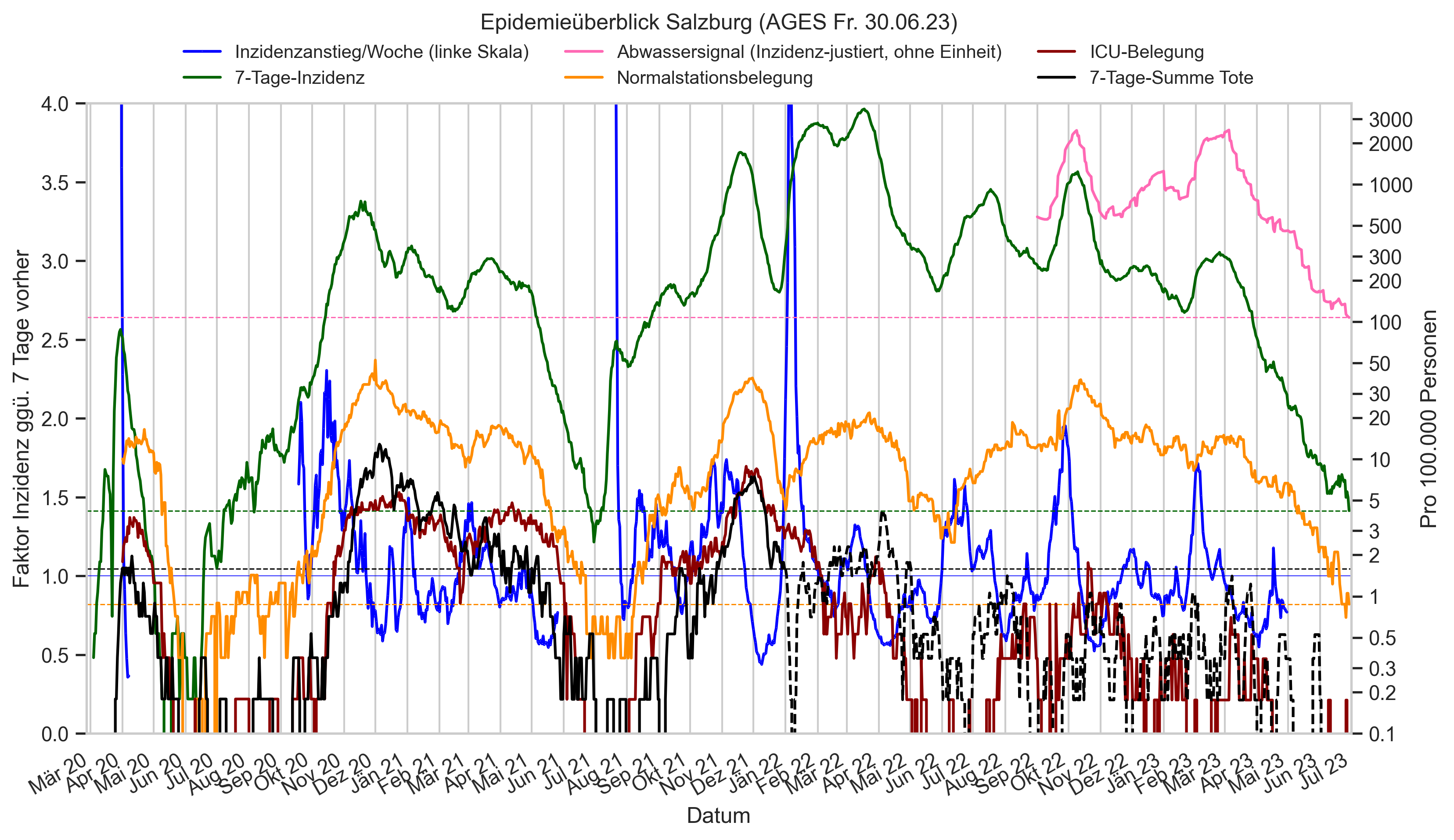
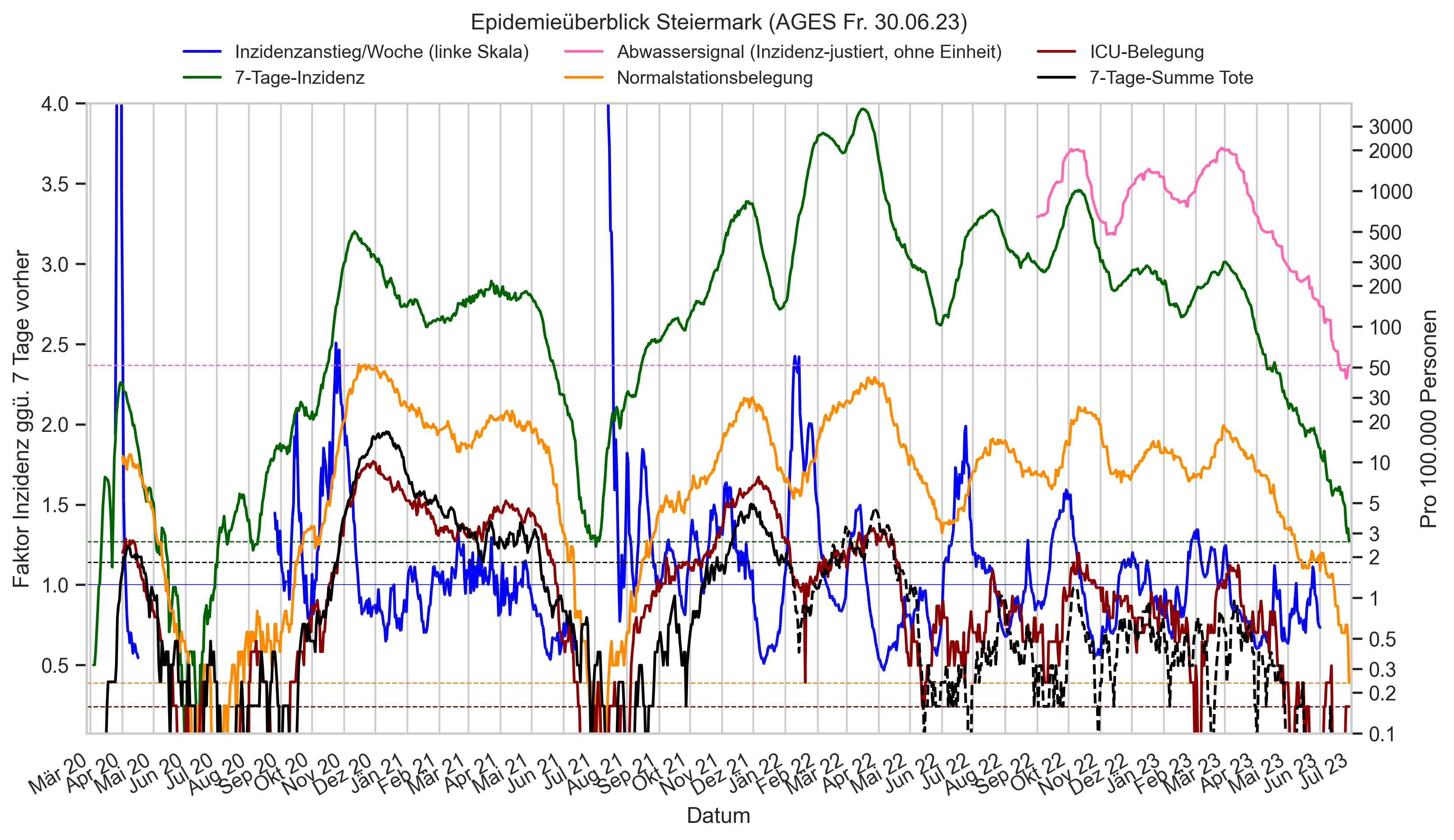
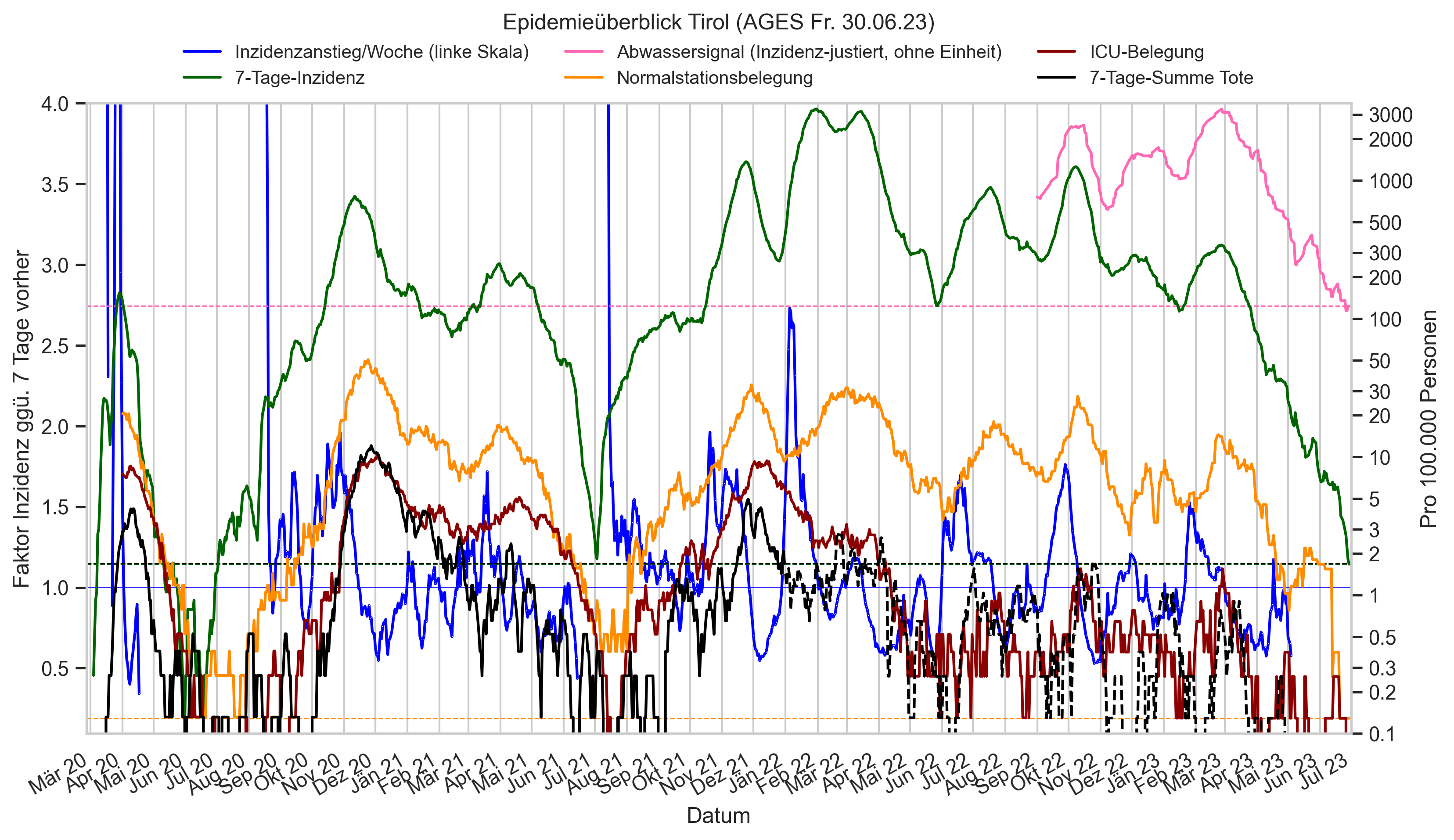
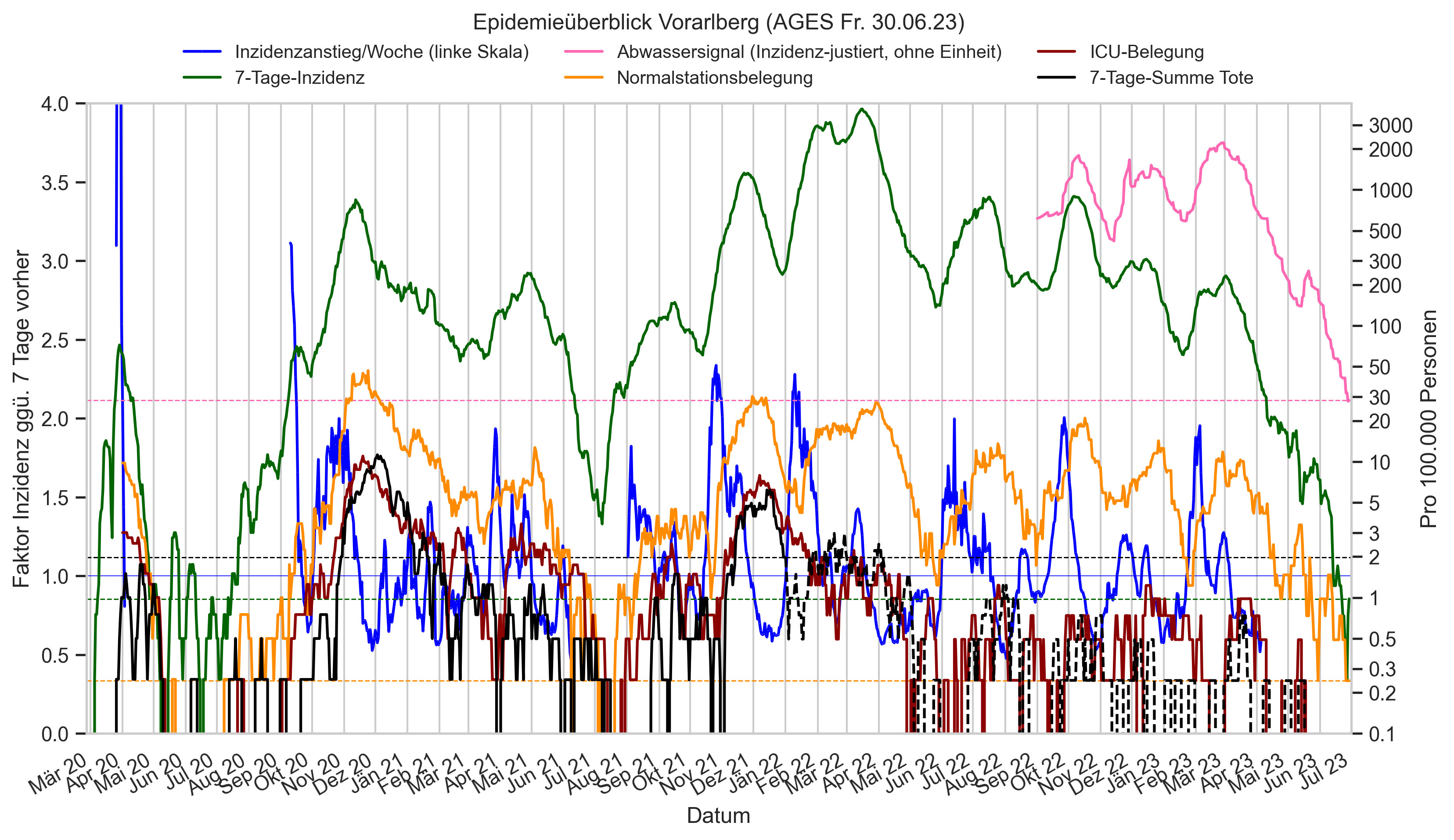
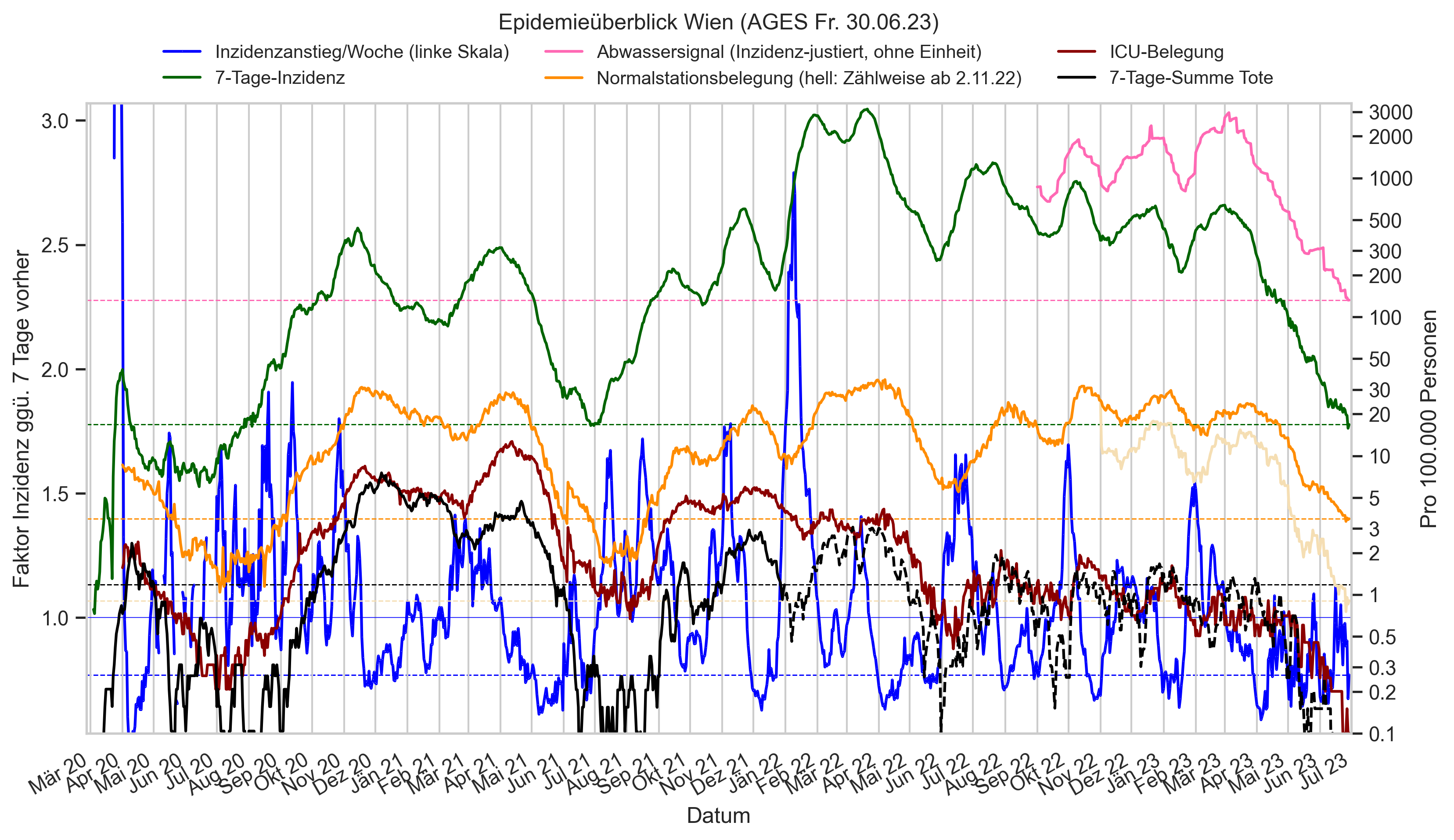
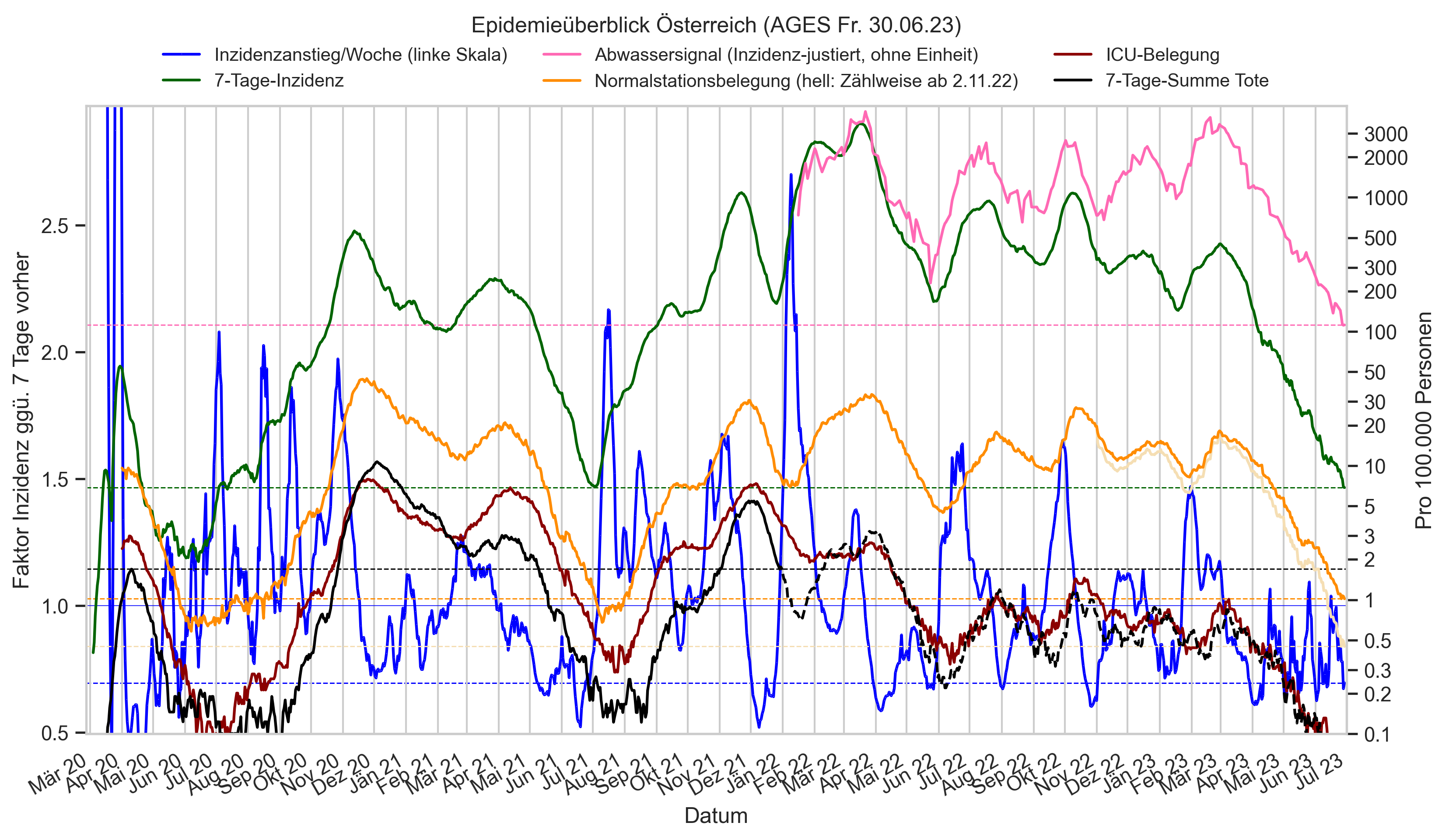
if False:
cov=reload(cov)
for bl in agdata2["Bundesland"].unique():
cov.print_predictions(agdata2[agdata2["Bundesland"] == bl].set_index("Datum"), "AnzahlFaelleSumProEW", "Kumulative Inzidenz " + bl,
target=1, days=35)
cov=reload(cov)
def plt_status(fs_at, hosp_at, mode="sep", bymdat=False, stamp=AGES_STAMP, ax=None, fig=None, ttly=0.93):
fs_at = fs_at.copy().set_index("Datum")#.query("Datum >= '2021-08-01'").set_index("Datum")
#ngeheilt = fs_at["AnzahlFaelleSum"] - fs_at["AnzahlGeheiltSum"]
#aktiv = ngeheilt - fs_at["AnzahlTotSum"]
#display(aktiv.tail(10))
#fzhaus = aktiv - fs_at["FZHosp"] - fs_at["FZICU"]
caserate = fs_at["AnzahlFaelleSum"] - fs_at["AnzahlFaelleSum"].shift(14)
dead0 = erase_outliers(fs_at["AnzahlTot"]).rolling(14).sum()
if hosp_at is not None and hosp_at.iloc[-1]["Datum"] > fs_at.index[-1]:
fs_at.loc[hosp_at.iloc[-1]["Datum"], "FZICU"] = hosp_at.iloc[-1]["FZICU"]
fs_at.loc[hosp_at.iloc[-1]["Datum"], "FZHosp"] = hosp_at.iloc[-1]["FZHosp"]
if ax is None:
fig, ax = plt.subplots()
ax.stackplot(
fs_at.index,
fs_at["FZICU"],
fs_at["FZHosp"],
#fs_at["AnzahlTotSum"],
#fs_at["AnzahlGeheiltSum"],
labels=["IntensivpatientInnen", "Andere Hospitalisierte"],# "Tot", "Inaktiv"],
colors=[sns.color_palette()[3], sns.color_palette()[1]],
#colors=["k"] + sns.color_palette(n_colors=2),
#step="pre",
lw=0)
deadlabel = "Verstorbene" if mode == "sum2" else "Verstorbene (14-Tage-Summe)"
if mode == "sep":
dead = dead0.iloc[7 - fs_at.index[0].weekday()::14]
#display(fs_at["AnzahlTot"].iloc[-3:])
extrabar = dead.index[-1] != dead0.index[-1]
if extrabar:
dead[dead0.index[-1]] = fs_at.loc[dead0.index[-1]]["AnzahlTotSum"] - fs_at.loc[dead.index[-1], "AnzahlTotSum"]
bs = ax.bar(dead.index, dead, label=deadlabel, color="k", lw=0, width=-7, alpha=0.5, align="edge")
if extrabar:
bs[-1].set_width(-7 * (dead.index[-1] - dead.index[-2]).total_seconds() / (60 * 60 * 24) / 14)
bs[-1].set_alpha(0.2)
if not bymdat and extrabar and dead.index[-1] - dead0.index[-1] < timedelta(7):
bs[-2].set_alpha(0.2)
ax.plot(dead0 if bymdat else dead0.iloc[:-9], color="k")
if not bymdat and False:
ax.plot(dead0.iloc[-9:], color="k", ls=":")
else:
ax.fill_between(
fs_at.index,
(fs_at["AnzahlTotSum"] if mode == "sum2" else dead0) + fs_at["FZICU"] + fs_at["FZHosp"],
fs_at["FZICU"] + fs_at["FZHosp"], color="k", label=deadlabel)
#ax.set_ylim(bottom=20)
#cov.set_logscale(ax)
ax.set_axisbelow(False)
ax.grid(alpha=0.5)
ax2 = ax.twinx()
ax2.plot(caserate, color="C0", label="14-Tage-Inzidenz (rechte Skala)", lw=2)
ax.set_ylim(bottom=0)
ax2.set_ylim(bottom=0)
ax2.set_ylabel("Fälle")
ax2.yaxis.set_major_formatter(matplotlib.ticker.ScalarFormatter(useLocale=True))
ax2.grid(False)
ax.set_ylabel("Hospitalisierte/Verstorbene")
cov.set_date_opts(ax, fs_at.loc[caserate.first_valid_index():].index, showyear=True)
#ax.set_xlim(right=ax.get_xlim()[1] + 3, left=pd.to_datetime("2021-08-15"))
yrstart = pd.to_datetime("2022-01-01")
if fig is not None:
fig.legend(loc="upper center", fontsize="small", ncol=4, frameon=False, bbox_to_anchor=(0.5, ttly))
fig.suptitle(
fs_at.iloc[0]["Bundesland"] + ": Akute COVID-Krankheitslast ‒ Versuch einer Visualisierung" + stamp,
y=ttly + 0.07)
fig.text(0.5, ttly, "(Chronische/post-akute Erkrankung mangels Daten nicht dargestellt)",
ha="center", fontsize="small")
fig.autofmt_xdate()
elif stamp:
ax.set_title(stamp)
#print(stamp, f"Krankheitstage seit {aktiv.loc[yrstart:].index[0]}:", aktiv.loc[yrstart:].sum(), ", davon im KH ", (fs_at["FZICU"] + fs_at["FZHosp"]).loc[yrstart:].sum())
#print("Derzeit aktiv:",
# aktiv.iloc[-1],
# ", davon im KH",
# (hosp["IntensivBettenBelCovid19"] + hosp["NormalBettenBelCovid19"]).iloc[-1],
# ", davon auf ICU",
# hosp["IntensivBettenBelCovid19"].iloc[-1])
#print("Verstorben 2022:", fs_at["AnzahlTot"].loc[yrstart:].sum())
return ax, ax2
#selbl = "Oberösterreich"
selbl = "Österreich"
if False: # Vergleich Quellen in Subdiagrammen
fig, axs = plt.subplots(nrows=2, sharex=True, sharey=True)
ax, ax2 = plt_status(
fs.query(f"Bundesland == '{selbl}'"),
hosp.query(f"Bundesland == '{selbl}'"),
mode="sep",
ax=axs[0],
fig=fig,
stamp="",
ttly=0.96)
ax.set_title(AGES_STAMP.removeprefix(" (").removesuffix(")"))
m_ax, m_ax2 = plt_status(mms.query(f"Bundesland == '{selbl}'"), None, mode="sep", bymdat=True, stamp="Krisenstab " + mms.iloc[-1]["Datum"].strftime("%a %x"), ax=axs[1])
same_axlims([ax, m_ax], [ax2, m_ax2], maxg=np.inf)
if False:
plt_status(
mmx.query(f"Bundesland == '{selbl}' and Datum >= '2019-08-01'"),
None,#hospfz.query(f"Bundesland == '{selbl}' and Datum >= '2021-08-01'"),
mode="sep", bymdat=True,
stamp=", nach Meldedatum " + AGES_STAMP)
plt_status(
fs.query(f"Bundesland == '{selbl}' and Datum >= '2019-08-01'"),
hospfz.query(f"Bundesland == '{selbl}' and Datum >= '2019-08-01'"),
mode="sep", bymdat=False,
stamp=AGES_STAMP)
(<Axes: ylabel='Hospitalisierte/Verstorbene'>, <Axes: ylabel='Fälle'>)
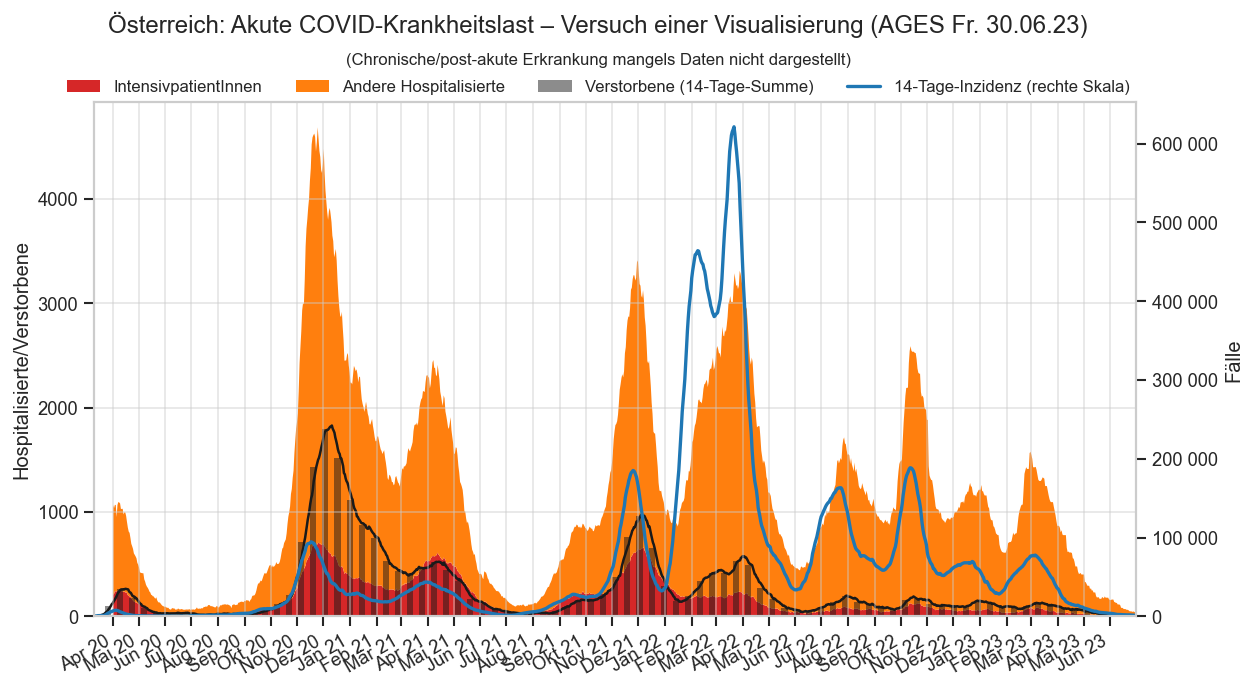
fs_at.query("FZHospAlle < 450").tail(20)[["FZHospAlle", "Datum"]]
| FZHospAlle | Datum | |
|---|---|---|
| 12009 | 119.0 | 2023-06-10 |
| 12019 | 119.0 | 2023-06-11 |
| 12029 | 111.0 | 2023-06-12 |
| 12039 | 86.0 | 2023-06-13 |
| 12049 | 87.0 | 2023-06-14 |
| 12059 | 84.0 | 2023-06-15 |
| 12069 | 75.0 | 2023-06-16 |
| 12079 | 75.0 | 2023-06-17 |
| 12089 | 75.0 | 2023-06-18 |
| 12099 | 69.0 | 2023-06-19 |
| 12109 | 68.0 | 2023-06-20 |
| 12119 | 67.0 | 2023-06-21 |
| 12129 | 60.0 | 2023-06-22 |
| 12139 | 53.0 | 2023-06-23 |
| 12149 | 53.0 | 2023-06-24 |
| 12159 | 53.0 | 2023-06-25 |
| 12169 | 48.0 | 2023-06-26 |
| 12179 | 52.0 | 2023-06-27 |
| 12189 | 49.0 | 2023-06-28 |
| 12199 | 45.0 | 2023-06-29 |
mmx.query("AnzahlFaelle > PCRReg").tail(10)[["Datum", "Bundesland", "PCRReg", "AnzahlFaelle"]]
| Datum | Bundesland | PCRReg | AnzahlFaelle | |
|---|---|---|---|---|
| 7305 | 2021-08-21 | Vorarlberg | 0.0000 | 61 |
| 7931 | 2023-05-09 | Vorarlberg | 24.4286 | 105 |
| 7995 | 2020-10-17 | Wien | 0.0000 | 703 |
| 8070 | 2020-12-31 | Wien | 0.0000 | 496 |
| 8073 | 2021-01-03 | Wien | 0.0000 | 210 |
| 8075 | 2021-01-05 | Wien | 357.0000 | 369 |
| 8193 | 2021-05-03 | Wien | 0.0000 | 18 |
| 8248 | 2021-06-27 | Wien | 0.0000 | 46 |
| 9071 | 2021-01-03 | Österreich | 0.0000 | 1630 |
| 9128 | 2021-03-01 | Österreich | 0.0000 | 1164 |
def plt_big3(fs_at, mms, stamp):
fig, ax = plt.subplots()
hosp_at = hosp.query("Bundesland == 'Österreich'")
#ax2 = ax.twinx()
lw=2.5
ax.axhline(fs_at["inz"].iloc[-1], color="C0", lw=0.5)
hospx = fs_at["Datum"]
hospy = fs_at["FZHosp"] + fs_at["FZICU"]
if hosp_at.iloc[-1]["Datum"] > fs_at.iloc[-1]["Datum"]:
hospx = pd.concat([hospx, hosp_at.iloc[-1:]["Datum"]])
hospy = pd.concat([hospy, hosp_at.iloc[-1:]["NormalBettenBelCovid19"] + hosp_at.iloc[-1:]["IntensivBettenBelCovid19"]])#["IntensivBettenBelCovid19"])
elif mms is not None and mms.iloc[-1]["Datum"] > fs_at.iloc[-1]["Datum"]:
assert mms.iloc[-1]["Bundesland"] == fs_at.iloc[-1]["Bundesland"]
hospx = pd.concat([hospx, mms.iloc[-1:]["Datum"]])
hospy = pd.concat([hospy, mms.iloc[-1:]["FZHosp"] + mms.iloc[-1:]["FZICU"]])#["IntensivBettenBelCovid19"])
hospx.reset_index(drop=True, inplace=True)
hospy.reset_index(drop=True, inplace=True)
#ax.set_ylim(top=3000)
ax.axhline(hospy.iloc[-1], color="C1", lw=0.5)
deadrolling_nodata = 9 if mms is not None else 0
deadrolling = fs_at.set_index("Datum")["AnzahlTot"]
deadrolling = deadrolling.rolling(14).sum()
deadrolling = deadrolling.loc[deadrolling.first_valid_index():]
if deadrolling_nodata:
deadrolling = deadrolling.iloc[:-deadrolling_nodata]
ax.plot(deadrolling.index, fs_at["inz"].iloc[-len(deadrolling):], label="7-Tage-Inzidenz pro 100.000 Einwohner", color="C0", lw=lw)
ax.plot(deadrolling.index, hospy.iloc[-len(deadrolling):], color="C1", label="Anzahl COVID-Fälle im KH", lw=lw)
ax.plot(deadrolling, color="k", label="Anzahl Tote pro 14 Tage*", lw=lw)
ax.axhline(deadrolling.iloc[-1], color="k", lw=0.5)
#fig.legend(loc="upper center", ncol=3, frameon=False, bbox_to_anchor=(0.5, 0.95))
aargs = dict(fontsize="larger")
#display(hospy, hospy.last_valid_index())
annots = [
(fs_at['inz'].iloc[-1], f"{fs_at['inz'].iloc[-1]:.0f} Fälle in 7 Tagen\n/100.000 EW", aargs),
(hospy.loc[hospy.last_valid_index()], f"{hospy.loc[hospy.last_valid_index()]:.0f} im KH", aargs),
(deadrolling.iloc[-1], f"{deadrolling.iloc[-1]:.0f} Tote* in 14 Tagen", aargs),
]
ax.set_ylim(bottom=0)
fig.suptitle("Inzidenz, Krankenhaus-PatientInnen, Tote" + stamp, y=0.93, fontsize="x-large")
#ax.xaxis.set_major_formatter(matplotlib.dates.DateFormatter("%b %y"))
#ax.xaxis.set_major_locator(matplotlib.dates.MonthLocator())
cov.set_date_opts(ax, deadrolling.index, showyear=len(hospx) > 330)
ax.set_xlim(left=deadrolling.index[0], right=hospx.iloc[-1] + (hospx.iloc[-1] - deadrolling.index[0]) * 0.01)
dodgeannot(annots, ax)
ax.yaxis.set_minor_locator(matplotlib.ticker.AutoMinorLocator(2))
ax.tick_params(labelsize="larger")
ax.grid(which="minor", lw=0.2)
tight = True
if len(hospx) > 300:
tight = False
fig.autofmt_xdate(which="major")
elif len(hospx) <= MIDRANGE_NDAYS + 14:
fig.autofmt_xdate()
ax.set_ylabel("Personen (siehe Beschriftung)");
if mms is not None:
fig.text(
0.5, 0.03 if tight else 0.07,
f"* Tote nach Todesdatum, letzte {deadrolling_nodata} Tage wegen zu erwartenden Nachmeldungen weggelassen", ha="center")
else:
fig.text(
0.5, 0 if tight else 0.06,
"* Tote nach Meldedatum, ohne Ausreißer-Nachmeldungen. Nur als Trendindikator geignet."
"\nBereinigte Todeszahlen inkl. Nachmeldungen sind erst später im Nachhinein verfügbar (via AGES).", ha="center")
#cov.stampit(fig)
#ax2.set_ylim(bottom=0)
#ax.yaxis.set_major_locator(matplotlib.ticker.MultipleLocator(100))
plt_big3(fs.query("Bundesland == 'Österreich' and Datum >= '2021-07-01'"), mmx.query("Bundesland == 'Österreich' and Datum >= '2021-07-01'"), AGES_STAMP)
if DISPLAY_SHORTRANGE_DIAGS:
plt_big3(mmx.query("Bundesland == 'Österreich' and Datum >= '2021-01-01'").iloc[-MIDRANGE_NDAYS - 14:], None, "")
#plt_big3(mmx.query("Bundesland == 'Oberösterreich' and Datum >= '2022-01-01'").iloc[-MIDRANGE_NDAYS - 14:], None, "")
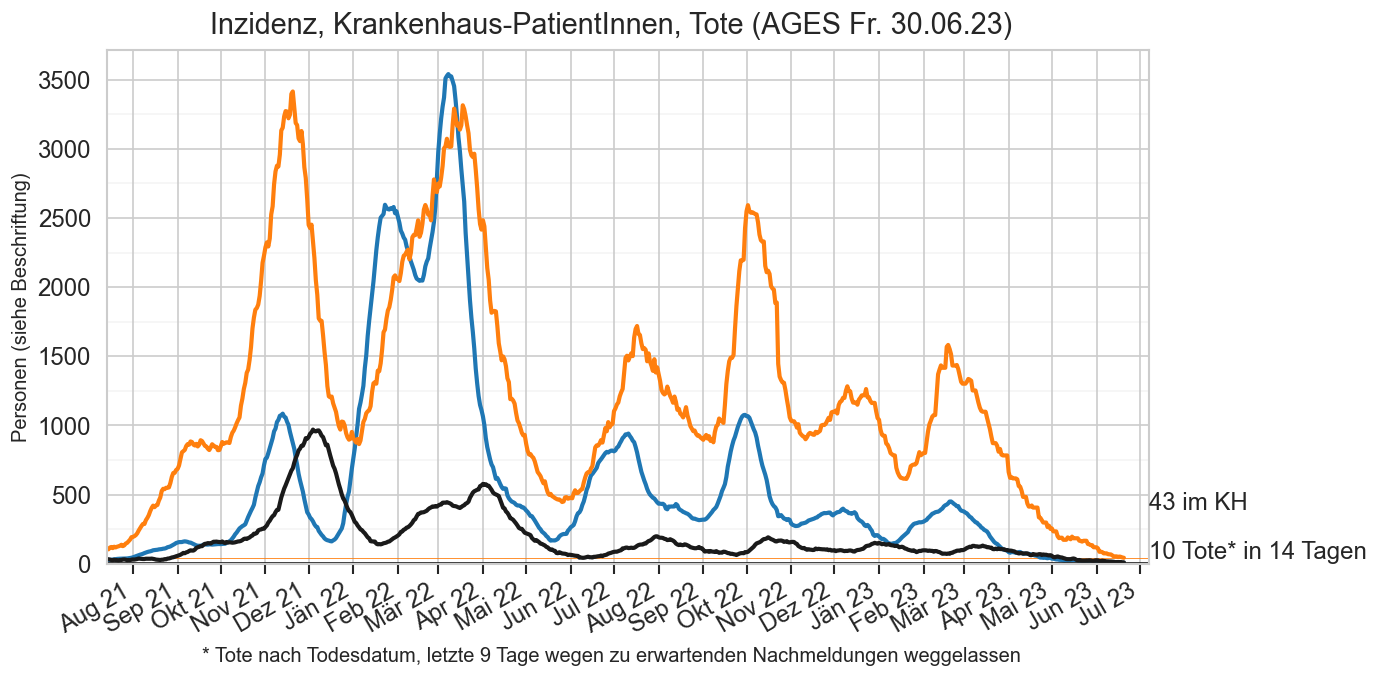
mmx["FZHosp"].tail(3)
9977 45 9978 41 9979 39 Name: FZHosp, dtype: int64
In den folgenden Heatmaps wurden die Bundesländer wurden nach Möglichkeit so angeordnet dass ähnliche untereinander sind. Dabei wurde die NUTS Gliederung (https://www.statistik.at/web_de/klassifikationen/regionale_gliederungen/nuts_einheiten/index.html) herangezogen die Österreich in eine Westregion mit Voralberg, Tirol, Salzburg, OÖ, Ostregion (Niederösterreich, Wien, Burgenland) und eine Südregion (Kärnten, Steiermark) unterteilt. Diese Unterteilung ist auch im Hinblick auf den früheren Schulstart in der Ostregion sinnvoll.
Die Farbskalierung erfolgt mit https://matplotlib.org/stable/api/_as_gen/matplotlib.colors.SymLogNorm.html#matplotlib.colors.SymLogNorm, d.h. die Farbzuteilung ist bis zur Inzidenz 20 linear und ab da logarithmisch.
cov=reload(cov)
#df["Datum"] = df
#print(df.dtypes)
#print(df.index)
#df.replace(0, 1, inplace=True)
def date_hm_extent(df: pd.DataFrame):
"""Calculate extents for imshow.
See <https://stackoverflow.com/a/45349235/2128694>.
"""
dates = df.columns.to_pydatetime()
dnum = matplotlib.dates.date2num(dates)
step = dnum[1] - dnum[0]
start = dnum[0] - step / 2
stop = dnum[-1] + step /2
rows = df.index
extent = [start, stop, -0.5, len(rows) - 0.5]
return extent
# fig, ax = plt.subplots(figsize=(14, 9) if bezmode else (14, 2))
def plt_tl_heat(df, *, ax=None, im_args=None, cbar_args=None):
if ax is None:
ax = plt.gca()
#cmap = cov.adjust_cmap(df, vmin=1, center=15)[0]
#display(np.nanmax(df.to_numpy()))
#tsnorm = matplotlib.colors.TwoSlopeNorm(vmin=1, vcenter=15, vmax=np.nanmax(df.to_numpy()))
#lnorm = matplotlib.colors.LogNorm()
#combnorm = matplotlib.colors.FuncNorm((
# lambda vs: lnorm(tsnorm(vs)),
# lambda vs: tsnorm.inverse(lnorm.inverse(vs))
#))
def_im_args = dict(
#fmt=".0f",
#center=0,
#annot=True,
#cmap="Spectral_r",
norm=matplotlib.colors.SymLogNorm(20, base=2, linscale=1),
#ax=axs[0],
aspect='auto',
interpolation="nearest")
if im_args is False:
def_im_args.clear()
else:
if im_args is not None:
def_im_args.update(im_args)
#if "cmap" not in def_im_args and hasattr(def_im_args["norm"], "linthresh"):
# def_im_args["cmap"]=cov.adjust_cmap(df, cmap=cov.un_cmap, center=def_im_args["norm"].linthresh * 2)
#print(df)
im = ax.imshow(df.values, extent=date_hm_extent(df), **def_im_args)
#ax.grid(False)
#ax.grid(bezmode)
ax.grid(axis="x", linewidth=0.2, color=(1, 1, 1))
ax.grid(False, axis="y")
#ax.xaxis.set_major_locator(matplotlib.dates.MonthLocator())
#ax.xaxis.set_minor_locator(matplotlib.dates.DayLocator())
#ax.xaxis.set_major_formatter(matplotlib.dates.DateFormatter('%b'))
showyear=len(df.columns) > 350
cov.set_date_opts(ax, df.columns, showyear=showyear)
if showyear:
plt.setp(ax.get_xticklabels(), rotation=30, ha="right", rotation_mode="anchor")
rows = df.index
ax.yaxis.set_major_locator(matplotlib.ticker.FixedLocator(range(len(rows))))
ax.yaxis.set_major_formatter(matplotlib.ticker.FixedFormatter(list(reversed(rows))))
ax.tick_params(axis="x", top=False, labeltop=False, bottom=True, labelbottom=True)
ax.set_xlim(left=df.columns.min() - timedelta(1), right=df.columns.max() + timedelta(1))
if cbar_args is not False:
vmax = df.max().max()
def_cbar_args = dict(
format=matplotlib.ticker.FormatStrFormatter("%.0f"),
ticks=[20, 50, 100, 200, 500, 1000, 3000] if vmax > 100 else
[0, 1, 2, 5, 10, 20, 50, 75, 100] if vmax > 50 else None,
ax=ax)
if cbar_args is True:
def_cbar_args = dict(ax=ax)
elif cbar_args is not None:
def_cbar_args.update(cbar_args)
cbar = ax.figure.colorbar(im, **def_cbar_args);
else:
cbar = None
return im, cbar
fig, axs = plt.subplots(figsize=(14, 11), nrows=4, sharex=True)
fig.subplots_adjust(hspace=0.5)
mindate = "2020-01-15"
plt_tl_heat(agd_sums.query(f"Bundesland == 'Österreich' and Altersgruppe != 'Alle' and Datum >= '{mindate}'")
.pivot(index="Altersgruppe", columns="Datum", values="inz")
.sort_index(axis="rows", key=lambda s: s.map(ag_to_id), ascending=False),
ax=axs[0])
axs[0].set_title("Inzidenz in den Altersgruppen" + AGES_STAMP);
fs0 = fs.copy()
with cov.calc_shifted(fs0, "Bundesland", 14, newcols=["dead14"]):
fs0["dead14"] = fs0["AnzahlTot"].rolling(14).sum() / fs0["AnzEinwohner"] * 100_000
fs0 = fs0[fs0["Datum"] >= pd.to_datetime(mindate)]
plt_tl_heat(fs0.pivot(index="BLCat", columns="Datum", values="inz"), ax=axs[1])
axs[1].set_title("Inzidenz in den Bundesländern" + AGES_STAMP)
plt_tl_heat(fs0.pivot(index="BLCat", columns="Datum", values="hosp"),
im_args=dict(norm=matplotlib.colors.SymLogNorm(1, base=2, linscale=.25)),
ax=axs[2]);
axs[2].set_title("Spitalsbelegung/100.000 EW in den Bundesländern" + AGES_STAMP);
plt_tl_heat(fs0[fs0["Datum"] <= fs0.iloc[-1]["Datum"] - timedelta(7)].pivot(
index="BLCat", columns="Datum", values="dead14"),
im_args=dict(norm=matplotlib.colors.SymLogNorm(0.3, base=10, linscale=.5)),
cbar_args=dict(ticks=[0, 0.3, 1, 3, 10, 30], format="%.1f"),
ax=axs[3]);
axs[3].set_title("Tote/14 Tage/100.000 EW in den Bundesländern" + AGES_STAMP);
axs[0].set_xlim(right=fs0.iloc[-1]["Datum"] + timedelta(1))
(18317.0000, 19538.0000)

Hotspots in Bezirken und Altersgruppen und Veränderung¶
Die folgenden Diagramme stellen sehr kompakt über viele Bezirke/Bundesländer bzw. Altersgruppe-Bundesland-Kombinationen hinweg dar. Es werden alle Gruppen/Bezirke/Bundesländer dargestellt die entweder zu den 40 mit der meisten Inzidenz haben, oder zumindest eine halbe Million Einwohner/"Mitglieder" haben.
Die Diagramme sind jeweils von oben nach unten nach Inzidenz sortiert. Der Balken geht von der Inzidenz vor sieben Tagen zum aktuellsten Inzidenzwert (das schwarze Ende ist der Wert vor 7 Tagen). Der schwarze bzw. gelbe Pfeil markieren die Inzidenz vor einem Tag bzw. vor zwei Wochen. Sie zeigen jeweils auf den aktuellen Inzidenzwert (auf das Balkenende). D.h. wenn die derzeitige Inzidenz höher ist, geht der Pfeil nach rechts, ist sie seitdem gesunken nach links.
Die Einfärbung der Balken erfolgt je nach dem prozentuellen Anstieg (immer dunkleres Rot) bzw. Verringerung (immer dunkleres Blau) seit gestern (schwarzer Pfeil).
cov=reload(cov)
def get_top_today(df: pd.DataFrame, catcol: str, by: str = "inz", add_ew: bool=True):
cur = cov.filterlatest(df).copy()
cur.sort_values(by=by, inplace=True)
n_top = 40
topn = cur.iloc[-n_top:]
if add_ew:
topn = cur.iloc[:-n_top].query("AnzEinwohner >= 500_000").append(topn)
return topn#.sort_values(by="inz")
def cleancurbez(bez):
cur_bez = cov.filterlatest(bez)
nwien = (cur_bez["Bezirk"] != "Wien") & np.isfinite(cur_bez["GKZ"])
cur_bez.loc[nwien, "Bezirk"] = cur_bez.loc[nwien, "Bezirk"].str.cat(
(cur_bez.loc[nwien, "GKZ"] // 100).replace(cov.BUNDESLAND_BY_ID).replace(cov.SHORTNAME_BY_BUNDESLAND),
sep="/")
return cur_bez.drop(columns="inz_a7")
def pltbez(bez, title, **topargs):
ax = cov.plt_manychange(get_top_today(cleancurbez(bez), 'Bezirk', **topargs))
ax.set_title(f"Bezirke: 7-Tages-{title}" + AGES_STAMP)
if False:
pltbez(bez, "Inzidenz ‒ Höchste & Meiste Einwohner")
#pltbez(bez1m, "Melde-Inzidenz ‒ Höchste & Meiste Einwohner")
if False:
pltbez(bez, "Inzidenz ‒ Prozentuell Meiststeigend/Woche", by="inz_g7", add_ew=False)
pltbez(bez, "Inzidenz ‒ Prozentuell Meiststeigend/Tag", by="inz_g", add_ew=Faclse)
pltbez(bez1m, "Melde-Inzidenz ‒ Prozentuell Meiststeigend/Tag", by="inz_g", add_ew=False)
pltbez(bez1m, "Inzidenz nach Meldedatum")
#ax.set_xscale("log")
#ax.xaxis.set_major_locator(matplotlib.ticker.LogLocator(base=10, subs=[0.15, 0.2, 0.3, 0.4, 0.5, 0.6, 0.7, 0.85, 1]))
#ax.xaxis.set_major_formatter(matplotlib.ticker.ScalarFormatter())
#cur_bez[["Bezirk", "Datum", "inz", "inz_prev7", "g_inz"]]
ax = cov.plt_manychange(get_top_today(agd_sums, "Gruppe"), catcol="Gruppe")
ax.set_title("Altersgruppen/Bundesland: 7-Tages-Inzidenz ‒ Höchste & Größte" + AGES_STAMP);
if False:
#ax = cov.plt_manychange(get_top_today(agd_sums, "Gruppe", by="inz_g7", add_ew=False), catcol="Gruppe")
#ax.set_title("Altersgruppen/Bundesland: 7-Tages-Inzidenz ‒ Meiststeigend/Woche" + AGES_STAMP);
ax = cov.plt_manychange(get_top_today(agd, "Gruppe", by="inz_g7", add_ew=False), catcol="Gruppe")
ax.set_title("Altersgruppen/Bundesland: 7-Tages-Inzidenz ‒ Meiststeigend/Woche" + AGES_STAMP);
ax = cov.plt_manychange(get_top_today(agd1m_sums, "Gruppe"), catcol="Gruppe")
ax.set_title("Altersgruppen/Bundesland: 7-Tages-Melde-Inzidenz" + AGES_STAMP);
def pltall_hotspots(bez, agd_sums, kind):
mixcats = pd.concat([cleancurbez(bez).rename(columns={'Bezirk': 'Gruppe'}), agd_sums.query("Altersgruppe != 'Alle'")])
tops = get_top_today(mixcats, 'Gruppe', add_ew=False, by="inz")
ax = cov.plt_manychange(tops, 'Gruppe')
ax.set_title(f"Altersgruppen & Bezirke mit Höchster Inzidenz nach {kind}" + AGES_STAMP)
#tops = get_top_today(cov.filterlatest(mixcats).query("inz_g14 >= 1"), 'Gruppe', add_ew=False)
#ax = cov.plt_manychange(tops, 'Gruppe')
#ax.set_title("Altersgruppen & Bezirke mit höherer Inzidenz als vor 2 Wochen" + AGES_STAMP)
ntop = 5
print(f"#COVID19at Top-{ntop} Hotspots (nach AGES-{kind}):\n")
inote = " Fälle in 7 Tagen/100.000 EW"
dnote = " in 7 Tagen"
for i in range(1, ntop + 1):
mrec = tops.iloc[-i]
print(f"{i}.", mrec["Gruppe"], f"({mrec['inz']:.0f}{inote}, {mrec['inz_g7'] - 1:+.0%}{dnote})")
dnote = inote = ""
print()
if DISPLAY_SHORTRANGE_DIAGS:
pltall_hotspots(bez, agd_sums, "Labordatum")
pltall_hotspots(bez1m, agd1m_sums, "Meldedatum")
Bezirke¶
Die folgende Heatmap zeigt den Inzidenzverlauf pro Bezirk. Die Bezirke wurden hierbei so sortiert dass möglichst Nachbarbezirke nacheinander kommen und die Bezirke auch nach Bundesland und Region (https://de.wikipedia.org/wiki/NUTS:AT) gruppiert sind.
-- Basiskarte © STATISTIK AUSTRIA, Letzte Änderung am 16.08.2021 https://www.statistik.at/web_de/klassifikationen/regionale_gliederungen/politische_bezirke/index.html
cov=reload(cov)
plt.rcParams['image.cmap'] = cov.un_cmap
bez_hm = bez[np.isfinite(bez["GKZ"])].copy().reset_index(drop=True)
#bez_hm["KFZ"] = bez_hm["Bezirk"].apply(cov.bezname_to_kfz)
bez_hm["sn"] = bez_hm["Bezirk"].apply(cov.shorten_bezname)
#bez_hm["inz"].replace(0, 0.1, inplace=True)
#kfz_to_gkz = bez_hm.set_index("KFZ")["GKZ"].to_dict()
sname_to_gkz = bez_hm.set_index("sn")["GKZ"].astype(int).to_dict()
geo_order_to_index = dict(zip(cov.BEZ_GKZ_GEO_ORDER, range(len(cov.BEZ_GKZ_GEO_ORDER))))
def plt_bez_hm(mode: str = "inz", *, recent: bool=False):
bez_hm0 = bez_hm if not recent else bez_hm[
bez_hm["Datum"] >= bez_hm["Datum"].iloc[-1] - timedelta(MIDRANGE_NDAYS)]
if mode == "dead":
bez_hm0 = bez_hm0.query("Bezirk != 'Rust(Stadt)'")
#bez_hm0 = bez_hm0[bez_hm0["Datum"] <= bez_hm0["Datum"].iloc[-1] - timedelta(7)]
bez_hm0 = bez_hm0[bez_hm0["Datum"] <= bez_hm0["Datum"].iloc[-1] - timedelta(9)].copy()
rwidth = 28
with cov.calc_shifted(bez_hm0, "Bezirk", rwidth, newcols=["dead28"]):
bez_hm0["dead28"] = bez_hm0["AnzahlTot"].rolling(rwidth).sum() / bez_hm0["AnzEinwohner"] * 100_000
bez_hm_p = (bez_hm0.pivot(index="sn", columns="Datum",
values="InfektionenPro100" if mode == "cumulative" else
"inz" if mode == "inz" else
"inz_g7" if mode == "inz_g7" else
"dead28" if mode == "dead" else None).replace(np.inf, 100_000)
.sort_index(axis="index", key=lambda s: s.map(sname_to_gkz).map(geo_order_to_index)))
bez_hm_p.dropna(axis=1, how='all', inplace=True)
fig, ax = plt.subplots(figsize=(14, 9), dpi=None if recent else 250)
mid = 50
if mode == 'inz':
if False and recent:
norm = matplotlib.colors.LogNorm(vmin=50)
else:
norm = matplotlib.colors.SymLogNorm(mid, base=2)
elif mode == "inz_g7":
norm = matplotlib.colors.TwoSlopeNorm(vmin=0.5, vcenter=1, vmax=2)
elif mode == 'cumulative':
norm = matplotlib.colors.Normalize()
elif mode == "dead":
#bez_hm_p.replace(0, 0.001, inplace=True)
norm = matplotlib.colors.SymLogNorm(0.3, linscale=0.5, vmin=0)
else:
raise ValueError("bad mode")
ticks = (
[0.2, 0.3, 0.5, 0.7, 1, 1.5, 2, 2.5, 3, 3.5, 4, 4.5, 5] if mode == 'inz_g7'
else cov.INZ_TICKS if mode == "inz"
else [0, 0.3, 1, 3, 10, 30, 75] if mode == "dead"
else None)
plt_tl_heat(bez_hm_p, im_args=dict(aspect='auto', norm=norm,
#cmap=sns.blend_palette(["darkbrown", "red", "white"], as_cmap=True)
#cmap=sns.color_palette("RdYlGn_r", as_cmap=True),
cmap=cov.div_l_cmap if mode == "inz_g7" else None
), cbar_args=dict(ticks=ticks, format="%.1f", shrink=0.5), ax=ax)
tsstr = " bis " + bez_hm0.iloc[-1]["Datum"].strftime("%a %x") + AGES_STAMP
if mode == 'cumulative':
ax.set_title("Kumulative Inzidenz (in Prozent) in den Bezirken" + tsstr)
elif mode == 'inz_g7':
ax.set_title("Inzidenzveränderung (Faktor) ggü. 7 Tage vorher in den Bezirken" + tsstr)
elif mode == "inz":
ax.set_title("Inzidenz in den Bezirken" + tsstr)
elif mode == "dead":
ax.set_title("Tote in den Bezirken pro 28 Tage und 100.000 Einwohnern" + tsstr)
else:
raise ValueError("bad mode")
ax.tick_params(axis="y", labelsize=6, labelleft=True, labelright=True, pad=0)
gkzs = bez_hm_p.index.map(sname_to_gkz).to_series().reset_index(drop=True)
#display(gkzs)
diff = (gkzs // 100 != gkzs.shift() // 100)
#display(len(diff) - diff[diff].index.values)
ax.hlines(
len(diff) - diff[diff].index.values - 0.5,
xmin=bez_hm0.index[0], xmax=bez_hm0.index[-1], linewidth=0.2, color=(1, 1, 1))
ax.hlines(
np.arange(0, len(bez_hm_p.index), 4) - 0.5,
xmin=bez_hm0.index[0], xmax=bez_hm0.index[-1], linewidth=0.08, color=(1, 1, 1))
ax.set_facecolor("black")
#else:
# ax.grid(False)
plt_bez_hm("inz")
plt_bez_hm("inz_g7")
#plt_bez_hm("cumulative")
plt_bez_hm("dead")
#plt_bez_hm(BEZMODE_LOW)
#plt_bez_hm(BEZMODE_HIGH)
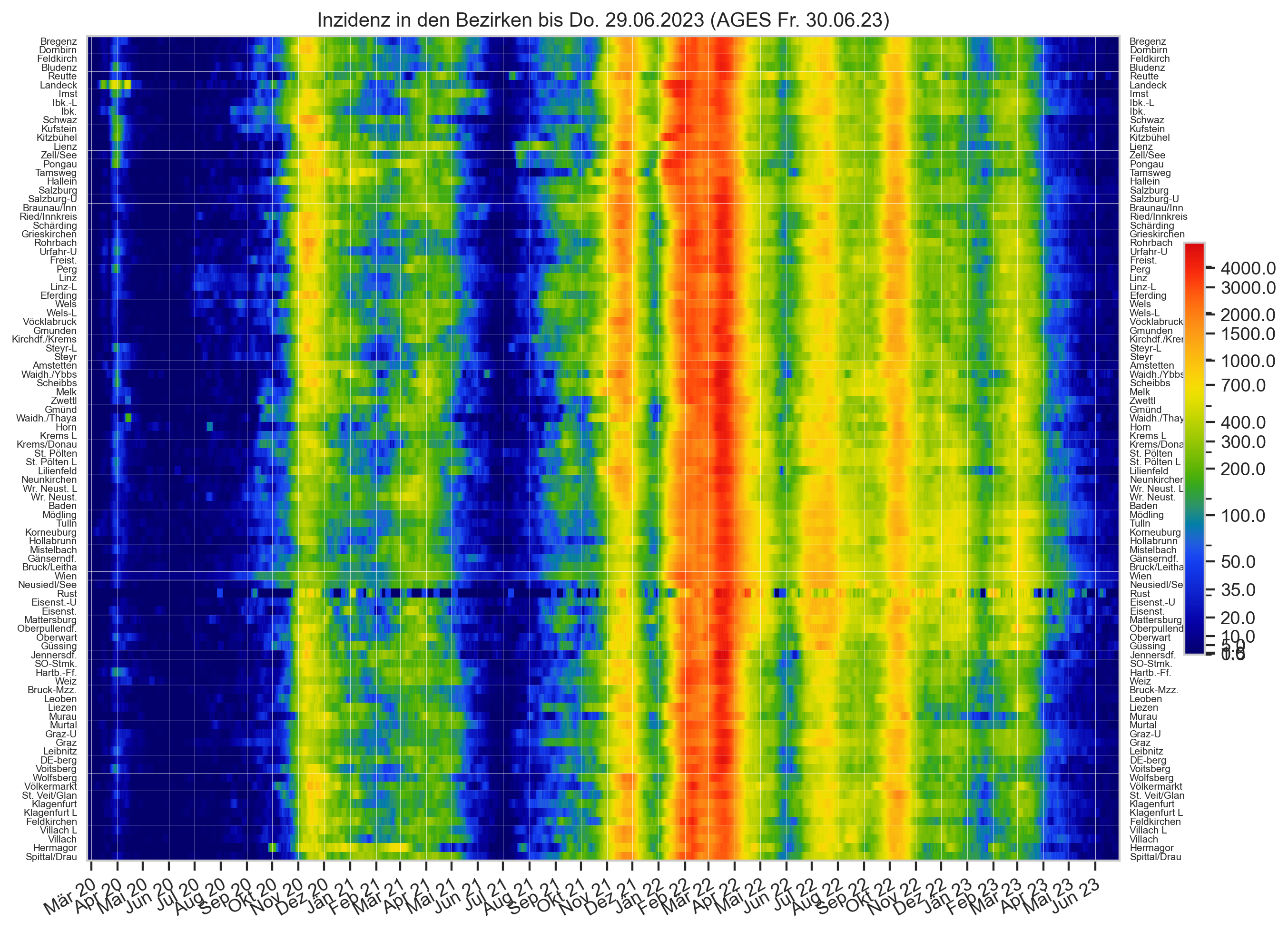
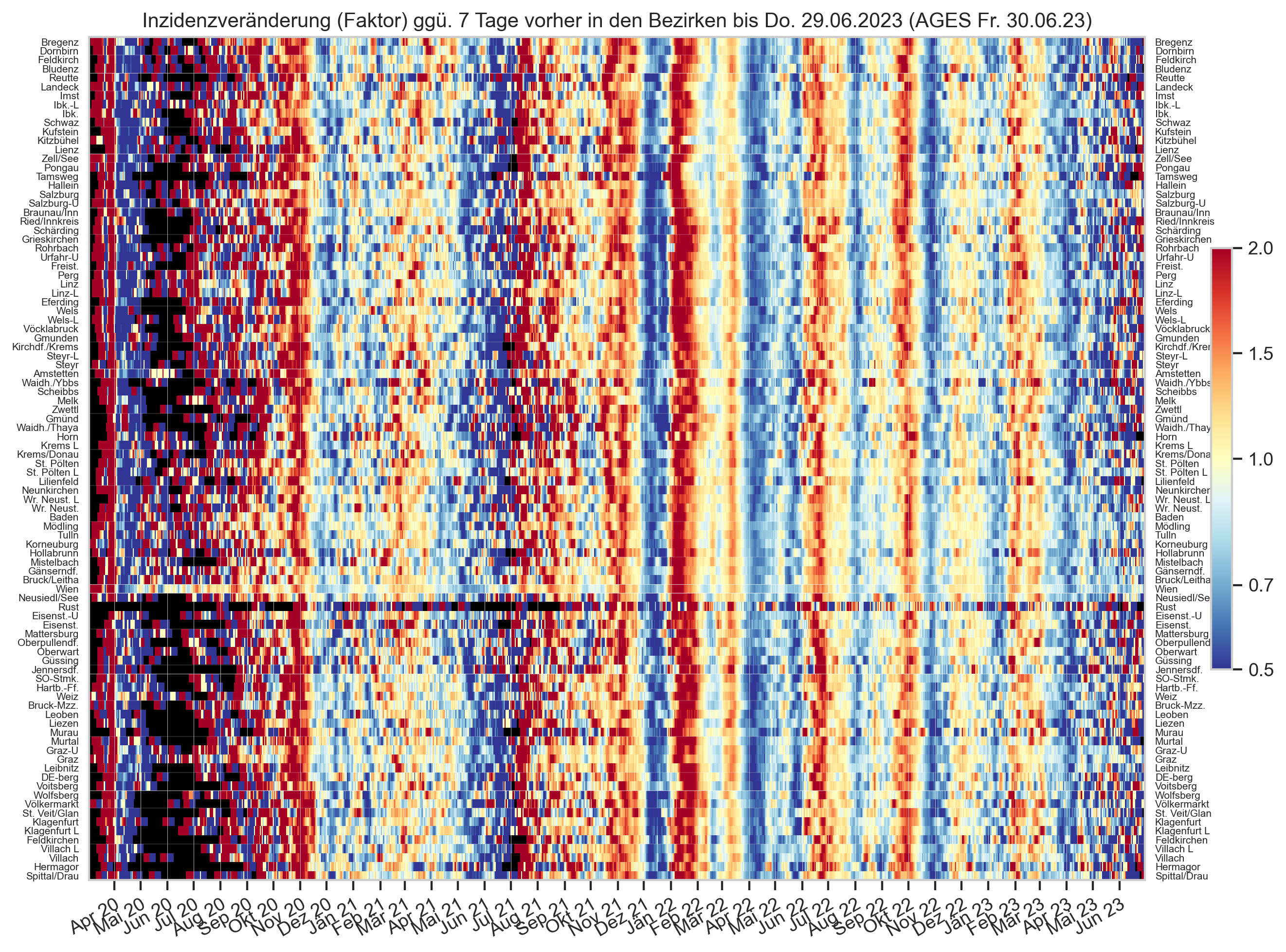
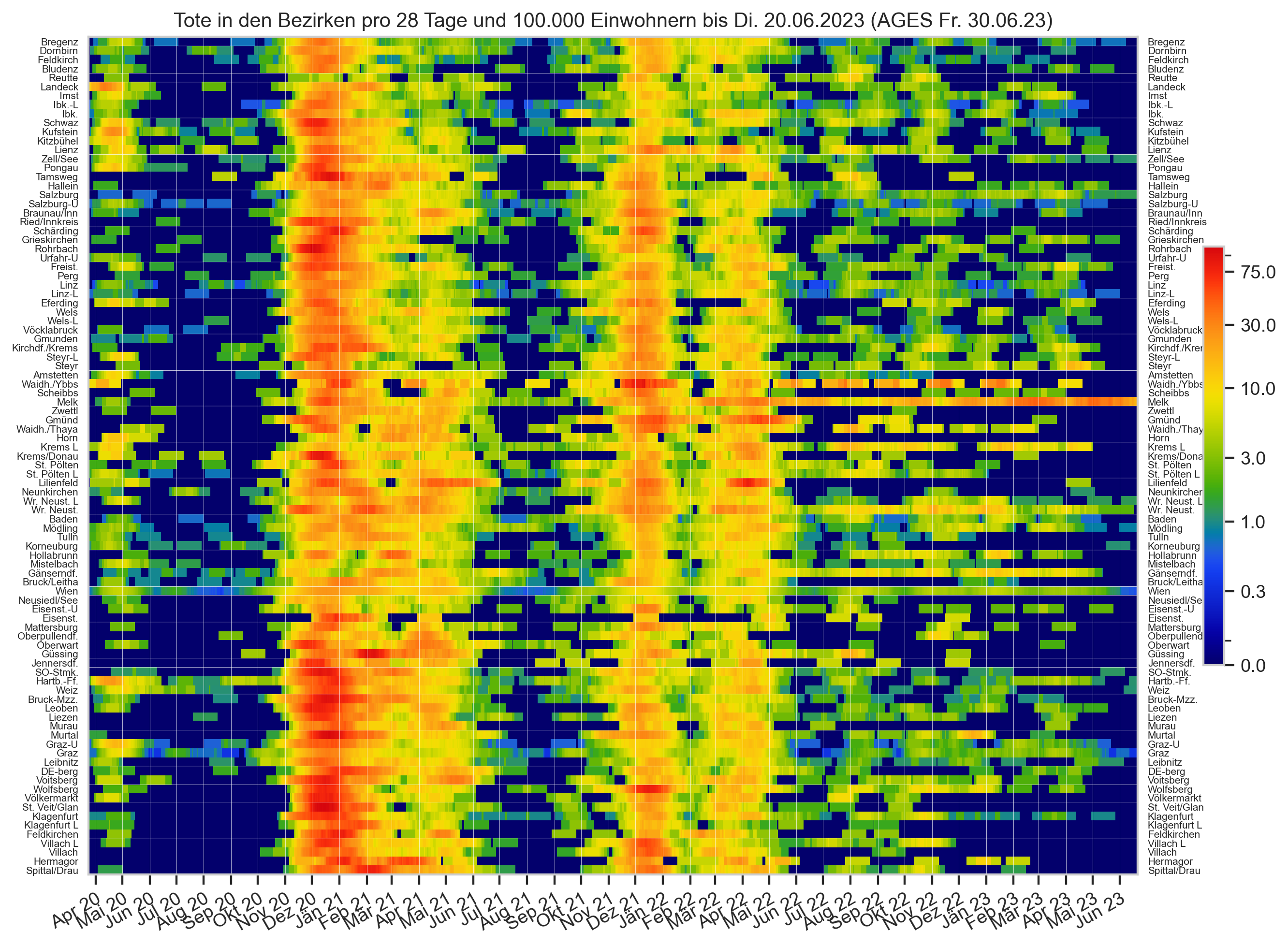
selbezs = ["Melk", "Waidhofen an der Ybbs(Stadt)", "Wiener Neustadt(Stadt)", "Niederösterreich", "Österreich"]
#selbezs = ["Landeck", "Tirol", "Österreich"]
#selbezs = ["Braunau am Inn", "Ried im Innkreis", "Schärding", "Grieskirchen", "Oberösterreich", "Österreich"]
#selbezs = (
# ["Villach Stadt"] +
# list(bez[bez["Bundesland"] == "Kärnten"].query("Bezirk != 'Villach Stadt'")["Bezirk"].unique()) +
# ["Kärnten", "Österreich"])
#selbezs = ["Bruck-Mürzzuschlag", "Steiermark", "Österreich"]
#selbezs = ["Sankt Veit an der Glan", "Kärnten", "Österreich"]
#selbezs = ["Linz(Stadt)", "Oberösterreich", "Österreich"]
#selbezs = ["Lilienfeld", "Melk", "Gmünd"]
bez0 = bez[bez["Bezirk"].isin(selbezs)].copy()
with cov.calc_shifted(bez0, "Bezirk", 28, newcols=["dead28"]) as shifted:
bez0["dead28"] = (bez0["AnzahlTotSum"] - shifted["AnzahlTotSum"]) / bez0["AnzEinwohner"] * 100_000
with cov.calc_shifted(bez0, "Bezirk", 7, newcols=["dead_a7"]) as shifted:
bez0["dead_a7"] = (bez0["AnzahlTotSum"] - shifted["AnzahlTotSum"]) / 7
for sbez in selbezs:
print(sbez, bez0[bez0["Bezirk"] == sbez].iloc[-1]["AnzEinwohner"])
bez0 = bez0[bez0["Datum"] >= bez0.iloc[-1]["Datum"] - timedelta(430)]
#mdead = bez.groupby("Datum", as_index=False).agg({"dead14": "max"})
#mdead["Bezirk"] = "Maximum aller Bezirke"
#display(mdead.tail(10))
#bez0 = pd.concat([bez0, mdead]).reset_index(drop=True)
showdet=True
pal = "tab20" if len(selbezs) > 10 else "tab10"
with cov.with_palette(pal):
fig, axs = plt.subplots(nrows=2, gridspec_kw={'height_ratios': [0.8, 0.2]}, sharex=True) if showdet else plt.subplots()
if not showdet:
axs = np.array([axs])
sns.lineplot(ax=axs[0], data=bez0, hue="Bezirk", y="dead28", x="Datum",
hue_order=reversed(selbezs),
palette=sns.color_palette(pal, n_colors=len(selbezs))[::-1],
err_style=None
)
if len(selbezs) >= 10:
axs[0].legend(ncol=2, fontsize="small")
cov.set_date_opts(axs[-1], bez0["Datum"], showyear=True)
if showdet:
bez_oo = bez0[bez0["Bezirk"] == selbezs[0]].set_index("Datum")
axs[1].bar(bez_oo.index, bez_oo["AnzahlTot"], lw=0, width=timedelta(0.8 if len(bez_oo) <= 300 else 1), snap=False, aa=True)
axs[1].plot(bez_oo.index, bez_oo["dead_a7"], alpha=0.5, color="k")
axs[1].yaxis.set_major_locator(matplotlib.ticker.MaxNLocator('auto', integer=True, min_n_ticks=3))
axs[1].set_ylabel("Tote/Tag")
axs[1].set_title("Tote in " + selbezs[0] + " täglich & 7-Tage-Schnitt")
fig.autofmt_xdate()
axs[0].set_ylabel("Tote/4 Wochen/100.000 EW")
#ax.set_xlim(*ax.get_xlim())
for ax in axs:
ax.set_ylim(bottom=0)
ax.axvspan(matplotlib.dates.date2num(bez.iloc[-1]["Datum"] - timedelta(9)), ax.get_xlim()[1], color="k", alpha=0.2)
ax.axvline(bez.iloc[-1]["Datum"] - timedelta(9), color="k", lw=1)
fig.suptitle("Tote pro 4 Wochen pro 100.000 EW" + AGES_STAMP, y=0.93);
Melk 78779.0 Waidhofen an der Ybbs(Stadt) 11187.0 Wiener Neustadt(Stadt) 47407.0 Niederösterreich 1727866.4520547944 Österreich 9135917.424657535
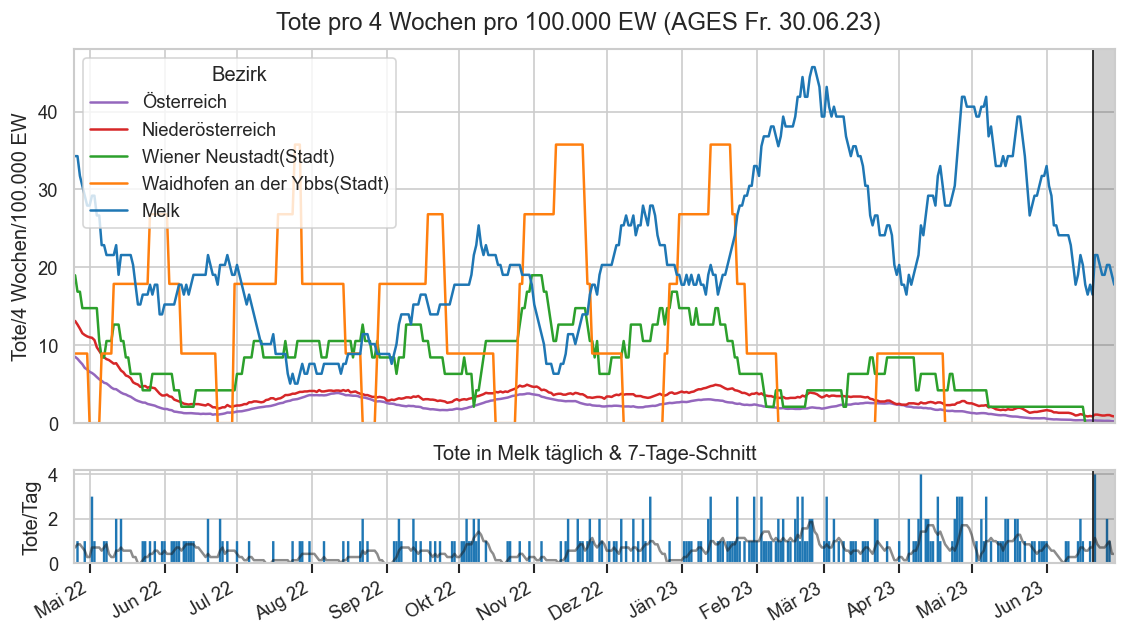
display(bez["Bezirk"].unique())
array(['Amstetten', 'Baden', 'Bludenz', 'Braunau am Inn', 'Bregenz',
'Bruck an der Leitha', 'Bruck-Mürzzuschlag', 'Burgenland',
'Deutschlandsberg', 'Dornbirn', 'Eferding', 'Eisenstadt(Stadt)',
'Eisenstadt-Umgebung', 'Feldkirch', 'Feldkirchen', 'Freistadt',
'Gmunden', 'Gmünd', 'Graz(Stadt)', 'Graz-Umgebung', 'Grieskirchen',
'Gänserndorf', 'Güssing', 'Hallein', 'Hartberg-Fürstenfeld',
'Hermagor', 'Hollabrunn', 'Horn', 'Imst', 'Innsbruck-Land',
'Innsbruck-Stadt', 'Jennersdorf', 'Kirchdorf an der Krems',
'Kitzbühel', 'Klagenfurt Land', 'Klagenfurt Stadt', 'Korneuburg',
'Krems an der Donau(Stadt)', 'Krems(Land)', 'Kufstein', 'Kärnten',
'Landeck', 'Leibnitz', 'Leoben', 'Lienz', 'Liezen', 'Lilienfeld',
'Linz(Stadt)', 'Linz-Land', 'Mattersburg', 'Melk', 'Mistelbach',
'Murau', 'Murtal', 'Mödling', 'Neunkirchen', 'Neusiedl am See',
'Niederösterreich', 'Oberpullendorf', 'Oberwart', 'Oberösterreich',
'Perg', 'Reutte', 'Ried im Innkreis', 'Rohrbach', 'Rust(Stadt)',
'Salzburg', 'Salzburg(Stadt)', 'Salzburg-Umgebung',
'Sankt Johann im Pongau', 'Sankt Pölten(Land)',
'Sankt Pölten(Stadt)', 'Sankt Veit an der Glan', 'Scheibbs',
'Schwaz', 'Schärding', 'Spittal an der Drau', 'Steiermark',
'Steyr(Stadt)', 'Steyr-Land', 'Südoststeiermark', 'Tamsweg',
'Tirol', 'Tulln', 'Urfahr-Umgebung', 'Villach Land',
'Villach Stadt', 'Voitsberg', 'Vorarlberg', 'Vöcklabruck',
'Völkermarkt', 'Waidhofen an der Thaya',
'Waidhofen an der Ybbs(Stadt)', 'Weiz', 'Wels(Stadt)', 'Wels-Land',
'Wien', 'Wiener Neustadt(Land)', 'Wiener Neustadt(Stadt)',
'Wolfsberg', 'Zell am See', 'Zwettl', 'Österreich'], dtype=object)
Impfungen vs. Inzidenzen pro Bezirk¶
Das folgende Diagramm zeigt die aktuelle Situation in den Bezirken bezüglich Anteil vollgeimpfter Personen (x-Achse) und Inzidenz (y-Achse) im Zusammenhang.
Die hellblaue Linie teilt die Punktwolke der Bezirke ungefähr in der Mitte.
Die Farbe der Punkte gibt das Bundesland an, die Größe die Einwohnerzahl des Bezirks.
if False:
cov=reload(cov)
def loadimpfbez():
gis = gis_o.copy()
# Since the data is published on the same day (23:59:59), use timedelta of full 7 days here.
def add_prev(days_before: int) -> None:
gis_o_prev = cov.load_gem_impfungen(gis.iloc[-1]["Datum"] - np.timedelta64(days_before, "D"))
assert gis_o["Datum"][-1] - gis_o_prev["Datum"][-1] == np.timedelta64(days_before, "D"), "Bad timedelta"
#print(gis_o_prev["Datum"][-1])
gis[f"Vollimmunisierte_d{days_before}"] = gis["Vollimmunisierte"] - gis_o_prev["Vollimmunisierte"]
gis[f"Teilgeimpfte_d{days_before}"] = gis["Teilgeimpfte"] - gis_o_prev["Teilgeimpfte"]
gis[f"VollimmunisiertePro100_d{days_before}"] = gis["VollimmunisiertePro100"] - gis_o_prev["VollimmunisiertePro100"]
gis[f"TeilgeimpftePro100_d{days_before}"] = gis["TeilgeimpftePro100"] - gis_o_prev["TeilgeimpftePro100"]
add_prev(1)
add_prev(7)
bfs_o = cov.filterlatest(bez[np.isfinite(bez["GKZ"])])
bis = cov.group_impfungen_by_bez(gis)
bfs = bfs_o.set_index("GKZ")
ds = bfs.join(bis.reset_index("Datum", drop=True).drop(columns="BundeslandID"))
ds["ImmunSpekulationPro100"] = ds["InfektionenPro100"] + ds["VollimmunisiertePro100"]
ds["ImmunSpekulationPro100_d1"] = ds["InfektionenPro100_d"] + ds["VollimmunisiertePro100_d1"]
ds["ImmunSpekulationPro100_d7"] = ds["InfektionenPro100_d7"] + ds["VollimmunisiertePro100_d7"]
ds.sort_values(by="Bundesland", inplace=True)
return ds
ds = loadimpfbez();
ds["KFZ"] = ds["Bezirk"].apply(cov.bezname_to_kfz)
if False:
from scipy.stats import linregress
cov=reload(cov)
bezimpf_cur = cov.filterlatest(bez_impf.reset_index(["Datum"])).drop(columns="Datum")
#display(bezimpf_cur)
bezimpf_cur.index = bezimpf_cur.index.astype(float)
bez_cur = (
bez[np.isfinite(bez["GKZ"])]
.set_index(["GKZ"])
.drop(columns=["BundeslandID", "AnzEinwohner", "Bundesland"])
.join(bezimpf_cur)
.reset_index())
bez_cur["dose3_percent"] = bez_cur["dose_3"] / bez_cur["AnzEinwohner"] * 100
#bez_cur = bez_cur[bez_cur["Datum"] == bez_cur.iloc[-1]["Datum"] - timedelta(2)]
bez_cur = cov.filterlatest(bez_cur)
#bez_cur.sort_index(inplace=True)
bez_cur.set_index("Bezirk", inplace=True)
bez_cur["AnzahlFaelleOmiSum"] = (bez_cur["AnzahlFaelleSum"] - bez.query("Datum == '2022-01-01'").set_index("Bezirk")["AnzahlFaelleSum"])
bez_cur["AnzahlFaelleOmi_pp"] = bez_cur["AnzahlFaelleOmiSum"] / bez_cur["AnzEinwohner"]
#display(bez_cur)
#bez_cur.loc[900, "Bezirk"] = "Wien"
ds = bez_cur.reset_index()
def pltbezcurcorr(mode="omi", ds=ds):
usedose3 = True
xcol = "dose3_percent" if usedose3 else "valid_certificates_percent"
#xcol = "dose3_percent"
ycol = "AnzahlFaelleOmi_pp" if mode == "omi" else "dead91" if mode == "dead" else "inz"
scol = "AnzEinwohner"
ds = ds.copy()
if mode == "dead":
ds = ds.query("Bezirk not in ('Rust(Stadt)')")
fig = plt.figure(figsize=(4*3, 3*3))
ax = fig.subplots()
def drawreg(ds0, color, lkws=None):
sns.regplot(
scatter=False,
ax=ax,
data=ds0,
x=xcol,
y=ycol,
color=color,
order=1,
#logx=True,
#robust=True,
#lowess=True,
line_kws={"zorder": -1, **(lkws or {})},
ci=None)
for i, bl in enumerate(list(ds["Bundesland"].unique()) + ["Österreich"]):
ds0 = ds[ds["Bundesland"] == bl] if bl != "Österreich" else ds
if len(ds0) >= 4:
pv = linregress(ds0[xcol], ds0[ycol]).pvalue
cl = f"C{i}" if bl != "Österreich" else "k"
if pv < 0.005:
drawreg(ds0, cl, lkws=dict(lw=0.7))
elif pv < 0.05:
drawreg(ds0, cl, lkws=dict(alpha=0.5, lw=1))
elif pv < 0.5:
drawreg(ds0, cl, lkws=dict(alpha=0.5, ls=":", lw=0.7))
else:
drawreg(ds0, cl, lkws=dict(alpha=0.3, ls=":", lw=0.4))
print(i, bl, pv)
sns.scatterplot(
ax=ax,
data=ds,
x=xcol,
y=ycol,
hue="Bundesland",
size=scol,
#marker="X",
sizes=(5, 200),
size_norm=matplotlib.colors.Normalize(vmin=10_000, vmax=500_000),
#legend=False,
zorder=2)
if False:
rgb_values = sns.color_palette(None, len(ds["Bundesland"].unique()))
# Map label to RGB
color_map = dict(zip(ds["Bundesland"].unique(), rgb_values))
ax.quiver(
ds[xcol],
ds[ycol] - ds[ycol + "_d7"],
np.repeat(0, len(ds)),
ds[ycol + "_d7"],
color=ds["Bundesland"].map(color_map),
units="xy",
angles="xy",
scale_units="xy",
scale=1,
width=2,
alpha=0.5,
zorder=1.5,
headaxislength=5,
headlength=10,
headwidth=10)
if False:
rgb_values = sns.color_palette(None, len(ds["Bundesland"].unique()))
# Map label to RGB
color_map = dict(zip(ds["Bundesland"].unique(), rgb_values))
ax.quiver(
ds["VollimmunisiertePro100"] - ds["VollimmunisiertePro100_d7"],
ds[ycol +"_prev7"],
ds["VollimmunisiertePro100_d7"] - ds["VollimmunisiertePro100_d1"],
ds[ycol + "_d7"] - ds[ycol + "_d"],
color=ds["Bundesland"].map(color_map),
units="xy",
angles="xy",
scale_units="xy",
scale=1,
width=0.3,
alpha=0.5,
zorder=1.5,
headaxislength=0)
ax.quiver(
ds["VollimmunisiertePro100"] - ds["VollimmunisiertePro100_d1"],
ds[ycol + "_prev"],
ds["VollimmunisiertePro100_d1"],
ds[ycol + "_d"],
color=ds["Bundesland"].map(color_map),
units="xy",
angles="xy",
scale_units="xy",
scale=1,
width=0.3,
alpha=0.2,
zorder=1.5,
headaxislength=0)
def addlabels():
for i in range(ds.shape[0]):
item = ds.iloc[i]
#if np.isnan(item["InfektionenPro100"]): # Wien
# continue
x = item[xcol]
y = item[ycol]
bname = item["Bezirk"]
#display(bname)
#if kfz.loc[bname]["ID"] in ("KI",) or bname in ("Wels-Land", "Eisenstadt-U"):
# y += 1
#if kfz.loc[bname]["ID"] in ("GR",) or bname in ("Mistelbach"):
# y -= 1
#if item["inz"] < 35 or item["inz"] > 130 or item["VollimmunisiertePro100"] < 51 or item["VollimmunisiertePro100"] > 68:
ax.annotate(cov.shorten_bezname(bname), (x, y),
#cov.bezname_to_kfz(bname),
size=8, ha="center", color="grey", zorder=1.1,
xytext=(0, 0 if item[scol] < 50_000 else 5),
textcoords='offset points')
#print(x,y,cov.shorten_bezname(bname),bname)
#else:
# ax.text(x, y + 2, kfz.loc[bname]["ID"], size=6, ha="center")
ax.set_ylim(bottom=0)
ax.set_ylabel("Kumulative Inzidenz seit 1.1.21" if mode == "omi"
else "Aktuelle 7-Tages-Inzidenz/100.000 EW" if mode == "inz"
else "Tote letzte 91 Tage/100.000 EW" if mode == "dead"
else None)
#ax.set_ylabel("Anstieg 7-Tages-Inzidenz ggü. 7 Tage vorher (Faktor)")
#ax.set_xlabel("Einwohner mit gültigen Impfzertifikaten in Prozent")
ax.set_xlabel("Einwohner mit 3. Impfung in Prozent" if usedose3 else "Gem. Empfehlung (1-Jahresfrist für Auffrischung)")
if False: # Hochrisiko-Grenze Herbst 2021
ax.plot(
np.hstack([[0], np.arange(50, 70 + 1, 5), [100]]),
np.hstack([np.arange(300, 800 + 1, 100), [100_000]]),
color="red",
scalex=False,
scaley=False,
drawstyle="steps-post",
zorder=0.55,
label="Hochrisiko-Grenze")
if mode == "omi":
cov.set_percent_opts(ax)
elif mode == "inz":
cov.set_logscale(ax)
ax.yaxis.set_major_locator(matplotlib.ticker.MultipleLocator(100))
ax.xaxis.set_major_locator(matplotlib.ticker.MultipleLocator(5))
ax.xaxis.set_minor_locator(matplotlib.ticker.MultipleLocator(1))
ax.xaxis.set_major_formatter(matplotlib.ticker.PercentFormatter(decimals=0))
ax.grid(which="minor", lw=.2, axis="x")
#ax.set_yticks(100, 200, 300)
ax.set_ylim(bottom=ds[ycol].sort_values().iloc[1] * 0.95)
addlabels()
cov.remove_labels_after(ax, "AnzEinwohner", loc="best", ncol=2, fontsize="x-small")
ax.set_title("Bezirke: Impfquote und {} bis ".format(
"Kumulative Inzidenz seit 1.1.21" if mode == "omi"else
"Tote in 91 Tagen/100.000 EW" if mode == "dead" else
"7-Tages-Inzidenz")
+ ds["Datum"].iloc[-1].strftime("%a %x"));
cov.stampit(ax.figure, cov.DS_BOTH)
#pltbezcurcorr(mode="omi")
pltbezcurcorr(mode="inz")
pltbezcurcorr(mode="dead")
if False:
from scipy.stats import kendalltau, spearmanr, linregress
def plotreg(**kwargs):
bez2 = bez.set_index(["Datum", "GKZ"]).join(
bez_impf.drop(columns=['AnzEinwohner', 'BundeslandID', 'Bundesland']), how="inner")
bezcur = cov.filterlatest(bez2.reset_index(["Datum"]))
#display(linregress(bezcur["dose_3"], bezcur["inz"]))
bez2["dose3_pp"] = bez2["valid_certificates_percent"]# / bez2["AnzEinwohner"]
xcol = "dose3_pp"
corr = bez2.groupby(level="Datum").apply(lambda s: pd.Series(
{#"kendall tau": kendalltau(s[xcol], s["inz"]).correlation,
#"spearman r": spearmanr(s[xcol], s["inz"]).correlation,
"R": linregress(s[xcol], s["inz"]).rvalue}))
#linregress(s["valid_certificates_percent"], s["inz"]))
#display(corr)
ax = corr.plot(**kwargs)
ax.axhline(0, color="k")
#ax.set_ylabel("Lineares Bestimmtheitsmaß $R^2$")
ax.set_xlim(right=ax.get_xlim()[1] + 1)
fig, axs = plt.subplots(nrows=3, sharex=True, figsize=(10, 8))
axs[0].set_title("Linearer Korrelationskoeffizent Anteil mit aktueller Impfung vs. Inzidenz in den Bezirken")
plotreg(ax=axs[0], legend=False)
axs[0].annotate("> 0, d.h. mehr Impfungen \n=> mehr Covid-Fälle", (axs[0].get_xlim()[0], 0.1), fontsize="small")
axs[0].annotate("< 0, d.h. mehr Impfungen \n=> weniger Covid-Fälle", (axs[0].get_xlim()[0], -0.1), va="top", fontsize="small")
axs[1].set_title("7-Tage-Inzidenz pro 100.000 Einwohner, logarithmisch")
if False:
axs[1].plot(fs_at.set_index("Datum")["inz"], label="7-Tage-Inziden/100.000 EW")
else:
sns.lineplot(data=fs.query("Bundesland != 'Österreich'"), hue="Bundesland", x="Datum", y="inz", ax=axs[1],
alpha=0.7, err_style=None)
labelend2(axs[1], fs.query("Bundesland != 'Österreich'"), "inz")
cov.set_logscale(axs[1])
axs[1].legend(fontsize="x-small", ncol=3, loc="lower center", bbox_to_anchor=(0.58, 0))
axs[1].set_ylim(bottom=100)
axs[1].set_ylabel(None)
#axs[1].legend()
if False:
axs[2].plot((mms.query("Bundesland == 'Österreich'").set_index("Datum")["PCRReg"]
- mms.query("Bundesland == 'Wien'").set_index("Datum")["PCRReg"]
- mms.query("Bundesland == 'Niederösterreich'").set_index("Datum")["PCRReg"]).rolling(7).sum() /
(mms.query("Bundesland == 'Österreich'").set_index("Datum")["AnzEinwohner"]
- mms.query("Bundesland == 'Wien'").set_index("Datum")["AnzEinwohner"]
- mms.query("Bundesland == 'Niederösterreich'").set_index("Datum")["AnzEinwohner"]))
cov.set_percent_opts(axs[2])
else:
sns.lineplot(
data=mmx.query("Bundesland != 'Österreich'"), hue="Bundesland", x="Datum", y="TestsRInz", ax=axs[2],
legend=False, alpha=0.7, err_style=None)
labelend2(axs[2], mmx[mmx["Datum"] != mmx["Datum"].iloc[-1]].query("Bundesland != 'Österreich'"), "TestsRInz")
axs[2].yaxis.set_major_formatter(matplotlib.ticker.PercentFormatter(xmax=100_000))
axs[2].set_ylim(top=60_000)
axs[2].set_ylim(bottom=0)
axs[2].set_title("Wöchentlich gemeldete AG+PCR-Tests in % der Einwohner")
axs[2].set_ylabel(None)
cov.set_date_opts(axs[-1], showyear=True)
end_3g = pd.to_datetime("2022-03-05")
test_limit = pd.to_datetime("2022-04-01")
omi = pd.to_datetime("2021-12-31")
for ax in axs:
ax.axvline(end_3g, color="k", zorder=1, lw=1)
ax.axvline(test_limit, color="k", zorder=1, lw=1)
ax.axvline(omi, color="k", zorder=1, lw=1)
axs[-1].annotate("Ende 3G am\nArbeitsplatz", (end_3g, 0), ha="right", fontsize="small")
axs[-1].annotate("Omikron\ndominant", (omi, 0), ha="right", fontsize="small")
axs[-1].annotate("Beschränkung\nGratistests", (test_limit, 0), ha="left", fontsize="small")
if False:
ds0 = ds#.query("Bundesland == 'Salzburg'")
(ds0[[
"Bezirk",
"valid_certificates_percent",
"InfektionenPro100",
"inz_g7",
"AnzEinwohner",
"inz",
"inz_a7"]]
.sort_values(by="valid_certificates_percent", ascending=False)
.assign(AnzEinwohner=ds["AnzEinwohner"].astype(int))
.rename(columns={
"valid_certificates_percent": "% mit 1G-Zertifikat",
"InfektionenPro100": "% Infektionen",
"AnzEinwohner": "Einwohner",
"inz_a7": "7-Tg Ø inz"},)
.set_index(np.arange(1, len(ds0) + 1)))
Bezirke, die auf den letzen oder vorletzen Tag verdächtig wenig Fälle gebucht haben¶
bez[bez["Datum"] >= bez["Datum"].iloc[-1] - timedelta(1)].query("inz_dg7 <= 0.3 and AnzahlFaelle7Tage >= 5 * 7 or AnzahlFaelle == 0 and AnzahlFaelle7Tage >= 3 * 7").set_index(["Datum", "Bezirk"])[["Bundesland", "AnzahlFaelle", "inz_dg7", "AnzahlFaelle7Tage", "AnzEinwohner"]].sort_index()
| Bundesland | AnzahlFaelle | inz_dg7 | AnzahlFaelle7Tage | AnzEinwohner | ||
|---|---|---|---|---|---|---|
| Datum | Bezirk | |||||
| 2023-06-28 | Burgenland | Burgenland | 0 | 0.0 | 24 | 302342.726 |
def plt_growfig(data0, ttl, basecol="inz", showlast=True):
fig, ax = plt.subplots()
color = sns.color_palette(n_colors=1)[0]
def gtox(s):
s = s.copy()
s[s < 1] = -(1 / s) + 1
s[s >= 1] -= 1
return s
inzdx7 = gtox(data0.set_index("Datum")[f"{basecol}_dg7"])
inzx7 = gtox(data0.set_index("Datum")[f"{basecol}_g7"])
ndays = len(data0)
ax.axhline(0, color="k", lw=1, zorder=1)
bar_args = dict(
zorder=2,
lw=0,
aa=True,
snap=False,
alpha=0.3,
width=0.7,
)
ax.bar(
inzdx7.index,
height=inzdx7.where(inzdx7 < 0),
color=color,
edgecolor=color,
label="Niedrigerer Wochentagswert",
**bar_args
)
ax.bar(
inzdx7.index,
height=inzdx7.where(inzdx7 >= 0),
color="C3",
edgecolor="C3",
label="Höherer Wochentagswert",
**bar_args
)
ax.plot(inzx7, color="grey", lw=2)
ax.plot(inzx7.where(inzx7 < 0), color="C0", label="Sinkende Wochensumme", lw=2)
ax.plot(inzx7.where(inzx7 >= 0), color="C3", label="Steigende Wochensumme", lw=2, marker="o",
mew=0, markersize=2.5)
valdates = data0["Datum"].loc[data0["inz_dg7"].first_valid_index():]
alwaysshow = int(-len(valdates) * 0.2)
ax.set_ylim(top=min(3, max(min(ax.get_ylim()[1], 1.5), inzdx7.iloc[alwaysshow:].quantile(0.99, interpolation="higher") * 1.05)),
bottom=max(-3, min(max(ax.get_ylim()[0], -1.5), inzdx7.iloc[alwaysshow:].quantile(0.01, interpolation="lower") * 1.05)))
def fmtx(v, _):
return f"×{v + 1:.2f}" if v >= 0 else f"÷{-v + 1:.2f}"
if showlast:
ax.axhline(inzx7.iloc[-1], color="C0" if inzx7.iloc[-1] < 0 else "C3", lw=1)
ax.annotate(
fmtx(inzx7.iloc[-1], None) + f"\n= {data0[f'{basecol}_g7'].iloc[-1] - 1:+.1%}".replace("-", "−") +
(("\n×2 in " + format(doubling_time(data0[f'{basecol}_g7'].iloc[-1]) * 7, ".0f") + " T") if inzx7.iloc[-1] > 0 else ""),
(inzx7.index[-1], inzx7.iloc[-1]), xytext=(10, 0), textcoords="offset points")
cov.set_date_opts(ax, valdates, showyear=True)
ax.set_xlim(
left=valdates.iloc[0],
right=valdates.iloc[-1] + (valdates.iloc[-1] - valdates.iloc[0]) * 0.01)
fig.legend(loc="upper center", ncol=4, frameon=False, bbox_to_anchor=(0.5, 0.94))
fig.suptitle(f"{ttl}: Inzidenzveränderung gegenüber 7 Tage vorher", y=0.96)
#ax.yaxis.set_major_formatter(matplotlib.ticker.FuncFormatter(lambda v, _: f"×{v:.1f}"))
ax.yaxis.set_major_formatter(matplotlib.ticker.FuncFormatter(fmtx))
fig.autofmt_xdate()
return fig, ax
#selbez = "Imst"
selbez = "Scheibbs"
#selbez = "Tamsweg"
data = bez[bez["Bezirk"] == selbez]
display(Markdown(f"# Details für Bezirk {selbez}\n\nEinwohner: {data.iloc[-1]['AnzEinwohner']:n}"))
if DISPLAY_SHORTRANGE_DIAGS:
fig, axs = plt.subplots(nrows=3, sharey=True, figsize=(8, 8))
fig.suptitle("Positive Tests im Bezirk " + selbez + AGES_STAMP, y=1.025)
fig.subplots_adjust(hspace=0.4)
axs2 = []
ndays=MIDRANGE_NDAYS
axs2.append(make_wowg_diag(bez[bez["Bezirk"] == selbez], "Letzter Stand nach Labordatum", axs[0], ndays=ndays))
#axs[0].tick_params(pad=0)
fig.legend(frameon=False, ncol=2, loc="upper center", bbox_to_anchor=(0.5, 1))
axs2.append(make_wowg_diag(bez1[bez1["Bezirk"] == selbez], "Nur Erstmeldungen nach Labordatum", axs[1], ndays=ndays))
#axs[1].tick_params(pad=0)
axs2.append(make_wowg_diag(bez1m[bez1m["Bezirk"] == selbez], "Nach Meldedatum", axs[len(axs2)], ndays=ndays))
same_axlims(axs, axs2, maxg=2)
#for ax in axs[:2]:
# ax.set_xlim(ax.get_xlim()[0] - 1, ax.get_xlim()[1] - 1)
#data = bez1m[bez1m["Bezirk"] == selbez]
plt_growfig(data, f"Bezirk {selbez}")
fig = plt.figure()
cov.plot_detail_ax(data.set_index("Datum").drop(columns=["ag55_inz", "FZHosp", "nhosp", "icu"], errors="ignore"), plt.gca());
fig.autofmt_xdate()
#fs_at2 = fs_at.copy()
#cov.enrich_inz(fs_at2, "ag55_inz", catcol="Bundesland")
#plt_growfig(fs_at2.query("Datum >= '2020-11-01'"), "55+", "ag55_inz")
Details für Bezirk Scheibbs¶
Einwohner: 41 711
...\AppData\Local\hatch\env\virtual\covidat\MDfikVs6\notebooks\Lib\site-packages\pandas\plotting\_matplotlib\core.py:807: UserWarning: The label '_7-Tage-Summe Tote vol.' of <matplotlib.lines.Line2D object at 0x0000019910C3AA90> starts with '_'. It is thus excluded from the legend. ax.legend(handles, labels, loc="best", title=title)
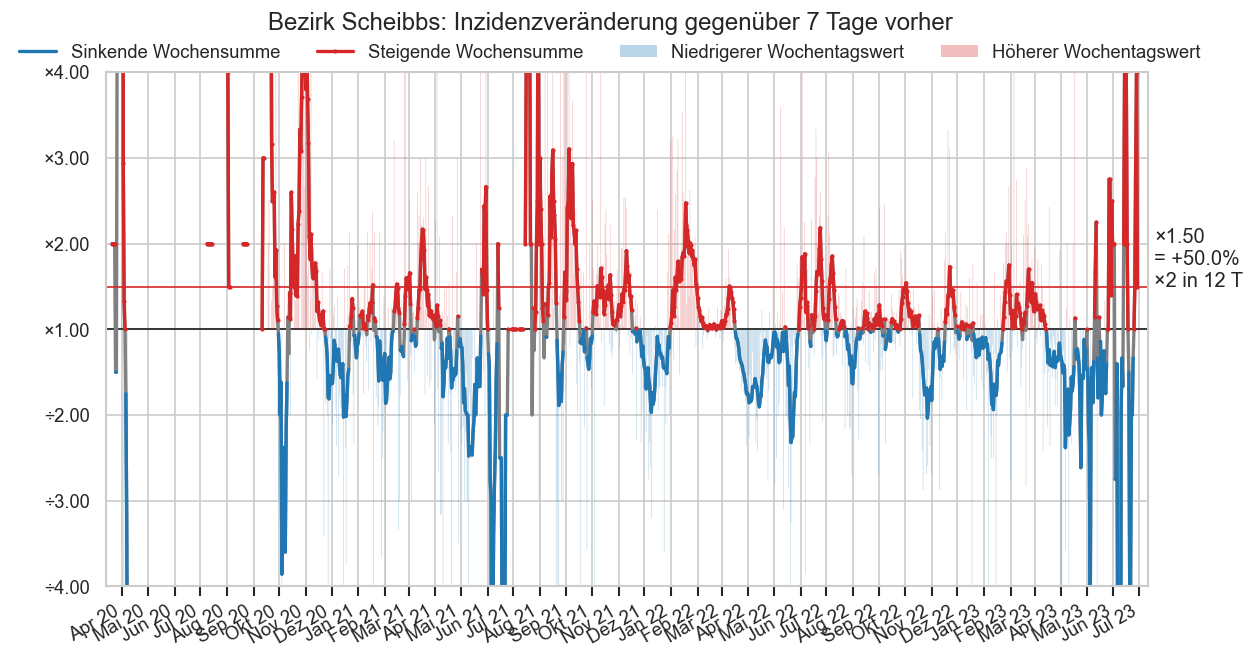
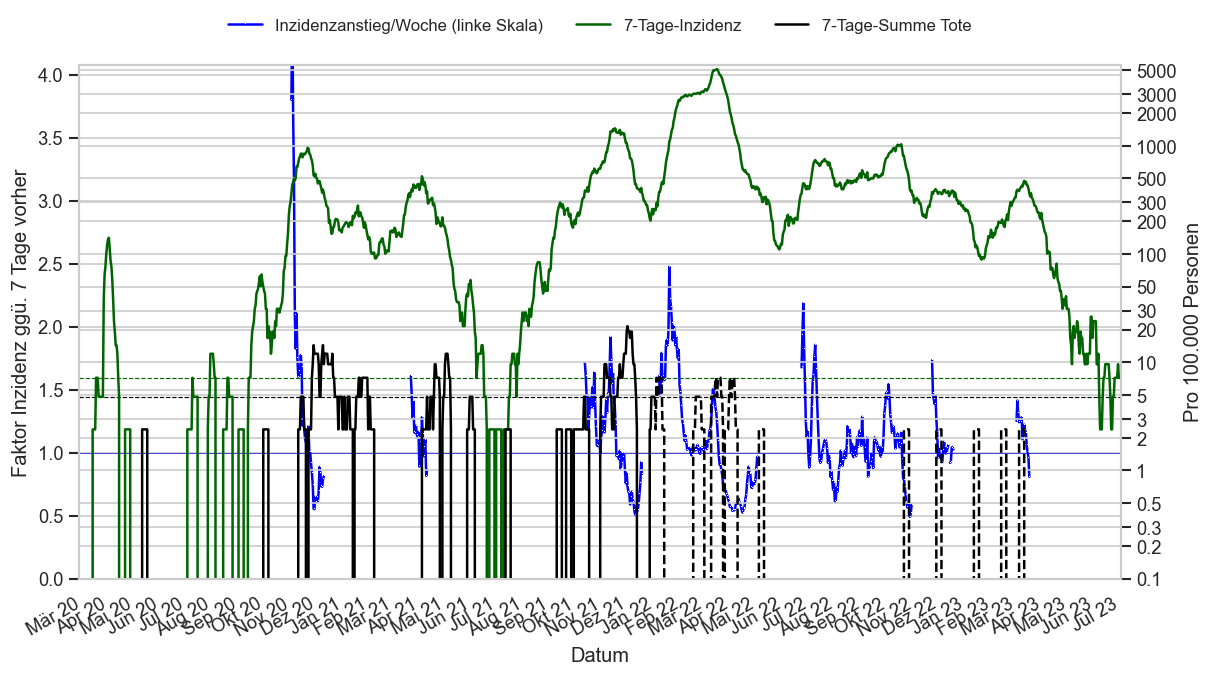
Tests¶
Diese Daten können nur den BMI-Morgenmeldungen entnommen werden. Öfters kommt es deshalb zu Korrekturen was dann zu einer gewaltigen Anzahl neuer PCR Tests oder auch Fällen pro Tag führt, oder auch zu negativen Anzahlen.
Wie man sieht hat Wien (und somit Gesamt-Österreich) sehr hohe Testraten was wohl dem dort stark beworbenen Alles-Gurgelt-Programm zu verdanken ist.
mms_cols = ["PCR", "Antigen", "AnzahlFaelle", "PCRApo", "PCRReg"]
apo_cols = ["PCR", "Antigen", "TestsBetrieb"]
mms_nw = (mmx.query("Bundesland == 'Österreich'").set_index("Datum")[mms_cols] -
mmx.query("Bundesland == 'Wien'").set_index("Datum")[mms_cols])
apo_nw = apo.xs(10)[apo_cols] - apo.xs(9)[apo_cols]
mms_nw["Bundesland"] = "Ö ohne Wien"
mms_nw["PCRRPosRate_a7"] = mms_nw["PCRReg"].rolling(7).sum() / mms_nw["AnzahlFaelle"].rolling(7).sum()
schulat = schul.xs(10).copy()
schulat["Zeit"] = schulat.index.strftime("%d.%m.%y")
schulat["PCR"] /= 1000
schulat["Antigen"] /= 1000
ax = schulat.plot.bar(x="Zeit", y=["PCR", "Antigen"], lw=0)
ax.yaxis.set_minor_locator(matplotlib.ticker.AutoMinorLocator())
ax.yaxis.set_major_formatter(matplotlib.ticker.ScalarFormatter())
ax.yaxis.set_minor_formatter(matplotlib.ticker.ScalarFormatter())
ax.ticklabel_format(useOffset=False, style='plain', axis="y")
ax.tick_params(which="minor", labelleft=False)
ax.grid(which="minor", lw=0.5)
ax.grid(False, axis="x")
ax.set_title("Wöchentlich durchgeführte Schultests in Österreich (in 1000)")
ax.set_xlabel("Datum")
ax.set_ylabel("Anzahl Tests (1000)")
def plt_tests_per_bl(col):
fig, ax = plt.subplots()
sns.lineplot(
data=schul.reset_index().query("Bundesland != 'Österreich'"),
x="Datum", y=col, hue="Bundesland", marker=".", ax=ax, err_style=None)
plt_tests_per_bl("PCR")
plt_tests_per_bl("Antigen")
#sns.lineplot(data=schul.reset_index().query("Bundesland != 'Österreich'"), x="Datum", y="PCR", hue="Bundesland", marker=".")
fig, axs = plt.subplots(figsize=(10,25), nrows=11)
fig.subplots_adjust(hspace=0.3)
fig.suptitle("Im Wochenschnitt gemeldete Tests", y=0.89)
ndays = MIDRANGE_NDAYS
def plt_tests(ax, mms_oo, apo_oo):
mms_oo = mms_oo.copy()
bl = mms_oo["Bundesland"].iloc[0]
mms_oo["PCR_a7"] = mms_oo["PCR"].rolling(7).mean()
mms_oo["Antigen_a7"] = mms_oo["Antigen"].rolling(7).mean()
mms_oo = mms_oo[(mms_oo["Datum"] >= mms_oo["Datum"].iloc[-1] - timedelta(ndays))]
apo_oo = apo_oo[apo_oo.index >= mms_oo.iloc[0]["Datum"] - timedelta(7)]
#ax.plot(fs_oo["Datum"] + timedelta(1), fs_oo["AnzTests"], label="Tests laut AGES", alpha=0.5)
ax.plot(mms_oo["Datum"].dt.normalize(), mms_oo["PCR_a7"], label="BMI PCR", marker=".")
ax.plot(apo_oo["PCR"].iloc[:-1].rolling(7).mean(), label="Apo PCR", marker=".")
ax.plot(apo_oo["TestsBetrieb"].rolling(7).mean(), label="Betriebe", marker=".")
ax.plot(apo_oo["Antigen"].rolling(7).mean(), label="Apo AG", marker=".")
ax.plot(mms_oo["Datum"].dt.normalize(), mms_oo["Antigen"].rolling(7).mean(), label="BMI AG", marker=".")
#print(mms_oo["Antigen"])
#ax.plot(schul_oo["PCR"] / 7, marker=".", label="Schul-PCR")
#ax.plot(hosp_oo["Datum"], hosp_oo["Tests"], label="Tests laut AGES/Hosp", alpha=0.5)
ax.legend(loc="lower left")
#ax.set_ylabel("Anzahl Tests (PCR)");
ax.set_ylabel(bl)
#ax.set_ylim(top=fs_oo["AnzTests"].quantile(0.995))
cov.set_date_opts(ax, mms_oo["Datum"])
ax.set_xlim(left=mms_oo["Datum"].iloc[0])
ax.set_ylim(bottom=0)
for (blid, bl), ax in zip(cov.BUNDESLAND_BY_ID.items(), axs):
#fs_oo = fs.query("Bundesland == 'Niederösterreich'")
apo_oo = apo.xs(blid)
schul_oo = schul.xs(blid).copy()
#hosp_oo = hosp.query("Bundesland == 'Niederösterreich'").copy()
#hosp_oo["Tests"] = hosp_oo["TestGesamt"].diff()
mms_oo = mmx[(mmx["Bundesland"] == bl)].copy()
plt_tests(ax, mms_oo, apo_oo)
plt_tests(axs.flat[-1], mms_nw.reset_index(), apo_nw)
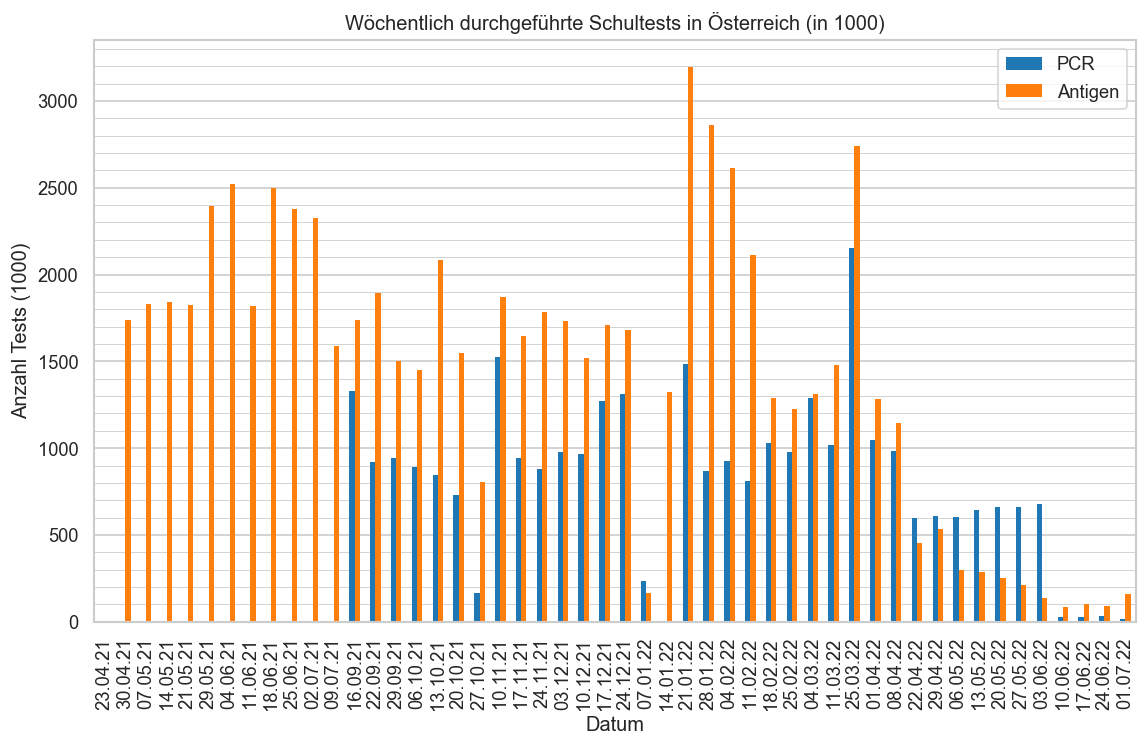
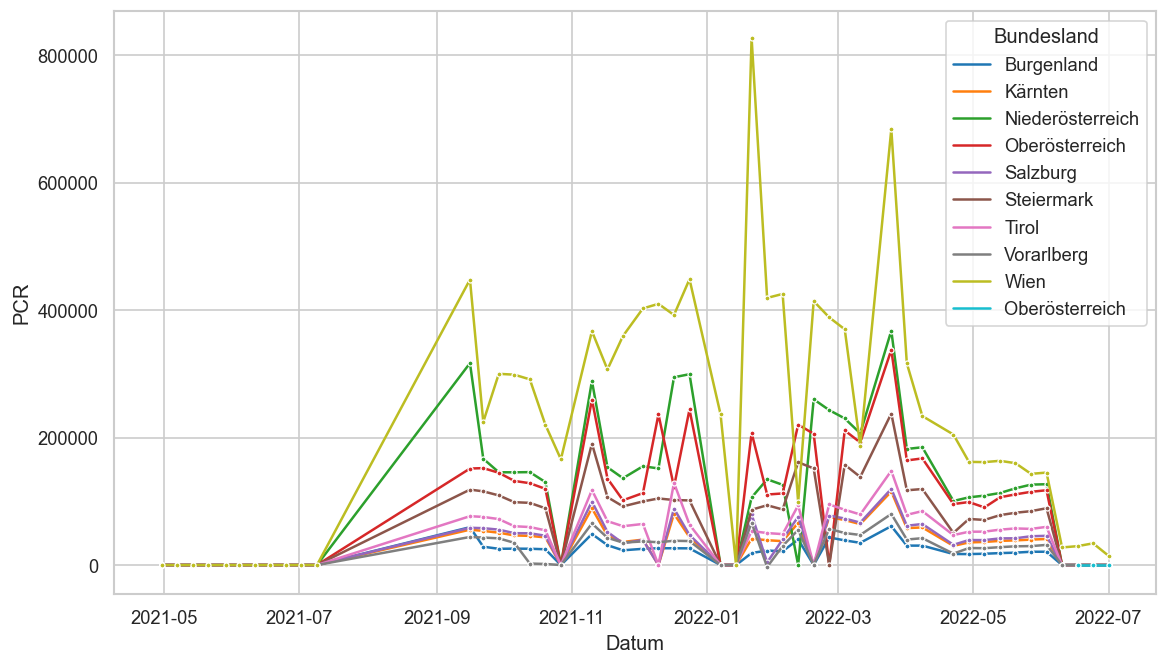
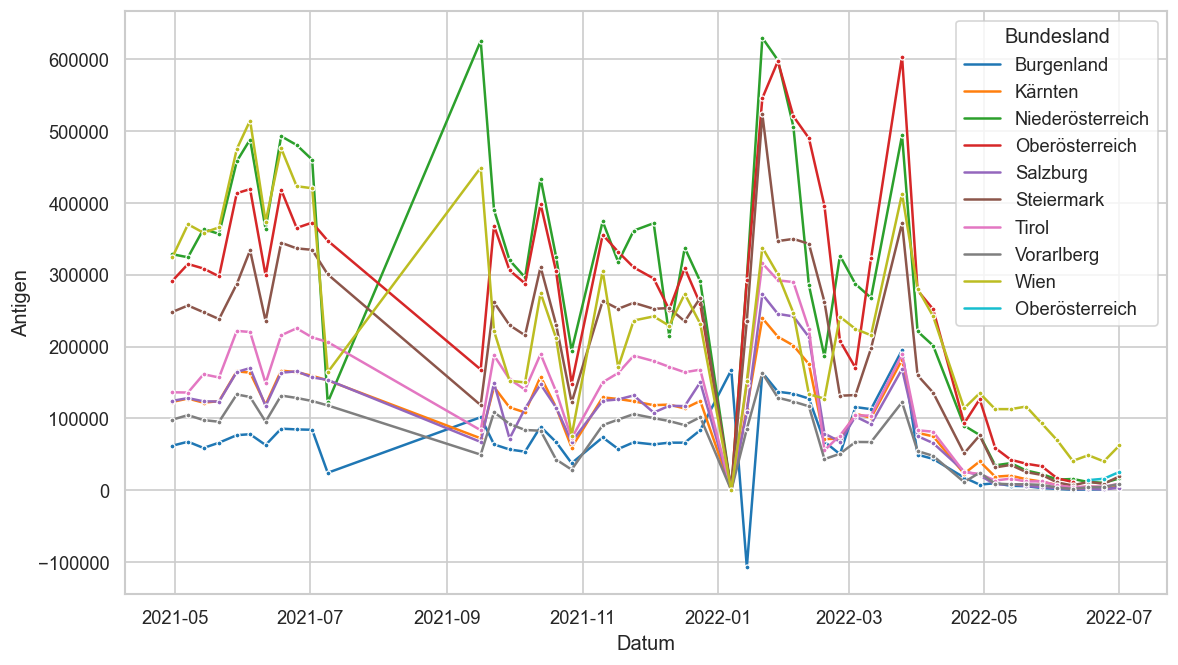
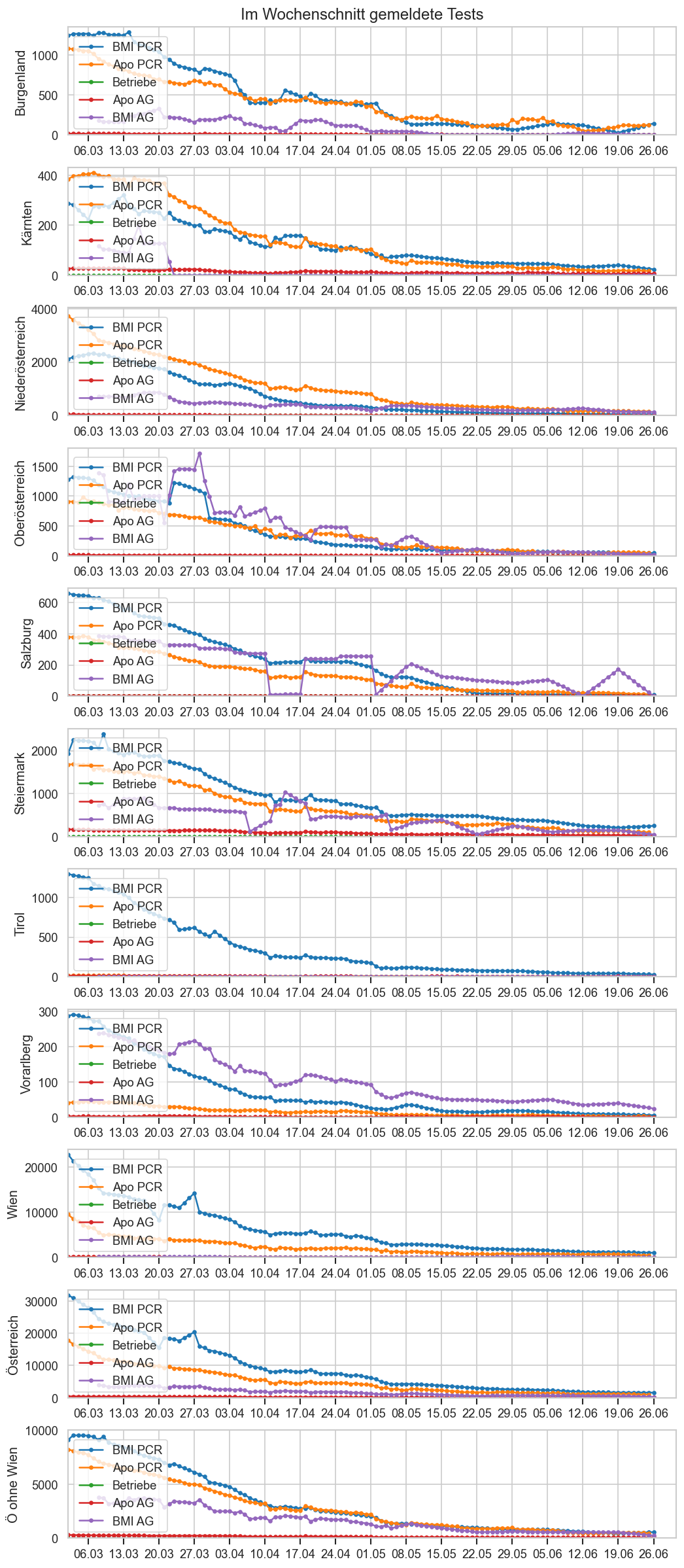
mmx.set_index(["Bundesland", "Datum"])["PCRReg"].tail(11)
Bundesland Datum
Österreich 2023-06-20 2209.7143
2023-06-21 3164.7143
2023-06-22 2545.7143
2023-06-23 2064.7143
2023-06-24 2956.7143
2023-06-25 2095.7143
2023-06-26 2030.7143
2023-06-27 NaN
2023-06-28 NaN
2023-06-29 NaN
2023-06-30 NaN
Name: PCRReg, dtype: float64
ndays=DETAIL_SMALL_NDAYS#7*6 + 1
def plt_tests_cases_daily(mms_oo0, ax):
bl = mms_oo0.iloc[0]["Bundesland"]
mms_oo = mms_oo0.iloc[-ndays - 1:].copy()
mms_oo["Datum"] = mms_oo["Datum"].dt.normalize()
#ax.plot(fs_oo["Datum"] + timedelta(1), fs_oo["AnzTests"], label="Tests laut AGES", alpha=0.5)
#ax.plot(mms_oo["Datum"].dt.normalize(), mms_oo["PCR"].rolling(7).mean(), label="Laut BMI", marker=".")
#ax.plot(apo_oo["Datum"].dt.normalize(), apo_oo["PCR"].rolling(7).mean(), label="Apotheken", marker=".")
#ax.plot(hosp_oo["Datum"], hosp_oo["Tests"], label="Tests laut AGES/Hosp", alpha=0.5)
pltr = cov.StackBarPlotter(ax, mms_oo["Datum"].iloc[1:], lw=0)
pltr(mms_oo["PCR"].iloc[1:], label="PCR lt. Ländermeldung", color="C0")
pltr(mms_oo["PCRApo"].iloc[1:], label="Apotheken-PCR", color="C4")
#ax.bar(, mms_oo["PCR"], label="PCR-Tests lt. BMI (links)", color="C0")
ax2 = ax.twinx()
ax2.plot(mms_oo["Datum"].dt.normalize(),
mms_oo["AnzahlFaelle"], label=f"Fälle lt. {'AGES nach Meldedatum' if haveages else '9:30-Krisenstabmeldung'} (rechts)",
color="C1",
marker=".",
lw=2,
mew=0.5,
markeredgecolor="white")
top3 = (mms_oo["PCR"] + mms_oo["PCRApo"]).sort_values().iloc[-3]
ax2.set_ylim(bottom=0)
if ax.get_ylim()[1] > top3 * 5:
ax.set_ylim(top=top3 * 2)
ax2.tick_params(labelsize="small")
ax.tick_params(labelsize="small")
if ax in axs[-1]:
cov.set_date_opts(ax, mms_oo["Datum"].iloc[1:].dt.normalize())
ax.tick_params(axis="x", which="minor", labelsize="xx-small", pad=0)
ax.tick_params(axis="x", which="major", labelsize="medium", rotation=0, pad=5)
ax.yaxis.set_major_locator(matplotlib.ticker.MaxNLocator(5))
ax2.yaxis.set_major_locator(matplotlib.ticker.MaxNLocator(5))
if ax is axs.flat[0]:
fig.legend(loc="upper center", bbox_to_anchor=(0.5, 0.95), ncol=3, frameon=False)
#ax.legend(loc="upper left")
#ax2.legend(loc="upper right")
if ax in axs.T[0]:
ax.set_ylabel("Tests")
if ax in axs.T[-1]:
ax2.set_ylabel("Fälle")
ax2.grid(False)
#ax.set_ylabel("Anzahl Tests (PCR)");
ax.set_title(f"{bl} ({mms_oo.loc[mms_oo['PCRRPosRate_a7'].last_valid_index(), 'PCRRPosRate_a7'] * 100:.2n}% positiv in 7 Tagen)", y=0.96)
#ax.set_ylim(top=fs_oo["AnzTests"].quantile(0.995))
ax.set_ylim(bottom=0)
if DISPLAY_SHORTRANGE_DIAGS:
fig, axs = plt.subplots(figsize=(10,10), nrows=5, ncols=2, sharex=True)
fig.suptitle("PCR-Tests und Fälle, Stand " + bltest_o.iloc[-1]["Datum"].strftime("%a %x"))
fig.subplots_adjust(hspace=0.24, wspace=0.32)
#fig.text(0.5, 0.9, "Beschriftung: „Bundesland (Anteil positiver Tests in 7 Tagen)“",
# ha="center", fontsize="small", va="bottom")
for bl, ax in zip(cov.BUNDESLAND_BY_ID.values(), axs.flat):
#fs_oo = fs.query("Bundesland == 'Niederösterreich'")
mms_oo0 = mmx[mmx["Bundesland"] == bl]
plt_tests_cases_daily(mms_oo0, ax)
#fig.autofmt_xdate()
#plt_tests_cases_daily(mms_nw.reset_index(), axs.flat[-1])
cov=reload(cov)
mms0 = mmx.copy()#mms[mms["Datum"] < mms.iloc[-1]["Datum"]]
#mms0 = mms0[np.isfinite[mms0["PCR"]]]
mms0_nw = mms0.query("Bundesland not in ('Wien', 'Österreich')").groupby("Datum").agg({
"AnzahlFaelleSum": "sum",
"AnzahlFaelle": "sum",
"AnzEinwohner": "sum",
"PCRSum": "sum",
"AntigenSum": "sum",
"Tests": "sum",
"TestsAlle": "sum",
"PCR": "sum",
"PCRReg": "sum",
"TestsReg": "sum",
"PCRAlle": "sum",
"TestsSum": "sum",
}).reset_index()
mms0_nw["Bundesland"] = "Ö ohne Wien"
c7 = mms0_nw["AnzahlFaelle"].rolling(7).sum()
mms0_nw["TestsAPosRate_a7"] = c7 / mms0_nw["TestsAlle"].rolling(7).sum()
mms0_nw["PCRAPosRate_a7"] = c7 / mms0_nw["PCRAlle"].rolling(7).sum()
mms0_nw["TestsRPosRate_a7"] = c7 / mms0_nw["TestsReg"].rolling(7).sum()
mms0_nw["PCRRPosRate_a7"] = c7 / mms0_nw["PCRReg"].rolling(7).sum()
mms0_nw["TestsBLPosRate_a7"] = c7 / mms0_nw["Tests"].rolling(7).sum()
mms0_nw["PosRate_a7"] = c7 / mms0_nw["Tests"].rolling(7).sum()
mms0_nw["PCRPosRate_a7"] = c7 / mms0_nw["PCR"].rolling(7).sum()
mms0_nw["inz"] = cov.calc_inz(mms0_nw)
mms0_nw["PCR_s7"] = mms0_nw["PCR"].rolling(7).sum()
def print_test_stats():
data = mms0[np.isfinite(mms0["PCR"])].query("Bundesland == 'Österreich'").tail(15 + 6).set_index("Datum").copy()
data["PCR_s7"] = data["PCR"].rolling(7).sum()
if not np.isfinite(mms0.iloc[-1]["PCR"]):
print("‼ Keine Daten für heute")
mday = data.index[-1].strftime("%A")
data = data.loc[data.index[-1].dayofweek == data.index.dayofweek]
data.sort_index(ascending=False, inplace=True)
agesremark = ", Fälle lt. AGES/Meldedatum" if haveages else ""
print(f"#COVID19at PCR-Tests (inkl. Apotheken) 24h bis {mday}{agesremark} ({data.iloc[0]['Bundesland']}):\n")
isfirst = True
for _, rec in data.iterrows():
nwrec = mms0_nw[mms_nw.index == rec.name].iloc[-1]
if nwrec["PCR"] < 0:
break
#print(nwrec)
def fmtpcr(n):
return format(int(n), "6,").replace(",", ".")
print(
"‒", rec.name.strftime("%d.%m") + ".:",
f"{fmtpcr(rec['PCRReg'])} / {fmtpcr(nwrec['PCRReg'])}{' exkl. Wien' if isfirst else ''}",
f"({rec['PCRRPosRate_a7']*100:.3n}% / {nwrec['PCRRPosRate_a7']*100:.3n}% {'positiv in 7 Tagen' if isfirst else '+'})")
isfirst = False
print_test_stats()
‼ Keine Daten für heute #COVID19at PCR-Tests (inkl. Apotheken) 24h bis Montag, Fälle lt. AGES/Meldedatum (Österreich): ‒ 26.06.: 2.030 / 658 exkl. Wien (4,84% / 6,44% positiv in 7 Tagen) ‒ 19.06.: 2.204 / 682 (5,14% / 9,38% +) ‒ 12.06.: 2.211 / 664 (5,47% / 9,04% +)
#display(mms0_nw.tail(15))
def pltposrate2(mms0_nw, schoolinc=False, ndays=MIDRANGE_NDAYS):
kwargs=dict(marker=".", mew=0)# if mark else dict()
mms0_nw = mms0_nw.iloc[-ndays:]
fig, ax = plt.subplots()
fig.suptitle("Positivrate: " + mms0_nw.iloc[0]["Bundesland"], y=0.95)
#apodiff = (mms0_nw["Datum"].iloc[-1] - apo.index.get_level_values("Datum")[-1]).days + 1
mms0_a = mms0_nw
#if apodiff > 0:
# apomsg = f"die {apodiff} letzten Tage" if apodiff > 1 else "den letzten Tag"
# ax.set_title(f"*Tests inklusive Apotheken wegen Meldeverzögerung ohne {apomsg}")
# mms0_a = mms0_nw.iloc[:-apodiff]
if not schoolinc:
ax.plot(
mms0_a["Datum"], mms0_a["PCRAPosRate_a7"],
label="PCR 9:30-Meldung + Apotheken* + Schulen", **kwargs)
ax.plot(
mms0_a["Datum"], mms0_a["PCRRPosRate_a7"],
label="PCR 9:30-Meldung + Apotheken*", color="C1", **kwargs)
ax.plot(
mms0_a["Datum"], mms0_a["TestsAPosRate_a7"],
label="AG+PCR 9:30-Meldung + Apotheken*" + ("" if schoolinc else " + Schulen"), color="C4", **kwargs)
ax.plot(
mms0_nw["Datum"], mms0_nw["TestsBLPosRate_a7"], label="AG+PCR 9:30-Meldung", color="C2", **kwargs)
ax.plot(
mms0_nw["Datum"], mms0_nw["PCRPosRate_a7"], color="C3",
label="PCR 9:30-Meldung" + (" (inkl. Schulen)" if schoolinc else ""), **kwargs)
ax.set_ylim(top=min(1, mms0_nw["PCRPosRate_a7"].iloc[-60:].max() * 1.1))
ax.set_ylabel("Test-Positivrate (Fälle lt. Krisenstab / Anz. Tests)")
ax2 = ax.twinx()
ax2.set_ylabel("7-Tage-Inzidenz / 100.000 EW")
ax2.plot(mms0_nw["Datum"], mms0_nw["inz"], label="Inzidenz", ls="--", color="k", lw=1)
ax2.grid(False)
ax.legend(loc="upper left")
ax2.legend(loc="upper right")
ax.set_ylim(bottom=0)
ax2.set_ylim(bottom=0, top=ax.get_ylim()[1] * 10_000)
cov.set_percent_opts(ax)
cov.set_date_opts(ax)
return fig, ax, ax2
if False:
fig, ax, ax2 = pltposrate2(mms0.query("Bundesland == 'Österreich'"))
ax2.set_ylim(bottom=0, top=ax.get_ylim()[1] * 20_000)
ax2.yaxis.set_major_locator(matplotlib.ticker.MultipleLocator(400))
fig, ax, ax2 = pltposrate2(mms0.query("Bundesland == 'Wien'"), schoolinc=True)
cov.set_percent_opts(ax, decimals=2)
ax2.set_ylim(bottom=0, top=ax.get_ylim()[1] * 100_000)
#pltposrate2(mms0_nw)
#pltposrate2(mms0.query("Bundesland == 'Oberösterreich'"))
#pltposrate2(mms0.query("Bundesland == 'Tirol'"))
#pltposrate2(mms0.query("Bundesland == 'Steiermark'"))
#pltposrate2(mms0.query("Bundesland == 'Burgenland'"))
def pltpos(ax, pltcol, rmlast=False, mark=True, ndays=MIDRANGE_NDAYS, mms0=mms0):
if rmlast:
mms0 = mms0[mms0["Datum"] != apo.xs(10).index[-1]]
#mms0 = mms0[mms0["Datum"] <= apo.xs(10).index[-1]]
sns.lineplot(
x=mms0["Datum"],
y=mms0[pltcol],
hue=mms0["Bundesland"],
marker="." if mark else "",
markeredgewidth=0,
ax=ax,
err_style=None)
def labelend(ycol, ymax=None):
for bl in mms0["Bundesland"].unique():
ys = mms0[mms0["Bundesland"] == bl][ycol]
ax.annotate(
cov.SHORTNAME_BY_BUNDESLAND[bl],
(mms0["Datum"].iloc[-1], ys.iloc[-1]),
xytext=(5, 0), textcoords='offset points')
ax.annotate(
cov.SHORTNAME_BY_BUNDESLAND[bl],
(mms0["Datum"].iloc[0], ys[np.isfinite(ys)].iloc[0]),
xytext=(-2, 0), textcoords='offset points')
labelend(pltcol)
#cov.set_date_opts(ax, mms0["Datum"])
#plt.setp(ax.get_legend().get_texts(), fontsize='9')
ax.figure.legend(*sortedlabels(ax, mms0, pltcol, fmtval=lambda v: f"{v * 100:.1f}%"), loc="upper center",
#bbox_to_anchor=(0.35, 1)
bbox_to_anchor=(0.5, 0.97),
fontsize="small",
ncol=5,
frameon=False
)
ax.get_legend().remove()
#ax.set_ylim(top=0.25, bottom=0)
ax.set_ylim(bottom=0, top=0.2)
#ax.set_ylim(top=0.3, bottom=0)
cov.set_date_opts(ax, mms0[mms0["Datum"] >= mms0["Datum"].iloc[-1] - timedelta(ndays)]["Datum"])
#ax.set_xlim(left=mms["Datum"].iloc[-1] - timedelta(45), right=mms["Datum"].iloc[-1] +timedelta(1))
cov.set_percent_opts(ax, decimals=1)
ax.yaxis.set_minor_locator(matplotlib.ticker.AutoMinorLocator(2))
ax.grid(axis="y", which="minor", lw=0.5)
ax.set_ylabel("Positivrate")
#ax.set_title("Positivrate je Bundesland im 7-Tage-Schnitt")
#mms_h = mms0.query("Datum >= '2021-04-20'")
if False:
plt.figure(figsize=(9, 4))
ax = plt_tl_heat(
mms0.assign(BLCat=mms0["Bundesland"].astype(cov.Bundesland)).pivot(
index="BLCat", columns="Datum", values=pltcol),
im_args=dict(#norm=matplotlib.colors.Normalize(vmin=0, vmax=0.1),
norm=matplotlib.colors.TwoSlopeNorm(vmin=0, vcenter=0.05, vmax=1/3),
cmap=cov.div_l_cmap,
),
cbar_args=dict(format=matplotlib.ticker.PercentFormatter(xmax=1, decimals=1),
pad=0.08,
ticks=np.arange(0, mms0.loc[np.isfinite(mms0[pltcol]), pltcol].max() + 0.1, 0.05)))[0]
for i, bl in enumerate(reversed(mms0["Bundesland"].astype(cov.Bundesland).unique().sort_values())):
mms0_oo = mms0[mms0["Bundesland"] == bl]
val = mms0_oo.loc[mms0_oo[pltcol].last_valid_index(), pltcol]
plt.annotate(
format(val, ".1%"), (1, i), (5, 0), textcoords="offset points",
xycoords=('axes fraction', 'data'), ha="left")
showboth = False
fig, axs = plt.subplots(nrows=2 if showboth else 1, figsize=(10, 8 if showboth else 6), sharex=True)
if not showboth:
axs = [None, axs]
fig.suptitle(
"Test-Positivrate (PCR Ländermeldung+Apotheke) je Bundesland im 7-Tage-Schnitt, Stand " +
mmx["Datum"].iloc[-1].strftime("%x"),
y=1)
if showboth:
fig.subplots_adjust(hspace=0.17)
pltpos(axs[0], "TestsAPosRate_a7")
axs[0].tick_params(labelbottom=False, which="minor", bottom=False)
axs[0].tick_params(labelbottom=True, bottom=False, which="major", pad=0)
axs[0].set_xlabel(None)
axs[0].set_title("Tests lt. 9:30-Meldung + Apotheken + Schultests inkl. Antigen")
pltpos(axs[1], "PCRRPosRate_a7", rmlast=False)
#axs[1].set_title("Ländermeldung + Apotheken")
axs[1].set_ylim(top=0.5, bottom=0.01)
cov.set_logscale(axs[1])
cov.set_percent_opts(axs[1])
cov.stampit(fig, cov.DS_BOTH)
if False:
fig, ax = plt.subplots()
pltpos(ax, "TestsAPosRate_a7")
ax.set_ylim(bottom=0.02, top=0.7)
ax.set_xlim(right=ax.get_xlim()[1] + 1)
ax.figure.suptitle(
"Test-Positivrate (PCR+Antigen) je Bundesland im 7-Tage-Schnitt, Stand " + mms0.iloc[-1]["Datum"].strftime("%x"),
y=1)
#ax.set_title("Nur Ländermeldung")
cov.set_logscale(ax)
cov.stampit(fig, cov.DS_BOTH)
fig, ax = plt.subplots()
pltpos(ax, "PCRPosRate_a7")
ax.set_ylim(bottom=0.02, top=0.75)
ax.set_xlim(right=ax.get_xlim()[1] + 1)
cov.set_logscale(ax)
ax.figure.suptitle(
"Test-Positivrate (PCR) je Bundesland im 7-Tage-Schnitt, Stand " + mms0.iloc[-1]["Datum"].strftime("%x"),
y=1)
#ax.set_title("Nur Ländermeldung")
cov.stampit(fig, cov.DS_BOTH)
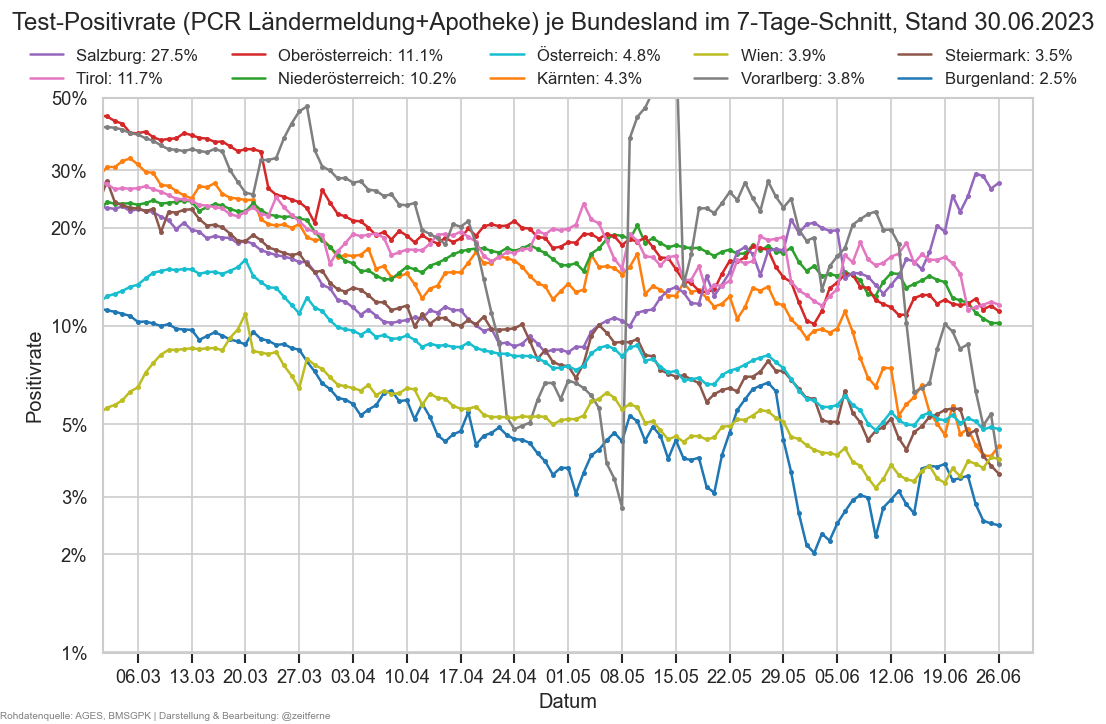
fig, ax = plt.subplots()
fig.suptitle(
"Test-Positivrate (PCR Ländermeldung + Apotheke) je Bundesland im 7-Tage-Schnitt, Stand " +
mmx["Datum"].iloc[-1].strftime("%x"),
y=1)
pltpos(ax, "PCRRPosRate_a7", rmlast=False, ndays=len(mmx), mark=False)
ax.set_xlim(right=ax.get_xlim()[1] + 7)
#ax.set_title("Tests lt. 9:30-Krisenstab-Meldung + Apotheken, Fälle lt. AGES")
ax.set_ylim(top=0.4)
cov.set_date_opts(ax, showyear=True)
fig.autofmt_xdate()
cov.stampit(fig, cov.DS_BOTH)
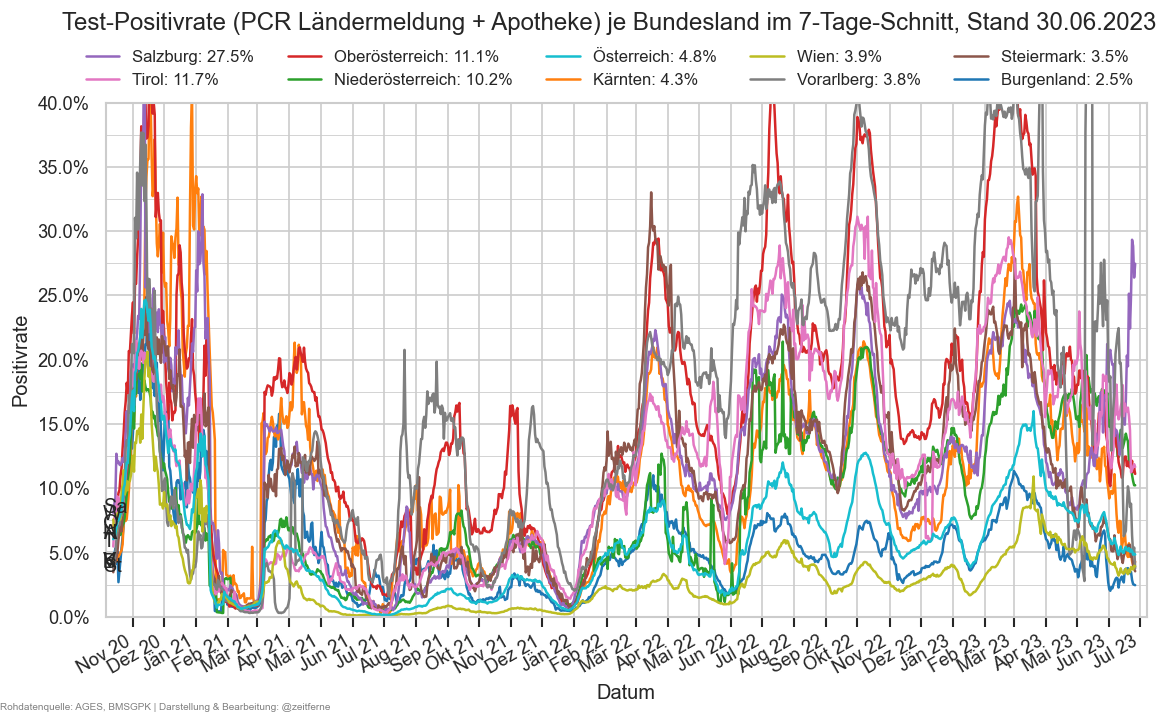
def drawposratelatest():
fig, ax = plt.subplots(figsize=(8, 3))
mms0 = cov.filterlatest(mmx)
sortbl = mms0.sort_values(by="PCRRPosRate_a7")
sns.barplot(
ax=ax,
data=sortbl,
hue_order=mms0["Bundesland"],
x="Bundesland",
hue="Bundesland",
y="PCRRPosRate_a7",
saturation=1,
dodge=False)
ax.yaxis.set_major_locator(matplotlib.ticker.MultipleLocator(0.05))
for i, bl in enumerate(sortbl["Bundesland"]):
bldata = sortbl.iloc[i]
v = bldata["PCRRPosRate_a7"]
ax.annotate(format(v, ".1%"), (i, v),
xytext=(0, 5),
ha="center", textcoords="offset points")
ax.get_legend().remove()
cov.set_percent_opts(ax)
ax.set_ylabel("Fälle / PCR-Tests")
ax.figure.suptitle(f"7-Tage PCR-Positivrate, Stand {mms0.iloc[-1]['Datum'].strftime('%a %x')}", y=0.95)
ax.figure.autofmt_xdate()
if DISPLAY_SHORTRANGE_DIAGS:
drawposratelatest()
ax = mmx.query("Bundesland == 'Wien'").plot(x="Datum", y="PCRRPosRate_a7", color="C8", lw=3, legend=False)
cov.set_percent_opts(ax)
cov.set_date_opts(ax, showyear=True)
ax.set_xlim(right=ax.get_xlim()[1] + 7)
ax.figure.suptitle("Wien: 7-Tage-PCR-Positivrate (9:30-Meldung + Apotheken)", y=0.93)
ax.set_ylim(bottom=0)
ax.figure.autofmt_xdate()
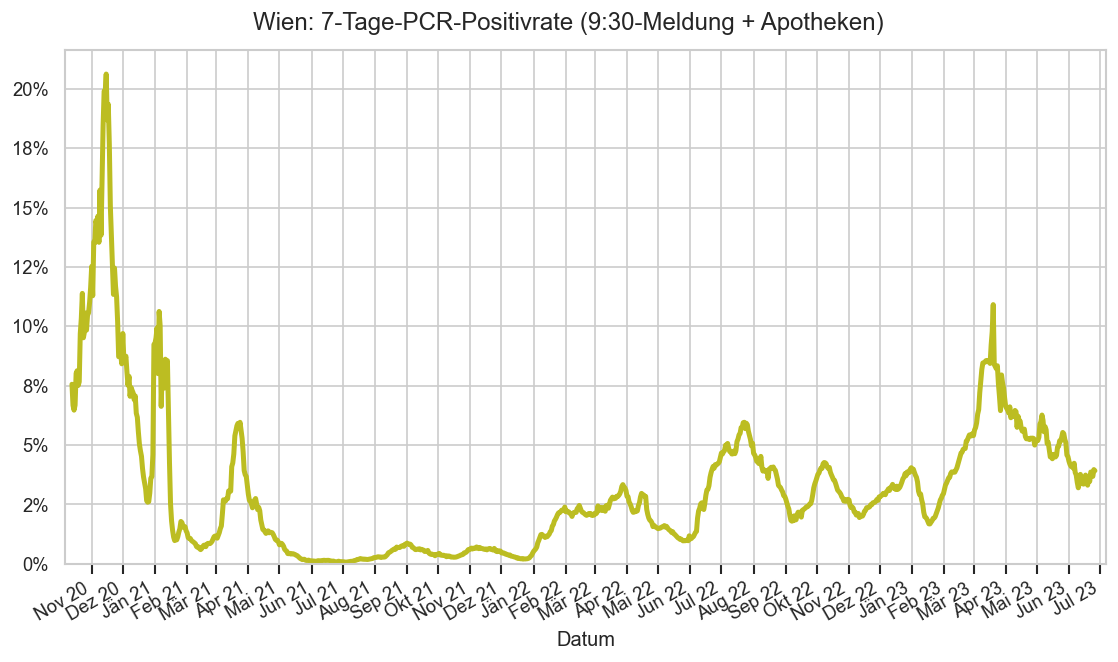
if DISPLAY_SHORTRANGE_DIAGS:
fig, ax = plt.subplots(figsize=(9, 4))
selbl = "Oberösterreich"
df0 = mmx[mmx["Bundesland"] == selbl].copy()
df0["PCRRPosrate"] = df0["AnzahlFaelle"] / df0["PCRReg"]
#print(df0.iloc[-1]["TestsSum"], df0.iloc[-1]["Tests"], df0.iloc[-1]["PCRSum"], df0.iloc[-1]["PCR"])
make_wowg_diag(
df0, selbl, ax, label="PCR-Positivrate", ccol="PCRRPosrate", ndays=7*4)
fig.legend(frameon=False, loc="upper center", bbox_to_anchor=(0.5, 1.01), ncol=2)
fig.suptitle(selbl + ": PCR-Positivrate (9:30 Krisenstabsmeldung + Apotheken)", y=1.05)
ax.set_title(None)
cov.set_percent_opts(ax, decimals=1)
cov=reload(cov)
def plt_pcrs():
pcrcol = "PCRRInz"
mms0 = mmx.copy()
mms0a = mms0[np.isfinite(mms0["PCR"])]
mms0a = mms0a#[mms0a["Datum"] >= mms0["Datum"].iloc[-1] - timedelta(MIDRANGE_NDAYS)]
ax = sns.lineplot(x=mms0a["Datum"], y=mms0a[pcrcol], hue=mms0a["Bundesland"],
#marker='.',
mew=0, err_style=None)
ax.get_legend().remove()
#ax.get_yaxis().set_major_formatter(matplotlib.ticker.PercentFormatter(xmax=1, decimals=1))
ax.set_ylabel("PCR-Tests pro Woche in % d. EW")
cov.set_logscale(ax)
cov.set_percent_opts(ax, decimals=2, xmax=100_000)
ax.set_ylim(bottom=30, top=100_000)
cov.labelend2(ax, mms0a, pcrcol, ends=(True, True), colorize=sns.color_palette())
ax.figure.suptitle("Testrate (Nur PCR, Ländermeldung+Apotheke) pro Bundesland, 7-Tage-Summe, logarithmisch", y=1);
ax.figure.legend(*sortedlabels(ax, mms0a, pcrcol, fmtval=lambda v: f"{v/100_000:.2%}"), ncol=5,
fontsize="small", loc="upper center", frameon=False, bbox_to_anchor=(0.5, 0.96));
cov.set_date_opts(ax, mms0a["Datum"])
fig = ax.figure
fig.autofmt_xdate()
plt_pcrs()
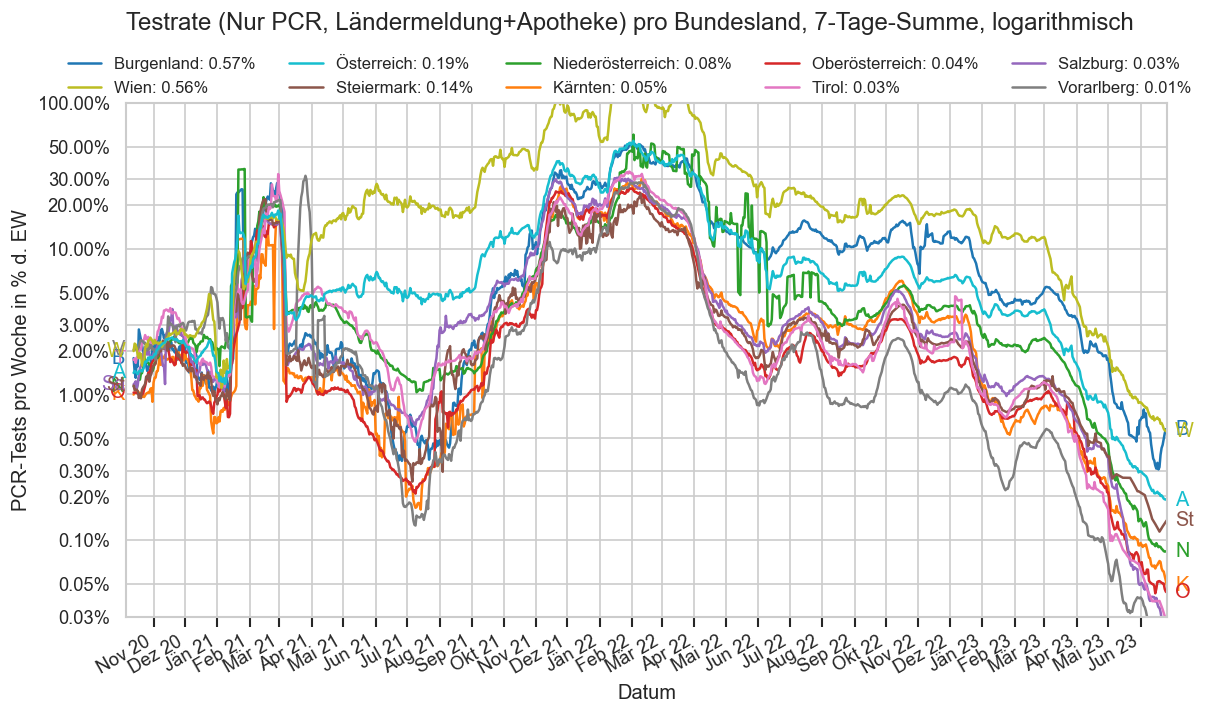
Altersgruppen und Bundesländern¶
Die Bundesländer wurden nach Möglichkeit so angeordnet dass ähnliche untereinander sind. Dabei wurde die NUTS Gliederung (https://www.statistik.at/web_de/klassifikationen/regionale_gliederungen/nuts_einheiten/index.html) herangezogen die Österreich in eine Westregion mit Voralberg, Tirol, Salzburg, OÖ, Ostregion (Niederösterreich, Wien, Burgenland) und eine Südregion (Kärnten, Steiermark) unterteilt. Diese Unterteilung ist auch im Hinblick auf den früheren Schulstart in der Ostregion sinnvoll.
Aktuelle Situation im Überblick¶
Die Farbskalierung der Inzidenzen ist logarithmisch, die der Inzidenzveränderung linear.
Als Lesehilfe ist am Ende eine Heatmap die die Bevölkerungszahlen angibt. Dabei sind in der "Alle" Spalte und der "Österreich" Zeile jeweils durschnittswerte angegeben um die Farbskala nicht zu sprengen. Hier ist also nur ein vergleich innerhalb dieser Zeile bzw. Spalte sinnvoll, nicht mit anderen Feldern.
if False:
cert_s_i = cert_s.copy()
cert_s_i.drop(index="NoState", level="Bundesland", inplace=True)
dt = cert_s_i.index.get_level_values("Datum")[0]
for bl in cert_s_i.index.get_level_values("Bundesland"):
cert_s_i.loc[(dt, bl, "<5"), "certs_pp"] = np.nan
key = (dt, bl, "5-14")
cert_s_i.loc[key] = cert_s_i.loc[(dt, bl, "12-14")] + cert_s_i.loc[(dt, bl, "00-11")]
cert_s_i.loc[key, "AnzEinwohner"] -= agd_sums[
(agd_sums["Bundesland"] == bl) & (agd_sums["Altersgruppe"] == "<5")].iloc[-1]["AnzEinwohner"]
cert_s_i.loc[key, "certs_pp"] = cert_s_i.loc[key, "valid_certificates"] / cert_s_i.loc[key, "AnzEinwohner"]
cert_s_i.index.set_names(cert_s.index.names, inplace=True) # With pandas v2.0, the names seem to get lost
cert_s_i.drop(index=["00-11", "12-14"], level="Altersgruppe", inplace=True)
cert_s_i.rename(index={"85+": ">84", "All": "Alle"}, level="Altersgruppe", inplace=True)
cert_s_i.sort_index(inplace=True)
cov=reload(cov)
#hm.loc[hm["inz_g7"] >= 10, "inz_g7"] = np.nan
def pivoted(valuecol, hm0):
return hm0.pivot(index="Bundesland", columns="Altersgruppe", values=valuecol).sort_index(
axis="columns", key=lambda s: s.map(ag_to_id))
def set_hm_ax_opts(ax):
ax.tick_params(labelbottom=False, labeltop=True, rotation=0)
ax.set_xlabel(None)
ax.set_ylabel(None)
ax.tick_params(pad=-4.5)
def fixup_hms(fig, axs):
fig.subplots_adjust(hspace=0.3)
for ax in axs:
set_hm_ax_opts(ax)
def getquan(s, *, upper, cutoff=0.015):
return s[np.isfinite(s)].quantile(1 - cutoff if upper else cutoff, interpolation="higher" if upper else "lower")
def drawinz(ax, hm0, cmap, label, norm=None, annot=True):
hm0_p = pivoted("inz", hm0).sort_index() # / 1000
#display(hm0_p)
#display(hm0.dtypes)
sns.heatmap(
hm0_p,
cmap=cmap,
fmt=".0f",
#fmt=".2n",
#fmt="3.3n",
#center=0,
annot=annot,
norm=matplotlib.colors.LogNorm(vmin=max(1, getquan(hm0["inz"], upper=False))) if not norm else norm,
ax=ax,
cbar_kws={
#"format": lambda n, _: f"{n:.2n}%", #matplotlib.ticker.PercentFormatter(decimals=1),
#"ticks": np.array([0, 20, 35, 50, 100, 200, 300, 400, 700, 1000, 1500, 2000, 3000, 4000]
# ) / 1000
"format": matplotlib.ticker.FormatStrFormatter("%.0f"),
#"ticks": [0, 1, 2, 3, 4, 5, 7, 10, 20, 35, 50, 100, 200, 300, 500, 800]
"ticks": [0, 20, 35, 50, 100, 200, 300, 400, 700, 1000, 2000, 3000, 5000]
})
#ax.set_title(f"Wöchentlich neu infizierte (%) per {hm0['Datum'].iloc[0].strftime('%a %x')}{AGES_STAMP}")
ax.collections[0].colorbar.ax.yaxis.set_minor_locator(matplotlib.ticker.NullLocator())
ax.set_title(f"7-Tage-{label} per {hm0['Datum'].iloc[0].strftime('%a %x')} {AGES_STAMP}")
def drawginz(ax, hm0, tcmap, label, norm=None):
hm0_p = (pivoted("inz_g7", hm0) - 1) * 100
sns.heatmap(hm0_p,
fmt=".0f",
annot=True,
ax=ax,
#center=1,
#vmax=3,
#vmin=0.5,
norm=matplotlib.colors.TwoSlopeNorm(
vmin=min(getquan(hm0["inz_g7"] * 100 - 100, upper=False) , -1),
vcenter=0,
vmax=max(getquan(hm0["inz_g7"] * 100 - 100, upper=True) , 1)) if not norm else norm,
cmap=tcmap)
ax.set_title(f"Anstieg wöchentlicher {label} (%) auf" +
f" {hm0['Datum'].iloc[0].strftime('%a %x')} i.Vgl. zu 7 Tage vorher lt. AGES")
#drawheatmap(agd_sums, "Inzidenz")
def animheatmap(n_days):
hmb = (agd_sums
.query("Bundesland != 'Österreich' and Altersgruppe != 'Alle'")
.drop(columns="Bundesland")
.rename(columns={"BLCat": "Bundesland"}))
#hmb = hmb.loc[hmb["Bundesland"] != "Österreich"]
norm = matplotlib.colors.LogNorm(vmin=10, vmax=2000)
cl = "lightgrey"
cmap = sns.color_palette("cet_fire", as_cmap=True).copy()
#cmap.set_under("b")
cmap.set_over("white")
with plt.rc_context({
"text.color": cl,
'axes.labelcolor': cl,
'xtick.color': cl,
'ytick.color': cl}):
for past in range(n_days):
hm0 = hmb[hmb["Datum"] == hmb.iloc[-1]["Datum"] - timedelta(past)]
fig = plt.Figure(figsize=(9, 4.5), dpi=120, facecolor="black")
ax = fig.subplots()
ax.set_facecolor("black")
drawinz(ax, hm0, cmap, "Inzidenz", norm=norm, annot=False)
dt = hm0.iloc[-1]["Datum"]
ax.set_title(dt.strftime("%x"))
#ax.tick_params(rotation=0)
fixup_hms(fig, [ax])
fig.tight_layout()
fig.savefig("inzanim/fig-" + format(n_days - past, "03d"))
#animheatmap(len(fs_at))
#animheatmap(1)
agd0 = agd_sums.query("AgeFrom >= 15 and AgeTo <= 65 and Bundesland == 'Österreich'")
display(agd0["Altersgruppe"].unique())
agd0 = agd0.groupby("Datum").agg({"AnzahlFaelle": "sum", "AnzEinwohner": "sum"})
agd0.query("Datum < '2025-07-01'")["AnzahlFaelle"].rolling(30).sum().iloc[-1] / agd0["AnzEinwohner"].iloc[-1] * 100
array(['15-24', '25-34', '35-44', '45-54', '55-64'], dtype=object)
0.0507
def drawheatmap(agd_sums=agd_sums):
agd_sums = agd_sums.copy()
with cov.calc_shifted(agd_sums, "Gruppe", 180):
agd_sums["AnzahlFaelle6M"] = agd_sums["AnzahlFaelle"].rolling(180).sum()
agd_sums["AnzahlFaelle9M"] = agd_sums["AnzahlFaelle"].rolling(240).sum()
agd_sums["AnzahlFaelle12M"] = agd_sums["AnzahlFaelle"].rolling(365).sum()
agd_sums["AnzahlFaelle6MProEw"] = agd_sums["AnzahlFaelle6M"] / agd_sums["AnzEinwohner"]
agd_sums["AnzahlFaelle9MProEw"] = agd_sums["AnzahlFaelle9M"] / agd_sums["AnzEinwohner"]
agd_sums["AnzahlFaelle12MProEw"] = agd_sums["AnzahlFaelle12M"] / agd_sums["AnzEinwohner"]
hm0 = agd_sums[agd_sums["Datum"] == agd_sums.iloc[-1]["Datum"]] #np.datetime64("2020-11-10")]#
hm0 = hm0.drop(columns="Bundesland").rename(columns={"BLCat": "Bundesland"})
hm0m = agd1m_sums[agd1m_sums["Datum"] == agd1m_sums.iloc[-1]["Datum"]] #np.datetime64("2020-11-10")]#
hm0m = hm0m.drop(columns="Bundesland").rename(columns={"BLCat": "Bundesland"})
hm01 = agd1_sums[agd1_sums["Datum"] == agd1_sums.iloc[-1]["Datum"]] #np.datetime64("2020-11-10")]#
hm01 = hm01.drop(columns="Bundesland").rename(columns={"BLCat": "Bundesland"})
hm0m_old = agd1m_sums[agd1m_sums["Datum"] == agd1m_sums.iloc[-1]["Datum"] - timedelta(7)]
hm0m_old = hm0m_old.drop(columns="Bundesland").rename(columns={"BLCat": "Bundesland"})
cmap = cov.un_l_cmap
tcmap = cov.div_l_cmap
if False:
fig2, ax2 = plt.subplots(figsize=(9, 4.5))
drawinz(ax2, hm0, cmap, "Inzidenz")
fixup_hms(fig2, [ax2])
cov.stampit(fig2)
if False:
figm, axsm = plt.subplots(nrows=4, figsize=(10, 12))
norm = matplotlib.colors.LogNorm(
vmin=max(1, min(getquan(hm0["inz"][hm0["inz"] >= 0], upper=False), getquan(hm0m["inz"][hm0m["inz"] >= 0], upper=False))),
vmax=max(2, max(getquan(hm0["inz"], upper=True), getquan(hm0m["inz"], upper=True)))
)
drawinz(axsm[0], hm0m, cmap, "Melde-Inzidenz", norm)
drawinz(axsm[1], hm0, cmap, "Inzidenz", norm)
gnorm = matplotlib.colors.TwoSlopeNorm(
vmin=min(getquan(hm0["inz_g7"] * 100 - 100, upper=False),
getquan(hm0m["inz_g7"] * 100 - 100, upper=False),
-1),
vcenter=0,
vmax=max(
getquan(hm0["inz_g7"] * 100 - 100, upper=True),
getquan(hm0["inz_g7"] * 100 - 100, upper=True),
1))
drawginz(axsm[2], hm0m, tcmap, "Meldungen", gnorm)
drawginz(axsm[3], hm0, tcmap, "Fälle", gnorm)
fixup_hms(figm, axsm)
cov.stampit(figm, cov.DS_AGES)
if DISPLAY_SHORTRANGE_DIAGS:
fig, axs = plt.subplots(nrows=2, figsize=(9, 6))
drawinz(axs[0], hm0, cmap, "Inzidenz")
drawginz(axs[1], hm0, tcmap, "Fälle")
fixup_hms(fig, axs)
cov.stampit(fig)
if DISPLAY_SHORTRANGE_DIAGS:
g1fig, g1ax = plt.subplots(figsize=(9, 3.5))
sns.heatmap(pivoted("inz_dg7", hm01) * 100 - 100,
fmt="2.1f",
annot=True,
ax=g1ax,
#center=1,
#vmax=1.5,
#vmin=0.9,
norm=matplotlib.colors.TwoSlopeNorm(
vmin=min(getquan(hm01["inz_dg7"] * 100 - 100, upper=False, cutoff=0.04) , -1),
vcenter=0,
vmax=max(getquan(hm01["inz_dg7"] * 100 - 100, upper=True, cutoff=0.04) , 1)),
cmap=tcmap)
g1ax.set_title(
f"Fallzahländerung (%) auf {hm01['Datum'].iloc[0].strftime('%x')}"
f" i.Vgl. zur Erstmeldung für vorigen {hm01['Datum'].iloc[0].strftime('%A')}{AGES_STAMP}")
fixup_hms(g1fig, [g1ax])
if True:
fig, ax = plt.subplots(nrows=1, figsize=(9, 4))
axs = [ax]
sns.heatmap(pivoted("AnzahlFaelle9MProEw", hm0) * 100,
fmt=".0f",
annot=True,
ax=axs[0],
#center=1,
#vmax=1.5,
#vmin=0.9,
#norm=matplotlib.colors.TwoSlopeNorm(vmin=0.8, vcenter=1, vmax=1.2),
cmap=cmap)
axs[0].set_title(f"Fälle in % d. EW, letzte 9 Monate, per {hm0['Datum'].iloc[0].strftime('%a %x')} lt. AGES")
if False:
cert0 = cert_s_i.reset_index()
cert0["Bundesland"] = cert0["Bundesland"].astype(cov.Bundesland)
sns.heatmap(pivoted("certs_pp", cert0) * 100,
fmt=".0f",
annot=True,
ax=axs[1],
#center=1,
#vmax=1.5,
#vmin=0.9,
norm=matplotlib.colors.TwoSlopeNorm(
vmin=0,
#vmin=cert0["certs_pp"].min(),
vcenter=max(50, cert_s_i.loc[(cert_s_i.index.get_level_values("Datum")[-1], "Österreich", "Alle"), "certs_pp"] * 100),
vmax=100),
cmap=tcmap[:-2] if tcmap.endswith("_r") else tcmap + "_r")
#cmap=cmap + "_r"#"viridis_r"
axs[1].set_title(f"Grüner Pass oder gem. NIG-Empfehlung (%) per {cert_s_i.index.get_level_values('Datum')[0].strftime('%a %x')} lt. {cov.DS_BMG}")
fixup_hms(fig, axs)
cov.stampit(fig)
if False:
fig, axs = plt.subplots(nrows=2, figsize=(9, 7), dpi=200)
drawinz(axs[0], hm0m, cmap, "Inzidenz nach Meldedatum")
drawginz(axs[1], hm0m, tcmap, "Neuinfektionen nach Meldedatum")
fixup_hms(fig, axs)
if DISPLAY_SHORTRANGE_DIAGS:
norm = matplotlib.colors.LogNorm(
vmin=max(1, min(getquan(hm0m_old["inz"][hm0m_old["inz"] >= 0], upper=False), getquan(hm0m["inz"][hm0m["inz"] >= 0], upper=False))),
vmax=max(2, max(getquan(hm0m_old["inz"][hm0m_old["inz"] >= 0], upper=True), getquan(hm0m["inz"][hm0m["inz"] >= 0], upper=True)))
)
fig, axs = plt.subplots(nrows=2, figsize=(9, 7))
drawinz(axs[0], hm0m, cmap, "Inzidenz nach Meldedatum", norm=norm)
drawinz(axs[1], hm0m_old, cmap, "Inzidenz nach Meldedatum", norm=norm)
fixup_hms(fig, axs)
if True:
bev_fig, bev_axs = plt.subplots(figsize=(9, 6), nrows=2)
bev = pivoted("AnzEinwohner", hm0)
#display(bev)
bev_rel = bev.astype(float).to_numpy()
bev_rel[:, 1:] = bev_rel[:, 1:] / bev_rel[:, 0][:,None]
#display(pd.DataFrame(bev_rel))
#display(bev.iloc[:, 0].to_numpy())
bev_rel[:, 0] /= bev_rel[0, 0]
#bev_rel[0, 0] = np.nan
#bev_rel[0, 3] = np.nan
#display(bev.loc[:"Österreich"])
bev["Alle"] = bev.drop(columns="Alle").mean(axis=1)
bev.loc["Österreich"] = bev.iloc[:-1].mean()
#display(bev.loc[:"Österreich"])
#bev.loc["Österreich", "Alle"] = np.nan # Makes no sense
sns.heatmap(bev / 1000,
fmt="0.1f",
annot=True,
ax=bev_axs[0],
#center=0,
#vmax=3,
#vmin=0.5,
#norm=matplotlib.colors.TwoSlopeNorm(vmin=0.5, vcenter=1, vmax=2),
cmap="Blues")
bev_axs[0].set_title("Bevölkerungszahlen (1000) lt. AGES (Links & oben Durchchnittswerte)")
sns.heatmap(pd.DataFrame(bev_rel, index=bev.index, columns=bev.columns) * 100,
fmt="2.1f",
annot=True,
ax=bev_axs[1],
#center=0,
#vmax=3,
#vmin=0.5,
norm=matplotlib.colors.Normalize(vmax=17),
cmap="Blues")
bev_axs[1].set_title("Altersverteilung (%) pro Bundesland lt. AGES")
fixup_hms(bev_fig, bev_axs)
drawheatmap()
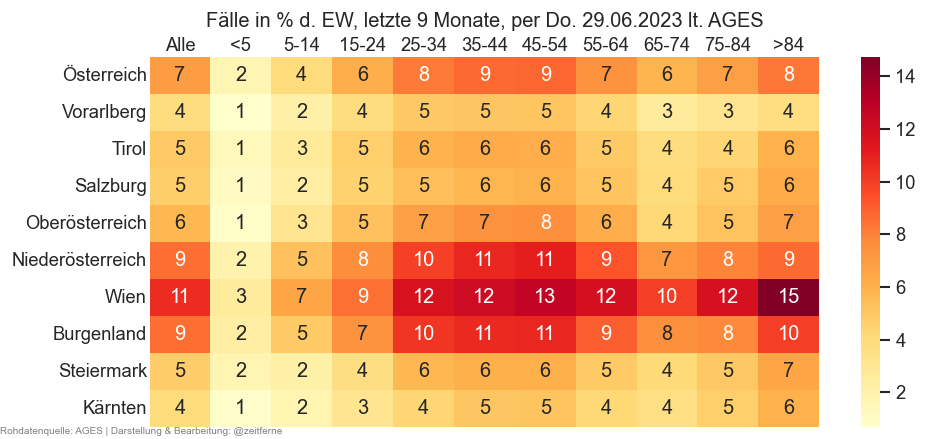
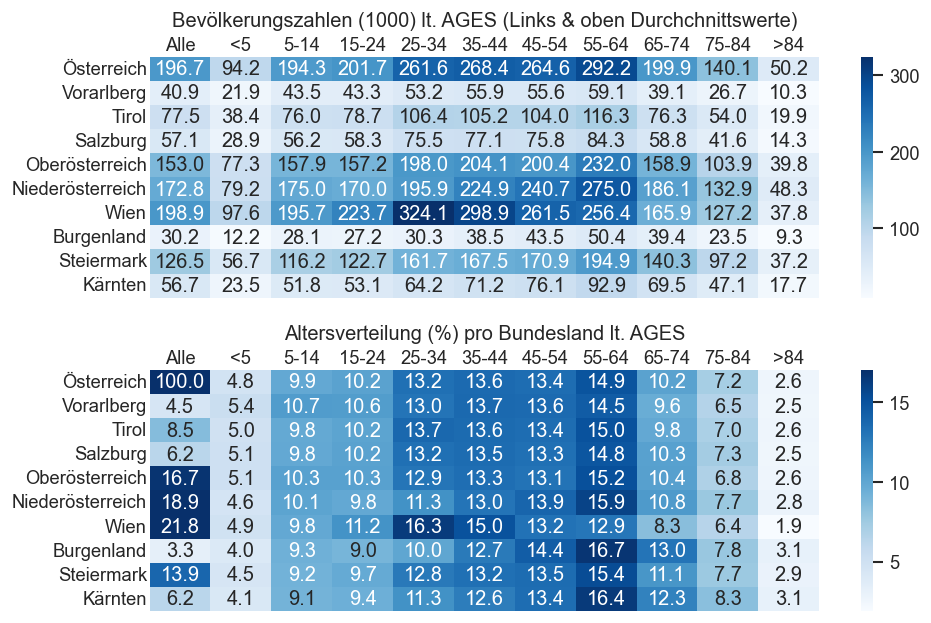
Altersgruppen, für die auf den letzen oder vorletzen Tag verdächtig wenig Fälle gebucht wurden¶
def print_sus_agd(agd_sums=agd_sums):
agd_sums = agd_sums.copy()
with cov.calc_shifted(agd_sums, "Gruppe", 7):
agd_sums["AnzahlFaelle7Tage"] = agd_sums["AnzahlFaelle"].rolling(7).sum()
display(agd_sums[agd_sums["Datum"] >= agd_sums["Datum"].iloc[-1] - timedelta(1)].query(
"inz_dg7 <= 0.3 and AnzahlFaelle7Tage >= 5 * 7 or AnzahlFaelle == 0 and AnzahlFaelle7Tage >= 3 * 7 and inz_dg7 < 1"
).set_index(["Datum", "Bundesland", "Altersgruppe"])[["AnzahlFaelle", "inz_dg7", "AnzahlFaelle7Tage", "AnzEinwohner"]].sort_values(by="AnzahlFaelle7Tage", ascending=False))
print_sus_agd()
| AnzahlFaelle | inz_dg7 | AnzahlFaelle7Tage | AnzEinwohner | |||
|---|---|---|---|---|---|---|
| Datum | Bundesland | Altersgruppe | ||||
| 2023-06-28 | Wien | 55-64 | 3.0 | 0.1429 | 60.0 | 256339.4548 |
| Österreich | 65-74 | 6.0 | 0.2500 | 56.0 | 934279.1315 | |
| 2023-06-29 | Österreich | 65-74 | 2.0 | 0.1667 | 46.0 | 934340.4356 |
| 2023-06-28 | Burgenland | Alle | 0.0 | 0.0000 | 24.0 | 302342.7260 |
if DISPLAY_SHORTRANGE_DIAGS:
selbl = 'Österreich'
ag_q = f"Altersgruppe != 'Alle' and Bundesland == '{selbl}'"
fig, axs = cov.plt_mdiff(
agd_sums.query(ag_q),
agd_sums_old.query(ag_q),
"Altersgruppe",
sharey=False,
rwidth=1,
ndays=DETAIL_SMALL_NDAYS, vcol="AnzahlFaelle", name="Fälle", color=(0.4,)*3)
fig.suptitle(selbl + ": COVID-Fälle" + AGES_STAMP)
if DISPLAY_SHORTRANGE_DIAGS:
selag = '>84'
ag_q = f"Altersgruppe == '{selag}'"
fig, axs = cov.plt_mdiff(
agd_sums.query(ag_q),
agd_sums_old.query(ag_q),
"Bundesland",
sharey=False,
rwidth=1,
ndays=10*7, vcol="AnzahlFaelle", name="Fälle", color=(0.4,)*3)
fig.autofmt_xdate()
fig.suptitle("Altersgruppe " + selag + ": COVID-Fälle" + AGES_STAMP, y=0.95)
#for ax in axs.flat:
#ax.set_ylim(bottom=ax.get_ylim()[1] * 0.025)
#cov.set_logscale(ax)
Verteilung der Infektionen auf die Bundesländer¶
if False:
cov=reload(cov)
selbl = "Oberösterreich"
bez2 = bez[np.isfinite(bez["GKZ"])].query(f"Bundesland == '{selbl}'").copy()
bez2 = bez2.sort_values(by="GKZ", key=lambda v: v.map(geo_order_to_index), kind="stable")
with plt.rc_context(
{"axes.prop_cycle": cycler(color=sns.color_palette("tab20" if bez2["GKZ"].nunique() > 10 else "tab10", n_colors=20))}):
cov.plt_cat_dists(
data_cat=bez2,
data_agg=fs.query(f"Bundesland == '{selbl}'"), catcol="Bezirk", bundesland=selbl,
stamp=AGES_STAMP,
datefrom=pd.to_datetime(date(2021, 9, 1)),
shortrange=60)
if False:
cov=reload(cov)
cov.plt_cat_dists(
data_cat=fs.query("Bundesland != 'Österreich'"), data_agg=fs_at, catcol="Bundesland", bundesland="Österreich",
stamp=AGES_STAMP)
Verteilung der Infektionen auf die Altersgruppen¶
def plt_ag_sep(uselog=False, rmlast=True, agd_sums=agd_sums, fromdate=omicronbegdate, ndays=DETAIL_NDAYS):
data = agd_sums[agd_sums["Datum"] != agd_sums["Datum"].iloc[-1]] if rmlast else agd_sums
per_bl = agd_sums["Altersgruppe"].nunique() < 2
fig, axs = plt_per_cat_inz(
data.query("Altersgruppe !='Alle'"),
", " + data.iloc[0]["Altersgruppe" if per_bl else "Bundesland"] +
", je " + ("Bundesland" if per_bl else "Altersgruppe")
+ (" nach Meldedatum" if rmlast is None else "") + AGES_STAMP,
"Bundesland" if per_bl else "Altersgruppe",
fromdate=fromdate,
ndays=ndays)
trans = matplotlib.transforms.blended_transform_factory(
fig.transFigure, fig.dpi_scale_trans)
if rmlast is not None:
fig.text(
0.5, 0.0,
"* bis Labordatum " + agd_sums["Datum"].iloc[-2].strftime("%a %x")
+ ", d.h. neuester Tag wegen Meldeverzug weggelassen; Zahlen in Klammer: Änderung ggü. Vortag/Vorwoche"
if rmlast else "* ACTHUNG: V.a. letzer Tag mit fehlenden Nachmeldungen",
va="bottom",
ha="center",
fontsize="x-small",
in_layout=False,
transform=trans)
if uselog:
for ax in axs.flat:
cov.set_logscale(ax)
ax.set_ylim(bottom=50)
ax.yaxis.set_major_locator(matplotlib.ticker.LogLocator(base=10, subs=[0.3, 1]))
if DISPLAY_SHORTRANGE_DIAGS:
plt_ag_sep(uselog=False, rmlast=False, agd_sums=agd_sums.query("Bundesland == 'Österreich'"))
#plt_ag_sep(uselog=False, rmlast=False, agd_sums=agd_sums.query("Bundesland == 'Österreich'"))
#plt_ag_sep(uselog=True, rmlast=False, agd_sums=agd_sums.query("Bundesland == 'Wien'"))
#plt_ag_sep(uselog=True, rmlast=False, agd_sums=agd_sums.query("Bundesland == 'Oberösterreich'"))
plt_ag_sep(uselog=False, rmlast=None, agd_sums=agd1m_sums.query("Bundesland == 'Österreich'"))
def plt_ag_sep_and_print():
df = agd_sums.query("Altersgruppe == '5-14'")
print("#COVID19at-Fälle pro Woche pro 100.000 Einwohnern in der Altersgruppe 5-14 in Österreich, nach Labordatum" + AGES_STAMP + ":\n")
df = df.query("Bundesland == 'Österreich'")
for i in range(4):
record = df.iloc[-7*i - 1]
print("‒", record["Datum"].strftime("%d.%m:"), format(record["inz"], ".0f") + ",", pctc(record["inz_g7"], emoji=True),
"in 7 Tagen" if i == 0 else "")
plt_ag_sep_and_print()
#COVID19at-Fälle pro Woche pro 100.000 Einwohnern in der Altersgruppe 5-14 in Österreich, nach Labordatum (AGES Fr. 30.06.23): ‒ 29.06: 1, ‒47% ⏬ in 7 Tagen ‒ 22.06: 2, ‒15% ↘ ‒ 15.06: 2, +33% ↗ ‒ 08.06: 2, ‒44% ⏬
if DISPLAY_SHORTRANGE_DIAGS:
plt_ag_sep(agd_sums=agd1m_sums.query("Altersgruppe == '5-14'"), uselog=False, rmlast=None)
# "agU25_inz_g7",
# "ag25to54_inz_g7",
# "ag55_inz_g7"
def agg_casedata(data, lblkey, lblval, extragrp=None):
res = data.groupby(["Datum"] + (extragrp or [])).agg({
"AnzahlFaelle": "sum",
"AnzahlFaelle7Tage": "sum",
"AnzEinwohner": "sum",
"AnzEinwohnerFixed": "sum",
"AnzahlTot": "sum"})
res["inz"] = res["AnzahlFaelle7Tage"] / res["AnzEinwohner"] * 100_000
res[lblkey] = lblval
return res.set_index(lblkey, append=True)
def draw_ag_grps(selbl="Österreich", ax=None, ndays=MIDRANGE_NDAYS):
data = agd_sums.query(f"Bundesland == '{selbl}'").copy()
data = data[data["Datum"] >= data["Datum"].iloc[-1] - timedelta(ndays)]
ag5 = data.query("Altersgruppe == '<5'").set_index(["Datum", "Altersgruppe"])
ag85 = agg_casedata(data.query("AgeFrom >= 84"), "Altersgruppe", "85+")
ag65 = agg_casedata(data.query("AgeFrom >= 64"), "Altersgruppe", "65+")
ag14 = agg_casedata(data.query("Altersgruppe == '5-14'"), "Altersgruppe", "5-14")
agmid = agg_casedata(data.query("AgeFrom >= 25 and AgeFrom < 64"), "Altersgruppe", "25-64")
agother = agg_casedata(data.query("Altersgruppe == '15-24'"), "Altersgruppe", "15-24")
hasfig = ax is None
if hasfig:
#display(ag65)
fig, ax = plt.subplots()
cov.set_logscale(ax)
pdata = pd.concat([ag14, agother, agmid, ag65]).reset_index()
sns.lineplot(
pdata, hue="Altersgruppe", y="inz", x="Datum",
palette="tab10",
lw=2,
err_style=None,
ax=ax)
extrapal = [sns.color_palette("Paired")[0], sns.color_palette("Paired")[9]]
sns.lineplot(
pd.concat([ag5, ag85]), hue="Altersgruppe", y="inz", x="Datum",
palette=extrapal,
err_style=None,
lw=0.9,
ax=ax)
ax.legend(ncol=2)
cov.labelend2(
ax,
pd.concat([pdata, ag5.reset_index(), ag85.reset_index()]).reset_index(drop=True),
"inz",
cats="Altersgruppe",
shorten=lambda a: a.split("-")[0].rstrip("+").replace("<5", "0"),
colorize=sns.color_palette(n_colors=pdata["Altersgruppe"].nunique()) + extrapal,
fontsize="small")
ax.set_xlim(left=data.iloc[0]["Datum"], right=data["Datum"].iloc[-1] + timedelta(7))
if hasfig:
fig.suptitle(f"{selbl}: Inzidenzen je Altersgruppe nach Labordatum ‒ Logarithmische Skala" + AGES_STAMP,
y=0.93)
ax.figure.autofmt_xdate()
ax.set_ylabel("Erkannte Fälle/100.000 EW");
cov.set_date_opts(ax)
ax.figure.autofmt_xdate()
else:
ax.set_title(selbl, y=0.95)
ax.set_ylabel("Fälle/100.000");
#ax.set_yscale("log")
#ax.set_ylim(bottom=0)
#ax.yaxis.set_major_locator(matplotlib.ticker.LogLocator(base=10, subs=[0.15, 0.2, 0.3, 0.4, 0.5, 0.6, 0.7, 0.85, 1]))
#ax.yaxis.set_major_formatter(matplotlib.ticker.ScalarFormatter())
#fs_at.iloc[fs_at["ag55_inz"].argmax()]
draw_ag_grps(ndays=2000)
ax = plt.gca()
ax.set_ylim(bottom=max(1, ax.get_ylim()[0]))
#cov.set_date_opts(plt.gca(), week_always=True)
def draw_ag_grps_all():
fig, axs = plt.subplots(nrows=5, ncols=2, figsize=(10, 10), sharex=True, sharey=True)
for bl, ax in zip(fs["Bundesland"].unique(), axs.flat):
draw_ag_grps(bl, ax, ndays=SHORTRANGE_NDAYS)
if ax is axs.flat[0]:
fig.legend(ncol=6, frameon=False, loc="upper center", bbox_to_anchor=(0.5, 0.94))
ax.get_legend().remove()
if ax in axs[-1]:
cov.set_date_opts(ax)
if False and ax is axs.flat[-1]:
ax.set_ylim(bottom=20, top=1000)
if ax is axs.flat[-1]:
cov.set_logscale(ax, reduced=True)
#ax.set_xlim(left=fs["Datum"].iloc[-1] - timedelta(SHORTRANGE_NDAYS), right=fs["Datum"].iloc[-1] + timedelta(5))
fig.suptitle("Österreich: COVID-19-Fälle je Bundesland & Altersgruppe, logarithmisch" + AGES_STAMP, y=0.97)
fig.subplots_adjust(wspace=0.01)
fig.autofmt_xdate()
draw_ag_grps_all()
...\AppData\Local\hatch\env\virtual\covidat\MDfikVs6\notebooks\Lib\site-packages\pandas\core\arraylike.py:396: RuntimeWarning: divide by zero encountered in log10 result = getattr(ufunc, method)(*inputs, **kwargs) ...\AppData\Local\hatch\env\virtual\covidat\MDfikVs6\notebooks\Lib\site-packages\pandas\core\arraylike.py:396: RuntimeWarning: divide by zero encountered in log10 result = getattr(ufunc, method)(*inputs, **kwargs) ...\AppData\Local\hatch\env\virtual\covidat\MDfikVs6\notebooks\Lib\site-packages\pandas\core\arraylike.py:396: RuntimeWarning: divide by zero encountered in log10 result = getattr(ufunc, method)(*inputs, **kwargs) ...\AppData\Local\hatch\env\virtual\covidat\MDfikVs6\notebooks\Lib\site-packages\pandas\core\arraylike.py:396: RuntimeWarning: divide by zero encountered in log10 result = getattr(ufunc, method)(*inputs, **kwargs) ...\AppData\Local\hatch\env\virtual\covidat\MDfikVs6\notebooks\Lib\site-packages\pandas\core\arraylike.py:396: RuntimeWarning: divide by zero encountered in log10 result = getattr(ufunc, method)(*inputs, **kwargs) ...\AppData\Local\hatch\env\virtual\covidat\MDfikVs6\notebooks\Lib\site-packages\pandas\core\arraylike.py:396: RuntimeWarning: divide by zero encountered in log10 result = getattr(ufunc, method)(*inputs, **kwargs) ...\AppData\Local\hatch\env\virtual\covidat\MDfikVs6\notebooks\Lib\site-packages\pandas\core\arraylike.py:396: RuntimeWarning: divide by zero encountered in log10 result = getattr(ufunc, method)(*inputs, **kwargs) ...\AppData\Local\hatch\env\virtual\covidat\MDfikVs6\notebooks\Lib\site-packages\pandas\core\arraylike.py:396: RuntimeWarning: divide by zero encountered in log10 result = getattr(ufunc, method)(*inputs, **kwargs) ...\AppData\Local\hatch\env\virtual\covidat\MDfikVs6\notebooks\Lib\site-packages\pandas\core\arraylike.py:396: RuntimeWarning: divide by zero encountered in log10 result = getattr(ufunc, method)(*inputs, **kwargs) ...\AppData\Local\hatch\env\virtual\covidat\MDfikVs6\notebooks\Lib\site-packages\pandas\core\arraylike.py:396: RuntimeWarning: divide by zero encountered in log10 result = getattr(ufunc, method)(*inputs, **kwargs) ...\AppData\Local\hatch\env\virtual\covidat\MDfikVs6\notebooks\Lib\site-packages\pandas\core\arraylike.py:396: RuntimeWarning: divide by zero encountered in log10 result = getattr(ufunc, method)(*inputs, **kwargs) ...\AppData\Local\hatch\env\virtual\covidat\MDfikVs6\notebooks\Lib\site-packages\pandas\core\arraylike.py:396: RuntimeWarning: divide by zero encountered in log10 result = getattr(ufunc, method)(*inputs, **kwargs) ...\AppData\Local\hatch\env\virtual\covidat\MDfikVs6\notebooks\Lib\site-packages\pandas\core\arraylike.py:396: RuntimeWarning: divide by zero encountered in log10 result = getattr(ufunc, method)(*inputs, **kwargs) ...\AppData\Local\hatch\env\virtual\covidat\MDfikVs6\notebooks\Lib\site-packages\pandas\core\arraylike.py:396: RuntimeWarning: divide by zero encountered in log10 result = getattr(ufunc, method)(*inputs, **kwargs) ...\AppData\Local\hatch\env\virtual\covidat\MDfikVs6\notebooks\Lib\site-packages\pandas\core\arraylike.py:396: RuntimeWarning: divide by zero encountered in log10 result = getattr(ufunc, method)(*inputs, **kwargs) ...\AppData\Local\hatch\env\virtual\covidat\MDfikVs6\notebooks\Lib\site-packages\pandas\core\arraylike.py:396: RuntimeWarning: divide by zero encountered in log10 result = getattr(ufunc, method)(*inputs, **kwargs)
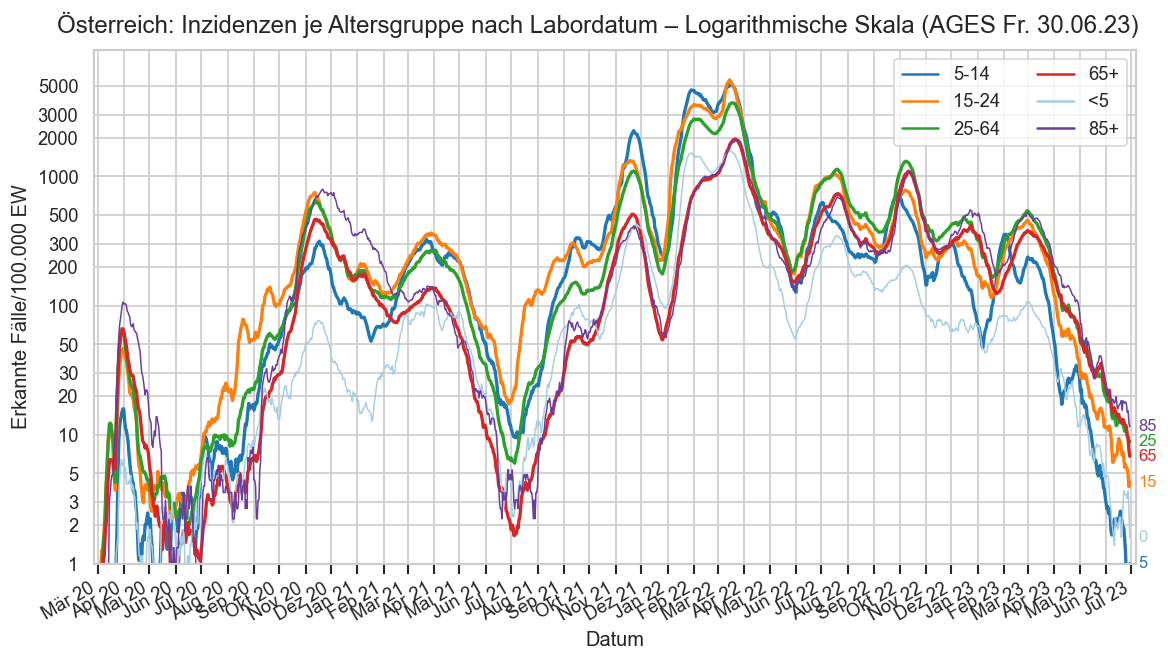
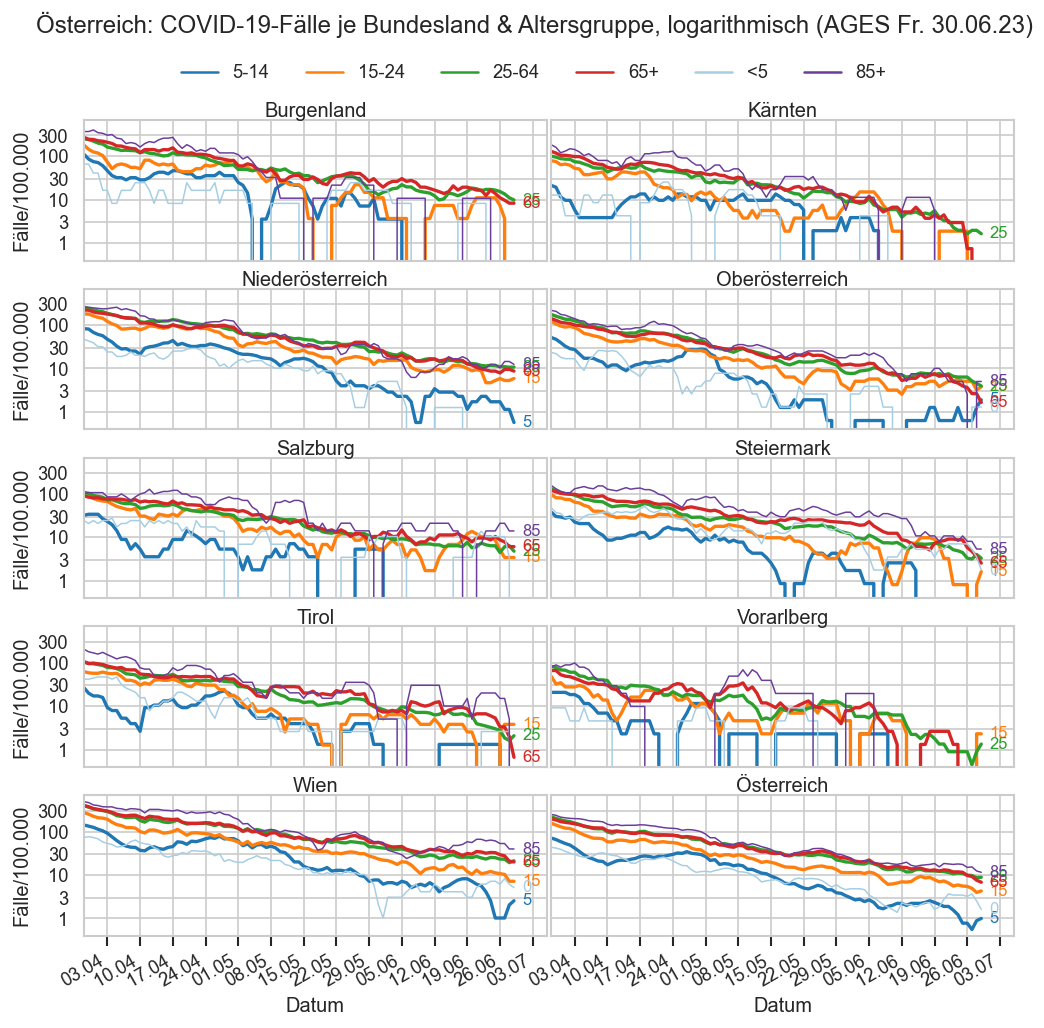
selbl = "Österreich"
data = fs.query(f"Bundesland == '{selbl}' and Datum >= '2020-01-01'")
ax = data.plot(
x="Datum", y=["inz"],
label=["Inzidenz gesamt"],
#marker="."
)
agd_sums.query(f"Altersgruppe == '5-14' and Bundesland == '{selbl}'").plot(
x="Datum", y="inz", label="Inzidenz 5-14", ax=ax)
#ax.plot(agd_sums.query("Bundesland == 'Österreich'"))
ax.set_title(f"{selbl}: Inzidenzen je Altersgruppe nach Labordatum ‒ Logarithmische Skala" + AGES_STAMP)
cov.set_date_opts(ax, data["Datum"], showyear=True)
ax.set_xlim(right=fs["Datum"].iloc[-1] + timedelta(7))
#ax.set_yscale("log")
cov.set_logscale(ax)
ax.set_ylim(bottom=1)
#ax.set_ylim(bottom=0)
#ax.yaxis.set_major_locator(matplotlib.ticker.LogLocator(base=10, subs=[0.15, 0.2, 0.3, 0.4, 0.5, 0.6, 0.7, 0.85, 1]))
#ax.yaxis.set_major_formatter(matplotlib.ticker.ScalarFormatter())
ax.figure.autofmt_xdate()
ax.set_ylabel("Erkannte Fälle/100.000 EW");
#fs_at.iloc[fs_at["ag55_inz"].argmax()]
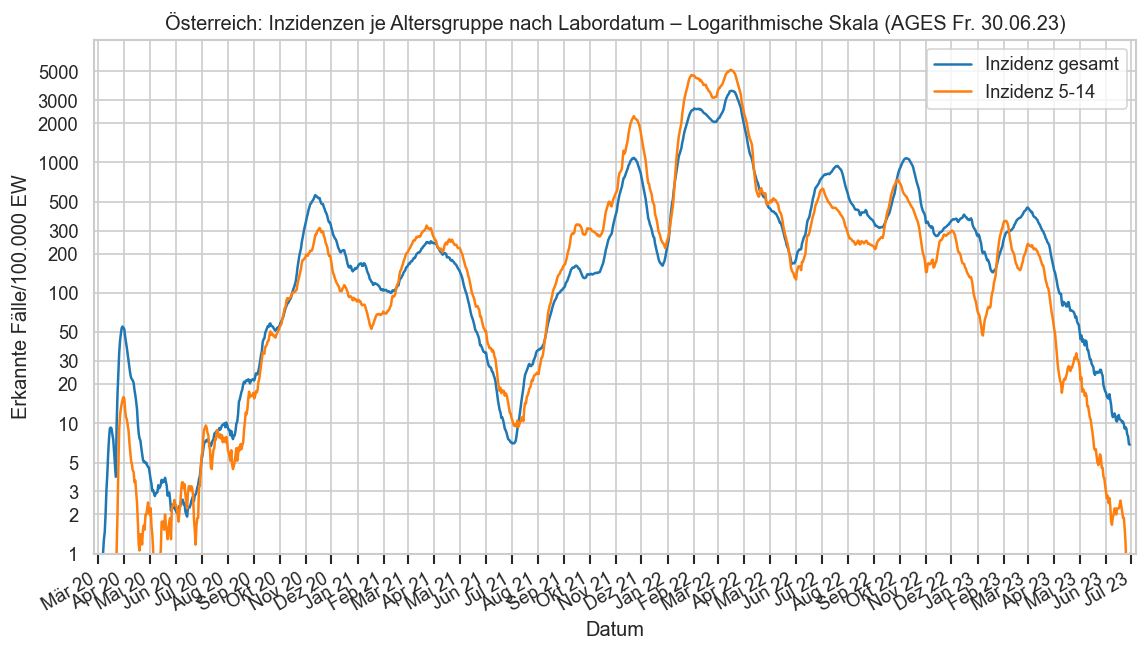
def plt_agd_front_1(tdata, ax, cl, visx=False, annot=(), sfactor=40, vcol="inz", annot_args=None, plt_args=None):
if annot is True:
annot = ('',)
elif not annot:
annot = ()
nags = tdata["Altersgruppe"].nunique()
#with plt.style.context("dark_background"):
#fig.set_facecolor((0.9, 0.9, 0.9))
#ax.set_facecolor('None')
#fig.set_textcolor("white")
#if monotonic:
coords = (tdata["Altersgruppe"], tdata[vcol])
if visx:
coords = coords[::-1]
lines = ax.plot(
*coords,
label=tdata.iloc[0]["Datum"].strftime("%d.%m.%y" if 'year' in annot else "%a %d. %B"),
zorder=2,
color=cl, **(plt_args or {}))
if annot:
def fdate(dt):
return dt.strftime("%d.%m.%y" if 'year' in annot else "%d.%m")
for left in (True, False):
idx = 0 if left else -1
ax.annotate(
("<" if 'last' in annot else "") +
fdate(tdata.iloc[0]["Datum"]) +
(">" if 'first' in annot else ""),
(coords[0].iloc[idx], coords[1].iloc[idx]),
xytext=(-5 if left else 5, 0)[::-1 if visx else 1], textcoords='offset points',
rotation=45 if visx else None,
color=cl,
ha='right' if left else 'left',
va='top' if left and visx else 'bottom' if visx else 'baseline',
**(annot_args or {}))
points = None
if sfactor:
points = ax.scatter(*coords, color=cl, marker="o",
s=matplotlib.colors.Normalize(vmin=10_000)(tdata["AnzEinwohner"]) * sfactor,
zorder=2,
**(plt_args or {}))
return lines, points
def plt_agd_front(
bldata, diffs=[0], vcol="inz", ttl="", ax=None, annot=True, legend=True, sfactor=40, plt_args=None,
mark_last=False):
bldata = bldata.query("Altersgruppe != 'Alle'").sort_values(by="Datum", kind="stable")
nags = bldata["Altersgruppe"].nunique()
#with plt.style.context("dark_background"):
#fig.set_facecolor((0.9, 0.9, 0.9))
#ax.set_facecolor('None')
#fig.set_textcolor("white")
long = len(diffs) > 10
seldata = []
needyear = max(diffs) - min(diffs) >= 365
def fdate(dt):
return dt.strftime("%d.%m.%y" if needyear else "%d.%m")
if long:
breaks = np.linspace(0, len(diffs) - 1, 5).astype(int)
cm = sns.color_palette("plasma", as_cmap=True)
monotonic = vcol == "AnzahlFaelleSumProEW"
fig = None
if ax is None:
fig = plt.Figure()#dpi=400 if long and monotonic else None
ax = fig.subplots()
#if monotonic:
vmax = max(diffs) + (max(diffs) - min(diffs)) * 0.1 if not long else max(diffs)
cnorm = matplotlib.colors.Normalize(vmin=min(diffs), vmax=vmax)
visx = monotonic
for i, diff in zip(range(len(diffs)), diffs[::-1]):
tdata = bldata.iloc[-nags * (diff + 1): -nags * diff if diff != 0 else None]
cl = cm(cnorm(diff))
if i > 0 and monotonic:
pdiff = diffs[-i]
#assert pdiff > diff, f"{pdiff} > {diff}"
for p in range(pdiff - 1, diff - 1, -1):
#print(pdiff, diff, p)
ptdata = bldata.iloc[-nags * (p + 1): -nags * p if p != 0 else None]
#print("ptdata", ptdata["Datum"].unique())
ptdata1 = bldata.iloc[-nags * (p + 2): -nags * (p + 1) if p + 1 != 0 else None]
#assert ptdata.shape == ptdata1.shape, f"{ptdata.shape:=} {ptdata1.shape:=}"
#print("pdata1", ptdata1["Datum"].unique())
#print(f"{ptdata[vcol].shape=} {ptdata1[vcol].shape=}")
ax.fill_betweenx(
ptdata["Altersgruppe"].to_numpy(),
ptdata1[vcol].to_numpy(),
ptdata[vcol].to_numpy(),
color=cm(cnorm(p)), #alpha=0.3,
lw=0.3,
#lw=0,
alpha=0.3
)
seldata.append(tdata)
coords = (tdata["Altersgruppe"], tdata[vcol])
doannot = annot and (not long or i in breaks) and len(diffs) > 1
if doannot and not monotonic:
if i == 0:
doannot = ('first',)
elif i + 1 == len(diffs):
doannot = ('last',)
plt_args0 = plt_args
if i + 1 == len(diffs) and mark_last:
plt_args0 = plt_args.copy() if plt_args else {}
plt_args0["lw"] = 3
plt_agd_front_1(tdata, ax, cl=cl, visx=visx,
annot=doannot,
sfactor=sfactor if not long else None,
vcol=vcol,
plt_args=plt_args0)
vaxis = ax.xaxis if visx else ax.yaxis
caxis = ax.yaxis if visx else ax.xaxis
caxis.set_label_text("Altersgruppe")
vaxis.set_label_text({"inz": "7-Tage-Inzidenz / 100.000 EW",
"AnzahlFaelleSumProEW": "Kumulative Inzidenz in Prozent der Bevölkerung"}[vcol])
if long and False:
(ax.set_ylim if visx else ax.set_xlim)(0, nags - 1)
#cov.set_logscale(ax)
if vcol == "inz":
(ax.set_xscale if visx else ax.set_yscale)("log", base=2)
vaxis.set_major_locator(matplotlib.ticker.LogLocator(base=10, subs=[0.2, 0.3, 0.5, 1]))
fmt = matplotlib.ticker.ScalarFormatter(useOffset=False)
fmt.set_scientific(False)
vaxis.set_major_formatter(fmt)
elif vcol == "AnzahlFaelleSumProEW":
vaxis.set_major_formatter(matplotlib.ticker.PercentFormatter(xmax=1))
(ax.set_xlim if visx else ax.set_ylim)(max(vaxis.get_data_interval()[0], 0))
if legend:
if not long:
ax.legend()
sname = {"inz": "Inzidenz (logarithmisch)", "AnzahlFaelleSumProEW": "Kumulative Inzidenz"}[vcol]
todate = fdate(bldata.iloc[-min(diffs) * nags - 1]["Datum"])
fromdate = fdate(bldata.iloc[-max(diffs) * nags - 1]["Datum"])
tostr = f" ‒ {todate}" if len(diffs) > 1 else ""
(fig.suptitle if fig else ax.set_title)(
bldata.iloc[0]["Bundesland"] + f": {sname} je Altersgruppe {fromdate}{tostr}{ttl}{AGES_STAMP}")
return fig, ax
cov = reload(cov)
data = agd_sums[agd_sums["Bundesland"] == "Österreich"]
if True:
fig, ax = plt_agd_front(
agd_sums[agd_sums["Bundesland"] == "Österreich"], np.arange(0, 7 * 9, 7), mark_last=True)
#plt_agd_front(
# agd1m_sums[agd1m_sums["Bundesland"] == "Österreich"], np.arange(0, 7 * 4, 7), ttl=" nach Meldedatum",
# plt_args=dict(ls="--", zorder=1, alpha=0.5), legend=False, annot=False, sfactor=0, ax=ax)
fig.legend(ncol=5, frameon=False, loc="upper center", bbox_to_anchor=(0.5, 0.96))
ax.get_legend().remove()
display(fig)
if False:
#raise
#n = 63
n = 0
for i in range(n + 1):
fig, ax = plt_agd_front(data, [n - i])
ax.set_ylim(bottom=100, top=2000)
ax.get_legend().remove()
fig.savefig(f"wave/{i:03d}.png")
#display(plt_agd_front(agd_sums[agd_sums["Bundesland"] == "Österreich"], np.arange(0, 7 * 6, 7), "AnzahlFaelleSumProEW")[0])
#plt_agd_front(agd_sums[agd_sums["Bundesland"] == "Österreich"], np.arange(0, 280, 7 * 4))
#plt_agd_front(agd_sums[agd_sums["Bundesland"] == "Österreich"], np.arange(0, 325, 7))
fig, ax = plt_agd_front(agd_sums[agd_sums["Bundesland"] == "Österreich"], np.arange(0, (agd_sums["Datum"].iloc[-1] - pd.to_datetime("2021-09-01")).days + 1, 7), "AnzahlFaelleSumProEW")
ax.set_xlim(left=0)
display(fig)
#ax.get_legend().remove()
if True:
fig, axs = plt.subplots(ncols=2, nrows=5, figsize=(10, 10), sharex=True, sharey=True)
fig.suptitle("7-Tage-Inzidenzen (logarithmisch) je Altersgruppe und Bundesland" + AGES_STAMP, y=0.94)
fig.subplots_adjust(wspace=0.1, hspace=0.2)
for bl, ax in zip(agd_sums["Bundesland"].unique(), axs.flat):
ax.set_title(bl, y=0.97)
agdata_bl = agd_sums[agd_sums["Bundesland"] == bl].query("Altersgruppe != 'Alle'")
bldata = fs[fs["Bundesland"] == bl]
deltapeakrange = bldata.query("Datum > '2021-10-01' and Datum < '2022-01-01'")
deltapeakdate = deltapeakrange.iloc[deltapeakrange["inz"].argmax()]["Datum"]
peakrange = bldata.query("Datum > '2022-01-01' and Datum < '2022-03-04'")
peakdate = peakrange.iloc[peakrange["inz"].argmax()]["Datum"]
postpeakrange = peakrange[peakrange["Datum"] > peakdate]
midpeakmindate = postpeakrange.iloc[postpeakrange["inz"].argmin()]["Datum"]
peak2range = bldata[bldata["Datum"] > midpeakmindate]
peak2date = peak2range.iloc[peak2range["inz"].argmax()]["Datum"]
ba5range = bldata.query("Datum > '2022-06-01' and Datum < '2022-09-01'")
ba5peakpeakdate = ba5range.iloc[ba5range["inz"].argmax()]["Datum"]
#print(bl, peakdate, midpeakmindate)
#display([0] + list((bldata["Datum"].iloc[-1] - pd.to_datetime(dt)).days for dt in ("2022-02-27", "2022-02-01")))
lines = []
dts = (deltapeakdate, peakdate, peak2date, ba5peakpeakdate, agdata_bl.iloc[-1]["Datum"])
cls = sns.color_palette(n_colors=len(dts) - 1) + ["k"]
for cl, dt in zip(cls, dts):
lines.append(plt_agd_front_1(
agdata_bl[agdata_bl["Datum"] == dt],
ax=ax, annot=dt is not dts[-1],
sfactor=20, cl=cl, annot_args=dict(fontsize="x-small"))[0][0])
lines[-1].set_linestyle("--")
if ax is axs.flat[0]:
fig.legend(lines, ["Delta-Peak", "BA.1-Peak", "BA.2-Peak", "BA.5-Sommer-Peak", agdata_bl["Datum"].iloc[-1].strftime("%a %x")],
frameon=False, loc="upper center", bbox_to_anchor=(0.5, 0.93), ncol=len(dts))
cov.set_logscale(ax)
if ax not in axs[-1]:
#ax.xaxis.set_major_formatter(matplotlib.ticker.NullFormatter())
ax.set_xlabel(None)
if ax in axs.T[0]:
ax.set_ylabel("7-T-Inzidenz")
else:
ax.set_ylabel(None)
ax.set_ylim(bottom=150)
fig.autofmt_xdate()
nweeks = 4
begdate = agd_sums["Datum"].iloc[-1] - timedelta(7 * (nweeks - 1))
if DISPLAY_SHORTRANGE_DIAGS:
fig, axs = plt.subplots(ncols=2, nrows=5, figsize=(10, 10), sharex=True, sharey=True)
fig.suptitle("7-Tage-Inzidenzen (logarithmisch) je Altersgruppe und Bundesland" + AGES_STAMP, y=0.94)
fig.subplots_adjust(wspace=0.1, hspace=0.2)
ymin = agd_sums[agd_sums["Datum"] >= begdate]["inz"].quantile(0.03) * 0.9
for bl, ax in zip(agd_sums["Bundesland"].unique(), axs.flat):
ax.set_title(bl, y=0.97)
agdata_bl = agd_sums[agd_sums["Bundesland"] == bl].query("Altersgruppe != 'Alle'")
plt_agd_front(agdata_bl, np.arange(0, 7 * nweeks, 7), ax=ax, legend=False, annot=False, mark_last=True)
if ax is axs.flat[0]:
fig.legend(frameon=False, loc="upper center", bbox_to_anchor=(0.5, 0.93), ncol=4)
if ax is axs.flat[-1]:
cov.set_logscale(ax)
ax.set_ylim(bottom=ymin)
if ax not in axs[-1]:
#ax.xaxis.set_major_formatter(matplotlib.ticker.NullFormatter())
ax.set_xlabel(None)
if ax in axs.T[0]:
ax.set_ylabel("7-T-Inzidenz")
else:
ax.set_ylabel(None)
fig.autofmt_xdate()
print(f"#COVID19at 7-Tage-Inzidenzen je Altersgruppe & Bundesland wöchentlich seit {begdate.strftime('%a %x')}")
aglast = cov.filterlatest(agd_sums).query("Bundesland == 'Österreich'")
agmax = aglast.iloc[aglast["inz"].argmax()]
print(f"Höchste gesamt-österreichische Inzidenz in einer Altersgruppe hat derzeit {agmax['Altersgruppe']}",
f"({agmax['inz']:.0f}, {agmax['inz_g7'] * 100 - 100:+.3n}% in 7 Tagen)")
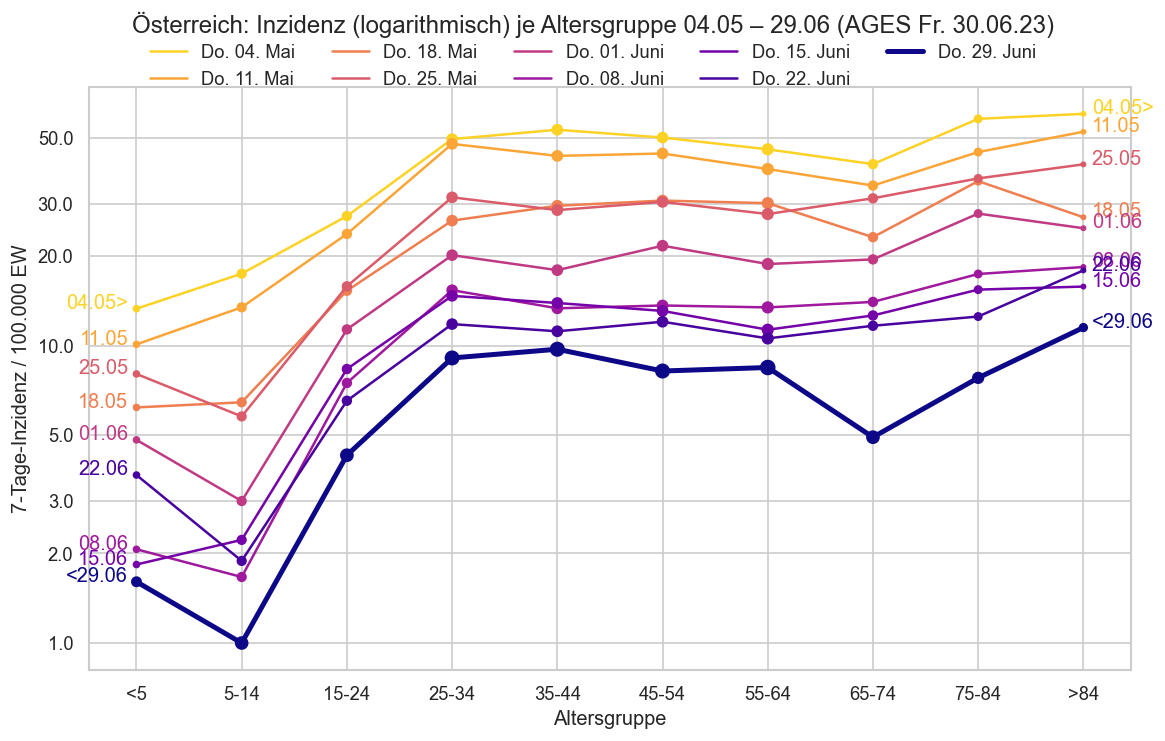
...\AppData\Local\hatch\env\virtual\covidat\MDfikVs6\notebooks\Lib\site-packages\matplotlib\collections.py:963: RuntimeWarning: invalid value encountered in sqrt scale = np.sqrt(self._sizes) * dpi / 72.0 * self._factor
#COVID19at 7-Tage-Inzidenzen je Altersgruppe & Bundesland wöchentlich seit Do. 08.06.2023 Höchste gesamt-österreichische Inzidenz in einer Altersgruppe hat derzeit >84 (12, -35,8% in 7 Tagen)
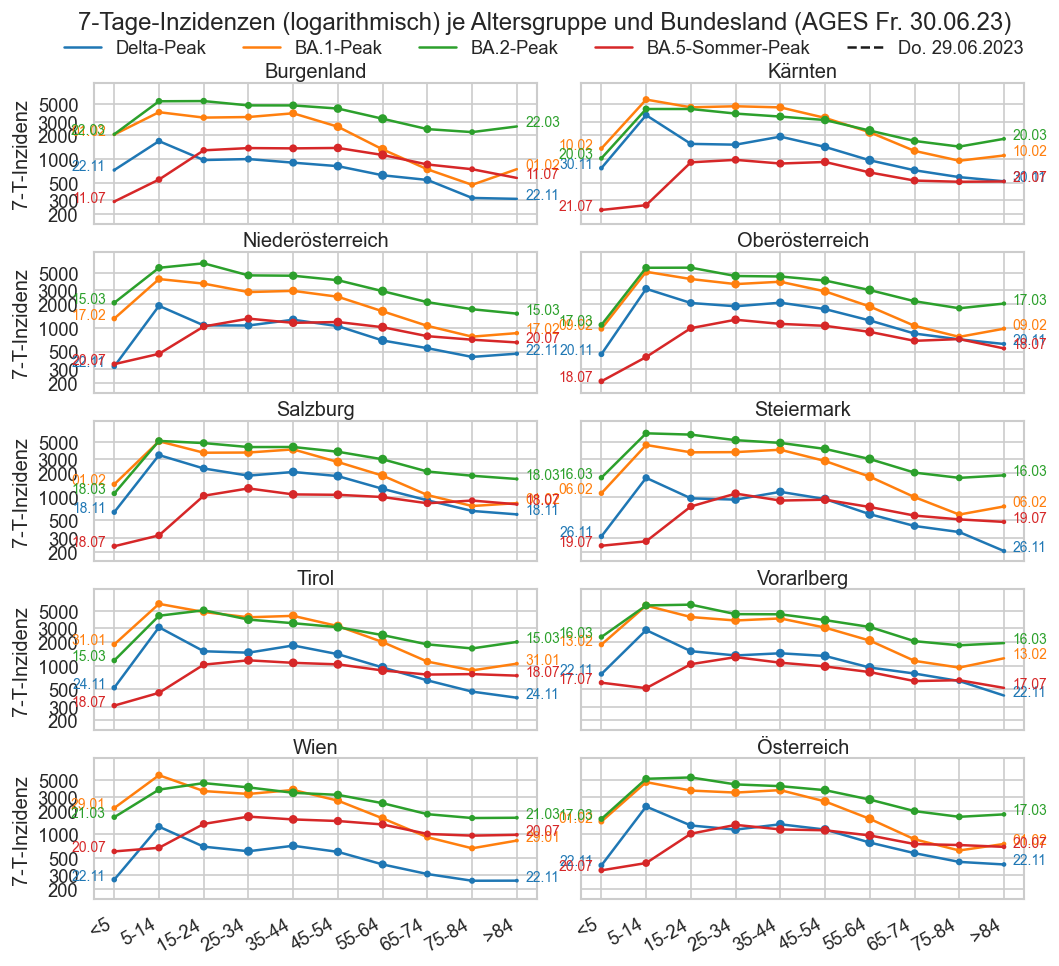
fig, ax = plt.subplots()
fig.suptitle("7-Tage-Inzidenz (logarithmisch) je Altersgruppe und Bundesland" + AGES_STAMP, y=1)
agd_latest = cov.filterlatest(agd_sums).query("Altersgruppe != 'Alle'")
agdata_nat = agd_latest.query("Bundesland != 'Österreich'")
ymin = min(agd_latest["inz"].quantile(0.03) * 0.9, agd_latest["inz"].min())
sznorm = matplotlib.colors.Normalize(
vmin=agdata_nat["AnzEinwohner"].quantile(0.05),
vmax=agdata_nat["AnzEinwohner"].quantile(0.95),
clip=True)
for i, bl in enumerate(agd_sums["Bundesland"].unique()):
cl = f"C{i}"
agdata_bl = agd_latest[agd_latest["Bundesland"] == bl]
coords = (agdata_bl["Altersgruppe"], agdata_bl["inz"])
ax.plot(*coords, label=bl)
ax.annotate(cov.SHORTNAME_BY_BUNDESLAND[bl],
(coords[0].iloc[-1], coords[1].iloc[-1]),
xytext=(5, 0), textcoords='offset points', color=cl)
ax.annotate(cov.SHORTNAME_BY_BUNDESLAND[bl],
(coords[0].iloc[0], coords[1].iloc[0]),
xytext=(-5, 0), textcoords='offset points', color=cl, ha="right")
ax.scatter(*coords, color=cl, marker="o",
s=sznorm(agdata_bl["AnzEinwohner"]) * 50,
zorder=2)
fig.legend(frameon=False, loc="upper center", bbox_to_anchor=(0.5, 0.97), ncol=5)
cov.set_logscale(ax)
ax.set_ylim(bottom=ymin)
ax.set_ylabel("7-T-Inzidenz")
...\AppData\Local\Temp\ipykernel_33144\3004067593.py:26: UserWarning: Attempt to set non-positive ylim on a log-scaled axis will be ignored. ax.set_ylim(bottom=ymin)
Text(0, 0.5, '7-T-Inzidenz')
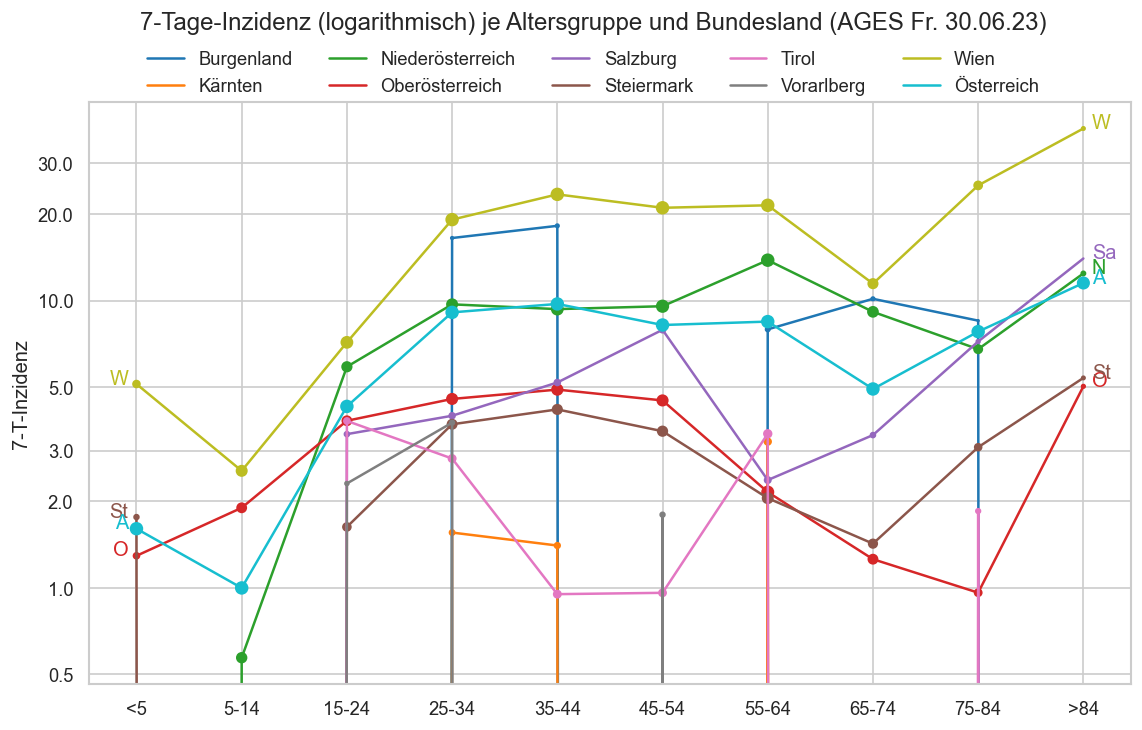
def plot_per_bl_inz_hm(
agd_sums: pd.DataFrame, figsize: (int, int), cbar_pad: float, figdpi: int,
fontsize: int=5,
labelright=True,
cbary=0.91,
cbar_aspect=4,
cbar_fraction=0.15,
projection=lambda bldata: bldata.pivot(index="Altersgruppe", columns="Datum", values="inz"),
sortkey=lambda s: s.map(ag_to_id)):
fig, axs = plt.subplots(nrows=agd_sums["Bundesland"].nunique(), figsize=figsize, dpi=figdpi, sharex=True)
if isinstance(axs, plt.Axes):
axs = [axs]
fig.suptitle("Inzidenz nach Bundeland und Altersgruppe" + AGES_STAMP, fontsize=fontsize + 3, y=1.02)
fig.subplots_adjust(hspace=0.0, top=0.975)
cmap = cov.un_cmap #sns.color_palette("BuPu", as_cmap=True).copy()
norm = matplotlib.colors.SymLogNorm(50, base=2,
vmin=0,
vmax=max(projection(agd_sums[agd_sums["Bundesland"] == bl]).max().max()
for bl in agd_sums["Bundesland"].unique()))
#norm = matplotlib.colors.TwoSlopeNorm(vmin=0.5, vcenter=1, vmax=2.5)
#norm.clip = False
for ax, bundesland in zip(axs, (c for c in cov.Bundesland.categories if c in agd_sums["Bundesland"].to_numpy())):
#ax.set_title(bundesland, size=6, pad=0)
ax.set_ylabel(cov.SHORTNAME2_BY_BUNDESLAND[bundesland])
ax.set_facecolor("grey")
bldata = agd_sums[agd_sums["Bundesland"] == bundesland]
_, cbar = plt_tl_heat(projection(bldata)
.replace(np.inf, 1000)
.sort_index(axis="rows", key=sortkey, ascending=False),
ax=ax,
im_args=dict(cmap=cmap, norm=norm),
cbar_args=dict(
#ticks=[0.5, 0.8, 1, 1.5, 2, 3],
#ticks=[0.5, 1, 1.5, 2, 2.5],
shrink=0.7,
#format=matplotlib.ticker.PercentFormatter(xmax=1),#matplotlib.ticker.FormatStrFormatter("%.1f"),
ticks=[0, 50, 100, 300, 1000, 4000],
pad=cbar_pad,
aspect=cbar_aspect,
fraction=cbar_fraction))
#print(vars(cbar))
#ax.axhline(0.4, color="lightgrey", linewidth=1, snap=True)
cbar.outline.set_visible(False)
cbar.ax.tick_params(labelsize=fontsize, pad=0)
cbar.ax.set_ylabel(cov.SHORTNAME2_BY_BUNDESLAND[bundesland])
cbar.ax.set_title("Inzidenz", size=fontsize, y=cbary)
cbar.ax.tick_params(size=0, which="both")
ax.tick_params(labelright=labelright, length=3, pad=0)
ax.tick_params(labelsize=fontsize, which="both")
ax.grid(color="lightgrey", axis="x")
#cov.set_date_opts(ax)
#ax.tick_params(bottom=False)
if ax is not axs[-1]:
ax.tick_params(axis="x", labelbottom=False, bottom=False)
if ax is axs[0]:
ax.tick_params(axis="x", labeltop=True, top=True)
plt.setp(ax.get_xticklabels(), rotation=30, ha="left", rotation_mode="anchor")
return fig, axs
if True:
plot_per_bl_inz_hm(
agd_sums[agd_sums["Datum"] >= agd_sums.iloc[-1]["Datum"] - timedelta(2000)]
.query("Altersgruppe != 'Alle'"),
(6, 3.5*2), cbar_pad=0.07, figdpi=250, fontsize=4.5);
fig, (ax,) = plot_per_bl_inz_hm(
agd_sums
.query("Bundesland == 'Österreich'"),
(9, 4), cbar_pad=0.07, figdpi=250, fontsize=8, cbar_aspect=5, cbar_fraction=0.03);
plt.setp([tick.label1 for tick in ax.xaxis.get_major_ticks()], rotation=30,
ha="right", va="center", rotation_mode="anchor")
plt.setp([tick.label2 for tick in ax.xaxis.get_major_ticks()], rotation=30,
ha="left", va="center",rotation_mode="anchor")
fig.suptitle("Inzidenz in den Altersgruppen, logarithmisch", y=1.1)
Text(0.5, 1.1, 'Inzidenz in den Altersgruppen, logarithmisch')
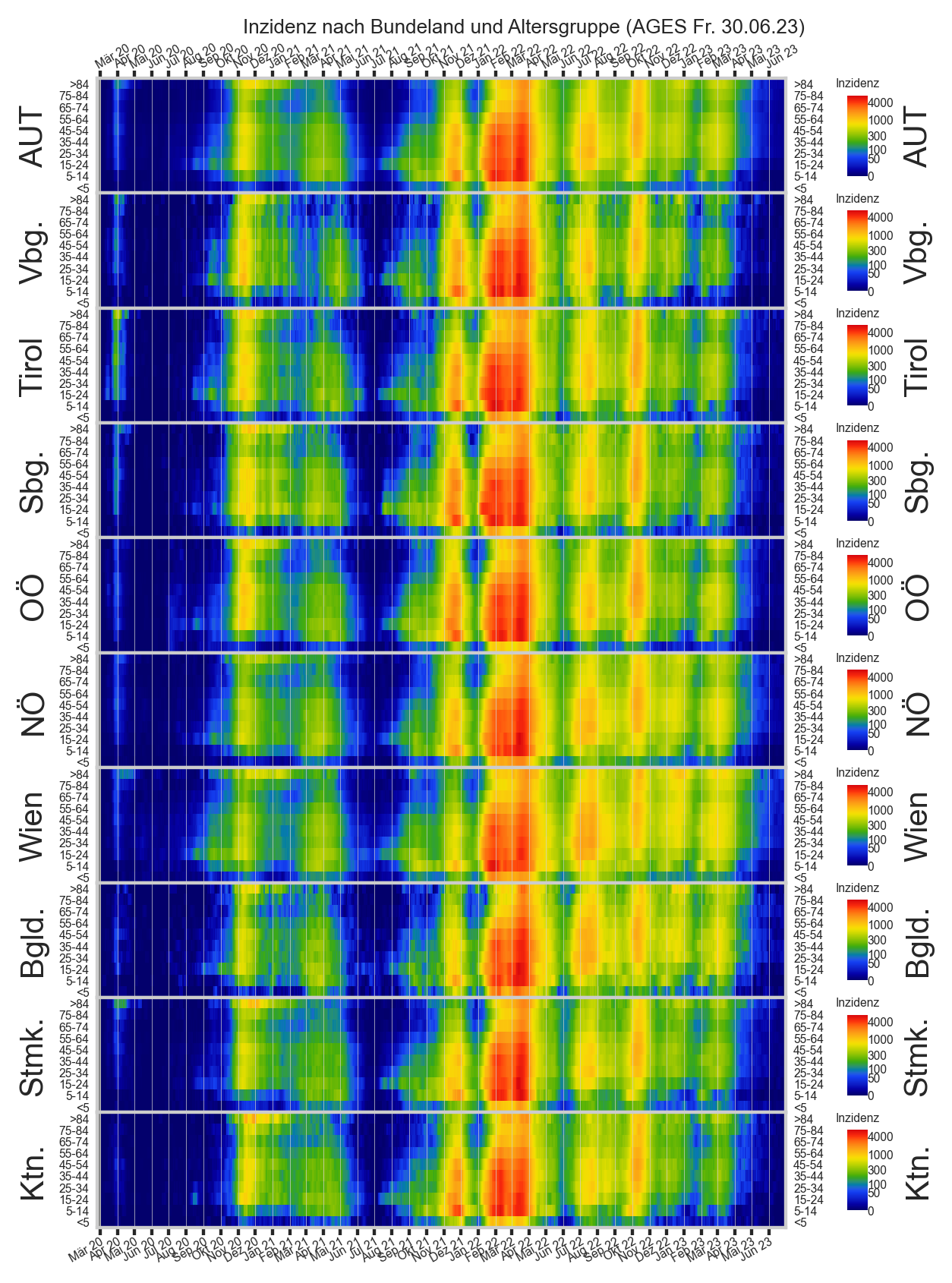
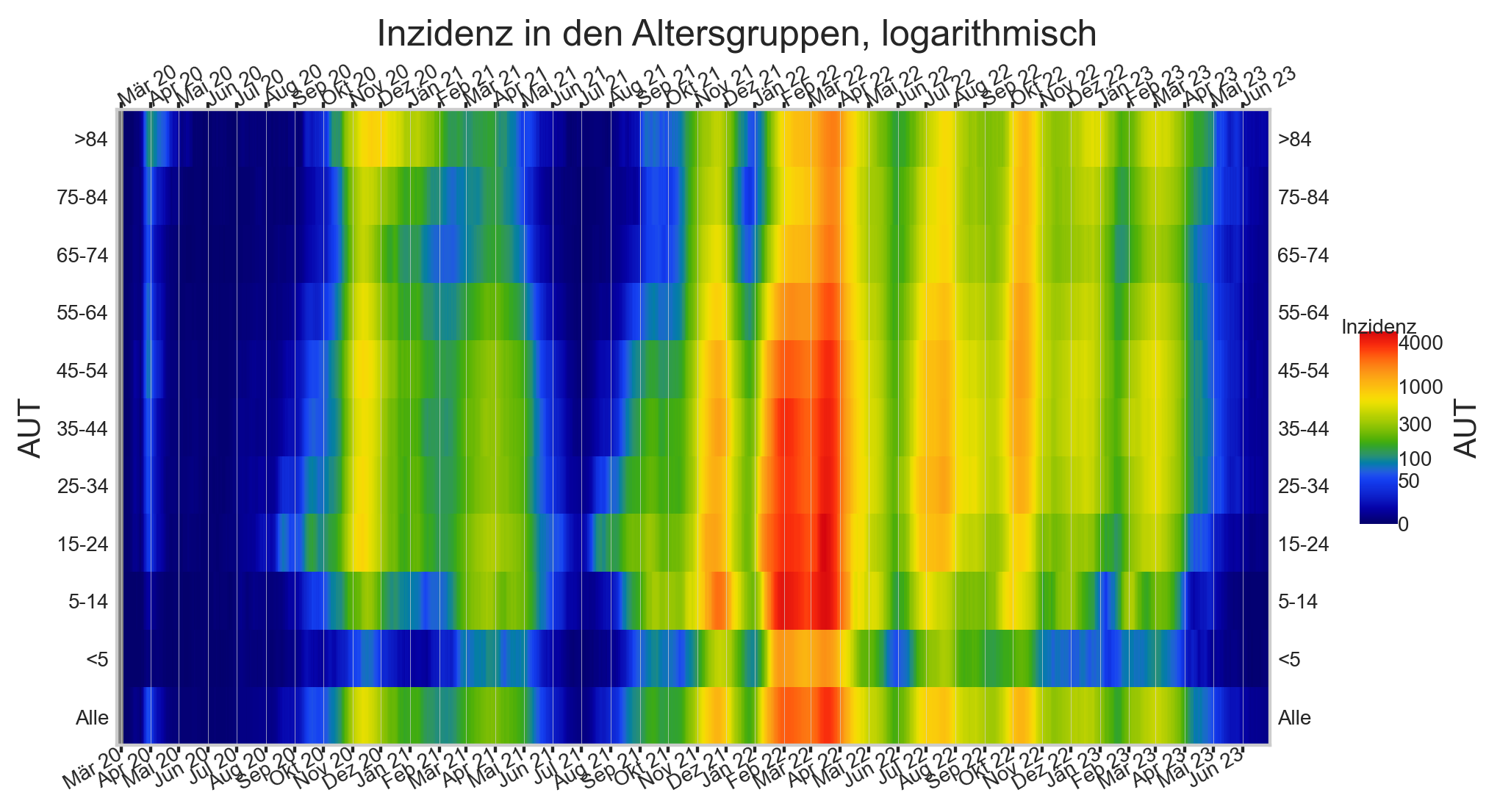
selag = "5-14"
agdata2 = agd_sums.query(f"Altersgruppe == '{selag}' and Bundesland == 'Österreich'")
#[agd_sums["Datum"] >= pd.to_datetime("2021-09-01")]
g = sns.relplot(
kind="line",
data=agdata2, x="Datum", y="AnzahlFaelleSumProEW", col="Bundesland",
#col_wrap=3,
ds="steps-post",
marker="s",
mew=0,
markersize=2,
err_style=None,
#col_order=agdata2["Bundesland"].unique()[:-1],
#solid_joinstyle="miter", marker="s", mew=0, ms=3
)
g.fig.set_size_inches(8, 8)
g.fig.suptitle("Kumulative Inzidenz in der Altersgruppe " + selag + AGES_STAMP, y=1.05)
#g.fig.subplots_adjust(hspace=0.3)
#ax.legend(*sortedlabels(ax, agdata2, "AnzahlFaelleSumProEW", fmtval=lambda v: format(v, ".0%")), ncol=2)
#ax.set_yscale("log")
#ax.yaxis.set_major_formatter(matplotlib.ticker.ScalarFormatter())
#ax.yaxis.set_major_locator(matplotlib.ticker.LogLocator(base=10, subs=[0.15, 0.2, 0.3, 0.5, 0.7, 1]))
#ax.set_ylim(bottom=1)
#labelend2(ax, agdata2, "AnzahlFaelleSumProEW", 100)
#ax.set_title("Kumulative Inzidenz " + agdata2.iloc[0]["Altersgruppe"])
#ax.set_ylabel("Kumulative Inzidenz in der Altersgruppe " + agdata2.iloc[0]["Altersgruppe"])
for ax, bl in zip(g.axes.flat, agdata2["Bundesland"].unique()):
cov.set_percent_opts(ax, decimals=0, freq=0.05)
#ax.set_ylim(bottom=0.08, top=0.28)
cov.set_date_opts(ax, agdata2["Datum"], showyear=True)
blval = agdata2[agdata2["Bundesland"] == bl]["AnzahlFaelleSumProEW"].iloc[-1]
ax.set_title(f"{bl}: {blval:.1%}")
ax.set_ylabel("Kumulative Inzidenz")
ax.set_ylim(bottom=0)
g.fig.autofmt_xdate()
...\AppData\Local\hatch\env\virtual\covidat\MDfikVs6\notebooks\Lib\site-packages\seaborn\axisgrid.py:118: UserWarning: The figure layout has changed to tight self._figure.tight_layout(*args, **kwargs)
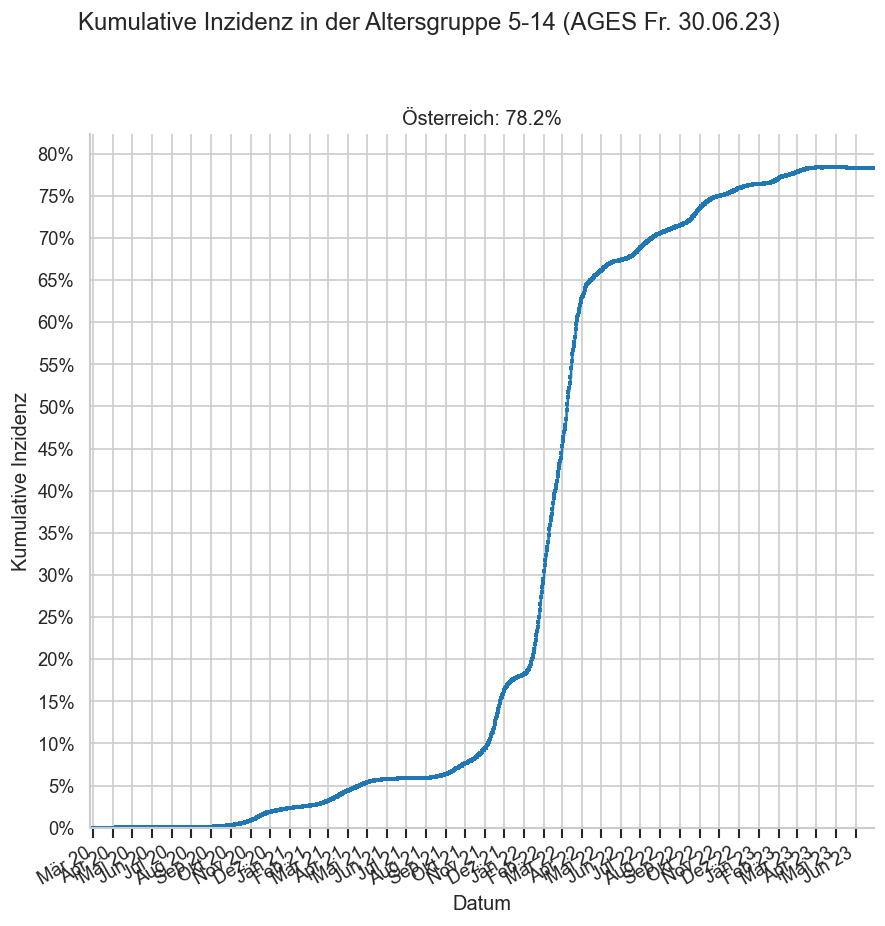
# cividis
# Spectral_r
# rainbow
# viridis
# cubehelix
# brg # Wie eine werbung oder so
# gist_ncar: Brauchbar
# seismic
cov=reload(cov)
with cov.with_age_palette():
for bundesland in ("Österreich", ): #cov.Bundesland.categories:
display(Markdown(f"### Altersgruppendaten zu {bundesland}"))
cov.plt_cat_dists(
data_cat=agd_sums[(agd_sums["Bundesland"] == bundesland)
#& (agd_sums["Datum"] != agd_sums["Datum"].iloc[-1])
]
.query(
#"Altersgruppe not in ('Alle', '15-24', '25-34')",
"Altersgruppe not in ('Alle')"),
data_agg=agd_sums[agd_sums["Bundesland"] == bundesland].query("Altersgruppe == 'Alle'"),
#.iloc[:-1]
bundesland=bundesland,
catcol="Altersgruppe",
stamp=AGES_STAMP,
datefrom=None,#fs.iloc[-1]["Datum"] - timedelta(400),
shortrange=90)
#break
x0 = cov.filterlatest(agd_sums).query("Bundesland == 'Österreich'")
p85 = x0.query("Altersgruppe == '>84'")["AnzahlFaelle7Tage"].iloc[-1] / x0.query("Altersgruppe == 'Alle'")["AnzahlFaelle7Tage"].iloc[-1]
p75 = x0.query("Altersgruppe == '75-84'")["AnzahlFaelle7Tage"].iloc[-1] / x0.query("Altersgruppe == 'Alle'")["AnzahlFaelle7Tage"].iloc[-1]
p65 = x0.query("Altersgruppe == '65-74'")["AnzahlFaelle7Tage"].iloc[-1] / x0.query("Altersgruppe == 'Alle'")["AnzahlFaelle7Tage"].iloc[-1]
data = (agd_sums[agd_sums["Datum"] > agd_sums["Datum"].iloc[-1] - timedelta(MIDRANGE_NDAYS * 4)]
.query("Altersgruppe == '5-14'"))
ax = sns.lineplot(data=data, x="Datum", y="inz", hue="Bundesland",
#marker=".",
mew=0,
size="AnzEinwohnerFixed",
size_norm=matplotlib.colors.Normalize(vmax=100_000),
markersize=12,
err_style=None)
ax.figure.suptitle(
"Inzidenz in der Altersgruppe " + data.iloc[0]["Altersgruppe"] +
" je Bundesland ‒ logarithmische Skala" + AGES_STAMP, y=0.93)
labelend2(ax, data, "inz")
ax.set_xlim(left=data.iloc[0]["Datum"])
ax.set_xlim(left=ax.get_xlim()[0] + 0.5)
cov.set_date_opts(ax, data["Datum"])
ax.set_ylabel("7-Tage-Inzidenz/100.000 EW")
#ax.set_yscale("log")
cov.set_logscale(ax)
ax.legend(*sortedlabels(ax, data, "inz", "Bundesland"), ncol=2, fontsize="small")
#ax.set_ylim(bottom=5);
#ax.yaxis.set_major_formatter(matplotlib.ticker.ScalarFormatter())
#ax.yaxis.set_major_locator(matplotlib.ticker.LogLocator(subs=[0.2, 0.5, 1]))
#ax.yaxis.set_minor_locator(matplotlib.ticker.NullLocator())
<matplotlib.legend.Legend at 0x19910bbd290>
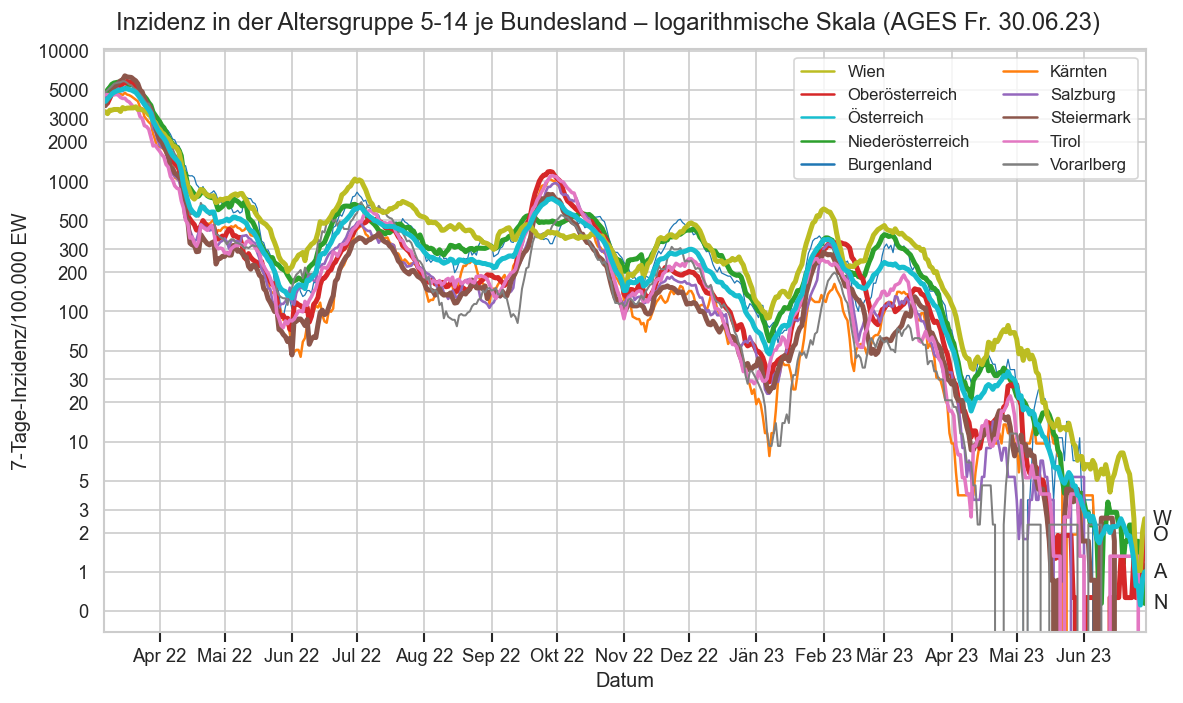
fig, ax = plt.subplots()
ax.plot(natmon_latest["Abwassersignal"].dropna() / 650_000,
label="Drübergelegtes Abwassersignal Österreich")
ax.plot(
agd_sums.query("Altersgruppe == '>84' and Bundesland == 'Wien'").set_index("Datum")["inz"],
label="Inzidenz Altersgruppe 85+ in Wien")
ax.plot(
fs.query("Bundesland == 'Österreich'").set_index("Datum")["inz"],
label="Gesamtinzidenz Österreich")
cov.set_date_opts(ax, natmon_latest.index)
fig.autofmt_xdate()
fig.legend(frameon=False, ncol=3, loc="upper center", bbox_to_anchor=(0.5, 0.97))
ax.set_ylabel("Fälle/100.000 EW")
ax.set_ylim(bottom=0, top=1000)
ax.yaxis.set_major_locator(matplotlib.ticker.MultipleLocator(100))
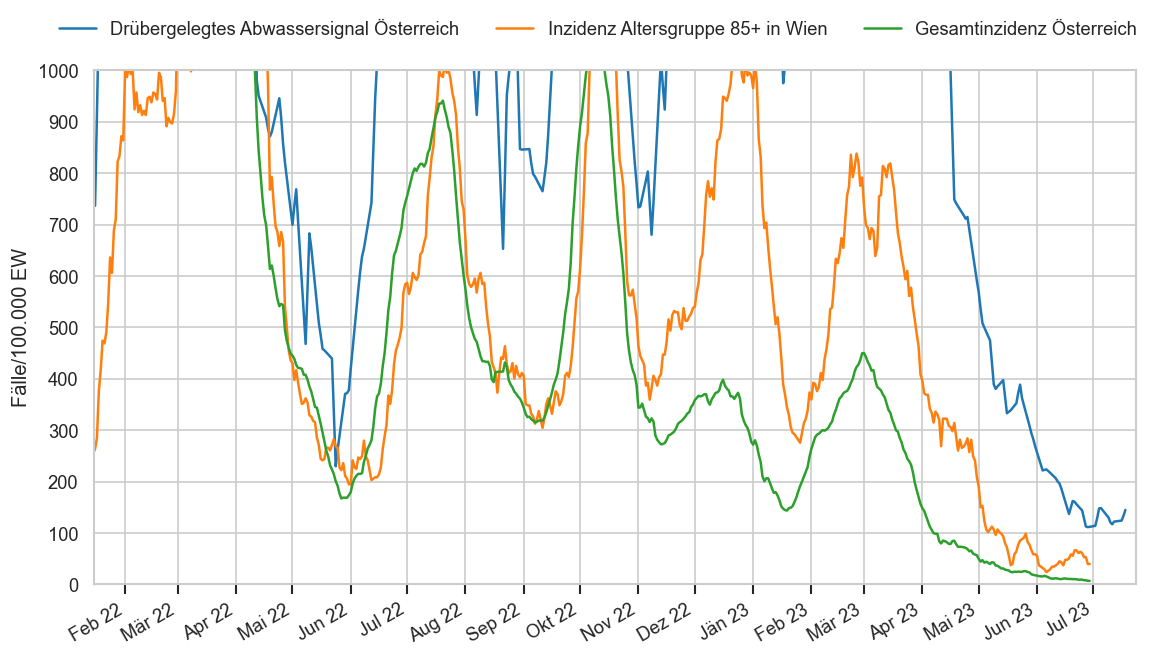
data = agg_casedata(agd_sums[agd_sums["Datum"] > agd_sums["Datum"].iloc[-1] - timedelta(2000)]
.query("Altersgruppe in ('>84',)"), "Altersgruppe", "85+", extragrp=["Bundesland"]).reset_index()
ax = sns.lineplot(data=data, x="Datum", y="inz", hue="Bundesland",
#marker=".",
#mew=0.5,
size="AnzEinwohnerFixed",
size_norm=matplotlib.colors.Normalize(vmax=data.query("Bundesland != 'Österreich'")["AnzEinwohner"].max()),
err_style=None,
#markersize=12
)
fig = ax.figure
fig.suptitle(
"Inzidenz in der Altersgruppe " + data.iloc[0]["Altersgruppe"] +
" je Bundesland" + ", logarithmische Skala" + AGES_STAMP, y=0.98)
labelend2(ax, data, "inz")
ax.set_xlim(left=data.iloc[0]["Datum"])
ax.set_xlim(left=ax.get_xlim()[0] + 0.5)
cov.set_date_opts(ax, data["Datum"], )
fig.autofmt_xdate()
ax.set_ylabel("7-Tage-Inzidenz/100.000 EW")
#ax.set_yscale("log")
if True:
cov.set_logscale(ax)
ax.set_ylim(bottom=max(1, data["inz"].quantile(0.02, interpolation="lower")))
else:
ax.set_ylim(bottom=0)
fig.legend(
*sortedlabels(ax, data, "inz", "Bundesland", fmtval=lambda x: f"{x:.0f}"), ncol=5, fontsize="small",
frameon=False, loc="upper center", bbox_to_anchor=(0.5, 0.96))
ax.get_legend().remove()
print(ax.get_xlim()[0], ax.get_xlim()[1], matplotlib.dates.date2num(data["Datum"].max() - timedelta(1)))
ax.axvspan(
matplotlib.dates.date2num(data["Datum"].max() - timedelta(1)),
ax.get_xlim()[1],
color="k", alpha=0.2)
#ax.set_ylim(bottom=5);
#ax.yaxis.set_major_formatter(matplotlib.ticker.ScalarFormatter())
#ax.yaxis.set_major_locator(matplotlib.ticker.LogLocator(subs=[0.2, 0.5, 1]))
#ax.yaxis.set_minor_locator(matplotlib.ticker.NullLocator())
#ax.axvline(pd.to_datetime("2023-02-01"), color="k")
18317.5 19537.5 19536.0
<matplotlib.patches.Polygon at 0x199129c0050>
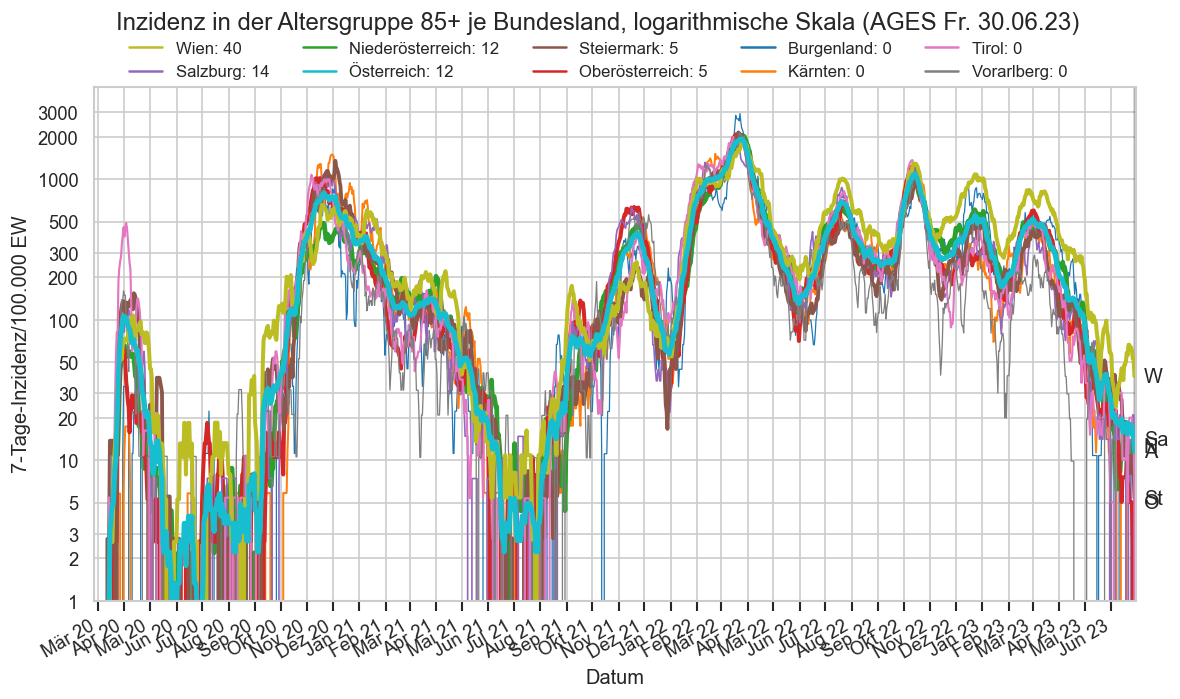
Inzidenzänderungsverlauf je Altersgruppe¶
Hier geht es nicht um die 7-Tages-Inzidenz pro 100.000 Einwohner selbst, sondern um deren relative Veränderung.
Der ORF hat die entsprechenden Inzidenzen dazu: https://orf.at/corona/daten/oesterreich
cov=reload(cov)
if False:
g = sns.FacetGrid(agd_sums.query("Datum > '2021-06-15' and (inz_prev7 > 20 or inz > 20)"), row="Bundesland", aspect=3).map_dataframe(
sns.lineplot,
x="Datum", y="inz_g7",
hue="Altersgruppe", hue_order=["<5", "5-14", "15-24", "25-34", "35-44", "45-54", "55-64", "65-74", "75-84", ">84"],
marker=".",
#markeredgecolor="none"
)
plt.legend()
#plt.text(pd.to_datetime("2021-08-09"), 5, "foo-bar-baz", rotation=45, ha="left", va="top")
for ax in g.axes.flat:
ax.axhline(1, color="black");
ax.set_ylabel("Relative Änderung ggü. 7 Tage voher");
ax.set_ylim(top=4, bottom=0)
def plt_ages(data: pd.DataFrame, by="Altersgruppe", **kwargs):
#print("pltby", by)
y = "inz_g7p"
data0 = data.copy()
data0[y] = data0["inz_g7"] - 1
ax = sns.lineplot(
data=data0,
x="Datum", y=y, mew=0, markersize=12,
hue=by, #hue_order=["<5", "5-14", "15-24", "25-34", "35-44", "45-54", "55-64", "65-74", "75-84", ">84"],
size="AnzEinwohnerFixed" if "AnzEinwohnerFixed" in data0.columns else "AnzEinwohner",
size_norm=matplotlib.colors.Normalize(vmax=data["AnzEinwohner"].quantile(0.9)),
err_style=None,
**kwargs
)
ax.yaxis.set_major_formatter(matplotlib.ticker.PercentFormatter(xmax=1))
#cov.remove_labels_after(ax, "AnzEinwohner", bbox_to_anchor=(0.7, 1), loc="upper right")
ax.legend(
*sortedlabels(ax, data0, y, cat=by, fmtval=lambda v: format(v, "+.0%")),
loc="best", fontsize="small", ncol=2)
kwargs2 = dict(shorten=lambda c: c) if by == "Altersgruppe" else {}
labelend2(ax, data0, y, cats=by, size=8, **kwargs2)
cov.set_date_opts(ax, data0["Datum"])
ax.set_xlim(left=ax.get_xlim()[0] + 0.5)
return ax
def plt_age_changes(data: pd.DataFrame, by="Altersgruppe", ax=None):
if ax is None:
ax = plt.gca()
#print("pltby_c", by)
ndays = (data["Datum"].max() - data["Datum"].min()).days
ax = plt_ages(data.query("Altersgruppe != 'Alle'"), by=by, marker='.' if ndays <= MIDRANGE_NDAYS else None, ax=ax)
ax.axhline(0, color="black", zorder=0.6)
#ax.set_ylim(top=min(0.7, ax.get_ylim()[1]), bottom=max(-0.5, ax.get_ylim()[0]))
ax.set_ylabel("Änderung ggü. 7 Tage vorher")
return ax
def plt_age_changes_2(agd_sums_at, by="Altersgruppe", ndays=SHORTRANGE_NDAYS, ax=None):
#print("pltby_c", by)
ax = plt_age_changes(
agd_sums_at[agd_sums_at["Datum"] >= agd_sums_at["Datum"].max() - np.timedelta64(ndays, "D")],
by=by, ax=ax)
ax.set_title(agd_sums_at.iloc[-1]["Altersgruppe" if by == "Bundesland" else "Bundesland"]
+ ": Verlauf der wöchentlichen Inzidenzveränderung je " + by + AGES_STAMP)
#plt.gcf().legend(loc="center right")
#ax.get_legend().remove()
if False:
plt.figure()
one_year_earlier = agd_sums_at["Datum"].max() - np.timedelta64(365, "D")
ax = plt_age_changes(agd_sums_at[
(agd_sums_at["Datum"] >= one_year_earlier - np.timedelta64(90 // 2, "D")) &
(agd_sums_at["Datum"] <= one_year_earlier + np.timedelta64(90 // 2, "D"))])
ax.axvline(one_year_earlier, linestyle='--', color="k", zorder=0.6)
ax.text(one_year_earlier, ax.get_ylim()[1] * 0.99, one_year_earlier.strftime(" %x"), va="top");
return ax
#plt.figure()
#agd_sums_oo = agd_sums.query("Bundesland == 'Oberösterreich'").reset_index()
#ax = plt_ages(agd_sums_oo[agd_sums_oo["Datum"] >= "2020-09-01"], "inz")
#ax.set_yscale("log", base=2)
#ax.get_yaxis().set_major_formatter(matplotlib.ticker.ScalarFormatter())
#ax.set_ylabel("Inzidenz");
if DISPLAY_SHORTRANGE_DIAGS:
with cov.with_age_palette():
fig, axs = plt.subplots(nrows=2, sharex=False, sharey=True, figsize=(10, 10))
fig.suptitle("Verlauf der wöchentlichen Inzidenzveränderung je Altersgruppe" + AGES_STAMP, y=0.92)
ax = plt_age_changes_2(agd_sums.query("Bundesland == 'Österreich'"), ax=axs[0], ndays=7*5 + 2)
ax.set_xlabel(None)
ax.set_title("Nach Labordatum")
ax = plt_age_changes_2(agd1m_sums.query("Bundesland == 'Österreich'"), ax=axs[1], ndays=7*5 + 2)
ax.set_ylim(bottom=max(ax.get_ylim()[0], -0.5), top=min(ax.get_ylim()[1], 2))
#ax.set_ylim(bottom=-0.6, top=1)
ax.set_title("Nach Meldedatum")
plt.figure()
#ax = plt_age_changes_2(agd_sums.query("Bundesland == 'Wien'"), by="Altersgruppe", ndays=37)
#ax.set_ylim(top=1)
for bl in agd_sums["Bundesland"].unique():
plt.figure()
ax = plt_age_changes_2(agd_sums[~np.isnan(agd_sums["inz_g7"])].query(f"Bundesland == '{bl}'"),
ndays=SHORTRANGE_NDAYS)
#ax.set_ylim(bottom=-0.6, top=1)
ax.set_title(ax.get_title().replace("(", "nach Labordatum ("))
import contextlib
cov=reload(cov)
def drawrelag(selbl="Österreich", by="Bundesland", relto="allcat"):
cat = "Bundesland" if by != "Bundesland" else "Altersgruppe"
allcat = "Alle" if cat == "Altersgruppe" else "Österreich"
allby = "Alle" if by == "Altersgruppe" else "Österreich"
agd_sums0 = agd_sums.query(f"{by} == '{selbl}'").set_index([cat, "Datum"])
if relto == "allcat":
norm = agd_sums0.xs(allcat)["inz"]
elif relto == "bytotal":
norm = agd_sums.query(f"{by} == '{allby}'").set_index([cat, "Datum"])["inz"]
agd_sums0["relinz"] = agd_sums0["inz"] / norm
#agd_sums0 = agd_sums0[
# agd_sums0.index.get_level_values("Datum") >= agd_sums0.index[-1][1] - timedelta(MIDRANGE_NDAYS * 1.5)]
with cov.with_age_palette() if cat == "Altersgruppe" else contextlib.nullcontext():
df = agd_sums0.reset_index().query(f"{cat} != '{allcat}'")
ax = sns.lineplot(
df,
x="Datum", y="relinz", hue=cat, size="AnzEinwohnerFixed", mew=0,
err_style=None)
ax.axhline(1, color="k", lw=1)
cov.remove_labels_after(ax, "AnzEinwohnerFixed", ncol=2, fontsize="small")
cov.set_percent_opts(ax)
cov.set_date_opts(ax, agd_sums0.index.get_level_values("Datum"), autoyear=True)
ax.set_xlim(right=ax.get_xlim()[1] + 1)
ax.set_ylim(bottom=0)
ax.set_ylabel("Inzidenz relativ zur Gesamtinzidenz")
fig = ax.figure
fig.suptitle(
selbl +
f": Inzidenz je {cat} relativ zur " +
("Gesamtinzidenz" if relto == "allcat" else f"Gesamtinzidenz je {cat}") + AGES_STAMP,
y=0.99)
fig.legend(
*cov.sortedlabels(ax, df, "relinz", cat=cat, fmtval=lambda x: f"{x:.0%}"), ncol=5,
loc="upper center", frameon=False, bbox_to_anchor=(0.5, 0.97))
ax.get_legend().remove()
cov.labelend2(ax, df, "relinz", cats=cat, **({"shorten": lambda x: x} if cat != "Bundesland" else {}))
ax.set_ylim(top=min(3.5, ax.get_ylim()[1]))
drawrelag("Österreich")
plt.figure()
drawrelag(">84", "Altersgruppe", relto="bytotal")
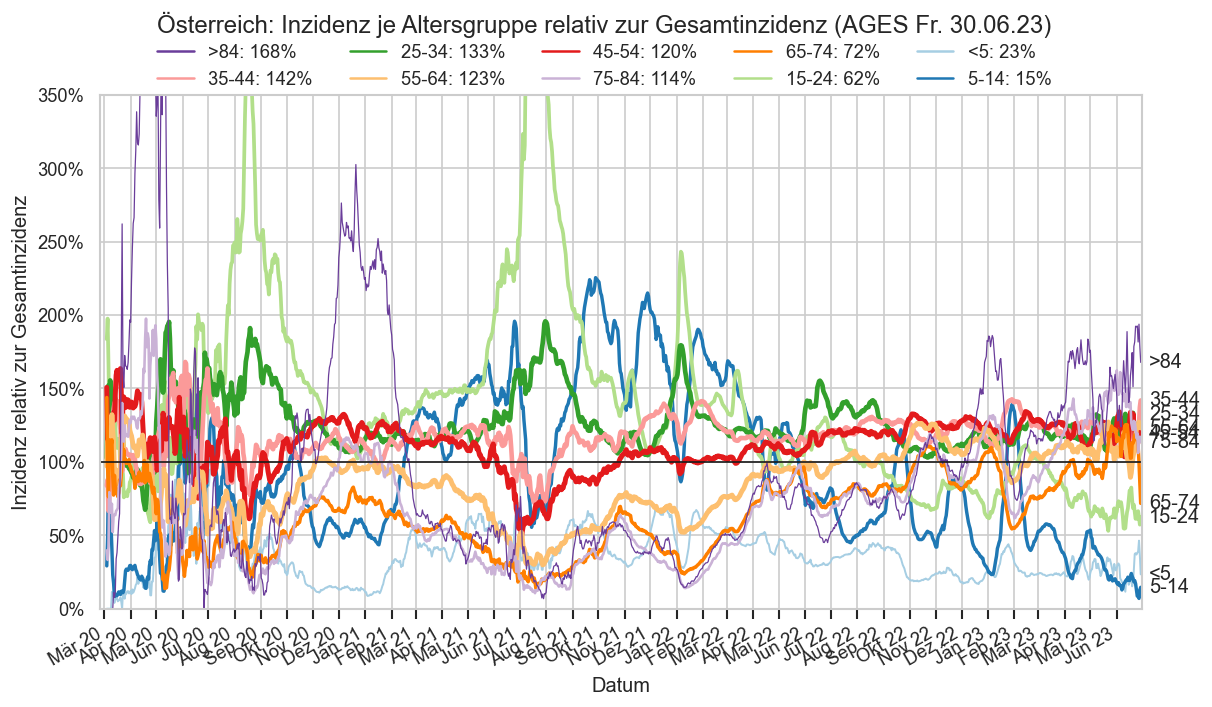
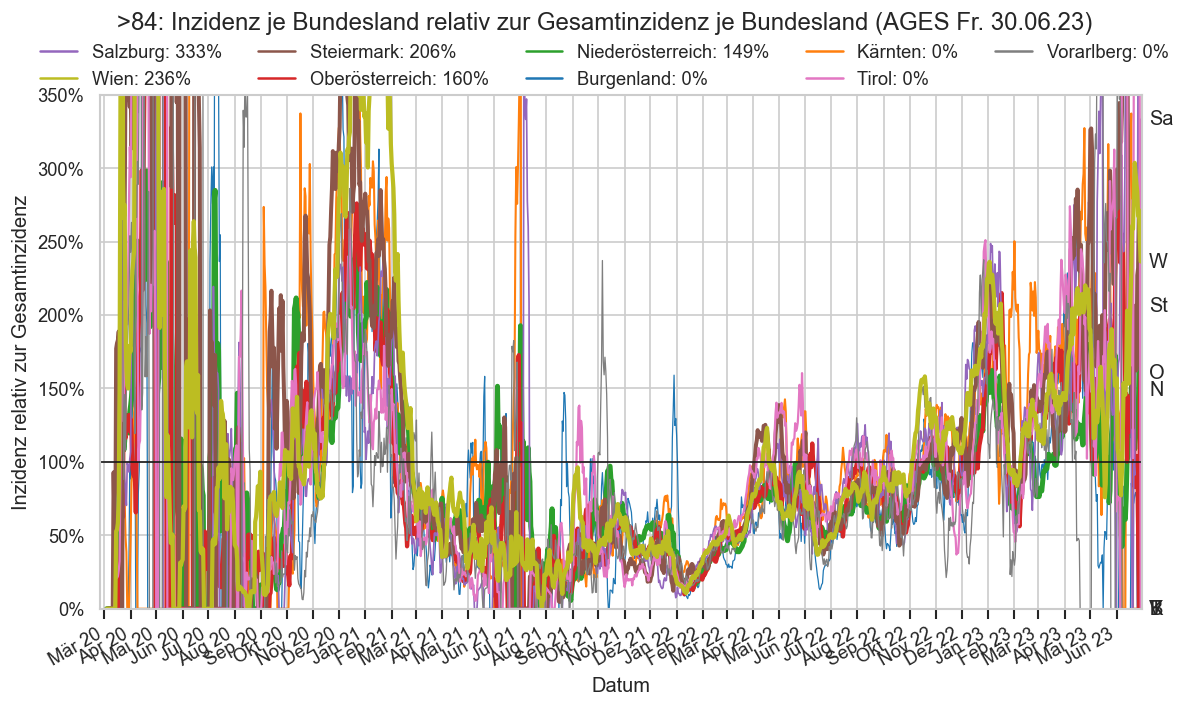
if DISPLAY_SHORTRANGE_DIAGS:
plt.figure()
plt_age_changes_2(agd_sums.query("Altersgruppe == '>84'"), by="Bundesland")
plt.gca().set_ylim(top=2)
plt.figure()
plt_age_changes_2(agd_sums.query("Altersgruppe == '5-14'"), by="Bundesland", ndays=SHORTRANGE_NDAYS);
Änderungsraten¶
reff_o = pd.read_csv(
DATAROOT / "covid/ages-ems-extra/R_eff_latest.csv",
sep=";", decimal=",",
parse_dates=["Datum"],
date_format=cov.ISO_DATE_FMT).set_index("Datum")
display(reff_o.index.dtype)
reff_o.index = reff_o.index.normalize().tz_localize(None)
fig, axs = plt.subplots(nrows=2, gridspec_kw={'height_ratios': [0.8, 0.2]}, sharex=True)
fig.subplots_adjust(hspace=0.1)
ax = axs.flat[0]
ax.set_title("Datenquelle: AGES, TU Graz (CC BY 4.0)")
reff = reff_o["R_eff"]#.query("Datum >= '2020-04-27' and Datum < '2022-04-16'")["R_eff"]
fig.suptitle("Effektive Reproduktionszahl von SARS-CoV-2 in Österreich bis " + reff.index[-1].strftime("%x"))
style = dict(zorder=-3, alpha=0.5, in_layout=False)
ax.plot(reff, color="grey")
ax.plot(reff.where(reff < 1), label=r"$R_\operatorname{eff} < 1$ (abnehmende Ausbreitung)")
ax.plot(reff.where(reff > 1), color="C3", label=r"$R_\operatorname{eff} > 1$ (zunehmende Ausbreitung)")
ax.set_ylabel(r"$R_\operatorname{eff}$")
ax.set_xlim(*ax.get_xlim())
def markseasons(ax):
ax.axvspan(pd.to_datetime("2019-12-01"), pd.to_datetime("2020-03-01"), color="skyblue", **style, label="Winter")
ax.axvspan(pd.to_datetime("2020-06-01"), pd.to_datetime("2020-09-01"), color=(1, 1, 0.2), **style, label="Sommer")
ax.axvspan(pd.to_datetime("2021-06-01"), pd.to_datetime("2021-09-01"), color=(1, 1, 0.2), **style)
ax.axvspan(pd.to_datetime("2022-06-01"), pd.to_datetime("2022-09-01"), color=(1, 1, 0.2), **style)
ax.axvspan(pd.to_datetime("2023-06-01"), pd.to_datetime("2023-09-01"), color=(1, 1, 0.2), **style)
ax.axvspan(pd.to_datetime("2020-12-01"), pd.to_datetime("2021-03-01"), color="skyblue", **style)
ax.axvspan(pd.to_datetime("2021-12-01"), pd.to_datetime("2022-03-01"), color="skyblue", **style)
ax.axvspan(pd.to_datetime("2022-12-01"), pd.to_datetime("2023-03-01"), color="skyblue", **style)
markseasons(ax)
ax.legend(loc="upper left", ncol=4, fontsize="smaller")
ax.axhline(1, color="k")
ax.tick_params(bottom=False, axis="x")
ax.set_ylim(top=1.6, bottom=0.6)
#ax.xaxis.set_major_locator(matplotlib.ticker.NullLocator())
ax2 = axs.flat[1]
#cov.set_logscale(ax2)
ax2.set_ylim(top=750, bottom=0)
ax2.yaxis.set_major_locator(matplotlib.ticker.MultipleLocator(300))
#ax2.grid(False)
ax2.fill_between(fs_at["Datum"], fs_at["inz"].to_numpy(), color="C1", lw=0, alpha=0.3)
ax2.plot(fs_at["Datum"], fs_at["inz"], color="C1", label="7-Tage-Inzidenz", lw=2)
ax2.legend(loc="upper left", ncol=4, fontsize="smaller")
markseasons(ax2)
cov.set_date_opts(ax2, reff.index, showyear=True)
ax.set_xlim(right=ax.get_xlim()[1] + 14)
fig.autofmt_xdate();
dtype('<M8[ns]')
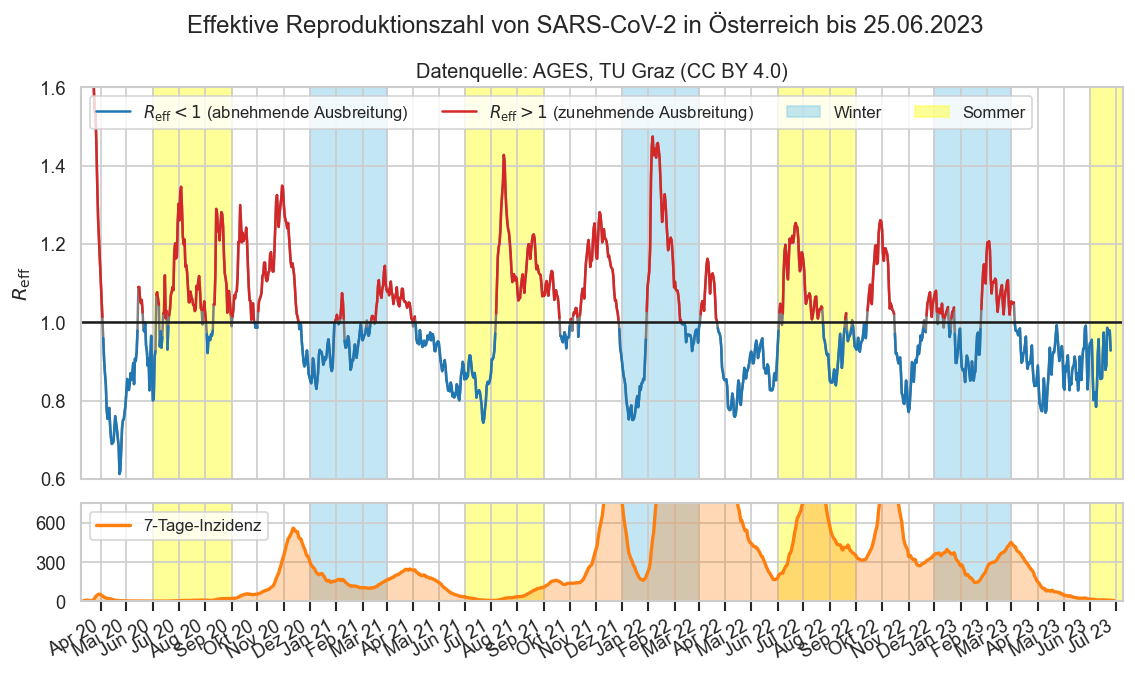
fs_at.iloc[-1]["AnzahlFaelle7Tage"] / fs_at.iloc[-1 -3]["AnzahlFaelle7Tage"]
0.8349
#selbl = "Österreich"
#data0 = ems.query(f"Bundesland == '{selbl}'")
nwien = fs.query("Bundesland not in ('Wien', 'Österreich')").groupby("Datum").agg({
"AnzahlFaelleSum": "sum",
"AnzahlFaelle": "sum",
"AnzEinwohner": "sum"}).reset_index()
nwien["Bundesland"] = "Österreich ohne Wien"
nwien["inz"] = cov.calc_inz(nwien)
cov.enrich_inz(nwien, catcol="Bundesland")
def plt0(data0):
data0 = data0.iloc[-MIDRANGE_NDAYS:]
plt_growfig(data0, data0.iloc[0]["Bundesland"])
#plt.axvspan(date(2021, 7, 1), date(2021, 7, 22), color="y", zorder=10, alpha=0.3)
#plt.axvline(date(2021, 7, 1), color="k", zorder=1)
#plt.axvline(date(2021, 7, 22), color="k", zorder=1)
plt.gca().set_ylim(top=2, bottom=-2)
#plt_growfig(fs_at, fs_at.iloc[0]["Bundesland"])
#display(nwien.tail(1))
#plt0(fs.query("Bundesland == 'Wien'"))
#plt_growfig(nwien.query("Datum >= '2021-01-01'"), "Österreich ohne Wien/AGES nach Labordatum")
#plt.gca().set_ylim(top=2, bottom=-2)
#plt0(fs.query("Bundesland == 'Österreich'"))
#plt_growfig(ages1m.query("Bundesland == 'Österreich' and Datum >= '2011-01-01'"), "Österreich/AGES nach Meldedatum")
plt_growfig(fs.query("Bundesland == 'Wien'"), "Wien/AGES nach Labordatum")
plt.gca().set_ylim(top=1.2, bottom=-1);
plt_growfig(ages1mx.reset_index().query("Bundesland == 'Österreich'").iloc[-600:], "Österreich/AGES nach Meldedatum ohne Nachmeldungen >14T")
plt.gca().set_ylim(top=1.2, bottom=-1);
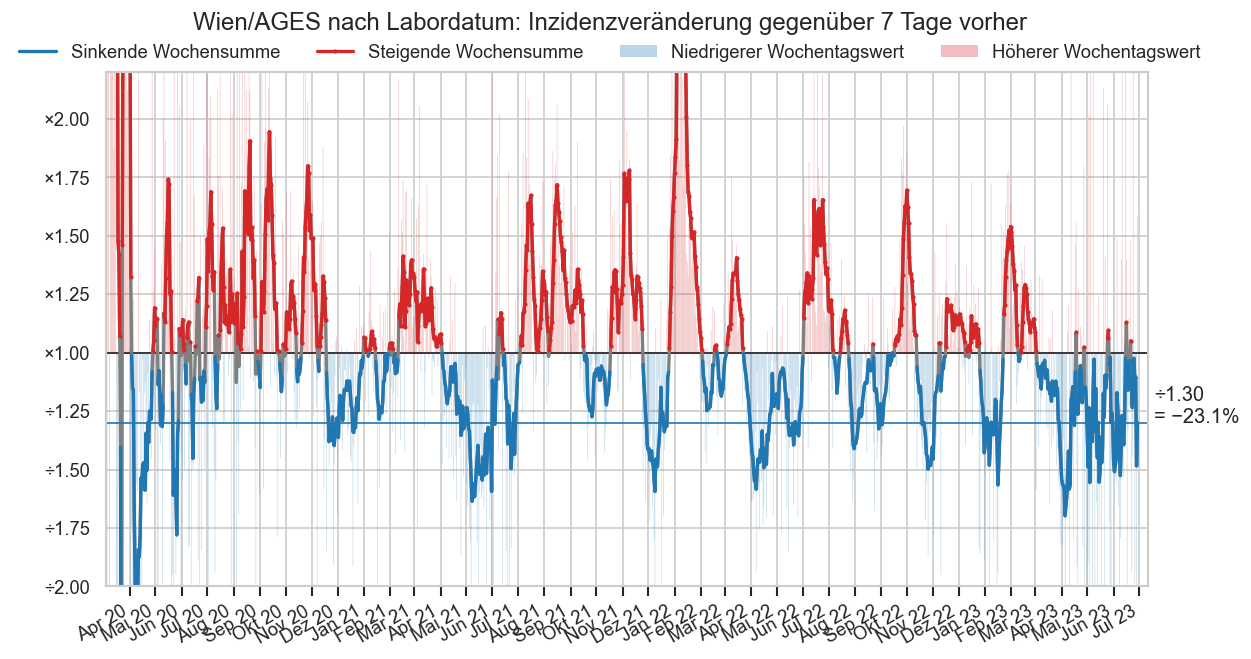
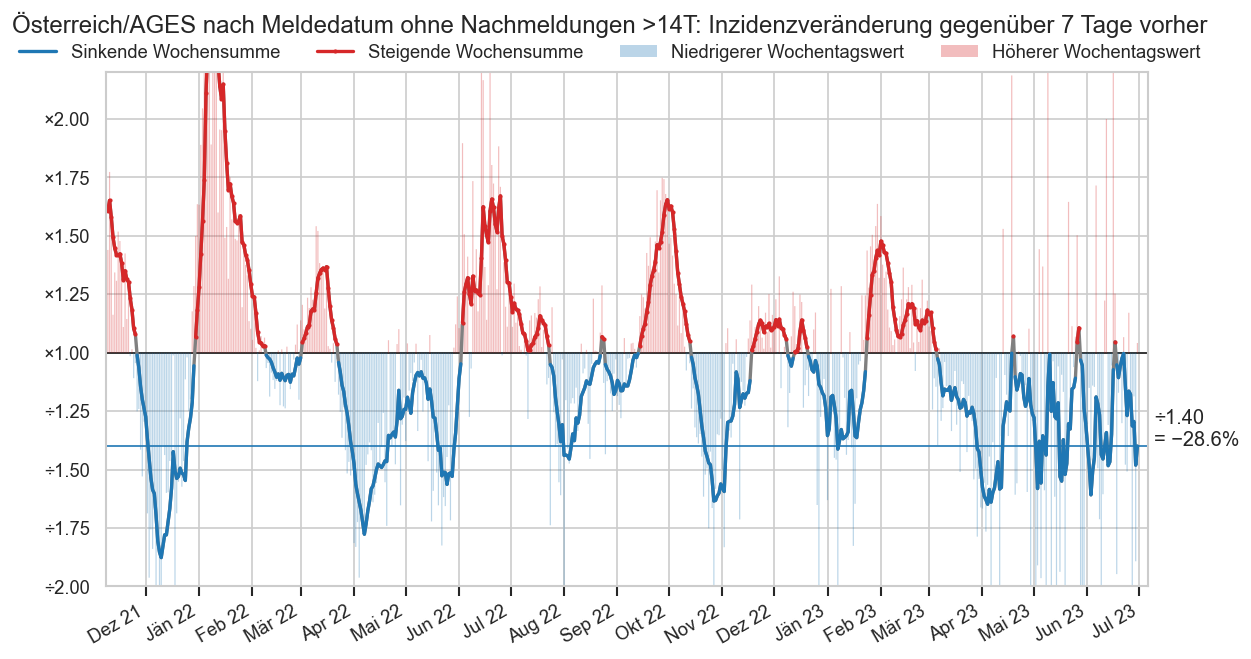
def plt_bl_gs(fs, extratitle="", ccol="Bundesland", ndays=SHORTRANGE_NDAYS):
recfs = fs[fs["Datum"] >= fs["Datum"].iloc[-1] - timedelta(ndays)]
recfs = recfs.copy()
recfs["inz_g7p"] = recfs["inz_g7"] - 1
recfs["inz_dg7p"] = recfs["inz_dg7"] - 1
uselegend = recfs[ccol].nunique() < 25
kwargs = {'err_style': None}
if uselegend:
kwargs['size_norm'] = matplotlib.colors.Normalize(vmax=min(2_000_000, recfs["AnzEinwohner"].max()))
kwargs['size'] = "AnzEinwohnerFixed" if "AnzEinwohnerFixed" in fs.columns else "AnzEinwohner"
if 10 < recfs[ccol].nunique() <= 20:
kwargs["palette"] = "tab20"
else:
kwargs['alpha'] = 0.992 ** recfs[ccol].nunique()
ax = sns.lineplot(
data=recfs, x="Datum", y="inz_g7p", hue=ccol,
marker='.' if uselegend else None, mew=0, markersize=8, legend=uselegend, **kwargs)
#sns.lineplot(
# data=recfs, x="Datum", y="inz_dg7p", hue="Bundesland", marker="*", lw=0, mew=0,
# ax=ax, legend=False)
if uselegend:
ax.legend(
*sortedlabels(ax, recfs, "inz_g7p", fmtval=lambda v: format(v, "+.0%"), cat=ccol),
ncol=2, fontsize="small")
#ax.set_ylim(bottom=-0.6, top=1)
cov.set_date_opts(ax, recfs["Datum"])
#ax.set_xlim(left=ax.get_xlim()[0] + 0.5, right=ax.get_xlim()[1] + 3)
finfs = recfs[np.isfinite(recfs["inz_g7p"])]
bottom = min(finfs["inz_g7p"].quantile(0.003) * 1.05, cov.filterlatest(finfs)["inz_g7p"].min() * 1.01)
top = max(finfs["inz_g7p"].quantile(0.997) * 1.05, cov.filterlatest(finfs)["inz_g7p"].max() * 1.01)
ax.set_ylim(
# TODO: Bottom calculation is only correct if bottom is negative
bottom=bottom,
top=top)
#ax.set_xlim(left=date(2021, 10, 1))
cov.set_percent_opts(ax, freq=0.25)
if ccol == "Bezirk":
labelend2(ax, recfs, "inz_g7p", cats=ccol, shorten=(lambda cat: cov.bezname_to_kfz(cat)))
elif ccol == "Bundesland":
labelend2(ax, recfs, "inz_g7p", cats=ccol)
elif ccol == "Gruppe":
def shorten_grp(cat):
tokens = cat.split()
tokens[0] = cov.SHORTNAME_BY_BUNDESLAND[tokens[0]]
return " ".join(tokens)
labelend2(ax, recfs, "inz_g7p", cats=ccol, shorten=shorten_grp)
ax.set_ylabel("Anstieg positiver Tests ggü. 7 Tage vorher")
ax.axhline(0, color="k", zorder=1);
ax.axhline(0, color="k", zorder=4, alpha=.5);
ax.set_title(f"Verlauf der wöchentlichen Inzidenzveränderung je {ccol}{extratitle}")
return ax
if False:
plt_bl_gs(ages1m, " ‒ Nach Meldedatum" + AGES_STAMP, ndays=50)
plt.figure()
if DISPLAY_SHORTRANGE_DIAGS:
plt_bl_gs(fs, "‒ Nach Labordatum" + AGES_STAMP)
if False:
plt.figure()
ages1mx0 = ages1mx.reset_index().copy()
cov.enrich_inz(ages1mx0, catcol="Bundesland")
plt_bl_gs(ages1mx0, " ‒ Nach AGES-Meldedatum ohne Nachmeldungen >14 Tage")
#ax.set_ylim(top=3)
if DISPLAY_SHORTRANGE_DIAGS:
plt.figure()
selbl="Oberösterreich"
ax = plt_bl_gs(bez.query(f"Bundesland == '{selbl}' and GKZ > 0"), f" in {selbl}", "Bezirk")
ax.yaxis.set_major_locator(matplotlib.ticker.MaxNLocator(10))
bez1mbegdt = bez1m.loc[bez1m['inz_g7'].first_valid_index(), "Datum"]
agd1mbegdt = agd1m_sums.loc[agd1m_sums['inz_g7'].first_valid_index(), "Datum"]
plt.figure()
ax = plt_bl_gs(bez1m.query("GKZ > 0"), " in Ö/MD", "Bezirk")
#ax.get_legend().remove()
ax.yaxis.set_major_locator(matplotlib.ticker.MaxNLocator(10))
#ax.set_ylim(top=3)
if False:
plt.figure()
ax = plt_bl_gs(agd1m.query("Altersgruppe != 'Alle' and Bundesland != 'Österreich'"), " in Ö nach Meldedatum", "Gruppe")
#ax.get_legend().remove()
ax.yaxis.set_major_locator(matplotlib.ticker.MaxNLocator(10))
if DISPLAY_SHORTRANGE_DIAGS:
plt.figure()
ax = plt_bl_gs(bez.query("GKZ > 0"), " in Ö nach Labordatum", "Bezirk", ndays=MIDRANGE_NDAYS)
#ax.get_legend().remove()
ax.yaxis.set_major_locator(matplotlib.ticker.MaxNLocator(10))
#ax.set_ylim(top=3)
plt.figure()
ax = plt_bl_gs(agd_sums.query("Altersgruppe != 'Alle' and Bundesland != 'Österreich'"), " in Ö nach Labordatum", "Gruppe", ndays=MIDRANGE_NDAYS)
#ax.get_legend().remove()
ax.yaxis.set_major_locator(matplotlib.ticker.MaxNLocator(10))
if False:
plt.figure()
ax = plt_bl_gs(agd.query("Datum >= '2021-03-01' and Datum < '2021-07-01'")
.query("Altersgruppe != 'Alle' and Bundesland != 'Österreich'"), " in Ö nach Labordatum, 2021", "Gruppe")
#ax.get_legend().remove()
ax.yaxis.set_major_locator(matplotlib.ticker.MaxNLocator(10))
def draw_gpct(agd0, catcol, catname, ax):
agd0# = agd0[agd0["Datum"] != agd0["Datum"].max()]
#agd0 = agd0[agd0["Datum"] >= agd0["Datum"].max() - timedelta(700)]
ndays = 2000#2 * MIDRANGE_NDAYS# 2000# (52 + 10) * 7
alldts = agd0["Datum"].unique()
crising = (agd0.query("inz_g7 > 1").groupby("Datum")["inz_g7"].count()
.reindex(alldts, fill_value=0))
ctotal = agd0[catcol].nunique()
ax.plot((crising / ctotal).iloc[-ndays:], label="Steigend ggü. 7 Tage vorher", zorder=20, alpha=0.9,
marker=".", lw=1)
crising1 = agd0.query("inz_g > 1").groupby("Datum")["inz_g"].count().reindex(alldts, fill_value=0)
if crising1.iloc[-1] < crising1.iloc[-2]:
# Delayed reporting may easily drag this down for the last day (but not up)
crising1 = crising1.iloc[:-1]
ax.plot((crising1 / ctotal).iloc[-ndays + 1:], label="Steigend ggü. Vortag", lw=.7)
cov.set_date_opts(ax, (crising / ctotal).iloc[-ndays:].index, autoyear=True)
ax.set_xlim(right=ax.get_xlim()[1] + 7)
cov.set_percent_opts(ax)
ax.set_title(f"Anteil {catname} mit steigender 7-Tage-Inzidenz")
ax.set_ylim(0, 1)
ax.axhline(0.5, color="grey")
print(f"{catname} mit steigender #Covid19at-7-Tage-Inzidenz " + AGES_STAMP)
print(f"Steigend seit 7 Tage zuvor per {crising.index[-1].strftime('%x')}:"
f" {crising.iloc[-1]}/{ctotal} ({crising.iloc[-1]/ctotal:.1%})")
print(f"Steigend seit Vortag per {crising1.index[-1].strftime('%x')}: "
f"{crising1.iloc[-1]} ({crising1.iloc[-1]/ctotal:.1%})")
#print(cov.filterlatest(agd0).query("inz_g7 > 1")[catcol].unique())
#print(cov.filterlatest(agd0).query("inz_g > 1")[catcol].unique())
fig, axs = plt.subplots(sharex=True, sharey=True, nrows=2)
bez0 = bez.query("GKZ > 0")
draw_gpct(bez0, "GKZ", "Bezirke", axs[0])
fig.legend(frameon=False, ncol=2, loc="upper center", bbox_to_anchor=(0.5, 0.97))
print()
agd0 = agd.query("Altersgruppe != 'Alle' and Bundesland != 'Österreich'")
draw_gpct(agd0, "Gruppe", "Bundesland+Altersgruppe+Geschlecht-Kombinationen", axs[1])
fig.suptitle("Anteil Gruppen/Bezirke mit steigender Inzidenz")
fig.autofmt_xdate()
Bezirke mit steigender #Covid19at-7-Tage-Inzidenz (AGES Fr. 30.06.23) Steigend seit 7 Tage zuvor per 29.06.2023: 18/94 (19.1%) Steigend seit Vortag per 28.06.2023: 18 (19.1%) Bundesland+Altersgruppe+Geschlecht-Kombinationen mit steigender #Covid19at-7-Tage-Inzidenz (AGES Fr. 30.06.23) Steigend seit 7 Tage zuvor per 29.06.2023: 30/180 (16.7%) Steigend seit Vortag per 29.06.2023: 45 (25.0%)
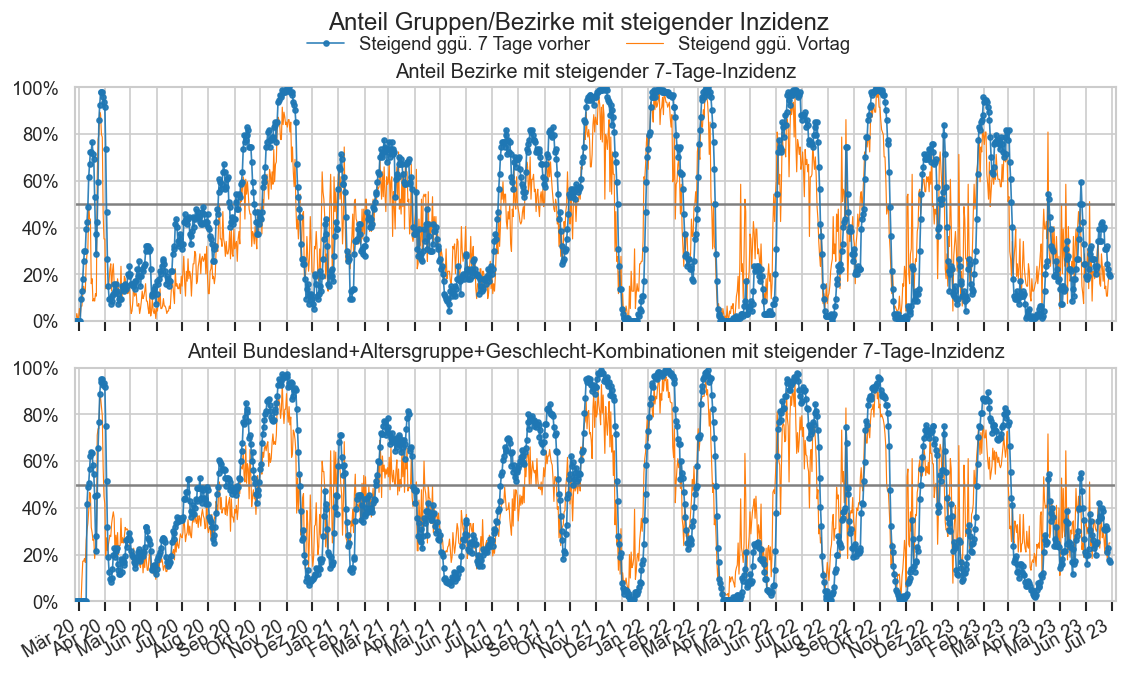
cov.filterlatest(bez0).query("inz_g7 > 1")["inz_g7"].count()
18
cov=reload(cov)
def plt_per_bl_g7(fs=fs, stamp=AGES_STAMP, catcol="Bundesland"):
fig, axs = plt.subplots(nrows=5, ncols=2, sharex=True, sharey=True, figsize=(9, 9))
fig.suptitle("Inzidenzveränderung gegenüber 7 Tage vorher" + stamp)
for ax, bl in zip(axs.flat, fs[catcol].unique()):
fsbl = fs[fs[catcol] == bl]
ax.plot(fsbl["Datum"], fsbl["inz_dg7"], color="grey", label="Einzel-Tageswert", marker=".", lw=1)
fsbl = fsbl[fsbl["Datum"] > fsbl["Datum"].iloc[-1] - timedelta(40)]
plot_colorful_gcol(ax, fsbl["Datum"], fsbl["inz_g7"], "Wochensumme", detailed=True)
if ax is axs[0][0]:
fig.legend(loc="upper center", frameon=False, ncol=3, bbox_to_anchor=(0.5, 0.96))
#ax.axhline(1, color="k")
ax.set_ylim(top=2, bottom=0.33)
ax.set_title(f"{bl}: ×{fsbl.iloc[-1]['inz_g7']:.2f} / Woche", y=0.97)
if ax in axs[-1]:
cov.set_date_opts(ax, fsbl["Datum"].iloc[1:], showday=False)
ax.set_xlim(right=ax.get_xlim()[1] + 1)
#ax.set_xlim(left=fsbl["Datum"].iloc[0])
if ax in axs.T[0]:
ax.yaxis.set_major_formatter(matplotlib.ticker.FuncFormatter(lambda v, _: f"×{v:.1f}"))
ax.set_ylabel("Inzidenzfaktor")
#ax.xaxis.set_major_locator(matplotlib.dates.MonthLocator(interval=3))
ax.yaxis.set_major_locator(matplotlib.ticker.MultipleLocator(0.5))
fig.subplots_adjust(wspace=0.05)
fig.autofmt_xdate()
#fig.autofmt_xdate()
if DISPLAY_SHORTRANGE_DIAGS:
plt_per_bl_g7()
#plt_per_bl_g7(ages1m, " - AGES nach Meldedatum" + AGES_STAMP)
#plt_per_bl_g7(ages1mx0, " - AGES/Meldedatum ohne Nachmeldungen >14 Tage")
if DISPLAY_SHORTRANGE_DIAGS:
plt_per_bl_g7(agd1m_sums.query("Bundesland == 'Österreich' and Altersgruppe != 'Alle'"), ", Altersgruppen, nach Meldedatum" + AGES_STAMP, catcol="Altersgruppe")
plt_per_bl_g7(agd_sums.query("Bundesland == 'Österreich' and Altersgruppe != 'Alle'"), ", Altersgruppen, nach Labordatum" + AGES_STAMP, catcol="Altersgruppe")
plt_per_bl_g7(agd1m_sums.query("Bundesland == 'Wien' and Altersgruppe != 'Alle'"), ", Wien, Altersgruppen, nach Meldedatum" + AGES_STAMP, catcol="Altersgruppe")
plt_per_bl_g7(agd_sums.query("Altersgruppe == '>84'"), ", Altersgruppe 85+, nach Labordatum" + AGES_STAMP)
if False:
for bl in fs["Bundesland"].unique():
plt_growfig(fs.query(f"Bundesland == '{bl}'"), bl + "/Labordatum" + AGES_STAMP, showlast=True)
cov=reload(cov)
def plot_g7s(
agd_sums: pd.DataFrame, figsize: (int, int), aspect, cbar_pad: float, figdpi: int=None,
fontsize: int=5,
labelright=True,
cbary=0.91,
projection=lambda bldata: bldata.pivot(index="Altersgruppe", columns="Datum", values="inz_g7"),
sortkey=lambda s: s.map(ag_to_id)):
fig, axs = plt.subplots(nrows=agd_sums["Bundesland"].nunique(), figsize=figsize, dpi=figdpi, sharex=True)
if isinstance(axs, plt.Axes):
axs = [axs]
fig.suptitle("Inzidenzveränderung (Faktor) ggü. 7 Tage vorher" + AGES_STAMP, fontsize=fontsize + 3, y=1.01)
fig.subplots_adjust(hspace=0.0, top=0.975)
cmap = sns.color_palette(cov.div_l_cmap, as_cmap=True).copy() #cov.div_cmap
norm = matplotlib.colors.TwoSlopeNorm(vmin=0.5, vcenter=1, vmax=2)
norm.clip = False
for ax, bundesland in zip(axs, (c for c in cov.Bundesland.categories if c in agd_sums["Bundesland"].to_numpy())):
#ax.set_title(bundesland, size=6, pad=0)
ax.set_ylabel(cov.SHORTNAME2_BY_BUNDESLAND[bundesland])
ax.set_facecolor("grey")
bldata = agd_sums[agd_sums["Bundesland"] == bundesland]
_, cbar = plt_tl_heat(projection(bldata)
.replace(np.inf, 1000)
.sort_index(axis="rows", key=sortkey, ascending=False),
ax=ax,
im_args=dict(
norm=norm,
cmap=cmap,
aspect=aspect),
cbar_args=dict(
#ticks=[0.5, 0.8, 1, 1.5, 2, 3],
#ticks=[-0.5, 0, 1, 2],
shrink=0.7,
format=matplotlib.ticker.FormatStrFormatter("%.1f"),
pad=cbar_pad,
aspect=4))
#print(vars(cbar))
#ax.axhline(0.4, color="lightgrey", linewidth=1, snap=True)
cbar.outline.set_visible(False)
#ax.xaxis.set_major_formatter(matplotlib.dates.DateFormatter('%b %y'))
cbar.ax.tick_params(labelsize=fontsize, right=False, pad=-5)
cbar.ax.set_ylabel(cov.SHORTNAME2_BY_BUNDESLAND[bundesland])
cbar.ax.set_title("Faktor", size=fontsize, y=cbary)
ax.tick_params(labelright=labelright, length=3, pad=0.1)
ax.tick_params(pad=-1, which="minor")
ax.tick_params(labelsize=fontsize, which="both", axis="both")
ax.grid(color="lightgrey", axis="x")
ax.tick_params(pad=3, which="major", axis="x")
#ax.tick_params(bottom=False)
if ax is not axs[-1]:
ax.tick_params(axis="x", labelbottom=False, bottom=False)
if ax is axs[0]:
ax.tick_params(axis="x", labeltop=True, top=True)
cov.stampit(fig)
return fig, ax
if False:
plot_g7s(agd_sums.query("Altersgruppe != 'Alle'"), (17, 12), aspect=6, cbar_pad=0.02 ,figdpi=200, fontsize=6)
plot_g7s(agd_sums[agd_sums["Datum"] >= agd_sums.iloc[-1]["Datum"] - timedelta(MIDRANGE_NDAYS)].query("Altersgruppe != 'Alle'"),
(6, 3.5*2), aspect='auto', cbar_pad=0.05, figdpi=160, fontsize=4.5)
if True:
selbl = "Österreich"
fig, ax = plot_g7s(
agd_sums#[agd_sums["Datum"] >= agd_sums.iloc[-1]["Datum"] - timedelta(MIDRANGE_NDAYS * 3)]
.query(f"Bundesland == '{selbl}'"),
(10, 2), aspect='auto', cbar_pad=0.05, fontsize=4.5, cbary=1, figdpi=200)
#ax.tick_params(labelsize=4)
ax.tick_params(axis="x", rotation=30)
fig.suptitle(f"{selbl}: Inzidenveränderung ggü. 7 Tage zuvor" + AGES_STAMP, y=1.15, fontsize=10);
if False:
def proj_kpi(bldata: pd.DataFrame) -> pd.DataFrame:
bldata = bldata.copy()
bldata.loc[bldata.index[-7:], "dead_g7"] = np.nan
return bldata.set_index("Datum")[["icu_g7", "nhosp_g7", "inz_g7", "dead_g7"]].rename(columns={
"icu_g7": "ICU", "nhosp_g7": "KH", "inz_g7": "Inz.", "dead_g7": "Tote"
}).T
fsh = fs.copy()
cov.enrich_inz(fsh, "nhosp", "BundeslandID")
cov.enrich_inz(fsh, "icu", "BundeslandID")
cov.enrich_inz(fsh, "dead", "BundeslandID")
fig = plot_g7s(fsh[fsh["Datum"] >= fsh.iloc[-1]["Datum"] - timedelta(90)],
(6, 5), aspect='auto', cbar_pad=0.05, fontsize=4.5,
projection=proj_kpi, cbary=0.8,
sortkey=lambda s: s.map({"Inz.": 2, "KH": 1, "ICU": 0, "Tote": -1}))[0]
fig.suptitle("Veränderung ggü. 7 Tage zuvor" + AGES_STAMP, y=1.02, fontsize=7);
def plot_cum_inz(
agd_sums: pd.DataFrame, figsize: (int, int), aspect, cbar_pad: float, figdpi: int=None,
fontsize: int=5,
labelright=True,
cbary=0.91,
projection=lambda bldata: bldata.pivot(index="Altersgruppe", columns="Datum", values="AnzahlFaelleSumProEW"),
sortkey=lambda s: s.map(ag_to_id)):
fig, axs = plt.subplots(nrows=agd_sums["Bundesland"].nunique(), figsize=figsize, dpi=figdpi, sharex=True)
if isinstance(axs, plt.Axes):
axs = [axs]
fig.suptitle("Kumulative Inzidenz nach Bundeland und Altersgruppe" + AGES_STAMP, fontsize=fontsize + 3, y=1.01)
fig.subplots_adjust(hspace=0.0, top=0.975)
cmap = cov.un_cmap #sns.color_palette("BuPu", as_cmap=True).copy()
norm = matplotlib.colors.Normalize(
vmin=0,
vmax=max(projection(agd_sums[agd_sums["Bundesland"] == bl]).max().max()
for bl in agd_sums["Bundesland"].unique()))
#norm = matplotlib.colors.TwoSlopeNorm(vmin=0.5, vcenter=1, vmax=2.5)
#norm.clip = False
for ax, bundesland in zip(axs, (c for c in cov.Bundesland.categories if c in agd_sums["Bundesland"].to_numpy())):
#ax.set_title(bundesland, size=6, pad=0)
ax.set_ylabel(cov.SHORTNAME2_BY_BUNDESLAND[bundesland])
ax.set_facecolor("grey")
bldata = agd_sums[agd_sums["Bundesland"] == bundesland]
_, cbar = plt_tl_heat(projection(bldata)
.replace(np.inf, 1000)
.sort_index(axis="rows", key=sortkey, ascending=False),
ax=ax,
im_args=dict(
norm=norm,
cmap=cmap,
aspect=aspect),
cbar_args=dict(
#ticks=[0.5, 0.8, 1, 1.5, 2, 3],
#ticks=[0.5, 1, 1.5, 2, 2.5],
shrink=0.7,
format=matplotlib.ticker.PercentFormatter(xmax=1),#matplotlib.ticker.FormatStrFormatter("%.1f"),
ticks=matplotlib.ticker.MaxNLocator(8),
pad=cbar_pad,
aspect=4))
#print(vars(cbar))
#ax.axhline(0.4, color="lightgrey", linewidth=1, snap=True)
cbar.outline.set_visible(False)
ax.xaxis.set_major_formatter(matplotlib.dates.DateFormatter('%b %y'))
cbar.ax.tick_params(labelsize=fontsize, length=3, pad=0.1, right=False, size=0)
cbar.ax.set_ylabel(cov.SHORTNAME2_BY_BUNDESLAND[bundesland])
cbar.ax.set_title("Infizierte", size=fontsize, y=cbary)
ax.tick_params(labelright=labelright, length=3)
ax.tick_params(labelsize=fontsize, which="both")
ax.grid(color="lightgrey", axis="x")
#ax.tick_params(bottom=False)
if ax is not axs[-1]:
ax.tick_params(axis="x", labelbottom=False, bottom=False)
if ax is axs[0]:
ax.tick_params(axis="x", labeltop=True, top=True)
return fig, ax
if False:
plot_cum_inz(agd_sums[agd_sums["Datum"] >= "2021-08-1"].query("Altersgruppe != 'Alle'"), (17, 12),
aspect='auto', cbar_pad=0.03, fontsize=6);


Änderung Inzidenz vs. Krankenhausbelegung & Tote¶
Im Folgenden wird dargestellt wie Veränderungen der Inzidenz um einen bestimmten Faktor zwei Wochen später eine Veränderung der Krankenhausauslastung & Todeszahlen um einen tendenziell ähnlichen Faktor verursachen.
Die Inzidenzen stammen von den AGES-Daten, alle anderen Kennzahlen aus der Morgenmeldung.
import matplotlib.patheffects
_posratecol = "PCRRPosRate_a7"
cov=reload(cov)
def plot_changes(mms, ax: plt.Axes):
mms, mms_orig = mms.copy(), mms
cov.enrich_inz(mms, "FZHospAlle", "Bundesland", "FZHospAlle")
cov.enrich_inz(mms, "FZICU", "Bundesland", "FZICU")
cov.enrich_inz(mms, _posratecol, "Bundesland", "PCRRPosRate")
mms["FZHospAlle_lag_g7"] = mms["FZHospAlle_g7"].shift(-7)
mms["AnzahlTot"] = mms["AnzahlTot"]
mms["FZICU_a7"] = mms["FZICU"].rolling(7).mean()
cov.enrich_inz(mms, "FZICU_a7", "Bundesland", "FZICU")
mms["FZICU_lag_g7"] = mms["FZICU_a7_g7"].shift(-7)
mms["dead"] = mms["AnzahlTot"].rolling(14).sum()
mms["dead_g7"] = mms["dead"] / mms["dead"].shift(7)
mms["dead_g7_lag"] = mms["dead_g7"].shift(-14)
mms.reset_index(inplace=True, drop=True)
NEED_CUTOFF = False
if mms.iloc[-1]["Datum"].weekday() in (5, 6) and NEED_CUTOFF:
cutoff = 2 if mms.iloc[-1]["Datum"].weekday() == 6 else 1
print("wd", mms.iloc[-1]["Datum"].weekday(), cutoff, mms.index[-cutoff:])
mms.loc[mms["FZHospAlle_lag_g7"].last_valid_index() - cutoff + 1:, "FZHospAlle_lag_g7"] = np.nan
#mms.loc[:, "FZICU_lag_g7"] = mms["FZICU_lag_g7"].iloc[:-cutoff]
ndays = MIDRANGE_NDAYS * 1
inzcols = ["inz_g7"]
inzcolors = ["C0"]
inzlabels = ["7-T-Inzidenz n. Meldedat. ohne Nachm. >14 T", "_", "_"]
pltdata = mms.iloc[-ndays:].set_index("Datum")
#display(
# pltdata["dead_g7_lag"].last_valid_index(),
# pltdata["dead_g7_lag"][pltdata["dead_g7_lag"].last_valid_index()],
# pltdata["Bundesland"][pltdata["dead_g7_lag"].last_valid_index()]
#)
#display(pltdata["dead"].iloc[-15:])
pltdata.plot(
ax=ax,
y=inzcols,
#marker=".",
#cmap="crest"
color=inzcolors
)
ax.plot(pltdata["inz_g7"].where(pltdata["inz_dg7"] >= 1), lw=0, marker=6, color=inzcolors[0])
ax.plot(pltdata["inz_g7"].where(pltdata["inz_dg7"] <= 1), lw=0, marker=7, color=inzcolors[0])
print("posrate:", pltdata[f"inz_g7"].iloc[-1], pltdata.index[-1])
ax.plot(
pltdata[f"{_posratecol}_g7"], color=sns.set_hls_values("C0", l=0.5), ls="--",
path_effects=[
matplotlib.patheffects.Stroke(linewidth=2.5, foreground='white'),
matplotlib.patheffects.Normal()],
label="PCR-Positivrate",
lw=1.5)
conscols = ["dead_g7_lag", "FZHospAlle_lag_g7"]
conscolors = ["k", "C1"]
conslabels = ["14-T Tote nach Meldedatum (‒14 Tage)", "Krankenhausbelegung (‒7 Tage)"]
pltdata.plot(
y="dead_g7_lag",
marker=".",
color="k",
#markersize=8
ax=ax)
pltdata.plot(
y="FZHospAlle_lag_g7",
marker=".",
color="C1",
ax=ax)
pltdata.plot(
y="FZICU_lag_g7",
color="C1",
ls="--",
lw=1,
ax=ax)
ax.set_ylim(top=2, bottom=0.5)
ax.axhline(y=1, color="lightgrey", zorder=0.6)
ax.legend(inzlabels + ["7-T-PCR-Positivrate (BL-Personengewichtet)"] + conslabels + ["7-T ICU (‒7 T)"],
prop=dict(size=10),
loc="best")
ax.set_ylabel("Relative Änderung ggü. 7 Tage voher")
cov.set_pctdiff_formatter(ax)
ax.xaxis.set_tick_params(rotation=0)
ax.axhspan(1, 1000, color="r", alpha=0.15, in_layout=False)
ax.axhspan(1, 0, color="b", alpha=0.15, in_layout=False)
ax.set_xlabel(None)
cov.set_date_opts(ax, mms.iloc[-ndays + 1:]["Datum"], showyear=False)
ax.set_xlim(right=ax.get_xlim()[1] + 1)
return ax
def plotchanges_all(mms, bl="Österreich"):
fig, ax = plt.subplots()
mms = mms[mms["Bundesland"] == bl].sort_values(by="Datum").copy()
if "FZHospAlle" not in mms.columns:
mms["FZHospAlle"] = mms["FZHosp"] + mms["FZICU"]
cov.enrich_inz(mms, "FZHospAlle", dailycol="FZHospAlle")
plot_changes(mms, ax)
fig.suptitle(f"SARS-CoV-2: {mms.iloc[-1]['Bundesland']}: Änderungsraten bis "
+ mms.iloc[-1]["Datum"].strftime("%a %x"), y=0.93)
cov.stampit(fig)
def bevwpcr(mmx, col="PCRRPosRate_a7"):
return mmx[~mmx["Bundesland"].isin(["Österreich","Vorarlberg"])].groupby("Datum").apply(
lambda s: np.average(s[col], weights=s["AnzEinwohner"]))
mmx0 = mmx.copy().set_index("Datum").sort_index()
mmx0[_posratecol] = bevwpcr(mmx, _posratecol)
#rint(mmx0.iloc[-1])
plt.plot(mmx0[_posratecol], label="7-T-PCR-Positivrate, BL-Personengewichtet")
plt.plot(mmx.query("Bundesland == 'Österreich'").set_index("Datum")[_posratecol], label="7-T-Positivrate roh (d.h. Wien-lastig)")
plt.legend()
cov.set_logscale(plt.gca())
plt.gcf().suptitle("Österreich: PCR-Positivrate (Apotheke+Ländermeldung)", y=0.93)
cov.set_date_opts(plt.gca())
cov.set_percent_opts(plt.gca(), decimals=1)
plt.gca().set_ylim(top=0.35)
plt.gcf().autofmt_xdate()
if DISPLAY_SHORTRANGE_DIAGS:
plotchanges_all(mmx0.reset_index(), "Österreich")
#plotchanges_all(None, fs_at, "Österreich")
plotchanges_all(mmx, "Wien")
#plotchanges_all(mmx, "Oberösterreich")
#plotchanges_all(mmx, "Niederösterreich")
#plotchanges_all(mmx, "Steiermark")
#plotchanges_all(mmx, "Tirol")
print(
"Die Änderungsraten der #COVID19at-Kennzahlen zeigen den Trend.\n\n"
"Je weiter entfernt von ±0%, desto dynamischer entwickelt sich die Kennzahl. "
"Ein Sinken der Kurve bedeutet nicht ein Sinken der Kennzahl. "
"Die Kennzahl sinkt erst wenn die Kurve den blauen Bereich unter ±0% erreicht.")
Die Änderungsraten der #COVID19at-Kennzahlen zeigen den Trend. Je weiter entfernt von ±0%, desto dynamischer entwickelt sich die Kennzahl. Ein Sinken der Kurve bedeutet nicht ein Sinken der Kennzahl. Die Kennzahl sinkt erst wenn die Kurve den blauen Bereich unter ±0% erreicht.
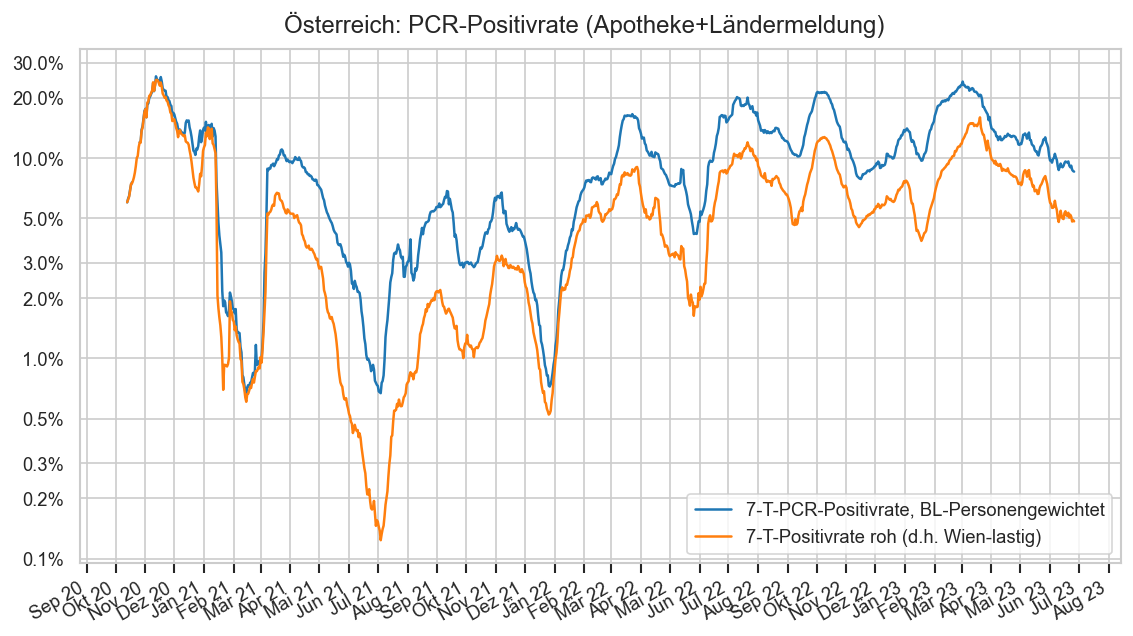
cov=reload(cov)
def print_grow_stats(selbl):
data = mmx.query(f"Bundesland == '{selbl}'").copy().set_index("Datum")
data["dead14"] = data["AnzahlTot"].rolling(14).sum()
data["Faelle7"] = data["AnzahlFaelle"].rolling(7).mean()
#data["dead14a"] = ages1m.query(f"Bundesland == '{selbl}'").set_index("Datum")["AnzahlTot"].rolling(14).sum()
data.reset_index(inplace=True)
cov.enrich_inz(data, "dead14", "Bundesland", "AnzahlTot")
#cov.enrich_inz(data, "dead14a", "Bundesland", "AnzahlTot")
#data["FZHospAlle"].ffill(inplace=True)
cov.enrich_inz(data, "FZHospAlle", "Bundesland")
data["FZHospAlle"].ffill(inplace=True)
data["FZHospAlle_g7"].ffill(inplace=True)
cov.enrich_inz(data, "FZICU_a3", "Bundesland")
data = data.set_index("Datum")
mday = data.index[-1].strftime("%A")
data = data.loc[data.index[-1].dayofweek == data.index.dayofweek].tail(3)
data.sort_index(ascending=False, inplace=True)
allmark = "AGES/Meldedatum"
nohosp = haveages and not havehosp or data.index[-1].dayofweek in (5, 6)
#print(mms.iloc[-1]["Datum"].weekday(), havehosp, nohosp)
if allmark:
mmsmark = agesmark = hmark = ""
dmark = ""
else:
agesmark = dmark = "¹"
mmsmark = hmark = "²"
if selbl == "Niederösterreich":
dmark = mmsmark
hmark += " (Stand Fr.)" if nohosp else ""
head = "#COVID19at Kennzahlen"
head += (" " + selbl) if selbl != 'Österreich' else ''
head += (" " + allmark) if allmark else ""
print(head + "\n")
isfirst = True
for _, rec in data.iterrows():
nf = np.round(rec['Faelle7'])
nfstr = format(nf, ',.0f' if nf >= 10_000 else '.0f').replace(',', '.')
dtstr = rec.name.strftime(("%A " if isfirst else "") + "%d.%m") + "."
dtstr = re.sub(r"\b0+", "", dtstr)
print(
dtstr,
f"🖤{rec['dead14']:.0f}{' Tote'+ dmark + ' in 14 Tagen,' if isfirst else ''}"
f" {pctc(rec['dead14_g7'], emoji=isfirst)}{' in 7 T' if isfirst else ''}",
#f"🖤{rec['dead14a']:.0f}{' Tote² in 14 Tagen,' if isfirst else ''} {pctc(rec['dead14a_g7'])}{' in 7 T' if isfirst else ''}",
f"🏥{rec['FZHospAlle']:.0f}{' im KH' + hmark + ',' if isfirst else ''}"
f" {pctc(rec['FZHospAlle_g7'], emoji=isfirst)}",
f"🤒{nfstr}{' Fälle' + agesmark + ' 7-T-Schnitt,' if isfirst else ''}"
f" {pctc(rec['inz_g7'], emoji=isfirst)}",
sep="\n" if isfirst else "\N{EM QUAD}") #")
if isfirst:
print()
isfirst = False
if not allmark:
print(f"\n{agesmark}AGES/Meldedatum\N{EM QUAD}{mmsmark}9:30-Meldung")
print_grow_stats("Österreich")
print()
print()
print_grow_stats("Oberösterreich")
print()
print()
print_grow_stats("Steiermark")
print()
print()
print_grow_stats("Wien")
#COVID19at Kennzahlen AGES/Meldedatum Freitag 30.6. 🖤14 Tote in 14 Tagen, ±0% in 7 T 🏥43 im KH, ‒19% ↘ 🤒91 Fälle 7-T-Schnitt, ‒29% ↘ 23.6. 🖤14 +40% 🏥53 ‒29% 🤒128 ‒13% 16.6. 🖤10 ‒38% 🏥75 ‒37% 🤒146 ‒6,8% #COVID19at Kennzahlen Oberösterreich AGES/Meldedatum Freitag 30.6. 🖤0 Tote in 14 Tagen, ±0% in 7 T 🏥7 im KH, ±0% 🤒7 Fälle 7-T-Schnitt, ‒48% ⏬ 23.6. 🖤0 ±0% 🏥7 ±0% 🤒13 +5,7% 16.6. 🖤0 ±0% 🏥7 ‒36% 🤒13 ‒16% #COVID19at Kennzahlen Steiermark AGES/Meldedatum Freitag 30.6. 🖤0 Tote in 14 Tagen, ‒100% ⏬ in 7 T 🏥4 im KH, ‒50% ⏬ 🤒5 Fälle 7-T-Schnitt, ‒57% ⏬ 23.6. 🖤2 ±0% 🏥8 ‒27% 🤒11 ‒1,3% 16.6. 🖤2 +100% 🏥11 ‒48% 🤒11 ‒17% #COVID19at Kennzahlen Wien AGES/Meldedatum Freitag 30.6. 🖤0 Tote in 14 Tagen, ‒100% ⏬ in 7 T 🏥18 im KH, ‒25% ↘ 🤒48 Fälle 7-T-Schnitt, ‒22% ↘ 23.6. 🖤2 ‒50% 🏥24 ‒11% 🤒62 ‒11% 16.6. 🖤4 ‒20% 🏥27 ‒25% 🤒69 ‒2%
def indic_hm():
mmx0 = mmx[mmx["Datum"] >= mmx["Datum"] - timedelta(28)].copy()
with cov.calc_shifted(mmx0, "Bundesland", 14, newcols=["dead14"]) as shifted:
mmx0["dead14"] = mmx0["AnzahlTotSum"] - shifted["AnzahlTotSum"]
with cov.calc_shifted(mmx0, "Bundesland", 7, newcols=["FZICU_a7"]):
mmx0["FZICU_a7"] = mmx0["FZICU"].rolling(7).mean()
cov.enrich_inz(mmx0, "FZHospAlle", "Bundesland", dailycol="FZHospAlle")
cov.enrich_inz(mmx0, "dead14", "Bundesland", dailycol="AnzahlTot")
cov.enrich_inz(mmx0, _posratecol, "Bundesland", dailycol=_posratecol)
cov.enrich_inz(mmx0, "FZICU_a7", "Bundesland", dailycol="FZICU")
agd65 = agd_sums[agd_sums["Altersgruppe"].isin(["65-74", "75-84", ">84"])].groupby(["Bundesland", "Datum"])[
["AnzahlFaelle", "AnzEinwohner", "AnzahlTot", "AnzahlFaelle7Tage"]].sum()
#display(agd65)
#s7 = agd65["AnzahlFaelle"].groupby(level="Bundesland").rolling(7).sum().reset_index(0, drop=True)
#display(s7)
#agd65["AnzahlFaelle7Tage"] = s7
agd65["AnzahlFaelle7Tage_g7"] = agd65["AnzahlFaelle7Tage"].groupby("Bundesland").transform(
lambda s: s / s.shift(7))
#agd_sums
atpcr = bevwpcr(mmx0, _posratecol)
atpcr_g7 = atpcr / atpcr.shift(7)
data = cov.filterlatest(mmx0).set_index("Bundesland")[
["inz_g7", "FZHospAlle_g7", "dead14_g7", _posratecol + "_g7", "FZICU_a7_g7"]]
data["ag65inz_g7"] = cov.filterlatest(agd65.reset_index("Datum"))["AnzahlFaelle7Tage_g7"]
data.loc["Österreich", _posratecol + "_g7"] = atpcr_g7.iloc[-1]
cols = {
"inz_g7": "Inzidenz 7-T",
"ag65inz_g7": "Inzidenz 65+ 7-T",
_posratecol + "_g7": "PCR+-Rate 7-T",
"FZHospAlle_g7": "Hospitalisierung",
"FZICU_a7_g7": "ICU 7-T",
"dead14_g7": "Tote 14-T"}
data = data[list(cols.keys())].rename(columns=cols)
data.index = data.index.astype(cov.Bundesland)
data.sort_index(inplace=True)
display(data)
annot = data.transform(lambda s: s.map(lambda s0: pctc(s0, percent=False)))
data = np.log(data.replace(np.nan, 0).replace(-np.inf, 0).replace(np.inf, 10).replace(0, 0.5))
data = data
norm = matplotlib.colors.TwoSlopeNorm(np.log(1), vmin=np.log(0.5), vmax=np.log(2))
ax = sns.heatmap(data, annot=annot, norm=norm, cmap=cov.div_l_cmap, fmt="s", cbar=False)
set_hm_ax_opts(ax)
ax.figure.suptitle("Indikatortrends: prozentuelle Veränderung zur Vorwoche" + AGES_STAMP, y=0.95)
if DISPLAY_SHORTRANGE_DIAGS:
indic_hm()
Hospitalisierung¶
Hier wird berechnet wann die nächste Gefahrenstufe/Maßnahmenstufe erreicht wird, würde sich das (angenommene) exponentielle Wachstum der belegten Intensivbetten seit 1/7/14 Tagen (jeweils über einen 3-Tage-Durchsnitt gerechnet) genau so fortsetzt. Das ist normalerweise nicht der Fall, einen Hinweis auf die in den nächsten zwei Wochen zu erwartende Geschwindigkeit der Belegungsveränderung gibt das Diagramm zu Inzidenz und Intensivstation.
Eine Darstellung mit Fokus auf der aktuellen Belegung mit schöner Einzeichnung der Gefahrengrenzen gibt es beim ORF bei den "Morgenmeldungen", wobei die Grenzen beim ORF leicht anders (niedriger) sind. Die Kapazitäten hier sind lt. AGES-Zahlen und inkludieren somit Zusatzbetten die notfallsmäßig innerhalb 7 Tage bereitgestellt werden könnten. Die Darstellung hier ist also konsistent mit https://covid19-dashboard.ages.at/dashboard_Hosp.html.
Was bedeuten nun diese Grenzen? Sind 10% nicht z.B. ziemlich wenig? Nein! Dies ist nur die Belegung durch COVID-Patienten zusätzlich zur normalen Belegung. Schon bei 10% Zusatzbelegung müssen bestimmte Operationen verschoben werden. Das trifft zuerst "elektive" OPs. Das klingt harmlos, aber "elektiv" heißt nur dass die OP nicht medizinisch dringend ist. Das kann z.B. Hüft-OPs betreffen, wo zwar eine auf später verschobene OP die Heilungschancen nicht (wesentlich) verschlechtert, aber wo die Lebensqualität der Betroffenen ohne OP doch inzwischen wesentlich verschlechtert wird.
Mehr dazu ist in https://www.oegari.at/web_files/cms_daten/pa_covid_intensivbelastung_120421-whkmfrei_1.pdf nachzulesen, unter der bezeichnenden Überschrift "Die 10:30:50-Regel: Schleichend zum Systemkollaps" (ÖGARI ist die Österreichische Gesellschaft u.a. für Intensivmediziner).
hospdiff = hospfz.query("Bundesland == 'Österreich'").set_index("Datum")["FZHospAlle"].diff(7)
fig, ax = plt.subplots()
barargs = dict(lw=0, width=timedelta(1), snap=True, aa=False)
ax.bar(hospdiff.index, hospdiff.where(hospdiff > 0), color="C1", **barargs)
ax.bar(hospdiff.index, hospdiff.where(hospdiff < 0), color="C0", **barargs)
ax.axhline(hospdiff[-1], color="black", lw=1)
ax.yaxis.set_major_formatter(matplotlib.ticker.FormatStrFormatter("%+d"))
cov.set_date_opts(ax, hospdiff.index, showyear=True)
ax.set_xlim(right=ax.get_xlim()[1] + 7)
fig.autofmt_xdate()
fig.suptitle("Österreich: Änderung der Hospitalisierten COVID-PatientInnen ggü. 7 Tage zuvor", y=0.93)
def print_hospdiff(hospdiff):
df = hospdiff.rename("d_hosp").to_frame()
df["d_hosp_g7"] = hospdiff / hospdiff.shift(7)
print("Änderung hospitalisierter #Covid19at-PatientInnen" + AGES_STAMP)
for i in range(3):
record = df.iloc[-7*i - 1]
print("‒", record.name.strftime("%d.%m:"), format(record["d_hosp"], "+.0f") + ",",
pctc(record["d_hosp_g7"], emoji=True),
"in 7 Tagen" if i == 0 else "")
print_hospdiff(hospdiff)
Änderung hospitalisierter #Covid19at-PatientInnen (AGES Fr. 30.06.23) ‒ 30.06: -10, ‒55% ⏬ in 7 Tagen ‒ 23.06: -22, ‒50% ⏬ ‒ 16.06: -44, ‒6,4% ↘
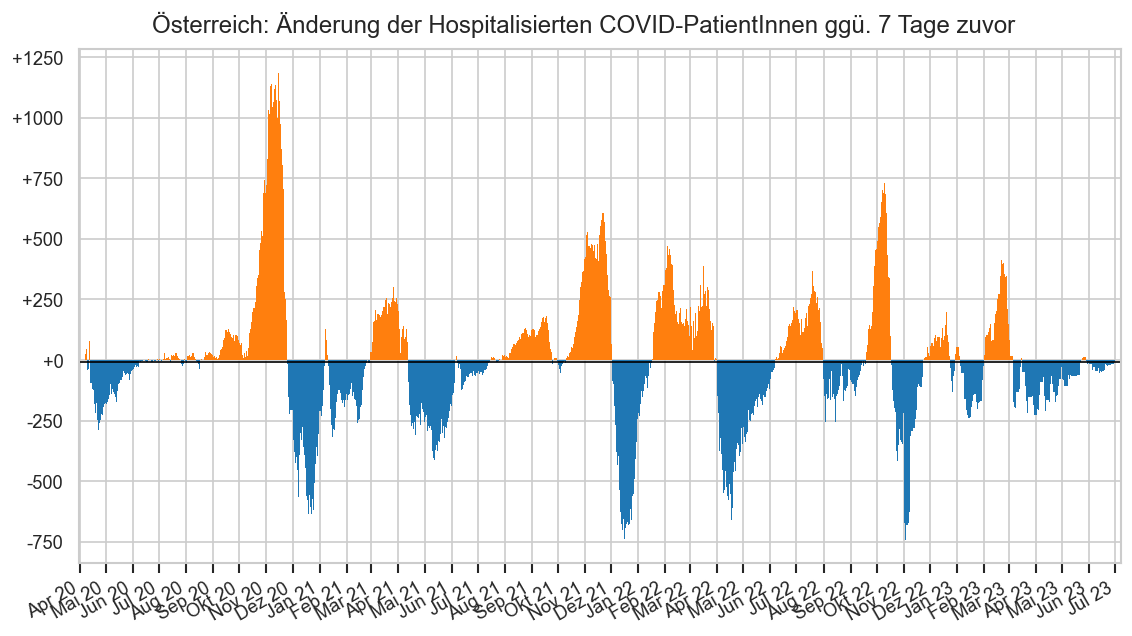
#recalc_at_hosp(hospfz_ow)
for bl in ("Wien", "Österreich"):
fig, ax = plt.subplots()
ndays = 9000
ax.plot(
hospfz.query(f"Bundesland == '{bl}' and Datum >= '2022-11-01'").set_index("Datum")["FZHosp"].iloc[-ndays:],
label="Normalstation AGES")
ax.plot(
hospfz_ow.query(f"Bundesland == '{bl}'").reset_index("BundeslandID", drop=True)["FZHosp"].iloc[-ndays:],
label="Normalstation AGES + Wiener Post Covid ab 2.11.2022")
if True:
cov.set_logscale(ax)
extralabel = " (logarithmisch)"
else:
ax.set_ylim(bottom=0)
extralabel = ""
cov.set_date_opts(ax, hospfz["Datum"].iloc[-ndays:])
ax.set_xlim(right=ax.get_xlim()[1] + 7)
ax.legend()
fig.suptitle(bl + ": COVID-19 PatientInnen auf Normalstation" + extralabel, y=0.93)
fig.autofmt_xdate()
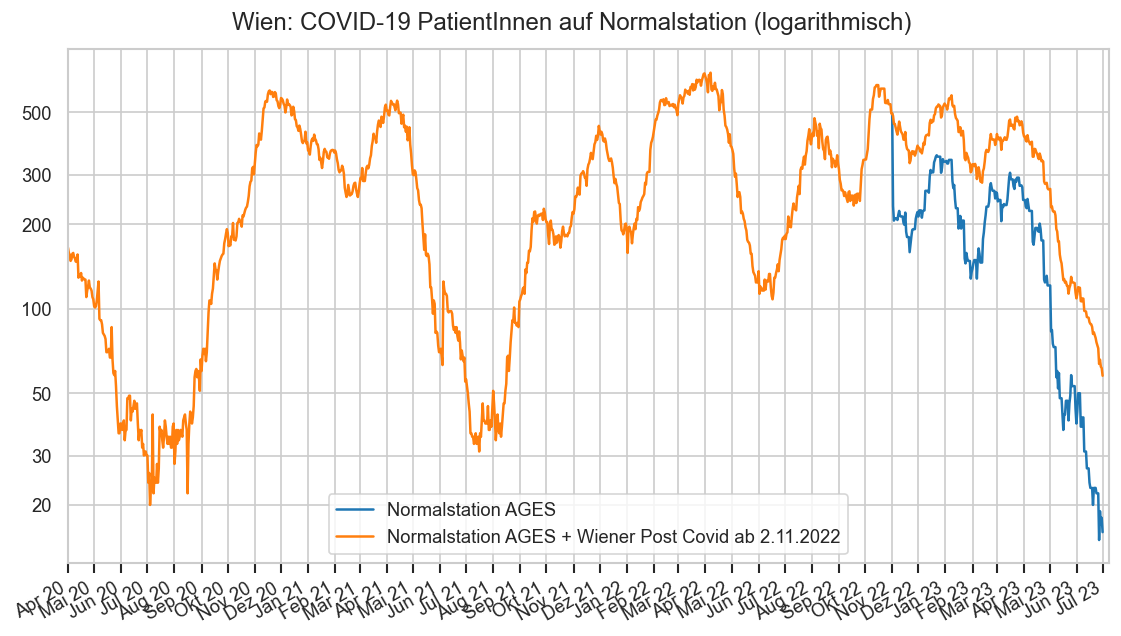
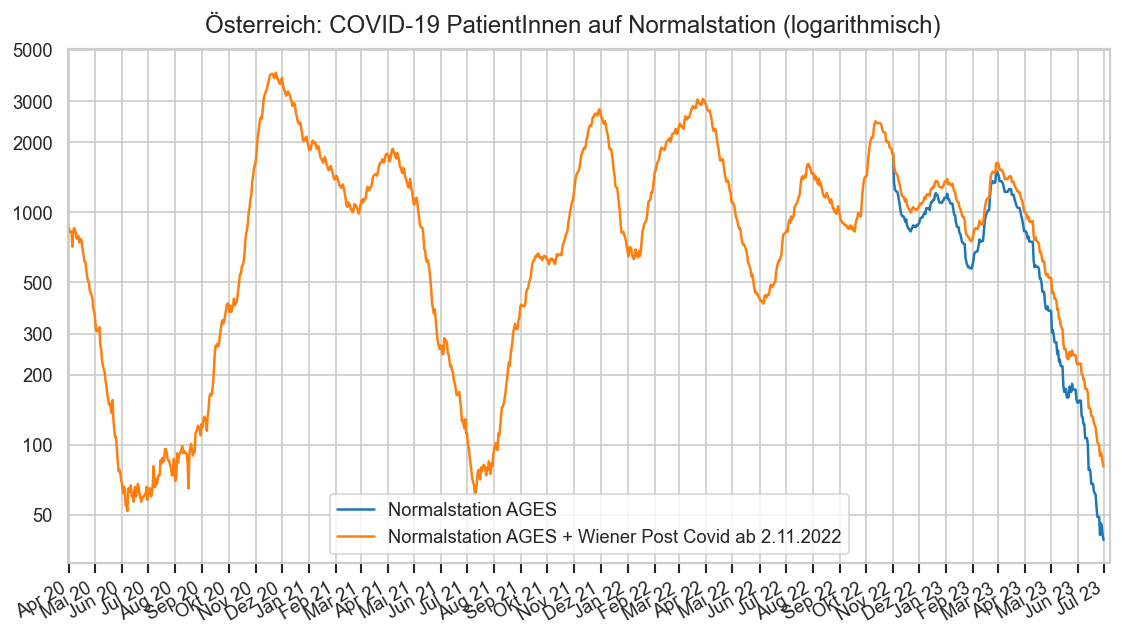
#wien_hosp = wien_hosp.query("Datum >= '2022-08-29'")
#display(wien_hosp)
#wien_hosp["FZHosp"] = wien_hosp["FZHospCov"] + wien_hosp["FZHospOutCov"] + wien_hosp["FZHospPostCov"]
def draw_wien_hosp(pfx, ttl):
fig, ax = plt.subplots()
pltr = cov.StackBarPlotter(ax, wien_hosp.index, lw=0, width=1)
ax.set_prop_cycle(color=sns.color_palette("plasma", n_colors=3))
pltr(wien_hosp[f"{pfx}Cov"], label="COVID-Station")
pltr(wien_hosp[f"{pfx}OutCov"], label="Nicht-COVID-Station")
pltr(wien_hosp[f"{pfx}PostCov"], label="Post-COVID-Station")
cov.set_date_opts(ax, showyear=True)
fig.suptitle(f"Wien: Personen wegen oder mit COVID-19 in Spitalsbehandlung in {ttl}", y=0.95)
ax.set_title("Quelle: https://presse.wien.gv.at/")
hwien = hospfz.query("Bundesland == 'Wien'")
#print(list(map(matplotlib.dates.num2date, ax.get_xlim())))
ax.set_xlim(*ax.get_xlim())
ax.set_xlim(left=ax.get_xlim()[0] - 1)
axrng = list(np.datetime64(matplotlib.dates.num2date(x).replace(tzinfo=None)) for x in ax.get_xlim())
axrng[0] -= np.timedelta64(1, 'D')
axrng[1] += np.timedelta64(1, 'D')
hwien = hwien.loc[hwien["Datum"].between(*axrng)]
ax.plot(hwien["Datum"], hwien[f"FZ{pfx}"], color="k", marker=".", label=f"{ttl} lt. AGES")
ax.legend(ncol=2, loc="upper right")
def draw_wien_hotline():
fig, ax = plt.subplots()
#ax.plot(wien_hosp["HotlineCalls"], marker="o", label="Täglich")
#ax.plot(wien_hosp["HotlineCalls"].rolling(7).mean(), ls="--",
# label="7-Tage-Schnitt", color="k", marker="_")
#cov.set_date_opts(ax)
make_wowg_diag(
wien_hosp.reset_index().assign(Bundesland="Wien"), "1450-Anrufe", ax,
ccol="HotlineCalls", label="Anrufe", ndays=2000, pltdg=True, pltg7=True)
fig.legend(ncol=4, frameon=False, bbox_to_anchor=(0.5, 0.94), loc="upper center", fontsize="small")
fig.suptitle(f"Wien: Anrufe bei der Gesundheitshotline 1450", y=1)
ax.set_title("Quelle: https://presse.wien.gv.at/", y=1.07)
ax.set_ylim(bottom=0)
draw_wien_hosp("Hosp", "Normalpflege")
draw_wien_hosp("ICU", "Intensivpflege")
draw_wien_hotline()
'1450-Anrufe'
HotlineCalls NaN HotlineCalls_a7 NaN inz_g7 NaN inz_dg7 NaN Name: 232, dtype: float64
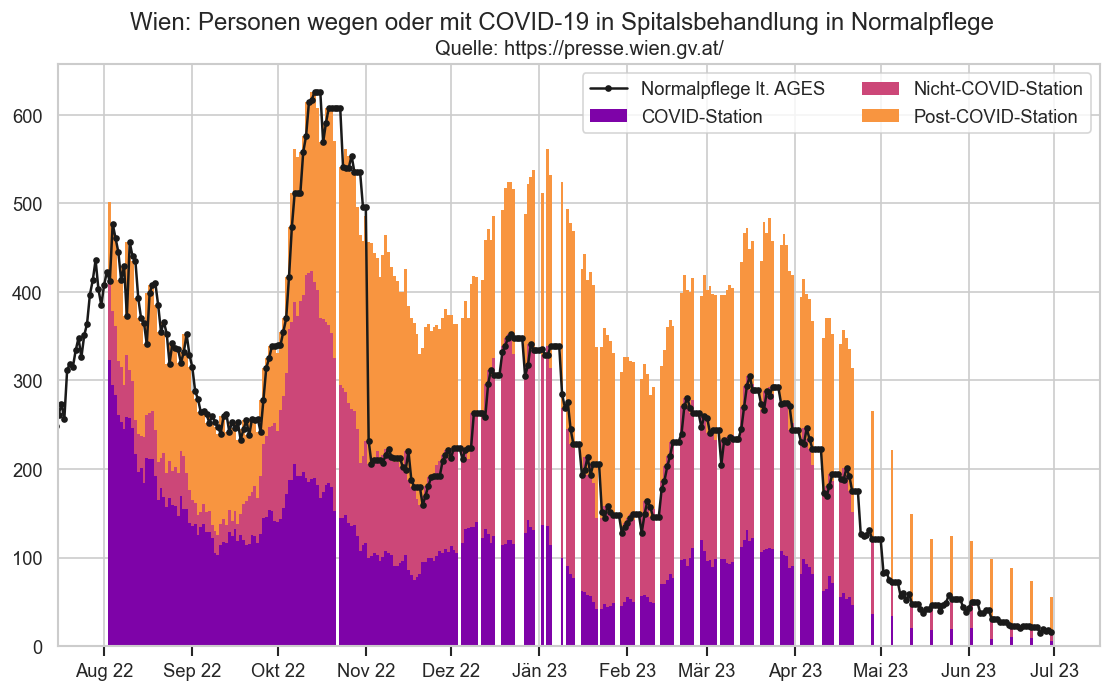
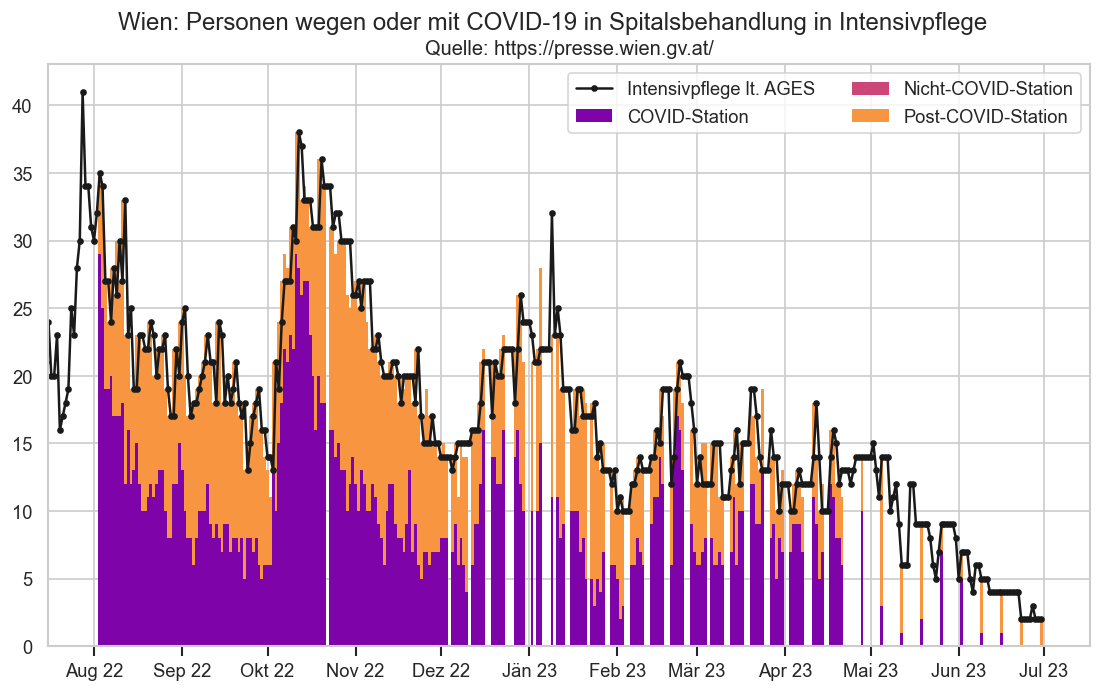
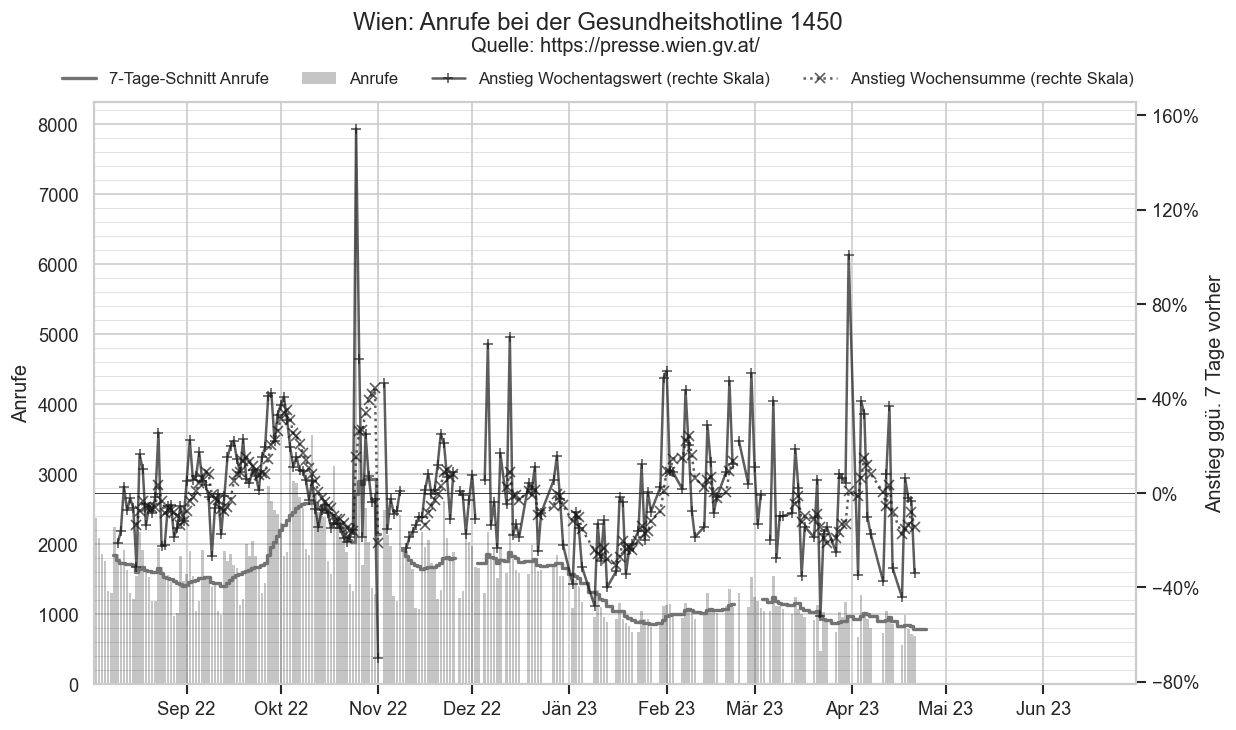
wien_hosp.iloc[-1][["HospCov", "HospOutCov", "HospPostCov"]].sum()
56.0000
hospfz.query("Bundesland == 'Wien'").tail(1)
| Datum | BundeslandID | TestGesamt | FZHosp | FZICU | FZHospFree | FZICUFree | Bundesland | AnzEinwohner | FZHospAlle | ICU_green_use | FZHospAlle_a3 | FZICU_a3 | FZICU_m3 | FZHosp_a3 | ICU_green_use_m3 | ICU_green_use_a3 | hosp | nhosp | icu | |
|---|---|---|---|---|---|---|---|---|---|---|---|---|---|---|---|---|---|---|---|---|
| 11858 | 2023-06-30 | 9 | 75761978 | 16 | 2 | 957 | 243 | Wien | 9.1359e+06 | 18 | 0.04 | 19.0 | 2.0 | 2.0 | 17.0 | 0.04 | 0.04 | 0.197 | 0.1751 | 0.0219 |
def draw_hosp_g7():
hospx = hospfz.set_index(["Bundesland", "Datum"]).sort_index()
hospxg7 = (
hospx["FZHospAlle"]
.groupby(level="Bundesland")
.transform(lambda s: s / s.shift(7))
.rename("FZHosp_g7"))
#hospxg7 = hospxg7.loc[
# hospxg7.index.get_level_values("Datum") >=
# hospxg7.index.get_level_values("Datum")[-1] - timedelta(MIDRANGE_NDAYS)]
ax = sns.lineplot(hospxg7.reset_index(), x="Datum", y="FZHosp_g7", hue="Bundesland", mew=0, #marker=".",
err_style=None)
ax = sns.lineplot(hospxg7.xs("Österreich").reset_index(), x="Datum", y="FZHosp_g7", color="C9",
mew=0, #marker="o",
lw=3,
err_style=None, legend=False)
ax.set_ylim(top=3.1)
ax.legend(*sortedlabels(ax, hospxg7.reset_index(), "FZHosp_g7", fmtval=lambda v: f"×{v:.2f}"), fontsize="small", ncol=2)
cov.set_date_opts(ax, hospxg7.index.get_level_values("Datum"))
ax.set_ylabel("Faktor ggü. Vorwoche")
fig = ax.figure
fig.suptitle("Veränderung Hospitalisierung (Faktor) ggü. gleichem Wochentag der Vorwoche" + AGES_STAMP,
y=0.93)
ax.axhline(1, color="k")
cov.labelend2(ax, hospxg7.reset_index(), "FZHosp_g7")
fig.autofmt_xdate()
draw_hosp_g7()
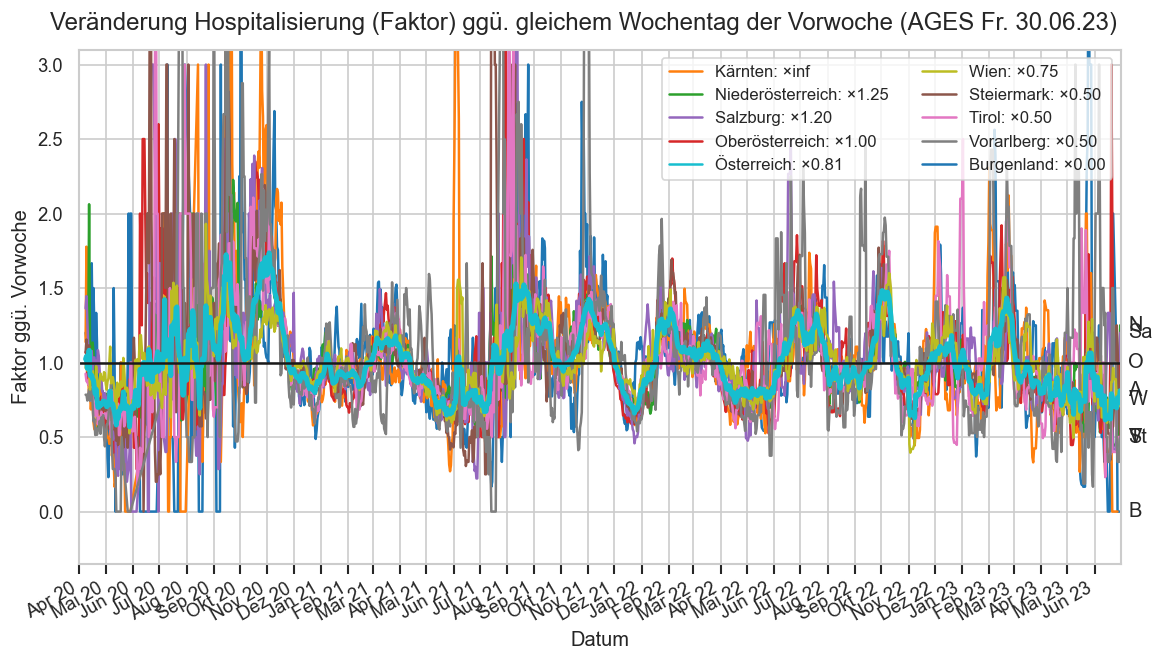
ax = sns.lineplot(
data=hosp.query("Bundesland != 'Österreich'"), x="Datum", y="IntensivBettenKapGes", hue="Bundesland",
err_style=None)
ax.get_legend().remove()
fig = ax.figure
fig.legend(*ax.get_legend_handles_labels(), fontsize=10, loc="upper center",
frameon=False, bbox_to_anchor=(0.5, 0.96), ncol=5);
ax.set_ylabel("Gesamtkapzität an Intensivbetten")
newcap = hosp.query("Bundesland == 'Oberösterreich' and Datum == '2021-09-10'")["IntensivBettenKapGes"].iloc[0]
oldcap = hosp.query("Bundesland == 'Oberösterreich' and Datum == '2021-09-09'")["IntensivBettenKapGes"].iloc[0]
mid = oldcap + (newcap - oldcap) / 2
if False:
ax.annotate(
"Anstieg insgesamt verfügbarer Intensivbetten in OÖ",
(date(2021, 9, 10), mid),
xytext=(date(2021, 5, 1), mid),
arrowprops={'arrowstyle': '->', 'color': 'k'})
#hosp.query("Bundesland == 'Oberösterreich' and Datum in ('2021-09-10', '2021-09-09', '2021-04-21', '2021-04-22')")[
# ["Datum", "Bundesland", "IntensivBettenKapGes", "IntensivBettenBelCovid19"]
#].set_index(["Bundesland", "Datum"]).tail(5)
#labelends(ax, hosp["IntensivBetten"])
ax.figure.suptitle("Gesamtkapazität der Intensivstationen" + AGES_STAMP, y=0.98);
cov.set_date_opts(ax, showyear=True)
ax.figure.autofmt_xdate()
ax.set_ylim(bottom=0)
(0.0000, 510.8500)
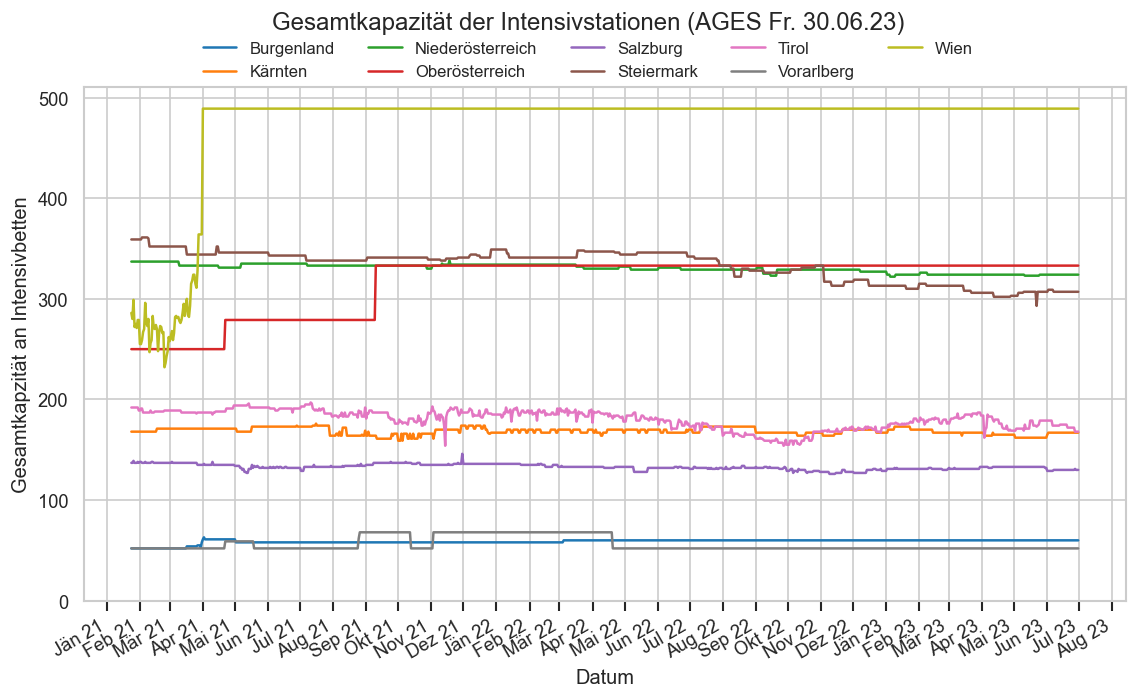
hosp2 = hosp.query("Bundesland != 'Wien'").copy()
subcols = list(set(hosp2.columns) - {"Bundesland", "Datum", "BundeslandID"})
hosp2.loc[hosp2["Bundesland"] == "Österreich", subcols] -= hosp.loc[hosp["Bundesland"] == 'Wien', subcols].to_numpy()
hosp2["IntensivBettenBelGes"] = hosp2["IntensivBettenBelCovid19"] + hosp2["IntensivBettenBelNichtCovid19"]
with cov.calc_shifted(hosp2, "Bundesland", 7):
hosp2["IntensivBettenFreiPro100_a7"] = hosp2["IntensivBettenFreiPro100"].rolling(7).mean()
hosp2["IntensivBettenBelGes_a7"] = hosp2["IntensivBettenBelGes"].rolling(7).mean()
hosp2["AnteilCov"] = hosp2["IntensivBettenBelCovid19"] / hosp2["IntensivBettenBelGes"]
hosp2["AnteilNichtCov"] = hosp2["IntensivBettenBelNichtCovid19"] / hosp2["IntensivBettenBelGes"]
if False:
sns.lineplot(data=hosp2, x="Datum", y="IntensivBettenFreiPro100_a7", hue="Bundesland", marker=".", mew=0)
#hosp2.sort_values(by=["Datum"], inplace=True)
#display(hosp2.head(30))
ax = hosp2.query("Bundesland == 'Oberösterreich'").plot.area(x="Datum", y=["AnteilNichtCov"], label=["% Nicht-COVID"], figsize=(16/2, 9/2))
ax.set_axisbelow(False)
cov.set_percent_opts(ax)
ax.set_ylim(top=1)
ax.set_yticks([0.15, 0.25], minor=True)
ax.grid(which="minor", axis="y")
ax.set_title("Anteil von Covid-Fällen an belegten Intensivbetten in OÖ")
#plt.figure()
#plt.stackplot(hosp2["Datum"], [hosp2["AnteilCov"], hosp2["AnteilNichtCov"]], linewidth=0)
#plt.legend(["% COVID", "% Nicht-COVID"])
#display(hosp2.dtypes)
df = hosp2.query("Bundesland == 'Oberösterreich'")[["Datum", "Bundesland", "IntensivBettenBelCovid19", "IntensivBettenBelNichtCovid19"]].tail(15).copy()
df["d_BelCov19"] = hosp2["IntensivBettenBelCovid19"].diff()
df["d_BelNichtCov19"] = hosp2["IntensivBettenBelNichtCovid19"].diff()
df["d_BelCov19_cumsum"] = df["d_BelCov19"].cumsum()
df["d_BelNichtCov19_cumsum"] = df["d_BelNichtCov19"].cumsum()
df.tail(15)
plt.figure()
sns.heatmap(df.set_index("Datum")[["d_BelNichtCov19", "d_BelCov19"]], center=0, annot=True, vmin=-1, vmax=+1)
plt.figure()
ax = hosp2.query("Bundesland == 'Oberösterreich'").plot(x="Datum", y=["IntensivBettenBelGes_a7", "IntensivBettenBelGes", "IntensivBettenBelCovid19", "IntensivBettenBelNichtCovid19"], marker=".")
ax.set_ylim(bottom=0)
ax.set_title("Intensivbelegung gesamt OÖ");
if False:
for bl in hosp["Bundesland"].unique():
display(hosp[hosp["Bundesland"] == bl].tail(3).set_index("Datum"))
oo_icu_levels = {
"1a": (226, 24),
"2'": (198, 52),
"2": (175, 52),
"2?": (175, 52),
"2a": (175, 75),
"3": (147, 103), # 100 / 150
"3a": (147, 127),
"4": (147, 157), # 150 / 150
"5?": (147, 175), # ??? https://www.land-oberoesterreich.gv.at/246019.htm
}
# No reports since Feb 7 2021 https://www.land-oberoesterreich.gv.at/249398.htm
# Till Mar 17 https://www.land-oberoesterreich.gv.at/251836.htm
oo_icu_levelchanged = {
date(2020, 11, 27): "5?", # https://www.land-oberoesterreich.gv.at/245274.htm
date(2020, 12, 10): "4",
date(2020, 12, 23): "3",
#hosp2.iloc[0]["Datum"].date(): "3",
date(2021, 2, 3): "2a",
date(2021, 2, 18): "2?", # No data, https://www.land-oberoesterreich.gv.at/250011.htm
date(2021, 3, 17): "2a",
date(2021, 3, 27): "3",
date(2021, 5, 20): "2a",
date(2021, 6, 2): "2",
date(2021, 10, 29): "2a",
date(2021, 11, 5): "3",
date(2021, 11, 13): "3a",
date(2021, 11, 24): "4",
date(2021, 12, 16): "3a",
date(2021, 12, 23): "3",
date(2021, 12, 30): "2a",
date(2022, 1, 14): "2",
date(2022, 1, 14): "2",
date(2022, 4, 27): "1a",
date(2022, 6, 1): "2'",
date(2022, 6, 20): "1a",
}
def load_hx():
hx = (hosp2
.set_index(["Bundesland", "Datum"])
.join(fs.set_index(["Bundesland", "Datum"])[["AnzEinwohner"]])
.join(hospfz.set_index(["Bundesland", "Datum"])[["FZHosp", "FZICU", "FZHospFree", "FZICUFree"]])
.sort_index())
latest = hx.index.get_level_values("Datum")[-1]
for bl in hx.index.get_level_values("Bundesland"):
hx.loc[(bl, latest), "AnzEinwohner"] = hx.loc[(bl,), "AnzEinwohner"].iloc[-2]
hvbg = hx.loc[("Vorarlberg",)]
#display(hvbg)
hx.loc["Vorarlberg", "FZICUFree"] = (
hvbg["FZICUFree"].to_numpy()
- hvbg["IntensivBettenBelGes"].to_numpy())
firstdate = hx.index.get_level_values("Datum")[0].date()
for dt, level in oo_icu_levelchanged.items():
if dt < firstdate:
dt = firstdate
kapncov, kapcov = oo_icu_levels[level]
dt = pd.to_datetime(dt)
hx.loc[("Oberösterreich", dt), "IntensivBettenKapNichtCovid19"] = kapncov
hx.loc[("Oberösterreich", dt), "IntensivBettenKapCovid19"] = kapcov
hx.loc[("Oberösterreich",), "IntensivBettenKapNichtCovid19"].fillna(method="ffill", inplace=True)
hx.loc[("Oberösterreich",), "IntensivBettenKapCovid19"].fillna(method="ffill", inplace=True)
#display(hvbg["FZICUFree"].to_numpy() - hvbg["IntensivBettenBelGes"].to_numpy())
#hx.loc["Vorarlberg"]
#display(hx.xs(hx.index.get_level_values("Datum")[-2], level="Datum")[["FZICUFree"]])
#display(hx.xs("Vorarlberg")["FZICUFree"].describe())
#display(hx.xs("Vorarlberg").tail(7))
#display((hx.xs("Vorarlberg")["FZICUFree"] + hvbg["IntensivBettenBelCovid19"]).describe())
for bl in hx.index.get_level_values("Bundesland").unique():
hx.loc[(bl, latest + timedelta(1)), :] = hx.loc[(bl, latest), :]
hx.loc[(bl, latest), ["FZHosp", "FZICU", "FZHospFree", "FZICUFree"]] = (
hx.loc[(bl, latest - timedelta(1)), ["FZHosp", "FZICU", "FZHospFree", "FZICUFree"]])
#print(bl, lastdate, hx.loc[(bl, lastdate + timedelta(1))])
hx.sort_index(inplace=True)
return hx
hx = load_hx()
def bltitle(bl: str) -> str:
return bl if bl != "Österreich" else "Österreich (ohne Wien)"
def plt_bl_icu_stats(ax, bl, hbl, pltfree_end=False):
ax.set_title(bltitle(bl))
#print(hbl.index)
#if bl in ("Vorarlberg", "Oberösterreich":
#hbl["IntensivBettenKapGes"].clip(upper=hbl["IntensivBettenKapGes"].quantile(0.1, interpolation="lower"), inplace=True)
ax.fill_between(hbl.index, hbl["IntensivBettenKapGes"].to_numpy(),
(hbl["IntensivBettenKapGes"] - hbl["IntensivBettenBelNichtCovid19"]).to_numpy(),
color="C0", label="Non-Cov-belegt", step="post", zorder=-2)
icufree = hbl["FZICUFree"]
stks = ax.stackplot(
hbl.index,
hbl["IntensivBettenBelCovid19"], icufree,
labels=["CoV-belegt", "CoV-verfügbar"],
colors=sns.color_palette()[1:2] + sns.color_palette()[2:3],
linewidth=0,
step="post", zorder=-2)
if pltfree_end:
ax.axvline(hbl["FZICUFree"].last_valid_index(), color="grey")
ax.plot(hbl["IntensivBettenKapGes"], color="k", label="Maximalkapazität", ds="steps-post", zorder=30)
stks[1].set_alpha(0.5)
if bl == "Oberösterreich":
ax.fill_between(
hbl.index,
(hbl["IntensivBettenKapGes"] - hbl["IntensivBettenKapNichtCovid19"]).to_numpy(),
hbl["IntensivBettenKapCovid19"].to_numpy(),
color="k", alpha=0.3,
step="post",
label="Außer Betrieb")
ax.set_ylabel("Intensivbetten")
cov.set_date_opts(ax, hbl.index, showyear=len(hbl) > 300)
ax.set_ylim(bottom=0, top=hbl["IntensivBettenKapGes"].max())
dsource = cov.DS_AGES + ", OÖ Landeskorrespondenz" + " | Nach einer Darstellung von @brosch_alex"
if DISPLAY_SHORTRANGE_DIAGS:
fig, axs = plt.subplots(nrows=3, ncols=3, figsize=(20, 14), sharex=True)
fig.subplots_adjust(wspace=0.1, hspace=0.1)
fig.suptitle("Intensivstationen Cov-Belegt & verfügbar" + AGES_STAMP, y=0.92, fontsize=20)
for bl, ax in zip(hx.index.get_level_values("Bundesland").unique(), axs.flat):
hbl = hx.xs(bl).copy()#.iloc[-60:]
plt_bl_icu_stats(ax, bl, hbl)
#ax.legend(loc="upper right", ncol=2, frameon=False, bbox_to_anchor=(1, 1.1), columnspacing=1.1)
if ax not in axs.T[0]:
ax.set_ylabel(None)
#ax.xaxis.set_major_locator(matplotlib.dates.MonthLocator(interval=1))
if ax in axs[-1]:
cov.set_date_opts(ax, hbl.index[-60:])
else:
ax.tick_params(bottom=False, labelbottom=False)
#ax.set_xlim(left=ax.get_xlim()[1] - 60)
#ax.set_xlim(left=hbl.index[0], right=hbl.index[-1])
#ax.xaxis.set_minor_locator(matplotlib.dates.MonthLocator(interval=1))
#ax.grid(axis="x", which="minor")
#ax.xaxis.set_major_formatter(matplotlib.dates.DateFormatter("%b"))
#ax.yaxis.set_major_formatter(lambda y, pos: abs(int(y)))
#ax.axhline(0, color='k', linewidth=1, zorder=20)
if ax is axs.flat[0]:
fig.legend(loc="upper left", frameon=False, bbox_to_anchor=(0.7, 0.94), ncol=2);
cov.stampit(fig, dsource)
fig, ax = plt.subplots()
plt_bl_icu_stats(ax, "Oberösterreich", hx.xs("Oberösterreich"), pltfree_end=False)
fig.legend(loc="upper center", frameon=False, bbox_to_anchor=(0.5, 0.96), ncol=5);
ax.set_title(None)
fig.suptitle("Intensivbetten in Oberösterreich" + AGES_STAMP, y=1)
fig.text(0.5, 0.95,
"(*Zwischen 7.2. und 16.3. wurde vom Land OÖ keine Krankenhaus-Stufe veröffentlicht, Stufen dort aus AGES-Daten geschätzt)",
ha="center", fontsize="small")
for dt, level in oo_icu_levelchanged.items():
isfirst = dt == hx.index[0][1].date()
if not isfirst:
ax.axvline(dt, color="k")
ax.annotate("Stufe " + level if isfirst else level,
(dt, ax.get_ylim()[1]),
ha="right" if isfirst else "center", xytext=(0, 2), textcoords='offset points')
fig.autofmt_xdate()
#ax.set_xlim(left=date(2021, 11, 1))
cov.stampit(fig, dsource)
if DISPLAY_SHORTRANGE_DIAGS:
fig, ax = plt.subplots()
plt_bl_icu_stats(ax, "Burgenland", hx.xs("Burgenland"), pltfree_end=False)
fig.legend(loc="upper center", frameon=False, bbox_to_anchor=(0.5, 0.96), ncol=5);
ax.set_title(None)
fig.suptitle("Intensivbetten im Burgenland" + AGES_STAMP, y=1)
fig.autofmt_xdate()
fig, ax = plt.subplots()
plt_bl_icu_stats(ax, "Salzburg", hx.xs("Salzburg").iloc[-80:], pltfree_end=False)
fig.legend(loc="upper center", frameon=False, bbox_to_anchor=(0.5, 0.96), ncol=5);
ax.set_title(None)
fig.suptitle("Intensivbetten in Salzburg" + AGES_STAMP, y=1)
fig.autofmt_xdate()
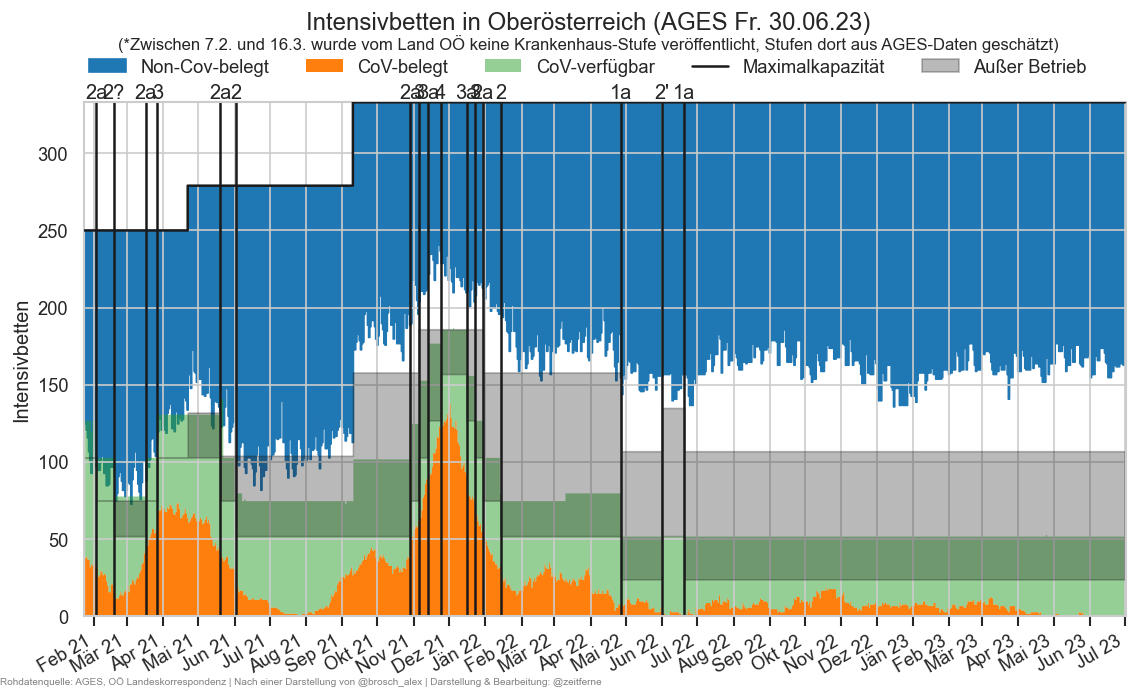
Zu OÖ: https://derstandard.at/permalink/rc/1000252002/context?ref=live_red_content Auf den Intensivstationen liegen derzeit noch 57 Corona-Patienten. Wie der Geschäftsführer der Oö. Gesundheitsholding Franz Harnoncourt kürzlich ausgeführt hat, würden 25 mit Covid-Patienten belegte Intensivbetten einen Normalbetrieb im Spital erlauben, 50 einen Hybridbetrieb, bei dem man aber elektive Eingriffe verschieben müsse, und bei 75 "konzentrieren wir uns nur mehr auf das Akutgeschehen".
mask = ~hx.index.get_level_values("Bundesland").isin(["Österreich", "Wien"])
#display(.index)
hx.loc["Österreich"] = hx.loc[mask].groupby(level="Datum").sum().to_numpy() # Sorry for the to_numpy...
hx.loc[("Österreich", hx.index.get_level_values("Datum")[-1]), "FZICUFree"] = np.nan
hx["AnteilCov"] = hx["IntensivBettenBelCovid19"] / hx["IntensivBettenBelGes"]
hx["AnteilNichtCov"] = hx["IntensivBettenBelNichtCovid19"] / hx["IntensivBettenBelGes"]
cov=reload(cov)
def plt_per_bl_hosp_bars():
fig, axs = plt.subplots(nrows=5, ncols=2, sharex=True, figsize=(10, 10))
fig.suptitle("COVID-PatientInnen im Krankenhaus" + AGES_STAMP, y=0.95)
fig.subplots_adjust(hspace=0.2, wspace=0.1)
for bl, ax in zip(fs["Bundesland"].unique(), axs.flat):
hbl = hospfz[hospfz["Bundesland"] == bl].copy().set_index("Datum")
hbl["FZICU_a7"] = hbl["FZICU"].rolling(7).mean()
hbl["FZHospAlle_a7"] = hbl["FZHospAlle"].rolling(7).mean()
rechosp = hbl.iloc[-DETAIL_NDAYS:]
ax.tick_params(axis="y", pad=-5, labelsize="x-small")
barargs=dict(width=0.8, lw=0, snap=False, aa=True)
pltr = cov.StackBarPlotter(ax, rechosp.index, **barargs)
pltr(
rechosp["FZICU"],
label="ICU",
alpha=0.7,
color="C3")
ax.plot(rechosp["FZICU_a7"], color="C3", lw=0.7)
pltr(
rechosp["FZHosp"],
label="Normalstation",
alpha=0.7,
color="C1")
ax.plot(rechosp["FZHospAlle_a7"], color="C1", lw=0.7)
if ax in axs[-1]:
cov.set_date_opts(ax, rechosp.index, showday=False)
ax.set_xlim(right=ax.get_xlim()[1] + 1)
if ax is axs.flat[0]:
fig.legend(loc="upper center", frameon=False, bbox_to_anchor=(0.5, 0.93), ncol=2);
ax.set_xlabel(None)
if ax in axs.T[0]:
ax.set_ylabel("PatientInnen", labelpad=0)
ax.set_title(f"{bl}: {rechosp['FZHospAlle'].iloc[-1]:.0f}", y=0.95)
fig.autofmt_xdate()
def plt_per_bl_hosp_free():
fig, axs = plt.subplots(nrows=5, ncols=2, sharex=True, figsize=(10, 10))
fig.suptitle("COVID-PatientInnen & verfügbare Betten im Krankenhaus" + AGES_STAMP, y=0.95)
fig.subplots_adjust(hspace=0.2, wspace=0.1)
for bl, ax in zip(fs["Bundesland"].unique(), axs.flat):
hbl = hospfz[hospfz["Bundesland"] == bl].copy().set_index("Datum")
rechosp = hbl.iloc[-SHORTRANGE_NDAYS:]
ax.tick_params(axis="y", pad=-5, labelsize="x-small")
barargs=dict(width=1, lw=0, snap=False, aa=True)
pltr = cov.StackBarPlotter(ax, rechosp.index, **barargs)
pltr(
rechosp["FZHosp"],
label="Belegt",
alpha=0.7,
color="C1")
pltr(
rechosp["FZHospFree"],
label="Weiters Verfügbar",
alpha=0.7,
color="C2")
if ax in axs[-1]:
cov.set_date_opts(ax, rechosp.index, showyear=False)
ax.set_xlim(right=ax.get_xlim()[1] + 1)
if ax is axs.flat[0]:
fig.legend(loc="upper center", frameon=False, bbox_to_anchor=(0.5, 0.93), ncol=2);
ax.set_xlabel(None)
if ax in axs.T[0]:
ax.set_ylabel("PatientInnen", labelpad=0)
ax.set_title(f"{bl}: {rechosp['FZHosp'].iloc[-1]:.0f}/{rechosp[['FZHosp', 'FZHospFree']].iloc[-1].sum():.0f}", y=0.95)
fig.autofmt_xdate()
if DISPLAY_SHORTRANGE_DIAGS:
plt_per_bl_hosp_bars()
plt_per_bl_hosp_free()
def drawhospbl():
hd = hospfz.copy()
hd["AnzEinwohner"] = hospfz["Bundesland"].map(ew_by_bundesland)
stamp = AGES_STAMP
hd["FZHospAlle"] = hd["FZICU"] + hd["FZHosp"]
with cov.calc_shifted(hd, "Bundesland", 7):
hd["hosp_a7"] = hd["FZHospAlle"].rolling(7).mean() / hd["AnzEinwohner"] * 100_000
hd0 = hd#[hd["Datum"] >= hd.iloc[-1]["Datum"] - timedelta(MIDRANGE_NDAYS)]
ax = sns.lineplot(data=hd0, x="Datum", y="hosp_a7", hue="Bundesland", err_style=None)
ax.set_ylim(bottom=0)
cov.set_date_opts(ax, hd0["Datum"])
ax.figure.autofmt_xdate()
ax.legend(*sortedlabels(ax, hd, "hosp_a7", fmtval=lambda v: f"{v:.3n}"), fontsize="small")
ax.set_ylabel("Hospitalisierte / 100.000 EW")
labelend2(ax, hd, "hosp_a7")
ax.figure.suptitle("CoV-PatientInnen/100.000 EW je Bundesland im 7-Tage-Schnitt" + stamp, y=0.93)
drawhospbl()
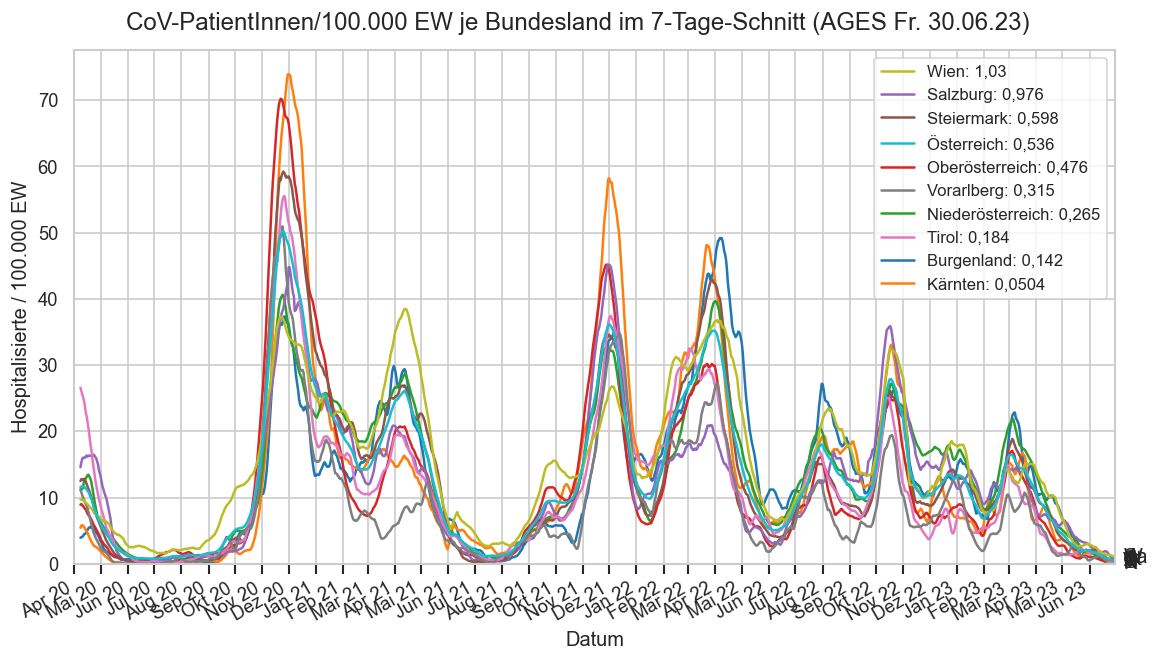
def print_hosp():
df = hospfz.query("Bundesland == 'Österreich'").copy()
df["FZHospAlle"] = df["FZICU"] + df["FZHosp"]
cov.enrich_inz(df, "FZHospAlle", catcol="Bundesland", dailycol="FZHospAlle")
print("Hospitalisierte #Covid19at-PatientInnen" + (AGES_STAMP if havehosp else MMS_STAMP))
for i in range(3):
record = df.iloc[-7*i - 1]
print("‒", record["Datum"].strftime("%d.%m:"), format(record["FZHospAlle"], ".0f") + ",", pctc(record["FZHospAlle_g7"], emoji=True),
"in 7 Tagen" if i == 0 else "")
print_hosp()
Hospitalisierte #Covid19at-PatientInnen (AGES Fr. 30.06.23) ‒ 30.06: 43, ‒19% ↘ in 7 Tagen ‒ 23.06: 53, ‒29% ⏬ ‒ 16.06: 75, ‒37% ⏬
def plthospchart(nhosp, icuhosp, source, selbl):
fig, ax = plt.subplots()
nhosp = nhosp.loc[nhosp.first_valid_index():]
nhosp = nhosp[nhosp.index >= pd.to_datetime("2021-07-15")]
icuhosp = icuhosp[icuhosp.index >= nhosp.index[0]]
#nhosp[hosp.iloc[-1]["Datum"]] = hosp.iloc[-1]["NormalBettenBelCovid19"]
msize = 1
mshift = 7
ahosp = nhosp + icuhosp
ahosp_a = ahosp.rolling(msize).mean()
pltr = cov.StackBarPlotter(ax, nhosp.index, snap=False, aa=True, lw=0)
pltr(icuhosp, color="C3", label="Auf ICU")
pltr(nhosp, color="C1", label="Auf Normalstation")
ax.axhline(ahosp.iloc[-1], color="C1", lw=0.5)
ax.set_ylabel("PatientInnen")
#ax.plot(nhosp_a)
cov.set_date_opts(ax, nhosp.index, showyear=True)
if True:
ax2 = ax.twinx()
ax2.set_ylabel("Änderung pro Woche")
ax2.grid(False)
ax2.yaxis.set_major_formatter(matplotlib.ticker.FuncFormatter(lambda v, _: f"{v - 1:+.0%}"))
#ax2.plot(nhosp_a3 / nhosp_a3.shift(msize), color="C1")
growth = ahosp_a / ahosp_a.shift(mshift)
#print(growth.tail(8))
plot_colorful_gcol(
ax2, ahosp_a.index, growth, name="Belastung", draw1=False, markersize=7, lw=1.5, mew=0.5, mec="w")
ax2.set_ylim(top=min(2, ax2.get_ylim()[1]))
ax2.annotate(f"{growth.iloc[-1] - 1:+.0%}",
(growth.index[-1], growth.iloc[-1]), xytext=(4, 0), textcoords="offset points", va="center")
ax.annotate(f"{ahosp.iloc[-1]}",
(nhosp.index[-1], ahosp.iloc[-1]), xytext=(4, +2), textcoords="offset points", va="bottom")
fig.suptitle(selbl + f": COVID-Krankenhaus-PatientInnen inkl. ICU{source}")
fig.autofmt_xdate()
fig.legend(loc="upper center", ncol=4, frameon=False, bbox_to_anchor=(0.5, 0.96))
ax.set_xlim(right=nhosp.index[-1] + (nhosp.index[-1] - nhosp.index[0]) * 0.04)
#display(growth.iloc[-1])
#fig.text(
# 0.5, 0.91,
# "* Änderung berechnet als Verhältnis des aktuellen Tages zu 7 Tagen vorher",
# va="top",
# ha="center",
# fontsize="small");
hosp_at = hospfz.query("Bundesland == 'Österreich'").set_index("Datum")
plthospchart(hosp_at["FZHosp"],
hosp_at["FZICU"],
AGES_STAMP, "Österreich")
#mms_oo = hospfz.query("Bundesland == 'Oberösterreich'")
#plthospchart(mms_oo.set_index("Datum")["FZHosp"], mms_oo.set_index("Datum")["FZICU"], AGES_STAMP, "Oberösterreich")
mms_oo = hospfz.query("Bundesland == 'Wien'")
plthospchart(mms_oo.set_index("Datum")["FZHosp"], mms_oo.set_index("Datum")["FZICU"], AGES_STAMP, "Wien")
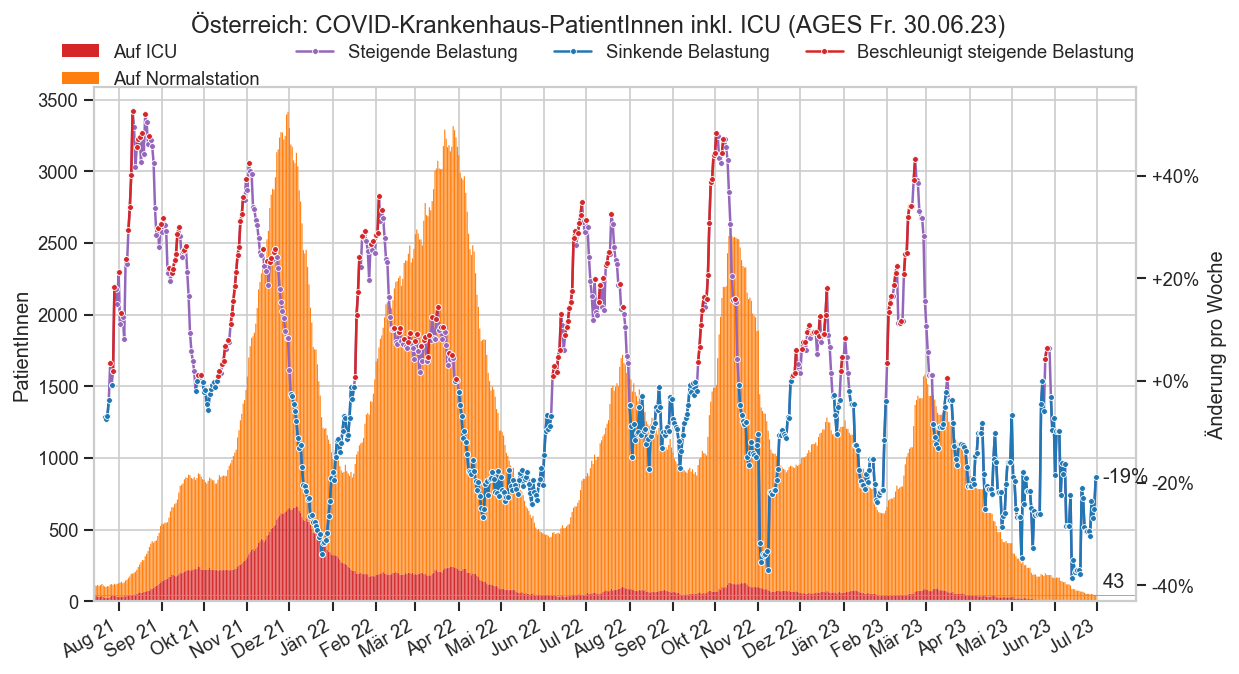
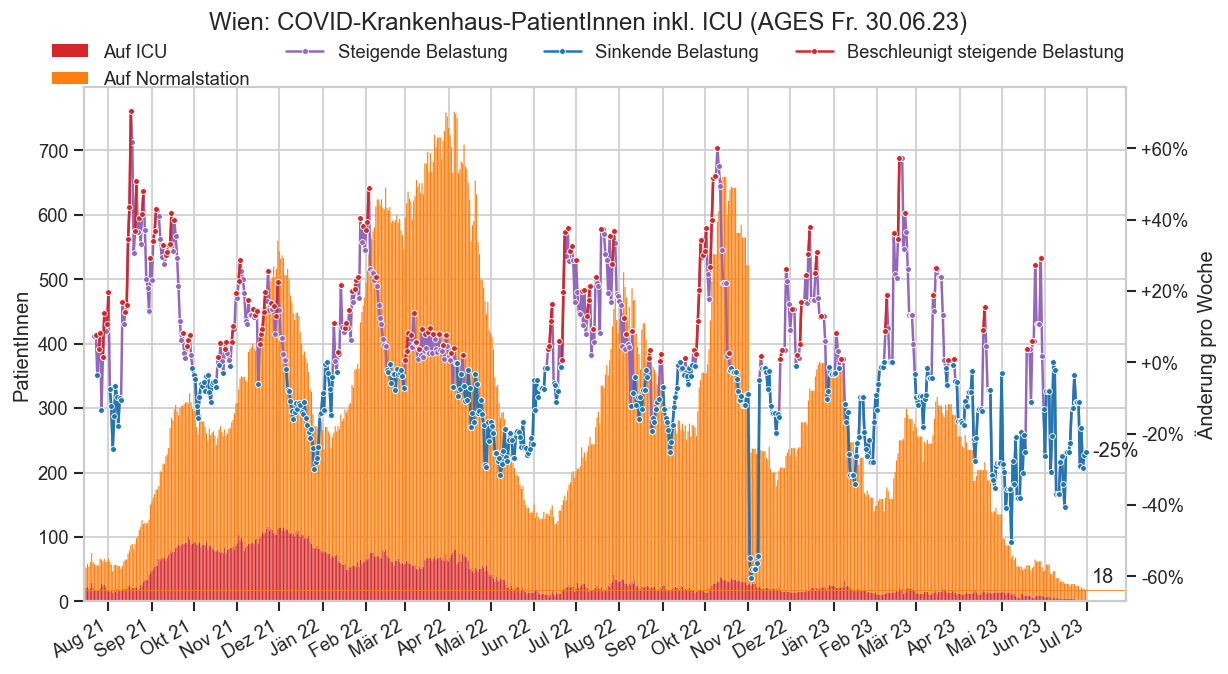
progn = pd.read_csv(DATAROOT / "covid/cov-prognose-nst.csv", encoding="utf-8", sep=";")
progn["Datum"] = pd.to_datetime(progn["Datum"], format=cov.AGES_DATE_FMT)
progn["FileDate"] = pd.to_datetime(progn["FileDate"], format=cov.AGES_DATE_FMT)
progn.set_index(["FileDate", "Datum"], inplace=True)
hdr = progn.columns.str.replace("^(.)$", r"\1.0", regex=True).str.split(".", expand=True)
hdr = hdr.set_levels(
[hdr.levels[0].map(
{v: k for k, v in cov.SHORTNAME_BY_BUNDESLAND.items()}
| {"Ö": "Österreich", "S": "Salzburg"}).to_list(),
[16, 50, 84]])
progn.columns = hdr
progn = progn.melt(
ignore_index=False,
value_name="VorHosp",
var_name=["Bundesland", "percentile"]
).set_index(
["Bundesland", "percentile"],
append=True).sort_index()["VorHosp"]
def plt_progn(selbl, logscale=False):
progn_at = progn.xs(selbl, level="Bundesland")
progn_at = progn_at[progn_at.index.get_level_values("FileDate") >= pd.to_datetime("2023-01-01")]
fig, ax = plt.subplots()
for i, fd in enumerate(progn_at.index.get_level_values("FileDate").unique()):
progn_at0 = progn_at.xs(fd, level="FileDate")
#display(progn_at0.index.levels[progn_at0.index.names.index("Datum")])
#display(progn_at0.xs(16, level="percentile"))
p16 = progn_at0.xs(16, level="percentile")
ax.fill_between(
p16.index,
p16,
progn_at0.xs(84, level="percentile"), alpha=.3, color="C0",
label="68%-Konfidenzintervall" if i == 0 else None)
ax.plot(progn_at0.xs(50, level="percentile"), ls="--", color="C0",
label="Prognosemittelwert" if i == 0 else None)
progn_at_dt = progn_at.index.get_level_values("Datum")
hospfz_at = hospfz.query(f"Bundesland == '{selbl}'")
ax.plot(
hospfz_at[hospfz_at["Datum"] >= progn_at_dt.min() - timedelta(2)].set_index("Datum")["FZHosp"],
lw=3,
color="C1",
marker="o",
label="Tatsächlich gemeldet")
cov.set_date_opts(ax)
if logscale:
cov.set_logscale(ax)
else:
ax.set_ylim(bottom=0)
lognote = " (logarithmisch)" if logscale else ""
ax.set_ylabel("PatientInnen" + lognote)
fig.suptitle(f"{selbl}: COVID-PatientInnen auf Normalstation: Real vs. Prognosekonsortium{lognote}")
fig.legend(loc="upper center", frameon=False, ncol=3, bbox_to_anchor=(0.5, 0.95))
plt_progn("Österreich")
plt_progn("Österreich", logscale=True)
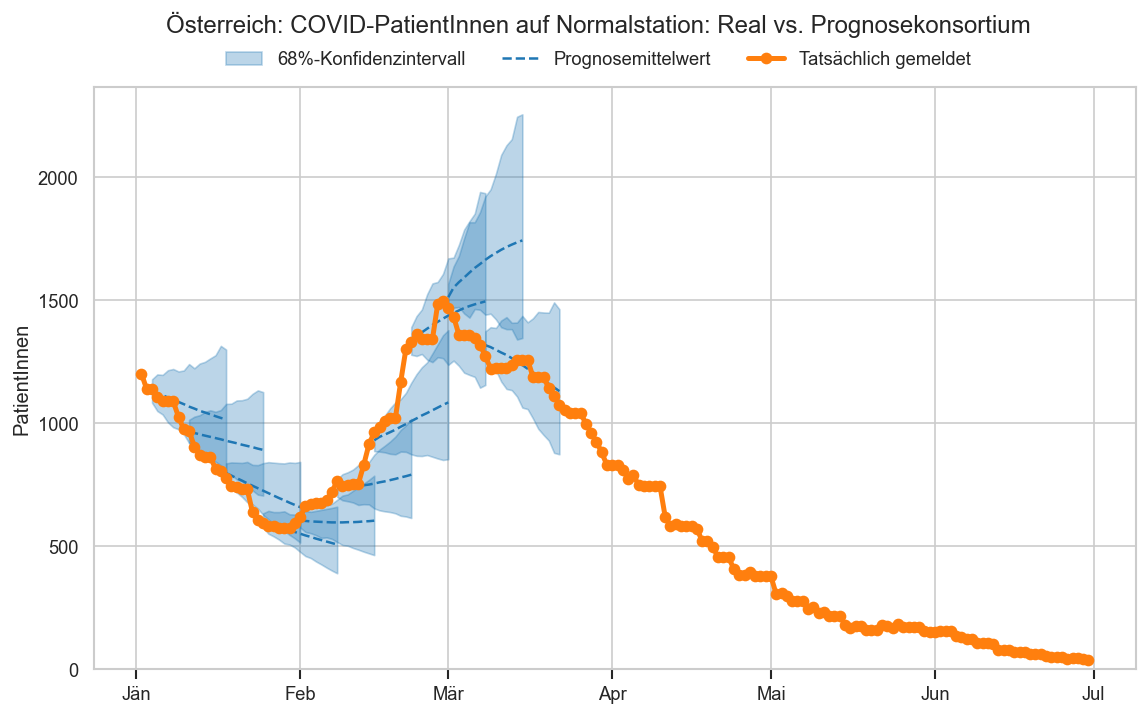
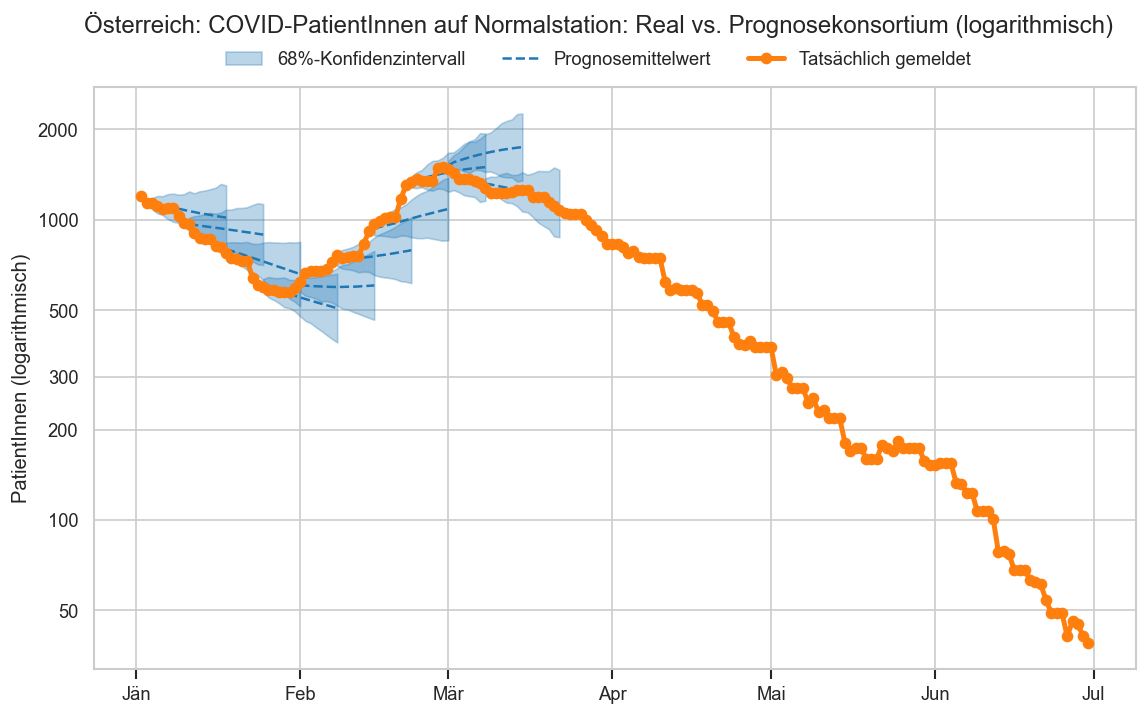
def active_cases(fs_at):
ngeheilt = fs_at["AnzahlFaelleSum"] - fs_at["AnzahlGeheiltSum"]
aktiv = ngeheilt - fs_at["AnzahlTotSum"]
return aktiv
def plt_hosprate(fs_at, stamp):
shift = -0#-19
hosp_sum = (fs_at["FZHosp"] + fs_at["FZICU"]).rolling(7).mean().shift(shift)
inz14 = fs_at["AnzahlFaelle"].rolling(14).sum()
hosprate = hosp_sum / active_cases(fs_at).rolling(7).mean()
rwidth = 14
gencnt = fs_at["AnzahlGeheiltSum"].diff().rolling(rwidth).sum()
#dcnt = erase_outliers(fs_at["AnzahlTot"]).rolling(rwidth).sum()
#deathrate = dcnt / (gencnt + dcnt)
print(hosprate.var())
fig, ax = plt.subplots()
ax2 = ax.twinx()
#ax2.set_facecolor("none")
#ax.set_facecolor("none")
ax2.plot(fs_at["Datum"], hosprate,
label="Anteil Hospitalisierter an aktiven Fällen: " + format(hosprate.iloc[-1] * 100, ".2n") + "%", lw=2)
#ax2.plot(fs_at["Datum"], deathrate, label="Geschätzte Fallsterblichkeit", lw=1, color="k")
ax.plot(fs_at["Datum"], hosp_sum, color="C1", label=f"Hospitalisierte: " + str(int(hosp_sum.iloc[-1])))
active = active_cases(fs_at)
ax.plot(fs_at["Datum"], active, color="C4", label="Aktive Fälle: " + format(int(active.iloc[-1]), ",").replace(",", "."))
ax.plot(fs_at["Datum"], inz14, color="C5", ls=":", label="14-T-Inz.: " + format(int(inz14.iloc[-1]), ",").replace(",", "."))
cov.set_logscale(ax2)
cov.set_logscale(ax)
cov.set_percent_opts(ax2, decimals=2)
cov.set_date_opts(ax, showyear=True)
ax.set_xlim(left=fs_at.iloc[0]["Datum"])
fig.autofmt_xdate()
ax.grid(False, axis="y")
#ax.set_ylim(top=0.1)
ax.set_ylim(bottom=max(20, ax.get_ylim()[0]))
fig.legend(ncol=4, frameon=False, loc="upper center", bbox_to_anchor=(0.5, 0.95))
fig.suptitle(fs_at.iloc[0]["Bundesland"] + ": Hospitalisierungsanteil an aktiven Fällen, logarithmisch" + stamp,
y=0.98)
ax.set_ylabel("Personen")
ax2.set_ylabel("Hospitalisierungsrate")
#plt_hosprate(fs[fs["Datum"] >= mms.iloc[0]["Datum"]].query("Bundesland == 'Österreich'"), AGES_STAMP)
fsh0 = fs.copy()
plt_hosprate(fsh0.query("Bundesland == 'Österreich'"), AGES_STAMP)
#print(fsh0.iloc[-1])
0.001983372360859888
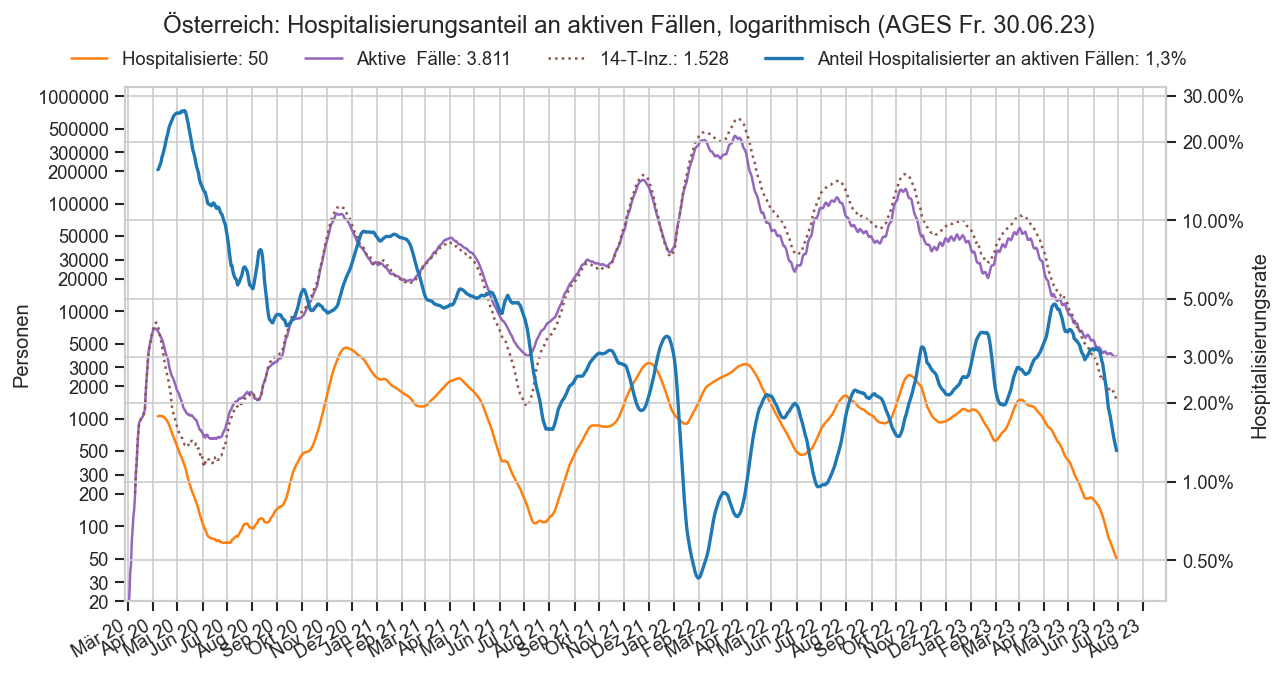
def plt_hosprate2(fs_at, stamp):
rwidth = 14
hosp_sum = (fs_at["FZHosp"] + fs_at["FZICU"])
#hamin = hosp_sum.iloc[-100:].argmin()
halflife=8
inz14 = (fs_at["AnzahlFaelle"].shift(7).ewm(halflife=halflife).sum()
#.rolling(20, win_type="exponential").sum(tau=1)
)
#.rolling(7).mean() #sym=False, center=8, tau=-(rwidth-1) / np.log(0.01)
#iamin = inz14.iloc[-100:].argmin()
shift = 0#7#iamin - hamin
hosp_sum = hosp_sum.rolling(7).mean().shift(shift)
hosprate = hosp_sum / inz14
#dcnt = erase_outliers(fs_at["AnzahlTot"]).rolling(rwidth).sum()
#deathrate = dcnt / (gencnt + dcnt)
#print(shift, hosprate.var(), fs_at.iloc[-100:].iloc[hamin]["Datum"], fs_at.iloc[-100:].iloc[iamin]["Datum"])
fig, ax = plt.subplots()
ax2 = ax.twinx()
#ax2.set_facecolor("none")
#ax.set_facecolor("none")
ax2.plot(fs_at["Datum"], hosprate,
label=f"Geschätzte Fallhospitalisierungsrate: " + format(hosprate.loc[hosprate.last_valid_index()] * 100, ".2n") + "%", lw=2)
#ax2.plot(fs_at["Datum"], deathrate, label="Geschätzte Fallsterblichkeit", lw=1, color="k")
ax.plot(fs_at["Datum"], hosp_sum, color="C1", label=f"Hospitalisierte: " + str(int(hosp_sum.loc[hosp_sum.last_valid_index()])))
ax.plot(fs_at["Datum"], fs_at["AnzahlFaelle"].rolling(14).sum(), color="r")
active = active_cases(fs_at)
ax.plot(fs_at["Datum"], inz14, color="C4", label=f"Inzidenz-7T, ewm(halflife={halflife}): " + format(int(inz14.iloc[-1]), ",").replace(",", "."))
cov.set_logscale(ax2)
cov.set_logscale(ax)
cov.set_percent_opts(ax2, decimals=2)
cov.set_date_opts(ax, showyear=True)
ax.set_xlim(left=fs_at.iloc[0]["Datum"])
fig.autofmt_xdate()
ax.grid(False, axis="y")
#ax.set_ylim(top=0.1)
ax.set_ylim(bottom=max(20, ax.get_ylim()[0]))
fig.legend(ncol=4, frameon=False, loc="upper center", bbox_to_anchor=(0.5, 0.95))
fig.suptitle(fs_at.iloc[0]["Bundesland"] + ": Geschätzte Fall-Hospitalisierungsrate, logarithmisch" + stamp,
y=0.98)
ax.set_ylabel("Personen")
ax2.set_ylabel("Hospitalisierungsrate")
#plt_hosprate(fs[fs["Datum"] >= mms.iloc[0]["Datum"]].query("Bundesland == 'Österreich'"), AGES_STAMP)
plt_hosprate2(fs.query("Bundesland == 'Österreich'"), AGES_STAMP)
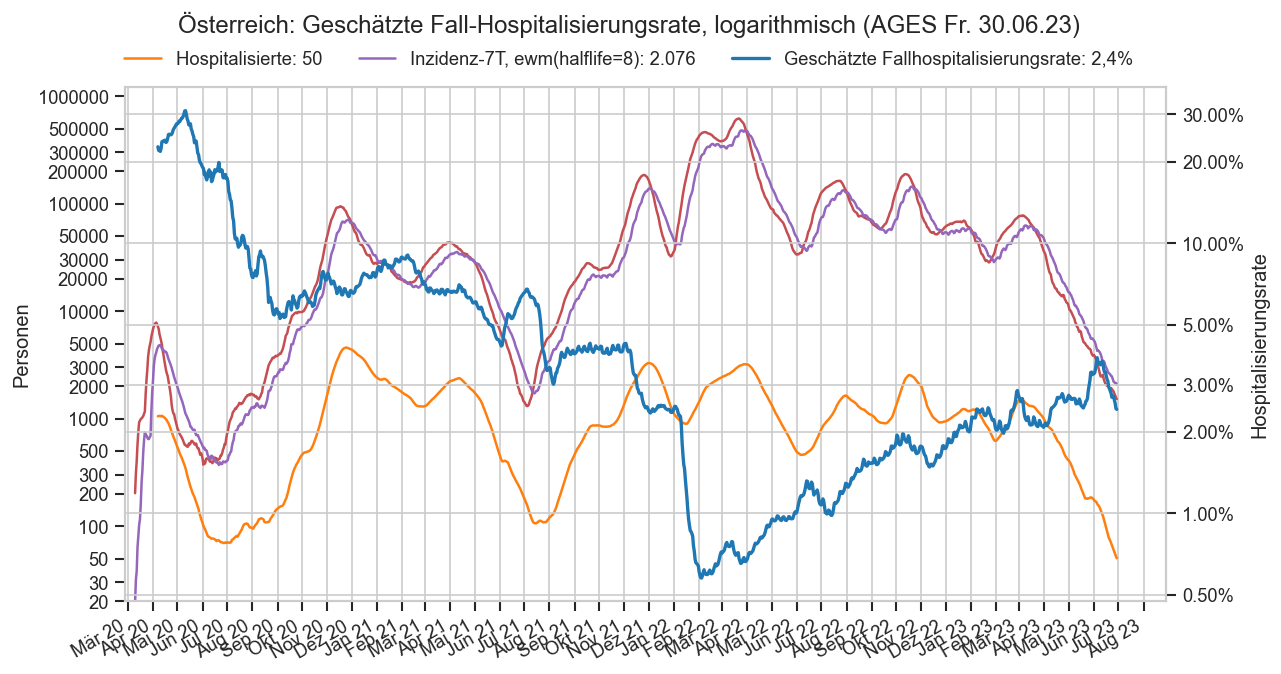
def plt_rate(n_num, s_num, n_denom, s_denom, stamp):
shift = -0#-19
#inz14 = fs_at["AnzahlFaelle"].rolling(14).sum()
rate = s_num / s_denom
#dcnt = erase_outliers(fs_at["AnzahlTot"]).rolling(rwidth).sum()
#deathrate = dcnt / (gencnt + dcnt)
fig, ax = plt.subplots()
ax2 = ax.twinx()
#ax2.set_facecolor("none")
#ax.set_facecolor("none")
ax2.plot(rate,
label=f"{n_num}/{n_denom}: " + format(rate.loc[rate.last_valid_index()] * 100, ".2n") + "%", lw=2)
#ax2.plot(fs_at["Datum"], deathrate, label="Geschätzte Fallsterblichkeit", lw=1, color="k")
ax.plot(s_denom, color="C1", label=f"{n_denom}: {int(s_denom.loc[s_denom.last_valid_index()])}")
ax.plot(s_num, color="C3", label=f"{n_num}: {int(s_num.loc[s_num.last_valid_index()])}")
#active = active_cases(fs_at)
cov.set_logscale(ax2)
cov.set_logscale(ax)
cov.set_percent_opts(ax2, decimals=0)
cov.set_date_opts(ax, showyear=True)
ax.set_xlim(left=s_num.index[0])
fig.autofmt_xdate()
ax.grid(False, axis="y")
#ax.set_ylim(top=0.1)
#ax.set_ylim(bottom=max(20, ax.get_ylim()[0]))
#ax2.set_ylim(bottom=0.03)
fig.legend(ncol=4, frameon=False, loc="upper center", bbox_to_anchor=(0.5, 0.95))
fig.suptitle(f"{n_num}/{n_denom}" + stamp, y=0.98)
ax.set_ylabel("Personen")
ax2.set_ylabel("Quote")
def plt_rates0():
hosp_at = hospfz.query("Bundesland == 'Österreich'").set_index("Datum")
#plt_rate("Auf ICU", mms_at["FZICU"], "Hospitalisierte ges.", mms_at["FZHosp"] + mms_at["FZICU"], mms_stamp)
plt_rate("Auf ICU 7-T-Schnitt", hosp_at["FZICU"].rolling(7).mean(),
"Hospitalisierte 7-T-Schnitt", (hosp_at["FZHosp"] + hosp_at["FZICU"]).rolling(7).mean(), AGES_STAMP)
#plt_rate("Tote (14 Tage-Schnitt)", mms_at["AnzahlTot"].rolling(14).mean(), "Hospitalisierte", mms_at["FZICU"] + mms_at["FZHosp"], mms_stamp)
#plt_hosprate(fs[fs["Datum"] >= mms.iloc[0]["Datum"]].query("Bundesland == 'Österreich'"), AGES_STAMP)
plt_rates0()
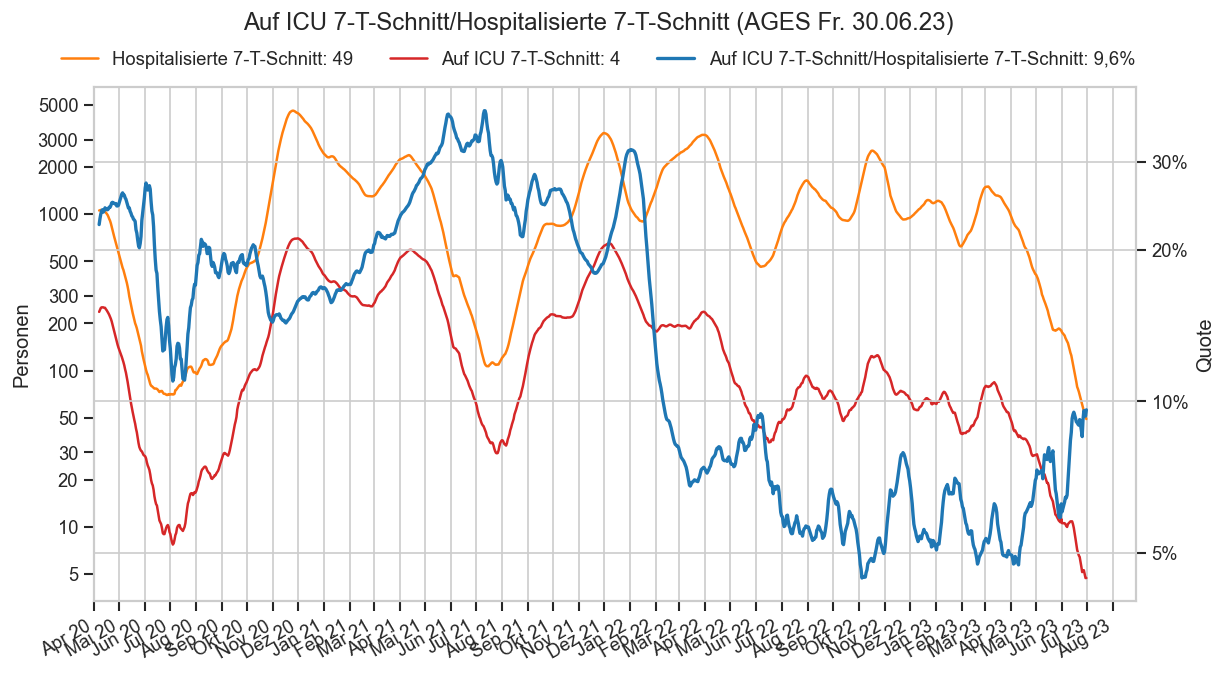
def plt_icu_stack_bl(ax, hbl, bl, ndays=300, showmin=True):
ax.set_title(bltitle(bl))
ax.stackplot(
hbl.index,
hbl["IntensivBettenBelNichtCovid19"], hbl["IntensivBettenBelCovid19"],
labels=["Belegt (Nicht-COVID)", "Mit COVID-PatientIn belegt"],
linewidth=0,
colors=sns.color_palette(n_colors=2),
baseline="zero",
step="post",
zorder=-1)
#ax.set_ylim(*ax.get_ylim())
mval = hbl["IntensivBettenBelGes"].max()
if bl in ("Salzburg", "Österreich"):
lval = hbl.loc[~hbl.index.isin(["2021-12-25"]), "IntensivBettenBelNichtCovid19"].min()
else:
lval = hbl["IntensivBettenBelNichtCovid19"].min()
#hbl["_m"] = mval
#hbl["_l"] = lval
#display(hbl.tail(5))
nccolor = "C9"
mcolor = "C3"
if showmin:
ax.axhline(lval, color=nccolor,
label="Bisheriger Tiefpunkt Nicht-Covid seit " + bdate, zorder=30)
minreached = hbl[hbl["IntensivBettenBelNichtCovid19"] <= lval]
ax.plot(minreached["IntensivBettenBelNichtCovid19"], color=nccolor,
lw=0, marker="x", label="Tiefpunkt Nicht-Covid erreicht", mew=2, markersize=8)
maxreached = hbl[hbl["IntensivBettenBelGes"] >= mval]
ax.axhline(mval, color=mcolor,
label="Bisherige Maximalauslastung seit " + bdate, zorder=30)
ax.plot(maxreached["IntensivBettenBelGes"], color=mcolor,
lw=0, marker="x", label="Maximalauslastung erreicht", mew=2, markersize=8)
#display(hbl["IntensivBettenKapGes"].append(
# pd.Series([hbl["IntensivBettenKapGes"].iloc[-1]], index=[hbl.index[-1] + timedelta(1)], copy=True)
# ).tail(5))
ax.plot(hbl["IntensivBettenKapGes"]
#.append(
#pd.Series([hbl["IntensivBettenKapGes"].iloc[-1]], index=[hbl.index[-1] + timedelta(1)], copy=True))
,
color="k", ls=":", ds="steps-post",
dash_joinstyle="miter",
solid_joinstyle="miter",
label="Not-Maximalkapazität lt. Bundesland")
ax.set_ylim(bottom=0, top=hbl["IntensivBettenKapGes"].max() * 1.01)
ax.plot(hbl["IntensivBettenBelGes"] + hbl["FZICUFree"],
color="k", alpha=0.4, ls="--", label="Ges.-Belegung + FZICUFree", ds="steps-post", scaley=False,
zorder=30,
dash_joinstyle="miter",
solid_joinstyle="miter",
)
#ax.plot(hbl["IntensivBettenKapGes"] - hbl["FZICUFree"], color="grey", scalex=False, scaley=False)
#ax.plot(hbl.index, (hbl["IntensivBettenKapGes"] - hbl["FZICUFree"]).rolling(7).mean(), color="k")
#ax.set_axisbelow(False)
#ax.legend(loc="upper right", ncol=2, frameon=False, bbox_to_anchor=(1, 1.2), columnspacing=1.1)
ax.set_xlim(
#left=hbl.index[0],
hbl.index[-1] - timedelta(ndays),
#left=hbl.index[0],
right=hbl.index[-1] + timedelta(1))
#ax.xaxis.set_minor_locator(matplotlib.dates.MonthLocator(interval=1))
#ax.grid(axis="x", which="minor")
#ax.xaxis.set_major_formatter(matplotlib.dates.DateFormatter("%b"))
fig, axs = plt.subplots(nrows=3, ncols=3, figsize=(18, 10), sharex=True, dpi=80)
fig.subplots_adjust(wspace=0.15, hspace=0.15)
fig.suptitle("Intensivstationen: Zusammensetzung der Belegung (ohne Wien)" + AGES_STAMP, y=1)
bdate = hx.index.get_level_values("Datum")[0].strftime("%x")
for bl, ax in zip(hx.index.get_level_values("Bundesland").unique(), axs.flat):
hbl = hx.xs(bl).copy()
#display(hbl)
#fig = plt.figure()
#fig.suptitle(bl)
#ax.set_title(cov.SHORTNAME2_BY_BUNDESLAND[bl], x=0, fontsize=14)
plt_icu_stack_bl(ax, hbl, bl)
if ax in axs.T[0]:
ax.set_ylabel("Intensivbetten")
if ax is axs.flat[0]:
fig.legend(loc="upper center", frameon=False, bbox_to_anchor=(0.5, 0.97), ncol=4)
elif ax is axs.flat[-1]:
cov.set_date_opts(ax)
cov.stampit(fig)
fig, ax = plt.subplots()#figsize=(18, 9))
selbl = "Österreich"
fig.suptitle(selbl + ": Intensivstationen: Zusammensetzung der Belegung" + AGES_STAMP, y=1)
plt_icu_stack_bl(ax, hx.xs(selbl), selbl, ndays=len(hx.xs(selbl)), showmin=False)
fig.legend(loc="upper center", frameon=False, bbox_to_anchor=(0.5, 0.97), fontsize="small", ncol=3)
ax.set_title(None)
cov.set_date_opts(ax, showyear=True)
fig.autofmt_xdate()
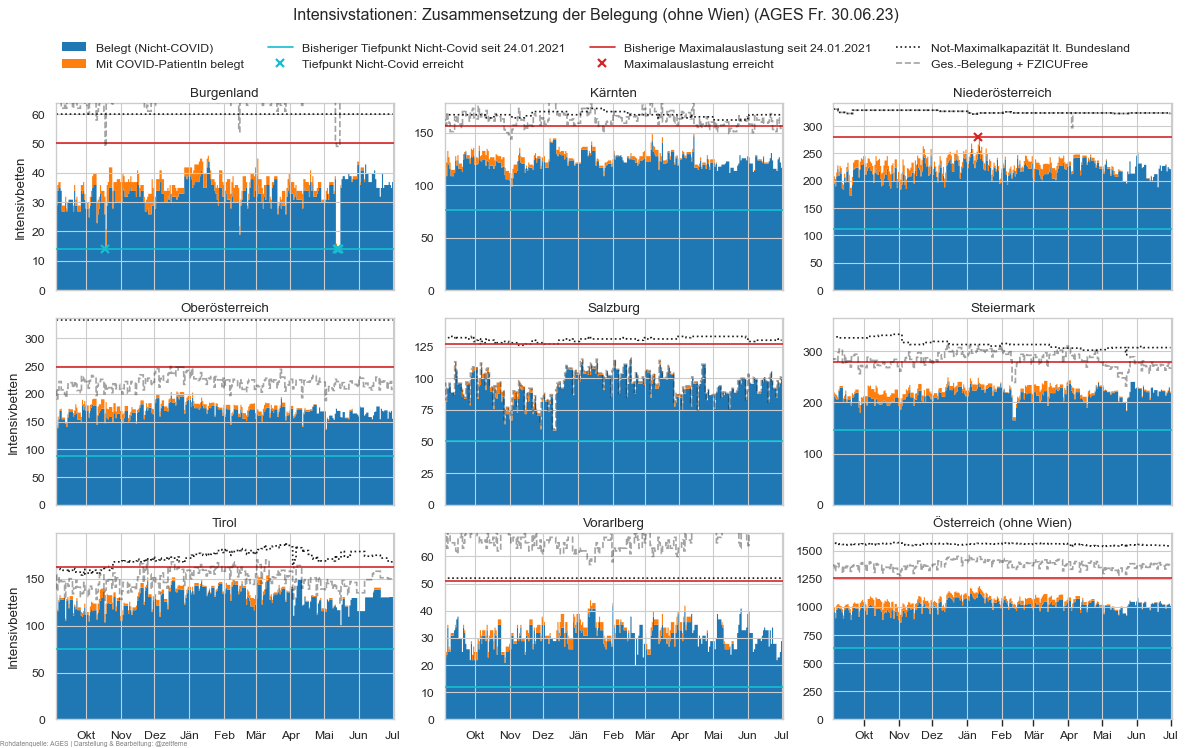
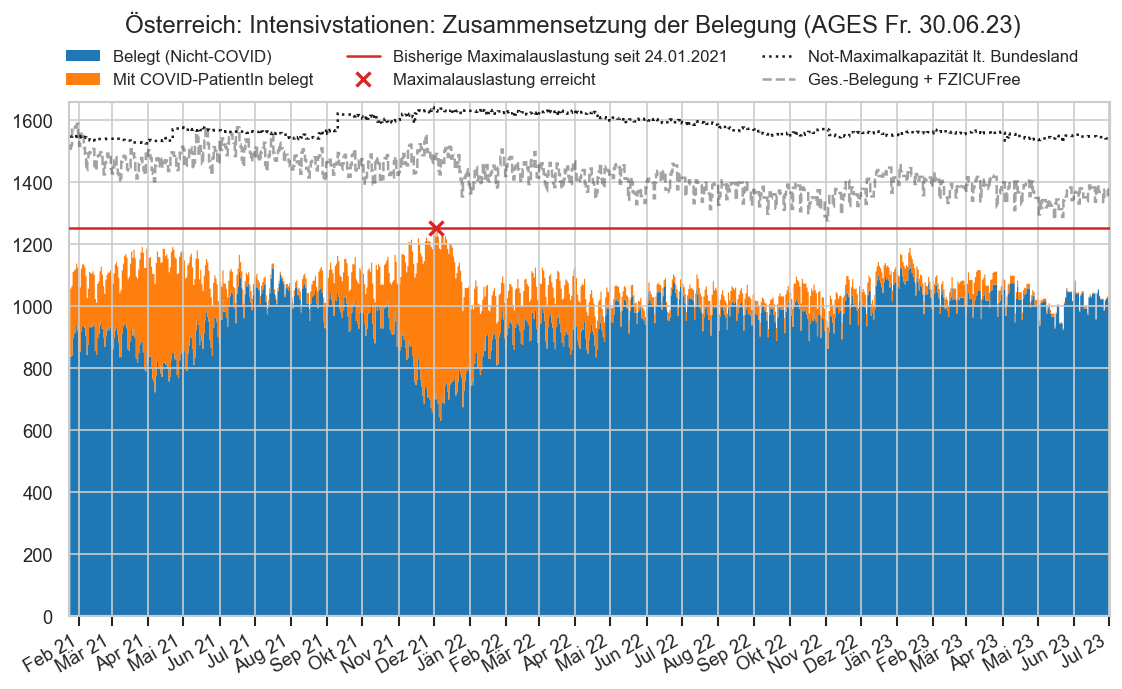
fig, axs = plt.subplots(nrows=3, ncols=3, figsize=(18, 14), sharex=True, dpi=80)
fig.subplots_adjust(wspace=0.2)
fig.suptitle("Intensivstationen: Anteilige Zusammensetzung der Belegung (ohne Wien)" + AGES_STAMP, y=0.92)
if DISPLAY_SHORTRANGE_DIAGS:
for bl, ax in zip(hx.index.get_level_values("Bundesland").unique(), axs.flat):
hbl = hx.xs(bl)
#display(hbl)
#fig = plt.figure()
#fig.suptitle(bl)
#ax.set_title(cov.SHORTNAME2_BY_BUNDESLAND[bl], x=-0.01, fontsize=14)
ges = hbl.iloc[-1]['IntensivBettenBelCovid19'] / hbl.iloc[-1]["IntensivBettenKapGes"]
ax.set_title(f"{bltitle(bl)}: {hbl.iloc[-1]['AnteilCov']:.0%} des Belags CoV ({ges:.0%} ges.)")
#print(hbl.index)
ax.stackplot(
hbl.index,
hbl["AnteilCov"], hbl["AnteilNichtCov"],
labels=["CoV-belegt", "Anders genutzt"],
colors=sns.color_palette(n_colors=2)[::-1],
linewidth=0, step="post")
ax.set_axisbelow(False)
#ax.legend(loc="upper right", ncol=2, frameon=False, bbox_to_anchor=(1, 1.1), columnspacing=1.1)
if ax in axs.T[0]:
#ax.set_ylabel("Intensivbetten")
ax.set_ylabel("Anteil an belegten Intensivbetten", labelpad=0)
ax.xaxis.set_major_locator(matplotlib.dates.MonthLocator(interval=1))
ax.set_xlim(left=hbl.index[-1] - timedelta(120), right=hbl.index[-1] + timedelta(2))
#ax.xaxis.set_minor_locator(matplotlib.dates.MonthLocator(interval=1))
#ax.grid(axis="x", which="minor")
ax.xaxis.set_major_formatter(matplotlib.dates.DateFormatter("%b"))
#ax.axhline(hbl.iloc[-1]["AnteilCov"], ls="-", color="k", lw=2, zorder=20, snap=True, aa=False)
cov.set_percent_opts(ax, freq=0.1)
ax.set_ylim(bottom=0, top=1)
ax.set_yticks([0.15, 0.25, 1/3], minor=True)
ax.grid(True, which="minor", axis="y", alpha=0.5)
if ax is axs.flat[0]:
fig.legend(loc="upper left", frameon=False, bbox_to_anchor=(0.8, 0.94));
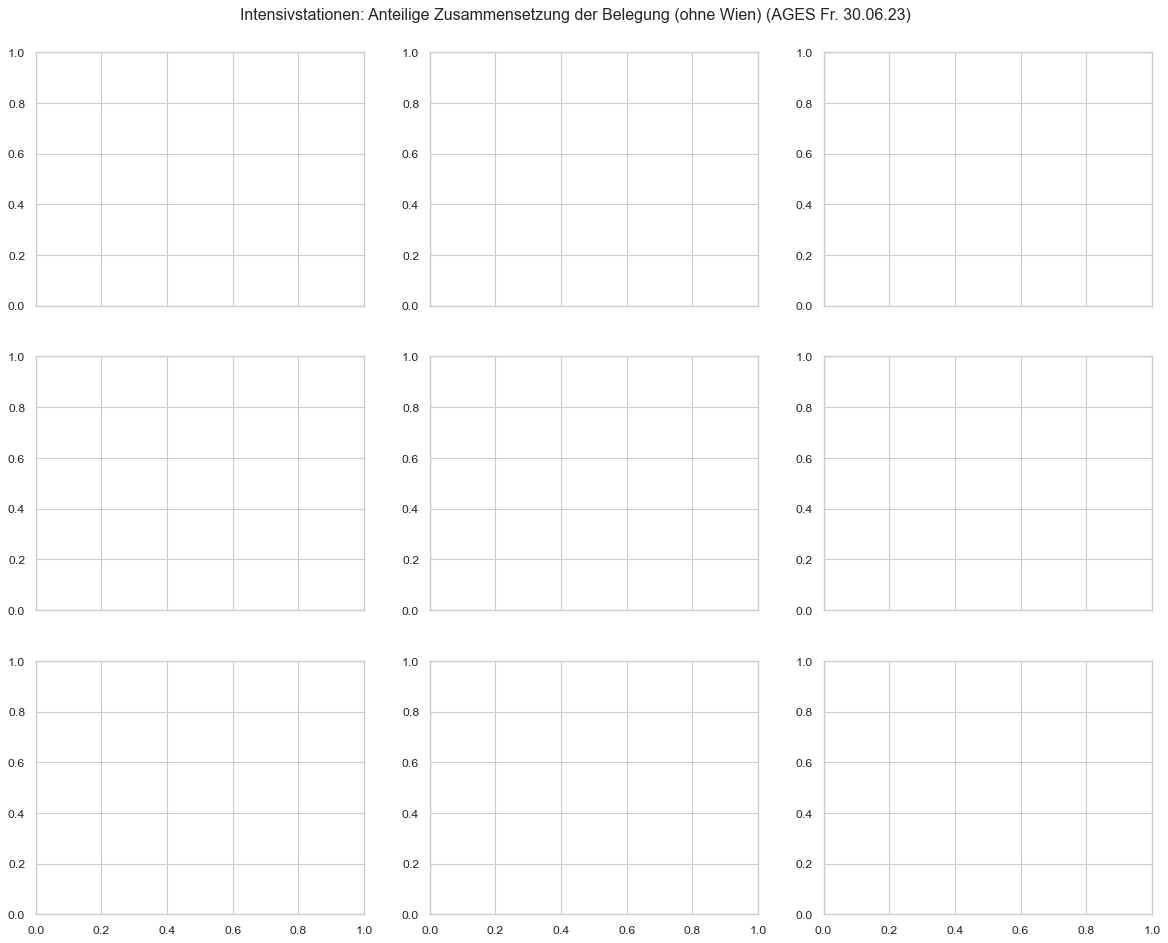
fix, ax = plt.subplots()
#ax.plot(hosp.query("Bundesland == 'Österreich'").groupby("Datum")["IntensivBettenBelNichtCovid19"].sum())
hosp.query("Bundesland == 'Wien'").groupby("Datum")["IntensivBettenBelNichtCovid19"].sum().plot()
ax.set_title("Nicht-Covid-ICU-Belegung für Wien" + AGES_STAMP)
Text(0.5, 1.0, 'Nicht-Covid-ICU-Belegung für Wien (AGES Fr. 30.06.23)')
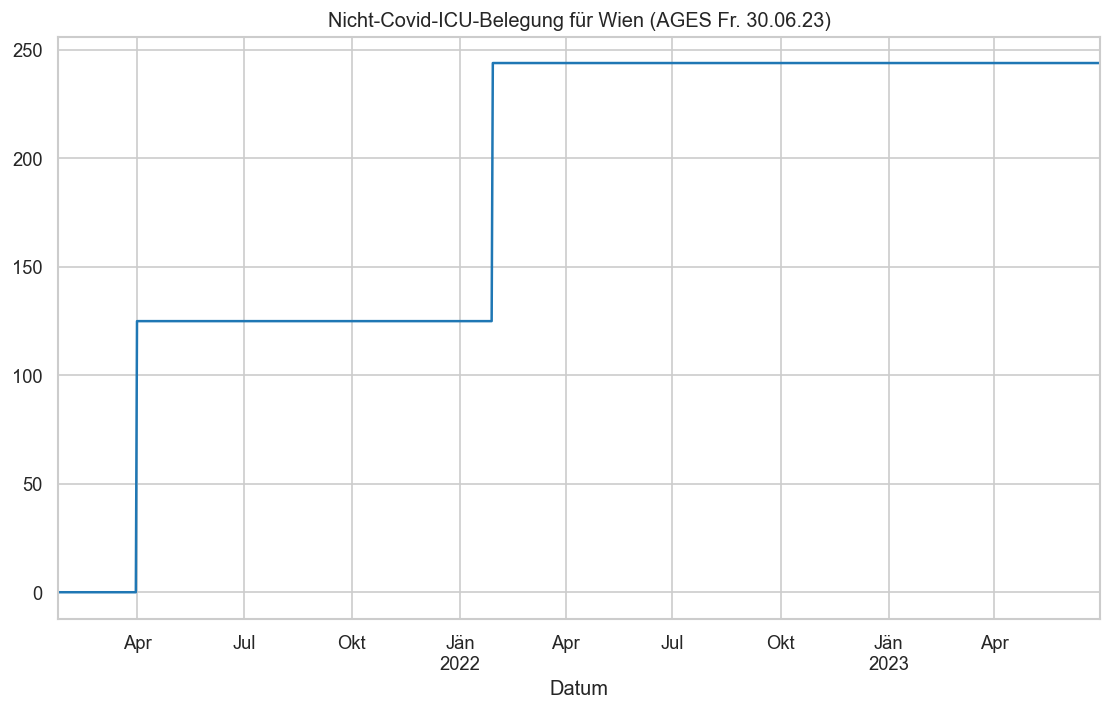
qr = "Bundesland not in ('Österreich', 'Wien')"
#qr = "Bundesland == 'Niederösterreich'"
icufree = hosp.query(qr).groupby("Datum")["IntensivBettenKapGes"].sum()
icufree -= hosp.query(qr).groupby("Datum")["IntensivBettenBelGes"].sum()
#icufree -= hosp.query(qr).groupby("Datum")["IntensivBettenBelNichtCovid19"].sum()
fig, ax = plt.subplots()
#ax.plot(icufree, label="Angeblich freie Betten", color="C2")
#ax.plot(hx.query("Bundesland == 'Österreich'")["IntensivBettenKapGes"].groupby("Datum").sum())
#ax.plot(hosp.query(qr).groupby("Datum")["IntensivBettenBelCovid19"].sum(), label="Belegt ‒ COVID-19", color="C1")
#ax.plot(hosp.query(qr).groupby("Datum")["IntensivBettenBelNichtCovid19"].sum(), label="Belegt ‒ Andere", color="C0")
ax.plot(hosp.query(qr).groupby("Datum")["IntensivBettenBelGes"].sum(), label="Belegt ‒ Summe", color="C4")
ax.plot(hosp.query(qr).groupby("Datum")["IntensivBettenBelGes"].sum().rolling(7).mean(), color="k", ls=":")
ax.set_xlim(left=icufree.index[0])
cov.set_date_opts(ax)
fig = ax.figure
fig.autofmt_xdate()
#fig.legend(ncol=4, loc="upper center", bbox_to_anchor=(0.5, 0.95), frameon=False)
#fig.suptitle("Insgesamt belegte Intensivbetten in Niederösterreich" + AGES_STAMP, y=0.95)
fig.suptitle("Insgesamt belegte Intensivbetten in Österreich ohne Wien" + AGES_STAMP, y=0.95)
ax.set_title("(Y-Achse beginnt nicht bei 0!)")
#ax.set_ylim(bottom=800, top=1300)
Text(0.5, 1.0, '(Y-Achse beginnt nicht bei 0!)')
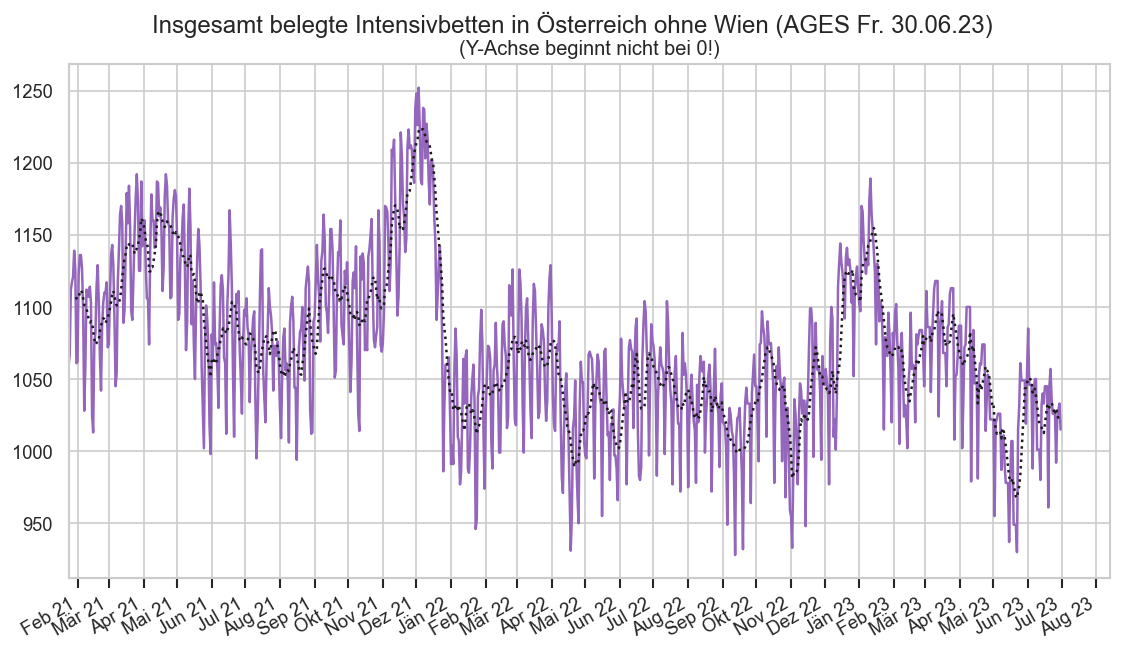
lasticu = hosp.query(qr).groupby("Datum").sum().iloc[-1]["IntensivBettenBelGes"]
print(lasticu)
len(hosp.query(qr).groupby("Datum").sum().query(f"IntensivBettenBelGes > {lasticu}"))
1015
753
fig, ax = plt.subplots()
ax.plot(
hx.xs("Österreich")["IntensivBettenBelGes"].rolling(7).mean()
/ hx.xs("Österreich")["IntensivBettenKapGes"].rolling(7).mean(),
label="Verhältnis Nicht-Covid : Kapazität")
cov.set_percent_opts(ax)
cov.set_date_opts(ax, hx.index.get_level_values("Datum"))
ax.set_xlim(right=ax.get_xlim()[1] + 7)
fig.autofmt_xdate()
ax.set_ylim(0.3, 0.8)
fig.suptitle("Österreich ohne Wien: Nicht-Covid-ICU-Auslastung in %")
ax.legend()
<matplotlib.legend.Legend at 0x19880b9e150>
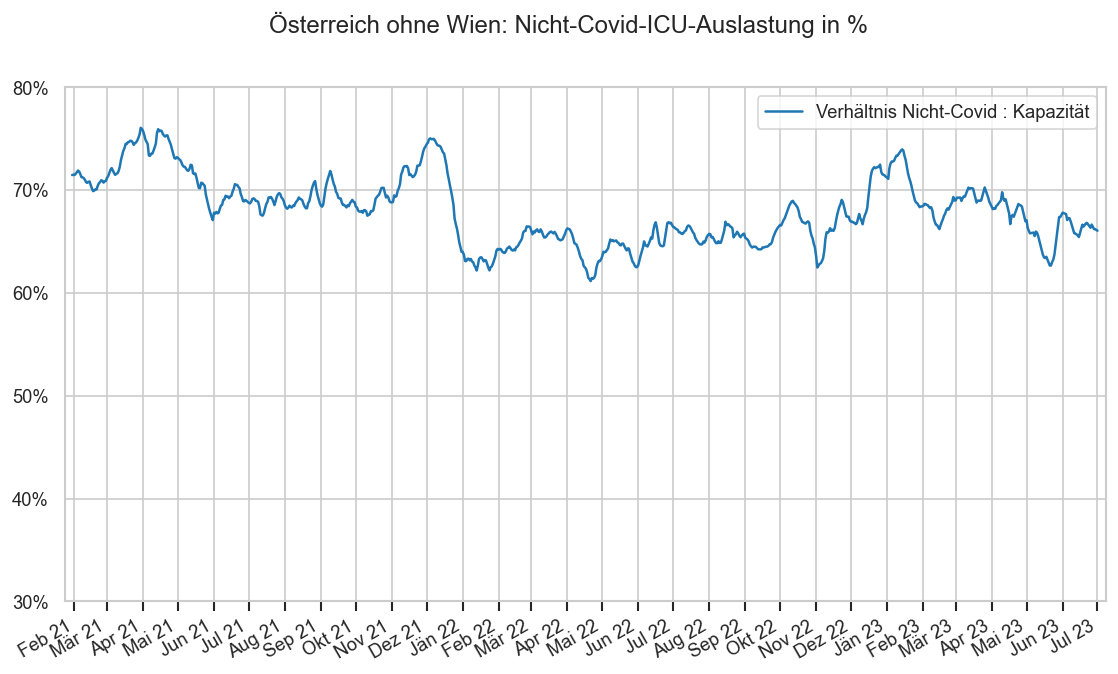
fig, axs = plt.subplots(nrows=3, ncols=3, sharex=True, sharey=True)
fig.subplots_adjust(wspace=0.04)
fig.suptitle(
"Intensivstationen: Mit CoV belegte Betten / Insgesamt belegte (ohne Wien; 7-Tage-Schnitt)" + AGES_STAMP,
y=0.95)
for bl, ax in zip(hx.index.get_level_values("Bundesland").unique(), axs.flat):
hbl = hx.xs(bl)
#display(hbl)
#fig = plt.figure()
#fig.suptitle(bl)
#ax.set_title(cov.SHORTNAME2_BY_BUNDESLAND[bl], x=-0.01, fontsize=14)
#ges = hbl.iloc[-1]['IntensivBettenBelCovid19'] / hbl.iloc[-1]["IntensivBettenKapGes"]
use = (hbl["IntensivBettenBelCovid19"] / (hbl["IntensivBettenBelNichtCovid19"] + hbl["IntensivBettenBelCovid19"]))
use7 = use.rolling(7).mean()
ndays = 2000
use7 = use7.iloc[-ndays:]
use = use.iloc[-ndays:]
ax.set_title(f"{bltitle(bl)}: zuletzt {use.iloc[-1]:.0%} CoV", y=0.96)
#print(hbl.index)
ax.plot(use7, )
ax.plot(use, lw=0, marker=".", mew=0, color="C0")
ax.axhline(use7.iloc[-1], ls="--", color="skyblue")
#ax.set_axisbelow(False)
#ax.legend(loc="upper right", ncol=2, frameon=False, bbox_to_anchor=(1, 1.1), columnspacing=1.1)
if ax in axs.T[0]:
ax.set_ylabel("% Belegung CoV", labelpad=0)
ax.xaxis.set_major_locator(matplotlib.dates.MonthLocator(interval=1 if ndays < 400 else 2))
ax.set_xlim(left=use.index[0], right=use.index[-1] + timedelta(7))
#ax.xaxis.set_minor_locator(matplotlib.dates.MonthLocator(interval=1))
#ax.grid(axis="x", which="minor")
ax.xaxis.set_major_formatter(matplotlib.dates.DateFormatter("%b %y"))
#ax.axhline(hbl.iloc[-1]["AnteilCov"], ls="--", color="skyblue")
cov.set_percent_opts(ax)
if ax is axs.flat[-1]:
ax.set_ylim(bottom=0, top=ax.get_ylim()[1])
#ax.set_yticks([0.15, 0.25], minor=True)
ax.grid(True, which="minor", axis="y", alpha=0.5)
#if ax is axs.flat[0]:
# fig.legend(loc="upper left", frameon=False, bbox_to_anchor=(0.8, 0.94));
for ax in axs.flat:
ax.axhspan(0, 0.1, color="green", alpha=0.2)
ax.axhspan(0.1, 1/3, color="yellow", alpha=0.2)
ax.axhspan(1/3, 0.5, color="orange", alpha=0.2)
ax.axhspan(0.5, 1, color="red", alpha=0.2)
#axs.flat[-1].set_ylim(*ylim)
fig.autofmt_xdate()
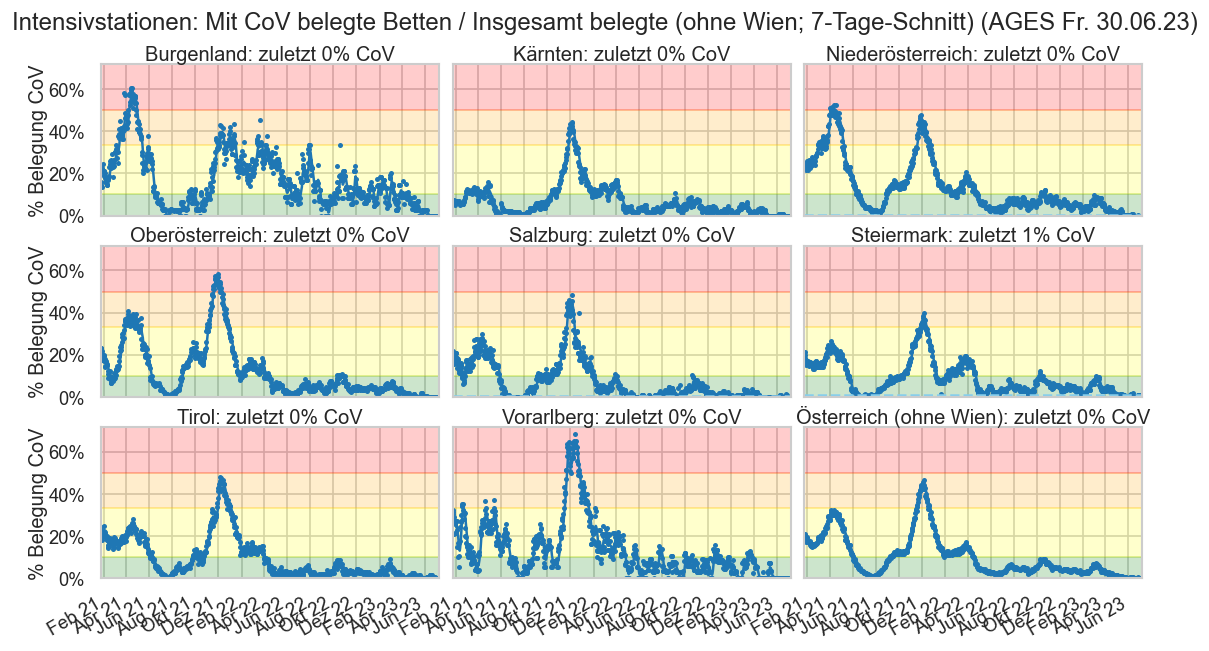
hospfs = hx.reset_index().copy()
hospfs = hospfs.query("Bundesland != 'Österreich'")
hospfs["Bundesland"] = hospfs["Bundesland"].map(bltitle)
#hosp_corr["Datum"] -= timedelta(1)
#hospfs = (hosp_corr.reset_index(drop=True).set_index(["Datum", "Bundesland", "BundeslandID"])
# .drop(columns=["TestGesamt"])
# .join(fs.reset_index(drop=True).set_index(["Datum", "Bundesland", "BundeslandID"]))
# .reset_index()
# .copy())
#hospfs = cov.filterlatest(hospfs) #hospfs[hospfs["Datum"] == "2021-07-20"]
hospfs["icu"] = hospfs["IntensivBettenBelCovid19"] / hospfs["AnzEinwohner"] * 100_000
hospfs["nc_icu"] = hospfs["IntensivBettenBelNichtCovid19"] / hospfs["AnzEinwohner"] * 100_000
hospfs["icu_cap"] = hospfs["IntensivBettenKapGes"] / hospfs["AnzEinwohner"] * 100_000
l_hospfs = cov.filterlatest(hospfs)
#display(cov.filterlatest(fs)[["Datum", "Bundesland", "BundeslandID", "icu", "FZICU", "AnzEinwohner"]])
#display(cov.filterlatest(hosp)[["Datum", "Bundesland", "BundeslandID", "AnteilCov"]])
#hospfs["AnteilCov"] = hospfs["IntensivBettenBelCovid19"] / hospfs["IntensivBettenBelGes"]
if DISPLAY_SHORTRANGE_DIAGS:
plt.figure(figsize=(7, 7))
if False:
sns.regplot(data=l_hospfs,
x="nc_icu",
y="icu",
scatter=False)
markers = cov.MARKER_SEQ
ax = sns.scatterplot(data=l_hospfs,
hue="Bundesland",
style="Bundesland",
markers=markers[:l_hospfs["Bundesland"].nunique()],
x="nc_icu",
y="icu",
s=200,
zorder=30)
for i, (marker, bl) in enumerate(zip(markers, l_hospfs["Bundesland"].unique())):
bhospfs = hospfs[hospfs["Bundesland"] == bl]
nrechist = 8
ax.plot(bhospfs["nc_icu"].iloc[-nrechist:], bhospfs["icu"].iloc[-nrechist:],
marker=marker,
markersize=5,
markeredgewidth=1,
lw=0.5,
color=f"C{i}")
nbackhist = 30
ax.plot(bhospfs["nc_icu"].iloc[-nrechist - nbackhist:-nrechist + 1],
bhospfs["icu"].iloc[-nrechist - nbackhist:-nrechist + 1],
lw=0.3, color=f"C{i}", scalex=False, scaley=False)
#lims = ax.get_ylim()
#minlim = min(ax.get_xlim()[0], ax.get_ylim()[0])
#maxlim = max(ax.get_xlim()[1], ax.get_ylim()[1])
ax.set_xlim(0, ax.get_xlim()[1])
ax.set_ylim(0, ax.get_ylim()[1])
#ax.set_xlim(minlim, maxlim)
#ax.set_ylim(minlim, maxlim)
ax.xaxis.set_major_locator(matplotlib.ticker.MultipleLocator(2))
ax.yaxis.set_major_locator(matplotlib.ticker.MultipleLocator(1))
#ax.plot([0, 100], [0, 100], color="grey")
#ax.plot([0, 100], [0, 150], color="grey")
#ax.plot([0, 100/3], [0, 100*2/3], color="grey")
#ax.plot([0, 100/10], [0, 100*9/10], color="grey")
ax.fill_between([0, 100], [100, 100], [0, 100], color="red", alpha=0.2)
ax.fill_between([0, 100], [0, 100], [0, 50], color="orange", alpha=0.2)
ax.fill_between([0, 100], [0, 50], [0, 10], color="yellow", alpha=0.2)
ax.fill_between([0, 100], [0, 10], [0, 0], color="lightgreen", alpha=0.2)
#cov.set_percent_opts(ax, freq=0.05)
#ax.set_ylabel("Anteil mit COVID-Patienten belegter Betten an belegten Betten")
ax.set_xlabel("Ohne COVID auf der Intensivstation pro 100.000 Einwohner")
ax.set_ylabel("Mit COVID auf der Intensivstation pro 100.000 Einwohner");
ax.figure.suptitle("Intensivstation: Belag ohne vs. mit COVID" + AGES_STAMP, y=0.95)
cov.stampit(ax.figure)
ax.text(0.5, 1.02, "(Für Wien hat die AGES keine Daten zur Nicht-Covid-Belegung)",
transform=ax.transAxes, ha="center", fontsize="small")
ax.figure.legend(loc="center right", bbox_to_anchor=(1.16, 0.5))
ax.get_legend().remove()
Todesfälle¶
stat_at_yr_d = pd.read_csv(DATAROOT / "covid/statat_yearly_covid_deaths_pr.csv", encoding="utf-8", sep=";", decimal=",",
index_col=["Jahr", "Bundesland"])
def plt_d_yrcmp_1():
y = 2022
bl = "Österreich"
emsd = fs.query(f"Bundesland == '{bl}' and Datum.dt.year == {y}")["AnzahlTot"].sum()
SRC_EMS = "EMS\n" + AGES_STAMP
SRC_STAT = "Todesursachenstatistik\n(Statistik Austria)"
pltfdata = [
[emsd, SRC_EMS, "\"an oder mit\""],
[stat_at_yr_d.loc[(y, bl), "AnzahlTot"], SRC_STAT, "Grundleiden (\"an\")"],
[stat_at_yr_d.loc[(y, bl), "AnzahlTotMit"], SRC_STAT, "Begleiterkrankung (relevantes \"mit\")"]]
pltf = pd.DataFrame(
pltfdata,
columns=["n", "src", "cat"])
display(pltf.dtypes)
ax = pltf.pivot(index="src", columns="cat", values="n")[["Grundleiden (\"an\")", "Begleiterkrankung (relevantes \"mit\")", "\"an oder mit\""]].plot.bar(stacked=True, rot=0)
ax.set_ylabel("Verstorbene Personen")
ax.set_xlabel(None)
ax.get_legend().set_title(None)
fig = ax.figure
fig.suptitle(f"{bl}: COVID-Tote im Jahr {y} aus verschiedenen Quellen", y=0.93)
plt_d_yrcmp_1()
n float64 src object cat object dtype: object
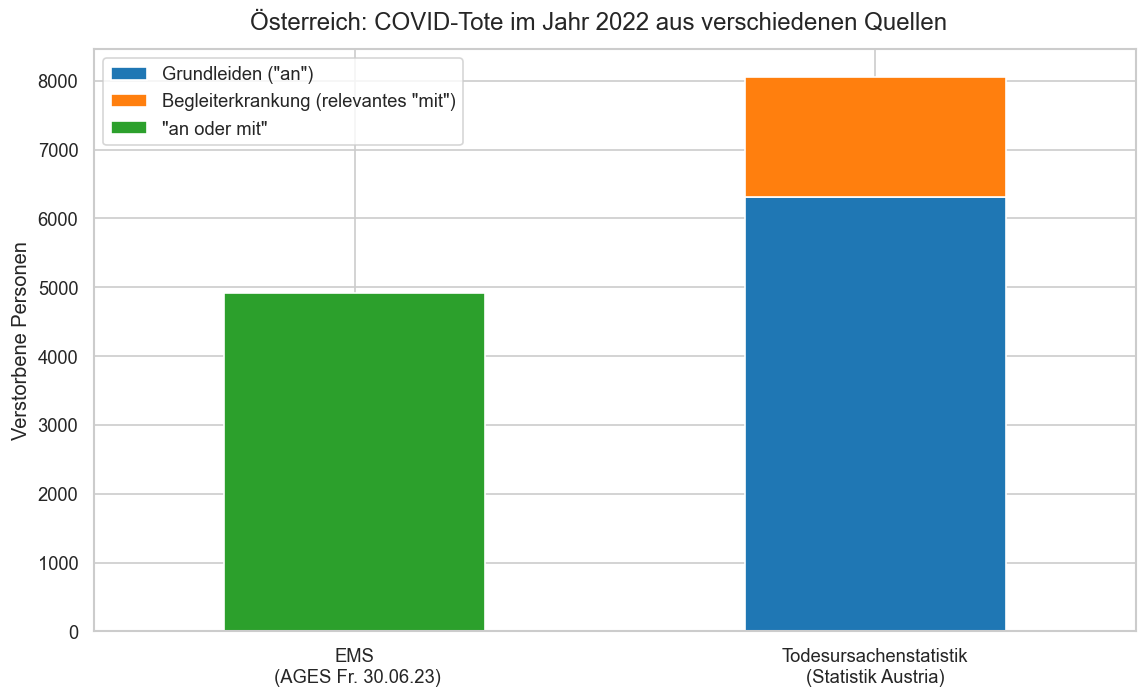
# https://www.statistik.at/fileadmin/announcement/2022/05/20220303Todesursachen2021.pdf
# https://www.statistik.at/fileadmin/announcement/2023/03/20230315Todesursachen2022vorl.pdf
def plt_d_yrcmp(ax, bl):
pltargs = dict(marker="o", lw=2, markersize=10)
ax.xaxis.set_major_locator(matplotlib.ticker.MultipleLocator(1))
blq = f"Bundesland == '{bl}' and Datum.dt.year < 2023"
fs_oo = fs.query(blq + " and Datum.dt.year < 2022")
agescnt = fs_oo.groupby(fs_oo["Datum"].dt.year)["AnzahlTot"].sum().rename("EMS Letzter Stand" + AGES_STAMP)
#and FileDate.dt.month == 4 and FileDate.dt.day == 16' +
#' and Datum.dt.year + 1 == FileDate.dt.year
ages_hist_oo = pd.concat([
ages_hist.query(blq + ' and Datum.dt.year <= 2021 and FileDate == "2022-4-19"'),
ages_hist[ages_hist["FileDate"] == ages_hist["FileDate"].max()].query(blq + "and Datum.dt.year > 2021")
])
ages1cnt = (ages_hist_oo
.groupby(ages_hist_oo["Datum"].dt.year)
["AnzahlTotTaeglich"]
.sum()
.rename("Letzter EMS-Stand vor Datenabgleich"))
agesstat = pd.concat([ages1cnt, agescnt], axis='columns')
#agesdiff = (agesstat[agesstat.columns[1]] - agesstat[agesstat.columns[0]]).rename("diff")
#agespdiff = (agesstat[agesstat.columns[1]] / agesstat[agesstat.columns[0]]).rename("pdiff")
#display(agesdiff, agespdiff)
colors = sns.color_palette("Blues", n_colors=2)
agesstat.plot(y=agesstat.columns[0], ax=ax, color=colors[0], ls="--", **pltargs)
agesstat.plot(y=agesstat.columns[1], ax=ax, color=colors[1], **pltargs)
#display(agesstat)
#ax.set_title("Todesursachenstatistik (Statistik Austria)")
atstat0 = stat_at_yr_d.xs(bl, level="Bundesland")[["AnzahlTot", "AnzahlTotMit"]]
atstat = pd.DataFrame(atstat0.to_numpy(),
columns=['Todesursache: Grundleiden ("an")', 'Todesursache: Begleiterkrankung ("u.a. auch wegen")'],
index=atstat0.index.get_level_values("Jahr"))
atstat['Todesursache: Grundleiden + relevante Begleiterkrankung'] = (
atstat[atstat.columns[0]] + atstat[atstat.columns[1]])
atstat.drop(columns=atstat.columns[1], inplace=True)
display(bl, atstat.join(agesstat))
atstat.plot(ax=ax, color=sns.color_palette("Reds", n_colors=2), **pltargs)
ax.set_ylim(bottom=0, top=max(agesstat.max().max(), atstat.max().max()) * 1.125)
#display(agescnt)
#display(ages1cnt)
fig, axs = plt.subplots(sharex=True, nrows=2, ncols=5)
fig.suptitle(f"Jährliche COVID-19-Todesfälle in Österreich (separate Skala pro Bundesland)", y=1.05)
fig.subplots_adjust(wspace=0.4)
for ax, bl in zip(axs.flat, fs["Bundesland"].unique()):
plt_d_yrcmp(ax, bl)
ax.get_legend().remove()
ax.set_title(bl)
ax.tick_params(labelleft=True, pad=-1)
if ax is axs.flat[0]:
fig.legend(loc="upper center", frameon=False, ncol=2, bbox_to_anchor=(0.5, 1.01))
if ax in axs.T[0]:
ax.set_ylabel("Anzahl Todesfälle")
cov.stampit(fig, "AGES, Statistik Austria")
'Burgenland'
| Todesursache: Grundleiden ("an") | Todesursache: Grundleiden + relevante Begleiterkrankung | Letzter EMS-Stand vor Datenabgleich | EMS Letzter Stand (AGES Fr. 30.06.23) | |
|---|---|---|---|---|
| Jahr | ||||
| 2022 | 241.0 | NaN | 116 | NaN |
| 2021 | 281.0 | NaN | 230 | 312.0 |
| 2020 | 189.0 | NaN | 174 | 204.0 |
'Kärnten'
| Todesursache: Grundleiden ("an") | Todesursache: Grundleiden + relevante Begleiterkrankung | Letzter EMS-Stand vor Datenabgleich | EMS Letzter Stand (AGES Fr. 30.06.23) | |
|---|---|---|---|---|
| Jahr | ||||
| 2022 | 466.0 | NaN | 302 | NaN |
| 2021 | 678.0 | NaN | 567 | 768.0 |
| 2020 | 635.0 | NaN | 532 | 644.0 |
'Niederösterreich'
| Todesursache: Grundleiden ("an") | Todesursache: Grundleiden + relevante Begleiterkrankung | Letzter EMS-Stand vor Datenabgleich | EMS Letzter Stand (AGES Fr. 30.06.23) | |
|---|---|---|---|---|
| Jahr | ||||
| 2022 | 1364.0 | NaN | 1262 | NaN |
| 2021 | 1735.0 | NaN | 1579 | 2079.0 |
| 2020 | 941.0 | NaN | 935 | 1067.0 |
'Oberösterreich'
| Todesursache: Grundleiden ("an") | Todesursache: Grundleiden + relevante Begleiterkrankung | Letzter EMS-Stand vor Datenabgleich | EMS Letzter Stand (AGES Fr. 30.06.23) | |
|---|---|---|---|---|
| Jahr | ||||
| 2022 | 1005.0 | NaN | 680 | NaN |
| 2021 | 1243.0 | NaN | 1167 | 1478.0 |
| 2020 | 1165.0 | NaN | 1187 | 1335.0 |
'Salzburg'
| Todesursache: Grundleiden ("an") | Todesursache: Grundleiden + relevante Begleiterkrankung | Letzter EMS-Stand vor Datenabgleich | EMS Letzter Stand (AGES Fr. 30.06.23) | |
|---|---|---|---|---|
| Jahr | ||||
| 2022 | 357.0 | NaN | 237 | NaN |
| 2021 | 500.0 | NaN | 449 | 567.0 |
| 2020 | 365.0 | NaN | 348 | 414.0 |
'Steiermark'
| Todesursache: Grundleiden ("an") | Todesursache: Grundleiden + relevante Begleiterkrankung | Letzter EMS-Stand vor Datenabgleich | EMS Letzter Stand (AGES Fr. 30.06.23) | |
|---|---|---|---|---|
| Jahr | ||||
| 2022 | 968.0 | NaN | 628 | NaN |
| 2021 | 1135.0 | NaN | 1096 | 1346.0 |
| 2020 | 1204.0 | NaN | 1391 | 1563.0 |
'Tirol'
| Todesursache: Grundleiden ("an") | Todesursache: Grundleiden + relevante Begleiterkrankung | Letzter EMS-Stand vor Datenabgleich | EMS Letzter Stand (AGES Fr. 30.06.23) | |
|---|---|---|---|---|
| Jahr | ||||
| 2022 | 425.0 | NaN | 315 | NaN |
| 2021 | 409.0 | NaN | 352 | 483.0 |
| 2020 | 593.0 | NaN | 522 | 673.0 |
'Vorarlberg'
| Todesursache: Grundleiden ("an") | Todesursache: Grundleiden + relevante Begleiterkrankung | Letzter EMS-Stand vor Datenabgleich | EMS Letzter Stand (AGES Fr. 30.06.23) | |
|---|---|---|---|---|
| Jahr | ||||
| 2022 | 223.0 | NaN | 149 | NaN |
| 2021 | 224.0 | NaN | 205 | 244.0 |
| 2020 | 270.0 | NaN | 233 | 286.0 |
'Wien'
| Todesursache: Grundleiden ("an") | Todesursache: Grundleiden + relevante Begleiterkrankung | Letzter EMS-Stand vor Datenabgleich | EMS Letzter Stand (AGES Fr. 30.06.23) | |
|---|---|---|---|---|
| Jahr | ||||
| 2022 | 1267.0 | NaN | 1223 | NaN |
| 2021 | 1652.0 | NaN | 1670 | 1934.0 |
| 2020 | 1115.0 | NaN | 1134 | 1344.0 |
'Österreich'
| Todesursache: Grundleiden ("an") | Todesursache: Grundleiden + relevante Begleiterkrankung | Letzter EMS-Stand vor Datenabgleich | EMS Letzter Stand (AGES Fr. 30.06.23) | |
|---|---|---|---|---|
| Jahr | ||||
| 2022 | 6316.0 | 8055.0 | 4912 | NaN |
| 2021 | 7857.0 | 9049.0 | 7315 | 9211.0 |
| 2020 | 6477.0 | 7859.0 | 6456 | 7530.0 |
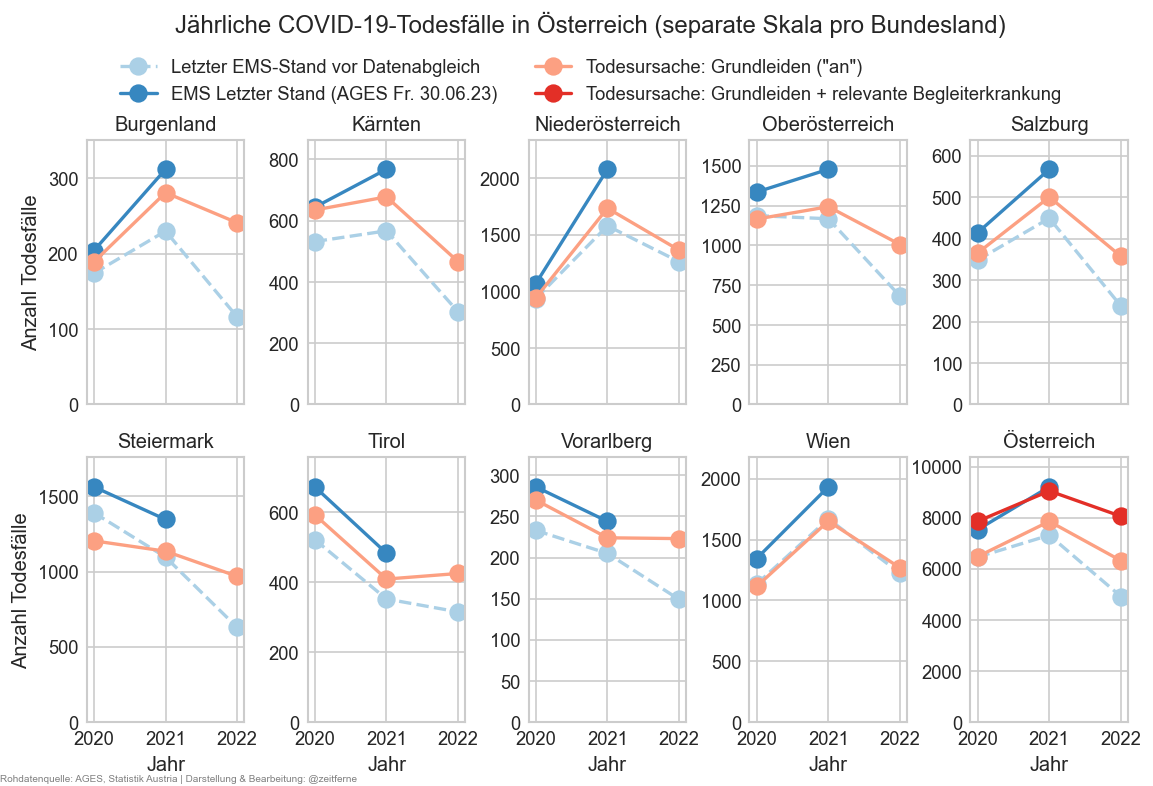
fs.query("Datum >= '2023-01-01' and Bundesland == 'Österreich'")["AnzahlTot"].sum()
889
def draw_simple_dead_by_mdate(bl="Österreich"):
fig, ax = plt.subplots()
make_wowg_diag(
ages1m[ages1m["Bundesland"] == bl], "Verstorbene nach Meldedatum", ax,
ccol="AnzahlTot", label="COVID-Tote", ndays=MIDRANGE_NDAYS, pltdg=False, pltg7=True)
ax.plot(mmx[mmx["Bundesland"] == bl].set_index("Datum")["AnzahlTot"].rolling(7).mean().iloc[-MIDRANGE_NDAYS:],
color="k", marker="_", lw=0)
ax.set_ylim(bottom=0)
ax.set_title(None)
fig.legend(frameon=False, ncol=3, loc="upper center", bbox_to_anchor=(0.5, 0.94))
fig.suptitle(bl + ": COVID-Tote nach Meldedatum" + AGES_STAMP, y=0.97)
if DISPLAY_SHORTRANGE_DIAGS:
draw_simple_dead_by_mdate()
AT_DEAD_PERIOD_STARTS = {
"Wildtyp bis Herbst": fs_at.iloc[0]["Datum"],
"Wildtyp ab Herbst": pd.to_datetime('2020-09-01'),
"Alpha": pd.to_datetime('2021-03-01'),
"Delta": pd.to_datetime('2021-08-01'),
"Omikron BA.1&2 (unvollst.)": pd.to_datetime('2022-01-15'),
"Omikron BA.5 (unvollst.)": pd.to_datetime('2022-06-20'),
"Suppe, XBB (unvollst.)": pd.to_datetime('2022-11-15'),
}
sharey=False
ndays=MIDRANGE_NDAYS
mms0 = mms.copy()#.query("Datum < '2022-10-01'")
with cov.calc_shifted(mms0, "BundeslandID", 14):
mms0["Tote_s14"] = mms0["AnzahlTot"].rolling(14).sum()
mms0["Tote_s14c"] = erase_outliers(mms0["AnzahlTot"], mode="zero").rolling(14).sum()
mms0["Tote_pp100k"] = mms0["Tote_s14"] / mms0["AnzEinwohner"] * 100_000
mms0["Tote_pp100kc"] = mms0["Tote_s14c"] / mms0["AnzEinwohner"] * 100_000
mms0 = mms0[mms0["Datum"] > mmx["Datum"].iloc[-1] - timedelta(ndays)]
def pltdeadtab(cleaned=False):
fig, axs = plt.subplots(5, 2, figsize=(10, 10), sharex=True, sharey=sharey)
#display(g.axes)
#ndays = len(mms0.query("Bundesland == 'Österreich'"))
style=dict(lw=1, mew=0, marker="." if ndays < 60 else None, markersize=5)
for k, ax in zip(fs["Bundesland"].unique(), axs.flat):
#print(k)
if ax in axs.T[0]:
ax.set_ylabel("Tote/100.000" if sharey else "COVID-Tote")
ax.set_title(k, y=0.92)
ages1m_oo = ages1m[ages1m["Bundesland"] == k]#.query("Datum < '2022-10-01'")
mms0_oo = mms0[mms0["Bundesland"] == k]#.query("Datum < '2022-10-01'")
mmx_oo = mmx[mmx["Bundesland"] == k]#.query("Datum < '2022-10-01'")
fs_oo = fs[fs["Bundesland"] == k]#.query("Datum < '2022-10-01'")
#if ax in axs.T[0] or not sharey:
#ax.set_ylim(top=fs_oo["AnzahlTot"].rolling(14).sum()[-100:].max() * 2)
if not sharey:
ax.tick_params(pad=-2, axis="y")
ax.yaxis.set_major_locator(matplotlib.ticker.MaxNLocator('auto', integer=True, min_n_ticks=4))
ax.plot(
fs_oo["Datum"].iloc[-ndays:],
(fs_oo["AnzahlTot"].rolling(14).sum() /
(fs_oo["AnzEinwohner"] / 100_000 if sharey else 1))
.iloc[-ndays:],
color="k", label="AGES nach Todesdatum", lw=3,
mew=0, marker="s" if style.get("marker") else None, markersize=4)
col = "Tote_pp100k" if sharey else "Tote_s14"
col = col + "c" if cleaned else col
ax.plot(
mms0_oo["Datum"],
mms0_oo[col],
color="C0", label="9:30-Bundesländermeldung", **style)
basedead = ages1m_oo["AnzahlTot"]
if cleaned:
basedead = erase_outliers(basedead, mode="zero")
ax.plot(
ages1m_oo["Datum"].iloc[-ndays:],
(basedead.rolling(14).sum() /
(ages1m_oo["AnzEinwohner"] / 100_000 if sharey else 1))
.iloc[-ndays:],
color="C1", label="AGES-Meldung", **style)
if haveages:
basedead = mmx_oo["AnzahlTot"]
ax.plot(
mmx_oo["Datum"].iloc[-ndays:],
(basedead.rolling(14).sum() /
(mmx_oo["AnzEinwohner"] / 100_000 if sharey else 1))
.iloc[-ndays:],
color="C1", label="AGES-Meldung ohne Alt-Nachmeldungen", ls="--", **style, alpha=0.7)
#labelend2(ax, mms0, "Tote_pp100k")
if ax in axs[-1]:
cov.set_date_opts(ax, mmx_oo["Datum"].iloc[-ndays:])
#ax.tick_params(labelsize="x-small", axis="x")
ax.set_xlim(right=ax.get_xlim()[1] + 1)
if ax is axs.flat[0]:
fig.legend(ncol=3, loc="upper center", frameon=False, bbox_to_anchor=(0.5, 0.96))
if ax is axs.flat[-1] or not sharey:
ax.yaxis.set_major_locator(matplotlib.ticker.MaxNLocator('auto', min_n_ticks=3))
ax.set_ylim(bottom=0)
#ax.set_title("Tote pro Woche pro 100.000 Einwohner je Bundesland lt. Morgenmeldung bis " + mms["Datum"].iloc[-1].strftime("%a %x"))
#cov.remove_labels_after(ax, "AnzEinwohner")
#ax.legend(*sortedlabels(ax, mms0, "Tote_pp100k"))
#ax.set_ylim(bottom=0)
#ax.set_xlim(right=ax.get_xlim()[1] + 1)
#cov.stampit(ax.figure, cov.DS_BMG)
#display(cov.filterlatest(mms0).set_index("Bundesland")[["Tote_s7"]])
fig.subplots_adjust(wspace=0.03 if sharey else 0.15)
fig.autofmt_xdate()
fig.suptitle("COVID-Tote, 14-Tage-Summen" + (", ausreißerbereinigt" if cleaned else ""))
if DISPLAY_SHORTRANGE_DIAGS:
#pltdeadtab()
pltdeadtab(cleaned=False)
cov=reload(cov)
def mark_periods(axs):
for ax in axs:
ax.axvspan(pd.to_datetime("2021-08-01"), pd.to_datetime("2022-01-15"), color="C3", alpha=0.2)
if DISPLAY_SHORTRANGE_DIAGS:
ndays = MIDRANGE_NDAYS#len(fs_at)
fig, axs = cov.plt_mdiff(fs, ages_old, "Bundesland", sharey=False, rwidth=1, ndays=ndays)#, vcol="AnzahlFaelle", name="Fälle")
for ax in axs[-1]:
ax.tick_params(labelrotation=55, axis="x")
fig.suptitle("Österreich: COVID-Tote je Bundesland" + AGES_STAMP, y=0.95)
#ages_oldx = ages_hist[ages_hist["FileDate"] == ages_hist.iloc[-1]["FileDate"] - timedelta(21)].copy()
#ages_oldx.rename(columns={"AnzahlTotTaeglich": "AnzahlTot"}, inplace=True)
fig, axs = cov.plt_mdiff(fs, ages_old7, "Bundesland", sharey=False, rwidth=1, ndays=ndays)#, vcol="AnzahlFaelle", name="Fälle")
for ax in axs[-1]:
ax.tick_params(labelrotation=55, axis="x")
fig.suptitle("Österreich: COVID-Tote je Bundesland in 7 Tagen" + AGES_STAMP, y=0.95)
#mark_periods(axs.flat)
selbl = 'Österreich'
ag_q = f"Altersgruppe != 'Alle' and Bundesland == '{selbl}'"
fig, axs = cov.plt_mdiff(
agd_sums.query(ag_q),
agd_sums_old.query(ag_q),
"Altersgruppe",
sharey=False,
rwidth=1, ndays=ndays)
fig.suptitle(selbl + ": COVID-Tote je Altersgruppe" + AGES_STAMP, y=0.95)
fig, axs = cov.plt_mdiff(
agd_sums.query(ag_q),
agd_sums_old7.query(ag_q),
"Altersgruppe",
sharey=False,
rwidth=1, ndays=ndays)
fig.suptitle(selbl + ": COVID-Tote je Altersgruppe in 7 Tagen" + AGES_STAMP, y=0.95)
#agd_prebig = agd_hist[agd_hist["FileDate"] == pd.to_datetime("2022-04-19")].copy()
#agd_postbig = agd_hist[agd_hist["FileDate"] == pd.to_datetime("2022-04-21")].copy()
#agd_sums_prebig = enrich_agd(agd_prebig, None)
#agd_sums_postbig = enrich_agd(agd_postbig, None)
#plt_mdiff(agd_sums.query(ag_q), agd_sums_old.query(ag_q),
# "Altersgruppe",
# sharey=False, rwidth=1, logview=False, vcol="AnzahlFaelle", name="Fälle")
if DISPLAY_SHORTRANGE_DIAGS:
ndays = 480
rwidth = 7
selbl = "Österreich"
fs_oo = fs.query(f"Bundesland == '{selbl}'").set_index("Datum").copy()
fs_oo["FileDate"] = fs_oo.index[-1] + timedelta(1)
fs_oo = fs_oo#.query("Datum <= '2023-01-01'")
fig, ax = plt.subplots()
cov.plt_mdiff1(
ax,
fs_oo,
#ages_hist.query(f"Bundesland == '{selbl}' and FileDate == '2023-01-02'").rename(columns={"AnzahlTotTaeglich": "AnzahlTot"}).set_index("Datum"),
#ages_old.query(f"Bundesland == '{selbl}' and Datum <= '2023-01-01'").rename(columns={"AnzahlTotTaeglich": "AnzahlTot"}).set_index("Datum"),
ages_old7.query(f"Bundesland == '{selbl}'").rename(columns={"AnzahlTotTaeglich": "AnzahlTot"}).set_index("Datum"),
vcol="AnzahlTot",
rwidth=rwidth, ndays=ndays, logview=False)#, vcol="AnzahlFaelle", name="Fälle")
cov.set_date_opts(ax, fs_oo.index[-ndays:] if ndays else fs_oo.index, showyear=True)
#cov.set_logscale(ax)
fig.suptitle(f"COVID-Tote in {selbl} in 7 Tagen, {rwidth}-Tage-Summen" + AGES_STAMP, y=0.95)
ax.legend(loc="upper right")
ax.set_ylabel("COVID-Tote")
fig.autofmt_xdate()
cov.stampit(fig)
selbl = "Österreich"
pltcol = "AnzahlTotSum"
fs_oo = fs.query(f"Bundesland == '{selbl}'").set_index("Datum")
ages_old_oo = ages_old.query(f"Bundesland == '{selbl}'").set_index("Datum")
fig, ax = plt.subplots()
args = dict(marker="", mew=0)
#ax.plot(ages_old_oo["AnzahlTotSum"], label="Tote nach Todesdatum, AGES gestern", color="C4", ls="--")
ax.plot(mms.query(f"Bundesland == '{selbl}'").set_index("Datum")[pltcol], label="Nach Meldedatum, 9:30-Krisenstabmeldung", **args)
ax.plot(ages1m.query(f"Bundesland == '{selbl}'").set_index("Datum")[pltcol], label="Nach Meldedatum, AGES", **args)
ax.plot(fs_oo[pltcol], label="Nach Todesdatum, AGES", **args)
#ax.plot(ems[ems["Bundesland"] == selbl].set_index("Datum")[pltcol], label="Nach Meldedatum, EMS", **args)
cov.set_date_opts(ax, ages1m["Datum"], showyear=True)
ax.legend()
fig.suptitle(f"{selbl}: Insgesamt gezählte COVID-Tote", y=0.93)
#ax.set_ylabel("Anzahl")
fig.autofmt_xdate()
#ax.set_ylim(bottom=0)
ax.set_ylim(bottom=ages1m.query(f"Bundesland == '{selbl}'")[pltcol].min() * 0.96)
ax.set_xlim(right=ax.get_xlim()[1] + 7)
cov.stampit(fig, cov.DS_BOTH)
ax.yaxis.set_major_locator(matplotlib.ticker.MultipleLocator(1000))
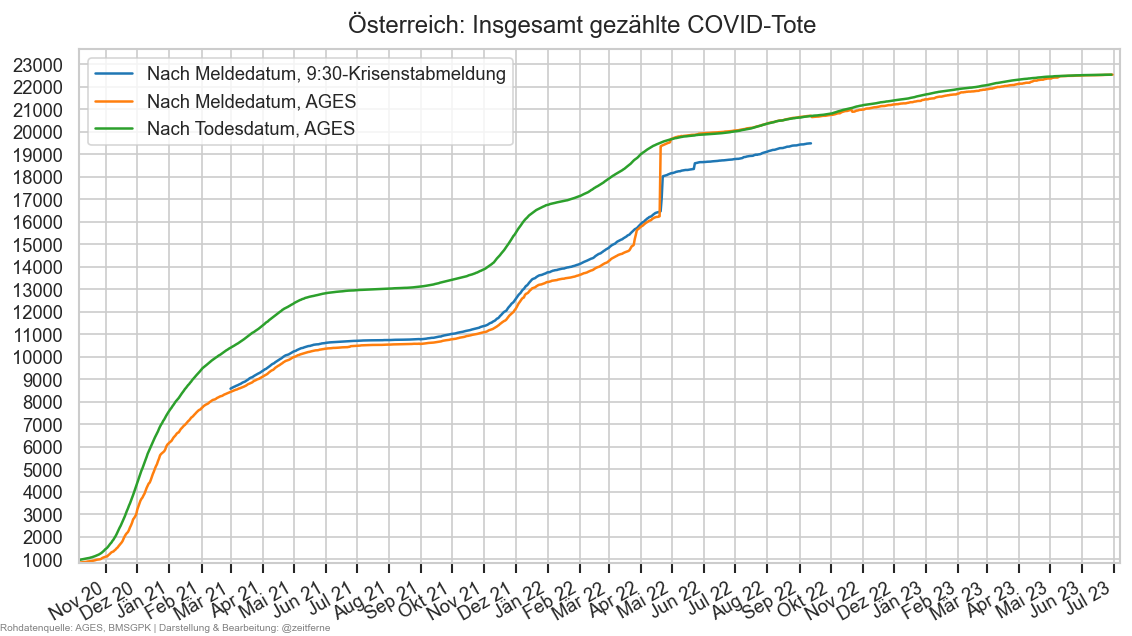
def pltmdelay(selbl, ndays=2000):
query = f"Bundesland == '{selbl}'"#" and Datum <= '2023-01-01'"
#ages40_at = ages_hist[ages_hist["FileDate"] == ages_hist["Datum"] + timedelta(22)].query(query)
ages9_at = ages_hist[ages_hist["FileDate"] == ages_hist["Datum"] + timedelta(10)].query(query)
ages1_at = ages1.query(query)
mms_at = mms.query(query)
mmx_at = mmx.query(query)
ages1m_at = ages1m.query(query)
fsq = fs.query(query)
def pltdata(xs):
xs = xs.set_index("Datum")
if "AnzahlTot7Tage" not in xs.columns:
res = xs["AnzahlTot"].rolling(7).sum()
else:
res = xs["AnzahlTot7Tage"]
return res[res.index >= mmx_at.iloc[-1]["Datum"] - timedelta(ndays)]
with cov.with_palette("plasma_r", n_colors=2):
fig, ax = plt.subplots()
ax.plot(pltdata(ages1_at), label="Am Ende der jeweiligen Woche aktueller Stand", marker="." if ndays <= 400 else None, mew=0)
ax.plot(pltdata(ages9_at), label="Stand neun Tage nach Ende jeweiliger Woche")
#ax.plot(ages40_at["Datum"], ages40_at["AnzahlTot7Tage"], label="Stand 21 Tage nach dem Ende der jeweiligen Woche")
#ax.plot(ages40_at["Datum"], ages40_at["AnzahlTot7Tage"], label="40 Tage nach dem Ende der jeweiligen Woche")
ax.plot(pltdata(fsq).iloc[:-1], label="Letzter Stand", color="k")
#ax.plot(mms_at["Datum"], mms_at["AnzahlTot"].rolling(7).sum(), color=(0.2,)*3, lw=0.8,
# label="9:30-Meldung (nach Meldedatum)", ls="--")
#cov.set_logscale(ax)
ax.set_ylim(*ax.get_ylim())
ax.plot(pltdata(ages1m_at.assign(AnzahlTot7Tage=ages1m_at["AnzahlTot"].clip(lower=0).rolling(7).sum())),
color=(0.6,)*3, lw=1,
label="AGES-Meldung (nach Meldedatum)", ls="--")
#ax.plot(mmx_at["Datum"], mmx_at["AnzahlTot"].rolling(7).sum(), color=(0.6,)*3,
# label="Für Kennzahlen", ls=":")
cov.set_date_opts(ax, pltdata(fsq).index, autoyear=True,
#week_always=True
)
ax.set_xlim(right=ax.get_xlim()[1]+1)
#fig.autofmt_xdate()
ax.set_ylabel("Tote pro 7 Tage")
ax.set_ylim(bottom=0)
fig.suptitle(fsq.iloc[0]["Bundesland"] + ": Meldeverzug bei Todesfällen (7-Tage-Summen)" + AGES_STAMP,
y=0.98)
#ax.legend(fontsize="small", loc="upper right", bbox_to_anchor=(1.02, 1.02))
fig.legend(fontsize="small", ncol=2, loc="upper center", frameon=False, bbox_to_anchor=(0.5, 0.96))
fig.autofmt_xdate()
#ax.set_xlim(left=ages1_at["Datum"].iloc[0])
#ax.set_xlim(left=pd.to_datetime("2022-01-01"), right=fs_at["Datum"].iloc[-1] + timedelta(7))
#ax.set_ylim(top=500)
#ax.set_ylim(bottom=9)
#cov.set_logscale(ax)
return ax
pltmdelay("Österreich")
#ax = pltmdelay("Tirol")
#ax.set_ylim(bottom=0.7, top=30)
ax = pltmdelay("Niederösterreich")
#ax.set_ylim(bottom=0.7, top=200)
ax = pltmdelay("Wien")
ax = pltmdelay("Oberösterreich")
#ax.set_ylim(bottom=2, top=150)
#ax = pltmdelay("Vorarlberg")
#ax.set_ylim(bottom=0.7, top=30)
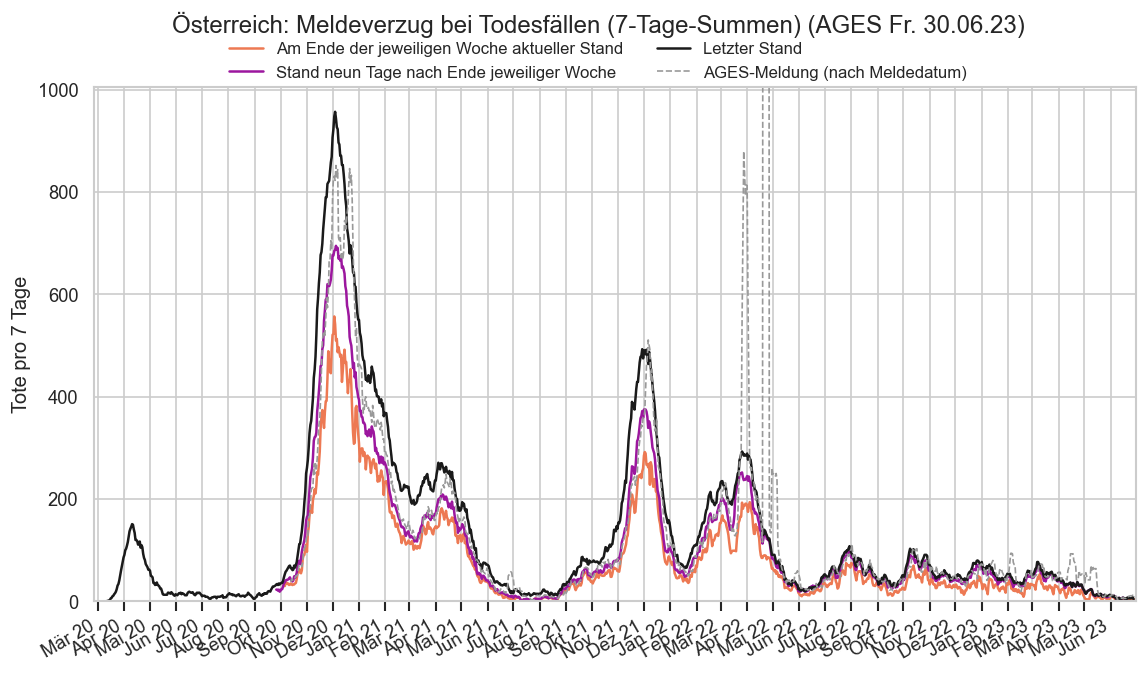
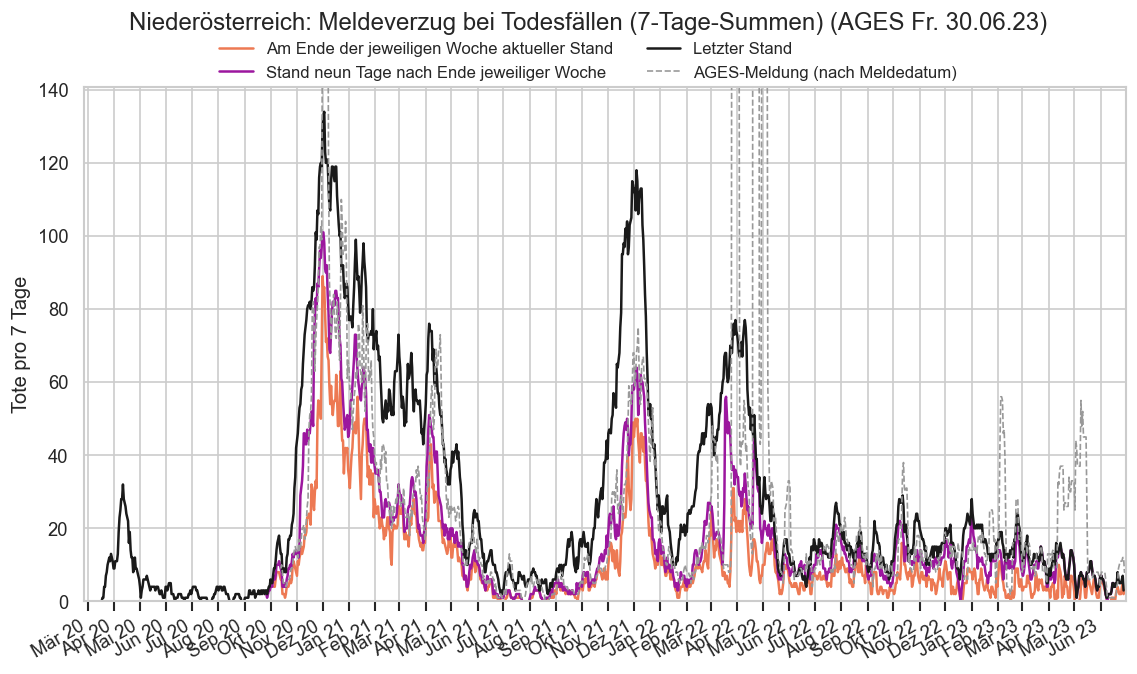
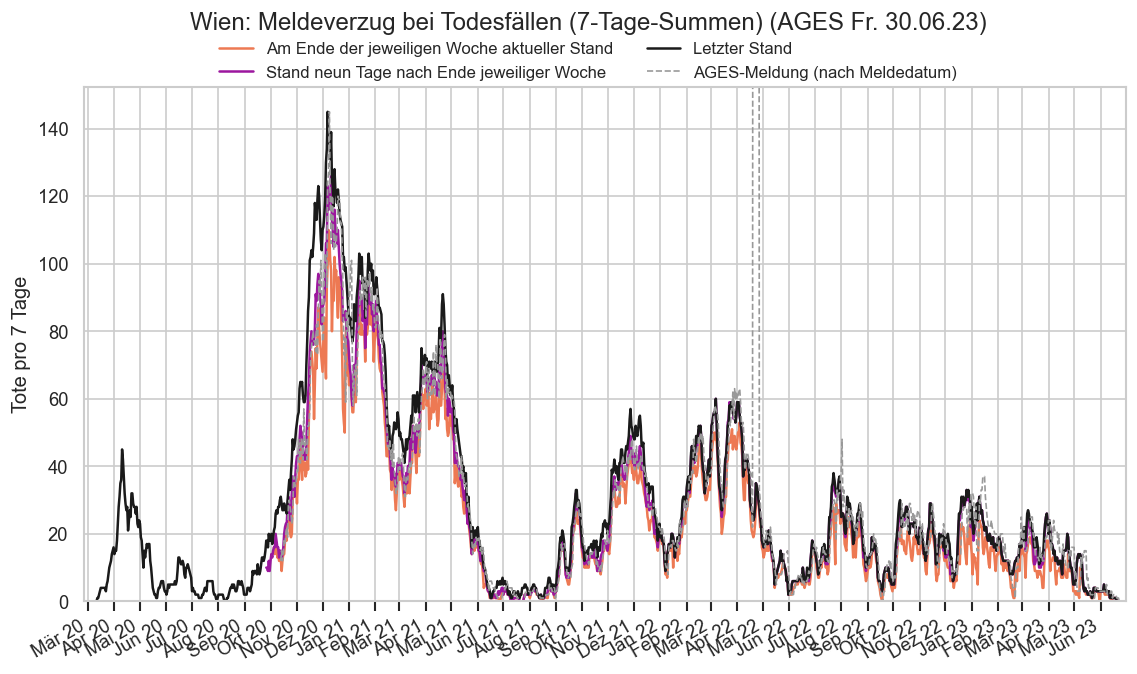
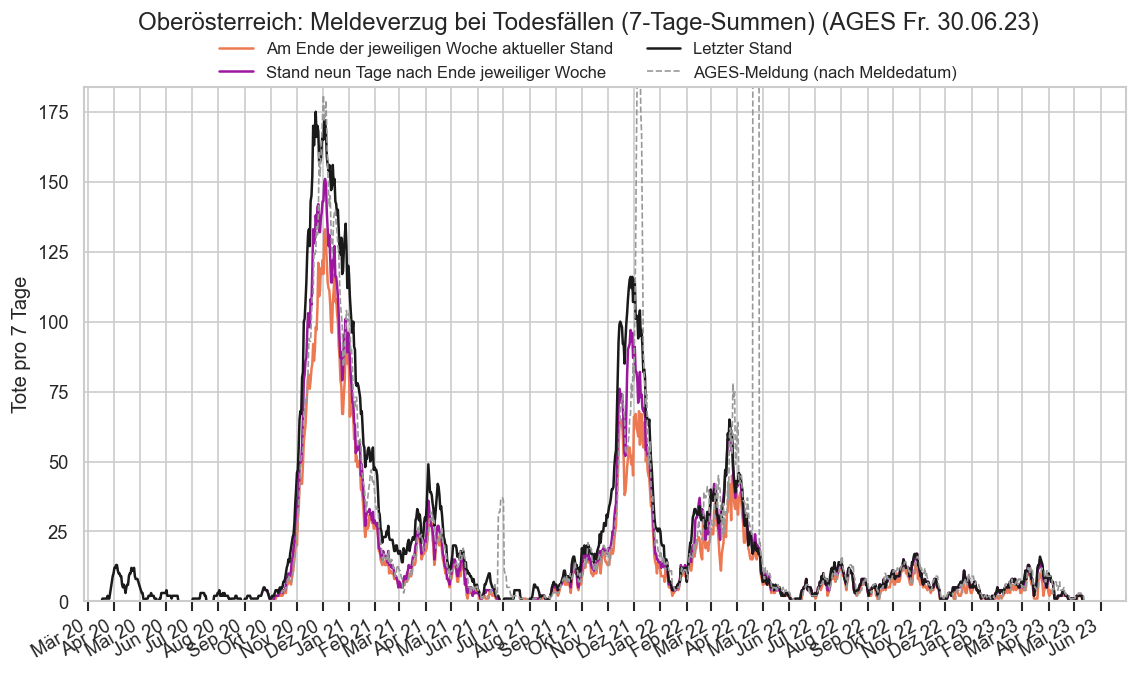
cov=reload(cov)
import calendar
def plt_completeness_avg_by_delay(ax: plt.Axes):
selbl = "Österreich" # Welches Bundesland wird betrachtet?
enddelay = 120 # Wie viele Tage Nachmeldungen werden berücksichtigt?
weekday = None # Soll die Betrachtung auf einen bestimmten Berichts-Wochentag eingeschränkt werden?
mindead = 2 # Wie viele Tote müssen am Enddatum (enddelay) mindestens gezählt sein?
pi = 80 # Wie viel Prozent der Daten soll die eingezeichnete Fläche einschließen?
hist_at = ages_hist.query(f"Bundesland == '{selbl}' and Datum >= '2022-05-01'").copy()
hist_at = hist_at[
(hist_at["Datum"] > hist_at.iloc[0]["FileDate"]) &
(hist_at["Datum"] + timedelta(enddelay) <= hist_at.iloc[-1]["FileDate"])]
hist_at["delay"] = hist_at["FileDate"] - hist_at["Datum"]
curdead = (
hist_at[hist_at["Datum"] + timedelta(enddelay) == hist_at["FileDate"]]
#hist_at[hist_at["FileDate"] == hist_at.iloc[-1]["FileDate"]]
.set_index("Datum")["AnzahlTot7Tage"])
#print(curdead.loc[pd.to_datetime("2021-07-23")])
#delay = hist_at.index.get_level_values("FileDate") - hist_at.index.get_level_values("FileDate")[-1]
hist_at.set_index(["Datum", "FileDate"], inplace=True)
#fs_at.set_index("Datum")["AnzahlTot"]
completeness = (hist_at["AnzahlTot7Tage"] / curdead)
hist_at["completeness"] = completeness
idxfrm = completeness.index.to_frame()
#completeness = completeness[]
#& (idxfrm["Datum"] >= pd.to_datetime("2022-01-01"))
#& (idxfrm.iloc[-1]["FileDate"] - idxfrm["FileDate"] > timedelta(60))]
#mcompl = completeness.groupby(hist_at["delay"]).mean()
sel = (
np.isfinite(completeness) &
(hist_at["delay"] <= timedelta(enddelay)) &
(hist_at["delay"] >= timedelta(1)) &
((idxfrm["Datum"].dt.weekday == weekday) if weekday is not None else True))
sel2 = sel & (curdead >= mindead)
#set(sel[sel].index.get_level_values("Datum")) - set(sel2[sel2].index.get_level_values("Datum"))
sel = sel2
#display(completeness[sel].groupby("Datum").count().describe())
#print(idxfrm["Datum"][sel].nunique(), idxfrm["FileDate"][sel].nunique())
dx = hist_at["delay"][sel].dt.days
#dy = -np.log(1 - completeness[sel].clip(upper=1))
#dy = 1 - completeness[sel].clip(upper=1)
dy = completeness[sel]
hue = idxfrm["Datum"][sel]
#display(hist_at[sel][(completeness <= 0.65) & (hist_at["delay"] >= timedelta(85))].reset_index()["Datum"].dt.strftime("%x").unique())
pirem = (100 - pi) / 2
sns.lineplot(
ax=ax, x=dx, y=dy, marker=".", errorbar=("pi", pi), estimator="median",
err_kws=dict(alpha=0.3))
#ax.set_ylim(*ax.get_ylim())
sns.lineplot(ax=ax, x=dx, y=dy, units=hue, estimator=None, legend=False, color="C4",
lw=0.5, zorder=0, alpha=1/3)
ax.xaxis.set_minor_locator(matplotlib.ticker.MultipleLocator(5))
ax.yaxis.set_minor_locator(matplotlib.ticker.MultipleLocator(0.05))
#ax.set_ylim(bottom=0.44, top=1.06)
ax.grid(axis="both", which="minor", lw=0.3)
#cov.set_logscale(ax)
#ax.yaxis.set_major_locator(matplotlib.ticker.MultipleLocator(0.1))
#cov.set_logscale(ax, axis="x")
#ax.set_ylim(bottom=0.001)
cov.set_percent_opts(ax, decimals=0)
ax.set_ylabel("Vollständigkeit 7-Tage-Summe COVID-Toter")
ax.set_xlabel("Tage nach Todesdatum")
ax.figure.suptitle(
cov.SHORTNAME2_BY_BUNDESLAND[selbl] + f": Meldevollständigkeit 7-Tage-Todesfälle im Vergleich zu {enddelay} Tage nach Todesdatum"
+ ("" if weekday is None else ", nur " + calendar.day_name[weekday]),
y=1)
ddrange = dy.index.get_level_values("Datum")
nddate = ddrange.nunique()
#display(
# hist_at.loc[sel & (completeness >= 0.85)][["AnzahlTot7Tage", "delay"]]
# #.query("Datum == '2021-11-15'")
# .groupby("Datum")["delay"].min().quantile(0.85 + 0.15/2)
#)
mdat = 1 - hist_at[sel]["completeness"].clip(upper=1)
#display(mdat.to_numpy())
#print(weibull_min.fit(mdat, floc=-1/enddelay, fscale=1/enddelay))
ax.set_title(
f"Es werden nur 7-Tage-Abschnitte (inkl. überlappender) betrachtet,"
f" deren Endsumme nach {enddelay} Tagen mindestens {mindead} beträgt."
f"\nDie Fläche markiert den Bereich, in den {pi:n}% aller 7-Tage-Abschnitte fallen (d.h. je {pirem:n}% sind darunter/darüber), die Linie den Median.\n"
f"Inkludiert: {nddate} Todesdaten {ddrange[0].strftime('%x')}‒{ddrange[-1].strftime('%x')} zu je {enddelay} Datenständen",
fontsize="small")
cov.stampit(ax.figure)
#ax.plot(mcompl.index.days, mcompl)
plt_completeness_avg_by_delay(plt.gca())
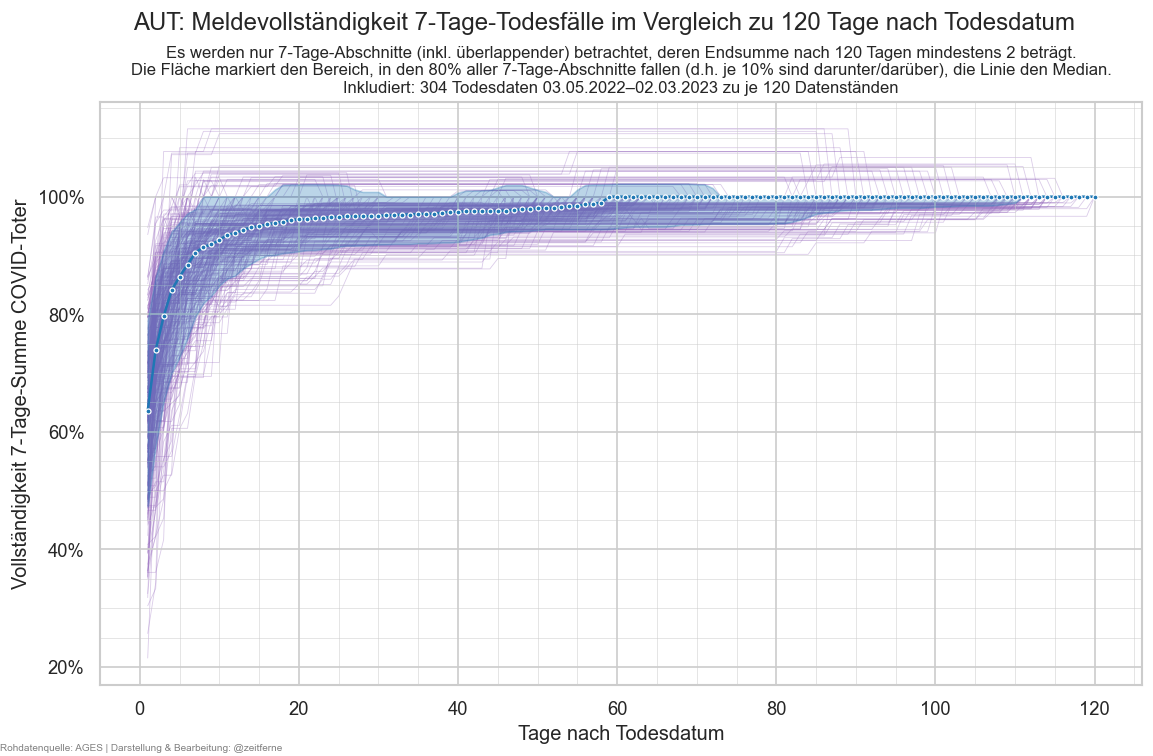
selbl = "Österreich"
def get_nachm(selbl):
d23e = ages_hist.query(
f"Bundesland == '{selbl}' and Datum == '2022-12-31'").set_index("FileDate")["AnzahlTotSum"]
#d23b = ages_hist.query(
# f"Bundesland == '{selbl}' and Datum == '2021-12-31'").set_index("FileDate")["AnzahlTotSum"]
#d23e -= d23b
d23e -= d23e.iloc[0]
return d23e.iloc[1:]
def plt_nachm(selbl):
return get_nachm(selbl).plot(marker=".", label=selbl)
ax = plt_nachm("Niederösterreich")
(get_nachm("Österreich") - get_nachm("Niederösterreich")).plot(marker=".", label="Rest von Österreich")
cov.set_date_opts(ax)
fig = ax.figure
fig.suptitle("Nachgemeldete COVID-Tote bis inkl. Todesdatum 31.12.2022 je Meldedatum", y=.93)
ax.set_xlim(right=ax.get_xlim()[1] + 7)
ax.set_ylabel("Anzahl Todesfälle (kumulativ)")
ax.set_xlabel("Meldedatum")
ax.legend()
<matplotlib.legend.Legend at 0x1990f5ee150>
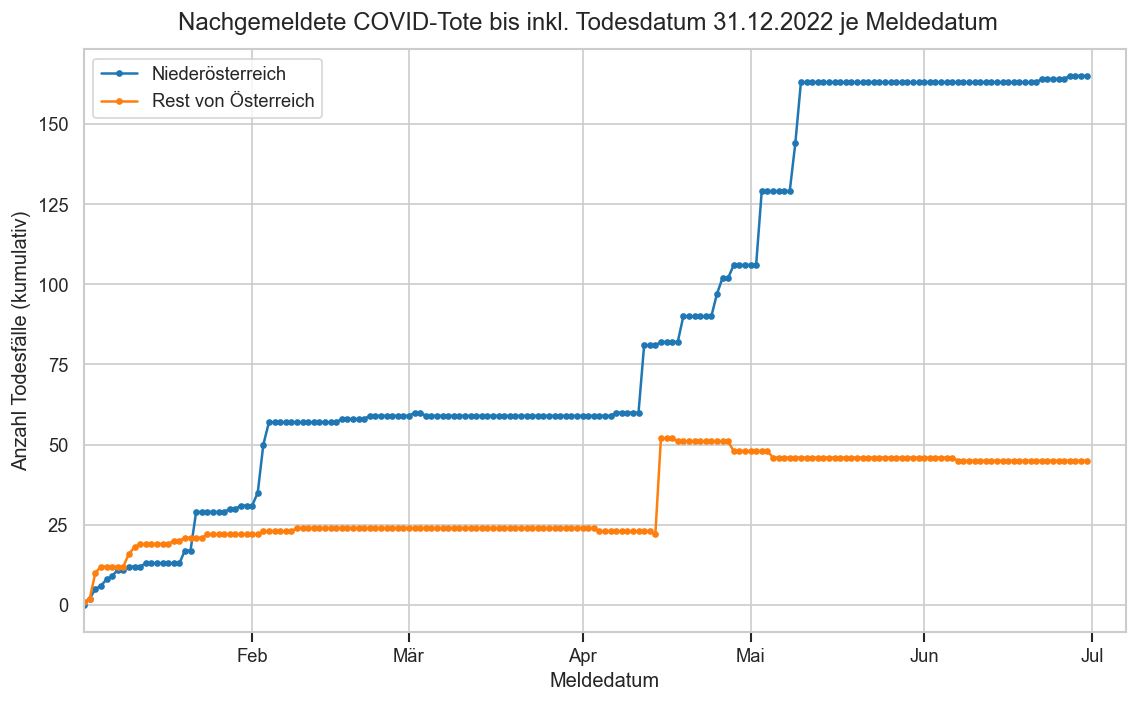
if False:
ages_hist0 = ages_hist.copy()
#ages_hist0["AnzahlTot7Tage"] = ages_hist0["AnzahlTot7Tage"].astype(int)
(
ages_hist0.sort_values(["FileDate", "Datum", "BundeslandID", "Bundesland"])
[["FileDate", "Datum", "BundeslandID", "Bundesland", "AnzahlTotSum", "AnzahlTotTaeglich", "AnzahlTot7Tage"]]
).to_csv("TodesfaelleHist.csv.zip", index=False, sep=";")
from operator import sub, truediv
rwidth = 21
def plt_dmdiff_ax(ax, selbl="Niederösterreich", relative=True, fromdate=None):
ages1m_oo = ages1m.query(f"Bundesland == '{selbl}'").set_index("Datum")
mms_oo = mms.query(f"Bundesland == '{selbl}'").set_index("Datum")
fs_oo = fs.query(f"Bundesland == '{selbl}'").set_index("Datum")
base = 1 if relative else 0
op = truediv if relative else sub
agesrate = op(ages1m_oo["AnzahlTot"].rolling(rwidth).sum().shift(1, freq="D"), mms_oo["AnzahlTot"].rolling(rwidth).sum())
fsrate = op(fs_oo["AnzahlTot"].rolling(rwidth).sum().shift(1, freq="D"), mms_oo["AnzahlTot"].rolling(rwidth).sum())
if fromdate is not None:
agesrate = agesrate[agesrate.index >= fromdate]
fsrate = fsrate[fsrate.index >= fromdate]
#print(fsrate.iloc[-1:])
#display(fsrate)
#display(agesrate.describe())
#fig, ax = plt.subplots()
#ax.plot(agesrate, color="k")
ax.plot(fsrate, color="grey", lw=0.8, zorder=8, label="AGES nach Todesdatum")
#kwargs=dict(alpha=0.8, width=timedelta(1), aa=True, snap=False, lw=0)
#ax.bar(agesrate.index, bottom=base, height=(agesrate - base).where(agesrate > base), label="AGES meldet mehr", **kwargs)
#ax.bar(agesrate.index, bottom=base, height=(agesrate - base).where(agesrate < base), color="r", label="AGES meldet weniger", **kwargs)
kwargs=dict(alpha=0.8)
ax.fill_between(agesrate.index, base, agesrate, where=agesrate > base, label="AGES meldet mehr", **kwargs)
ax.fill_between(agesrate.index, base, agesrate, where=agesrate < base, color="r", label="AGES meldet weniger", **kwargs)
#ax.legend()
#cov.set_date_opts(ax, showyear=True)
#fig.autofmt_xdate()
#cov.set_percent_opts(ax)
if not relative:
ax.set_ylim(
bottom=max(ax.get_ylim()[0], min(-5, agesrate.quantile(0.25) * 2)),
top=min(ax.get_ylim()[1], max(5, agesrate.quantile(0.75) * 2)))
ax.axhline(base, color="k", lw=0.5)
if agesrate.index[0].date() < date(2022, 1, 1):
ax.axvline(date(2022, 1, 1), color="k", lw=0.5)
def plt_dmdiff(relative=True):
fig, axs = plt.subplots(nrows=5, ncols=2, sharex=True, sharey=relative, figsize=(9, 9))
fig.suptitle(
f"Todesfälle {'als Anteil' if relative else 'i.Vgl. zur'} der 9:30-Meldung, {rwidth}-Tage-Summen",
y=0.95)
for ax, bl in zip(axs.flat, cov.SHORTNAME2_BY_BUNDESLAND.keys()):
plt_dmdiff_ax(ax, bl, relative=relative, fromdate=mms.iloc[-1]["Datum"] - timedelta(200))
if ax is axs.flat[0]:
fig.legend(loc="upper center", frameon=False, ncol=3, bbox_to_anchor=(0.5, 0.94))
ax.set_title(bl, y=0.95)
#break
if relative:
axs.flat[0].set_ylim(bottom=0, top=2)
axs.flat[0].yaxis.set_major_locator(matplotlib.ticker.MultipleLocator(0.5))
cov.set_percent_opts(axs.flat[0])
fig.subplots_adjust(wspace=0.02, hspace=0.25)
cov.set_date_opts(axs.flat[-1], showyear=True)
fig.autofmt_xdate()
if not relative:
for ax in axs.flat:
ax.yaxis.set_major_locator(matplotlib.ticker.MaxNLocator('auto', integer=True, min_n_ticks=3))
#ax.relim()
#ax.autoscale_view()
if False:
plt_dmdiff(relative=True)
plt_dmdiff(relative=False)
def make_wowg_dead_fig(bl):
fig = plt.Figure(figsize=(16*0.7, 8))#figsize=(16/2, 8))
axs = fig.subplots(nrows=3)
axs2 = []
fig.subplots_adjust(hspace=0.35)
kwargs = dict(ccol="AnzahlTot", label="COVID-Tote", ndays=MIDRANGE_NDAYS, pltdg=False, pltg7=True)
axs2.append(make_wowg_diag(
ages1m[ages1m["Bundesland"] == bl], "Verstorbene nach Meldedatum", axs[len(axs2)], **kwargs))
fig.legend(frameon=False, ncol=2, loc="upper center", bbox_to_anchor=(0.5, 0.96))
#axs2.append(make_wowg_diag(
# mms[mms["Bundesland"] == bl], f"Verstorbene nach Meldedatum (9:30-Krisenstabmeldung {mms['Datum'].iloc[-1].strftime('%a %x')})",
# axs[len(axs2)], **kwargs))
axs2.append(make_wowg_diag(
fs[fs["Bundesland"] == bl], "Verstorbene nach Todesdatum", axs[len(axs2)], **kwargs))
ages2 = ages_hist[ages_hist["FileDate"] == ages_hist["Datum"] + timedelta(2)].rename(columns={
"AnzahlTotTaeglich": "AnzahlTot"})
axs2.append(make_wowg_diag(
ages2[ages2["Bundesland"] == bl], "Verstorbene nach Todesdatum ‒ Nur Zweitmeldung",
axs[len(axs2)], **kwargs))
same_axlims(axs[:], axs2[:] if axs2[1] is not None else None, minbottom=-2)
#same_axlims(axs[-2:], axs2[-2:])
fig.suptitle(bl + ": COVID-Tote" + AGES_STAMP, y=0.98)
if False:
for ax in axs[:1]:
ax.set_ylim(top=min(ax.get_ylim()[1], max(10.5,
mms[mms["Bundesland"] == bl]["AnzahlTot"]
.iloc[-SHORTRANGE_NDAYS:]
.quantile(0.9, interpolation="higher") * 2)),
bottom=0)
if axs2[0] is not None:
for ax in axs2:
ax.set_ylim(top=min(ax.get_ylim()[1], 1), bottom=max(ax.get_ylim()[0], -1))
display(fig)
if DISPLAY_SHORTRANGE_DIAGS:
make_wowg_dead_fig("Österreich")
if DISPLAY_SHORTRANGE_DIAGS:
make_wowg_dead_fig("Niederösterreich")
def drawdbl():
fs0 = fs.copy()
with cov.calc_shifted(fs0, "Bundesland", 14, newcols=["dead14"]):
fs0["dead14"] = fs0["AnzahlTot"].rolling(14).sum() / fs0["AnzEinwohner"] * 100_000
fs0 = fs[(fs["Datum"] <= fs["Datum"].iloc[-1] - timedelta(9))].copy()
fsc = fs[fs["Datum"] >= fs["Datum"].iloc[-1] - timedelta(9)].copy()
ax = sns.lineplot(data=fs0, x="Datum", y="dead28", hue="Bundesland", err_style=None)
sns.lineplot(ax=ax, data=fsc, x="Datum", y="dead28", hue="Bundesland", ls=":", legend=False,
err_style=None)
ax.legend(*sortedlabels(ax, fs0, "dead28", fmtval=lambda v: f"{v:.2n}"), ncol=2, fontsize="x-small")
#ax.set_yscale("log")
cov.set_logscale(ax)
cov.set_date_opts(ax, pd.concat([fs0["Datum"], fsc["Datum"]]), showyear=True)
ax.yaxis.set_major_formatter(matplotlib.ticker.StrMethodFormatter("{x:n}"))
ax.figure.autofmt_xdate()
#ax.yaxis.set_major_locator(matplotlib.ticker.LogLocator(base=10, subs=[0.15, 0.2, 0.3, 0.5, 0.7, 1]))
#ax.yaxis.set_major_formatter(matplotlib.ticker.ScalarFormatter())
#ax.set_ylim(bottom=0.5, top=30)
labelend2(ax, fs0, "dead28", 100)
ax.figure.suptitle("Tote pro 4 Wochen pro 100.000 Einwohner je Bundesland, logarithmisch")
ax.set_title("Letzte 9 Tage strichliert, da meist noch sehr unvollständig (fehlende Nachmeldungen)")
ax.set_ylabel("Summe Tote pro 4 Wochen pro 100.000 Einwohner");
#ax.set_xlim(left=date(2021, 9, 1), right=date(2021, 11, 20))
#ax.set_ylim(top=10)
drawdbl()
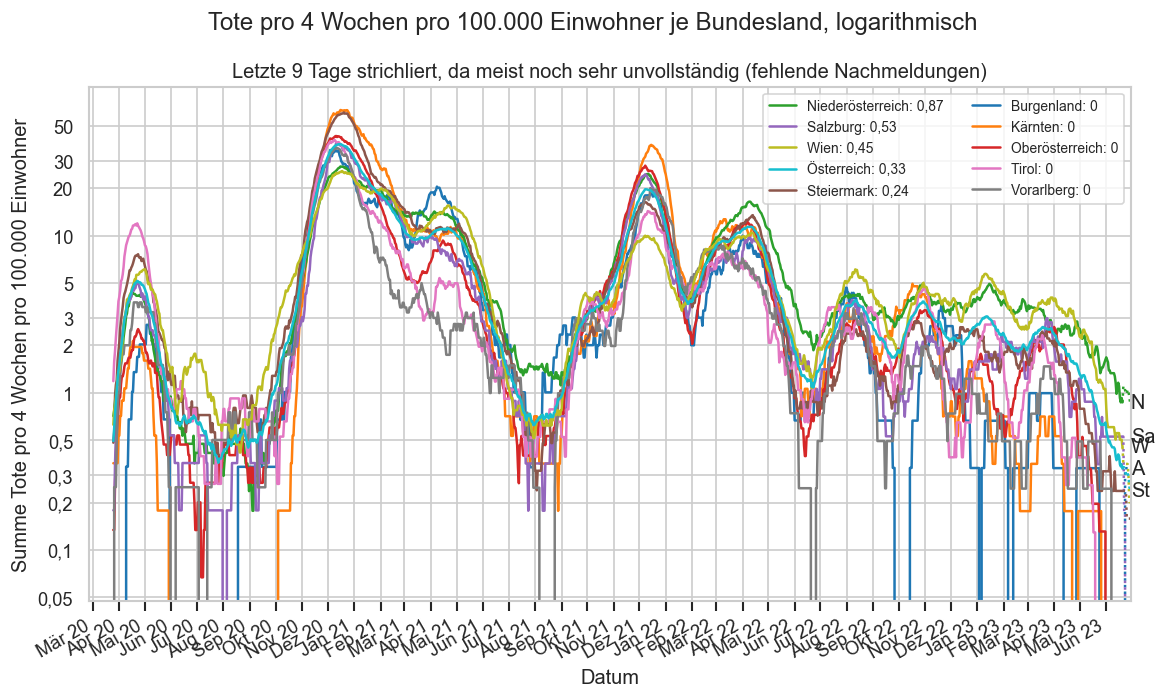
cov=reload(cov)
def plt_drates(agd_sums_at0):
with cov.calc_shifted(agd_sums_at0, "Altersgruppe", 14, newcols=["dead14"]):
agd_sums_at0["dead14"] = agd_sums_at0["AnzahlTot"].rolling(14).sum() / agd_sums_at0["AnzEinwohner"] * 100_000
agd_sums_at0.sort_values(by=["AltersgruppeID", "Datum"], inplace=True)
agd_sums_at0.reset_index(drop=True)
agd_sums_at = agd_sums_at0[agd_sums_at0["Datum"] <= agd_sums_at0["Datum"].iloc[-1] - timedelta(9)].copy()
agd_sums_cont = agd_sums_at0[agd_sums_at0["Datum"] >= agd_sums_at0["Datum"].iloc[-1] - timedelta(10)].copy()
#display(agd_sums_cont)
with cov.with_age_palette():
ax = sns.lineplot(data=agd_sums_at, x="Datum", y="dead14", hue="Altersgruppe", lw=2, err_style=None,)
sns.lineplot(data=agd_sums_cont, ax=ax, x="Datum", y="dead14", hue="Altersgruppe", legend=False,
lw=0.6, err_style=None,)
ax.legend(*sortedlabels(ax, agd_sums_at, "dead14", cat="Altersgruppe", fmtval=lambda v: f"{v:.2n}"), ncol=2, loc="upper left", fontsize="x-small")
cov.set_logscale(ax, reduced=True)
ax.yaxis.set_major_formatter(matplotlib.ticker.StrMethodFormatter("{x:n}"))
cov.set_date_opts(ax, showyear=True)
ax.figure.autofmt_xdate()
ax.set_ylim(bottom=0.051)
labelend2(ax, agd_sums_at, "dead14", cats="Altersgruppe", shorten=lambda ag: ag)
ax.set_title("COVID-Tote pro 2 Wochen pro 100.000 Einwohner je Altersgruppe, logarithmisch")
ax.set_ylabel("Summe Tote pro 2 Wochen pro 100.000 Einwohner");
#ax.set_xlim(left=date(2021, 9, 1), right=date(2021, 11, 20))
#ax.set_ylim(top=10)
#agd_sums_at0 = agd_sums.query("Bundesland != 'Österreich' and Bundesland != 'Niederösterreich' and Altersgruppe != 'Alle'").copy()
#agd_sums_at0 = agd_sums_at0.groupby(["AltersgruppeID", "Datum"]).agg({"AnzahlTot": "sum", "Altersgruppe": "first", "AnzEinwohner": "sum"}).reset_index()
#plt_drates(agd_sums_at0)
#plt.gcf().suptitle("COVID-Tote/2 Wochen/100.000 EW ohne NÖ")
plt.figure()
agd_sums_at0 = agd_sums.query("Bundesland == 'Österreich' and Altersgruppe != 'Alle'").copy()
plt_drates(agd_sums_at0)
plt.figure()
agd_sums_at0 = agd_sums.query("Bundesland == 'Niederösterreich' and Altersgruppe != 'Alle'").copy()
plt_drates(agd_sums_at0)
plt.gcf().suptitle("Niederösterreich: COVID-Tote/2 Wochen/100.000 EW")
plt.figure()
agd_sums_at0 = agd_sums.query("Bundesland == 'Wien' and Altersgruppe != 'Alle'").copy()
plt_drates(agd_sums_at0)
plt.gcf().suptitle("Wien: COVID-Tote/2 Wochen/100.000 EW")
Text(0.5, 0.98, 'Wien: COVID-Tote/2 Wochen/100.000 EW')
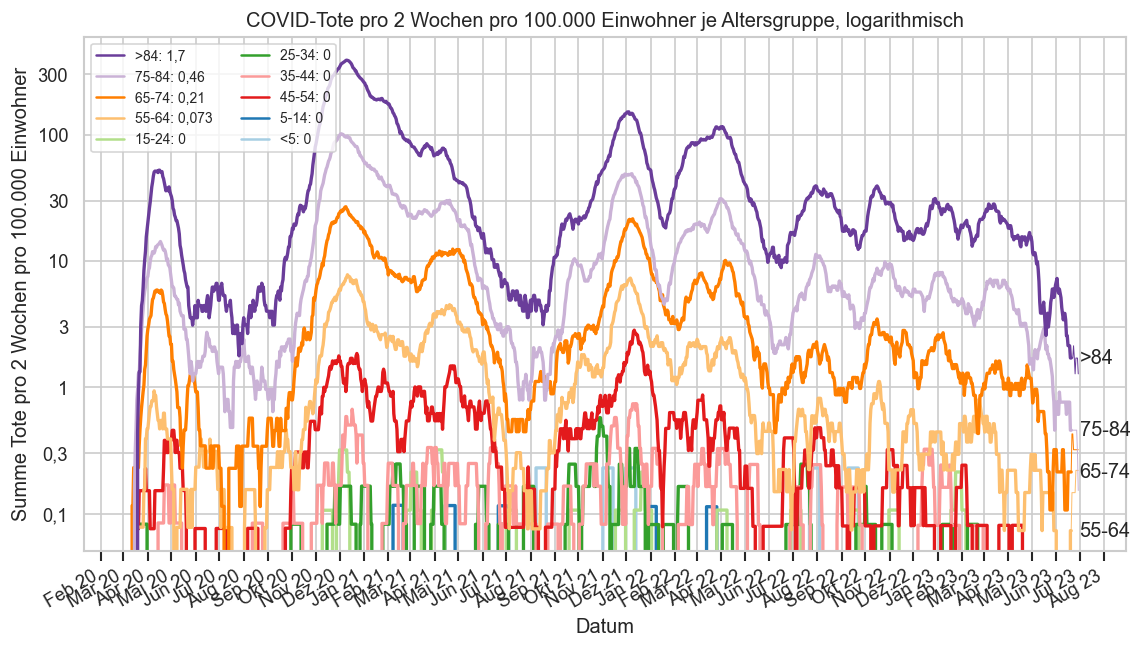
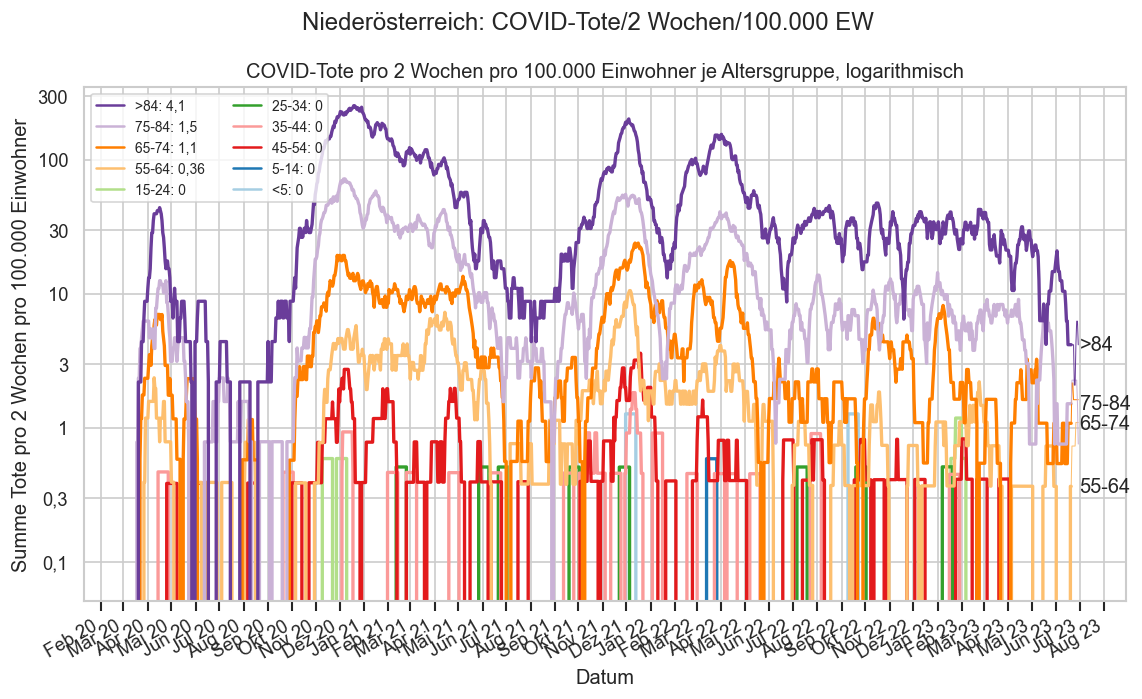
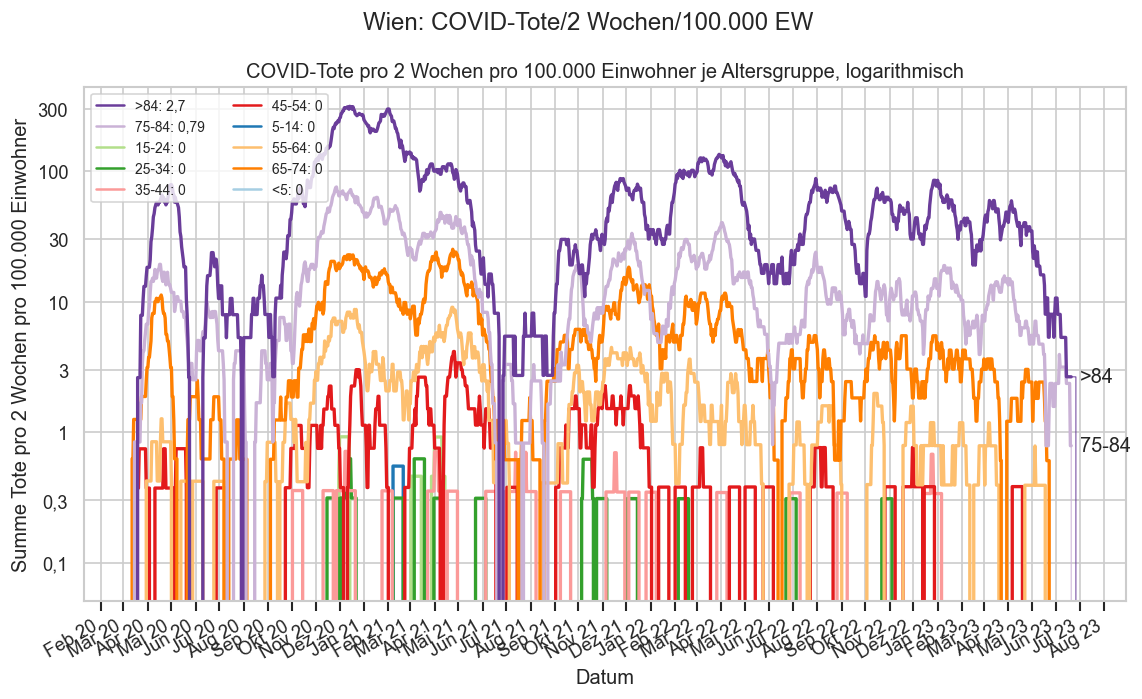
Erfasste Omikron-Tote nach Alter & Geschlecht¶
def write_d_tex():
fromdate = pd.to_datetime("2022-01-01")# list(AT_DEAD_PERIOD_STARTS.values())[-1]# "2022-01-15"
todate = pd.to_datetime("2023-01-01") #fs_at.iloc[-1]["Datum"] + timedelta(1) #list(AT_DEAD_PERIOD_STARTS.values())[3]
data0 = (agd[(agd["Datum"] >= fromdate) & (agd["Datum"] < todate)].query(f"AnzahlTot > 0 and Bundesland != 'Österreich'")
.set_index(["Datum", "Bundesland", "AltersgruppeID", "AgeFrom", "Altersgruppe", "Geschlecht"])
["AnzahlTot"]
.astype(int))
extra = []
while True:
gt1 = data0 > 1
if not gt1.any():
break
data0[gt1] -= 1
gt1rs = data0[gt1].copy()
gt1rs[:] = 1
extra.append(gt1rs)
data0 = pd.concat([data0] + extra)
data0 = data0.sort_index().reset_index().drop(columns="AltersgruppeID")
data0["Bundesland"] = data0["Bundesland"].map(cov.SHORTNAME2_BY_BUNDESLAND)
data0["sum"] = data0["AnzahlTot"].cumsum()
mtot = data0["AnzahlTot"].max()
data0 = data0[["Datum", "AgeFrom", "sum", "Bundesland", "Altersgruppe", "Geschlecht"]]
with open("d.tex", "w", encoding="utf-8", newline="\n") as f:
f.write(r"\newcommand*\rptstartdt{" + pd.to_datetime(fromdate).strftime("%a %d.%m.%Y") + "}\n")
f.write(r"\newcommand*\rptenddt{" + pd.to_datetime(todate).strftime("%a %d.%m.%Y") + "}\n")
f.write(r"\newcommand*\rptdatadt{" + pd.to_datetime(ages_vdate).strftime("%a %d.%m.%Y") + "}\n")
for dt in data0["Datum"].unique():
rows = data0[data0["Datum"] == dt].drop(columns="Datum")
#print(type(rows))
#if len(rows) <= 0:
# continue
f.write(f"\\rptdayhead{{{pd.to_datetime(dt).strftime('%a %x')}}}\n")
#print(type(rows))
if False:
f.write(rows.to_string(formatters={
"Altersgruppe": lambda ag: ag.ljust(5),
"Bundesland": lambda bl: bl.ljust(5),
"Geschlecht": lambda gs: gs.lower(),
"sum": lambda n: str(n).rjust(4),
}, sparsify=True, index=False, header=False))
else:
f.write("\\begin{tabbing}\\rptdaytabs\n")
isfirst = True
for row in rows.itertuples():
cellmark = f"\\rptnextrow{{{(row.AgeFrom / 85) * 100}}} "
f.writelines((
"\\\\\n" if not isfirst else "",
cellmark, r"\makebox[\rptidxw][r]{", str(row.sum), " } \\> ", cellmark,
(" \\> " + cellmark).join(map(str, row[3:])),
))
isfirst = False
#f.write("\n".join(r"\rptnextrow{" + + r"} \>" + ln.replace("&", "\\'", 1) for ln in
# rows.to_csv(sep="&", header=False, index=False, line_terminator="\n").rstrip()
# .replace("\n", " \\\\\n").split("\n")).replace("&", " \\> "))
f.write("\n\\end{tabbing}\n")
f.write("\n\n")
if False:
write_d_tex()
#sterbe_o = pd.read_csv("sterbe_ag_kw.csv", encoding="cp1252", skiprows=6, sep=";")
if False:
sterbe = sterbe_o.copy()
sterbe["Datum"] = pd.to_datetime(
sterbe["Kalenderwoche des Sterbedatums"]
.str.replace(r".+ bis (.+)\)", r"\1", regex=True),
dayfirst=True)
sterbe.drop(index=(sterbe[sterbe["Anzahl"] == "-"]).index, inplace=True)
sterbe["AnzahlTotAllCause"] = sterbe["Anzahl"].astype(float)
sterbe.drop(columns=["Werte", "Unnamed: 5", "Kalenderwoche des Sterbedatums", "Anmerkungen", "Anzahl"], inplace=True)
agidmap = {f"{x * 5} bis {x * 5 + 4} Jahre": (x + 1) // 2 + 1 for x in range(1, 19)}
agidmap['bis 4 Jahre'] = 1
agidmap['95 Jahre und älter'] = 10
sterbe["AltersgruppeID"] = sterbe["Altersgruppe des Verstorbenen"].map(agidmap)
sterbe = sterbe.groupby(["AltersgruppeID", "Datum"]).sum().reset_index()
if False:
agd_sums_at_e = agd_sums.query("Bundesland == 'Österreich'").merge(
sterbe[["AltersgruppeID", "Datum", "AnzahlTotAllCause"]],
how="left", on=["AltersgruppeID", "Datum"], validate="many_to_one")
agd_sums_at_e.sort_values(by=["AltersgruppeID", "Datum"], inplace=True)
cov=reload(cov)
def plt_deads_cases(ax, agyoung, bymdat=False, pltcases=True, pltrolling=False, showincomplete=True):
#display(agyoung["Altersgruppe"].unique())
agyoung_s = agyoung[["AnzahlTotSum", "Datum", "AnzahlFaelle"]].copy().groupby(by="Datum").sum()
#agyoung_s["AnzahlTotAllCause"].fillna(0, inplace=True)
#display(agyoung["Altersgruppe"].unique())
#display(agyoung)
agyoung_s["ToteNeu"] = agyoung_s["AnzahlTotSum"].diff()
monthly = agyoung_s.groupby(pd.Grouper(freq="W")).agg({
"AnzahlTotSum": "last", "AnzahlFaelle": "sum", "ToteNeu": "sum"
#"AnzahlTotAllCause": "sum"
})
#monthly["ToteNeu"] = monthly["AnzahlTotSum"].diff()
#monthly.loc[monthly.index[0], "ToteNeu"] = monthly.iloc[0]["AnzahlTotSum"]
#print(monthly.index[0], monthly.iloc[0]["AnzahlTotSum"], monthly.loc[monthly.index[0], "ToteNeu"])
#monthly.drop(monthly[monthly["ToteNeu"] > monthly["AnzahlTotAllCause"]].index, inplace=True)
monthly.sort_index(inplace=True)
week_complete = agyoung["Datum"].iloc[-1] >= monthly.index[-1]
if agyoung["Datum"].iloc[0] > monthly.index[0] - timedelta(7):
#print("dropping", monthly.index[0], agyoung["Datum"].iloc[0])
monthly = monthly.iloc[1:]
if bymdat:
cutlatest = 0 if week_complete else 1
else:
cutlatest = 1 if agyoung["Datum"].iloc[-1] - monthly.index[-2] >= timedelta(9) else 2
#print(week_complete, agyoung["Datum"].iloc[-1], monthly.index[-1], cutlatest)
#monthly.loc[monthly["AnzahlTotAllCause"] == 0, "AnzahlTotAllCause"] = monthly["ToteNeu"]
#display(monthly["AnzahlTotAllCause"])
#display(monthly)
dtfmt = "%x %y"
#ax.bar(monthly.index, monthly["AnzahlTotAllCause"],
# #bottom=monthly["ToteNeu"],
# color="k", lw=0, width=-5, align="edge")
barargs = dict(
color="k", width=-5, align="edge",
snap=True,
aa=False)
bs = ax.bar(
monthly.index,
monthly["ToteNeu"],
#bottom=monthly["AnzahlTotAllCause"] - monthly["ToteNeu"].fillna(0),
lw=0,
**barargs
)
for i in range(1, cutlatest + 1):
bs[-i].set_alpha(0.3)
drolling = agyoung_s["ToteNeu"].rolling(7).sum()
if pltrolling:
ax.plot(drolling, color="k", alpha=0.8)
interp = False
if not week_complete and showincomplete and monthly["ToteNeu"].iloc[-1] < drolling.iloc[-1] and interp:
#xc = np.array([monthly.index[-1].date() - timedelta(5), monthly.index[-1].date()])
#print(xc, drolling.iloc[-1])
#print("at^", monthly.index[-1:], drolling.iloc[-1:] - monthly["ToteNeu"].iloc[-1:])
ax.bar(
monthly.index[-1:],
drolling.iloc[-1:].to_numpy() - monthly["ToteNeu"].iloc[-1:].to_numpy(),
bottom=monthly["ToteNeu"].iloc[-1:],
lw=0, alpha=0.07, **barargs)
#ax.yaxis.set_major_locator(matplotlib.ticker.MultipleLocator(2))
ax2 = None
if pltcases:
cases = agyoung_s["AnzahlFaelle"].rolling(7).sum()
if cases.max() > 7500:
div = 1000
else:
div = 1
ax2 = ax.twinx()
ax2.grid(False)
ax2.set_ylabel("Anzahl positiv Getestete" + (f" ({div})" if div != 1 else ""))
#ax2.yaxis.set_major_locator(matplotlib.ticker.LinearLocator(int(monthly["ToteNeu"].max() + 1)))
oldidx = monthly.index
#monthly.index -= timedelta(2.5)
#print("cases", cases.index[-1])
ax2.plot(cases / div, color="darkgrey")
complcases = monthly if week_complete else monthly.iloc[:-1]
ax2.plot(cases[cases.index.dayofweek == 0] / div,
color="darkgrey", mew=1, marker=".", mec="white", markersize=10, lw=0, alpha=0.6)
#if not week_complete:
# ax2.plot(monthly[-1:]["AnzahlFaelle"] / 1000, color="grey", marker="o", lw=0, mew=0.5, mec="white")
#ls[-1].set_alpha(0.5)
#monthly.index = oldidx
ax2.set_ylim(bottom=0)
cov.set_date_opts(ax, monthly.index if showincomplete else monthly.index[:-cutlatest], showyear=True)
ax.set_xlim(left=ax.get_xlim()[0] - 7)
ax.figure.autofmt_xdate()
locator = matplotlib.ticker.MaxNLocator(nbins='auto', steps=[1, 2, 5, 10], integer=True)
ax.yaxis.set_major_locator(locator)
ticks = locator.tick_values(*ax.get_ylim())
#import pdb; pdb.set_trace()
if 1 not in ticks:
ax.yaxis.set_minor_locator(matplotlib.ticker.AutoMinorLocator(4 if ticks[1] % 4 == 0 else 5 if ticks[1] % 5 == 0 else 2))
ax.grid(which="minor", lw=0.5)
ax.set_ylabel("Anzahl Verstorbene")
return ax2
#ax.set_ylim(bottom=0);
#display(agyoung.query("ToteNeu < 0")[["AnzahlTot", "Altersgruppe", "Datum", "ToteNeu"]])
#display(agyoung.query("Datum == '2020-02-26'")[["AnzahlTot", "Altersgruppe", "Datum", "ToteNeu"]])
def plt_agesep_death(agd_sums_at):
fig, axs = plt.subplots(nrows=2, figsize=(16*0.8, 9*0.9), sharey=False)
fig.subplots_adjust(hspace=0.2)
agesep = 65
fig.suptitle(agd_sums_at.iloc[0]["Bundesland"] + ": Wöchentliche Tote (Balken) und Fälle (Linie) ‒ separate Skalen" + AGES_STAMP, y=.94)
showincomplete=True
plt_deads_cases(
axs[0],
agd_sums_at[agd_sums_at["AgeTo"] > agesep].query("Altersgruppe != 'Alle'"),
showincomplete=showincomplete)
axs[0].set_title(f"{agesep} Jahre alt und älter")
plt_deads_cases(
axs[1],
agd_sums_at[agd_sums_at["AgeFrom"] < agesep].query("Altersgruppe != 'Alle'"),
showincomplete=showincomplete)
axs[1].set_title(f"Jünger als {agesep} Jahre");
#l = cov.filterlatest(agd_sums_at_e[agd_sums_at_e["AgeFrom"] >= 54])[["AnzahlTot", "AnzahlFaelleSum"]].sum()
#l["AnzahlTot"]
cov.stampit(fig);
def print_mms_ages_cmp(selbl):
fig, axs = plt.subplots(nrows=2, sharex=True, sharey=True, figsize=(16*0.8, 9*0.9))
fig.suptitle(selbl + ": Wöchentliche COVID-Tote (Balken) und Fälle (Linie) nach Meldedatum")
fig.suptitle(selbl + ": Wöchentliche COVID-Tote")
begdate = pd.to_datetime("2021-12-26")
fsdata = fs[fs["Datum"] >= begdate].query(f"Bundesland == '{selbl}'")
ax21 = plt_deads_cases(axs[0], fsdata, bymdat=False, pltcases=False, pltrolling=True)
axs[0].set_title(AGES_STAMP.strip(" ()"))
mms0 = mms[mms["Datum"] >= begdate].query(f"Bundesland == '{selbl}'").copy()
mms0["AnzahlTot"] = erase_outliers(mms0["AnzahlTot"])
mms0["AnzahlTotSum"] = mms0["AnzahlTot"].cumsum()
mms0 = mms0[mms0["Datum"] >= ages1m.iloc[0]["Datum"]]
axs[1].set_title("9:30 Krisenstabmeldung " + mms.iloc[-1]["Datum"].strftime("%a %x"))
ax22 = plt_deads_cases(axs[1], mms0, bymdat=True, pltcases=False, pltrolling=True)
#for ax2 in (ax21, ax22):
# ax2.set_ylim(bottom=0, top=max(ax21.get_ylim()[1], ax22.get_ylim()[1]))
plt_agesep_death(agd_sums.query(f"Bundesland == 'Österreich'"))
plt_agesep_death(agd_sums.query(f"Bundesland == 'Niederösterreich'"))
#axs[0].set_ylim(top=350)#min(mms0["AnzahlTot"].rolling(7).sum().max() * 1.2, axs[0].get_ylim()[1]))
if False:
fig, ax = plt.subplots()
fig.suptitle("9:30 Krisenstabmeldung " + mms0.iloc[-1]["Datum"].strftime("%a %x"), y=0.93)
plt_deads_cases(ax, mms0.query("Datum >= '2021-08-01'"), bymdat=True, pltcases=True, pltrolling=False)
#ax.set_ylim(top=300)
fig, ax = plt.subplots()
selag = "75-84"
fig.suptitle(f"{selbl}: Wöchentliche COVID-Tote (Balken) und Fälle (Linie), Altersgruppe {selag}{AGES_STAMP}", y=0.93)
plt_deads_cases(
ax,
agd_sums.query(f"Bundesland == '{selbl}' and Datum >= '2019-08-01' and Altersgruppe == '{selag}'"),
bymdat=False, pltcases=True, pltrolling=False, showincomplete=True)
#ax.set_ylim(top=300)
fig, ax = plt.subplots()
fig.suptitle(f"Wöchentliche Tote{AGES_STAMP}", y=0.93)
plt_deads_cases(
ax,
fs_at,
bymdat=False, pltcases=False, pltrolling=True, showincomplete=True)
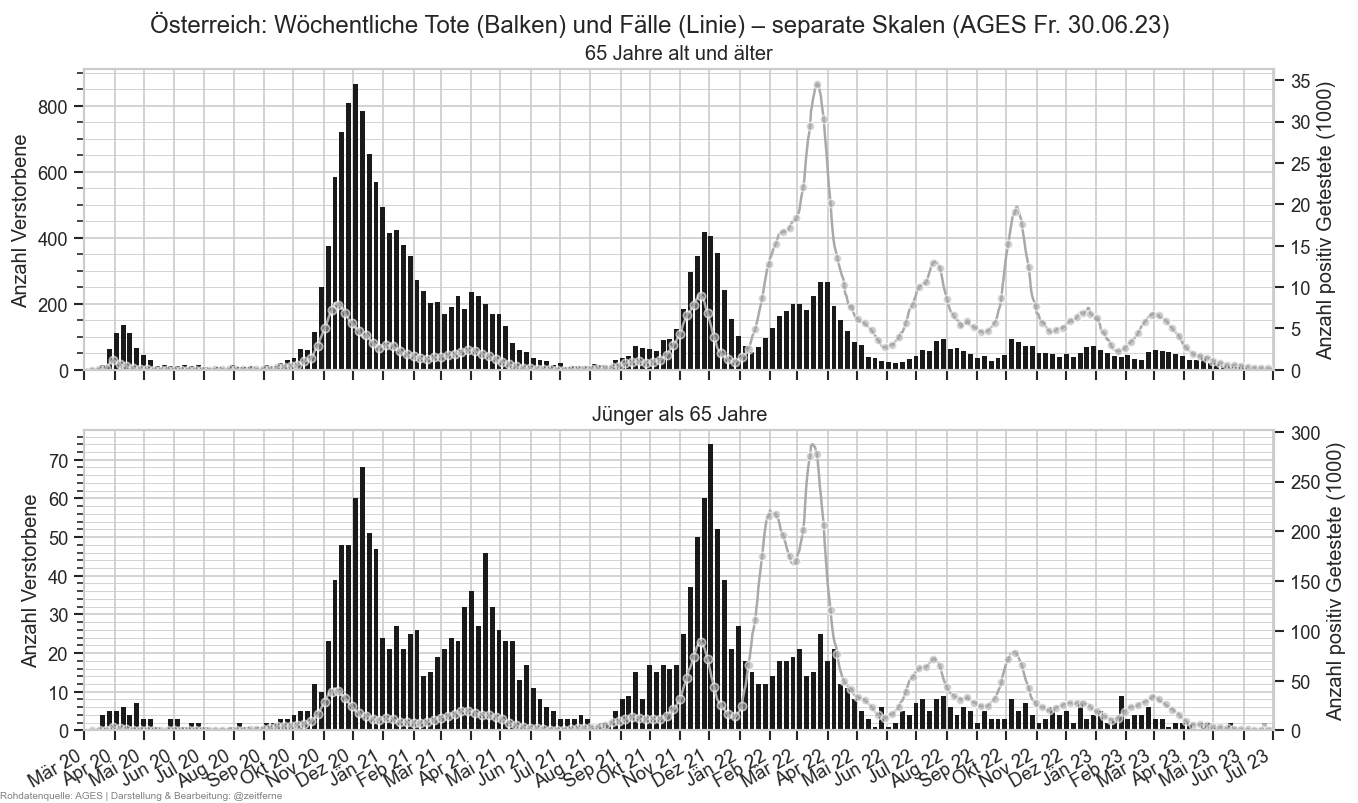
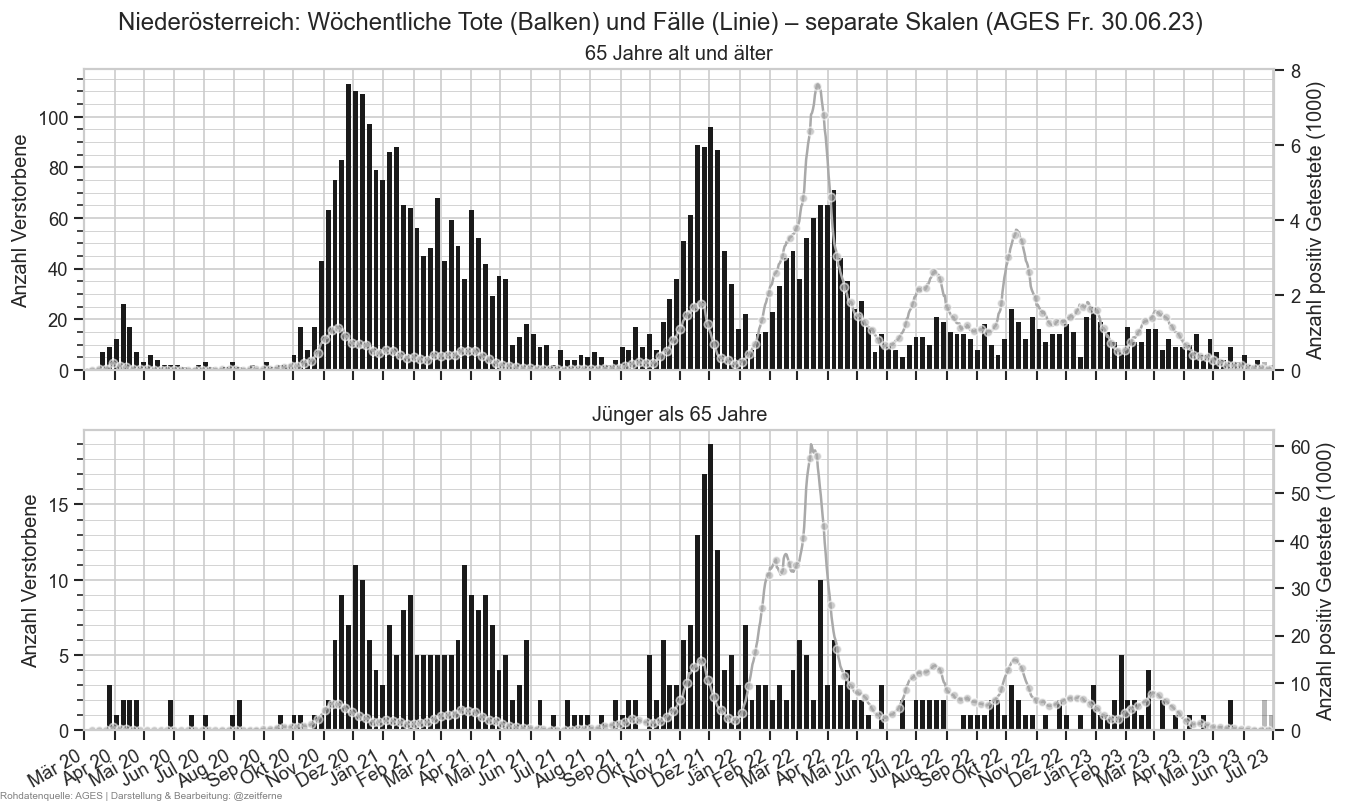
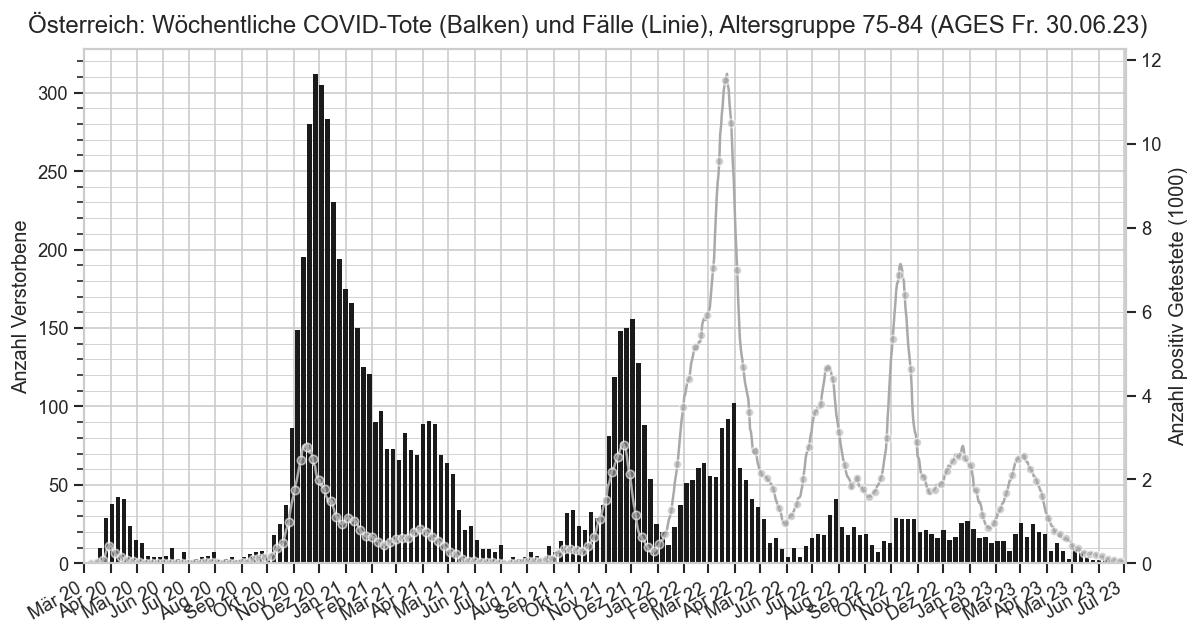
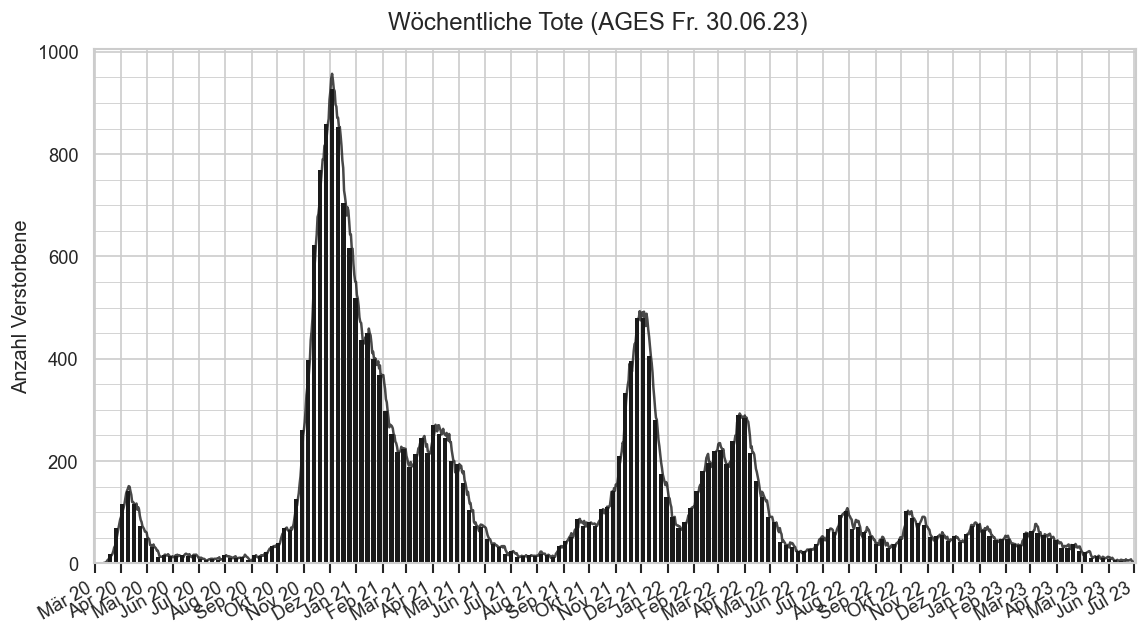
#pdata = (fs.set_index(
# ["Datum", "Bundesland"])["AnzahlTot"].groupby("Bundesland",).rolling(365, min_periods=1).sum().reset_index(0, drop=True)).dropna()
pdata = (ages_hist[ages_hist["FileDate"] == ages_hist["Datum"] + timedelta(1)].set_index(
["Datum", "Bundesland"])["AnzahlTote1J"]
.combine_first(ages_hist[ages_hist["FileDate"] == ages_hist["FileDate"].min()].set_index(
["Datum", "Bundesland"])["AnzahlTote1J"]))#.dropna()
pdata /= fs.set_index(["Datum", "Bundesland"])["AnzEinwohner"]
ax = sns.lineplot(pdata.reset_index(), x="Datum", y="AnzahlTote1J", hue="Bundesland", err_style=None)
fig = ax.figure
fig.suptitle("Österreich: Tote pro 365 Tage, jeweils historische Datenstände", y=0.93)
cov.set_date_opts(ax, showyear=True)
ax.set_xlim(*ax.get_xlim())
#ax.axvspan(matplotlib.dates.date2num(date(2022, 1, 1)), ax.get_xlim()[1], color="k", alpha=0.1, zorder=3,
# label="Unvollständige Daten")
ax.legend()
ax.figure.autofmt_xdate()
ax.set_ylim(bottom=0)
cov.set_percent_opts(ax, decimals=3)
ax.set_ylabel("Anteil an Gesamtbevölkerung")
Text(0, 0.5, 'Anteil an Gesamtbevölkerung')
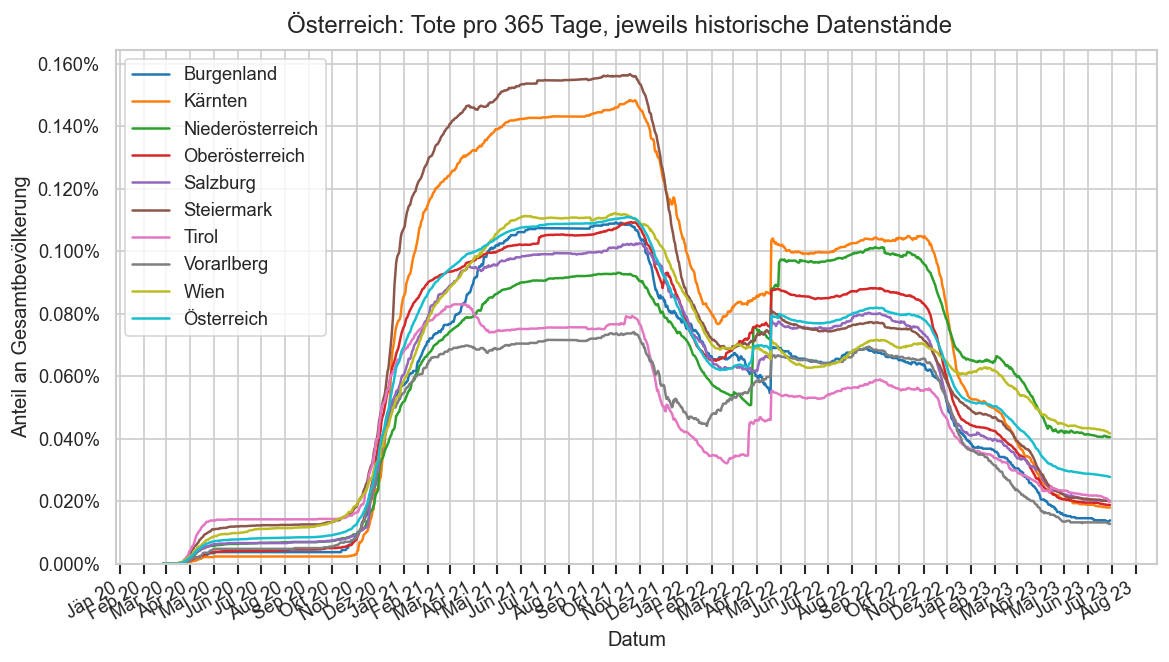
#pdata = (fs.set_index(
# ["Datum", "Bundesland"])["AnzahlTot"].groupby("Bundesland",).rolling(365, min_periods=1).sum().reset_index(0, drop=True)).dropna()
pdata = (ages_hist[ages_hist["FileDate"] == ages_hist["Datum"] + timedelta(1)]
.query("Bundesland == 'Österreich'")
.set_index(["Datum"])["AnzahlTote1J"]
.combine_first(ages_hist[ages_hist["FileDate"] == ages_hist["FileDate"].min()]
.query("Bundesland == 'Österreich'")
.set_index(["Datum"])["AnzahlTote1J"]))#.dropna()
#pdata /= fs.set_index(["Datum", "Bundesland"])["AnzEinwohner"]
ax = sns.lineplot(pdata.reset_index(), x="Datum", y="AnzahlTote1J", err_style=None, color="k", legend=False)
fig = ax.figure
fig.suptitle("Österreich: Tote pro 365 Tage, jeweils historische Datenstände", y=0.93)
cov.set_date_opts(ax, showyear=True)
ax.set_xlim(*ax.get_xlim())
ax.axhline(pdata.iloc[-1], color="k", lw=0.7)
#ax.axvspan(matplotlib.dates.date2num(date(2022, 1, 1)), ax.get_xlim()[1], color="k", alpha=0.1, zorder=3,
# label="Unvollständige Daten")
ax.figure.autofmt_xdate()
ax.set_ylim(bottom=0)
ax.set_ylabel("Anteil an Gesamtbevölkerung")
Text(0, 0.5, 'Anteil an Gesamtbevölkerung')
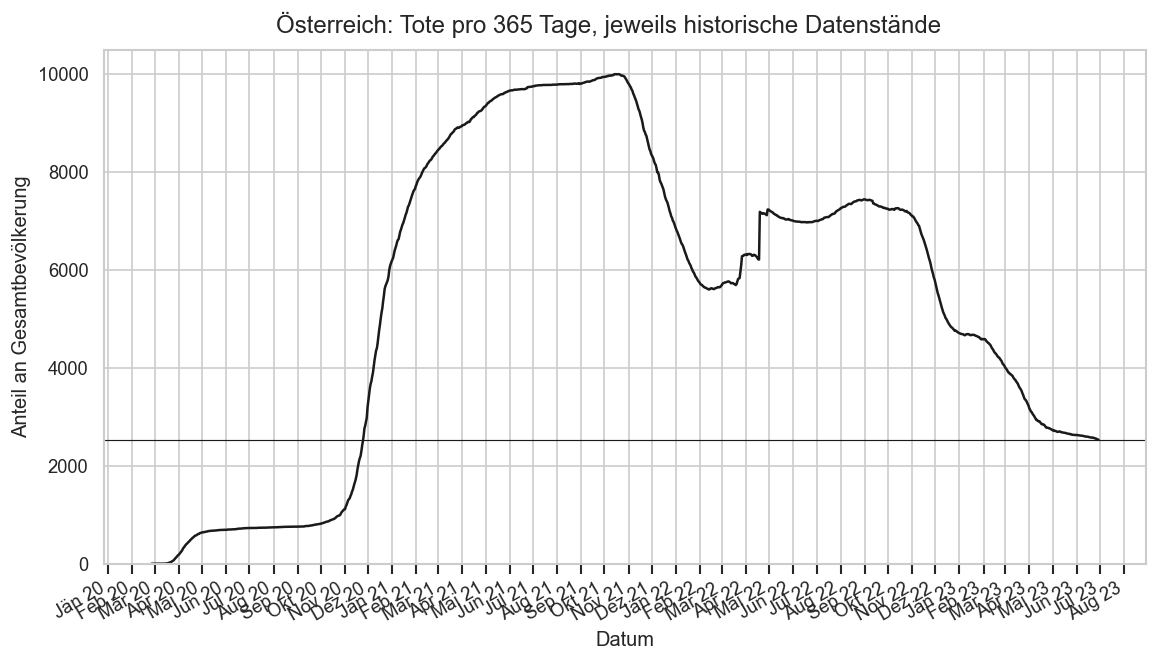
ax = agd_sums.query(
"Altersgruppe == 'Alle' and Bundesland == 'Österreich'").plot(
x="Datum", y=["AnzahlFaelleSum", "AnzahlTotSum"], color=["C1", "k"])
cov.set_logscale(ax, reduced=True)
cov.set_date_opts(ax)
fig = ax.figure
fig.autofmt_xdate()
ax.set_ylim(bottom=100);
fmt = matplotlib.ticker.ScalarFormatter(useLocale=True)
fmt.set_scientific(False)
ax.yaxis.set_major_formatter(fmt)
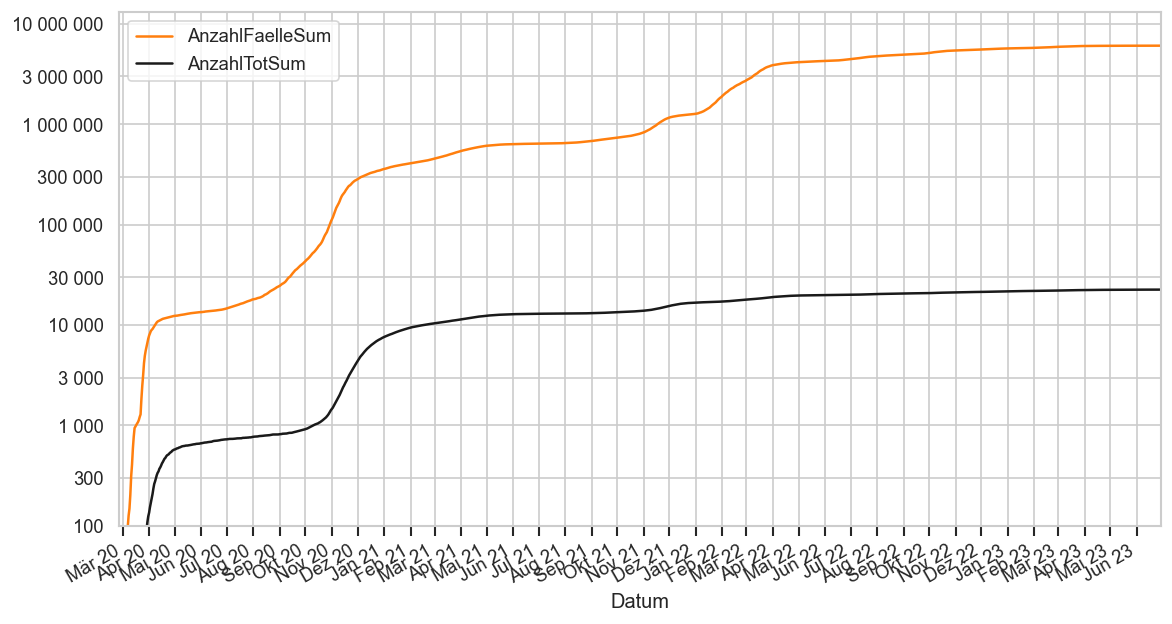
fs2 = fs.copy()#agd_sums.query("Altersgruppe == '>84'").copy() #fs.copy()
fs2["dead_p100k_cum"] = fs2["AnzahlTotSum"] * 100_000 / fs2["AnzEinwohner"]
#display(fs2.query("Bundesland == 'Österreich'")[["Datum", "AnzahlTotSum", "AnzEinwohner"]])
ax = sns.lineplot(data=fs2, x="Datum", y="dead_p100k_cum", hue="Bundesland", size="AnzEinwohnerFixed",
size_norm=matplotlib.colors.Normalize(vmax=fs2.query("Bundesland == 'Wien'").iloc[-1]["AnzEinwohner"]),
err_style=None)
ax.legend(*sortedlabels(ax, fs2, "dead_p100k_cum", fmtval=lambda n: f"{n:.3n}"), ncol=1)
#ax.set_yscale("log")
#ax.yaxis.set_major_formatter(matplotlib.ticker.ScalarFormatter())
#ax.yaxis.set_major_locator(matplotlib.ticker.LogLocator(base=10, subs=[0.15, 0.2, 0.3, 0.5, 0.7, 1]))
#ax.set_ylim(bottom=1)
labelend2(ax, fs2, "dead_p100k_cum", 100, colorize=sns.color_palette())
ax.set_ylabel("Tote je 100.000 Einwohner");
cov.set_date_opts(ax, fs2["Datum"], showyear=True)
ax.figure.autofmt_xdate()
ax.tick_params(bottom=False)
fig = ax.figure
fig.suptitle("COVID-Tote pro 100.000 Einwohner je Bundesland" + AGES_STAMP, y=0.93);

def plt_ags_std():
agd2 = (agd
.query("Altersgruppe != 'Alle'")
.set_index(["Altersgruppe", "Geschlecht", "Datum", "Bundesland"])
.sort_index())
#display(agd2.dtypes)
agd2["dead_28s"] = agd2.groupby(["Altersgruppe", "Geschlecht", "Bundesland"])["AnzahlTot"].transform(
lambda s: s.rolling(28).sum())
agd2["dead_pp_cum"] = agd2["dead_28s"] / agd2["AnzEinwohner"]
#display(agd2.dtypes)
#display(agd2)
ewat = agd2.xs('Österreich', level="Bundesland")["AnzEinwohner"]
#display(agd2)
agd2["dead_cum_norm"] = agd2["dead_pp_cum"] * ewat
agd2sum = agd2.groupby(["Datum", "Bundesland"])[["dead_cum_norm"]].sum()
#display(agd2sum.query("Bundesland == 'Österreich'")["dead_cum_norm"])
#display(ewat.groupby("Datum").sum())
#display(agd2["dead_cum_norm"])
agd2sum["dead_pp_cum_norm"] = agd2sum["dead_cum_norm"] * 100_000 / ewat.groupby("Datum").sum()
#display(ewat.groupby("Datum").sum())
pdata = agd2sum.reset_index().query("Datum >= '2020-01-15'")
pdata = pdata[pdata["Datum"] <= pdata["Datum"].max() - timedelta(9)]
ax = sns.lineplot(data=pdata, x="Datum", y="dead_pp_cum_norm", hue="Bundesland",
#size_norm=matplotlib.colors.Normalize(vmax=fs.query("Bundesland == 'Wien'").iloc[-1]["AnzEinwohner"]),
err_style=None)
ax.legend(*sortedlabels(ax, pdata, "dead_pp_cum_norm", fmtval=lambda n: f"{n:.3n}"), ncol=2,
title="Daten bis " + pdata["Datum"].max().strftime("%x"))
#ax.set_yscale("log")
#ax.yaxis.set_major_formatter(matplotlib.ticker.ScalarFormatter())
#ax.yaxis.set_major_locator(matplotlib.ticker.LogLocator(base=10, subs=[0.15, 0.2, 0.3, 0.5, 0.7, 1]))
#ax.set_ylim(bottom=1)
labelend2(ax, pdata, "dead_pp_cum_norm", 100, colorize=sns.color_palette())
ax.set_ylabel("Tote pro 100.000 Einwohner");
cov.set_date_opts(ax, pdata["Datum"], showyear=True)
ax.figure.autofmt_xdate()
ax.tick_params(bottom=False)
ax.set_ylim(bottom=0)
fig = ax.figure
fig.suptitle("COVID-Tote pro 100.000 Einwohner in 28 Tagen je Bundesland, altersstandadisiert" + AGES_STAMP, y=0.93);
plt_ags_std()
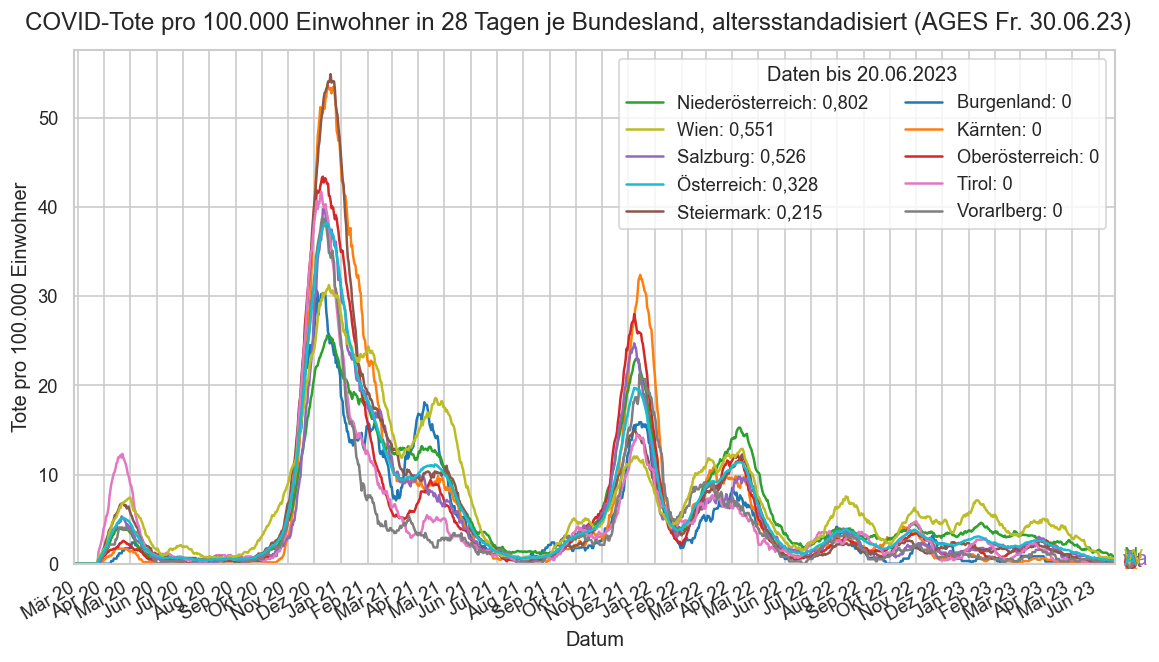
DT_SCHULBEG = date(2021, 9, 6)
def drawd(fromdate=None, mline=True, basecol="AnzEinwohner", annot=True, query=None, basedata=agd_sums):
fsbase = basedata.query("Bundesland == 'Österreich' and Altersgruppe != 'Alle'").set_index(
["Altersgruppe", "Datum"])
if query:
fsbase = fsbase.query(query)
zerofirst = True
if fromdate is None:
fromdate = fsbase.index.get_level_values("Datum")[0]
zerofirst = False
fs2 = fsbase.loc[fsbase.index.get_level_values("Datum") >= fromdate].copy()
if zerofirst:
fs2["AnzahlTotSum"] -= fsbase.xs(fromdate - timedelta(1), level="Datum")["AnzahlTotSum"]#fsbase.index.get_level_values("Datum") == fromdate]
# [(0.4, 0.4, 0.4), (0, 0, 0), (0.6, 0.6, 0.6)]
palette = (sns.color_palette("bone", n_colors=4)[:-1] * 10
)[:fsbase.index.get_level_values("Altersgruppe").nunique()] #* 2
fs2["dead_p100k_cum"] = fs2["AnzahlTotSum"]
if basecol:
fs2["dead_p100k_cum"] = fs2["AnzahlTotSum"] / fs2[basecol].groupby(level="Altersgruppe").transform(lambda s: s.shift(21).bfill()) * 100_000
#fs2["Gruppe"] = fs2["Altersgruppe"] + " " + fs2["Geschlecht"]
fig = plt.figure()
ax = sns.lineplot(data=fs2, x="Datum", y="dead_p100k_cum", hue="Altersgruppe", legend=False,
#size="AnzEinwohner",
#size=40,
#lw=2.5,
#palette=sns.color_palette("Paired", desat=0.5, n_colors=10)
#palette="prism",
palette=palette,
size="AnzEinwohnerFixed",
ds="steps-mid",
solid_joinstyle="miter",
snap=True,
aa=False
)
#ax.legend(*sortedlabels(ax, fs2, "dead_p100k_cum", "Altersgruppe"), ncol=1)
if basecol:
ax.set_yscale("log")
ax.yaxis.set_major_formatter(matplotlib.ticker.FormatStrFormatter("%.1f"))
ax.set_ylim(bottom=0.05)
#ax.yaxis.set_major_locator(matplotlib.ticker.LogLocator(base=10, subs=[0.15, 0.2, 0.3, 0.5, 0.7, 1]))
#labelend2(ax, fs2, "dead_p100k_cum", 100)
prev_y = None
def sort_grps(cl_ag):
_, ag = cl_ag
return fs2.xs(ag, level="Altersgruppe").iloc[-1]["dead_p100k_cum"]
grps = sorted(zip(palette, fsbase.index.get_level_values("Altersgruppe").unique()), key=sort_grps)
for cl, ag in grps:
ag0 = fs2.xs(ag, level="Altersgruppe")
record = ag0.iloc[-1]
y = record["dead_p100k_cum"]
if prev_y is not None and prev_y / y > 0.8:
#print(ag, "adjusted!")
y = prev_y * 1.5
#print(prev_y, y, prev_y is not None and prev_y / y)
ax.annotate(ag + (":\n" if mline else ": ") + str(record["AnzahlTotSum"]) + " Tote"
+ ("/r" if record["AnzahlTotSum"] == 1 else ""),
(record.name, y),
xytext=(5, -5 if ag in ("5-14") else 0),
textcoords='offset points', size=9, color=cl)
prev_y = y
if annot:
for dt in map(pd.to_datetime, (date(2020, 9, 6), date(2021, 1, 15), DT_SCHULBEG, date(2022, 9, 5))):
if dt < fromdate:
continue
record = ag0.loc[pd.to_datetime(dt)]
ax.annotate(str(record["AnzahlTotSum"]),
(record.name, record["dead_p100k_cum"]),
xytext=(0, -8 if record["AgeFrom"] <= 15 else 8), textcoords='offset points', size=9, color=cl)
if basecol:
ax.set_ylabel("Tote pro 100.000" + (" Einwohner" if basecol == "AnzEinwohner" else " Fälle" if "AnzahlFaelleSum" else ""))
else:
ax.set_ylabel("Tote")
fromstr = "Insgesamt" if not zerofirst else "Seit " + fromdate.strftime("%x")
ax.set_title(
fs2.iloc[0]["Bundesland"] + f": {fromstr} direkt an/mit COVID Verstorbene je Altersgruppe, logarithmisch" + AGES_STAMP)
cov.set_date_opts(ax, fs2.index.get_level_values("Datum"), showyear=True)
ax.set_xlim(left=fs2.index.get_level_values("Datum")[0])
ax.figure.autofmt_xdate()
ax.tick_params(bottom=False)
cov.stampit(ax.figure)
return fig, ax
drawd(mline=False)
drawd(mline=False, basecol="AnzahlFaelleSum")[1].set_ylim(bottom=0.7, top=100_000)
if False:
drawd(fromdate=pd.to_datetime("2021-09-01"), mline=False, annot=False)
#fig, ax = drawd(fromdate=pd.to_datetime("2022-01-01"), mline=False, basecol=None, query="AgeTo < 50", basedata=agd1m_sums);
#fdate = agd_sums.query("Altersgruppe != 'Alle'")["Datum"].min() + timedelta(1)
fdate = pd.to_datetime("2022-01-01") #fs["Datum"].iloc[0] + timedelta(1)# pd.to_datetime("2022-01-01")
fig, ax = drawd(fromdate=fdate, mline=False, basecol=None, query="AgeTo < 45", basedata=agd_sums);
ax.set_xlabel("Todesdatum")
#ax.set_yscale("linear")
ax.yaxis.set_major_locator(matplotlib.ticker.MultipleLocator(5))
ax.set_ylim(bottom=0)
ax.set_title(None)
fig.suptitle("Österreich: COVID-Tote unter 45 seit " + fdate.strftime("%x"), y=0.93)
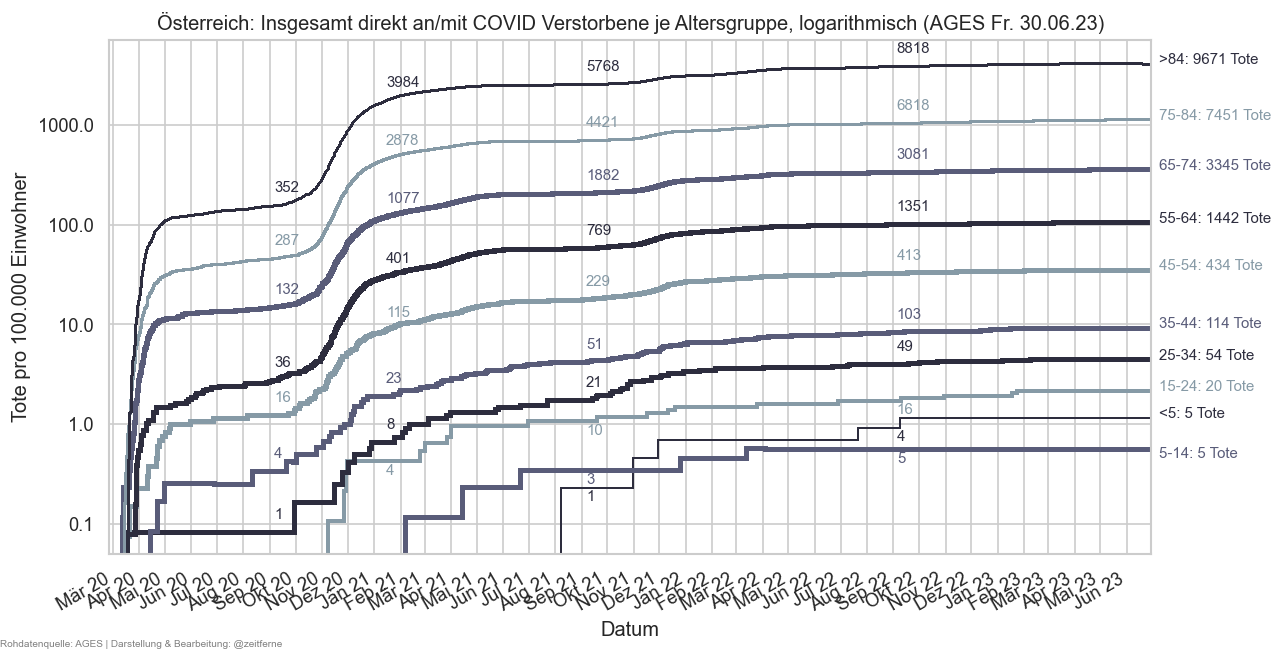
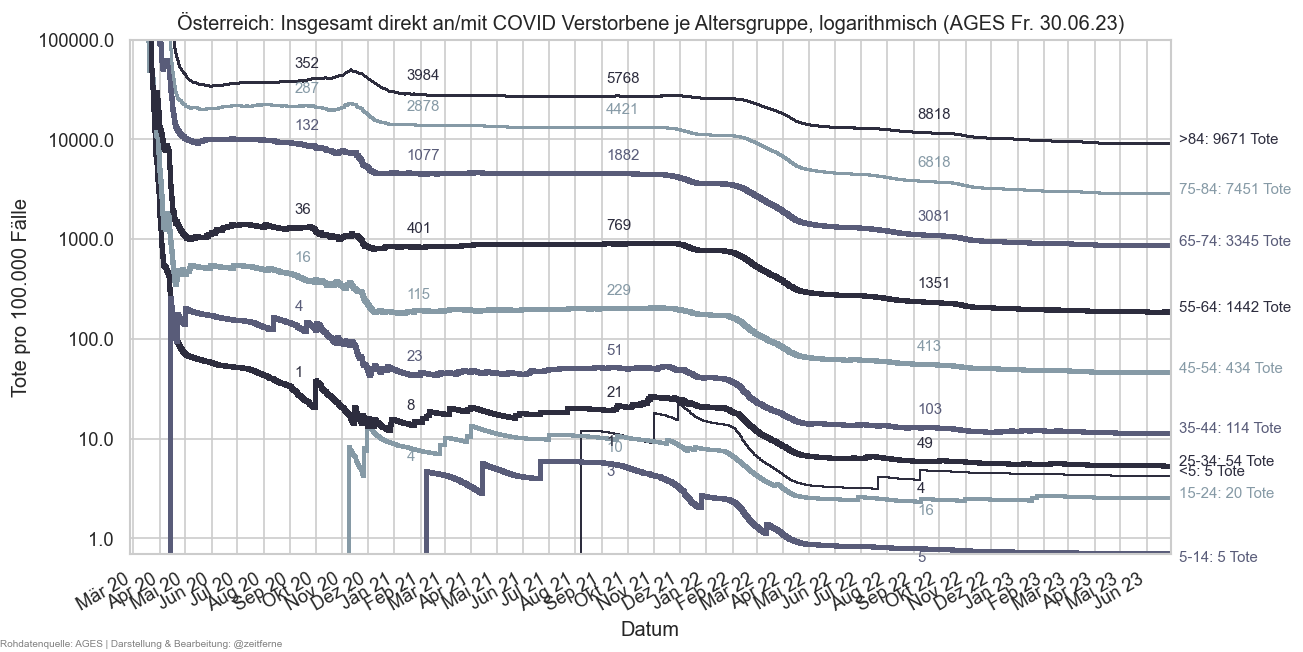
if False:
fsx = fs_at.set_index("Datum")
ax = (fsx["AnzahlTot"].rolling(14).sum().shift(-12) / fsx["AnzahlFaelle"].rolling(14).sum()).plot()
ax.set_ylim(top=0.1, bottom=0.0005)
cov.set_logscale(ax)
cov.set_percent_opts(ax, decimals=2)
if False:
fsx = fs.query("Bundesland == 'Österreich'").set_index("Datum")
ax = (fsx["AnzahlTot"].rolling(21).sum().shift(-21) / fsx["AnzahlFaelle"].rolling(21).sum()).iloc[-300:].plot()
ax.set_ylim(top=0.03, bottom=0.0005)
cov.set_logscale(ax)
cov.set_percent_opts(ax, decimals=2)
## $$CFR
#ax = (fsx["AnzahlTot"].rolling(14).sum().shift(20) / fsx["AnzahlFaelle"].rolling(14).sum()).plot()
rwidth=35
selag = ">84"
selsex = "M"
#selag = "65+" # and AgeFrom >= 64
fsx = agd.query(f"Bundesland == 'Österreich' and Altersgruppe == '{selag}' and Geschlecht == '{selsex}'").groupby("Datum").agg({
"Bundesland": "first",
"AnzahlFaelle": "sum",
"AnzahlTot": "sum"
})
ds = fsx["AnzahlTot"].iloc[:-14].rolling(rwidth).sum()#
cs = fsx["AnzahlFaelle"].rolling(rwidth).sum().shift(14)#
ax = ds.plot(label="Tote, logarithmisch", color="k")
cs.plot(ax=ax, color="C1", label="Fälle, +14 Tage verschoben, logarithmisch")
ax2 = ax.twinx()
cfr = ds / cs
cfr.plot(ax=ax2, lw=2, color="C0", label="Fallsterblichkeit (rechte Skala)")
#print(cfr.loc[cfr.last_valid_index()])
ax2.set_ylim(bottom=0)
#cov.set_logscale(ax2)
cov.set_logscale(ax)
#ax2.grid(False)
ax.grid(False, axis="y")
ax.figure.legend(loc="upper center", bbox_to_anchor=(0.5, 0.94), ncol=3, frameon=False)
ax.set_xlim(right=ax.get_xlim()[1] + 14)
cov.set_date_opts(ax, showyear=True)
ax.figure.autofmt_xdate()
ax.yaxis.set_major_formatter(matplotlib.ticker.FuncFormatter(lambda x, p: locale.format_string("%d", x, grouping=True)))
cov.set_logscale(ax2)
ax2.set_ylim(bottom=0.01, top=0.8)
cov.set_percent_opts(ax2, decimals=2)
ax.figure.suptitle(
fsx["Bundesland"].iloc[0] + f", Altersgruppe {selag} {selsex}: COVID-Tote und Fälle im Verhältnis, {rwidth}-Tage-Summen", y=0.97)
ax.set_ylabel(f"Ereignisse/100.000 EW/{rwidth} Tage (log)")
ax2.set_ylabel("Geschätzte Fallsterblichkeit");
#for dt in map(pd.to_datetime, ["2020-09-01", "2021-03-01", "2021-08-01", "2022-01-15"]):
# ax.axvline(dt, color="k", zorder=1)
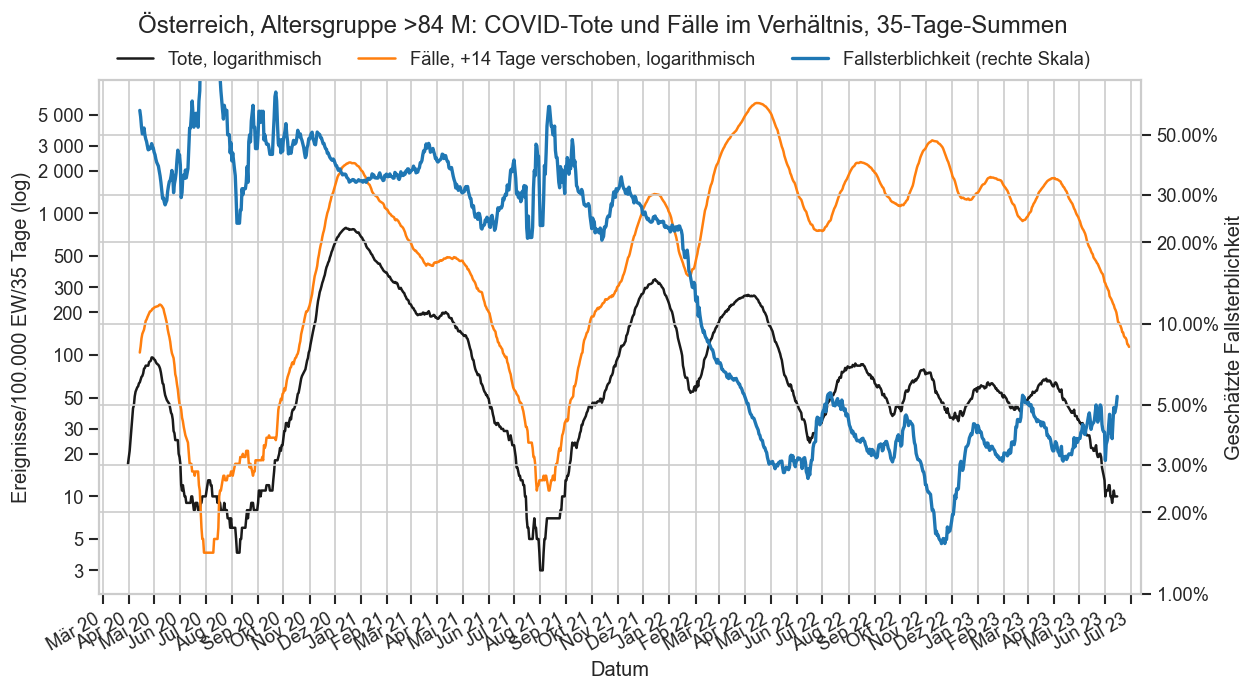
#ax = (fsx["AnzahlTot"].rolling(14).sum().shift(20) / fsx["AnzahlFaelle"].rolling(14).sum()).plot()
rwidth=35
if False:
selag = "65+"
fsx = agd_sums.query(f"Bundesland == 'Österreich' and AgeFrom >= 64 and Altersgruppe != 'Alle'").groupby("Datum").agg({
"Bundesland": "first",
"AnzahlFaelle": "sum",
"AnzahlTot": "sum",
"AnzahlGeheilt": "sum"
})
else:
selag = ">84"
selsex = "M"
fsx = (
agd
.query(f"Bundesland == 'Österreich' and Altersgruppe == '{selag}' and Geschlecht == '{selsex}'")
.set_index("Datum"))
ds = fsx["AnzahlTot"].iloc[:-9].rolling(rwidth).sum()#.shift(-14)#
cs0 = fsx["AnzahlGeheilt"].diff().rolling(rwidth).sum() + ds#
cs14 = fsx["AnzahlFaelle"].rolling(rwidth).sum().shift(14)
cs = cs0.clip(lower=cs14)
ax = ds.plot(label="Tote", color="k")
cs0.plot(ax=ax, color="C1", label="Genesene+Tote", ls=":")
cs14.plot(ax=ax, color="C3", label="Fälle vor 14 T", ls="--", lw=0.7)
cs.plot(ax=ax, color="C1", label="max(Gen+Tot, F vor 14 T)")
ax2 = ax.twinx()
cfr = (ds / cs)
cfr.plot(ax=ax2, color="C0", lw=2, label="Fallsterblichkeit (rechts): " + format(cfr.loc[cfr.last_valid_index()], ".2%"))
#print(cfr.loc[cfr.last_valid_index()])
#ax2.set_ylim(bottom=0)
#cov.set_logscale(ax2)
cov.set_logscale(ax)
#ax2.grid(False)
ax.grid(False, axis="y")
ax.figure.legend(loc="upper center", bbox_to_anchor=(0.5, 0.94), ncol=5, frameon=False)
ax.set_xlim(right=ax.get_xlim()[1] + 14)
cov.set_date_opts(ax, showyear=True)
ax.figure.autofmt_xdate()
ax.yaxis.set_major_formatter(matplotlib.ticker.FuncFormatter(lambda x, p: locale.format_string("%d", x, grouping=True)))
cov.set_logscale(ax2)
ax2.set_ylim(bottom=0.01, top=0.8)
cov.set_percent_opts(ax2, decimals=3)
ax.figure.suptitle(
fsx["Bundesland"].iloc[0] + f", Altersgruppe {selag} {selsex}: COVID-Tote und Fälle im Verhältnis, {rwidth}-Tage-Summen, logarithmisch", y=0.97)
ax.set_ylabel(f"Ereignisse/100.000 EW/{rwidth} Tage (log)")
ax2.set_ylabel("Geschätzte Fallsterblichkeit (log)");
#for dt in map(pd.to_datetime, ["2020-09-01", "2021-03-01", "2021-08-01", "2022-01-15"]):
# ax.axvline(dt, color="k", zorder=1)
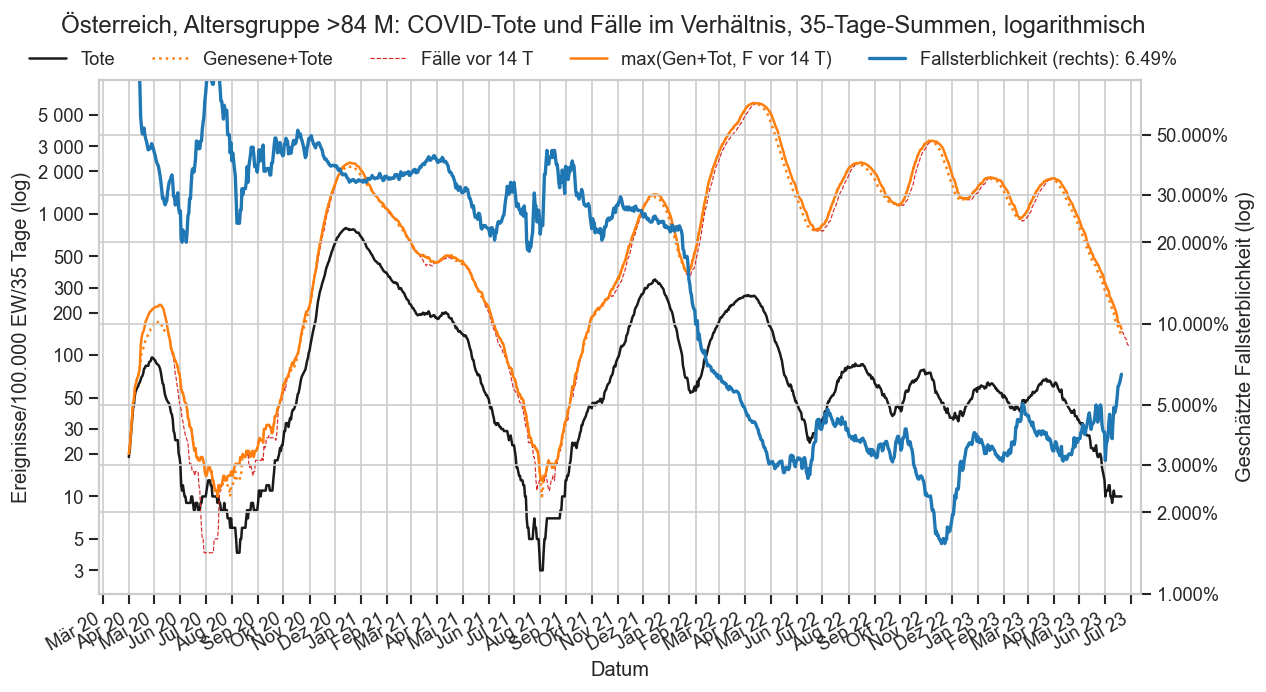
if False:
ls = []
for shift in range(-40, 40):
ds = fsx["AnzahlTot"].rolling(14).sum().shift(shift) / fsx["AnzahlFaelle"].rolling(14).sum()
ds = ds.iloc[40:]
ls.append((ds.mean(), ds.quantile(0.95)))
plt.plot(np.arange(-40, 40), ls, marker=".")
from itertools import pairwise, chain
#NS_PER_DAY = 1e9 * 60 * 60 * 24
#def pd_timedelta_fmt(val, x):
# return int(val / NS_PER_DAY)
def add_arrow(line, position=None, to_position=None, direction='right', size=15, color=None):
"""
add an arrow to a line.
line: Line2D object
position: x-position of the arrow. If None, mean of xdata is taken
direction: 'left' or 'right'
size: size of the arrow in fontsize points
color: if None, line color is taken.
"""
# https://stackoverflow.com/a/34018322/2128694
if color is None:
color = line.get_color()
xdata = line.get_xdata()
ydata = line.get_ydata()
if position is None:
position = xdata.mean()
# find closest index
start_ind = np.argmin(np.absolute(xdata - position))
if to_position is not None:
end_ind = to_position
else:
if direction == 'right':
end_ind = start_ind + 1
else:
end_ind = start_ind - 1
line.axes.annotate('',
xytext=(xdata[start_ind], ydata[start_ind]),
xy=(xdata[end_ind], ydata[end_ind]),
arrowprops=dict(arrowstyle="-|>", color=color, lw=0),
size=size
)
def drawwavedead(fs_at, vcol="AnzahlTotSum", vcolname="Tote"):
waves = {
name: (wavebeg, fs_at[(fs_at["Datum"] >= wavebeg) & (fs_at["Datum"] < nextbeg)])
for (name, wavebeg), (_, nextbeg)
in pairwise(chain(
AT_DEAD_PERIOD_STARTS.items(),
[(None, fs_at.iloc[-1]["Datum"] + timedelta(1))]))
}
fig, ax = plt.subplots(figsize=(8, 6))
fig.suptitle(fs_at.iloc[0]["Bundesland"] + f": {vcolname} je COVID-19-Periode" + AGES_STAMP, y=0.96)
ax.set_title("Periodenbeginn: Ca. Minimum der Todeszahlen zwischen den Wellen")
colors = sns.color_palette(n_colors=len(waves))
annots = []
for idx, color, (name, (wavebeg, waverange)) in zip(range(len(waves)), colors, waves.items()):
cols = ["Datum", vcol]
waveend = waverange["Datum"].iloc[-1]
if waverange.iloc[0]["Datum"] == fs_at.iloc[0]["Datum"]:
wave = waverange[cols].copy()
wave["Datum"] -= wave["Datum"].iloc[0]
else:
wave = waverange[cols] - waverange.iloc[0][cols]
wave[vcol] += waverange.iloc[0]["AnzahlTot"]
#display(wave.dtypes)
wave["Datum"] = wave["Datum"].map(lambda dt: dt.days)
wave = wave.set_index(["Datum"])
lastline = ax.plot(wave[vcol], label=name, color=color, lw=3, ls="-" if waveend < pd.to_datetime("2022-01-15") else "--")[0]
lastval = wave.iloc[-1][vcol]
ax.axhline(lastval, color=color, zorder=1, alpha=0.5)
annots.append((
lastval,
f"{idx + 1}: {name}, ab {wavebeg.strftime('%d.%m.%y')}\n {lastval:n} {vcolname} in {len(wave)} Tagen",
dict(color=color)))
#ax.plot(wave.iloc[-1:], color=color, marker=">", lw=0, markersize=8)
add_arrow(lastline, wave.index[-min(14, len(wave))], to_position=wave.index[-2], size=30)
ax.set_ylim(bottom=0
# , top=4500
)
ax.set_xlim(left=0)
dodgeannot(annots, ax)
#ax.xaxis.set_major_formatter(matplotlib.ticker.FuncFormatter(pd_timedelta_fmt))
ax.yaxis.set_minor_locator(matplotlib.ticker.AutoMinorLocator(2))
ax.grid(axis="y", which="minor")
ax.xaxis.set_major_locator(matplotlib.ticker.MultipleLocator(30))
ax.set_xlabel("Verstrichene Tage")
ax.set_ylabel(vcolname)
cov.stampit(fig)
#ax.legend()
drawwavedead(fs.query("Bundesland == 'Österreich'"))
#drawwavedead(fs.query("Bundesland == 'Österreich'"), vcol="AnzahlFaelleSum", vcolname="Fälle")
...\AppData\Local\Temp\ipykernel_33144\1746487939.py:65: PerformanceWarning: Adding/subtracting object-dtype array to DatetimeArray not vectorized. wave = waverange[cols] - waverange.iloc[0][cols] ...\AppData\Local\Temp\ipykernel_33144\1746487939.py:65: PerformanceWarning: Adding/subtracting object-dtype array to DatetimeArray not vectorized. wave = waverange[cols] - waverange.iloc[0][cols] ...\AppData\Local\Temp\ipykernel_33144\1746487939.py:65: PerformanceWarning: Adding/subtracting object-dtype array to DatetimeArray not vectorized. wave = waverange[cols] - waverange.iloc[0][cols] ...\AppData\Local\Temp\ipykernel_33144\1746487939.py:65: PerformanceWarning: Adding/subtracting object-dtype array to DatetimeArray not vectorized. wave = waverange[cols] - waverange.iloc[0][cols] ...\AppData\Local\Temp\ipykernel_33144\1746487939.py:65: PerformanceWarning: Adding/subtracting object-dtype array to DatetimeArray not vectorized. wave = waverange[cols] - waverange.iloc[0][cols] ...\AppData\Local\Temp\ipykernel_33144\1746487939.py:65: PerformanceWarning: Adding/subtracting object-dtype array to DatetimeArray not vectorized. wave = waverange[cols] - waverange.iloc[0][cols]
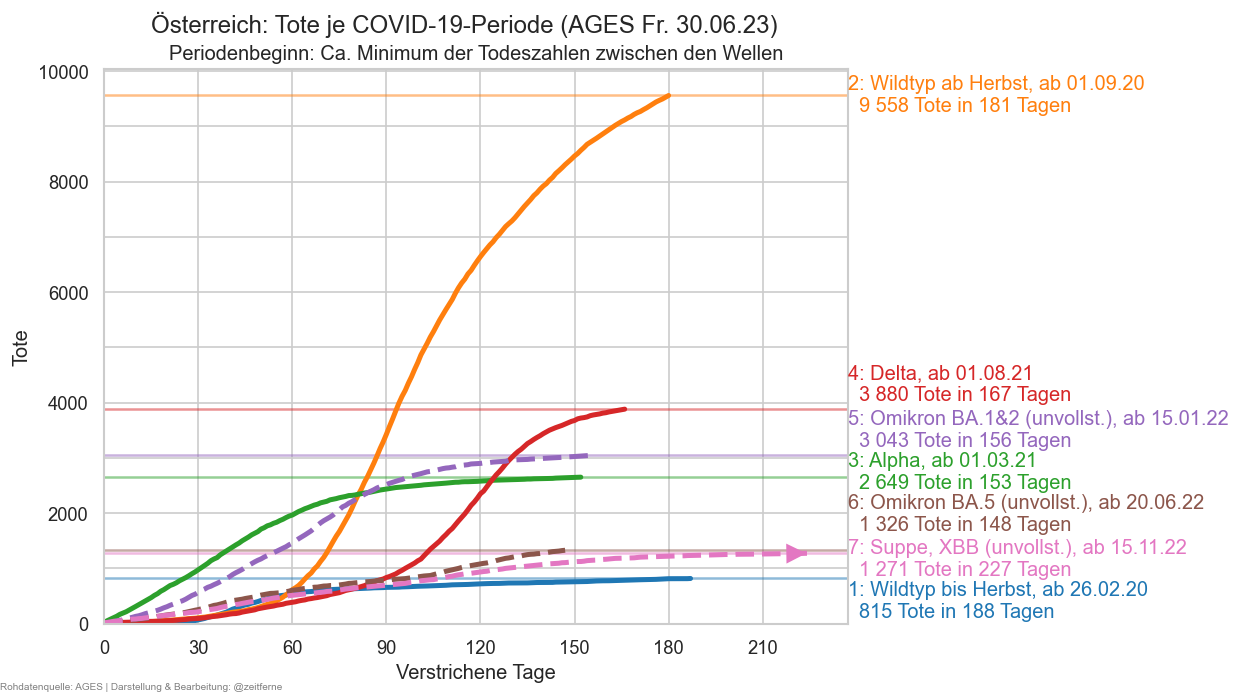
if False:
fs_at.iloc[:200].plot(x="Datum", y="AnzahlTotSum")
def drawcfr(selbl):
rwidth=35
fsbase = agd_sums.query(f"Bundesland == '{selbl}' and Altersgruppe != 'Alle'").set_index(
["AltersgruppeID", "Datum"])
fs2 = fsbase
fs2.sort_index(inplace=True)
fsg = fs2.groupby(level="AltersgruppeID")
fs2["deadsum"] = fsg["AnzahlTot"].transform(lambda s: s.iloc[:-2].rolling(rwidth).sum())
fs2["deadsum"].replace(0, np.nan, inplace=True)
fs2["casesum"] = fsg["AnzahlFaelle"].shift(14).transform(lambda s: s.rolling(rwidth).sum())
fs2["cfr"] = fs2["deadsum"] / fs2["casesum"]
fs2 = fs2.loc[
fs2.index.get_level_values("Datum") >= fs2.loc[np.isfinite(fs2["cfr"])].index.get_level_values("Datum").min()]
fs2 = fs2.loc[np.isfinite(fs2["cfr"])]
#fs2["Gruppe"] = fs2["Altersgruppe"] + " " + fs2["Geschlecht"]
fig = plt.figure()
palette = sns.color_palette(n_colors=fsbase.index.get_level_values("AltersgruppeID").nunique())
splitat = 3
ax = sns.lineplot(data=fs2, x="Datum", y="cfr", hue="Altersgruppe", legend=False,
palette=palette,
hue_order=fsbase["Altersgruppe"].unique())
sns.lineplot(ax=ax, data=fs2.query("AgeTo <= 40 and AnzahlTot > 0"), x="Datum", y="cfr", hue="Altersgruppe", legend=False,
palette=palette,
hue_order=fsbase["Altersgruppe"].unique(), marker="o", mew=0, lw=0)
#ax.legend(*sortedlabels(ax, fs2, "dead_p100k_cum", "Altersgruppe"), ncol=1)
#ax.set_yscale("log")
cov.set_logscale(ax)
ax.yaxis.set_major_formatter(matplotlib.ticker.FormatStrFormatter("%.1f"))
#ax.yaxis.set_major_locator(matplotlib.ticker.LogLocator(base=10, subs=[0.15, 0.2, 0.3, 0.5, 0.7, 1]))
#ax.set_ylim(bottom=0.05)
#labelend2(ax, fs2, "dead_p100k_cum", 100)
mline = False
for cl, agid in zip(palette, fsbase.index.get_level_values("AltersgruppeID").unique()):
if agid not in fs2.index.get_level_values("AltersgruppeID"):
continue
ag0 = fs2.xs(agid, level="AltersgruppeID")
record = ag0.loc[ag0["cfr"].last_valid_index()]
ag = record["Altersgruppe"]
ax.annotate(ag + (":\n" if mline else ": ") + format(record["cfr"] * 100, ".2n").replace(",", ".") + " %",
(fs2.iloc[-1].name[1], record["cfr"]),
xytext=(8, -5 if ag in ("5-14") else 0),
textcoords='offset points', size=9, color=cl)
cov.set_percent_opts(ax, decimals=3)
ax.set_ylabel("Fallsterblichkeit")
fig.suptitle(
fs2.iloc[0]["Bundesland"] + f": COVID-Fallsterblichkeit je Altersgruppe, logarithmisch" + AGES_STAMP,
y=1
)
ax.set_title(
f"Berechnet als Verhältnis von nachlaufenden {rwidth}-Tage-Summen, Tote 14 Tage in die Vergangenheit verschoben."
"Das ist eine sehr grobe Näherung."
"\nVor allem in den jüngeren Altersgruppen ist die Sterblichkeit eher überschätzt, "
f"da nur die Fälle der letzten {rwidth} Tage berücksichtig werden."
f"\nV.a. am Beginn & Ende von Wellen verfälscht der fix angenommene 14-Tage-Abstand zusätzlich.",
fontsize="small")
cov.set_date_opts(ax, fs2.index.get_level_values("Datum"), showyear=True)
ax.set_xlim(left=fs2.index.get_level_values("Datum").min())
ax.figure.autofmt_xdate()
ax.tick_params(bottom=False)
cov.stampit(ax.figure)
ax.axhline(1, color="k", zorder=1, lw=0.5)
ax.set_ylim(top=1.1, bottom=0.0000051)
return fig, ax
with cov.with_age_palette():
drawcfr("Österreich")
#drawcfr("Wien")
#drawcfr("Niederösterreich")
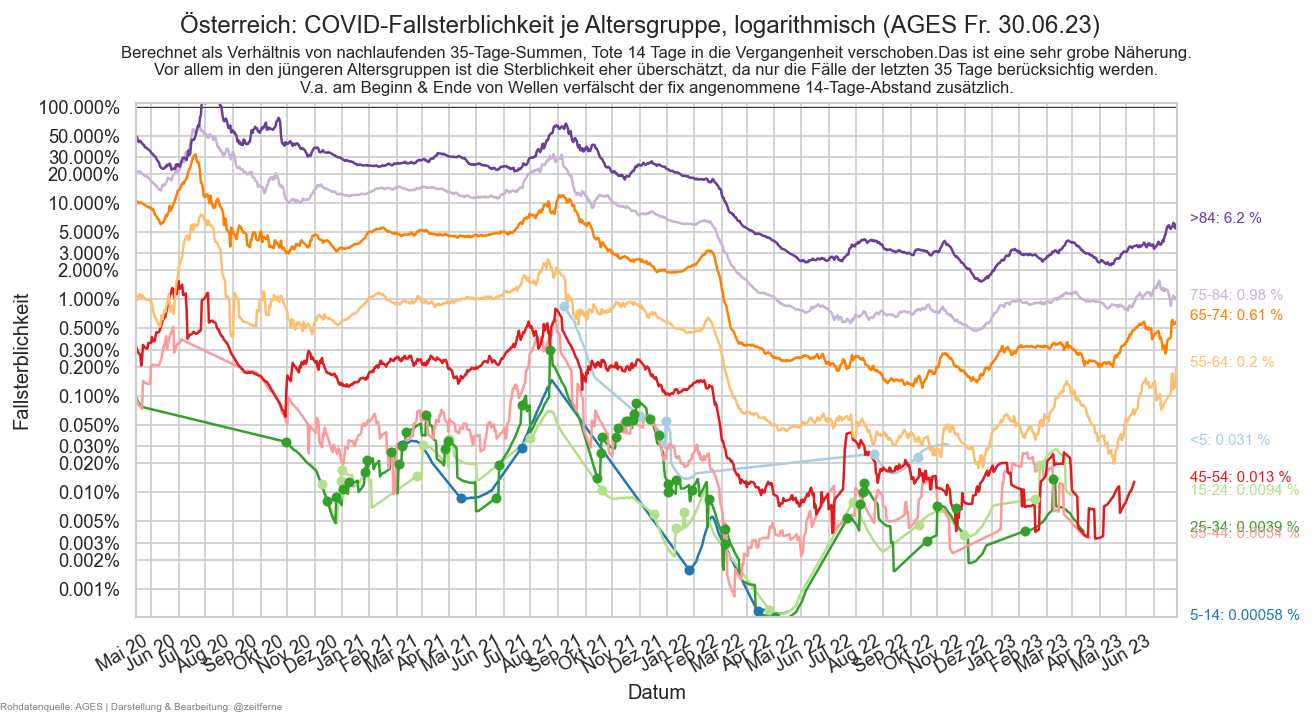
def calc_cfr2(selbl, rwidth=35, sex=None):
if sex is not None:
fsbase = agd.query(
f"Bundesland == '{selbl}' and Altersgruppe != 'Alle' and Geschlecht == '{sex}'")
else:
fsbase = agd_sums.query(f"Bundesland == '{selbl}' and Altersgruppe != 'Alle'")
fsbase = fsbase.set_index(["AltersgruppeID", "Datum"])
fs2 = fsbase
fs2.sort_index(inplace=True)
fsg = fs2.groupby(level="AltersgruppeID")
cutoff = 9
fs2["deadsum"] = fsg["AnzahlTotSum"].transform(lambda s: s.iloc[:-cutoff] - s.iloc[:-cutoff].shift(rwidth))
fs2["deadsum"] = fs2["deadsum"][fs2["deadsum"] > 0]
fs2["casesum"] = fsg["AnzahlGeheilt"].transform(lambda s: s - s.shift(rwidth))
fs2["casesum"].clip(
inplace=True,
lower=fsg["AnzahlFaelle"].transform(lambda s: s.rolling(rwidth, min_periods=1).sum().shift(14)))
assert not (fs2["casesum"] < 0).any()
fs2["casesum"] += fs2["deadsum"]
#fs2.loc[fs2["AnzahlTot"] > 0, "cfr"] = fs2["deadsum"] / fs2["casesum"]
fs2["cfr"] = fs2["deadsum"] / fs2["casesum"]
fs2 = fs2.loc[
fs2.index.get_level_values("Datum") >= fs2.loc[np.isfinite(fs2["cfr"])].index.get_level_values("Datum").min()]
fs2 = fs2.loc[np.isfinite(fs2["cfr"])]
return fs2, fsbase
def drawcfr2(selbl, sex=None):
rwidth=35
fs2, fsbase = calc_cfr2(selbl, rwidth, sex)
#fs2["Gruppe"] = fs2["Altersgruppe"] + " " + fs2["Geschlecht"]
fig = plt.figure()
n_ag = fsbase.index.get_level_values("AltersgruppeID").nunique()
#print(f"{n_ag=}")
palette = sns.color_palette(n_colors=n_ag)
ax = sns.lineplot(data=fs2, x="Datum", y="cfr", hue="Altersgruppe", legend=False,
#size="AnzEinwohner",
#size=40,
#lw=2.5,
#palette=sns.color_palette("Paired", desat=0.5, n_colors=10),
palette=palette,
hue_order=fsbase["Altersgruppe"].unique()
#palette="prism",
#palette=[(0.6, 0.6, 0.6), (0, 0, 0)] * 5, #* 2
#size="AnzEinwohner",
#ds="steps-mid",
#solid_joinstyle="miter",
#snap=True,
#aa=False
)
#sns.lineplot(ax=ax, data=fs2.query("AgeTo <= 50 and AnzahlTot > 0"), x="Datum", y="cfr", hue="Altersgruppe", legend=False,
# palette=palette,
# hue_order=fsbase["Altersgruppe"].unique(), marker="o", mew=0, lw=0)
#ax.legend(*sortedlabels(ax, fs2, "dead_p100k_cum", "Altersgruppe"), ncol=1)
#ax.set_yscale("log")
cov.set_logscale(ax)
ax.yaxis.set_major_formatter(matplotlib.ticker.FormatStrFormatter("%.1f"))
#ax.yaxis.set_major_locator(matplotlib.ticker.LogLocator(base=10, subs=[0.15, 0.2, 0.3, 0.5, 0.7, 1]))
#ax.set_ylim(bottom=0.05)
#labelend2(ax, fs2, "dead_p100k_cum", 100)
mline = False
for cl, agid in zip(palette, fsbase.index.get_level_values("AltersgruppeID").unique()):
if agid not in fs2.index.get_level_values("AltersgruppeID"):
continue
ag0 = fs2.xs(agid, level="AltersgruppeID")
record = ag0.loc[ag0["cfr"].last_valid_index()]
ag = record["Altersgruppe"]
if fs2.index[-1][1] - record.name > timedelta(35):
continue
ax.annotate(ag + (":\n" if mline else ": ") + format(record["cfr"] * 100, ".2n").replace(",", ".") + " %",
(fs2.iloc[-1].name[1], record["cfr"]),
xytext=(8, -5 if ag in ("5-14") else 0),
textcoords='offset points', size=9, color=cl)
cov.set_percent_opts(ax, decimals=3)
ax.set_ylabel("Fallsterblichkeit")
sexlabel = "" if sex is None else f" ({sex})"
fig.suptitle(
fs2.iloc[0]["Bundesland"] + f": COVID-Fallsterblichkeit je Altersgruppe{sexlabel}, logarithmisch" + AGES_STAMP,
y=0.95
)
ax.set_title(
f"Berechnet als Verhältnis von nachlaufenden {rwidth}-Tage-Summen"
" Verstorbene/max(Genesene+Verstorbene, Fälle vor 14 Tagen)."
" Das ist eine sehr grobe Näherung.",
fontsize="small")
cov.set_date_opts(ax, fs2.index.get_level_values("Datum"), showyear=True)
ax.set_xlim(left=fs2.index.get_level_values("Datum").min())
ax.figure.autofmt_xdate()
ax.tick_params(bottom=False)
cov.stampit(ax.figure)
ax.set_xlabel("Todes- bzw. Genesungsdatum")
#ax.axhline(1, color="k", zorder=1, lw=0.5)
ax.set_ylim(top=1.1, bottom=0.0000051)
return fig, ax
with cov.with_age_palette():
drawcfr2("Österreich")
drawcfr2("Wien")
drawcfr2("Niederösterreich")
drawcfr2("Niederösterreich", "M")
if False:
drawcfr2("Niederösterreich", "W")
drawcfr2("Tirol")
drawcfr2("Oberösterreich")
drawcfr2("Salzburg")
drawcfr2("Kärnten")
drawcfr2("Steiermark")
drawcfr2("Burgenland")
drawcfr2("Vorarlberg")
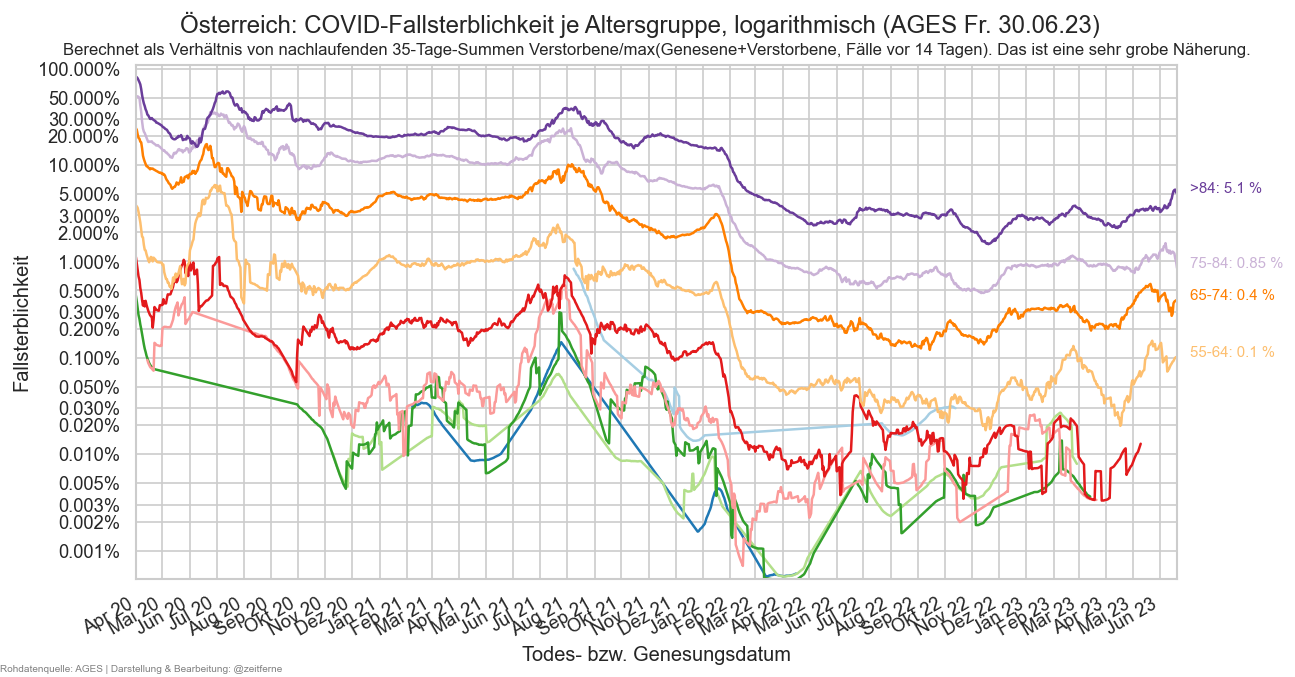
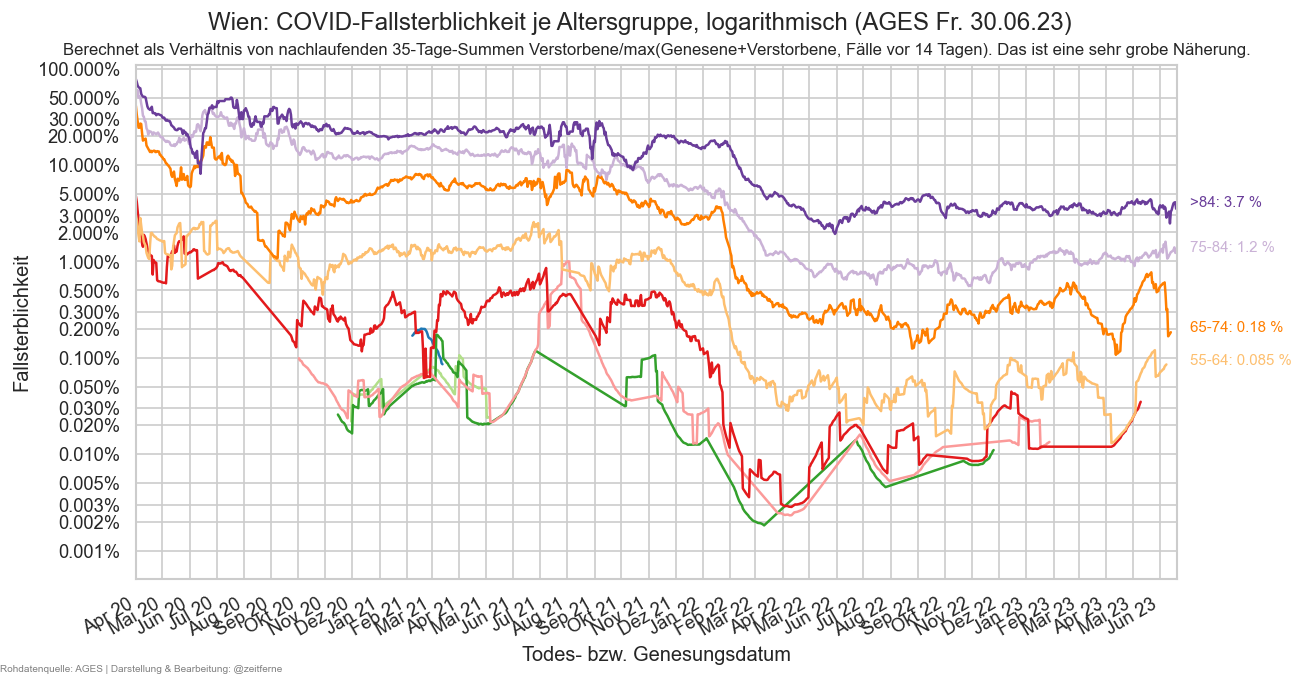
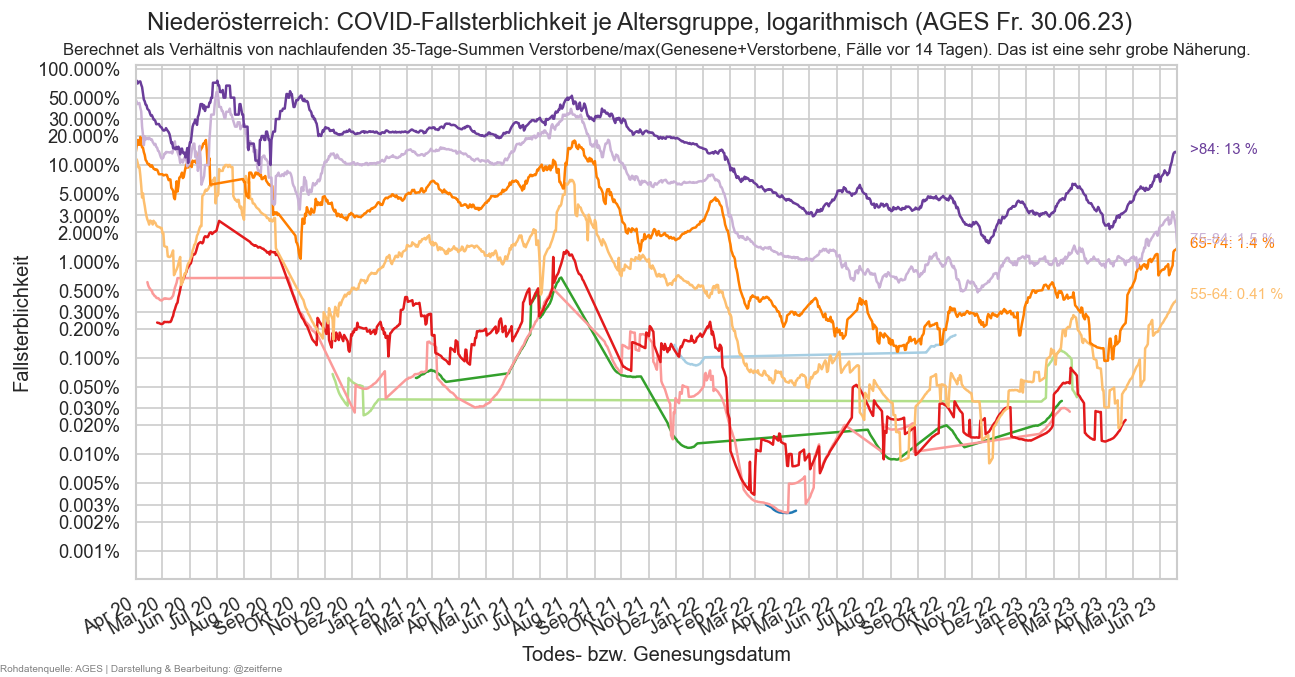
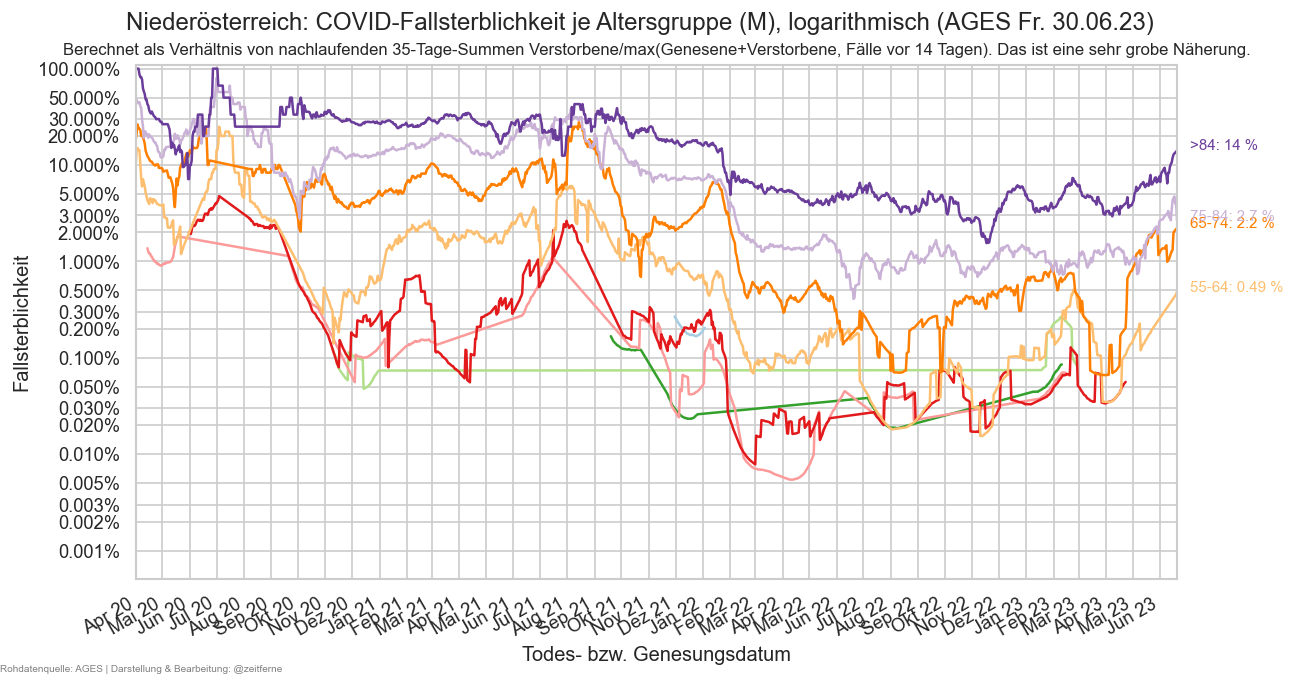
Prognose Todesfälle¶
def calc_cfr_all(cutoff=9, rwidth=35):
calcby = ["Altersgruppe", "Geschlecht", "Bundesland"]
fsbase = agd.query(f"Bundesland != 'Österreich' and Altersgruppe != 'Alle'").set_index(
calcby + ["Datum"])
fs2 = fsbase
fs2.sort_index(inplace=True)
fsg = fs2.groupby(level=calcby)
fs2["deadsum"] = fsg["AnzahlTotSum"].transform(lambda s: s.iloc[:-cutoff] - s.iloc[:-cutoff].shift(rwidth))
fs2["deadsum"] = fs2["deadsum"][fs2["deadsum"] > 0]
fs2["casesum"] = fsg["AnzahlGeheilt"].transform(lambda s: s - s.shift(rwidth))
fs2["casesum"].clip(
inplace=True,
lower=fsg["AnzahlFaelle"].transform(lambda s: s.rolling(rwidth, min_periods=1).sum().shift(14)))
assert not (fs2["casesum"] < 0).any()
fs2["casesum"] += fs2["deadsum"]
#fs2.loc[fs2["AnzahlTot"] > 0, "cfr"] = fs2["deadsum"] / fs2["casesum"]
fs2["cfr"] = fs2["deadsum"] / fs2["casesum"]
fs2 = fs2.loc[
fs2.index.get_level_values("Datum") >= fs2.loc[np.isfinite(fs2["cfr"])].index.get_level_values("Datum").min()]
fs2 = fs2.loc[np.isfinite(fs2["cfr"])]
return fs2, fsbase
cfr = cov.filterlatest(calc_cfr_all()[0].reset_index("Datum"))
#display(cfr.query("Bundesland == 'Wien'"))
cfrs = (cov.filterlatest(agd).query("Bundesland != 'Österreich'").set_index(["Altersgruppe", "Geschlecht", "Bundesland"])["AnzahlFaelle7Tage"] * cfr["cfr"])
cfrs.sum()#, cfrs.loc[np.isfinite(cfrs)]
2.2765
cov=reload(cov)
def calc_forecast(selbl, cutoff=9, tilldate=None):
hcfr = calc_cfr_all(cutoff=cutoff)[0]
return calc_forecast_from_cfr(hcfr, selbl, cutoff, tilldate)
def calc_forecast_from_cfr(hcfr, selbl, cutoff=9, tilldate=None):
if tilldate is not None:
hcfr = hcfr[hcfr.index.get_level_values("Datum") < tilldate]
fromdate = "2022-04-19"
hcase = (
agd.query(("Bundesland != 'Österreich'" if not selbl else f"Bundesland == '{selbl}'")
+ " and Altersgruppe != 'Alle'")
.set_index(["Altersgruppe", "Geschlecht", "Bundesland", "Datum"])["AnzahlFaelle7Tage"])
#display("forecast with", cov.filterlatest(hcfr.reset_index("Datum"))[["Datum", "cfr"]])
forecast = pd.concat([
#(hcfr.query("Bundesland != 'Österreich'")["AnzahlFaelle7Tage"] * hcfr["cfr"]).groupby("Datum").sum(),
(cov.filterlatest(hcfr.reset_index("Datum"))["cfr"] * hcase).groupby("Datum").sum()
]).shift(14, freq="D")#.iloc[-MIDRANGE_NDAYS:]
forecast = forecast[forecast.index >= pd.to_datetime(fromdate)]
#print(forecast.index[-1], forecast.iloc[-1])
return forecast
def drawforecast(ax, selbl, cfr_all, mode):
#selbl = "Burgenland"
selblname = selbl
if selbl == "Österreich":
selbl = None#if selbl is None else selbl
else:
selbl = selblname
maxcfr = cfr_all
maxfc = (
(maxcfr["AnzEinwohner"] *
maxcfr.query(
(f"Bundesland != 'Österreich'" if not selbl else f"Bundesland == '{selbl}'")
+ " and Altersgruppe != 'Alle'")["cfr"])
.groupby(level="Datum").sum())
maxdt = maxfc.iloc[-90:].idxmax()
mindt = maxfc.iloc[-90:-3].idxmin()
#ax.plot(fs[fs["Bundesland"] == selblname].set_index("Datum")["AnzahlTot"])
#print(f"{maxdt=}", maxfc.iloc[-21:].max())
forecast = calc_forecast_from_cfr(cfr_all, selbl, cutoff=9, tilldate=pd.to_datetime("2022-06-02"))
def get_actual_d1(fs):
return fs[fs["Datum"] >= forecast.index[0] - timedelta(7)].query(f"Bundesland == '{selblname}'").groupby("Datum")["AnzahlTot"].sum()
d1 = get_actual_d1(fs)
d7 = d1.rolling(7).sum()
pfx = "Schätzung aus Infektionsfällen, " if mode == 'single' else ""
forecast.plot(ax=ax, ls="--", label="CFR vom 1. Juni",
#marker="o", mew=0, markersize=3
)
if mode == "single":
bs = ax.bar(d1.index, d1, color="k", snap=False, aa=True, lw=0, width=0.4)
for bi in bs[-9 - 4:]:
bi.set_alpha(0.25)
#calc_forecast(cutoff=9, tilldate=pd.to_datetime("2022-04-11")).plot(
# ax=ax, ls="--",label="Schätzung aus Infektionsfällen, CFR vom 10. April")
#calc_forecast(cutoff=1).iloc[-16:].plot(
#ax=ax, ls="--", label="Schätzung aus Infektionsfällen, CFR vor 1 T")
#calc_forecast(cutoff=16).iloc[-16:].plot(ax=ax, ls="--", label="Schätzung aus Infektionsfällen, CFR vor 16 T")
if mode == 'single':
max_suf = ", d.h. " + maxdt.strftime("%d.%m.")
min_suf = ", d.h. " + mindt.strftime("%d.%m.")
else:
max_suf = min_suf = ""
calc_forecast_from_cfr(cfr_all, selbl, cutoff=1, tilldate=maxdt + timedelta(0.1)).plot(
ax=ax, ls="--", label=pfx + "max(CFR letzte 90 T)" + max_suf)
calc_forecast_from_cfr(cfr_all, selbl, cutoff=1, tilldate=mindt + timedelta(0.1)).plot(
ax=ax, ls="--", label=pfx + "min(CFR letzte 90 T)" + min_suf)
#lim = ax.get_xlim()
#hcase.groupby("Datum")["AnzahlTotTaeglich"].rolling(7).sum().plot()
marker = "." if mode == "single" else None
ax.plot(get_actual_d1(ages_old7).rolling(7).sum(), color="brown", lw=0.7, label="Stand vor 7 T")
d7.iloc[:-9].plot(ax=ax, label="Gemeldet", color="k", marker=marker, mew=0)
ax.plot(d7.iloc[-9 - 1:], color="k", alpha=0.5, marker=marker, mew=0)
cov.set_date_opts(ax, forecast.index.get_level_values("Datum"), week_always=True, showyear=False)
#ax.figure.autofmt_xdate()
ax.set_xlim(right=ax.get_xlim()[1] + 14)
if mode == "single":
ax.figure.suptitle(
f"COVID-19-Todesfälle pro Woche, {selblname}; Datenstand " + ages_vdate.strftime("%x"),
y=0.95)
ax.legend()
else:
ax.set_title(selblname, y=0.95)
ax.set_ylabel("Tote/7-Tage")
ax.set_xlabel("Todesdatum")
if True:
ax.set_ylim(bottom=0)
else:
cov.set_logscale(ax)
#ax.legend(fontsize="x-small", ncol=2)
#print(hcfr.index.names, hcase.index.names)
#death_forecast.plot()
fig, axs = plt.subplots(nrows=5, ncols=2, sharex=True, figsize=(14, 14))
cfr_all = calc_cfr_all(cutoff=1)[0]
for bl, ax in zip(fs["Bundesland"].unique(), axs.flat):
drawforecast(ax, bl, cfr_all, mode="multi")
if ax is axs.flat[0]:
fig.legend(frameon=False, loc="upper center", bbox_to_anchor=(0.5, 0.92), ncol=5)
fig.suptitle(
f"COVID-19-Todesfälle pro Woche, je Bundesland; Datenstand " + ages_vdate.strftime("%x"),
y=0.93)
fig, ax = plt.subplots()
drawforecast(ax, "Österreich", cfr_all, mode="single")
if False:
fig, ax = plt.subplots()
drawforecast(ax, "Niederösterreich", cfr_all, mode="single")
fig, ax = plt.subplots()
drawforecast(ax, "Steiermark", cfr_all, mode="single")
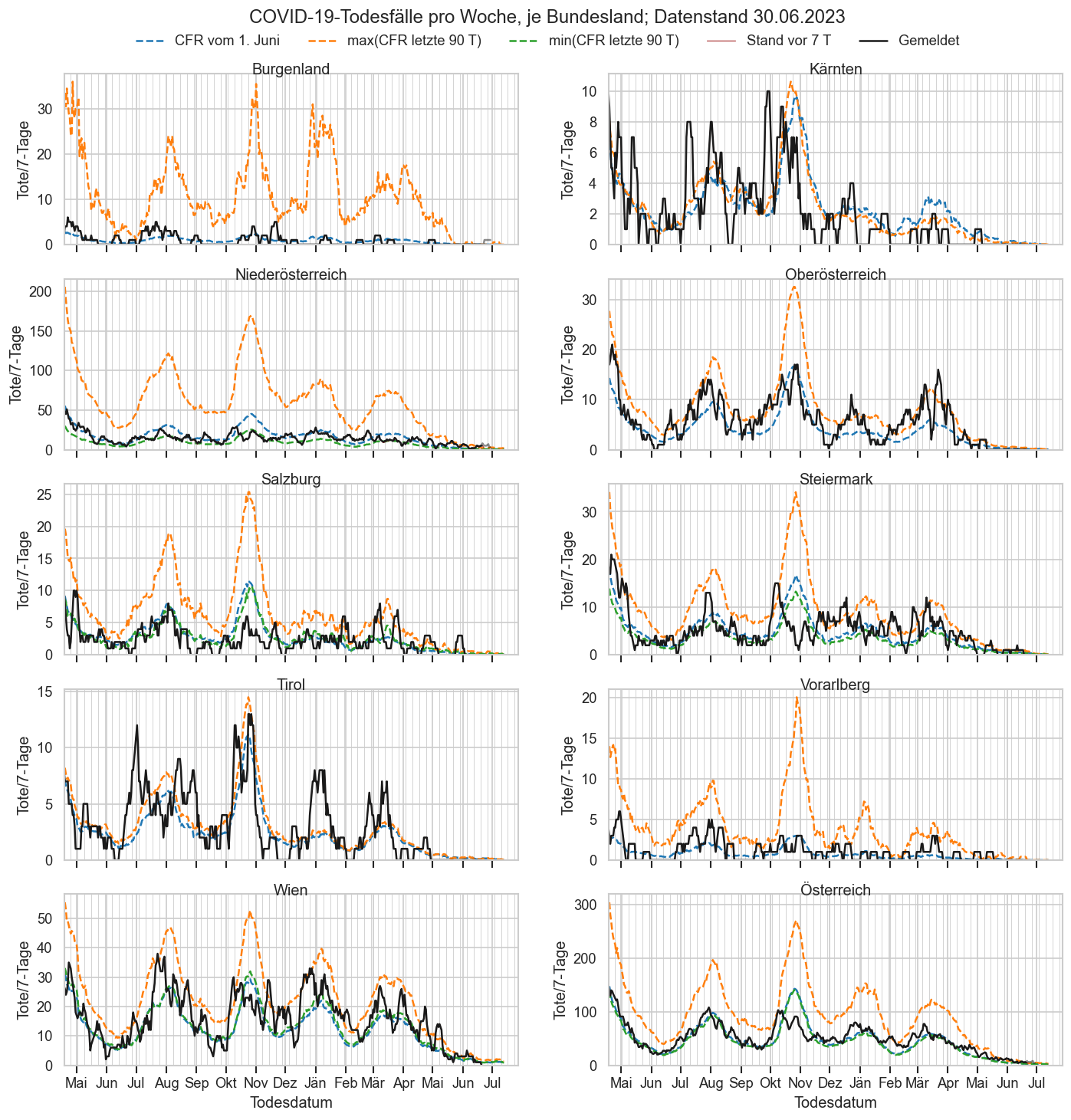
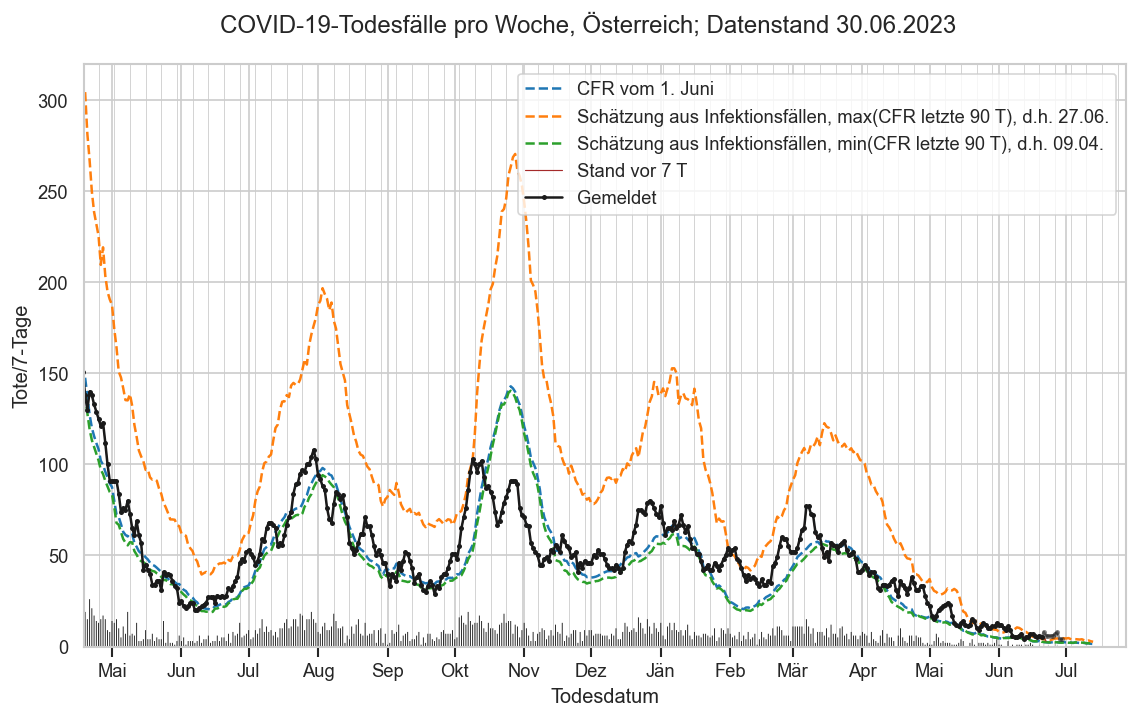
print(DT_SCHULBEG)
ag_schuljahr = agd_sums_at[agd_sums_at["Datum"] >= pd.to_datetime(DT_SCHULBEG)]#pd.to_datetime("2022-01-08")]
def agagg(ags):
#assert ags["Altersgruppe"].nunique() >= 3
return ags.groupby("Datum").agg({
"AnzahlTotSum": "sum", "AnzahlFaelleSum": "sum", "AnzahlFaelle": "sum"})
ag_eltern = agagg(ag_schuljahr.query("Altersgruppe in ('25-34', '35-44', '45-54')"))
ag_geltern = agagg(ag_schuljahr.query("AgeFrom >= 55"))
#ag_eltern["AnzahlTot"].sum()
agk = agagg(ag_schuljahr.query("Altersgruppe in ('<5', '5-14', '15-24')"))
print("Verstorbene seit Schulbeginn / Ges 0-24:",
int(agk.iloc[-1]["AnzahlTotSum"] - agk.iloc[0]["AnzahlTotSum"]), "/",
int(agk.iloc[-1]["AnzahlTotSum"]))
print("Verstorbene seit Schulbeginn / Ges 25-54:",
int(ag_eltern.iloc[-1]["AnzahlTotSum"] - ag_eltern.iloc[0]["AnzahlTotSum"]), "/",
int(ag_eltern.iloc[-1]["AnzahlTotSum"]))
print("Verstorbene seit Schulbeginn / Ges 55+:",
int(ag_geltern.iloc[-1]["AnzahlTotSum"] - ag_geltern.iloc[0]["AnzahlTotSum"]), "/",
int(ag_geltern.iloc[-1]["AnzahlTotSum"]))
agk2 = agagg(ag_schuljahr.query("Altersgruppe in ('5-14',)"))
print("Fälle seit Schulbeginn / Ges 5-14:",
int(agk2.iloc[-1]["AnzahlFaelleSum"] - agk2.iloc[0]["AnzahlFaelleSum"]), "/",
int(agk2.iloc[-1]["AnzahlFaelleSum"]))
2021-09-06 Verstorbene seit Schulbeginn / Ges 0-24: 16 / 30 Verstorbene seit Schulbeginn / Ges 25-54: 301 / 602 Verstorbene seit Schulbeginn / Ges 55+: 9069 / 21909 Fälle seit Schulbeginn / Ges 5-14: 647756 / 704498
if False:
data = cov.filterlatest(agd).query("Altersgruppe == '<5'") #.query("Bundesland == 'Österreich'")
data.sort_values("AnzahlFaelleSum", ascending=False).set_index(np.arange(1, len(data) + 1))[
["Bundesland", "Altersgruppe", "AnzEinwohner", "AnzahlFaelleSum", "AnzahlFaelleSumProEW", "AnzahlTotSum", "Geschlecht"]
]
deaths = cov.filterlatest(agd1m).set_index(["Datum", "Altersgruppe", "Geschlecht", "Bundesland"]).sort_index()
deaths["AnzahlTot"] = deaths["AnzahlTot"].astype(int)
display(Markdown("## Summe Änderungen gemeldeter Toter in Altersgruppendaten" + AGES_STAMP))
display(deaths[["AnzahlTot"]].query("AnzahlTot != 0 and Bundesland != 'Österreich'")) #and Altersgruppe == '>84'
display(Markdown("**Summe Änderungen aus Altersgruppendaten: " + format(
cov.filterlatest(agd1m_sums).query("Bundesland == 'Österreich' and Altersgruppe != 'Alle'")["AnzahlTot"].sum().astype(int), "+d") + "**"))
deathsb = cov.filterlatest(bez1m).query("AnzahlTot != 0")
deathsb = deathsb[~np.isnan(deathsb["GKZ"])]
deathsb["AnzahlTot"] = deathsb["AnzahlTot"].astype(int)
display(Markdown("## Summe Änderungen gemeldeter Toter in Bezirksdaten" + AGES_STAMP))
display(deathsb.set_index(["Datum", "Bundesland", "Bezirk"]).sort_index()[["AnzahlTot"]])
#display(Markdown("**Summe Änderungen aus Bundesländerdaten: " + format(cov.filterlatest(ages1m).query("Bundesland == 'Österreich'")["AnzahlTot"].iloc[-1].astype(int), "+d") + "**"))
display(Markdown("**Summe Änderungen aus Bundesländerdaten: " + format(cov.filterlatest(ages1m).query("Bundesland == 'Österreich'")["AnzahlTot"].iloc[-1].astype(int), "+d") + "**"))
display(Markdown("**Summe Änderungen aus Bezirksdaten: " + format(cov.filterlatest(bez1m).query("GKZ > 0")["AnzahlTot"].sum().astype(int), "+d") + "**"))
Summe Änderungen gemeldeter Toter in Altersgruppendaten (AGES Fr. 30.06.23)¶
| AnzahlTot | ||||
|---|---|---|---|---|
| Datum | Altersgruppe | Geschlecht | Bundesland | |
| 2023-06-30 | >84 | W | Burgenland | 1 |
| Niederösterreich | 1 |
Summe Änderungen aus Altersgruppendaten: +2
Summe Änderungen gemeldeter Toter in Bezirksdaten (AGES Fr. 30.06.23)¶
| AnzahlTot | |||
|---|---|---|---|
| Datum | Bundesland | Bezirk | |
| 2023-06-30 | Burgenland | Neusiedl am See | 1 |
| Niederösterreich | Melk | 1 |
Summe Änderungen aus Bundesländerdaten: +2
Summe Änderungen aus Bezirksdaten: +2
idxkeys = ["Datum", "Bundesland", "Altersgruppe", "Geschlecht"]
diffdt_ag = agd.set_index(idxkeys)["AnzahlTot"].sub(agd_old.set_index(idxkeys)["AnzahlTot"], fill_value=0)
#diffdt["AnzahlTot"] = diffdt["AnzahlTot"].astype(int)
display(Markdown("## Änderungen gemeldeter Toter in Altersgruppendaten" + AGES_STAMP))
diffdt_ag = diffdt_ag[(diffdt_ag != 0) & np.isfinite(diffdt_ag)].astype(int).to_frame().query("Bundesland != 'Österreich'")
idxkeys = ["Datum", "Bundesland", "Bezirk"]
diffdt_bez = bez.set_index(idxkeys).query("GKZ > 0")["AnzahlTot"].sub(bez_old.set_index(idxkeys).query("GKZ > 0")["AnzahlTot"], fill_value=0)
diffdt_bez = diffdt_bez[(diffdt_bez != 0) & np.isfinite(diffdt_bez)].astype(int)
Änderungen gemeldeter Toter in Altersgruppendaten (AGES Fr. 30.06.23)¶
cov=reload(cov)
def print_d():
bezopen = diffdt_bez.copy()
print("#Covid19at-Todesfälle, gemeldet am " + ages_vdate.strftime("%a %x") + ":")
print()
tod = pd.to_datetime(date.today())
for row in diffdt_ag.itertuples():
ddate, bl, ag, sex = row[0]
try:
bezmatch = diffdt_bez.loc[(ddate, bl)]
except KeyError:
bezmatch = ()
def print_row(loc):
if row.AnzahlTot <= 0:
print(row.AnzahlTot, end=" ")
print(ddate.strftime("%a").removesuffix(".") if (tod - ddate).days < 7
else ddate.strftime("%d.%m") if ddate.year == tod.year
else ddate.strftime("%x"), sex, ag, loc)
if len(bezmatch) == 1:
#print(bezmatch, bezmatch.index[0])
loc = cov.shorten_bezname(bezmatch.index[0], soft=True)
bezopen.loc[(ddate, bl)] = bezopen.loc[(ddate, bl)].to_numpy() - row.AnzahlTot
elif len(bezmatch) > 1 and bezmatch.sum() == row.AnzahlTot:
for loc in (cov.shorten_bezname(bezm0, soft=True) for bezm0 in bezmatch.index):
print_row(loc)
bezopen.loc[(ddate, bl)] = 0
continue
else:
loc = cov.SHORTNAME2_BY_BUNDESLAND[bl].removesuffix(".")
for i in range(max(1, row.AnzahlTot)):
print_row(loc)
#print(row, len(bezmatch), bezmatch.index.get_level_values("Bezirk")[0])
bezbad = bezopen[bezopen != 0]
if len(bezbad) != 0:
display(bezbad)
print("*** overbooked or unused Bezirke")
#diffdt["AnzahlTot"] = diffdt["AnzahlTot"].astype(int)
print_d()
display(Markdown("## Änderungen gemeldeter Toter in Bezirksdaten" + AGES_STAMP))
display(diffdt_ag)
display(diffdt_bez.to_frame().query("Bundesland != 'Österreich'"))
#Covid19at-Todesfälle, gemeldet am Fr. 30.06.2023: 23.06 W >84 Neusiedl/See 27.06 W >84 Melk
Änderungen gemeldeter Toter in Bezirksdaten (AGES Fr. 30.06.23)¶
| AnzahlTot | ||||
|---|---|---|---|---|
| Datum | Bundesland | Altersgruppe | Geschlecht | |
| 2023-06-23 | Burgenland | >84 | W | 1 |
| 2023-06-27 | Niederösterreich | >84 | W | 1 |
| AnzahlTot | |||
|---|---|---|---|
| Datum | Bundesland | Bezirk | |
| 2023-06-23 | Burgenland | Neusiedl am See | 1 |
| 2023-06-27 | Niederösterreich | Melk | 1 |
if DISPLAY_SHORTRANGE_DIAGS:
deaths_s = cov.filterlatest(agd1m_sums).query("Bundesland == 'Österreich'").set_index(["Altersgruppe"]).sort_index()
ax = (deaths_s["AnzahlTot"] / deaths_s["AnzahlTotSum"]).sort_index(axis="rows", key=lambda s: s.map(ag_to_id)).plot.bar()
cov.set_percent_opts(ax, decimals=2)
ax.set_title("Prozentuale Änderung insgesamt gemeldeter Toter je Altersgruppe" + AGES_STAMP)
Aus der OÖ Landeskorrespondenz¶
Details zu OÖ basierend auf https://www.land-oberoesterreich.gv.at/lksuche.htm
ooch_o = pd.read_csv(
COLLECTROOT / "covid/extractlk.csv",
sep=";")
ooch_o["Datum"] = cov.parseutc_at(ooch_o["Datum"], format=cov.ISO_SP_TIME_FMT)
ooch = ooch_o.drop_duplicates("Datum", keep="last").set_index("Datum", verify_integrity=True).sort_index()
lastloc = ooch["chlocs"].last_valid_index()
OO_STAMP = f" (OÖ Landeskorrespondenzen bis {lastloc.strftime('%a %x')})"
def plt_ltcf(ooch=ooch):
ooch = ooch[np.isfinite(ooch["chlocs"])].copy()
#display(ooch)
fig, ax = plt.subplots()
ax.plot(ooch["chlocs"], label="Anzahl Altenheime", marker=".", mew=0, color="C2")
ax.plot(ooch["chstaff"], label="Altenheim-MitarbeiterInnen", marker=".", mew=0)
ax.plot(ooch["chres"], label="Altenheim-BewohnerInnen", marker=".", mew=0)
aargs = {"fontsize":"larger"}
annots = [
(ooch["chlocs"].loc[lastloc], str(int(ooch["chlocs"].loc[lastloc])) + " Heime", {"color":"C2", **aargs}),
(ooch["chres"].loc[lastloc], str(int(ooch["chres"].loc[lastloc])) + " BewohnerInnen", {"color":"C1", **aargs}),
(ooch["chstaff"].loc[lastloc], str(int(ooch["chstaff"].loc[lastloc])) + " MitarbeiterInnen", {"color":"C0", **aargs}),
]
#annots = [(matplotlib.dates.date2num(dt), *xs) for dt, *xs in annots]
#ax.set_xlim(
# left=date(2022, 1, 1),
# right=ooch.index[-1] + timedelta(7))
#dodgeannot(annots, ax)
#ax.annotate(
# , xytext=(3, 0), textcoords="offset points", va="center")
#ax.annotate(,
# (ooch.index[-1], ooch["chres"].iloc[-1]), xytext=(3, 0), textcoords="offset points", va="center")
ax.yaxis.set_major_locator(matplotlib.ticker.MultipleLocator(100))
#ax.plot(ooch["chlocs"])
agd_sums_oo = agd_sums.query("Bundesland == 'Oberösterreich' and AgeFrom >= 5 and AgeFrom <= 35").groupby("Datum").agg({
"Bundesland": "first",
"AnzEinwohner": "sum",
"AnzahlFaelle": "sum",
"AnzahlFaelleSum": "sum",
"AnzahlTotSum": "sum",
"AnzahlGeheilt": "sum",
})
agd_sums_oo["AnzahlTot"] = agd_sums_oo["AnzahlTotSum"].diff()
agd_sums_oo["AnzAktiv"] = (
agd_sums_oo["AnzahlFaelleSum"] - agd_sums_oo["AnzahlGeheilt"] - agd_sums_oo["AnzahlTotSum"])
agd_sums_oo = agd_sums_oo[agd_sums_oo.index.tz_localize(None) >= ooch.index[0].tz_localize(None)]
ax.set_facecolor("none")
#ax2 = ax.twinx()
#ax2.yaxis.set_major_locator(matplotlib.ticker.MaxNLocator(5))
#ax2.plot(agd_sums_oo["AnzAktiv"], color="C4", mew=0, label="Altersgruppe 5-44" + AGES_STAMP, zorder=0)
#ax2.annotate(str(int(agd_sums_oo["AnzAktiv"].iloc[-1])),
# (agd_sums_oo.index[-1], agd_sums_oo["AnzAktiv"].iloc[-1]), xytext=(3, 0), textcoords="offset points", va="center")
#ax2.grid(False)
#ax2.set_zorder(-10)
ax.set_ylabel(f"Aktive Fälle in Altenheimen")
#ax2.set_ylim(bottom=0, top=ax.get_ylim()[1] * 10)
#ax2.yaxis.set_major_locator(matplotlib.ticker.MultipleLocator(1000))
#ax2.set_ylabel("Aktive Fälle 5-44")
ax.legend()#loc="upper left")
#ax2.legend(loc="upper right")
#ax2.set_ylim(bottom=0, top=60_000)
ax.yaxis.set_major_locator(matplotlib.ticker.MaxNLocator('auto', integer=True))
#display(agd_sums_oo)
fig.suptitle(f"Aktive Fälle in Oberösterreichs Alten- und Pflegeheimen" + OO_STAMP, y=0.93, fontsize="large")
cov.set_date_opts(ax, showyear=True)
ax.set_ylim(bottom=0)
fig.autofmt_xdate()
#fig.autofmt_xdate()
plt_ltcf()
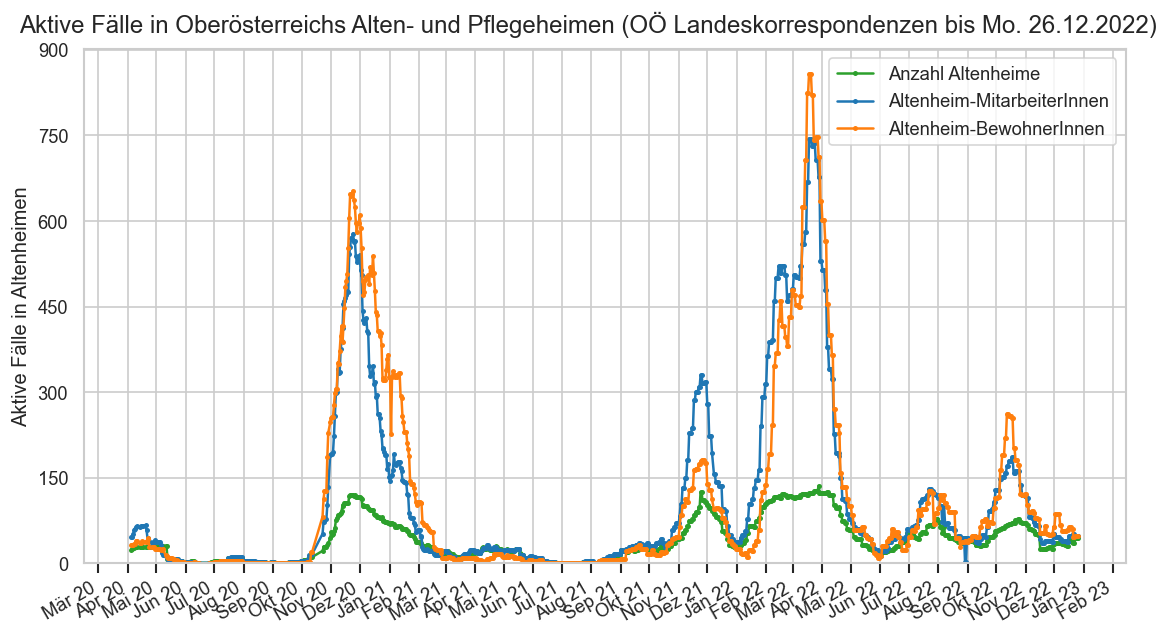
cov=reload(cov)
if False:
fig, ax = plt.subplots()
ax.stackplot(ooch.index,
ooch["hospunvax"], ooch["FZHosp"] - ooch["hospunvax"],
labels=["Nicht vollständig Immunisierte", "Vollständig Immunisierte"],
step="pre", colors=[sns.color_palette()[1], sns.color_palette()[2]], lw=0)
#ax.axhline(0, color="k")
ax.legend()
cov.set_date_opts(ax, showyear=True)
ax.set_title("PatientInnen auf OÖ Normalstationen nach Immunisierung" + OO_STAMP)
fig, ax = plt.subplots()
ax.stackplot(ooch.index,
ooch["icuunvax"], ooch["FZICU"] - ooch["icuunvax"],
labels=["Nicht vollständig Immunisierte", "Vollständig Immunisierte"],
step="pre", colors=[sns.color_palette()[1], sns.color_palette()[2]], lw=0)
#ax.axhline(0, color="k")
ax.legend()
cov.set_date_opts(ax, showyear=True)
ax.set_title("PatientInnen auf OÖ Intensivstationen nach Immunisierung" + OO_STAMP)
ooch_wk = ooch[np.isfinite(ooch["FZHospnew"])].copy()
#idxs = ooch_wk.index.to_series()
#idxs[idxs.dayofweek != matplotlib.dates.SUNDAY] = idxs.
ooch_wk.index = ooch_wk.index.snap(pd.offsets.Week(weekday=0))
ooch_wk["dt"] = ooch_wk.index.strftime("%d.%m.%y")
#ooch_wk["FZICUvnew"] = ooch_wk["FZICUnew"] - ooch_wk["icuunvaxnew"]
#ooch_wk["FZHospvnew"] = ooch_wk["FZHospnew"] - ooch_wk["hospunvaxnew"]
ooch_wk["FZHospnewTotal"] = ooch_wk["FZHospnew"] + ooch_wk["FZICUnew"]
#ax.set_xlim(left=ax.get_xlim()[0])
hosp_oo = hospfz[hospfz["Datum"] >= ooch_wk.index[0].tz_localize(None) - timedelta(7)].query("Bundesland == 'Oberösterreich'")
hosp_oo = hosp_oo[~hosp_oo["Datum"].dt.weekday.isin([5, 6])]
hospa_oo = hosp[hosp["Datum"] >= ooch_wk.index[0].tz_localize(None) - timedelta(7)].query("Bundesland == 'Oberösterreich'")
def plt_oo_hosp(logscale=False):
fig, ax = plt.subplots()
ax.plot(hosp_oo["Datum"], hosp_oo["FZHosp"] + hosp_oo["FZICU"],
label="Belegung (AGES)", color="C1", marker="o")
#ax.plot(hospa_oo["Datum"], hospa_oo["NormalBettenBelCovid19"] + hospa_oo["IntensivBettenBelCovid19"],
# label="Belegung (AGES)", color="C1", marker="o")
args = dict(marker="o") if logscale else dict(lw=0, snap=False, aa=True)
(ax.plot if logscale else ax.bar)(
ooch_wk.index,
ooch_wk["FZHospnewTotal"],
label="Neuaufnahmen/Woche (OÖ Landeskorrespondenz)", zorder=10, **args)
#ax.tick_params(rotation=0)
cov.set_date_opts(ax, hosp_oo["Datum"])
ax.set_xlabel("Woche bis")
ax.set_ylabel("Stationäre PatientInnen")
ax.legend()
if not logscale:
ax.grid(False, axis="x")
fig.suptitle("Stationäre COVID-Krankenhaus-PatientInnen in OÖ" + (", logarithmisch" if logscale else ""), y=0.93)
if logscale:
cov.set_logscale(ax)
plt_oo_hosp()
plt_oo_hosp(True)
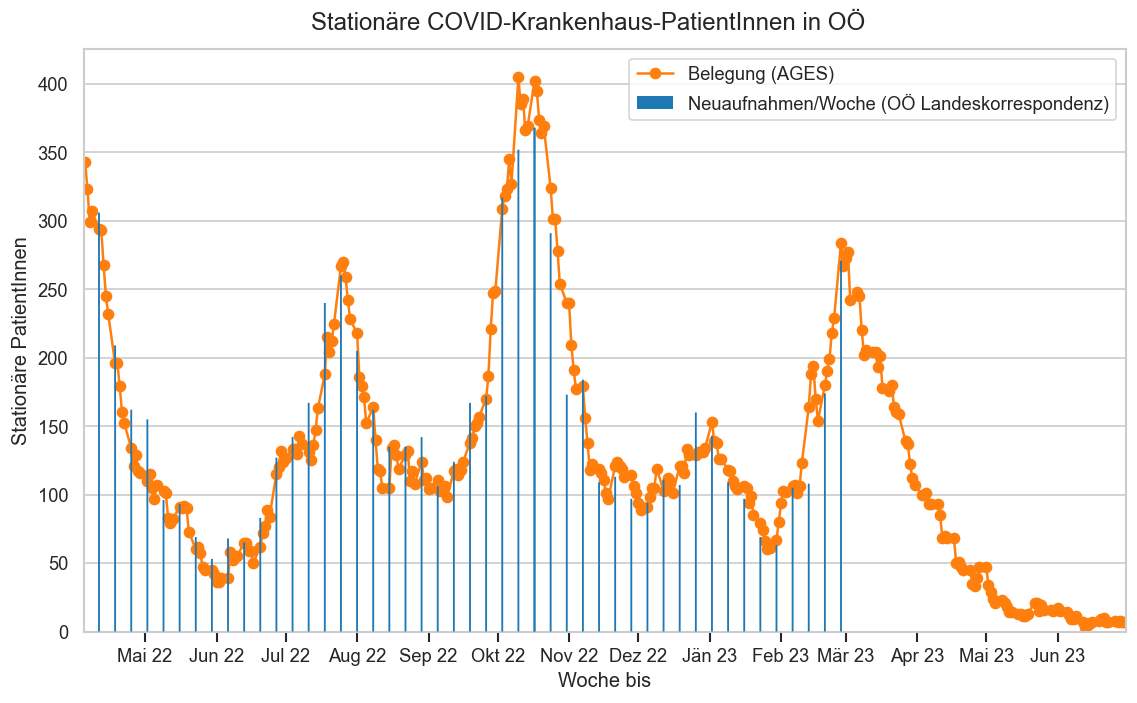
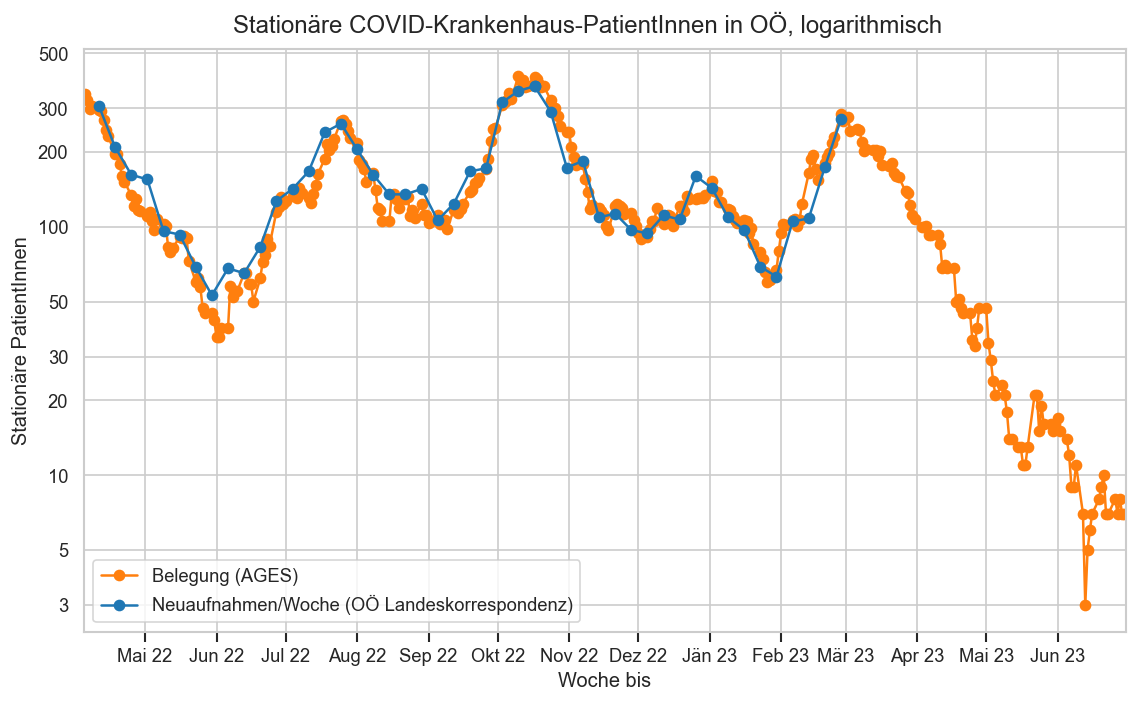
oodead_o = pd.read_csv(
COLLECTROOT / "covid/extractlk.dead.csv",
sep=";")
oodead_o["pubdate"] = cov.parseutc_at(oodead_o["pubdate"], format=cov.ISO_SP_TIME_FMT)
oodead_o["deathdate"] = cov.parseutc_at(oodead_o["deathdate"], format=cov.ISO_DATE_FMT)
oodead = oodead_o.copy()
fmask = pd.isna(oodead["deathdate"])
oodead.loc[fmask, "deathdate"] = oodead["pubdate"] - timedelta(1)
oodead.sort_values(by="deathdate", inplace=True)
oodead["deathdate"] = oodead["deathdate"].dt.normalize().dt.tz_localize(None)
oodead["pubdate"] = oodead["pubdate"].dt.normalize().dt.tz_localize(None)
oodead["deathloc"].nunique()
oodead["deathlockind"] = ""
locs = oodead["deathloc"].fillna("")
medothermarker = r"MVE |Therapiezentrum "
khmarker = (r"[Kk]linikum\b|\b[UL]?KH\b|Landesklinik|Ordensklinik|PEK\b|hospital"
r"|Barmherzige Schwestern Linz|Elisabethinen Linz|SK Bad Ischl|LK Zwettl|St. Josef Braunau am Inn"
r"|OKL\b|Universitätsklinik|Uniklinik|KUM Med Campus"
r"|KUK(?:[, ]|$)|[Kk]rankenh?aus|^Barmherzige (?:Schwestern|Brüder) \S+"
r"|\bSalzkammergut Klinik\b"
r"|\bBHB\b"
+ "|" + medothermarker)
aphmarker = (r"BSH |BHS |[Aa]ltenheim|[Ss]enioren|BAH |\bB?APH\b"
r"|Pflegestation, Gesellenhausstraße|[Aa]lten\b|\b[Pp]flege|pflegeheim|SENIORium|Seniorium"
r"|^Haus |Sozialzentrum |St. Josef Wohnen Sierning")
unkmarker = r"unbekannt|Obduktion|nicht gemeldet|^$"
homemarker = r"\b[Zz]uhause|zu Hause"
oodead["hascond"] = "Vorerkrankung unbekannt"
oodead.loc[oodead["cond"].str.startswith(r"mit ").fillna(False), "hascond"] = "Vorerkrankt"
oodead.loc[oodead["cond"].str.startswith(r"ohne ").fillna(False)
| oodead["cond"].str.startswith(r"keine ").fillna(False), "hascond"] = "Nicht vorerkrankt"
display(oodead["hascond"].value_counts(dropna=False))
oodead.loc[locs.str.contains(khmarker), "deathlockind"] = "Krankenhaus"
oodead.loc[locs.str.contains(aphmarker), "deathlockind"] = "Altenheim"
#oodead.loc[locs.str.contains(medothermarker), "deathlockind"] = "Andere Med. Einrichtung"
oodead.loc[locs.str.contains(unkmarker), "deathlockind"] = "Unbekannt"
oodead.loc[locs.str.contains(homemarker), "deathlockind"] = "Zuhause"
oodead["deathlockind"].unique()
display(oodead["deathlockind"].value_counts(dropna=False))
display(len(oodead))
uncat = locs[(oodead["deathlockind"] == "") | pd.isna(oodead["deathlockind"])].unique()
display(uncat)
assert len(uncat) == 0
loc_order = ["Krankenhaus", "Unbekannt", "Altenheim", "Zuhause"]
age_bins = np.arange(0, oodead["age"].max() + 5, 5)
mindate = matplotlib.dates.date2num(oodead["deathdate"].min())
maxdate = matplotlib.dates.date2num(oodead["deathdate"].max())
binwidth = 7
fs_oo = fs.query("Bundesland == 'Oberösterreich'")
fig, ax = plt.subplots()
fig.suptitle(f"COVID-Tote in OÖ bis {oodead['deathdate'].max().strftime('%x')} nach Sterbeort und Sterbedatum", y=0.92)
fs_oo = fs.query("Bundesland == 'Oberösterreich'")
ax.plot(fs_oo["Datum"], fs_oo["AnzahlTot"].rolling(binwidth).sum(), color="k", label="14-Tage-Summe-Tote AGES", alpha=0.5)
sns.histplot(data=oodead, x="deathdate", hue="deathlockind", multiple="stack", ax=ax,
bins=np.arange(mindate, maxdate + binwidth, binwidth), #hue_order=[None, 'Unbekannt', 'Altenheim', 'Zuhause']
hue_order=loc_order)
#aphdead.iloc[aphdead["age"].argmin()]
#ax.legend()
ax.get_legend().set_title("")
ax.set_xlabel("Datum")
ax.set_ylabel("Anzahl")
cov.set_date_opts(ax, showyear=True)
fig.autofmt_xdate()
ttlbase = f"COVID-Tote in OÖ bis {oodead['deathdate'].max().strftime('%x')}"
fig, ax = plt.subplots()
fig.suptitle(ttlbase + " nach Vorerkrankung und Sterbedatum", y=0.92)
ax.plot(fs_oo["Datum"], fs_oo["AnzahlTot"].rolling(binwidth).sum(), color="k", label=f"{binwidth}-Tage-Summe-Tote AGES", alpha=0.5)
sns.histplot(data=oodead, x="deathdate", hue="hascond", multiple="stack", ax=ax,
bins=np.arange(mindate, maxdate + binwidth , binwidth))
#aphdead.iloc[aphdead["age"].argmin()]
#ax.legend()
ax.set_xlabel("Datum")
ax.set_ylabel("Anzahl")
cov.set_date_opts(ax, showyear=True)
fig.autofmt_xdate()
def pltdeadage(partitions):
fig, axs = plt.subplots(ncols=len(partitions), sharex=True, sharey=True)
fig.suptitle("COVID-Tote in Oberösterreich je Welle und Sterbeort" + OO_STAMP)
fig.subplots_adjust(wspace=0.05)
isfirst = True
for ax, oodead in zip(axs.flat if len(partitions) > 1 else (axs,), partitions):
ddate = oodead['deathdate']
ax.set_title(f"{ddate.min().strftime('%x')} ‒ {ddate.max().strftime('%x')}")
mindate = matplotlib.dates.date2num(oodead["deathdate"].min() - timedelta(oodead["deathdate"].min().weekday()))
maxdate = matplotlib.dates.date2num(oodead["deathdate"].max())
xisage=True
if xisage:
ax = sns.histplot(data=oodead, x="age", hue="deathlockind", multiple="stack",
ax=ax, hue_order=loc_order, bins=age_bins, kde=False, legend=isfirst)
if len(oodead) >= 1000:
sns.rugplot(data=oodead.query("age < 45"), x="age", ax=ax, color="k", alpha=0.3, legend=False)
#aphdead.iloc[aphdead["age"].argmin()]
ax.set_xlabel("Alter")
ax.set_xlim(left=0)
ax.xaxis.set_major_locator(matplotlib.ticker.MaxNLocator('auto', min_n_ticks=4, integer=True))
else:
ax = sns.histplot(data=oodead, x="deathlockind", hue="deathlockind", multiple="stack",
ax=ax, hue_order=loc_order, bins=age_bins, kde=False, legend=False)
ax.set_xlabel("Sterbeort")
if isfirst:
if xisage:
ax.get_legend().set_title("Sterbeort")
ax.set_ylabel("Anzahl")
isfirst = False
if False:
fig, ax = plt.subplots(figsize=(8, 8))
fig.suptitle(ttlbase + " nach Alter und Vorerkrankung", y=0.92)
ax = sns.histplot(data=oodead, x="age", hue="hascond", multiple="stack", ax=ax, bins=age_bins, kde=False)
#aphdead.iloc[aphdead["age"].argmin()]
ax.get_legend().set_title("")
ax.set_xlabel("Alter")
ax.set_ylabel("Anzahl")
#oodead["deathlockind"].unique()
fig, ax = plt.subplots(figsize=(8, 8))
fig.suptitle(ttlbase + " nach Sterbeort und Vorerkrankung", y=0.92)
ax = sns.histplot(data=oodead, x="deathlockind", hue="hascond", multiple="dodge", ax=ax, shrink=.8)
#aphdead.iloc[aphdead["age"].argmin()]
ax.get_legend().set_title("")
ax.set_xlabel("Todesort")
ax.set_ylabel("Anzahl")
if not xisage:
fig.autofmt_xdate()
pltdeadage([oodead])
pltdeadage([
#oodead.query("deathdate > '2020-09-01' and deathdate <= '2021-09-01'"),
oodead.query("deathdate > '2021-03-01' and deathdate <= '2021-07-01'"),
oodead.query("deathdate > '2021-07-01' and deathdate <= '2022-01-15'"),
oodead.query("deathdate > '2022-01-15' and deathdate <= '2022-06-12'"),
oodead.query("deathdate > '2022-06-12'")]);
#display(oodead))
hascond Vorerkrankt 2446 Vorerkrankung unbekannt 527 Nicht vorerkrankt 81 Name: count, dtype: int64
deathlockind Krankenhaus 2270 Unbekannt 453 Altenheim 296 Zuhause 35 Name: count, dtype: int64
3054
array([], dtype=object)
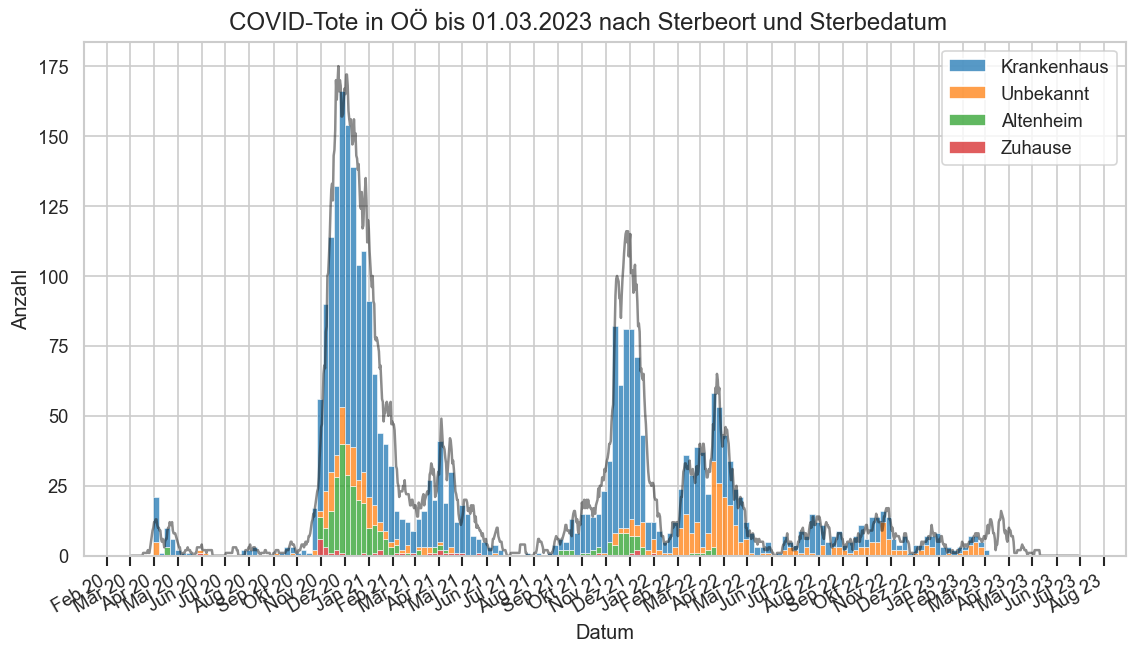
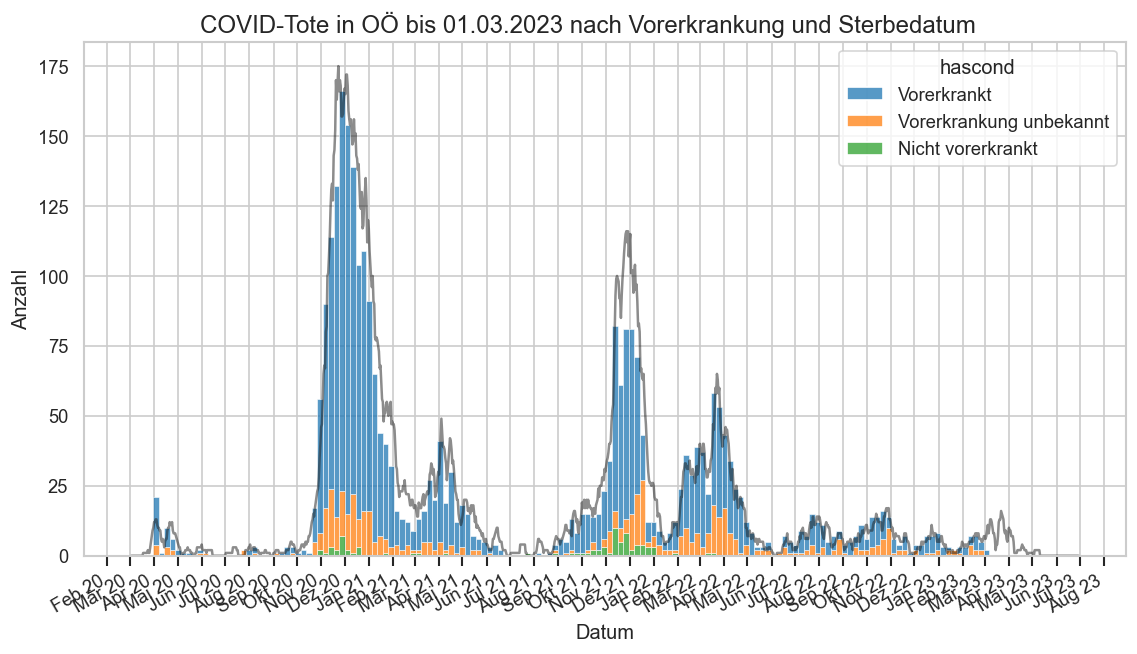
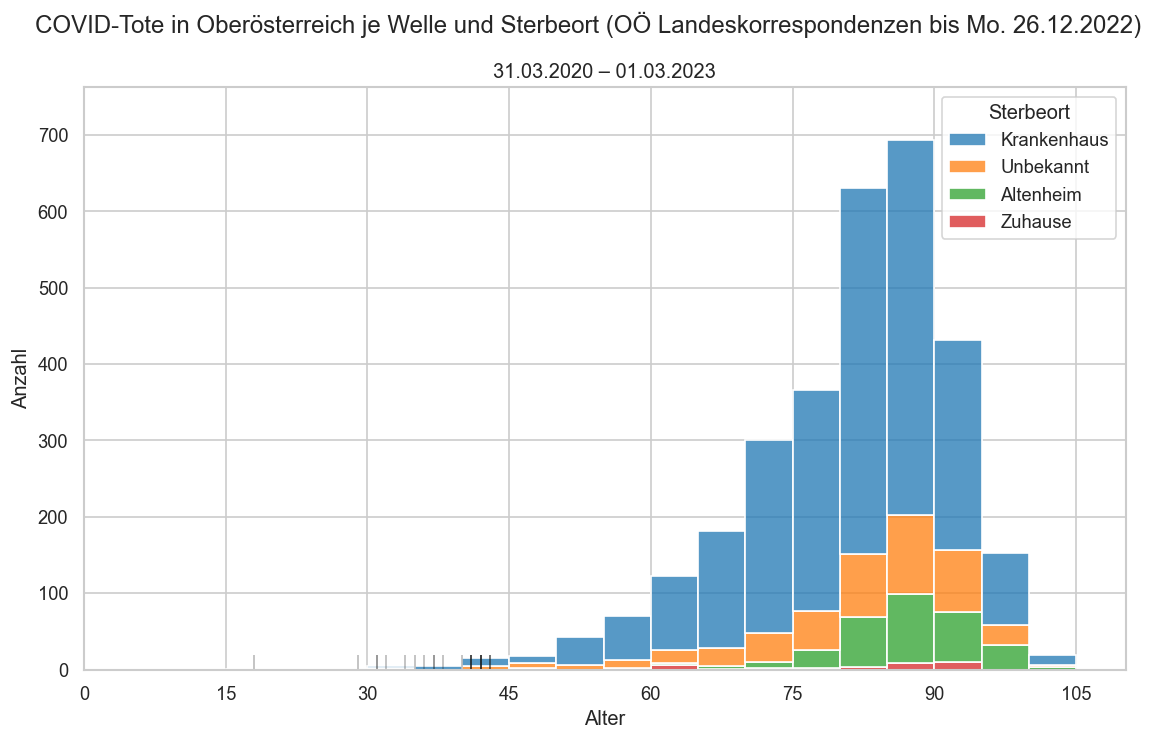

oodead["mdelay"] = oodead["pubdate"] - oodead["deathdate"]
oodead.sort_values(["pubdate", "deathdate"]).tail(200)["mdelay"].quantile(0.9)
Timedelta('6 days 02:23:59.999999999')
oodead.sort_values(["pubdate", "deathdate"]).tail(30)[["pubdate", "deathdate", "label", "age", "district", "deathloc", "cond"]]
| pubdate | deathdate | label | age | district | deathloc | cond | |
|---|---|---|---|---|---|---|---|
| 3024 | 2023-01-24 | 2023-01-22 | Patient | 89 | Gmunden | Salzkammergut Klinikum, Gmunden | Vorerkrankungen unbekannt |
| 3025 | 2023-01-27 | 2023-01-25 | Mann | 90 | Linz | Sterbeort unbekannt | Vorerkrankungen unbekannt |
| 3026 | 2023-01-31 | 2023-01-29 | Patient | 62 | Schärding | Klinikum Schärding | mit Vorerkrankungen |
| 3027 | 2023-02-05 | 2023-01-31 | Patient | 79 | Steyr-Stadt | Pyhrn-Eisenwurzenklinikum, Standort Steyr. | mit Vorerkrankungen |
| 3028 | 2023-02-07 | 2023-01-27 | Patientin | 85 | Linz | Krankenhaus der Barmherzigen Brüder, Linz | mit Vorerkrankungen |
| 3029 | 2023-02-07 | 2023-02-04 | Mann | 59 | Linz | Sterbeort unbekannt | mit Vorerkrankungen |
| 3030 | 2023-02-08 | 2023-01-05 | Patient | 83 | Perg | Krankenhaus der Barmherzigen Schwestern, Linz | mit Vorerkrankungen |
| 3031 | 2023-02-09 | 2023-01-31 | Mann | 78 | Steyr | Sterbeort unbekannt | mit Vorerkrankungen |
| 3032 | 2023-02-09 | 2023-02-07 | Patientin | 96 | Rohrbach | Klinikum Rohrbach | mit Vorerkrankungen |
| 3033 | 2023-02-11 | 2023-01-14 | Mann | 88 | Linz | Sterbeort unbekannt | Vorerkrankungen unbekannt |
| 3034 | 2023-02-11 | 2023-02-09 | Patient | 81 | Rohrbach | Klinikum Freistadt | Vorerkrankungen unbekannt |
| 3035 | 2023-02-11 | 2023-02-09 | Mann | 86 | Steyr-Land | Sterbeort unbekannt | Vorerkrankungen unbekannt |
| 3036 | 2023-02-14 | 2023-02-11 | Frau | 76 | Freistadt | Sterbeort unbekannt | mit Vorerkrankungen |
| 3037 | 2023-02-14 | 2023-02-11 | Patientin | 65 | Gmunden | Salzkammergut Klinikum Vöcklabruck | Vorerkrankungen unbekannt |
| 3038 | 2023-02-14 | 2023-02-12 | Frau | 72 | Wels-Land | Sterbeort unbekannt | mit Vorerkrankungen |
| 3039 | 2023-02-17 | 2023-02-15 | Patient | 89 | Freistadt | Klinikum Freistadt | mit Vorerkrankungen |
| 3040 | 2023-02-17 | 2023-02-15 | Mann | 91 | Gmunden | Sterbeort unbekannt | mit Vorerkrankungen |
| 3041 | 2023-02-17 | 2023-02-15 | Mann | 89 | Linz-Land | Sterbeort unbekannt | mit Vorerkrankungen |
| 3042 | 2023-02-17 | 2023-02-16 | Patient | 87 | Vöcklabruck | Salzkammergut Klinikum Vöcklabruck | mit Vorerkrankungen |
| 3043 | 2023-02-19 | 2023-02-17 | Mann | 86 | Grieskirchen | Sterbeort unbekannt | mit Vorerkrankungen |
| 3044 | 2023-02-21 | 2023-02-18 | Mann | 79 | Vöcklabruck | Sterbeort unbekannt | Vorerkrankungen unbekannt |
| 3045 | 2023-02-23 | 2023-02-13 | Mann | 85 | Linz | Sterbeort unbekannt | Vorerkrankungen unbekannt |
| 3046 | 2023-02-24 | 2023-02-20 | Frau | 82 | Gmunden | Sterbeort unbekannt | Vorerkrankungen unbekannt |
| 3047 | 2023-02-24 | 2023-02-22 | Mann | 86 | Linz | Sterbeort unbekannt | Vorerkrankungen unbekannt |
| 3048 | 2023-02-25 | 2023-02-23 | Mann | 91 | Gmunden | Sterbeort unbekannt | mit Vorerkrankungen |
| 3049 | 2023-02-25 | 2023-02-24 | Mann | 83 | Linz-Land | Sterbeort unbekannt | Vorerkrankungen unbekannt |
| 3050 | 2023-03-02 | 2023-02-27 | Patientin | 73 | Linz-Land | Krankenhaus der Barmherzigen Schwestern, Linz | mit Vorerkrankungen |
| 3051 | 2023-03-02 | 2023-02-27 | Patient | 76 | der Stadt Linz | Krankenhaus der Barmherzigen Schwestern, Linz | mit Vorerkrankungen |
| 3052 | 2023-03-03 | 2023-02-28 | Patientin | 95 | Kirchdorf | PEK, Kirchdorf | mit Vorerkrankungen |
| 3053 | 2023-03-03 | 2023-03-01 | Patient | 61 | Braunau | Krankenhaus Sankt Josef, Braunau | mit Vorerkrankungen |
Lücken in OÖ Landeskorrespondenz-Zeitreihe¶
An einigen Tagen wurde keine Landeskorrespondenz zur aktuellen COVID-19 Situation publiziert.
dfs = ooch_o.set_index("Datum").sort_index().index.tz_localize(None).normalize().to_series().diff().rename("dt")
dfs[dfs != timedelta(1)].to_frame()
| dt | |
|---|---|
| Datum | |
| 2020-04-01 | NaT |
| 2020-04-13 | 3 days |
| 2020-04-19 | 3 days |
| 2020-04-26 | 3 days |
| 2020-05-10 | 3 days |
| 2020-07-24 | 0 days |
| 2020-09-01 | 2 days |
| 2020-09-03 | 2 days |
| 2021-12-06 | 0 days |
| 2021-12-08 | 2 days |
| 2022-11-18 | 2 days |
| 2023-03-10 | 7 days |
| 2023-03-17 | 7 days |
| 2023-03-24 | 7 days |
| 2023-03-31 | 7 days |
| 2023-04-07 | 7 days |
| 2023-04-14 | 7 days |
| 2023-04-21 | 7 days |
| 2023-04-28 | 7 days |
| 2023-05-05 | 7 days |
| 2023-05-12 | 7 days |
| 2023-05-19 | 7 days |
| 2023-05-26 | 7 days |
| 2023-06-02 | 7 days |
| 2023-06-09 | 7 days |
| 2023-06-16 | 7 days |
| 2023-06-23 | 7 days |
| 2023-06-30 | 7 days |
Verschiedenes¶
dtm = ages1m.query("Bundesland == 'Österreich'").set_index("Datum").copy()
dtm["d14"] = dtm["AnzahlTot"].rolling(14).sum()
display(dtm[["AnzahlTot", "d14"]].tail(15))
| AnzahlTot | d14 | |
|---|---|---|
| Datum | ||
| 2023-06-16 | 1.0 | 9.0 |
| 2023-06-17 | 0.0 | 9.0 |
| 2023-06-18 | 0.0 | 9.0 |
| 2023-06-19 | 0.0 | 9.0 |
| 2023-06-20 | 3.0 | 12.0 |
| 2023-06-21 | 1.0 | 14.0 |
| 2023-06-22 | 5.0 | 16.0 |
| 2023-06-23 | 1.0 | 17.0 |
| 2023-06-24 | 1.0 | 17.0 |
| 2023-06-25 | 0.0 | 17.0 |
| 2023-06-26 | 0.0 | 17.0 |
| 2023-06-27 | 4.0 | 20.0 |
| 2023-06-28 | 1.0 | 19.0 |
| 2023-06-29 | 1.0 | 18.0 |
| 2023-06-30 | 2.0 | 19.0 |
mreinf = reinf["N Reinfektionen"] / reinf["N Infektionen"]
creinf = reinf["N Reinfektionen"].cumsum() / reinf["N Infektionen"].cumsum()
ax = mreinf.plot(marker="o", label="Anteil Reinfektionen monatlich, zuletzt " + format(mreinf.iloc[-2], ".0%"))
creinf.plot(marker="o", label="Anteil Reinfektionen gesamt, zuletzt " + format(creinf.iloc[-2], ".0%"))
cov.set_date_opts(ax, showyear=True)
cov.set_percent_opts(ax)
ax.set_ylim(bottom=0)
ax.set_ylabel("Anteil an allen bestätigten Fällen")
ax.legend()
ax.figure.suptitle("Österreich: Anteil von Reinfektionen an bestätigten COVID-Fällen (Quelle: AGES)", y=0.93)
ax.set_xlim(left=pd.to_datetime("2021-01-01"))
cov.stampit(ax.figure)
display(mreinf)
Datum 2020-05-01 0.0000 2020-06-01 0.0000 2020-07-01 0.0006 2020-08-01 0.0003 2020-09-01 0.0001 2020-10-01 0.0002 2020-11-01 0.0001 2020-12-01 0.0002 2021-01-01 0.0007 2021-02-01 0.0023 2021-03-01 0.0038 2021-04-01 0.0043 2021-05-01 0.0095 2021-06-01 0.0165 2021-07-01 0.0149 2021-08-01 0.0156 2021-09-01 0.0146 2021-10-01 0.0130 2021-11-01 0.0178 2021-12-01 0.0318 2022-01-01 0.0990 2022-02-01 0.1054 2022-03-01 0.1169 2022-04-01 0.1296 2022-05-01 0.1453 2022-06-01 0.1836 2022-07-01 0.2181 2022-08-01 0.2549 2022-09-01 0.2962 2022-10-01 0.2864 NaT 0.1181 dtype: float64
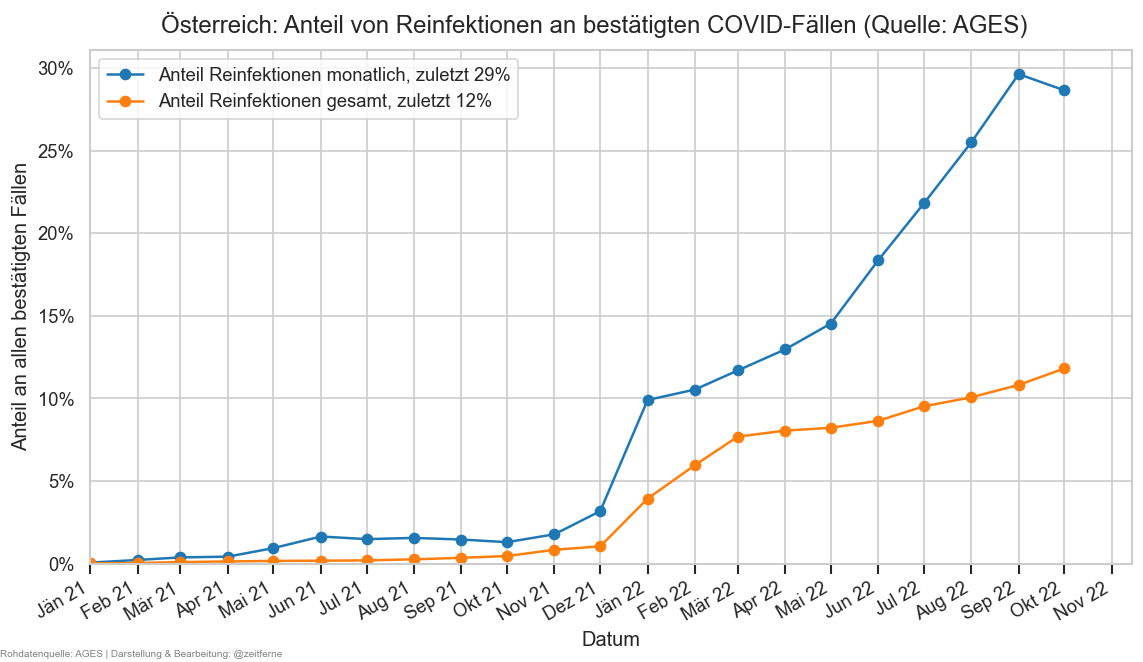
ax = reinf["N Reinfektionen"].cumsum().plot(marker="o", label="Reinfektionen")
fs_at.query("Datum < '2021-12-25'").set_index("Datum")["AnzahlFaelleSum"].plot(label="Infektionen vor Omikron")
ax.set_ylim(bottom=0)
ax.legend()
cov.set_date_opts(ax, showyear=True)
ax.figure.suptitle("Bestätigte Fälle & Reinfektionen", y=0.93)
ax.set_xlim(left=pd.to_datetime("2021-01-01"))
ax.yaxis.get_major_formatter().set_scientific(False)
ax.yaxis.get_major_formatter().set_useLocale(True)
#dir(ax.yaxis.get_major_formatter()
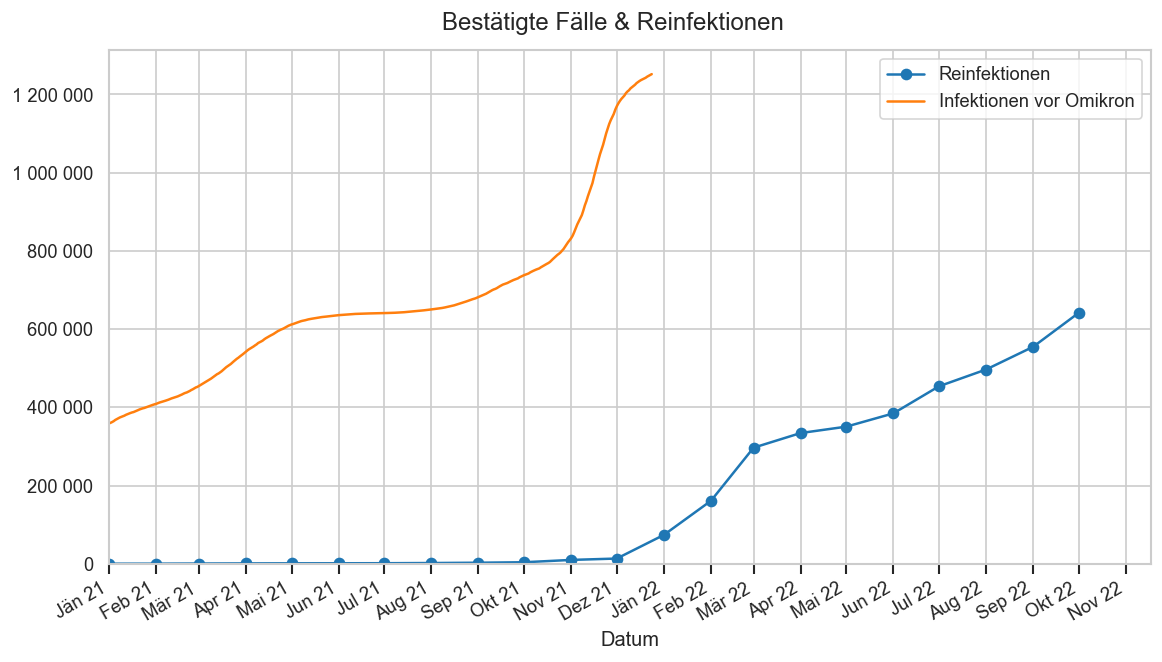
def drawcmp(valcol, valname, *,
usemean=False, agg=None, usemmx=False, selbl="Österreich", rstrip=0, showstripped=True, rwidth=7,
wholeyear=False, fromdate=pd.to_datetime(date(2022, 5, 1)), hlcur=True):
if usemean and not agg:
agg = 'mean'
#mms_at = mms.query(f"Bundesland == '{selbl}'").copy()
#mms_at["AnzahlTot"] = erase_outliers(mms_at["AnzahlTot"])
#mms_at["AnzahlFaelle7Tage"] = mms_at["AnzahlFaelle"].rolling(7).sum()
if usemmx is True:
dsrc = mmx.query(f"Bundesland == '{selbl}'").copy()
#if valcol == "AnzahlTot":
#dsrc["AnzahlTot"] = erase_outliers(dsrc["AnzahlTot"])
tdiff = 0 if valcol in ("FZHosp", "FZICU", "FZHospAlle") else 1
hist = fs[(fs["Datum"] + timedelta(tdiff) < mmx.iloc[0]["Datum"]) & (fs["Bundesland"] == selbl)].copy()
if tdiff:
hist["Datum"] += timedelta(tdiff)
dsrc = pd.concat([hist, dsrc])
elif usemmx is False or usemmx is None:
dsrc = fs[fs["Bundesland"] == selbl]
else:
dsrc = usemmx[usemmx["Bundesland"] == selbl]
fig, ax = plt.subplots()
#valcol, valname = "AnzahlFaelle", "Fälle"
#valcol, valname = "AnzahlTot", "Tote"
#valcol, valname = "FZHospAlle", "Hospitalisierte"
vals = dsrc.set_index("Datum")[valcol]
if usemmx is True and valcol == "AnzahlTot":
vals = erase_outliers(vals)
if agg:
vals = vals.rolling(rwidth).agg(agg)
if rstrip:
cvals = vals.iloc[-rstrip - 1:]
vals = vals.iloc[:-rstrip]
#.rolling(7).mean() if usemean else vs
items = [(2019, "C7"), (2020, "C4"), (2021, "C0"), (2022, "C3"), (2023, "C1")]
items = [(y, c) for y, c in items if fromdate.replace(year=y) <= vals.index[-1]]
thisyearstart = fromdate
thisyearlen = (vals.index[-1] - fromdate).days + 1
datalen = 0 if wholeyear else sum(vals.index >= thisyearstart)
margin = 0 if wholeyear else max(int(np.round(datalen * 0.1)), rstrip + 1)
mixedyear = fromdate.replace(year=2022) != pd.to_datetime("2022-01-01")
for yearidx, (year, color) in enumerate(items):
thatyearstart = thisyearstart.replace(year=year)
thatyearlen = datalen if not wholeyear else 365 + 1 + (
1 if (thatyearstart + timedelta(365)).is_leap_year else 0)
yeardata = vals[vals.index >= thatyearstart]
hl_idx = thisyearlen - 1
if yeardata.index[0] > thatyearstart:
off = (thatyearstart - yeardata.index[0]).days
thatyearlen += off
hl_idx += off
else:
off = 0
yeardata = yeardata.iloc[:thatyearlen + margin + 1]
thatyearlen = min(len(yeardata), thatyearlen)
#print(thatyearlen, year)
if thatyearlen <= 0:
print(year, "No data")
continue
if wholeyear:
datalen = max(datalen - 1, thatyearlen)
lastval = yeardata.iloc[hl_idx] if hlcur and hl_idx >= 0 else None
lastval_s = format(lastval, ".0f") if lastval is not None else "N/A"
#lastyear = mms_at.query("Datum >= '2021-05-01'").iloc[:len(thisyear)].copy()
#lastyear2 = fs_at.query("Datum >= '2020-05-01'").iloc[:len(thisyear)].copy()
dts = thisyearstart + (yeardata.index - yeardata.index[0] - timedelta(off))
#lastyear2["Datum"] = thisyear.iloc[0]["Datum"] + (lastyear2["Datum"] - lastyear2.iloc[0]["Datum"])
#ax.plot(lastyear2["Datum"], _tseries(lastyear2), label="2020: " + lastval(lastyear2), color="C4")
#display(yeardata)
valsuffix = ""
if valcol == "AnzahlTot":
if lastval_s == "1":
valsuffix = "/r"
if mixedyear:
yearsuffix = f"/{(year + 1) % 100}"
else:
yearsuffix = ""
lines = ax.plot(dts, yeardata,
label=f"{year}{yearsuffix}" + (f": {lastval_s} {valname}{valsuffix}" if hlcur else ""),
color=color)
if thatyearstart == thisyearstart and rstrip and showstripped:
ax.plot(cvals, color=color, ls=":")
if hlcur:
ax.plot(dts[hl_idx:hl_idx + 1], yeardata[hl_idx:hl_idx + 1],
color=color, marker="o", lw=0)
#ax.annotate("foo", (dts[-1], yeardata.iloc[-1]))
#ax.plot(thisyear["Datum"], _tseries(thisyear), lw=2, label="2022: " + lastval(thisyear), color="C3")
lines[0].set_linewidth(2)
cov.set_date_opts(ax, showyear=False)
ax.set_xlim(left=thisyearstart,
right=thisyearstart + timedelta((datalen + margin) if not wholeyear else 367))
ax.legend()
ax.set_ylim(bottom=0)
meanlbl = " (7-Tage-Schnitt)" if usemean else ""
ax.figure.suptitle(
dsrc.iloc[0]["Bundesland"] + f": COVID-{valname}{meanlbl} 2020 ‒ "
+ vals.last_valid_index().strftime("%d.%m.%Y") + AGES_STAMP, y=0.93)
ax.set_ylabel(valname + meanlbl)
#drawcmp("AnzahlFaelle", "Fälle", usemean=True)
#drawcmp("FZHospAlle", "Hospitalisierte", usemean=False, usemmx=True)
#drawcmp("FZHospAlle", "Hospitalisierte", usemean=False, usemmx=True, selbl="Oberösterreich")
#drawcmp("AnzahlTot", "Tote/14 Tage", agg='sum', rwidth=14, usemmx=False, rstrip=9, selbl="Österreich")
drawcmp("AnzahlTot", "Tote/14 Tage", agg='sum', fromdate=pd.to_datetime("2022-06-15"),
rwidth=14, usemmx=False, rstrip=9, wholeyear=True, selbl="Österreich", hlcur=False, showstripped=True)
drawcmp("AnzahlTot", "Todesfallmeldungen*/7 Tage", agg="sum", rwidth=7, fromdate=pd.to_datetime("2022-06-15"),
usemmx=mmx,#ages1m[ages1m["Datum"] >= ages1m.iloc[0]["Datum"]],
rstrip=0,
wholeyear=True, selbl="Österreich", hlcur=False, showstripped=True)
plt.gca().set_title("*Todesfallmeldungen ohne Nachmeldungen die mehr als 21 Tage in Vergangenheit reichen",
fontsize="small", y=0.98)
plt.gca().set_ylim(top=900)
drawcmp("AnzahlTot7Tage", "Tote*/7 Tage", fromdate=pd.to_datetime("2022-06-15"),
usemmx=ages_hist.loc[(ages_hist["FileDate"] == ages_hist["Datum"] + timedelta(10))
| ((ages_hist["FileDate"] == ages_hist["FileDate"].min())
& (ages_hist["Datum"] <= ages_hist["FileDate"].min() - timedelta(10)))
| ((ages_hist["FileDate"] == ages_hist["FileDate"].max())
& (ages_hist["Datum"] >= ages_hist["FileDate"].max() - timedelta(10)))],
rstrip=9, wholeyear=True, selbl="Österreich", hlcur=False, showstripped=True)
plt.gca().set_title(
"*Todesfälle je historischer Datenstand 10 Tage nach letztem Todesdatum bzw. mindestens Stand "
+ ages_hist["FileDate"].min().strftime("%x"),
fontsize="small", y=0.98)
plt.gca().set_ylim(top=800)
#plt.gca().set_ylim(bottom=10)
#cov.set_logscale(plt.gca())
#cov.set_logscale(plt.gca())
#plt.gca().set_ylim(bottom=10)
drawcmp("FZHospAlle", "Hospitalisierte", selbl="Österreich", usemmx=True, wholeyear=True,
fromdate=pd.to_datetime("2022-06-15"), hlcur=False)
drawcmp("FZICU", "PatientInnen auf ICU", usemmx=True, wholeyear=True, fromdate=pd.to_datetime("2022-06-15"), hlcur=False)
#drawcmp("FZHospAlle", "Hospitalisierte", selbl="Burgenland", usemmx=True, wholeyear=True, fromdate=pd.to_datetime("2022-06-15"), hlcur=False)
drawcmp("inz", "7-Tage-Inzidenz/100.000", usemean=False, wholeyear=True, fromdate=pd.to_datetime("2022-05-15"), hlcur=False)
plt.gca().set_ylim(bottom=5)
cov.set_logscale(plt.gca())
drawcmp("inz", "7-Tage-Inzidenz/100.000, Altersgruppe 5-14", usemean=False, wholeyear=True, fromdate=pd.to_datetime("2022-05-15"), hlcur=False,
usemmx=agd_sums.query("Altersgruppe == '5-14'"))
plt.gca().set_ylim(bottom=5)
cov.set_logscale(plt.gca())
drawcmp("inz", "7-Tage-Inzidenz/100.000, Altersgruppe 65+", usemean=False, wholeyear=True, fromdate=pd.to_datetime("2022-05-15"), hlcur=False,
#usemmx=agd_sums.query("Altersgruppe == '<5'")
usemmx=agg_casedata(
agd_sums.query("Bundesland == 'Österreich' and Altersgruppe in ('65-74', '75-84', '>84')"),
"Altersgruppe",
"65+").reset_index().assign(Bundesland="Österreich")
)
plt.gca().set_ylim(bottom=5)
cov.set_logscale(plt.gca())
drawcmp("inz", "7-Tage-Inzidenz/100.000, Altersgruppe 25-54", usemean=False, wholeyear=True,
fromdate=pd.to_datetime("2023-01-01"), hlcur=False,
#usemmx=agd_sums.query("Altersgruppe == '<5'")
usemmx=agg_casedata(
agd_sums.query("Bundesland == 'Österreich' and Altersgruppe in ('25-34', '35-44', '45-54')"),
"Altersgruppe",
"25-54").reset_index().assign(Bundesland="Österreich")
)
plt.gca().set_ylim(bottom=5)
cov.set_logscale(plt.gca())
2019 No data 2019 No data
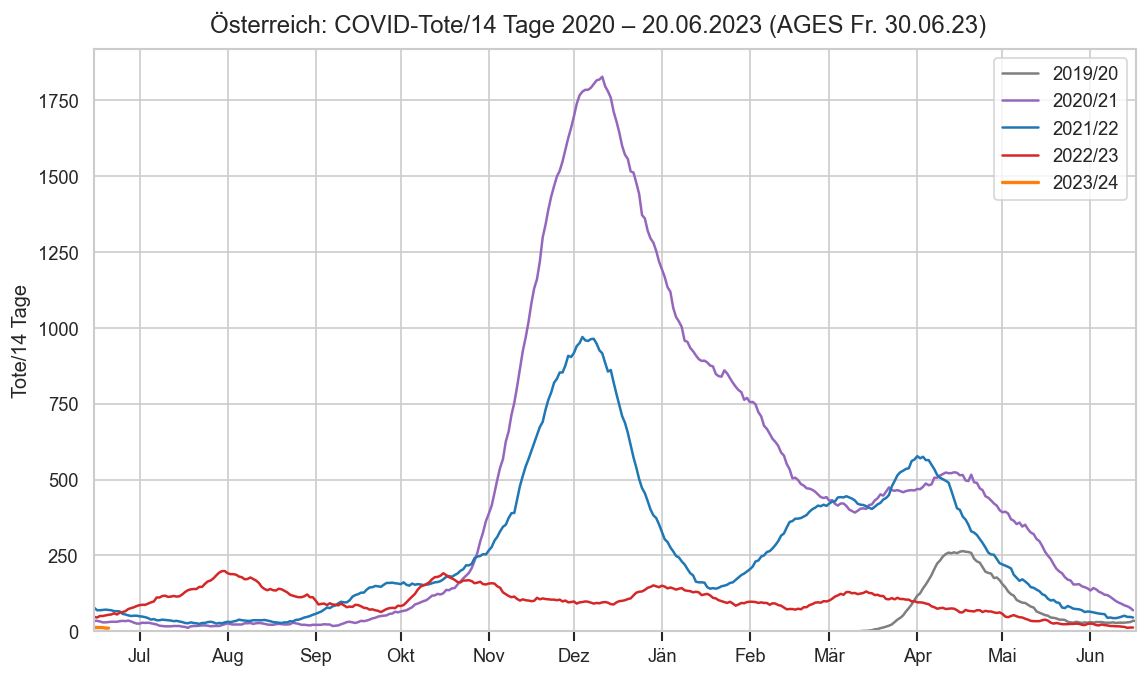
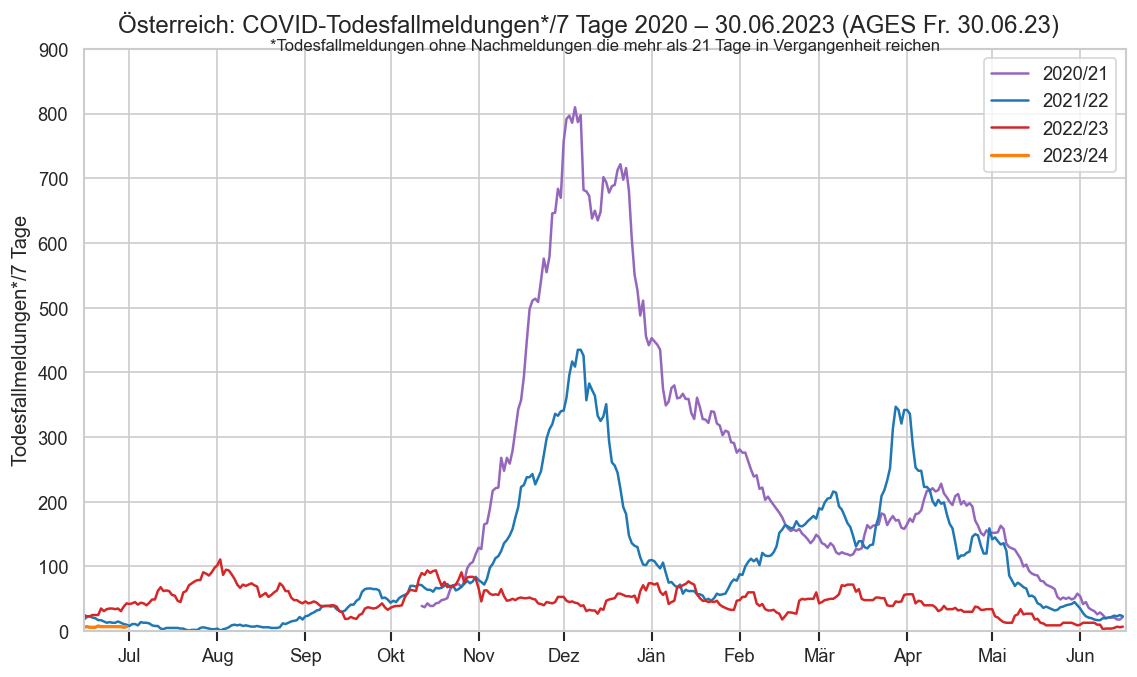
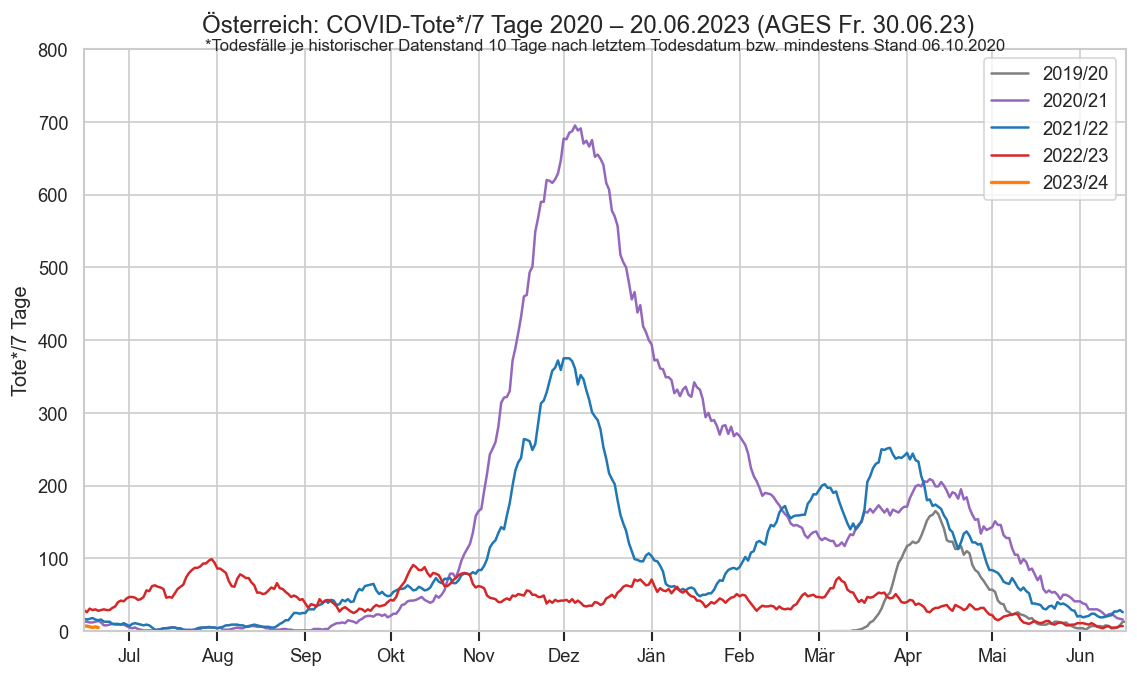
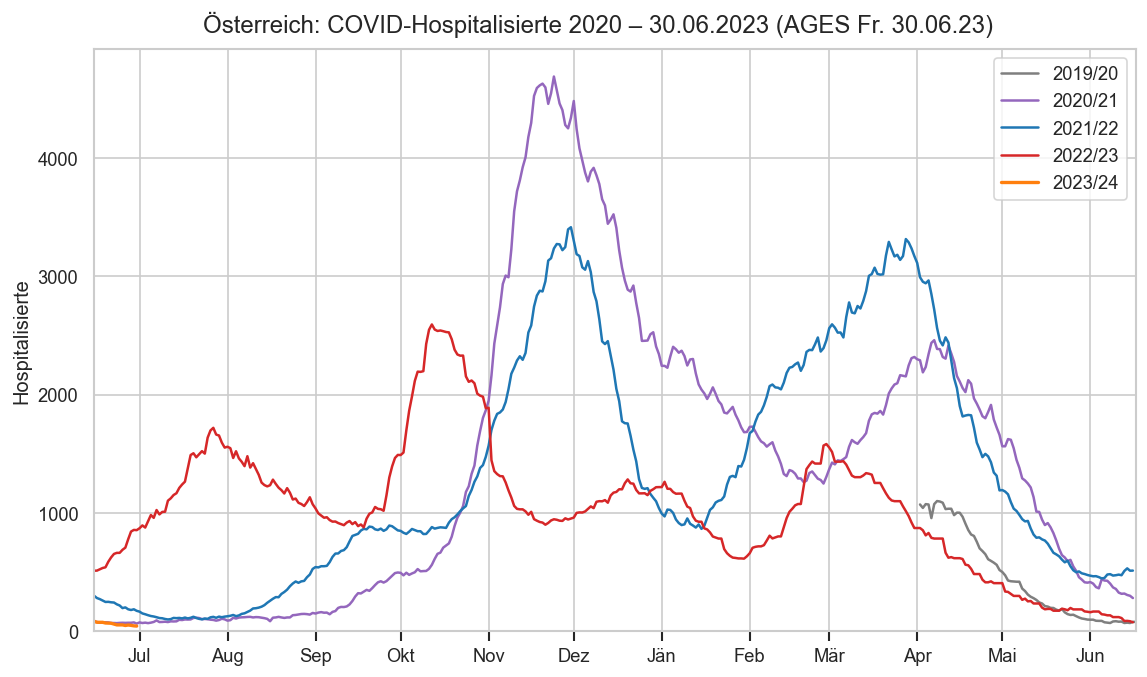
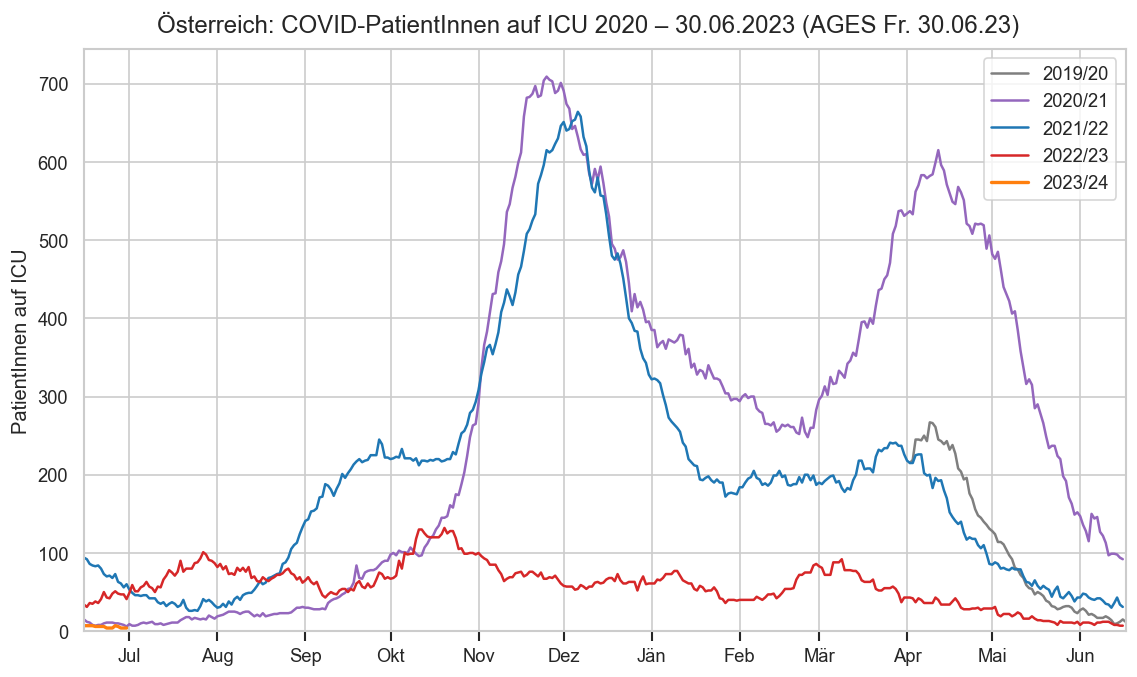
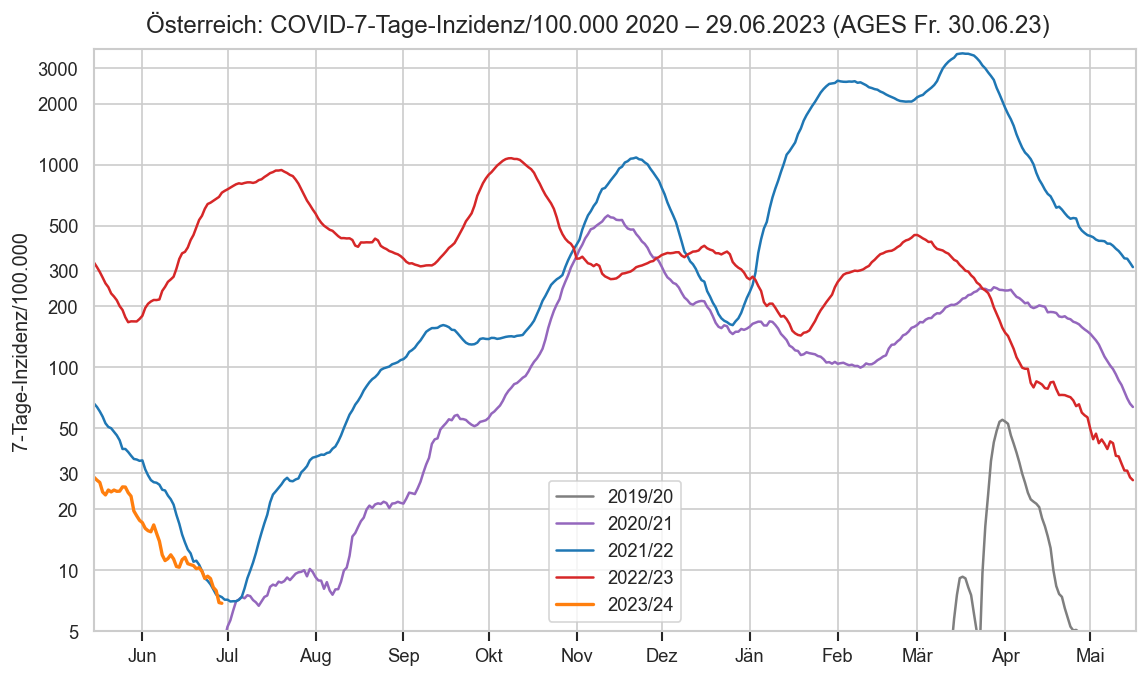
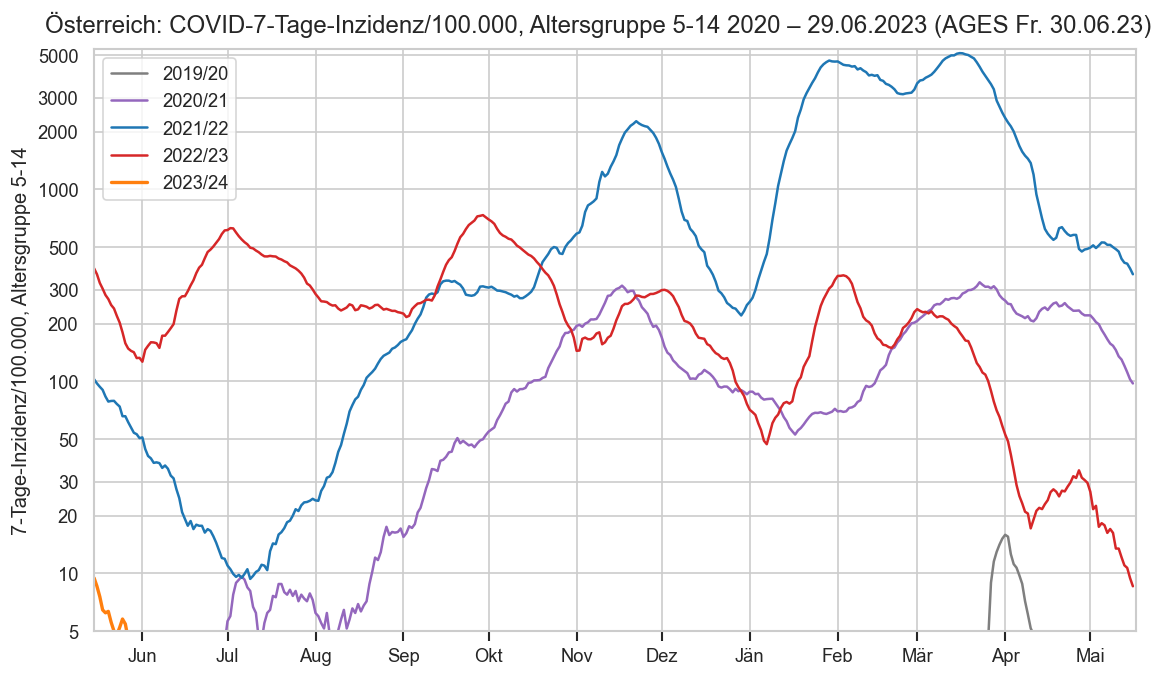
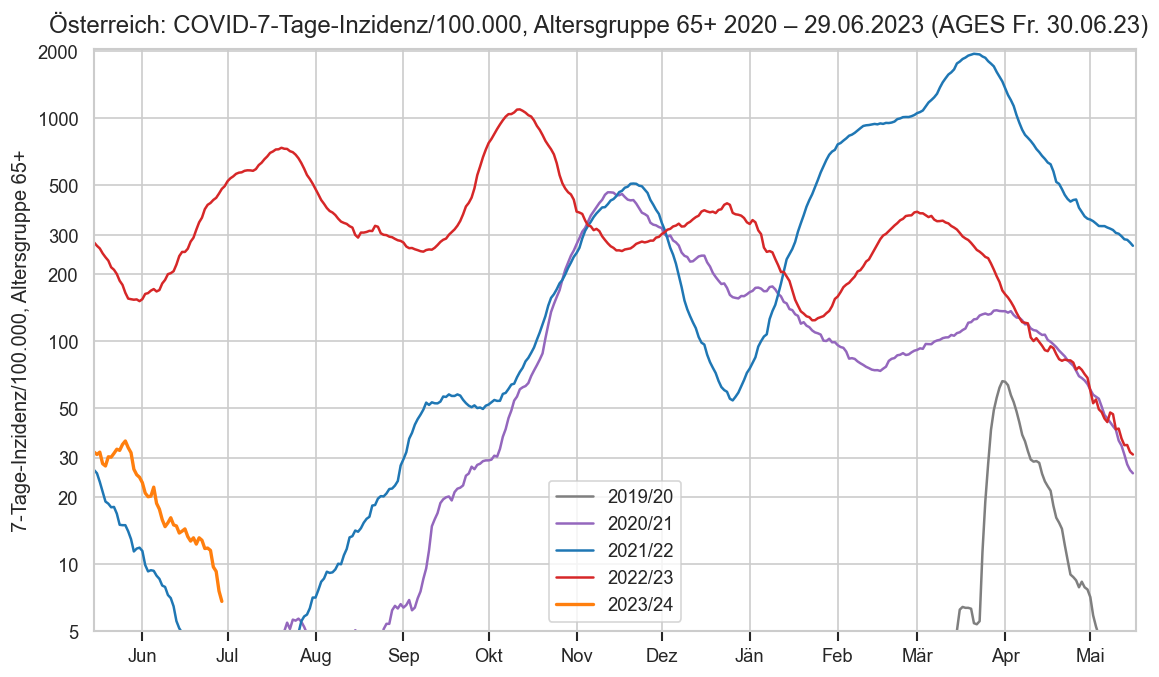
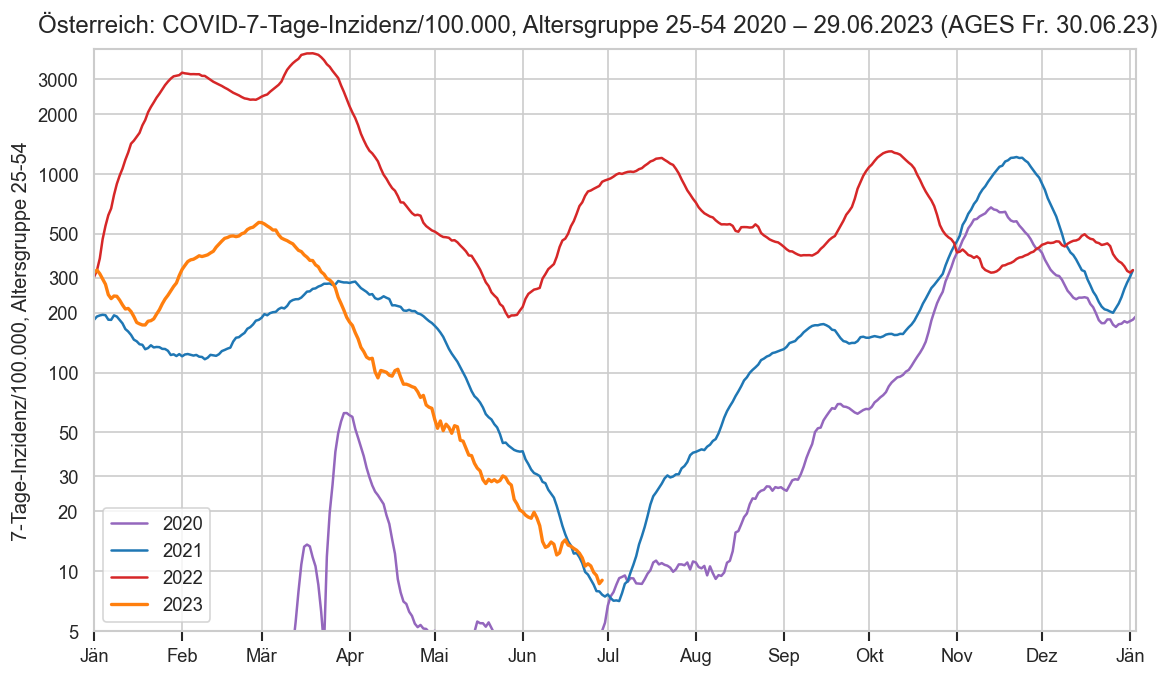
Varianten¶
import http.client
import email.utils
from datetime import timezone
with open(DATAROOT / "covid/ages-varianten/Varianten_Verteilung_lasthdr.txt", "rb") as hdrf:
seqdate = pd.to_datetime(
email.utils.parsedate_to_datetime(http.client.parse_headers(hdrf)["Last-Modified"])
).tz_convert("Europe/Vienna").strftime("%a %d.%m.%Y")
print(f"{seqdate=}")
def map_seqkw(xs):
xs["Datum"] = xs["Kalenderwoche"].map(
lambda kw: pd.to_datetime(date.fromisocalendar(2022 if kw >= 45 else 2023, kw, 1)))
seqcount = pd.read_csv(
DATAROOT / "covid/ages-varianten/Varianten_gesamt_KW_latest.csv",
sep=";", decimal=",")
map_seqkw(seqcount)
seqcount_n = seqcount.set_index("Datum")["Sequenzierung pro KW"]
seqdistr = pd.read_csv(
DATAROOT / "covid/ages-varianten/Varianten_Verteilung_latest.csv",
sep=";", decimal=",").melt(id_vars="Kalenderwoche", var_name="variant", value_name="share")
print("Distr bis KW", seqdistr["Kalenderwoche"].iloc[-1])
nseqvars = seqdistr["variant"].nunique()
seqdistr["share"] /= 100
map_seqkw(seqdistr)
blv_at_last_y = blverlauf_last.query("Bundesland == 'Österreich'").set_index("Datum")["y"]
dt_end = seqdistr["Datum"] + timedelta(6)
seqdistr = seqdistr.merge(
blv_at_last_y.rolling(7).mean().rename("load"),
left_on=dt_end, right_index=True).drop(columns="key_0")
seqdistr["load"] *= seqdistr["share"]
#display(seqdistr)
dt_end = seqdistr["Datum"] + timedelta(6) # Need to recalc b/c of index change
seqdistr = seqdistr.merge(
fs_at.set_index("Datum")["inz"].rename("case_inz"),
left_on=dt_end, left_index=False, right_index=True, how="left")#.drop(columns="key_0")
#display(seqdistr)
seqdistr["case_inz"] *= seqdistr["share"]
seqdistr["Datum"] += timedelta(3) # Week center (last date is start of last day)
seqcount_n.index += timedelta(3)
#display(seqdistr)
fig = plt.figure()
ax = sns.lineplot(seqdistr, x="Datum", y="share", hue="variant", marker=".", mew=0)
cov.set_date_opts(ax)
cov.set_logscale(ax)
cov.set_percent_opts(ax, decimals=1)
ax.get_legend().remove()
cov.labelend2(ax, seqdistr, "share", cats="variant", shorten=lambda v: v,
colorize=sns.color_palette(n_colors=nseqvars), ends=(True, True))
fig.legend(loc="upper center", ncol=7, frameon=False, bbox_to_anchor=(0.5, 0.97))
fig.suptitle("Österreich: SARS-CoV-2-Variantenverteilung lt. AGES, logarithmisch, Stand " + seqdate, y=1)
ax.set_ylabel("Anteil")
fig, axs = plt.subplots(nrows=2, sharex=True, gridspec_kw={'height_ratios': [0.85, 0.15]})
ax = sns.lineplot(seqdistr, x="Datum", y="load", hue="variant", marker=".", mew=0, ax=axs[0])
cov.set_logscale(ax)
ax.yaxis.set_major_formatter(matplotlib.ticker.FormatStrFormatter("%.1f"))
ax.get_legend().remove()
ax.plot(blv_at_last_y[blv_at_last_y.index.get_level_values("Datum") >= seqdistr["Datum"].min()], color="k",
label="Summe")
cov.labelend2(ax, seqdistr, "load", cats="variant", shorten=lambda v: v,
colorize=sns.color_palette(n_colors=nseqvars), ends=(True, True))
fig.legend(loc="upper center", ncol=7, frameon=False, bbox_to_anchor=(0.5, 0.97))
fig.suptitle("Österreich: SARS-CoV-2-Varianten-Abwasserlast, logarithmisch, Stand Varianten: " + seqdate, y=1)
ax.set_ylabel("Genkopien pro Tag / EW * 10⁶")
axs[1].plot(seqcount_n, marker="o", color="k")
h50 = seqcount_n.max() / 2
for i in range(len(seqcount_n)):
v = seqcount_n.iloc[i]
axs[1].annotate(
str(v),
(seqcount_n.index[i], v),
xytext=(0, 8 if v < h50 else -8), textcoords='offset points',
va="baseline" if v < h50 else "top",
ha="center",
fontsize="medium" if i + 1 == len(seqcount_n) else "x-small",)
#axs[1].set_ylim(bottom=0)
cov.set_logscale(axs[1], reduced=True)
axs[0].set_xlabel("Probedatum")
#axs[1].yaxis.set_major_locator(matplotlib.ticker.MaxNLocator('auto', integer=True, min_n_ticks=3))
cov.set_date_opts(axs[1])
axs[1].set_title("Anzahl sequenzierter Proben (inkl. nicht auswertbarer) pro KW (logarithmisch; Achse beginnt nicht bei 0)")
axs[1].set_ylabel("Sequenzen")
axs[1].set_xlabel("Probedatum (oberer Teil) bzw. unklares Datum (Probe oder Sequenzierung) (unterer)")
cov.stampit(fig, cov.DS_BOTH)
###########
#display([pdata[c] for c in pdata.columns])
fig, ax = plt.subplots()
ax.stackplot(
seqdistr["Datum"].unique(),
*[seqdistr.loc[seqdistr["variant"] == c, "load"].to_numpy() for c in seqdistr["variant"].unique()],
labels=seqdistr["variant"],
lw=0)
seqdistr["cs"] = seqdistr.groupby("Datum")["load"].cumsum()
seqdistr["cc"] = seqdistr.groupby("Datum")["cs"].transform(lambda cs: pd.concat([pd.Series([0]), cs]).rolling(2).mean().iloc[1:])
#display(seqdistr)
cov.set_date_opts(ax)
#cov.set_logscale(ax)
ax.yaxis.set_major_formatter(matplotlib.ticker.FormatStrFormatter("%.1f"))
#ax.get_legend().remove()
cov.labelend2(ax, seqdistr, "cc", cats="variant", shorten=lambda v: v,
colorize=sns.color_palette(n_colors=nseqvars), ends=(True, True))
ax.set_axisbelow(False)
fig = ax.figure
fig.legend(loc="upper center", ncol=7, frameon=False, bbox_to_anchor=(0.5, 0.97))
fig.suptitle("Österreich: SARS-CoV-2-Varianten-Abwasserlast, Stand Varianten: " + seqdate, y=1)
ax.set_ylabel("Genkopien pro Tag / EW * 10⁶")
fig = plt.figure()
ax = sns.lineplot(seqdistr, x="Datum", y="case_inz", hue="variant", marker=".", mew=0)
cov.set_date_opts(ax)
cov.set_logscale(ax)
ax.yaxis.set_major_formatter(matplotlib.ticker.FormatStrFormatter("%.1f"))
ax.get_legend().remove()
cov.labelend2(ax, seqdistr, "case_inz", cats="variant", shorten=lambda v: v,
colorize=sns.color_palette(n_colors=nseqvars), ends=(True, True))
fig = ax.figure
fig.legend(loc="upper center", ncol=7, frameon=False, bbox_to_anchor=(0.5, 0.97))
fig.suptitle("Österreich: SARS-CoV-2-Varianten-Fall-Inzidenz, logarithmisch, Stand Varianten: " + seqdate, y=1)
ax.set_ylabel("Fälle pro Woche / 100.000 EW")
seqdate='Di. 11.07.2023' Distr bis KW 26
Text(0, 0.5, 'Fälle pro Woche / 100.000 EW')
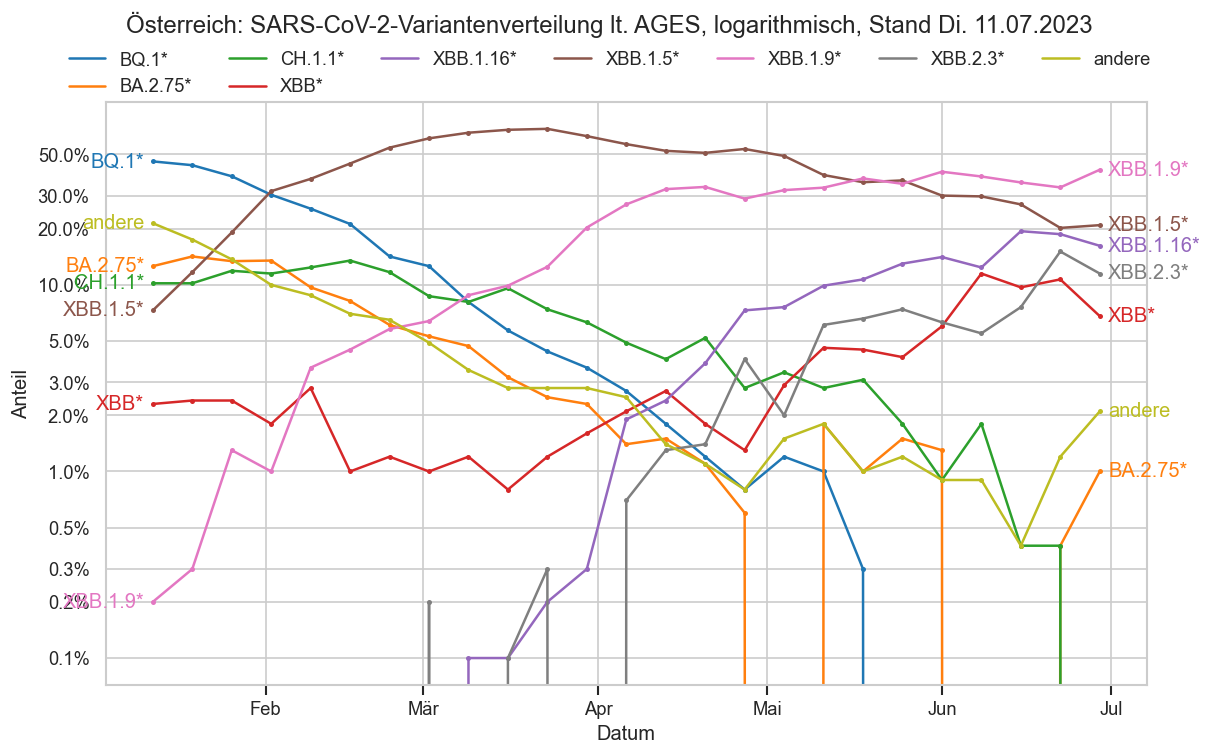
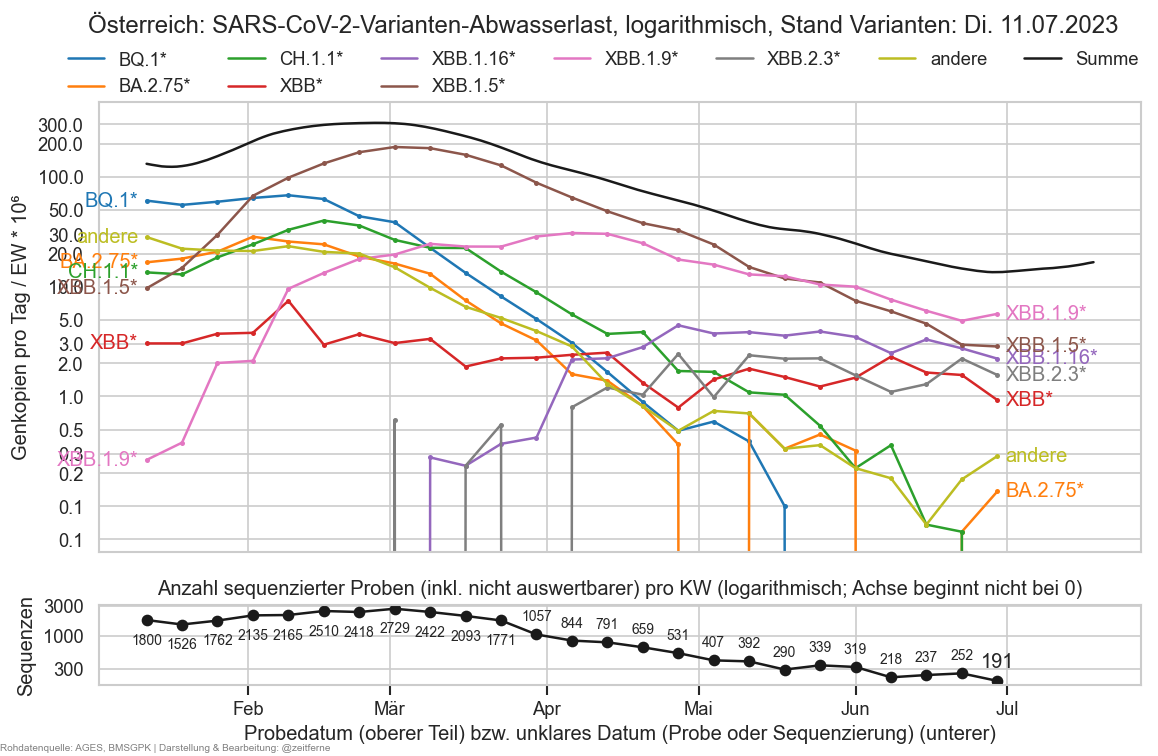
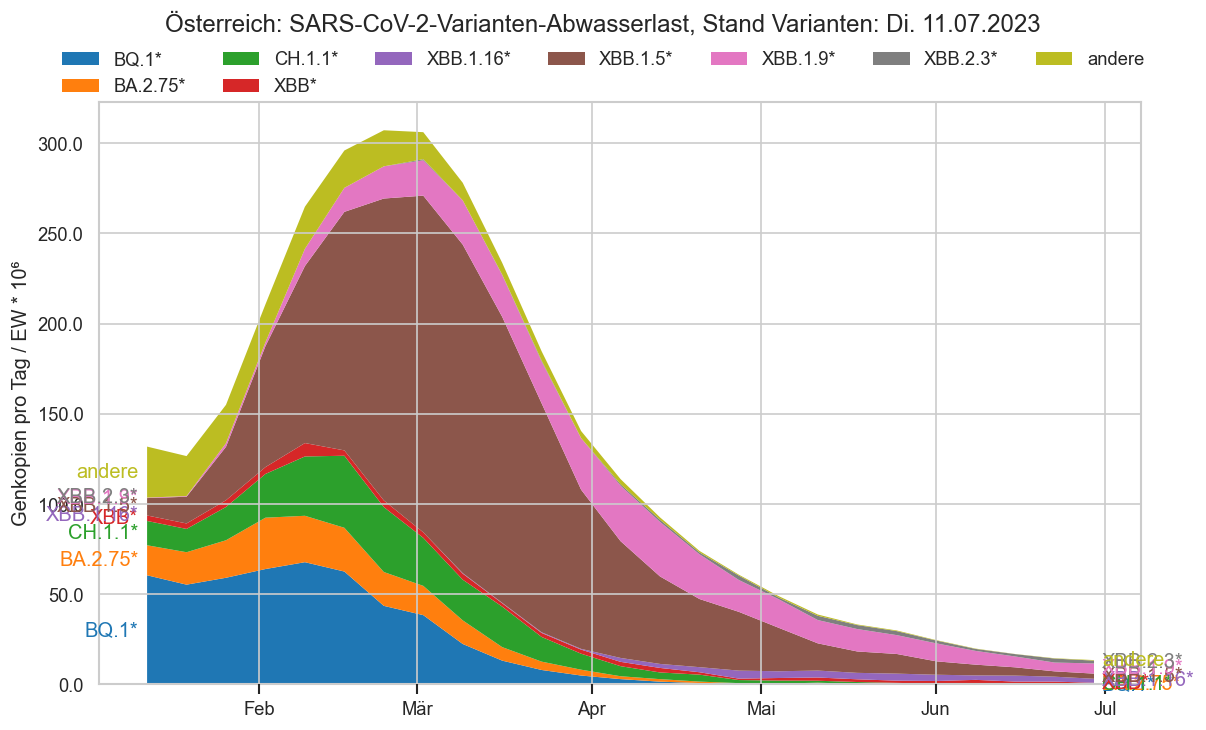
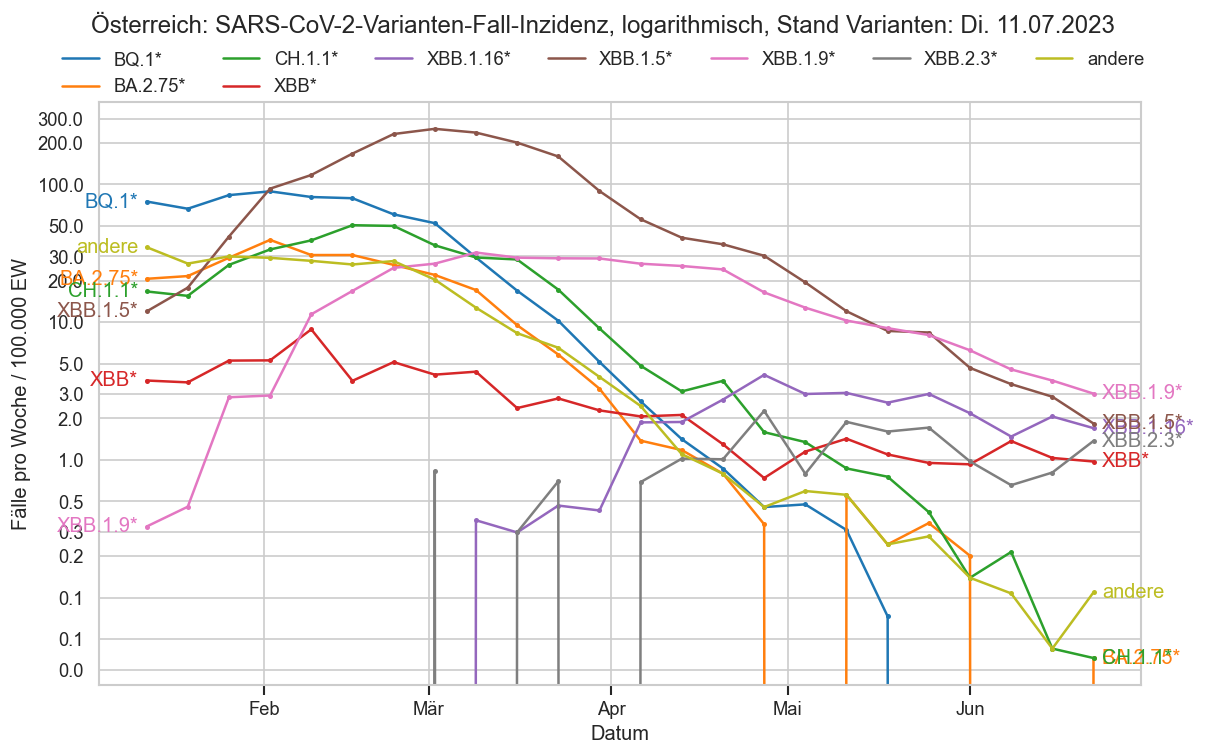
# Alter Code für:
# Quelle: Gesamt-Fallzahlen der AGES, Anteile aus grober Pixelzählung von
# * https://twitter.com/EllingUlrich/status/1532750801164197889
# * https://twitter.com/EllingUlrich/status/1535259206655295488
# (Meine variants.csv habe ich nie veröffentlicht, war auch sehr unvollständig)
if False:
variants = pd.read_csv("variants.csv", sep=";", parse_dates=["Datum"]).merge(fs_at[["Datum", "AnzahlFaelle7Tage"]], on="Datum")
variants["AnzahlFaelle7Tage"] *= variants["rel_freq"]
variants.set_index(["Datum", "variant"], inplace=True)
variants.sort_index(inplace=True)
variants = pd.concat([
variants,
variants.query("variant != 'BA.2'")["AnzahlFaelle7Tage"]
.groupby("Datum")
.sum()
.to_frame()
.assign(variant="Nicht-BA.2")
.reset_index()
.set_index(["Datum", "variant"])]).sort_index()
variants["inz_g7"] = variants["AnzahlFaelle7Tage"].groupby(level=["variant"]).transform(lambda s: s / s.shift())
ax = sns.lineplot(data=variants.reset_index(), x="Datum", hue="variant", y="AnzahlFaelle7Tage", marker="o", mew=0)
fs_at0 = fs_at[fs_at["Datum"] >= variants.index.get_level_values("Datum").min()]
ax.plot(fs_at0["Datum"], fs_at0["AnzahlFaelle7Tage"], label="Gesamt", color="k", alpha=0.5)
ax.xaxis.set_major_locator(matplotlib.dates.WeekdayLocator(6))
ax.legend()
ax.figure.suptitle("Fallzahlen je SARS-CoV-2-Variante, logarithmisch", y=0.93)
cov.set_logscale(ax)
plt.figure()
ax = sns.lineplot(data=variants.reset_index(), x="Datum", hue="variant", y="inz_g7", marker="o", mew=0)
ax.plot(fs_at0["Datum"], fs_at0["inz_g7"], label="Gesamt", color="k", alpha=0.5)
ax.axhline(1, color="k")
ax.legend()
ax.figure.suptitle("7-Tage-Wachstumsrate je SARS-CoV-2-Variante", y=0.93)
lastdate = variants.index.get_level_values("Datum")[-1]
nextdate = lastdate + timedelta(7)
nextc = (variants
.groupby(level=["variant"])
.apply(lambda s: s.iloc[-1]["AnzahlFaelle7Tage"] * s.iloc[-1]["inz_g7"]).rename("AnzahlFaelle7Tage").to_frame())
nextc["Datum"] = nextdate
nextc.reset_index(inplace=True)
nextc.set_index(["Datum", "variant"], inplace=True)
display(nextc)
variants = pd.concat([variants, nextc])
display(variants)
plt.figure()
ax = sns.lineplot(data=variants.reset_index(), x="Datum", hue="variant", y="AnzahlFaelle7Tage", marker="o", mew=0)
ax.plot(fs_at0["Datum"], fs_at0["AnzahlFaelle7Tage"], label="Gesamt", color="k", alpha=0.5)
ax.xaxis.set_major_locator(matplotlib.dates.WeekdayLocator(6))
ax.legend()
ax.figure.suptitle("Fallzahlen je SARS-CoV-2-Variante, logarithmisch", y=0.93)
ax.plot([nextdate], [variants.query("variant != 'Nicht-BA.2'").loc[nextdate, "AnzahlFaelle7Tage"].fillna(0).sum()], marker="X", color="r", markersize=10)
cov.set_logscale(ax)
ax.set_xlim(*ax.get_xlim())
ax.axvspan(lastdate + timedelta(1), matplotlib.dates.num2date(ax.get_xlim()[1]), color="k", alpha=0.2)
